






















Kogan Page is a leading independent business book publisher, publishing content from global business experts on the trends and topics shaping business today. Recognized as Digital Publisher of the Year 2020, Academic & Professional Publisher of the Year 2019 and awarded the International Achievement Award at the Independent Publishers Guild (IPG) Awards, we are committed to accessibility standards and deliver the highest quality content from authors who are leading experts in their field.
We publish content across a broad range of subject areas within business:
Business & Management
Human Resources, Learning & Development
Marketing & Communications
Logistics, Supply Chain & Operations
Skills, Careers & Employability
Kogan Page Inspire
Risk & Compliance
Accounting, Finance & Banking
Our books are available to lecturers through our inspection copy service. We will consider requests from any instructor with a registered academic address, teaching a class of 10 or more students. You can request an inspection copy by registering for an academic account at www.koganpage.com/inspectioncopies
Kogan Page books are available as ebooks from major retailers and our website. We also offer multiple access for students through digital textbook platforms such as Kortext and VitalSource.
We are proud to have partnered with Carbon Neutral Britain to calculate and offset Kogan Page Ltd’s carbon footprint. In July 2021, our internal efforts led us to become certified as a Carbon Neutral Business. We also partner with suppliers and vendors that follow sustainability guidelines and processes.
We take action to ensure we are a diverse and representative organization. We are an active member of the Independent Publishers Guild Diversity and Inclusivity Action Group, support the Publishers Association Inclusivity Action Plan, partner with Creative Access to support under-represented groups entering the creative industries, and monitor representation across our staff and authors.
We are one of few publishers globally to receive the Global Certified Accessible accreditation and ASPIRE verification service gold rating. GCA certification is the gold standard for accessible publications within the industry. Testament to our work in accessibility, we also achieved the BIC Excellence Plus award, won the ABC International Excellence Award for Accessible Publishing in 2022 and won the IPG Digital Publishing Award in 2020.
To find out more about our efforts in these areas, visit: www.koganpage.com/our-values
Subscribe to our newsletter to receive updates on new books, expert content, sample chapters and special offers, delivered straight to your inbox: www.koganpage.com/newsletters
Did you know that we offer a variety of personalization options for custom books?
You can tailor the content to directly match your module’s content and structure to cater for your students’ needs.
• Combined material and extracts from a selection of Kogan Page books
• You can add some of your own bespoke content
• Your own cover with your university logo
• A unique title of your choice
• A personalized message or foreword
• A module guide if you wish

• Print and e-book options
To find out more, please contact Paul Raymond, Academic Sales Manager: praymond@koganpage.com
07866 109832
Logistics, Supply Chain & Operations
Ebook Collections
• Supply Chain
• Procurement
• Logistics
• Operations Skills, Careers and Employability
Ebook Collections
• Ace your selection tests

• Find and get the job you want
• Early career success
• First-time manager
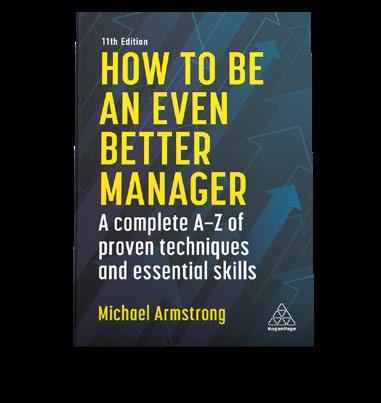
Logistics, Supply Chain & Operations Ebook Collections
CIPD and HR Ebook Collections

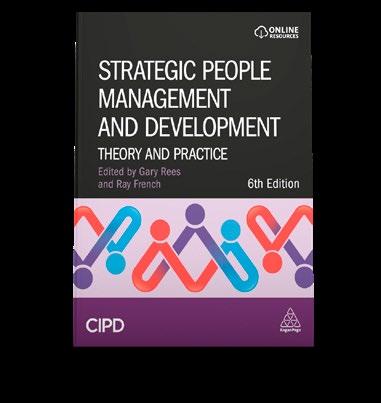
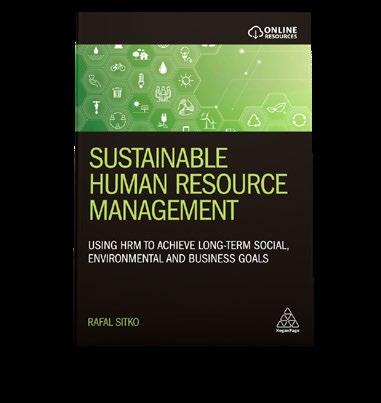
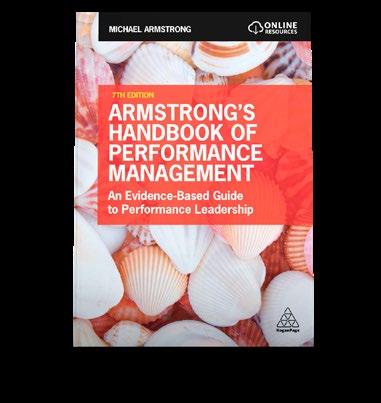

• Supply Chain
• Procurement Operations
• CIPD Foundation Certificate
• CIPD Associate Diploma
• CIPD Advanced Diploma
• HR Professional Books Marketing Ebook Collections
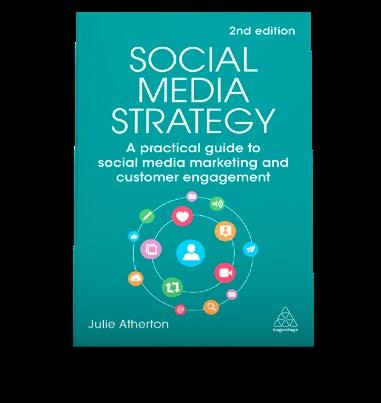

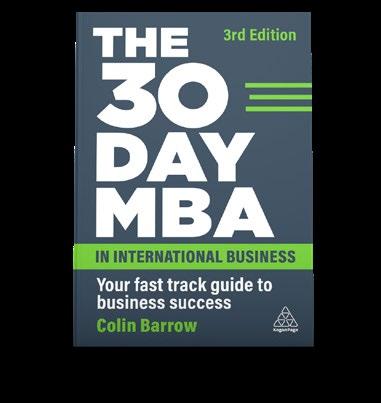
Logistics, Supply Chain & Operations Ebook Collections
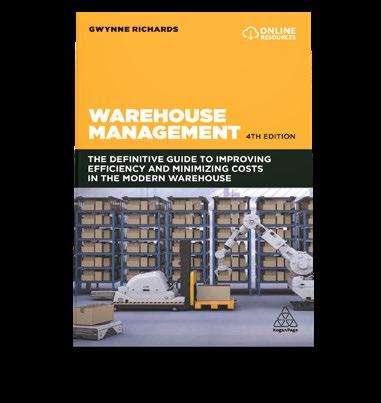

• Supply Chain
• Procurement Operations
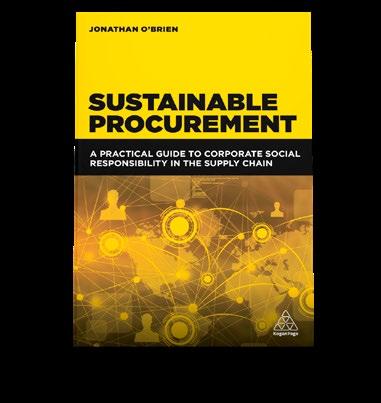
• Branding & Advertising

• PR & Communications
• Digital Marketing
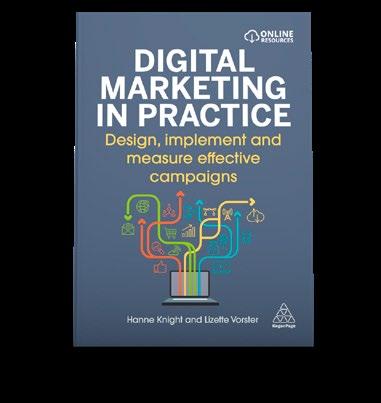
• Strategy & Planning

• Business & Management
• Human Resources, Learning & Development & CIPD

• Logistics, Supply Chain & Operations
• Marketing & Communications
• Risk & Compliance
• Skills, Careers & Employability
WITH OUR PRINT AND EBOOK BUNDLES
Get the
With our print and ebook bundles available at koganpage.com you can read Kogan Page and CIPD textbooks anytime, anywhere. You can have the printed copy for your desk plus access to the ebook through the Kogan Page Bookshelf® for free when you select the ‘paperback + ebook bundle’ option.
Powered by VitalSource®, Bookshelf provides an optimized reading experience for you and your students. You can:
• Read books offline on iOS, Android, Mac and PC
• Bookmark, highlight and search for easy navigation
• Adjust the font size to suit your preferences
• Cite content correctly in a variety of citation styles
• Learn collaboratively by sharing notes
We offer bulk discounts on print books, ebooks and bundles to academic institutions –contact us at sales@koganpage.com
Kogan Page has made a commitment to accessibility. We create highly accessible ebook files and we make sure they are readily available to users who are blind, visually impaired or otherwise print disabled. Our commitment to accessibility has been recognized by organizations such as DAISY, Inclusive Publishing and Digital Book World. Kogan Page staff have presented at the London Book Fair and the Anniversary Conference for the NADP on accessibility and born-accessible production workflows, and authored an accessibility case study for Inclusive Publishing.
ABC International Excellence Award in Accessible Publishing (2022) Accessible Books Consortium
Product Design Award (2021)
The Stationers’ Company Innovation Excellence Awards
Digital Publishing Award (2020)
IPG Independent Publishing Awards

ASPIRE rating GOLD for our website accessibility statement

DAISY Award for Accessibility (shortlisted)
Digital Book World
Kogan Page is proud to be one of a small number of publishers in the world to receive Benetech’s Global Certified Accessible accreditation for ebooks. This award is the gold standard for accessible publications and certifies that Kogan Page has demonstrated conformance to accessibility guidelines set forth by the Global Certified Accessible Consortium, which are based on standards put in place by the W3C and the international publishing community.
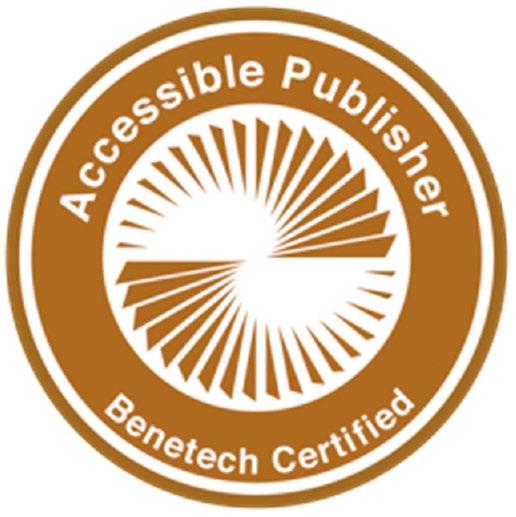
Kogan Page ebooks are available in EPUB3 formats and conform to the W3C standard EPUB Accessibility 1.0. We ensure ARIA roles, EPUB types, accessibility metadata and alternative (alt) text and long descriptions for imagery and tables are included. All of our ebooks have a logical reading order and include mark-up and structure to ensure easy navigation and compatibility with assistive technologies, such as screen readers.
Since 2012, Kogan Page has worked with RNIB Bookshare, an online library of accessible publications, to make all of our ebooks available to persons who are blind, visually impaired or otherwise print disabled at the same time as the publication of the print editions. Our accessible ebooks are also available on numerous platforms including VitalSource Bookshelf, AccessText, Kortext, Bookshare (US) and Bookshare Australia (Vision Australia). We are a signatory to the Accessible Book Consortium’s Charter for Accessible Publishing, which promotes the production of ebooks in accessible formats.
If you have any questions about accessibility accessibility@koganpage.com
Business, Finance, Risk & Information Management
Accounting & Finance
International Finance
Sustainable Investment
Financial Technology
Banking
Business Research
Change Management
Corporate Governance, Ethics & CSR
Entrepreneurship
Information, Knowledge & Data Management
International Business
Leadership
Project Management
Risk Management
Cyber Security Strategy
Sustainability in Business
Systems Thinking
Workplace Skills
Human Resources, Organizations and Learning & Development
Introduction to HRM
Human Resource Management
Business Environment
HR Analytics
HR Leadership
International HRM
HR Technology
Strategic HRM
Sustainable HRM
Organizations
Organizational Development
Diversity & Inclusion
Employee Engagement
Employment Law & Relations
Talent Management & Recruitment
Performance Management
Reward Management
Coaching
Learning & Development
Logistics, Operations and Supply Chain Management
Intro Logistics & Supply Chain
Logistics
Global Logistics
Humanitarian Logistics & Supply Chain
Maritime Logistics
Retail Logistics & Supply Chain
Manufacturing & Production
Operations Management
Procurement
Supply Chain Management
Supply Chain Analytics
Supply Chain Finance
Sustainability
Transport Warehouse Management
Marketing & Public Relations
Marketing Strategy
Sustainable Marketing
Marketing Planning
Marketing Analytics
B2B Marketing
Digital Marketing
Marketing Communications
Internal Communications
Luxury Marketing
Market Research
Branding
Event Management
Public Relations
Retail
Sales & Key Account Management
Social Media
Social Media Marketing





Innovation and Best Practice in:


Accounting & Finance
International Finance


Sustainable Investment

Financial Technology






Banking
Business Research
Change Management
Corporate Governance, Ethics & CSR




Entrepreneurship
Information, Knowledge & Data Management
International Business Leadership
Project Management
Risk Management
Cyber Security Strategy
Sustainability in Business Systems Thinking























Workplace Skills

• Specifically designed for business and management students who need to understand accounting and finance information in order to make better-informed business decisions

• Uses clear language accessible to students who have not studied finance previously and explains all key concepts in a logical manner
• Develops analytical skills through exercises, comprehension questions, and the interpretation of real financial statements and worked examples from well-known businesses, such as Tesco, Ryanair and Whitbread PLC
• New to this edition: provides updates on new accounting standards and regulations, as well as featuring more modern real-world examples in extracts and in expert view sections.
• Online resources: bonus chapters containing guidance and teaching tips, additional questions and lecture slides for each chapter
This textbook is the ideal guide for business and management students who need to understand accounting and finance information and develop analytical skills in order to make better-informed decisions.
Accounting and Finance for Managers rebukes the myth that in order to excel in accounting and finance you need to be great at mathematics. Split into two broad sections which focus on financial accounting and management accounting and finance, this textbook uses clear, accessible language that will appeal to students from a variety of academic backgrounds. Taking a uniquely practical approach that focuses on the financial aspects of business decisions, the textbook covers all the core topics of accounting and finance, including basic bookkeeping, financial analysis, business planning, cash-flow analysis and investment decisions.
Now in its third edition, Accounting and Finance for Managers contains updates on new accounting standards and regulations, as well as featuring up-to-date real-world examples of real options, value chain analysis and competitive advantage analysis. This textbook features ‘traditional’ accounting practices in detail, but also covers topics with a strategic focus to ensure students learn to think in broader strategic terms. Written for an international audience using International Financial Reporting Standards (IFRS) terminology with supporting online resources including additional exercise questions, curated further reading and lecture slides for each chapter.
Matt Bamber is an Assistant Professor in Accounting at Schulich School of Business, York University. He has taught a range of undergraduate, MBA and other postgraduate courses. He is a Fellow of the Institute of Chartered Accountants in England and Wales, with professional experience in the UK and US.
Simon Parry is a Senior Lecturer in Accounting and Finance at Newcastle University. Over the last 22 years he has taught professional accounting courses for ACCA, CIMA, ICAEW, and CIPD, together with academic courses for Business, Accounting and MBA students. He is a Chartered Accountant (ICAEW, FCA) with 34 years’ professional experience in industry, practice and the public sector.
Edition: 3
Date: 12/28/2020
Price: $52.95
Paperback: 9781789667516
Ebook: 9781789667523
Pages: 464
Format (mm): 240x170
Band: Textbook
Subject: Accounting & Finance
1 Introduction to accounting
2 Accounting concepts and systems
3 Financial analysis: Part I
4 Financial analysis: Part II
5 Business planning
6 Budgets and performance management
7 Cash flow and working capital management
8 Pricing decisions
9 Investment decisions
10 Financing decisions
11 Operational decisions
Appendix A: An introduction to double-entry bookkeeping
Appendix B: International Accounting/ Financial Reporting Standards
Appendix C: Example earnings announcements
Appendix D: Discount tables
Appendix E: Annuity factors
Appendix F: Useful web links
• Presents the basics of both financial and management accounting in an easy to follow format
• Contains review questions in each chapter, with answers and workings where appropriate, to embed learning
• New to this edition: fully updated with new content including reworked chapters on the current issues in accounting and economic issues that have an effect on accounting
• Brings the reader up to date on UK GAAP accounting standards, International Financial Reporting Standards (IFRS) and International Accounting Standards (IAS)
• Online resources: Over 200 additional review questions to support the book and a glossary of key terms
Accounting has a reputation as a technical and jargon-heavy subject, but there is no reason why those without formal training cannot master the basics of interpreting accounts and making good decisions.
Accounting for Non-Accountants assumes no prior knowledge of the subject area and is designed to serve as an introductory text for managers and non-specialists who wish to gain an oversight of the accounting discipline. The book covers both financial and management accounting in sufficient detail to allow data to be interpreted but in a clear and accessible manner so the reader can quickly gain an understanding of the basic principles of the subject area.
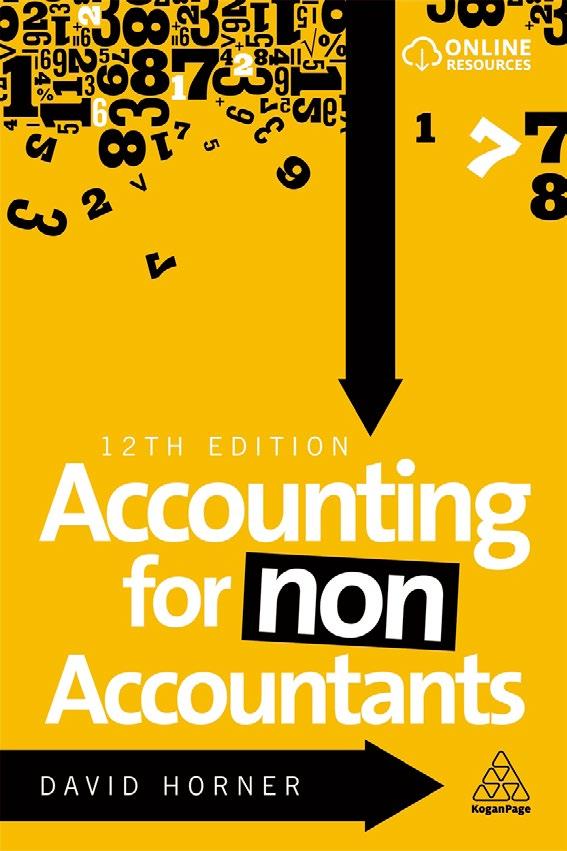
Now in its 12th edition, Accounting for Non-Accountants has been fully updated to the latest regulatory requirements including the UK GAAP framework, International Financial Reporting Standards (IFRS) and International Accounting Standards (IAS). The final chapter focuses on the impact of changes in the economic environment on businesses and there are introductions to areas including tax, transfer pricing and creative accounting. This practical guide includes review questions in each chapter, with answers and workings where appropriate, and is supported online by over 200 questions and a glossary to develop a firm understanding of all topics.
David Horner has taught Accounting and related courses for over 25 years in the UK. He currently teaches at Birkdale school, Sheffield. He has written numerous textbooks aimed at students both for schools and university level. He has worked with AQA, a major examination board in the UK, for over 20 years.
Edition: 12
Date: 05/28/2020
Price: $27.99
Paperback: 9781789664300
Ebook: 9781789664317
Pages: 392
Format (mm): 235x158
Band: Textbook/ Professional
Subject: Accounting & Finance
• Introduces the basic principles of financial accounting, reporting and performance appraisal in an engaging and accessible way

• Written for an international audience using terminology which is compliant with International Financial Reporting Standards (IFRS)
• Includes a range of in-text features such as in-text definitions, worked examples, multiple-choice questions, extended problems and learning quizzes
• Features case studies including Huawei and Ryanair and a fictional case study presented throughout the chapters
• Online resources: lecture slides, bank of 250 self-test questions, short video tutorials, interactive balance sheets and accompanying questions
This textbook introduces the essential principles of financial accounting to nonaccounting students, written for an international audience with global case studies and a suite of learning features.
Using terminology which is compliant with International Financial Reporting Standards (IFRS), Financial Accounting and Reporting for Non-Accounting Students covers topics such as the statement of financial position, profit and loss statements, non-current assets, inventory valuation and the statement of cashflows. It also provides a roadmap for performance appraisal and presents the subjective nature of financial accounting and the impact of bias in financial reporting.
Real-world case studies from Huawei, Ryanair and Greggs illustrate the principles discussed in the book and a fictional performance appraisal case study demonstrates how financial metrics can be applied to analyse the effects of new entrants on an incumbent's operating performance. With over 300 multiple-choice questions, 44 extended problems and more than 90 questions to enable deep learning in the fundamental aspects of this core business subject, Financial Accounting and Reporting for Non-Accountings Students is a key textbook for undergraduate and postgraduate students taking modules on financial accounting and reporting or introductory modules in accounting.
Stephen Frost is Programme Director of the MSc Corporate Finance, MSc Finance and MSc Finance and Investment at Loughborough University. He teaches a wide range of courses at undergraduate and postgraduate levels, including Financial Reporting and Performance Appraisal.
Edition: 1
Date: 01/28/2024
Price: $43.99
Paperback: 9781398614086
Ebook: 9781398614093
Pages: 384
Format (mm): 240x170
Band: Textbook
Subject: Accounting & Finance
Introduction
1 Introduction to Financial Accounting
2 The Statement of Financial Position
3 The Income Statement
4 Non-current Assets
5 Inventory Valuation
6 The Statement of Cash Flows
7 Performance Appraisal
8 Financial Accounting Issues
9 Learning Solutions
• Each chapter is written by a high-profile specialist, in association with the Network of Independent Forensic Accountants, bringing the latest industry insights to the topics covered
• Considers the Forensic Accountant in practice, using case studies throughout from a number of different regions and sectors to demonstrate the link between theory and forensic accountancy in the professional world
• Offers comprehensive coverage of all key forensic accounting topics, such as taxation, financial analysis and modelling and auditing and reporting while also covering areas of current interest to the sector, including financial crime, fraud and cyber crime while sharing expertise on civil disputes and litigation and expert witnessing and dispute resolution
• Online Resources: PowerPoint lecture slides and links to regional updates
A complete guide to Forensic Accounting and Finance, this book is ideal for advancedlevel students and new or mid-level forensic accounting professionals looking to boost their specialist knowledge as part of their CPD, for accountants who wish to build more knowledge in this skills area or advanced undergraduates who feel ready to stretch themselves.

Demand for expertise in this field is growing, and Forensic Accounting and Finance offers a complete, accessible and affordable guide, combining coverage of principle theory with the real and practical needs of the professional. Written by a strong academic and practitioner author team and in association with the Network for Independent Forensic Accountants, this book covers all forensic accounting topics from forensics as an extension of auditing and the basic principles of forensic accounting, to financial analysis and modelling, financial reporting, financial crime, and IT systems.
Forensic Accounting and Finance shares current examples and case studies, highlighting cultural differences for key topics with updated regional legislation information available online for those looking for a truly global approach which is always up to date. Online supporting resources include PowerPoint lecture slides and links to regional updates.
Bee-Lean Chew is an experienced member of the forensic accounting team at Wilder Coe Ltd., a director of the Network of Independent Forensic Accountants and a provider of CPD training to solicitors and fellow business professionals. The author trained with Wilder Coe Ltd., becoming partner in 2005. A Chartered Accountant, Ms Chew has a Law degree from Kent University, a Master's degree in Finance from the University of Strathclyde and is an ICAEW-accredited Forensic Accountant.
Edition: 1
Date: 08/28/2017
Price: $59.99
Paperback: 9780749479992
Ebook: 9780749480004
Pages: 288
Format (mm): 233x156
Band: Textbook
Subject: Accounting & Finance
1 The forensic accountant in practice [Fiona Hotston Moore and Simon Martin]
2 The forensic accountant as expert witness [Niamh M Brennan]
3 Forensic accountancy and taxation [Tim Cook]
4 Forensic accountancy and fraud [David Muggridge]
5 Fraud prevention [Steven Toms]
6 Professional negligence [Adam Stronach and Christopher Hatcher]
7 Valuations [Brian Spencer and Christopher Hatcher]
8 Audit and financial reporting [Bee-Lean Chew]
9 Crime [Andrew Donaldson and Adam Calvert]
10 Commercial disputes [Kate Hart]
11 Forensic accountancy in matrimonial cases [Kate Hart]
12 Insolvency [Norman Cowan]
13 Personal injury [Christopher Hatcher]
• Explains how value pricing is the fairest and most profitable option for accountants and bookkeepers, and a better alternative to hourly billing

• Contains clear guidance on becoming more confident and comfortable with your pricing strategy and how to avoid pricing too low
• Describes how to identify the right kind of client, the critical steps to pricing a new client and powerful strategies to re-price existing clients without losing them
• Features benchmarking research on how thousands of accounting professionals price their services and dozens of case studies of firms which implemented value pricing
• Covers all aspects of pricing, including creating effective packages, setting out a fixed price agreement and building scope creep into the price
Accountants and bookkeepers are working long hours but not making the profits they should. A value pricing strategy can lead to better prices for accounting professionals and better results for their clients.
The concept of value pricing is simple to understand but many accountants struggle with the price conversation and lack the confidence to charge higher prices. Value Pricing for Accounting Professionals is a practical guide to building a clear pricing strategy, feeling more confident and increasing earnings. It covers the critical steps to pricing a new client and how to re-price existing clients without losing them by quantifying value.
The book's step-by-step approach is backed up by dozens of real-life case studies of firms which applied these methods to get better results, along with benchmarking research based on a survey of thousands of accounting professionals. There is guidance on calculating a profitable price, creating effective packages and managing the 'invisible' cost of scope creep, and new insights into meeting clients remotely and pricing in difficult economic times. Become more profitable and deliver extraordinary solutions to clients with this essential guide to effective value pricing.
Mark Wickersham is a Chartered Accountant, speaker and sought-after profit improvement expert. Since selling his own accountancy practice in 2006 he has trained and mentored hundreds of accountants around the world on how to improve their value pricing techniques and strategies. He has built a large, international online community with The Value Pricing Academy, The Bookkeepers' Pricing Academy and the private Facebook group, Value Pricing with Mark Wickersham.
Edition: 1
Date: 07/28/2022
Price: $41.99
Paperback: 9781398605374
Ebook: 9781398605381
Pages: 280
Format (mm): 235x155
Band: Professional
Subject: Accounting & Finance
1 The problem with the old-fashioned way of pricing accounting services
2 What the research tells us
3 Overcoming a lack of confidence when pricing
4 What makes a great pricing strategy?
5 How does pricing change in a postCOVID world?
6 The foundations of value pricing
7 The structure of the value conversation
8 How to price a new client
9 How to prequalify prospects so you avoid the time wasters
10 The questions to ask the client to determine value
11 Giving clients a choice – Your first step to value pricing
12 How to create effective packages
13 How to calculate a profitable price
14 How to properly build scope into the price so you never make a loss
15 How to set out your fixed price agreement
16 How to identify and tackle scope creep
17 How to re-price your existing clients without fear of losing them
18 How to get clients to value what you do for them
19 How to quantify the value to your client
20 The reason your clients are clueless about price and how that helps you
• Introduces what can sometimes be a difficult, technical subject in a highly accessible, engaging way
• Is rooted in Europe rather than adapted from a US text, but draws on examples and practice from around the world
• Adopts a practical approach, drawing on the authors' many years of experience working in the financial sector to illustrate concepts with real-world examples and practice, making it the perfect choice for those preparing for a career in finance and investment
• Offers a concise introduction, supported with links to further reading and self-directional study
• Online resources: Lecture slides and figures from the book
For students of finance at both undergraduate and postgraduate level, or those preparing for professional examinations, Investment and Portfolio Management develops knowledge and understanding of the key financial products, investment strategies and risks in financial markets in the UK and internationally.
With an emphasis on practice, Investment and Portfolio Management presents the theory and its relevance and application in the financial workplace. The authors draw on their experience working in the financial sector to illustrate concepts with case studies, examples and problems, including material relevant to candidates studying for professional examinations offered by the major professional bodies in the subject area (Charted Institute of Investment, CII & Chartered Institute of Securities and Investment, CISI). Each chapter is written in an easy-to-follow style, allowing readers to navigate their way through different topics without issue, avoiding complicated technical jargon, in favour of simpler terms and writing style. To meet the criteria for those studying for academic and professional courses, links are provided to more in-depth material and in-chapter features to encourage selfdirectional learning.
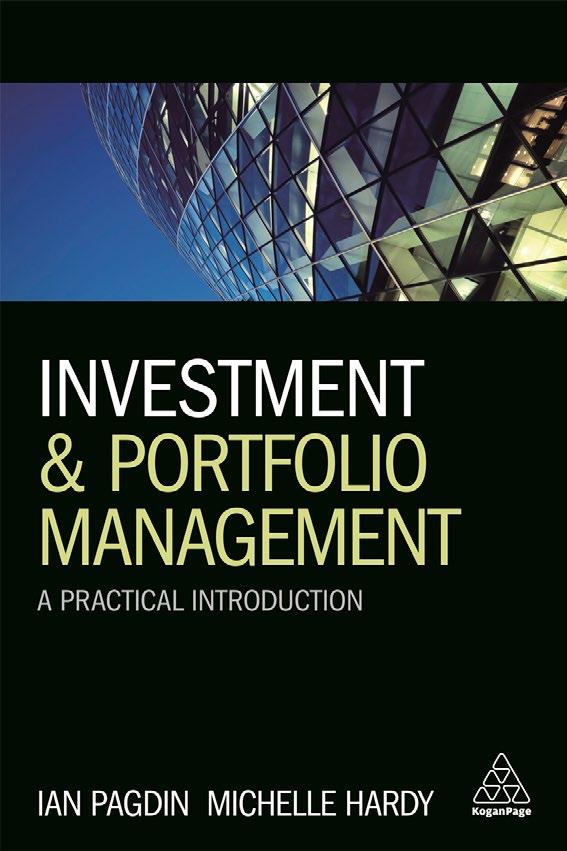
Online supporting resources for this book include lecture slides and figures from the book.
Ian Pagdin is Course Leader for Banking & Finance Masters and a variety of finance and international finance courses at Sheffield Hallam University. His background is finance, having worked in the finance industry for 22 years, including 19 years as an independent financial adviser.
Michelle Hardy is a senior lecturer and module leader for several key modules on a variety of finance and international finance courses at Sheffield Hallam University. Her background is corporate banking and international wealth management for 14 years. She is a fellow of the Institute of Chartered Accountants in England and Wales
Edition: 1
Date: 11/28/2017
Price: $79.99
Paperback: 9780749480059
Ebook: 9780749480066
Pages: 616
Format (mm): 235x156
Band: Textbook
Subject: Accounting & Finance
1
2
3
4
2
3
11
4
11

• Offers a step-by-step framework navigating each phase of corporate venturing from design to completion, designed to make all involved stakeholders address the necessary aspects
• Provides a valuable tool on how to measure and capture the return on innovation, improving the transparency and traceability of value creation
• Takes an evidence-based, data-driven approach to corporate venturing to steer users to make informed decisions tailored to their organizations
• Offers valuable guidance on how to manage the underlying dynamics and mechanics of corporate venturing and avoid pitfalls, underpinned by cutting-edge research and best practice insights
• Partners with some of the biggest, most established and best-in-class corporate venture organizations to provide best practice cases, examples and insights
Corporate venturing is a key strategic growth tool, but it is also complex and most programmes fail. Learn how to successfully manage, measure and improve a corporate venturing programme with this one-stop strategic guide.
The Corporate Venturing Handbook delivers phase-by-phase guidance on the effective set-up, operation and termination of a corporate venturing programme. Shedding light on how corporate venturing actually works in practice, it outlines how to manage its underlying dynamics and avoid pitfalls. Its intuitive and systematic framework navigates users through meeting objectives and expectations so they can successfully generate value for their organizations. The framework is evidence-based and data-driven, steering users to make informed decisions specifically tailored to their own organizational needs, and also offers a valuable tool to help measure and capture the financial and strategic return on innovation, improving the transparency and traceability of value creation.
Readers will also benefit from best practice insights, cases and examples from some of the biggest and most longstanding corporate venturing programmes in the world, including Siemens Healthineers, Shell Ventures, Axa Venture Capital and Strategic Capital, PM Equity Partner, Nestle and Samsung.
Dietmar Grichnik is Director of the Institute of Technology Management at the University of St. Gallen, Switzerland.
Manuel Hess is Assistant Professor at the Global Centre for Entrepreneurship and Innovation, University of St. Gallen, Switzerland.
Jana Reuther is Research Associate at the Chair for Entrepreneurship at the University of St. Gallen, Switzerland.
Alexander Stoeckel is Director of Venture Capital at Philip Morris International in Lausanne, Switzerland.
Edition: 1
Date: 01/28/2024
Price: $47.99
Paperback: 9781398613577
Ebook: 9781398613591
Pages: 288
Format (mm): 234x156
Band: Professional/ Academic
Subject: Accounting & Finance
Getting started
1 Profiling
1 What is your CV profile?
2 Who is involved and who is your main promotor?
3 What is your funding size and duration?
4 What is your main investment focus?
5 CV Cockpit I
6 Summary: CV mandate
2 Designing
7 What’s your structure and governance?
8 What does your team look like?
9 Which communication style do you take?
10 Which environment do you claim?
11 What’s your portfolio approach?
12 CV Cockpit II
13 Summary: CV Programme
3 Operating
14 How is your sourcing and portfolio managed?
15 What form of collaboration do you operate?
16 Which shared resources and syndication are available to you?
17 CV Cockpit III
18 Summary: CV value-add
4 Harvesting
19 How to terminate your CV programme
20 How to continue your CV programme
21 CV Cockpit IV
5 MISSION ACCOMPLISHED
22 What are the common pitfalls and success factors
• Considers Islamic banking and finance as a multi-level service system, an approach which will enable students and professionals of Islamic finance to gain a more in-depth, holistic understanding of how the system functions
• Offers four cutting edge, in depth case studies that clearly demonstrate how the system operates in different types of financial systems
• Is written by Karim Ullah, a key player in Islamic finance in Pakistan, having played a major role in setting up the Centre for Excellence in Islamic Finance there
• Presents a much needed up to date resource for a growing global industry thirsty for new sources of knowledge.
WINNER: The HEC Outstanding Research Award 2019
Understanding Islamic Financial Services offers fresh insights on the Islamic financial system. The importance of this system cannot be underestimated. Experts expect that it is likely to sustain double digit growth globally over the next few years, and demand for professionals in the area has never been higher, both in the UK and around the world.
While other texts on the subject look at the basic concepts, principles, contracts and financial products used in Islamic banking and finance, Understanding Islamic Financial Services goes one step further and provides a new context, identifying four levels on which the Islamic Financial system operates: product level, institution level, market level and intermarket level. It considers Islamic banking and finance as a multi-level service system, an approach which will enable students and professionals of Islamic finance to gain a more in-depth, holistic understanding of how the system functions.
Understanding Islamic Financial Services covers contemporary developments in service science (e.g. service theories, service visualization tools and service co-creation concepts) and implications for the development and sustainability of Islamic financial services

Examples from practice enliven the text and allow the reader to relate the theories and principles discussed to current practice.
Karim Ullah is Assistant Professor and Islamic Financial Services Co-ordinator, Centre for Excellence in Islamic Finance at the Institute of Management Sciences. He has taught extensively in the areas of Islamic banking and finance, business finance and managerial finance, amongst others.
Wafi Al-Karaghouli is Senior Lecturer in Operations and Project Management, Brunel University. He has extensive experience within multinational companies and Higher Education.
Edition: 1
Date: 04/28/2017
Price: $59.99
Paperback: 9780749480516
Ebook: 9780749480523
Pages: 232
Format (mm): 235x156
Band: Textbook
Subject: Accounting & Finance
1 History and Development of the Islamic Financial System
2 Islamic Law (Shariah), Economics, and Financial System
3 Core Elements of the Islamic Financial System
4 Multi-Level Islamic Financial System
5 Product Level Development of Islamic Financial System
6 Institution Level Development of Islamic Finance
7 Market Level Development of Islamic Financial System
8 Inter-Markets (Ecosystem) Level Development of Islamic Financial System
9 Adaptability and Sustainability of Islamic Financial System
• Includes a highly accessible, engaging introduction to what can sometimes be a difficult, technical subject
• Draws on examples from practice from around the world to offer a truly global approach
• Offers an up-to-date approach to the subject post global financial crisis
• Provides a glossary to accompany the text, offering instant access to key terminology
• Online Resources: PowerPoint lecture slides
International Finance offers a clear and accessible introduction to the fundamental principles and practice of international finance in today's world, from the international financial environment and exchange rates, to financing multinational companies and international investment. The theory and techniques are presented with the non-financial manager in mind, and the theoretical material is supplemented by case studies and a discussion of the appropriateness of the various techniques and principles to solve practical problems. This book draws from examples and practice around the world, helping students of international corporate finance, particularly non-specialist finance students, understand the complexities of modern Europe and comparative systems of finance globally.
International Finance is essential reading for anyone studying international finance or needing an up-to-date, engaging resource to help them navigate the complicated and ever-changing global financial world. Key theories and terms are explained and defined, avoiding unnecessary jargon and acknowledging that many readers are coming to the subject with little or no prior knowledge of corporate finance at all. Online supporting resources include PowerPoint lecture slides.

Dora Hancock has over 30 years' teaching experience at universities in the UK including Birmingham City University and Leeds Beckett University. Recently, her teaching has focused solely on finance, including international, corporate and investment finance on undergraduate, postgraduate and professional courses. She has taught UK and international students. The author is passionate about teaching and writing materials for students and lecturers to use.
Edition: 1
Date: 01/28/2018
Price: $51.99
Paperback: 9780749480011
Ebook: 9780749480028
Pages: 248
Format (mm): 235x156
Band: Textbook/ Professional
Subject: International Finance
1 The International Financial Environment
1 The Rise of the Multinational and the International Monetary System
2 The Institutions and Participants that Make Up the Global Financial System
3 The History of Exchange Rates, the IMF and the World Bank
4 The Euro and the Global Financial Environment
2 Exchange Rates
5 Exchange Rate Regimes
6 Parity Conditions and Forecasting Exchange Rates
7 Currency Markets
8 Measuring and Managing Exchange Risk
3 Financing the International Company
9 Financing International Trade
10 Long Term Sources of Finance
11 International Cash Management
4 International Investment
12 Investing Directly in Foreign Enterprises
13 International Investment Appraisal
14 Country Risk Analysis
15 Long–Term Financing
16 Capital Structure
• Contains international case studies and examples of cross-border transactions from across the globe
• Features a section on risk management and its potential impact on the physical flow of goods and the cost of insurance
• Contains a comprehensive glossary to demystify all the key terms associated with international trade and finance to ensure that readers can use them confidently
• Provides a complete and thorough assessment of all the issues involved in the international financing process as well as key insight into the financing process by describing it from the perspectives of both the buyer and the seller
• Is full of practical examples and easy-touse templates to ensure practitioners are complying with best practice
• Online Resources: PowerPoint lecture slides
International trade, and its financing, is now a key component of many undergraduate and postgraduate qualifications. For anyone involved in international sales, finance, shipping and administration, or for those studying for academic or professional qualifications in international trade, The Handbook of International Trade and Finance offers an extensive and topical explanation of the key finance areas. This essential reference resource provides the information necessary to help you to reduce risks and improve cash flow, identify the most competitive finance alternatives, structure the best payment terms, and minimize finance and transaction costs.
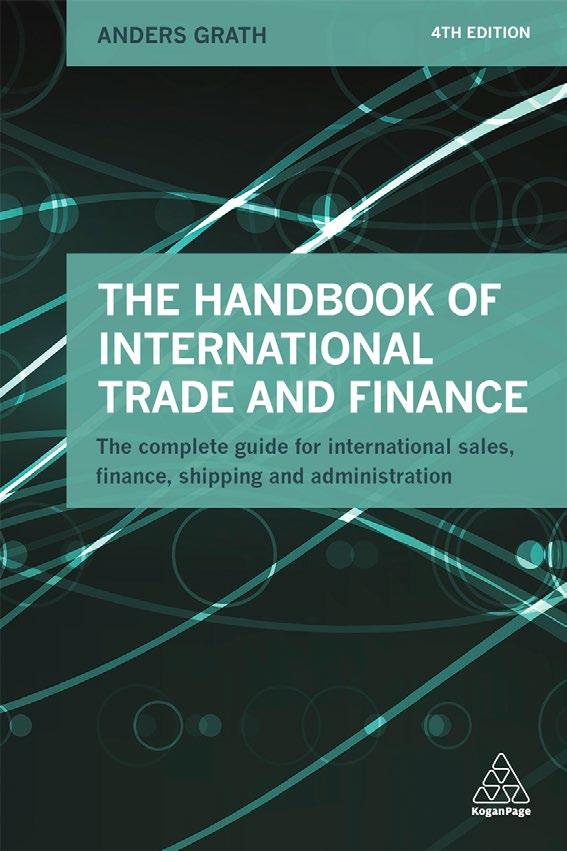
This fully revised and updated 4th edition of The Handbook of International Trade and Finance also describes the negotiating process from the perspectives of both the buyer and the seller, providing valuable insight into the complete financing process, and covering key topics such as: trade risks and risk assessment; structured trade finance; methods and terms of payment; currency risk management and bonds, guarantees and standby letters of credit.
The Handbook of International Trade and Finance provides a complete and thorough assessment of all the issues involved in constructing, financing and completing a crossborder transaction, as an indispensable guide for anyone dealing with international trade. The new edition also includes a section on risk management, which plays an increasingly important role in international trade from currency fluctuations to political risk and natural disasters.
N.B. This covers the principles of international trade and finance that are common across the globe and is relevant to anyone wanting to understand the subject, wherever they are located. Specific national issues (such as the UK's Brexit decision) do not affect the content. Online supporting resources include PowerPoint lecture slides.
Anders Grath has over 25 years' experience in international trade and finance within major European financial institutions, as head of both international departments and corporate units. He is the author of a series of similar titles on individual country markets.
Edition: 4
Date: 08/28/2016
Price: $79.99
Paperback: 9780749475987
Ebook: 9780749475994
Pages: 264
Format (mm): 234x158
Band: Textbook/ Professional
Subject: International Finance
1 Trade risks and risk assessment
2 Methods of payment
3 Bonds, guarantees and standby letters of credit
4 Currency risk management
5 Export credit insurance
6 Trade finance
7 Structured trade finance
8 Terms of payment
9 The export quotation
• Shows how to embed green and sustainable finance principles and practice into finance advice, analysis and decisions to lead a successful transition to net zero
• Covers risk and regulation in green finance, international market frameworks and standards, and the role of a range of financial institutions and markets
• Considers ethics and professionalism, and how the finance sector can mainstream green finance

• New to this edition: recent assessments of climate science from the IPCC, extended coverage of sustainability reporting and carbon accounting, and regulatory and market developments in sustainability risk management; material on the rapid growth of sustainable lending and investment and the latest finance sector alliances and initiatives
• Endorsed by the Chartered Banker Institute as the core text for the benchmark Certificate in Green and Sustainable Finance
To achieve society's goals, as set out in the UN Sustainable Development Goals and the Paris Agreement, the finance sector has a crucial role to play in driving sustainable business and the transition to a net zero economy.
To achieve this change, it is vital for the finance sector to allocate capital to the firms, investments and activities looking to create a more sustainable world. Green and Sustainable Finance offers a comprehensive guide to green and sustainable principles and practice in banking, investment and insurance to help finance professionals manage sustainability risks and support their clients and customers in transition. Given the need for urgent, rapid and sustained change, it is essential that all finance professionals understand and apply these principles so that every professional financial decision takes account of sustainability.
Written by the CEO of the Chartered Banker Institute this fully updated second edition includes the most recent assessments of climate science from the IPCC, extended coverage of sustainability reporting and carbon accounting, and regulatory and market developments in sustainability risk management. It also features material on the rapid growth of sustainable lending and investment and the latest finance sector alliances and initiatives. Endorsed by the Chartered Banker Institute as the core text for the global benchmark Certificate in Green and Sustainable Finance, this book is essential reading for finance professionals, university students and individuals working to embed sustainability in business, finance, policy and regulation.
Simon Thompson is Chief Executive of the Chartered Banker Institute. He leads the UK's Green Finance Education Charter initiative and is a former Vice President of the European Bank Training Network. Simon is a Fellow of the Chartered Banker Institute, a Member of the Chartered Institute of Personnel and Development and holds an MBA from the University of Edinburgh.
Edition: 2
Date: 03/28/2023
Price: $69.99
Paperback: 9781398609242
Ebook: 9781398609259
Pages: 664
Format (mm): 240x172
Band: Professional/ Academic
Subject: Sustainable Investment
Introduction – About Green and Sustainable Finance – Principles and practice in banking, investment and insurance
1 An introduction to green and sustainable finance
2 Climate change and our changing world
3 Building a sustainable financial system: International, national, industry and institutional responses
4 Measuring and reporting impacts, alignment and flows of green and sustainable finance
5 Risk management
6 Responsible retail, commercial and corporate banking
7 Green and sustainable bonds
8 Central and development banks
9 Responsible and sustainable investment
10 Insurance – impact underwriting
11 Green and sustainable FinTech
12 The future of green and sustainable finance
• This insider's guide optimizes the opportunities for sustainable finance while noting and addressing the challenges with solutions
• Helps readers to avoid common pitfalls with its balanced and realistic take on sustainable investing
• Covers topics such as ESG ratings, data and disclosure, multi-asset portfolios and public equity markets
• Supported by fresh insights and viewpoints from a range of top-tier expert commentators including Richard Curtis, Professor Robert G. Eccles and Catherine Howarth.
• Written by an experienced author team who built one of the financial industry's fastest growing and most decorated sustainable investing franchises
The compelling promise of progressing profits, purpose and the planet is what drives sustainable investing. Yet the field is also packed with challenges and pitfalls for the finance industry.
Sustainable Investing in Practice provides a pragmatic steer for how finance professionals can navigate the realities of ESG investing so they can achieve the impact they desire. It addresses the obvious problems - a lack of common standards, opaque vocabulary, irrelevant data - that investors face. And it explains the skewed incentives and compromises that have held sustainable investing back. Yet it does not dwell on obstacles and defeat. Instead, it shows readers how to develop sustainable strategies and improve outcomes, covering critical topics such as ESG ratings, data and disclosure policies and multi-asset portfolios, while also documenting successful practices and pointing out how to modify inadequate ones.

Packed full of insightful examples, analysis and interviews from expert commentators such as Paul Polman KBE, Richard Curtis OBE, and Gillian Tett, the book provides useful ideas and plans for how to take sustainable finance forward while balancing credibility and commerciality in equal measure. Written by two pioneering leaders within sustainable investing, this is a mustread for every finance professional, investor and regulator-whether they are seeking to fast track their careers, bring commercial and sustainable learning to their organization, or upgrade their understanding of this crucial but complex topic. It will also be of interest to students taking modules on sustainable finance.
Simon Smiles was a Group Managing Director at UBS and the Chief Investment Officer for Ultra High Net Worth Clients, where he established and ran the wealth management sustainable and impact investing teams. An IIF Future Leader, WEF Young Global Leader and member of the Milken Institute's Young Leaders Circle, he appeared regularly in global financial media speaking about sustainability and investments. Before moving to Zurich, he worked in Sydney and Hong Kong and earned a PhD in economics from the Australian National University.
James Purcell is the Group Head of Sustainable Frameworks at Credit Suisse. He and his team coordinate the firm's approach to sustainable investing and lending. Previously, he was the Group Head of Sustainable, Thematic and Impact Investing at Quintet Private Bank, a privately held bank operating out of 50 cities across Europe. Earlier in his career he was a managing director at UBS, where he spent more than a decade in roles based in London, Hong Kong, and Zurich.
Edition: 1
Date: 01/28/2023
Price: $49.99
Paperback: 9781398607903
Ebook: 9781398607910
Pages: 344
Format (mm): 235x155
Band: Professional/ Academic
Subject: Sustainable Investment
Introduction
1 What is sustainable investing?
2 Sustainable data and ESG ratings
3 Sustainable public equity markets
4 Sustainable public debt markets
5 Sustainable private markets
6 Themes and the United Nations Sustainable Development Goals
7 Sustainable multi-asset portfolios
8 Conclusion
• Combines theoretical and commercial perspectives informed by the author's professional experience and academic research
• Thoroughly explains key technologies and emerging business models in a clear and accessible manner for those with no technological background
• Includes a mix of international case studies from large financial services organizations and smaller start-ups, including Lloyds Bank, TransferWise, Generali, Starling and Stocktwits
• Covers the topics required for postgraduate and undergraduate Financial Technology courses and includes learning objectives and discussion questions based on case studies
• Online resources: PowerPoint slides for lecturers and additional case studies.
With the continued success of fintech (financial technology) businesses around the world, financial services are becoming increasingly de-centralized, personalized, and automated.
This new textbook strikes a balance between academic depth and commercial relevance in examining the advantages and challenges of these changes through the lens of various analytical frameworks. Financial Technology demystifies key technologies, such as blockchains, APIs, AI, machine learning, and cloud computing, in a clear and accessible style suitable for readers with no technological background.
Real-world case studies from a variety of international organizations including Lloyds Bank, TransferWise, Generali, Starling and Stocktwits, bridge the gap between theory and practice and contextualize learning in terms of real businesses, from large incumbents to smaller start-ups. With coverage of robo-advisors, mobile-only banks, open banking and risk and regulation, this book also explores a range of analytical frameworks to critically examine new technologies and emerging business models.
Financial Technology enables readers to understand the fintech movement in the context of recent financial history, examine the key drivers of change and form insights about the financial system in a forward-looking and global manner. Online resources include PowerPoint slides for lecturers and additional case studies.
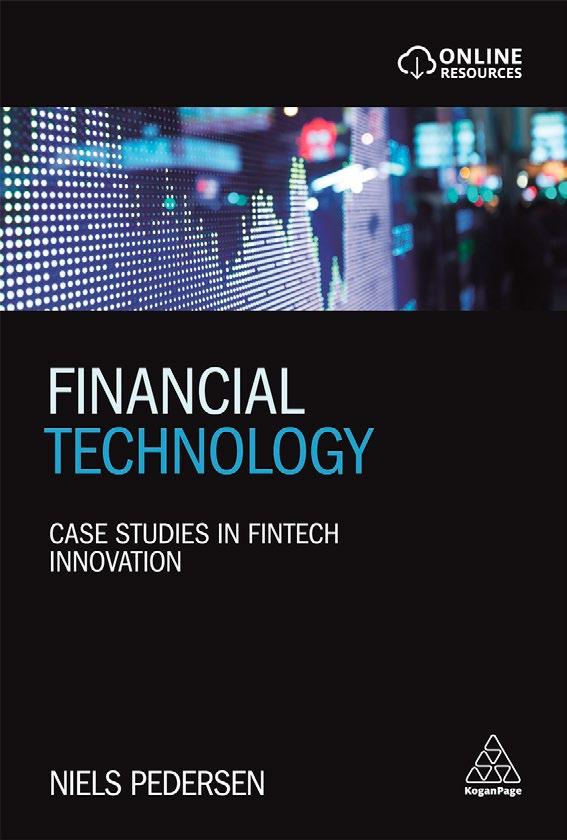
Niels Pedersen is a Senior Lecturer on the MSc Financial Technology programme at Manchester Metropolitan University, UK, and a regular conference speaker on fintech. As a Chartered Accountant (ICAEW), he worked at PwC and the Financial Services Authority before coming to academia.
Edition: 1
Date: 12/28/2020
Price: $52.95
Paperback: 9781789665437
Ebook: 9781789665444
Pages: 272
Format (mm): 240x170
Band: Textbook
Subject: Financial Technology
1 Networks, APIs and fintech banking platforms – How technology is decentralizing finance
2 Disruption and disintermediation – How financial innovation and cloud computing gave birth to the fintech revolution
3 Behavioural economics and experience design – How to optimize user engagement
4 Artificial intelligence and automation in fintech – AI and machine learning in practice
5 Bitcoin, blockchain and cryptocurrencies – The applications of distributed ledger technology in finance
6 Digitizing the price mechanism – The impact of automation and social media on financial markets
7 Financial crime, cybersecurity and risk management – Pitfalls and opportunities in fintech
8 Regtech and regulatory compliance –Financial regulation in a fintech context
9 Looking to the future – Optimization, decentralization and personalization
• Develops the financial intelligence you need to communicate effectively with investors, implement business strategies and pinpoint emerging pathways for profit
• Outlines how to analyze your performance and undertake risk-return assessments to tactically grow your start-up
• Offers proven methods for tracking your start-up's progress to ensure that growth is maintained and continuous
• New to this edition: analysis of financial statements directly from start-ups, new case studies on companies that have scaled up, focus on new digital technologies and market opportunities for start-ups, information on new players and potential future tech startups
More than a third of start-ups fail due to founders having a poor understanding of financial management. Become financially savvy with this easy to understand guide and learn how to effectively grow your business, communicate with investors and progress to the next level.
Start-ups face many challenges but managing the finances does not need to be one. Financial Management for Technology Start-Ups offers a complete financial toolkit on how to use this area of your business to your advantage. This book contains invaluable tools and insights designed specifically for tech start-ups, with a concentrated focus on what is important in financial terms for technology-based and innovation focused entrepreneurial businesses.
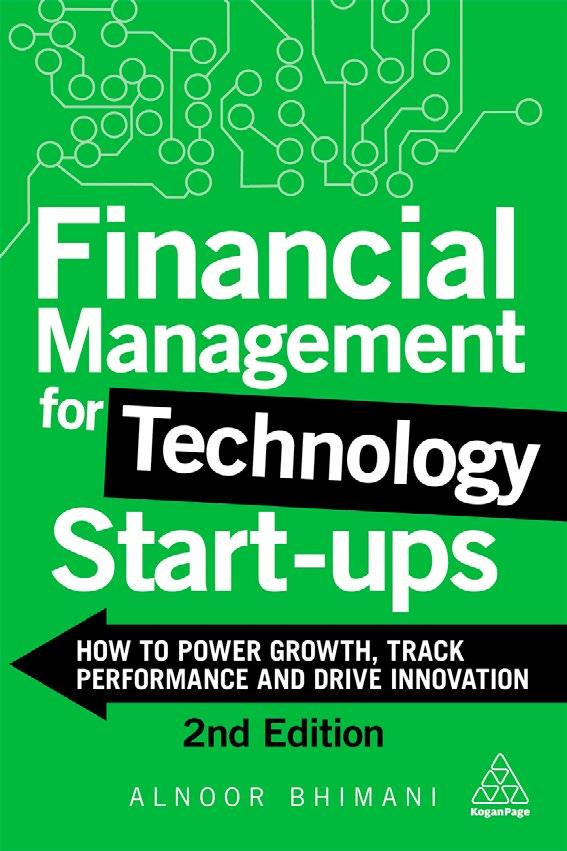
The fully updated second edition offers greater analysis of financial statements directly from real-world start-ups, charts the success of businesses that went from start-up to scale-up with all new case studies and covers new digital technologies, emerging opportunities in the ecosystem, developing markets and much more. For entrepreneurs and tech innovators, this is a must-have book to help take your idea from concept to company with clear and effective financial insights.
Alnoor Bhimani is Professor of Management Accounting at the London School of Economics (LSE) and was previously Head of the Department of Accounting and Founding Director of LSE Entrepreneurship based in London, UK. He regularly delivers business and technology focused talks at conferences and events across the globe, is a professionally certified accountant and has a PhD from LSE and an MBA from Cornell University where he was a Fulbright Scholar.
Edition: 2
Date: 01/28/2022
Price: $25.99
Paperback: 9781398603066
Ebook: 9781398603073
Pages: 248
Format (mm): 235x155
Band: Professional/ Academic
Subject: Financial Technology
1 Now is the Time
2 Tech Start-ups - It’s a Different World
3 Start-up Contribution Analysis
4 Start-up Financial Analysis
5 Start-up Progress Analysis
6 The Importance of Being Liquid
7 What’s it Worth to you
8 Tracking your Start-up’s Growth
9 Glossary
10 Resources
• Explores how banks can collaborate with fintech firms to drive innovation in areas such as cash management, compliance and tax
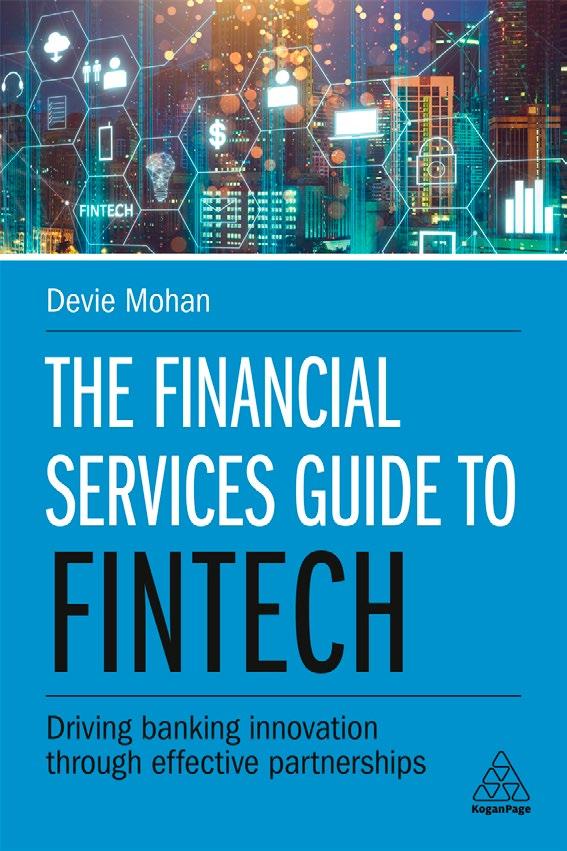
• Explains key fintech segments such as regtech, robo-advisory, blockchain and personal finance management
• Includes case studies and business models of banks who have had successful partnerships including Barclays and Citibank
• Covers key fintech hubs in Europe, Africa, Asia, Latin America and the US
Fintech has emerged as one of the fastest growing sectors in the financial services industry and has radically disrupted traditional banking. However, it has become clear that for both to thrive, the culture between fintech and incumbent firms must change from one of competition to collaboration. The Financial Services Guide to Fintech looks at this trend in detail, using case studies of successful partnerships to show how banks and fintech organizations can work together to innovate faster and increase profitability.
Written by an experienced fintech advisor and influencer, this book explains the fundamental concepts of this exciting space and the key segments to have emerged, including regtech, robo-advisory, blockchain and personal finance management. It looks at the successes and failures of bank-fintech collaboration, focusing on technologies and start-ups that are highly relevant to banks' product and business areas such as cash management, compliance and tax. With international coverage of key markets, The Financial Services Guide to Fintech offers practical guidance, use cases and business models for banks and financial services firms to use when working with fintech companies.
Devie Mohan is a fintech industry advisor and analyst based in London, UK. She is cofounder and CEO of Burnmark, a fintech research company, a contributor to the ING group Think Forward Initiative, and sits on the Editorial Board for the Journal of Digital Banking. She has been listed in the top 10 of various fintech influencer lists. In 2019 she was included in the Financial Times' list of the 100 most influential BAME leaders in technology.
Edition: 1
Date: 01/28/2020
Price: $41.99
Paperback: 9780749486372
Ebook: 9780749486389
Pages: 264
Format (mm): 235x155
Band: Professional
Subject: Financial Technology
1 Banks versus fintechs during the economic crisis
2 Fintech for customer experience
3 Early collaboration models
4 Widening of the fintech ecosystem
5 Emerging markets driving innovation
6 Governments and fintech hubs
7 Fintech segments at play
8 B2B fintech
9 Collaboration models within fintech
10 Challenger banking
11 Data and analytics
12 Conclusion
• Supports the Chartered Banker Institute's Professionalism and Ethics module requirements and helps prepare for assessment
• Includes case studies, further reading and viewing recommendations, and definitions of key terms throughout
• Analyzes the evolution of the bank's role in society and examines the impact of legislation, regulation and governance on banking operations
• Offers a range of ethical theories and their applicability to banking and finance
• Online resources: a glossary and information on further sources
Endorsed by the Chartered Banker Institute as core reading for its professional qualifications, Culture, Conduct and Ethics in Banking emphasizes the importance of professionalism for banks, and explores how all staff play a key role in putting customers at the heart of their business.
Taking an applied approach, it aims to develop the reader's capability to: recognize and contribute towards balanced outcomes for consumers and organizations; understand the impact of reputational deficit; and understand the personal impact of an individual in the workplace.
From a discussion of the main branches of ethical thinking to an overview of regulation and legislation in the UK and internationally, this book covers the theory and practice of conduct and professionalism in banking. Chapters contain activities and industry case studies, and further reading and viewing suggestions are included to help develop a deeper understanding of the topics covered. With fully referenced discussion of conflicts of interest, decision making models, the role of professional bodies, corporate governance, conduct risk management and the Global Financial Crisis 2007-08, Culture, Conduct and Ethics in Banking is the essential guide for finance professionals.

Fred Bell is an experienced career banker with extensive risk management leadership expertise. Working over 39 years in the Royal Bank of Scotland (RBS), he has held senior leadership roles including Head of Operational Risk in the RBS Wealth Division, Head of Risk at Tesco Personal Finance and Head of the RBS Bank of China Risk Programme. Bell established and ran RBS's first dedicated business continuity function.
Edition: 1
Date: 12/28/2019
Price: $55.99
Paperback: 9780749482909
Ebook: 9780749482916
Pages: 376
Format (mm): 234x156
Band: Textbook
Subject: Banking
Introduction
1 Ethics theory
2 Professionalism and ethics in banking
3 Ethical decision making in practice
4 A short history of banking
5 An overview of regulation and legislation in banking
6 Corporate governance
7 Conduct and culture in banking
8 Conduct risk management
9 Corporate social responsibility and environmental issues
10 Ethics and technology
• Supports the Chartered Banker Institute's Personal and Private Banking module requirements and helps to prepare for assessment
• Is written by a banking sector expert with cutting-edge industry perspective, ideal to support students of banking in professional training or at undergraduate and postgraduate level
• Aids work-based learning and professional development with a highly practical and applied approach, bringing learning to life with activities to carry out in the workplace as well as case studies, further reading recommendations and definitions of key terms throughout
• Offers thought leadership on retail and digital banking from an expert author with over 39 years of experience in the sector, endorsed by the Chartered Banker Institute
• Online resources: includes a glossary and updates to regulation
Endorsed by the Chartered Banker Institute as core reading for the Personal and Private Banking module, Retail and Digital Banking looks at the changes that have occurred, including developments in onshore and offshore operations, call centres and the impact of technology and other critical factors in retail and digital banking. This book considers the evolution of retail banking services and the major role that technology has played in providing quality, cost-effective services to consumers. This fascinating text then goes on to offer expert thought leadership on the future of retail banking and what this could mean for existing established banks and disruptive new entrants.
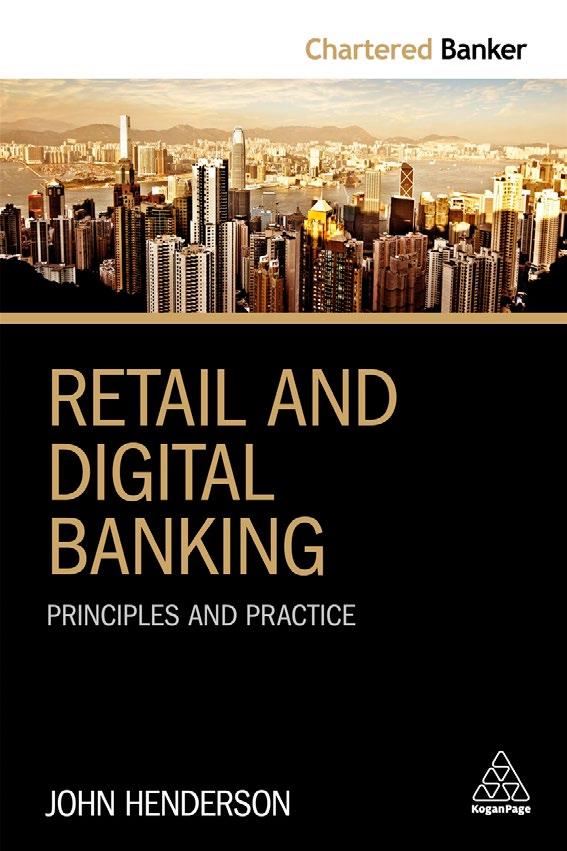
Retail and Digital Banking offers readers the opportunity to take a step back and consider the evolution of the sector in which they work and the tremendous level of change that has occurred over time for all operational activity. Retail and Digital Banking provides support for the Personal and Private Banking module assessment and features practical case studies from the banking sector. This essential text brings the journey of modern banking to life and considers what the future holds. Online supporting resources include a glossary and updates to regulation.
John Henderson has over 30 years' experience in the banking sector, having held a number of roles for the Bank of Scotland, Sainsbury's Bank, the Royal Bank of Scotland (RBS) and NatWest. He began his career working in retail branches but has also been Regional Training Manager, headed up the Treasury Department and other operational risk services, managed quality for an operational call centre business and also led branch design and distribution. His current role is with the RBS Group, where he manages the offshoring portfolio. The author is a Fellow of the Chartered Banker Institute.
Edition: 1
Date: 10/28/2018
Price: $59.99
Paperback: 9780749482718
Ebook: 9780749482725
Pages: 280
Format (mm): 235x155
Band: Textbook
Subject: Banking
Introduction
1 The birth and development of retail banking
2 The growth of retail banking and its place in the economy
3 Problems and opportunities caused by financial crises
4 Preparing for external trends and influences to deliver high-quality income and cost-effective services
5 Disruption in the market
6 Distribution of retail banking services via a range of customer channels
7 Multi-channel versus omni-channel
8 The role of technology in the evolution of retail banking
9 The impact of legislation and regulation on retail banking operations
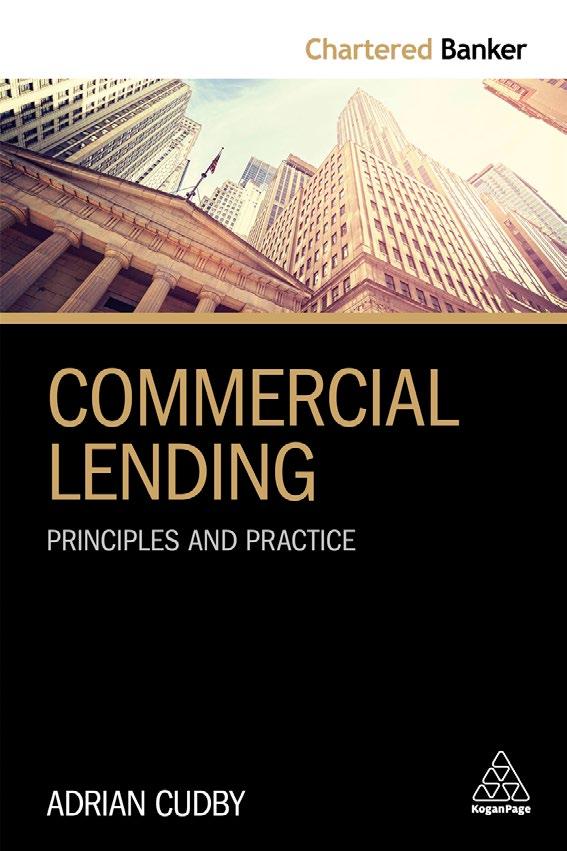
• Supports the Chartered Banker Institute's Commercial Lending module requirements and helps to prepare for assessment
• Is written by a banking sector expert with cutting-edge industry perspective, ideal to support students of banking at undergraduate and postgraduate level
• Aids work-based learning and professional development with a highly practical and applied approach, bringing learning to life with activities to carry out in the workplace as well as case studies, further reading recommendations and definitions of key terms throughout
• Offers additional numeracy support to help readers with practical lending work, such as assessing balance sheets and understanding financial reports and documents
• Offers thought leadership on commercial lending from an expert author with over 30 years of experience in the sector, endorsed by the Chartered Banker Institute
• Online resources: includes a glossary and updates to regulation
Endorsed by the Chartered Banker Institute as core reading for one of the modules leading to the Institute's professional qualifications and chartered status, Commercial Lending supports readers that wish to develop their ability to analyze the creditworthiness of a customer and their business in the context of the current economic climate, future market and sector expectations.
Commercial Lending uses a series of practical exercises and case studies, and provides the tools needed for the reader to understand and appraise a customer's business strategy. This will then enable the reader to provide appropriate funding solutions to meet the commercial needs of customers while reflecting the bank's risk appetite. These tools include: how to assess the performance and creditworthiness of a business; how to critically evaluate the robustness of cash flow; and how to undertake sensitivity analysis to quantify sustainable debt repayment capacity. This practical text will present a critical analysis of financial and non-financial information to help readers identify key risks inherent in the customer's lending proposition. Readers will go on to propose suitable funding solutions that mitigate risk and meet the needs of customer and bank. Online supporting resources include a glossary and updates to regulation.
Adrian Cudby runs his own financial training and consulting business based in Edinburgh, UK. His clients range from international financial institutions to individuals who require one-to-one mentoring and coaching. He is a professional banker (ACIB) with over thirty years' experience in the industry. He has a Master's Degree in Business Administration and holds a Postgraduate Certificate in Higher Education.
Edition: 1
Date: 10/28/2018
Price: $59.99
Paperback: 9780749482770
Ebook: 9780749482787
Pages: 352
Format (mm): 235x157
Band: Textbook
Subject: Banking
1 The relationship between the bank and the customer
2 The financial analysis of businesses
3 Cash analysis
4 How to structure a lending proposition
5 The strategic analysis of business
6 Securities for lending
7 Lending products
8 Management and leadership
9 Businesses facing financial difficulties
10 Glossary
• Supports the Chartered Banker Institute's Personal & Private Banking and Commercial Lending modules requirements and helps to prepare for assessment
• Is written by banking sector experts with cutting-edge industry perspective, ideal to support students studying banking at undergraduate and postgraduate level
• Aids work-based learning and professional development with a highly practical and applied approach, bringing learning to life with activities to carry out in the workplace as well as case studies, further reading recommendations and definitions of key terms throughout
• Offers thought leadership on relationship management from expert authors with over 50 years of combined experience in the sector, endorsed by the Chartered Banker Institute
• Online resources: includes a glossary and updates to regulation
Endorsed by the Chartered Banker Institute as core reading for the Personal & Private Banking and Commercial Lending modules, Relationship Management in Banking supports and develops the need to be able to manage key customer relationships. The text considers the nature of commercial relationships and help the reader synthesise complex factors in order to develop a robust relationship management methodology. It will draw from bona fide case studies and examples that can demonstrate key relationship management concepts as well as bring learning to life and share examples of customers, good and bad, from a range of different sectors.
Through case studies and providing online updates to regulations, Relationship Management in Banking considers how to critically analyze approaches to relationship management used for a variety of banking customer types and examine the impact of legislation, regulation, governance and technology on banking relationship management and customer acquisition and retention. Online supporting resources include a glossary and updates to regulation.

Steve Goulding worked for a UK Bank for 35 years, the majority of which were spent in Commercial and Corporate, as a Relationship Director. He is now an author, coach and mentor for a number of financial services personnel, and provides management consultancy services for a number of businesses.
Richard Abley has operated within the banking industry since 1978, fulfilling a number of customer-facing and leadership roles in business and corporate banking. Simultaneously, he has lectured to many hundreds of bankers seeking to obtain their professional qualifications, and has co-authored several books on banking.
Edition: 1
Date: 10/28/2018
Price: $59.99
Paperback: 9780749482831
Ebook: 9780749482848
Pages: 400
Format (mm): 235x156
Band: Textbook
Subject: Banking
Introduction
1 Business customers
2 Products and services
3 Reputational risk and ethics
4 The changing nature of banking
5 The changing nature of regulation and legislation
6 The role of the relationship manager
7 Tools and techniques to help relationship managers
8 Customer service and portfolio planning
9 Relationship strategies: customer retention, development and acquisition
10 Case study – gaining new business
11 Glossary
• Helps students apply research methods to their own projects
• Presents complex principles in a user-friendly way
• Online resources: instructor’s manual with additional activities and supporting handouts, lecture slides, figures and tables from the text and web links, templates, quizzes, activities, examples of practice and sample questionnaire results for students
Organizations need research, and managers have to be able to commission, judge and use others' research as well as conduct research themselves to inform business decisions. Business Research Methods helps you understand the challenges of carrying out worthwhile research into significant issues and develop a wide range of research-related professional skills. Guiding you through the process of selecting, carrying out and reporting on a successful research project, it breaks down the research process, from exploring the literature and crafting a research proposal to practical research management and addressing the transferable skills of project management and communication.
Business Research Methods places research firmly in the real world, exploring why research is done and how to ensure that projects are meaningful for organizations. Examples and case studies, including examples of students' projects, give learners with little or no work experience a meaningful context in which to relate their own projects. Online supporting resources for lecturers include an instructor's manual with additional activities and supporting handouts, lecture slides and figures and tables from the text. Resources for students include web links, templates, quizzes, activities, examples of practice and sample questionnaire results for students.
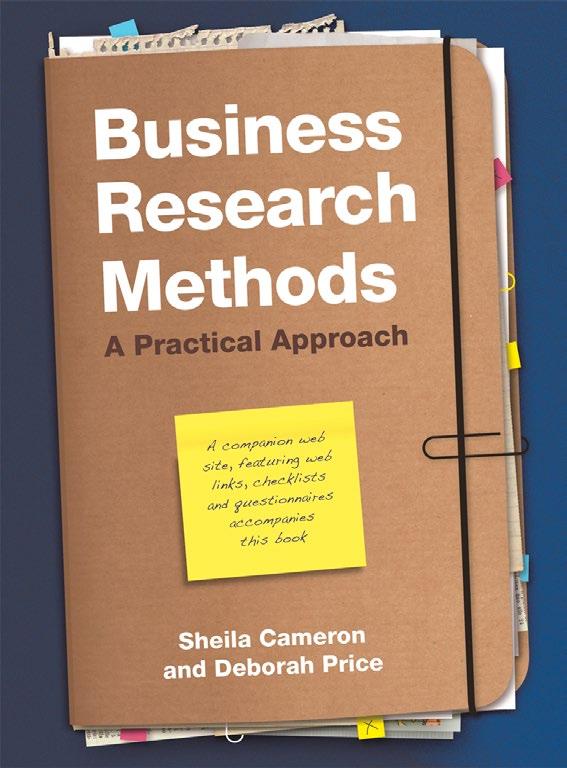
Sheila Cameron is a senior lecturer at the Open University Business School (OUBS), UK.
Deborah Price is a lecturer in Management at the Open University Business School (OUBS), UK.
Edition: 1
Date: 11/28/2009
Price: $69.99
Paperback: 9781843982289
Ebook: 9781843983620
Pages: 656
Format (mm): 265x195
Band: Textbook
Subject: Business Research
1 From First Ideas to Possible Topics
1 Practical Business Research - An Overview
2 The Complexities of Business Research
3 The Investigative Process
4 Stakeholders, Power and Ethics
5 Considering Possible Topics
2 Towards a Research Proposal
6 Exploring the Literature
7 Writing A Literature Review
8 Research Questions and Purposes
9 Data, Evidence and Sampling
10 Choosing a Research Method
11 Crafting a Research Proposal
3 Data Collection
12
13
14
17
19
20
21
5
23
• Offers a critical perspective and challenges change management assumptions to facilitate a deeper understanding and appreciation of the subject
• New to this edition: new chapters on perspectives, power and politics, ethics, agents and agency, HRM and evaluation; a revised structure to reflect strategic, group and individual change; a revised final chapter on evaluating the practice and theory of change management; and an appendix of twenty popular change management techniques
• Online resources: annotated web links for students, an instructor's manual complete with commentary on questions and cases in the book, lecture slides and additional case studies for tutors
Managing Change: A Critical Perspective explores how and why change occurs in organizations and how the change process can be managed effectively. Complete with an appendix featuring twenty popular change management techniques, it is an ideal core textbook for change modules on HR and business degree programmes at both undergraduate and postgraduate level. It offers a critical perspective, challenging the main assumptions and ensuring that the complexity of the subject is understood and appreciated.
This fully updated 2nd edition of Managing Change: A Critical Perspective includes new chapters on perspectives, power and politics, ethics, agents and agency, HRM and evaluation. Its revised structure reflects strategic, group and individual change, and a revised final chapter evaluates the practice and theory of change management. Online supporting resources include annotated weblinks for students, an instructor’s manual complete with commentary on questions and cases in the book and lecture slides and additional case studies for tutors.
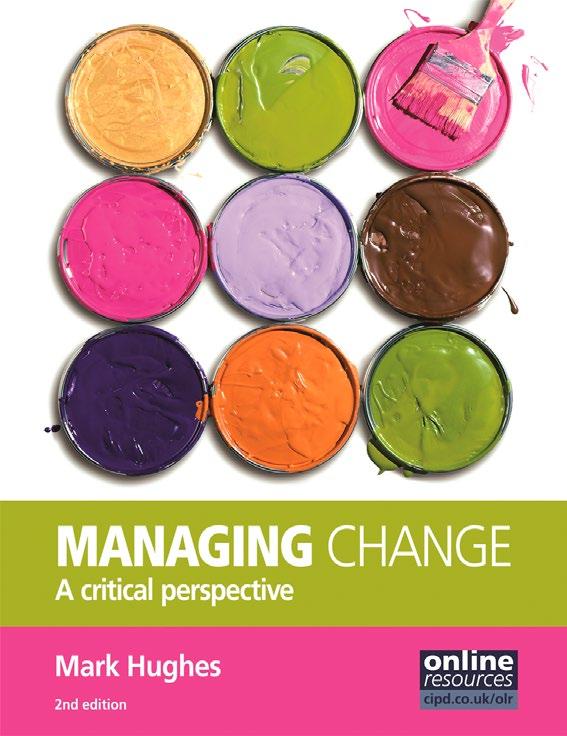
Mark Hughes is a senior lecturer in organisational behaviour at Brighton Business School, UK.
Edition: 2
Date: 08/28/2010
Price: $69.99
Paperback: 9781843982418
Ebook: 9781843984528
Pages: 392
Format (mm): 245x190
Band: Textbook
Subject: Change Management
1
1
2
3
4
2
5
6
7
• Provides a comprehensive overview of the theories, frameworks and techniques of change management
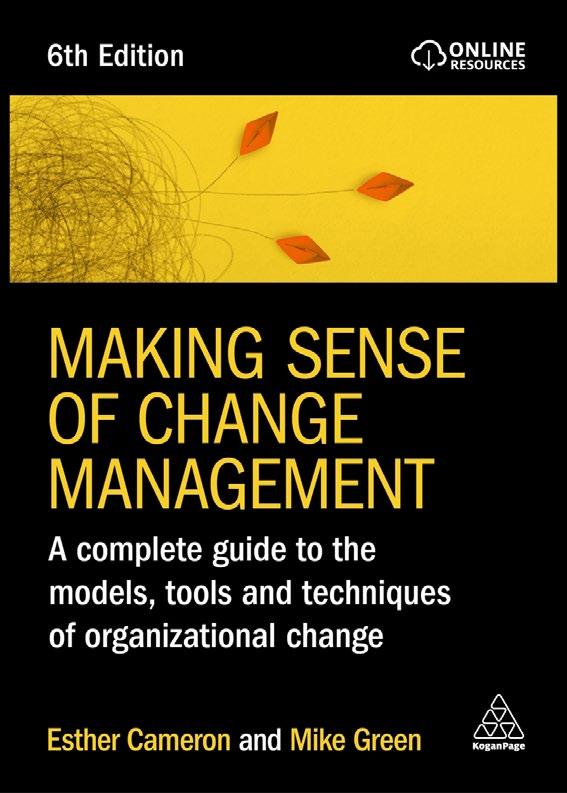
• Supports learning and understanding with checklists, tips, 'stop and think' boxes and examples from organizations including Google, Burberry and Volvo
• New to this edition: an introduction to emerging regenerative mindsets around change; new chapters on the application of change strategies, including new organizational forms, the central role of finance and economics and focus on compassionate leadership
• Online resources: international case study question packs and lecture slides with further reflective questions
How can organizations effectively navigate times of change? This book provides comprehensive guidance on adapting mindsets, structures and strategies to achieve success.
Without relying on assumed knowledge, Making Sense of Change Management covers the theories and models of change management and connects them to workable techniques that organizations of all types and sizes can use to adapt to tough market conditions. The updated sixth edition includes an introduction to emerging regenerative mindsets around change that will help meet the urgency of change during crises. There is coverage of how COVID-19, remote work and the focus on compassionate leadership has affected the way change is managed in organizations.
This definitive, bestselling text in the field shows how to succeed by changing strategies, structures, mindsets, behaviours and expectations of staff and managers. Supported by thoughtful and provocative questions at the end of each chapter, as well as checklists, tips and summaries to apply knowledge in practice, Making Sense of Change Management remains essential reading for both students and practitioners who are currently part of, or leading, a change initiative. Online resources include international case study question packs and lecture slides with further reflective questions.
Esther Cameron is the Founder of Simple Connected Conversations, a consultancy that helps leaders and their teams shift their working paradigms to healthier, regenerative and dynamic practices to deal with change.
Mike Green was previously the Managing Director of Transitional Space, a consultancy firm specializing in change management, leadership development and coaching. He was a Visiting Executive Fellow at Henley Business School and delivered accredited programmes in change management to senior managers and change agents globally.
Edition: 6
Date: 01/28/2024
Price: $47.99
Paperback: 9781398612853
Ebook: 9781398612860
Pages: 544
Format (mm): 240x170
Band: Textbook/ Professional
Subject: Change Management
Introduction
1 The underpinning theory
1 Individual change
2 Team change
3 Organizational change
4 Leading change
5 The change agent
2 The applications
6 Restructuring, Mergers and Acquisitions
7 Culture and change
8 Remote and hybrid working
9 Digital transformation
10 Becoming a sustainable business
3 Emerging inquiries
11 Complex change
12 Leading change in uncertain times
13 Project- and programme-led change
14 Conclusion
• Equips students and practitioners with the knowledge and skills to manage people through times of change and achieve sustainable operational performance
• Uses the author's evidence-based research to provide new models including a 'Change Readiness Assessment Template'
• Includes global case studies to help apply the theory to practice, including PepsiCo, Nissan and Aegon Asset Management
• New to this edition: content on managing the impact of technological advances and the importance of wellbeing; case studies from Netflix and the UK National Health Service
• Online resources: lecturer's slides and discussion points for each chapter
Change in organizations is all about people: it is people who plan, prepare for and implement change, and who are affected by it in the daily course of their work. Yet there is a tendency to focus on quantifiable and often more easily solved technical aspects of implementing organizational change programmes, and ignore the complex ways that these will impact individuals.
Providing an evidence-based analysis of change in organizations, Managing and Leading People Through Organizational Change is written for practitioners responsible for change programmes and postgraduate students of organizational change.

This updated edition demonstrates the importance of understanding the effects of change on individuals and engaging them collaboratively through the transformation journey. Featuring new material on individual wellbeing and the impact of technological advances on the workplace, this book sets out frameworks, practical approaches and recommendations for communicating with and leading individuals, teams and organizations through change. Full of exercises, interviews and case studies from across the globe, this book is an essential resource for leaders and students enabling them to achieve sustainable benefits of change at work.
Professor Julie Hodges is a leading expert on change in organizations. Prior to this, Julie Hodges worked as a business consultant for over 20 years in several profit and non-profit organizations, including PwC. Based in the UK, she is also an Academic Fellow of the ICMCI (International Council of Management Consulting Institutes), a Principal Fellow of the Higher Education Academy, and a Senior Fellow of the Foundation for Management Education (FME), and a member of the editorial board of the 'Management Consulting' journal.
Edition: 2
Date: 05/28/2021
Price: $49.99
Paperback: 9781789667974
Ebook: 9781789667981
Pages: 368
Format (mm): 235x155
Band: Textbook/ Professional
Subject: Change Management
Introduction
1 PART ONE: Understanding organizational change
1 The context and nature of change
2 PART TWO: Individual responses to change
2 The impact of organizational change on emotions
3 Individual sense-making processes
3 PART THREE: The role of leaders and managers
4 Leading people through change
5 Fostering commitment and ownership
6 Engaging people through dialogue
7 Changing elements of the organization’s culture
4 PART FOUR: Building capabilities
8 Building capabilities for sustaining change
9 Sustaining change
10 Glossary
11 Index
• Shows how to plan a consulting intervention, from diagnosing what change is needed and identifying risks to ensuring ethical practice and demonstrating value
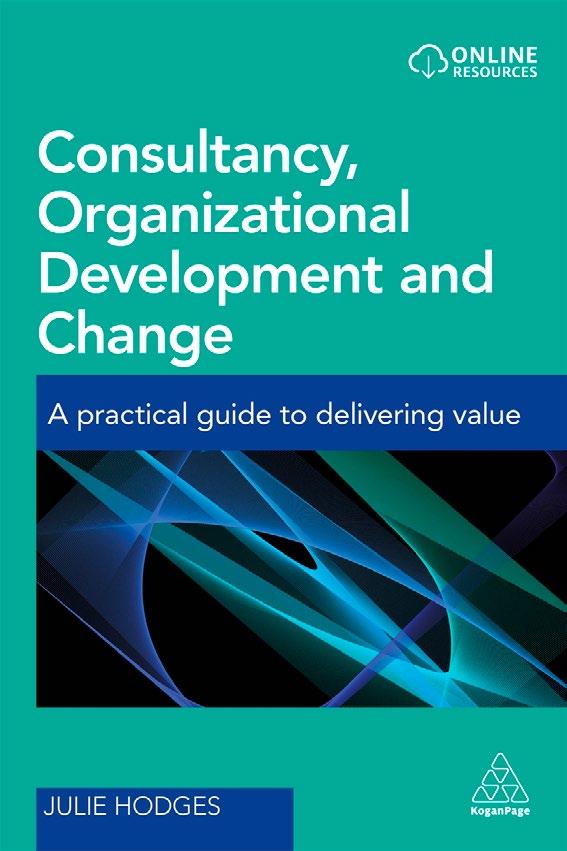
• Provides global case studies and perspectives from internal and external consultants across a range of consultancies, from the 'Big Four' to boutique firms
• Helps build the necessary skills to get work as a consultant, from putting the business case forward to establishing credibility
• Online resources: Lecturer slides
Organizations are increasingly investing in consulting capabilities to understand what changes they need to make to keep up the pace with the competition and future-proof their business. Consultancy, Organizational Development and Change is a guide for students and internal and external consultants needing to develop the necessary skills to consult in organizational settings where there is a great deal of complexity.
It tackles the issues posing the greatest threat to the success of the change programme, including how to adapt to rapidly shifting needs, deal with the emotional and ethical issues that arise and ensure that the managers take full ownership for the change so that 'business as usual' is established.
Complete with case studies from the 'Big Four' consultancy groups as well as boutique firms, Consultancy, Organizational Development and Change shows how to identify and execute interventions in a variety of organizational settings to deliver value. It provides guidance on how to develop a value proposition; define, write and present the business case for the proposed interventions; establish credibility and report on the results.
Professor Julie Hodges is a leading expert on change in organizations. Prior to this, Julie Hodges worked as a business consultant for over 20 years in several profit and non-profit organizations, including PwC. Based in Durham, UK, she is also an Academic Fellow of the ICMCI (International Council of Management Consulting Institutes), a Principal Fellow of the Higher Education Academy, and a Senior Fellow of the Foundation for Management Education (FME), and a member of the editorial board of the 'Management Consulting' journal.
Edition: 1
Date: 04/28/2017
Price: $51.99
Paperback: 9780749478636
Ebook: 9780749478643
Pages: 328
Format (mm): 18x155
Band: Textbook/ Professional
Subject: Change Management
1 The Context of Consulting
1 The Nature and Value of Consulting
2 Roles and Responsibilities of Consulting
2 The Consulting Cycle
3 Preparation and Contracting
4 Diagnosing the Need and Readiness for Change
5 Designing and Delivering Interventions
6 Transition
3 Consulting Capabilities
7 Building Capabilities for Consulting
8 Becoming a Consultant
9 The Shadow Side of Consultancy
10 Conclusions and Reflections
• Explains core concepts of agile methodologies enabling readers to create a flexible plan for managing both large-scale and micro-level change in their organization
• Provides best practice advice on how to build strong relationships with stakeholders to ensure benefits are realized early
• New to this edition: Chapters on behavioural change and decomposition in planning iterations; discussion on prototyping for business needs and virtual leadership; refresh of the content to cover the latest developments and support the APMG Agile Change Agent course
• Online resources: PDFs of appendices from the book on change roles, change management documents, change capabilities, a change activity index and communication activities
The second edition of Agile Change Management provides essential tools to build change manager capabilities and ensure change initiatives are embedded effectively throughout the organization.
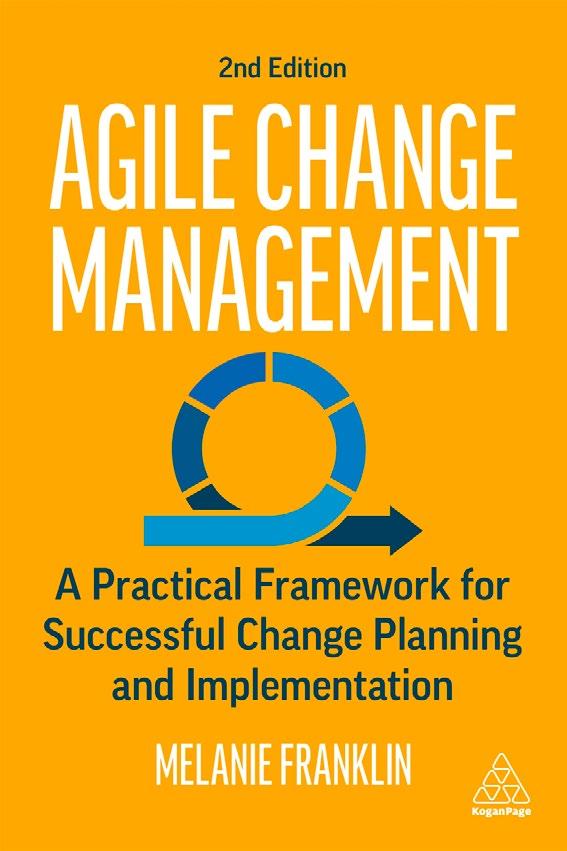
This book is a comprehensive resource for creating a roadmap that is flexible and unique to each organization to manage any type of change initiative. Detailing all the processes, activities and information needed, from creating the right environment for change to completing iterative tasks, it shows how to respond to different needs as they arise, reducing the potential for wasted time and resources.
The updated second edition features chapters on behavioural change and decomposition in planning iterations, and new material on prototyping for business needs and virtual leadership. Whether implementing a large-scale transformation or working through projects at micro-level, Agile Change Management provides tools, frameworks and examples necessary to adapt to and manage change effectively.
Melanie Franklin is a globally recognized thought leader in change management who has effected business change programmes across public and private sector organizations. Based in London, UK, she is the Director of Agile Change Management Ltd and Founder of the Continuous Change Community. An impressive array of clients in Europe, the US and the Middle East benefit from her unique insights into change. She designs and runs in-house programs to develop skills in change and transformation and advises boards on strategies for change. She is Chief Examiner for the Agile Change Agent qualification from APMG International and works for several professional bodies to help grow the consulting and change management professions. She is the author of several publications and a regular keynote speaker at various conferences worldwide.
Edition: 2
Date: 10/28/2021
Price: $46.95
Paperback: 9781398603141
Ebook: 9781398603158
Pages: 304
Format (mm): 235x155
Band: Professional/ Academic
Subject: Change Management
1 Concept
2 Roadmap
3 Business need
4 Relationship building
5 Environment
6 Coaching for Change
• Offers a practical approach underpinned by neuroscience for engaging and supporting employees during times of change
• Contains numerous examples of how these approaches have been applied in organizations including as Lloyds Banking Group and Government Communications Headquarters (GCHQ)
• Includes key reflection points at the end of each chapter to aid planning and implementation of key steps and insights
• New to this edition: new chapters on planning the work day with the brain in mind and overcoming the difficulties related to behavioural change, as well as updated wider content and further case studies
Organizational change can be unpredictable and stressful. With a better understanding of what our brains need to focus, organizations can increase employee engagement, productivity and well-being to successfully manage periods of uncertainty.
Drawing on the latest scientific research and verified by an independent neuroscientist, Neuroscience for Organizational Change explores the need for social connection at work, how best to manage emotions and reduce bias in decision-making, and why we need communication, involvement and storytelling to help us through change.
Practical tips and suggestions can be found throughout, as well as examples of how these insights have been applied at organizations such as Lloyds Banking Group and GCHQ. The book also sets out a practical science-based planning model, SPACES, to enhance engagement.
This updated second edition of Neuroscience for Organizational Change contains new chapters on planning the working day with the brain in mind and on overcoming the difficulties related to behavioural change. It also features up-to-the-minute wider content reflecting the latest insights and developments, and updated case studies from the first edition which give a long-term view of the benefits of applying neuroscience in organizations.
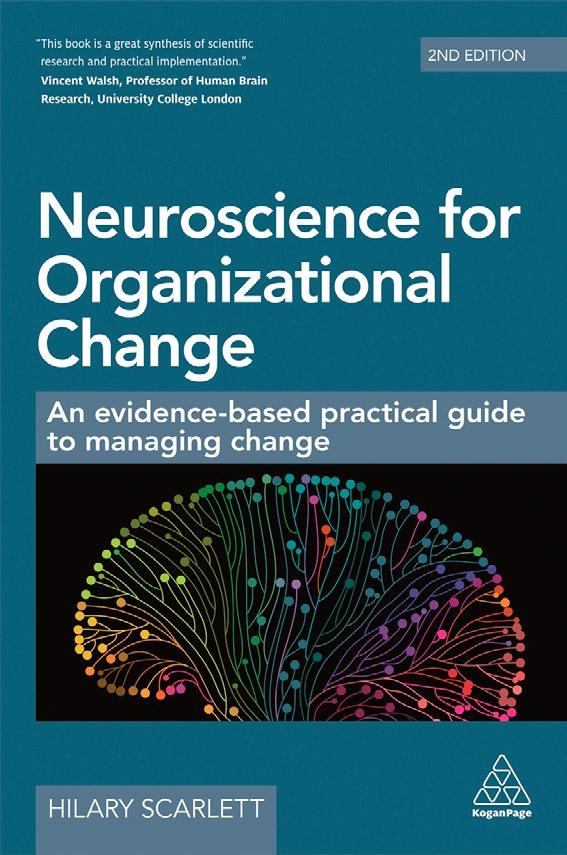
Hilary Scarlett is a writer, international speaker and consultant on change management and neuroscience. Her work, which has spanned Europe, the US and Asia, concentrates on the development of people-focused change management programmes, employee engagement and well-being. Hilary has been working with neuroscientists at University College London and in the US to apply cognitive neuroscience to practical management tools. She regularly works with leadership teams in the private and public sectors to help them build resilience and successfully introduce change.
Edition: 2
Date: 07/28/2019
Price: $39.99
Paperback: 9780749493189
Ebook: 9780749493196
Pages: 288
Format (mm): 235x158
Band: Professional/ Academic
Subject: Change Management
Preface
1 The challenge
1 Introduction to neuroscience
2 Brain facts
3 Why our brains don’t like organizational change
2 What can we do?
4 Performing at our best during change
5 Our social brains: The role of leaders and managers
6 Managing emotions during change
7 Decision-making and bias
8 Communication, involvement and the role of storytelling
9 Planning change with the brain in mind
10 Changing behavior
11 Planning the working day to maximize productivity
12 Applying neuroscience in the organization
13 Index
• Enables readers to understand Appreciative Inquiry (AI) conversational techniques and implement them for change within their organizations

• Explores the difference that AI can make through in-depth case studies from BP Castrol Marine, Nokia and Orbseal Technology Center
• New to this edition: chapters on how positive psychology can enhance appreciative practice and appreciative coaching
• Teaches new ways of authentically engaging with others in business to facilitate positive change
Appreciative Inquiry (AI) is a widely recognised process for engaging people in organizational development and change management. Based on conversational practice, it is a particular way of asking questions, fostering relationships and increasing an organization's capacity for collaboration and change. It focuses on building organizations around what works, rather than trying to fix what doesn't, and acknowledges the contribution of individuals in increasing trust and organizational alignment and effectiveness. Appreciative Inquiry for Change Management studies AI in depth, identifying what makes it work and how to implement it to improve performance within the business.
Appreciative Inquiry for Change Management explains the skills, perspectives and approaches needed for successful AI, and demonstrates how a practical conversational approach can be applied to organizational challenges in times of change. Case studies from organizations that have already integrated AI into their change management practice, including Nokia and BP, reveal why the processes are valuable and how to promote, create and generate such conversations in other organizations. Written in jargon-free language, this second edition now includes chapters on how positive psychology can enhance appreciative practice and appreciative coaching, making it an essential resource for anyone looking to implement AI in their organization.
Sarah Lewis is an Associated Fellow of the British Psychological Society, a Principal member of the Association of Business Psychologists, and the owner of Appreciating Change, where she works as a facilitator and consultant.
Jonathan Passmore is an award-winning professor of psychology with an international reputation for his work in coaching, change and leadership. He is managing director of Embrion and consults and speaks at conferences across the world.
Stefan Cantore is the Principal Teaching Fellow in Organizational Behaviour and HRM and the Director for the MSc in Organizational Change Management at the University of Southampton. He is an experienced leadership and organizational development consultant.
Edition: 2
Date: 09/28/2016
Price: $45.99
Paperback: 9780749477912
Ebook: 9780749477929
Pages: 304
Format (mm): 165x120
Band: Professional/ Academic
Subject: Change Management
1 Organizations as machines, workers as cogs and management as a control process
2 An alternative approach: organizations as living human systems
3 The development of conversational approaches to organizational change
4 Appreciative Inquiry: how do you do it?
5 The power of the question
6 The power of conversation
7 Extending practice: working with story in organizations
8 Extending practice: working with appreciative coaching
9 How Positive Psychology enhances Appreciative Inquiry
10 Developing your conversational practice
11 Becoming an appreciative conversational practitioner
12 How to introduce Appreciative Inquiry and related approaches to your organization
13 Case study: using Appreciative Inquiry at BP Castrol Marine
14 Case study: revitalizing corporate values in Nokia
15 Case study: World Café enabling strategic change at the American Society for Quality
16 Case study: rapidly transforming conflict into co-action at a South African coal mine
17 Case study: applying Appreciative Inquiry to deliver strategic change at Orbseal Technology Center
This book
• Guides the reader towards achieving sustained competitive advantage through organizational change
• Provides a practical framework for the implementation and evaluation of cultural change
• Enables managers to communicate cultural change successfully to their stakeholders
• Includes a longitudinal case study of Cordia, a public-sector organization transitioning into an LLP, to enhance learning and understanding
Leading Cultural Change is a unique text, rooted in behavioural sciences, which explores the topic as an organizational necessity to achieving sustained competitive advantage.
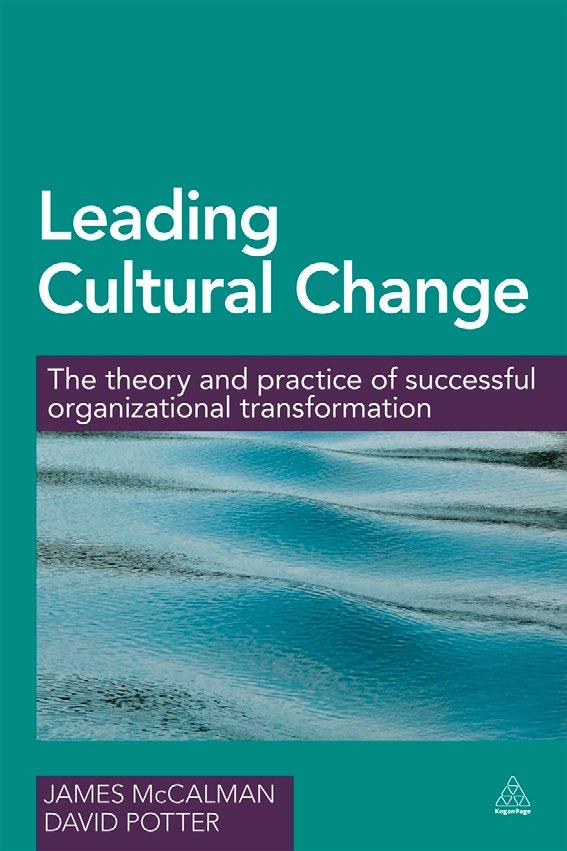
Author Information
Dr David Potter is the founder of The Cultural Change Company, which specializes in enabling cultural change interventions. He is a qualified NLP Practitioner and holds both an MBA and a PhD specialising in strategy design and cultural change dynamics. He frequently teaches and presents to students on MBA and Executive courses on the topic of cultural change, including at Adam Smith Business School University of Glasgow, University of St Andrews Business School, Glasgow Caledonian University and Glasgow University Business School.
Edition: 1
Date: 05/28/2015
Price: $59.99
Paperback: 9780749473037
Ebook: 9780749473044
Pages: 240
Format (mm): 234x155
Band: Professional/ Academic
Subject: Change Management
Table of Contents
1 Leading cultural change. Theoretical perspectives
1 Cultural change management
2 Organization development
3 Cultural change literature
4 A theory of culture
5 Cultural management as a form of control
6 Leadership as a cultural variable
7 Leadership and the management of meaning
8 Language as a cultural process
9 Ethnography as a tool for cultural change
2 Cultural and strategic tensions. When theory meets practice
10 The client and its problem
11 Change technologies
12 What did the people think?
13 Reflective learning
14 Closing thoughts
• Is the official guide for the first ever Change Management Body of Knowledge, created by Change Management Institute and APMG
• Provides a strong base level knowledge for continuing professional development across the discipline
• Enables change managers to effectively advise and coach senior colleagues and those sponsoring or leading change initiatives
The Effective Change Manager's Handbook helps practitioners, employers and academics define and practise change management successfully and develop change management maturity within their organization.

A single-volume learning resource covering the range of knowledge required, it includes chapters from established thought leaders on topics ranging from benefits management, stakeholder strategy, facilitation, change readiness, project management and education and learning support. Endorsed by the Change Management Institute and the official guide to the CMI Body of Knowledge, The Effective Change Manager's Handbook covers the whole process from planning to implementation, offering practical tools, techniques and models to effectively support any change initiative.
The editors of The Effective Change Manager's Handbook - Richard Smith, David King, Ranjit Sidhu and Dan Skelsey - are all experienced international consultants and trainers in change management. All four editors worked on behalf of the Change Management Institute to co-author the first global change management body of knowledge, The Effective Change Manager, and are members of the APMG International examination panel for change management.
APMG is a leading global Examination Institute and the Official Accreditor of the UK Government's Cabinet Office and the United Kingdom Accreditation Service (UKAS). They accredit professional training and consulting organizations and manage certification schemes for knowledge-based workers.
Richard Smith (Editor) is a specialist in organizational development-related people development issues. He works with clients as diverse as Unilever, Nestle, Mars and Harvard Business School. He is the Chief Examiner for APMG Change Management products and lead author of the first global Change Management Body of Knowledge (CMBoK) for the Change Management Institute. He is also a Fellow of the CIPD.
Edition: 1
Date: 11/28/2014
Price: $64.99
Paperback: 9780749473075
Ebook: 9780749473082
Pages: 632
Format (mm): 241x170
Band: Professional/ Academic
Subject: Change Management
1 A change management perspective –Richard Smith
2 Defining change – Robert Cole, David King and Rod Sowden
3 Managing benefits: Ensuring change delivers value – Stephen Jenner
4 Stakeholder strategy – Patrick Mayfield
5 Communication and engagement – Ranjit Sidhu
6 Change impact – Caroline Perkins
7 Change readiness, planning and measurement – Nicola Busby
8 Project management: Change initiatives, projects and programmes – Ira Blake
9 Education and learning support – Richard Smith
10 Facilitation – Dan Skelsey
11 Sustaining change – Helen Campbell
12 Personal and professional management – Ray Wicks
13 Organizational considerations – Tim Cole, Martin Lunn, Una McGarvie and Eric Rouhof
• Gives readers the knowledge and confidence to make sound ethical decisions in all business activities
• Provides easily implementable practical guidance in the form of decision-making trees and a model organizational ethics code
• Features detailed analysis of international ethical issues such as the conflict between Sharia law and Western principles
• Supports the student market with case studies and worked examples of dilemmasolving
• Online Resources: Instructor's manual, lecture slides and appendices
Corporate social responsibility, sustainability and acting ethically are all accepted business aims, but their meaning and implementation in a global context is far less clear-cut. Global Business Ethics cuts through the confusion to provide a coherent basis for ethical decisionmaking within the complications of the international business landscape.
Underpinned by theory and including worked-through examples of ethical dilemmas and their solutions, this textbook will guide the reader beyond theory to real-world business decisions. Practical tools such as decision trees and suggested principles to apply in dilemma situations give readers the skills and confidence to tackle the ethical challenges they face. Global Business Ethics offers a unique working code of ethics provided as a model with guidance to readers for adaptation and implementation. Case studies include: Walmart, Hershey's, Citibank, Ford, Nike, Johnson & Johnson, Harley-Davidson, The Body Shop and Procter and Gamble.
A chapter on the legal aspects of ethics provides guidance on the complex relationship between law and ethics in international business. The final part takes an in-depth look at the practical application of ethics in business life. Covering all the major theories of ethics, including an examination of the role of quantification of ethics, Global Business Ethics demonstrates how their principles can be applied to inform better business decisions. Online supporting resources for this book include instructor's manual, lecture slides and appendices.
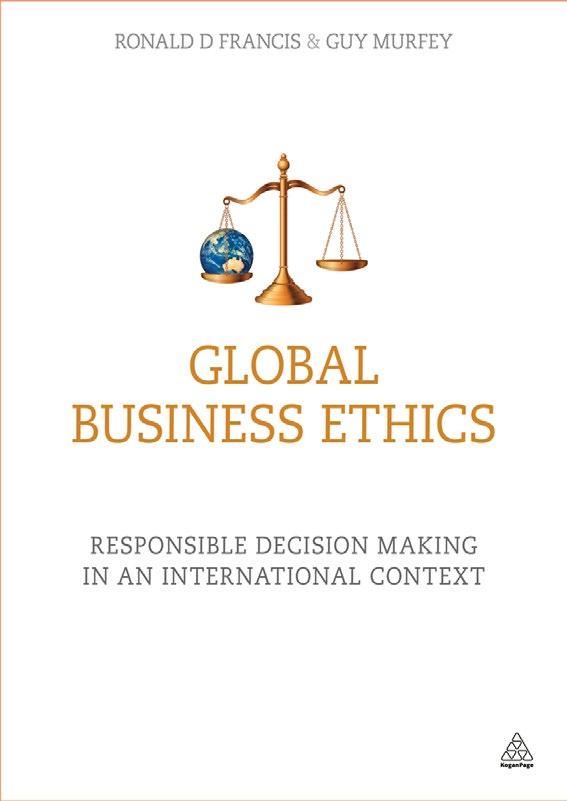
Ronald D Francis is Professor Emeritus in Ethics and Governance at Victoria University, Melbourne. His experiences in ethics extends over decades, and includes a period as Chairman of a national ethics committee, and as a member of a psychologists' registration board, as well as ten years on a research ethics committee. As a consultant, he has worked with corporations and universities to develop ethics codes and deliver practical business ethics training.
Guy Murfey is a psychologist and lawyer, recently retired as the National Practice manager of the Australian Tax Office's (ATO) Legal Services Branch, where he was responsible for the day to day running of litigation, ensuring that the highest ethical standards of practice were adhered to.
Edition: 1
Date: 11/28/2015
Price: $51.99
Paperback: 9780749473952
Ebook: 9780749473969
Pages: 248
Format (mm): 241x171
Band: Textbook
Subject: Corporate Governance, Ethics & CSR
1 THE NECESSITY, JUSTIFICATION AND RESEARCH INTO CROSS CULTURAL BUSINESS ETHICS
1 Background to ethics
2 Justification for ethics
3 Cross-cultural issues in business ethics
4 Organizational factors in business ethics
5 Individual factors in business ethics
2 THEORETICAL ISSUES IN BUSINESS ETHICS
6 Theoretical approaches
7 Legal aspects of ethics
3 SOLVING PROBLEMS
8 Ethical gradualism, culture, quantification and codes
9 Investigating ethical breaches
10 International standards and first principles
11 Ethical codes: ready reference guide (glossary of international codes related to ethics)
• Highlights the added value to organizations of incorporating triple P (People, Planet and Profits) considerations into investment decisions
• Features case studies from private and public sector, not-for-profit and social enterprise organizations who have benefited from this approach including the Ellen MacArthur Foundation
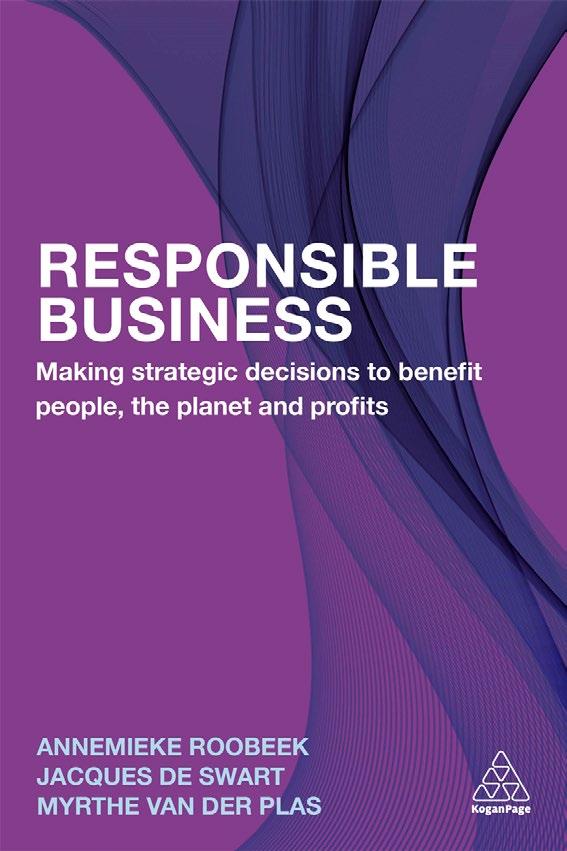
• Includes access to a ready-made business simulator tool for evaluating investment decisions
Until recently, profit has been the driving force for most business decisions. However, business leaders must now look more widely at their actions to assess the impact of these on people both inside and outside the organization as well as the environment. Responsible Business provides a seven step framework that eliminates internal bias and can be used to make decisions that increase profits, benefit staff and protect the environment as a whole. This means that personal values, ethics and morals can be aligned with business goals and overall company strategy.
Responsible Business will enable business leaders to answer questions including: What values should be attached to financial and non-financial aspects of business decisions? How can these values be translated into concrete manageable actions? Which decisions best suit the strategic goals of the organization? Readers will have access to the business simulator tool which removes the complexity, ambiguity and stress of business decisions to allow leaders to manage the competing priorities in their organization and confidently make the best investment decisions for their business. With diverse case studies from organizations who have benefited from this approach, this book is essential reading for everyone needing to evaluate their investment decisions.
Annemieke Roobeek is Professor of Strategy and Transformation Management at Nyenrode Business Universiteit (Netherlands). She was previously Professor of Technology and Economics at Nyenrode and Professor of Complex Issues in strategy and policy at the University of Amsterdam.
Jacques de Swart is Professor of Applied Mathematics at Nyenrode Business University and partner within PwC, where he is responsible for the Data Analytics Group.
Myrthe van der Plas is a GARP certified Financial Risk Manager. She works within the Data Analytics Group of PwC and also teaches courses on Strategic Decision Making at several universities.
Edition: 1
Date: 06/28/2018
Price: $45.99
Paperback: 9780749480608
Ebook: 9781398612297 9780749480615
Pages: 280
Format (mm): 235x157
Band: Professional/ Academic
Subject: Corporate Governance, Ethics & CSR
Preface
1 Working Towards Responsibility in Business and Society
2 The Responsible Business Simulator at the Heart of the Decision-Making Process
3 Shared Value as a Framework for Shaping the Strategy
4 Innovation and Sustainability as a Catalyst for Responsible Growth
5 Stakeholder Management and Interactivity in the Decision-Making Process
6 Strategic Decision Making based on Data and Dialogue via the Responsible Business Simulator
7 Using the Responsible Business Simulator
8 Reducing Greenhouse Gas Emissions
9 Putting Roof Renovation in a Strategic Context
10 Choosing between Various Waste Collection Systems
11 Creating a Healthy and Productive Working Environment
12 Quantifying the Contribution of Sports
13 Responding to the Refugee Influx in Europe
14 Attracting Investment at a Social Enterprise
15 Conclusion

• Discusses compliance in broader terms than other books in the market, considering social, psychological, global and cultural factors in order to better understand how to collaborate, communicate and engage others in the organization
• Provides precision, but also allows nonspecialist readers to access the information provided, including expertise on the typical traps to be aware of, policy and process and how to develop an ethics and compliance strategy
• Provides an ideal self-development toolkit that readers can access on a day-to-day basis, offering a clear, simple route to quickly find and apply expertise
• Gives professionals clear guidance to key issues, using accessible language and cutting through jargon to define ethics and compliance and offer practical advice and ideas
• Uses storytelling and scenarios to help readers apply theory to real-life situations, bringing issues to life in the human, social and political contexts relevant to the workplace
Edition: 1
Date: 08/28/2019
Price: $51.99
Paperback: 9780749482978
Ebook: 9780749482985
Pages: 376
Format (mm): 234x157
Band: Professional
Subject: Corporate Governance, Ethics & CSR
1 Section - ONE:
1 Why compliance isn’t working
2 The meaning, origins and role of compliance and ethics
3 Barriers to success
4 Looking for answers
2 Section - TWO:
5 The anatomy of a compliance and ethics programme
6 Top-level commitment
7 Risk assessment and due diligence
8 Code of conduct and policies
9 Communication, education and training
10 Whistle-blowing hotline and speak-up culture
11 Procedures and controls
12 Investigations, remediation and enforcement
13 Assurance and continuous improvement
14 Implementation – The compliance and ethics function – and everyone else
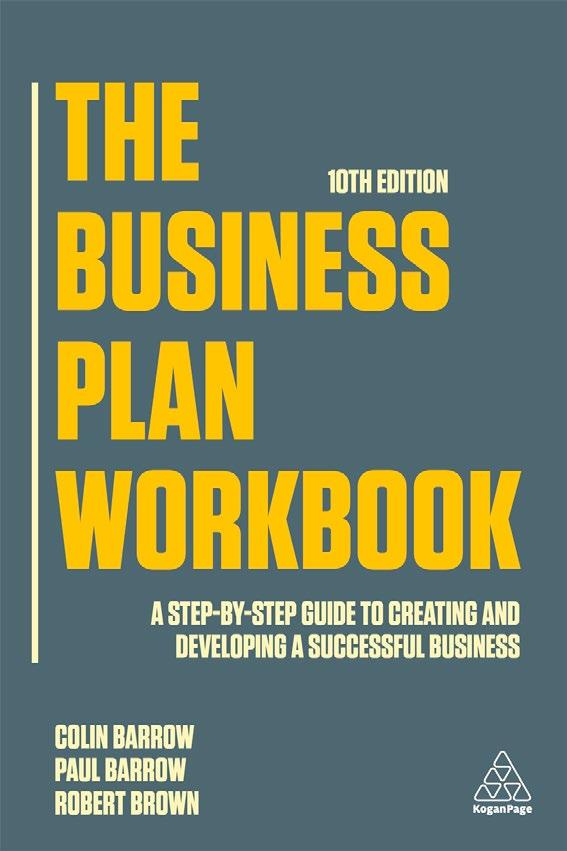
• Enables readers to research and complete a winning business plan by highlighting 24 separate areas of development with corresponding assignments
• Is based on teaching methodology which was developed at one of the UK's best business schools, Cranfield School of Management
• Contains close to 70 case studies of business planning that are behind a myriad of business ventures that include Richer Sounds, Eat 17, The Northern Dough Company, Catalan and Secret Escapes
• New to this edition: Has been streamlined to ensure readers spend time where it matters and also includes updated information resources, new case studies and updated financial projection assignments
• Online Resources: Includes slide deck for lecturers and downloadable templates
Lay down the foundations of a successful business venture through a thoroughly researched and competitive business plan.
Based on tried and tested business methodology used at the leading business school, Cranfield School of Management, this 10th edition of The Business Plan Workbook guides you through all the necessary steps to constructing a winning business plan. This is a practical run-through of 26 key areas of development of strategic planning. It will allow you to think of these areas in isolation through the use of assignments that ensure you have stress-tested your business proposition. This guide covers how to
- Come up with a winning business idea
- Complete market and competitive research
- Set up a winning marketing strategy
- Forecast watertight financials and projections
- Define realistic operations and staffing
- Deliver an unforgettable pitch to potential backers and investors
This new and fully updated edition includes 67 business case studies that show you how successful entrepreneurs have dealt with strategic planning in the past. The content has been streamlined to focus on the most critical parts of business planning, ensuring you spend time where it matters and stay competitive. With new information resources and financial planning consideration, this is an invaluable guide for entrepreneurs, business executives and students.
Colin Barrow has lectured in business schools in the UK, the USA, Australia, the Far East and throughout Europe. A former visiting fellow at Cranfield School of Management, he is the author of the 30 Day MBA series, Financial Management for the Small Business and Starting a Business from Home (all published by Kogan Page).
Paul Barrow is a visiting fellow at Cranfield and also a consultant advising SMEs on growth strategies.
Robert Brown is a visiting fellow at Cranfield and directed the Graduate Enterprise Programme there, where he led a course on entrepreneurship.
Edition: 10
Date: 02/28/2021
Price: $23.99
Paperback: 9781789667370
Ebook: 9781789667387
Pages: 320
Format (mm): 232x150
Band: Professional/ Academic
Subject: Entrepreneurship
• Is written specifically for business and management courses, focusing on issues such as how knowledge management can be integrated with the business decision making process
• Covers the most advanced IT and information systems technologies and cutting-edge research on topics such as boundary spanning
• Includes real world case studies, role play scenarios, and "think back" and "critique discussion" questions to encourage reflective learning and critical thinking
• Takes an international approach to knowledge management, for example comparing models from USA, UK and Japan
• Online resources: PowerPoint lecture slides and exercise questions for students
As knowledge economies become increasingly important around the world, it is essential that organizations are able to transform their knowledge into a competitive advantage. This textbook offers an interdisciplinary approach to knowledge management written specifically for postgraduate students in business and management schools. Knowledge Management presents classic and advanced concepts, models and frameworks using a clear logical structure, which covers building knowledge competence, the knowledge lifecycle, and integration of knowledge management with business decision making. An overall framework illustrates links between chapters and ensures readers can gain a body of actionable knowledge rather than learning isolated, uncontextualized topics.
Based on cutting-edge research findings and covering the most advanced IT and IS technologies, this book emphasises the need for knowledge management to span boundaries across organizations, supply chains and partnerships, rather than being limited to individual learning and sharing within businesses. Knowledge Management is international in scope and includes real world case studies and role play scenarios to show how theories are applied in practice, and "think back" and "critique discussion" questions to encourage reflective learning and critical thinking. This indispensable text provides a dynamic picture of the evolution of knowledge management and demonstrates its full potential to enable better business decisions. Accompanying online resources include PowerPoint slides for lecturers and exercise questions for students.
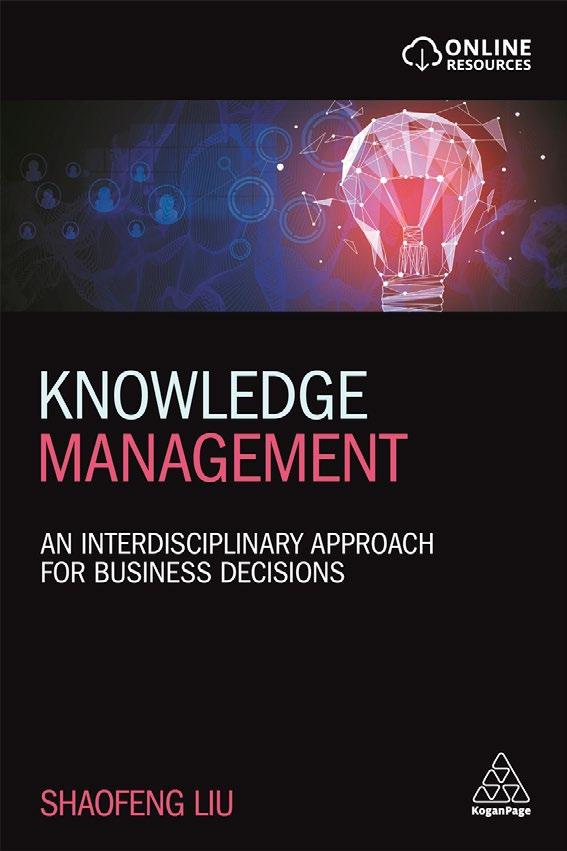
Shaofeng Liu is Professor of Operations Management and Decision Making at Plymouth Business School, University of Plymouth, UK. She teaches a Knowledge Management module every year to postgraduate students across several courses in the Faculty of Business. She is Senior Editor for Cogent Business & Management and Associate Editor for the International Journal of Decision Support System Technology and has published over 150 research papers in peer-reviewed books, journals and conference proceedings.
Edition: 1
Date: 01/28/2020
Price: $49.99
Paperback: 9780749494834
Ebook: 9780749496876
Pages: 384
Format (mm): 240x205
Band: Textbook
Subject: Information, Knowledge & Data Management
1 Knowledge management – Key concepts and models
1 Introduction to knowledge management
2 Tacit and explicit knowledge
3 Knowledge management process and lifecycle models
2 Building knowledge competence in organizations
4 Organizational learning
5 The learning organization
6 Organizational culture for knowledge sharing and learning
3 Crossing knowledge boundaries
7 Communities of practice
8 Knowledge boundaries and boundaryspanning mechanisms
9 Knowledge networks
10 ICT-enabled knowledge managementInternet of Things and big data analytics
4 Knowledge support for business decision making
11 The business decision context
12 Human decision-making processes and knowledge requirements
13 Knowledge-based decision support systems

• Guides the reader through the essential steps of aligning knowledge management with organizational priorities to deliver long-term benefits
• Covers best practice requirements from the first internationally recognised standard for knowledge management, ISO 30401:2018
• Provides practical checklists, guidelines and process templates to help with implementation
• Includes case studies from a variety of organizations, such as Mars, Huawei and the Singapore Youth Olympics
• New to this edition: clear guidance on ISO 30401:2018, new content on the impact of AI and data analytics, and updated case studies
WINNER: CILIP's Knowledge and Information Management Award 2019 - Information Resources Print Category
The way an organization manages and disseminates its knowledge is key to informed business decision-making, effectiveness and competitive edge. The Knowledge Manager's Handbook takes you step by step through the processes needed to define and embed an effective knowledge management framework within an organization.
This second edition now includes clear guidance on the best practice requirements from the first ever internationally recognised standard for knowledge management, ISO 30401:2018, as well as content on the impact of AI and data analytics. Nick Milton and Patrick Lambe work through each stage of creating and implementing a knowledge management framework for an organization's specific needs, based around the four essential aspects of knowledge management: people, processes, technologies and governance. With updated international case studies from organizations of all sizes and sectors, along with user-friendly templates and checklists to help implement effective knowledge management procedures, The Knowledge Manager's Handbook is the end-toend guide to making a sustainable change in the knowledge management culture.
Dr Nick Milton is a director and co-founder of Knoco Ltd, an international knowledge management consultancy. He previously worked at BP, coordinating the BP Knowledge Management Community of Practice, and was a member of the working group for the development of ISO 30401:2018.
Patrick Lambe is a founding partner of Straits Knowledge, a global consulting and research firm specializing in knowledge, learning and innovation. He is a Visiting Professor in knowledge management at Bangkok University, President of the International Society for Knowledge Development Singapore chapter and an editorial board member of the Journal of Knowledge Management.
Edition: 2
Date: 10/28/2019
Price: $58.99
Paperback: 9780749484606
Ebook: 9780749484613
Pages: 448
Format (mm): 235x157
Band: Professional/ Academic
Subject: Information, Knowledge & Data Management
• Shows readers how to fully leverage, analyze and integrate big data to reduce costs, increase operating margins and add income
• Offers a vendor-independent approach to transforming massive quantities of data into value
• Covers detailed data analysis and data engineering techniques for anyone who wants a deep understanding of big data
• Helps readers understand the core concepts and techniques that underpin the somewhat abstract concept of big data
• Online resources: sample data for practice purposes
Businesses who can make sense of the huge influx and complexity of data will be the big winners in the information economy.
This comprehensive guide covers all the aspects of transforming enterprise data into value, from the initial set-up of a big data strategy, towards algorithms, architecture and data governance processes. Using a vendor-independent approach, The Enterprise Big Data Framework offers practical advice on how to develop data-driven decision making, detailed data analysis and data engineering techniques.
With a focus on business implementation, The Enterprise Big Data Framework includes sections on analysis, engineering, algorithm design and big data architecture, and covers topics such as data preparation and presentation, data modelling, data science, programming languages and machine learning algorithms. Endorsed by leading accreditation and examination institute AMPG International, this book is required reading for the Enterprise Big Data Certifications, which aim to develop excellence in big data practices across the globe. Online resources include sample data for practice purposes.

Jan-Willem Middelburg is the CEO and co-founder of Cybiant, based in Kuala Lumpur, Malaysia. With Cybiant he helps to create a more sustainable world through analytics, big data and automation, developing algorithms and employing data scientists to unearth patterns and information. He is also President and Chief Examiner of the Enterprise Big Data Framework, an independent organization dedicated to upskilling individuals with expertise in Big Data. In partnership with APMG-International, the Enterprise Big Data Framework offers vendor-neutral certifications for individuals.
Edition: 1
Date: 11/28/2023
Price: $59.99
Paperback: 9781398601710
Ebook: 9781398601727
Pages: 568
Format (mm): 240x170
Band: Professional/ Academic
Subject: Information, Knowledge & Data Management
1 Introduction to Big Data
1 Introduction to Big Data
2 The Big Data framework
3 Big Data strategy
4 Big Data architecture
5 Big Data algorithms
6 Big Data processes
7 Big Data functions
8 Artificial intelligence
2 Enterprise Big Data analysis
9 Introduction to Big Data analysis
10 Defining the business objective
11 Data ingestion – importing and reading data sets
12 Data preparation – cleaning and wrangling data
13 Data analysis – model building
14 Data presentation
3 Enterprise Big Data engineering
15 Introduction to Big Data engineering
16 Data modelling
17 Constructing the data lake
18 Building an enterprise Big Data warehouse
19 Design and structure of Big Data pipelines
20 Managing data pipelines
21 Cluster technology
4 Enterprise Big Data algorithm design
22 Introduction to Big Data algorithm design
23 Algorithm design – fundamental concepts
24 Statistical machine learning algorithms
25 The data science roadmap
26 Programming languages 26 visualization and simple metrics
27 Advanced machine learning algorithms
28 Advanced machine learning classification algorithms
29 Technical communication and documentation
5 Enterprise Big Data architecture
30 Introduction to the Big Data architecture
31 Strength and resilience – the Big Data platform
32 Design principles for Big Data architecture
33 Big Data infrastructure
34 Big Data platforms
35 The Big Data application provider
36 System orchestration in Big Data
• Provides a detailed framework with practical methods for organizations to implement an ethical information management strategy
• Assesses the types of ethical dilemmas your organization might face as it becomes more data-driven and provides guidance on how ethical frameworks can be standardized across cultures that have conflicting values
• New to this edition: sustainability and environmental management, the challenge of ethical trade-offs with analytics and ad-tech; discussion of data colonialism; case studies on Smart Cities and Demings Principles
• Is written by internationally regarded experts in information governance, data privacy and information ethics
Data-gathering technology is more sophisticated than ever, as are the ethical standards for using this data. This second edition shows how to navigate this complex environment.
Data Ethics provides a practical framework for the implementation of ethical principles into information management systems. It shows how to assess the types of ethical dilemmas organizations might face as they become more data-driven. This fully updated edition includes guidance on sustainability and environmental management and on how ethical frameworks can be standardized across cultures that have conflicting values. There is also discussion of data colonialism, the challenge of ethical trade-offs with ad-tech and analytics such as Covid-19 tracking systems and case studies on Smart Cities and Demings Principles.
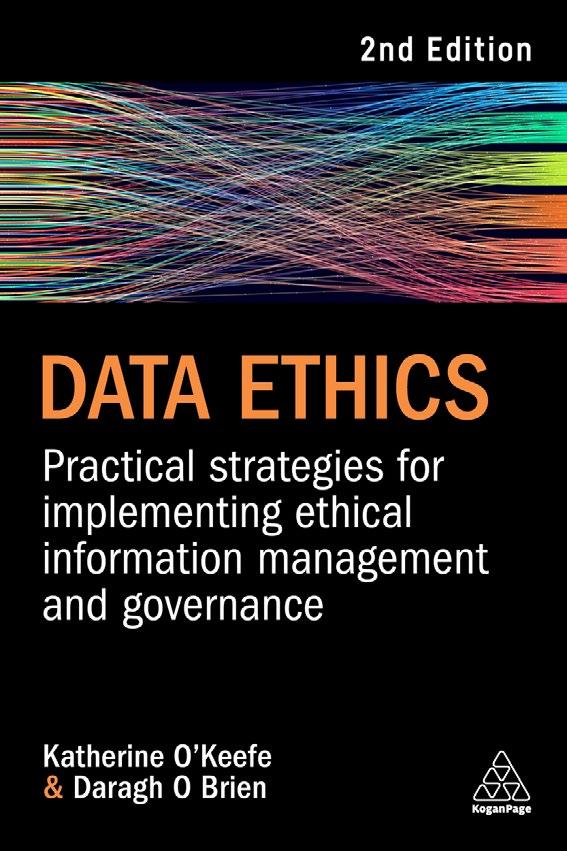
As the pace of developments in data-processing technology continues to increase, it is vital to capitalize on the opportunities this affords while ensuring that ethical standards and ideals are not compromised. Written by internationally regarded experts in the field, Data Ethics is the essential guide for students and practitioners to optimizing ethical data standards in organizations.
Katherine O'Keefe works with Ireland's national water utility, Uisce Éireann, and is on the teaching faculty of the Law Society of Ireland's Diploma Centre. She has developed international professional accreditation schemes for information management, for which she was awarded the DAMA International Professional Achievement Award in 2017.
Daragh O Brien is the founder and managing director of Castlebridge, a leading data strategy consultancy. He lectures in Data Protection and Data Governance in the Sutherland School of Law at University College Dublin. Daragh is a founding member of the Strategic Advisory Board to the School of Business in Maynooth University.
Edition: 2
Date: 06/28/2023
Price: $62.99
Paperback: 9781398610279
Ebook: 9781398610286
Pages: 400
Format (mm): 235x158
Band: Professional/ Academic
Subject: Information, Knowledge & Data Management
Introduction - Why write a book on data ethics?
1 Ethics in the context of data management
2 Introduction to ethical concepts and frameworks
3 Ethical principles, standards and practice
4 Ethics, privacy and analytics
5 Ethics and data management (including AI)
6 Developing an ethical architecture for information management
7 Introducing the Ethical Enterprise Information Management (E2IM) framework
8 Information ethics as an information quality system
9 Information ethics and data governance
10 Information ethics and risk - Tools and methods for identifying and managing ethical risk
11 Data ethics - the bigger picture
12 And in conclusion...
• Offers a strategic guide on how to use analytics to ensure that business decision making is fully data-driven

• Utilizes the four levels of analytics model (describe, diagnose, predict, and prescribe) to help organizations develop a cohesive framework for the systematic and strategic conversion of data into value, insight and action.
• Provides practical guidance on how to use the four levels of analytics effectively, covering people and functions, strategies, skills and implementation
• Takes an accessible and non-technical approach tailored specifically for business practitioners, managers and leaders who need to use analytics as part of their everyday roles
• Written by a global trailblazer in the world of data literacy, data culture and data-driven transformation.
Be Data Analytical is the book organizations and individuals need to understand how to truly use analytics to turn data into valuable insights and drive smarter decision making.
Data needs analytics to turn it into value and for organizations to be truly data-driven, they need to use analytics correctly. However, most organizations do not move beyond the first, most rudimentary stage of analytics. They miss out on the powerful insights and opportunities available with all the four levels of analytics: descriptive, diagnostic, predictive and prescriptive. Be Data Analytical reveals how to supercharge data value through all the four levels of analytics, bringing data to life and enhancing data-driven decision making.
Be Data Analytical examines each of these four levels of analytics in-depth: what they are, why they matter, how they can be used strategically and how they can be implemented. The book also explores how individuals and organizations can improve their skills and performance in each of these areas. Written by a global trailblazer in the world of data literacy, the book shows professionals, managers, leaders and organizations how to use analytics for the successful and strategic conversion of data into value, insight and action.
Jordan Morrow is Vice President and Head of Data and Analytics at BrainStorm. He served as the Chair of the Advisory Board for The Data Literacy Project and currently serves on the board of INFORMS Analytics Certification Board. He has helped organizations around the world, including the United Nations, build and understand data literacy. He is based in Salt Lake City, Utah and is also the author of Be Data Literate and Be Data Driven (Kogan Page).
Edition: 1
Date: 06/28/2023
Price: $29.99
Paperback: 9781398609280
Ebook: 9781398609297
Pages: 240
Format (mm): 233x157
Band: Professional
Subject: Information, Knowledge & Data Management
Introduction
1 Data and analytics
1 Defining data and analytics
2 Defining the four levels of analytics
3 The power of analytics in decision making
2 The four levels of analytics - define, empower, understand and learn
4 Descriptive analytics
5 How are descriptive analytics used today?
6 How individuals and organizations can improve in descriptive analytics
7 Diagnostic analytics
8 How are diagnostic analytics used today?
9 How individuals and organizations can improve in diagnostic analytics
10 Predictive analytics
11 How are predictive analytics used today?
12 How individuals and organizations can improve in predictive analytics
13 Prescriptive analytics
14 How are prescriptive analytics used today?
15 How individuals and organizations can improve in prescriptive analytics
3 Bringing it all together
16 Using all four levels of analytics to empower decision making
17 Conclusion
• Shows managers, leaders and data professionals how to harness the power of their data and analytical strategies to become truly data driven
• Outlines a roadmap for building a datadriven organization, including deciding on outcomes and building a strategy
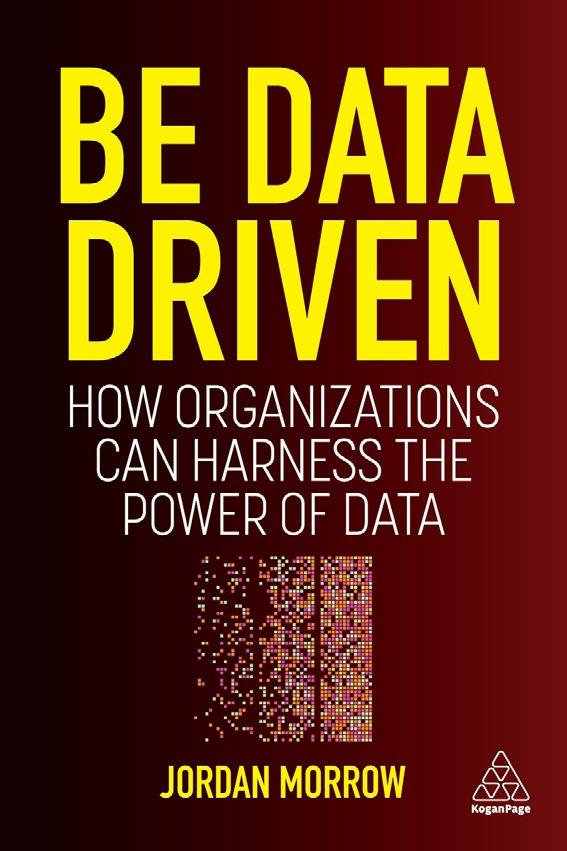
• Explains how to identify and overcome common hurdles, such as a foundational skills gap and the difficulty of creating a datadriven culture
• Explores advances in technologies, where to invest and the importance of the human element in data
• Includes case studies of data-driven businesses and how the COVID-19 pandemic has impacted the way organizations use data
Make any team or business data driven with this practical guide to overcoming common challenges and creating a data culture.
Businesses are increasingly focusing on their data and analytics strategy, but a datadriven culture grounded in evidence-based decision making can be difficult to achieve. Be Data Driven outlines a step-by-step roadmap to building a data-driven organization or team, beginning with deciding on outcomes and a strategy before moving onto investing in technology and upskilling where necessary.
This practical guide explains what it means to be a data-driven organization and explores which technologies are advancing data and analytics. Crucially, it also examines the most common challenges to becoming data driven, from a foundational skills gap to issues with leadership and strategy and the impact of organizational culture. With case studies of businesses who have successfully used data, Be Data Driven shows managers, leaders and data professionals how to address hurdles, encourage a data culture and become truly data driven.
Jordan Morrow is Vice President and Head of Data and Analytics at BrainStorm and a global trailblazer in the world of data literacy. He served as the Chair of the Advisory Board for The Data Literacy Project and is an active voice in the data and analytics community. He has helped organizations around the world, including the United Nations, build and understand data literacy. He is based in Salt Lake City, Utah and is also the author of Be Data Literate (Kogan Page).
Edition: 1
Date: 08/28/2022
Price: $34.99
Paperback: 9781398606128
Ebook: 9781398606555
Pages: 240
Format (mm): 234x156
Band: Professional
Subject: Information, Knowledge & Data Management
1 Foundational
1 A data-driven world
2 The impact of Covid-19 on organizations and data
3 Technologies advancing data and analytics, and the need for the human element
4 What is a data-driven organization?
2 Gaps
5 Foundational skills gaps
6 Pillars of an organizational data strategy
7 The gap in leadership
8 The biggest hurdle: culture
3 Building your data-driven organization
9 Decide your outcome
10 Build your strategy
11 Be data driven—start your journey!
12 References
This book
• Explains how to use data to become a better decision maker by developing curiosity, creativity and critical thinking
• Examines the different skills required for the four levels of analytics (descriptive, diagnostic, predictive, prescriptive) and for different aspects of the data literacy world, from data visualisation to data science and data architecture
• Includes tips, tricks and exercises to work through and examples from industries successfully implementing data literacy skills from a leading expert and trainer
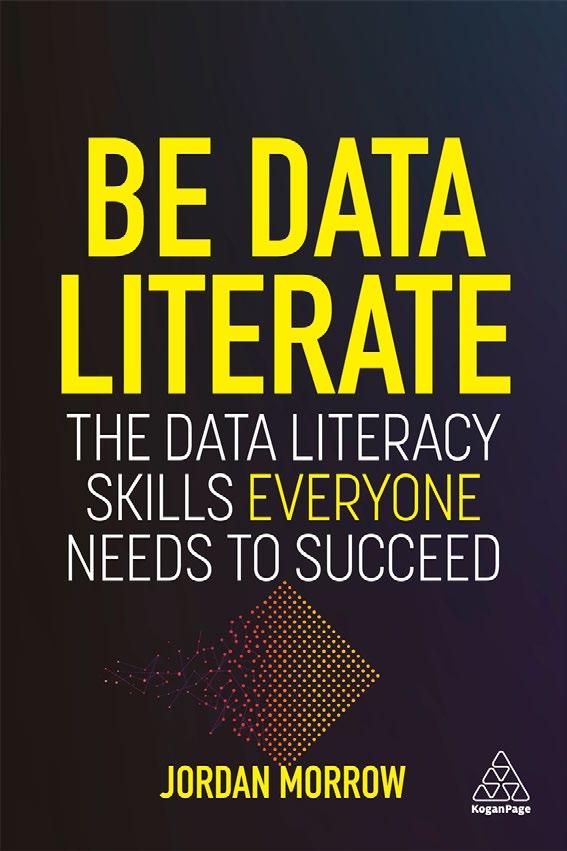
In the fast moving world of the fourth industrial revolution not everyone needs to be a data scientist but everyone should be data literate, with the ability to read, analyze and communicate with data.
It is not enough for a business to have the best data if those using it don't understand the right questions to ask or how to use the information generated to make decisions. Be Data Literate is the essential guide to developing the curiosity, creativity and critical thinking necessary to make anyone data literate, without retraining as a data scientist or statistician.
With learnings to show development and real-world examples from industries implementing data literacy skills, this book explains how to confidently read and speak the 'language of data' in the modern business environment and everyday life. Be Data Literate is a practical guide to understanding the four levels of analytics, how to analyze data and the key steps to making smarter, data-informed decisions. Written by a founding pioneer and worldwide leading expert on data literacy, this book empowers professionals with the skills they need to succeed in the digital world.
Author Information
Edition: 1
Date: 03/28/2021
Price: $25.99
Paperback: 9781789668018
Ebook: 9781789668025
Pages: 240
Format (mm): 235x156
Band: Professional
Subject: Information, Knowledge & Data Management
Table of Contents
2 The four levels of analytics
3 Defining data literacy
4 The data literacy umbrella
5 Reading and speaking the language of data
6 Combining data literacy and the four levels of analytics
7 The steps of data literacy learning
8 The three Cs of data literacy
9 Data informed decision-making
10 Data literacy and data and analytical strategy
11 Begin your data and analytics journey
Unlock Data Assets and Increase Innovation with a ResultsDriven Data Strategy
• Follows the five 'waves' of data maturity businesses must pass through to implement a data-driven strategy which leverages existing assets
• Explains how to choose projects which reflect organizational goals and get started with some quick wins
• Outlines how to improve business performance and optimise processes through automation
• Explores how investing in AI, machine learning and data science can help businesses become leading innovators prepared for change
• Offers guidance on rigorous data governance and the importance of data quality in building trust
For many organizations data is a by-product, but for the smarter ones it is the heartbeat of their business. Most businesses have a wealth of data buried in their systems which, if used effectively, could increase revenue, reduce costs and risk and improve customer satisfaction and employee experience.
Beginning with how to choose projects which reflect your organization's goals and how to make the business case for investing in data, this book then takes the reader through the five 'waves' of organizational data maturity. It takes the reader from getting started on the data journey with some quick wins, to how data can help your business become a leading innovator which systematically outperforms competitors.
Data and Analytics Strategy for Business outlines how to build consistent, high-quality sources of data which will create business value and explores how automation, AI and machine learning can improve performance and decision making. Filled with realworld examples and case studies, this book is a stage-by-stage guide to designing and implementing a results-driven data strategy.
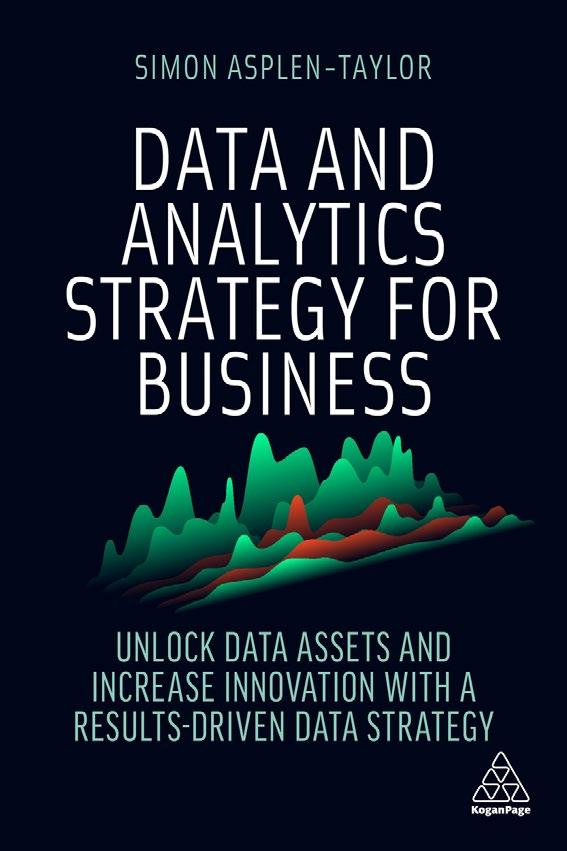
Simon Asplen-Taylor is an experienced and successful data and analytics leader based in London, UK, having served as Chief Data Officer for multiple FTSE firms and led some of the largest data led transformations in Europe. He specialises in transforming business through the use of data, analytics and artificial intelligence and is currently leading the data transformation at Lloyd's of London. He was included in the dataIQ 100 Most Influential People in Data in both 2020 and 2021.
Edition: 1
Date: 06/28/2022
Price: $34.99
Paperback: 9781398606050
Ebook: 9781398606067
Pages: 328
Format (mm): 235x155
Band: Professional/ Academic
Subject: Information, Knowledge & Data Management
1 How data and analytics can help you grow your business
1 How can this book help you?
2 The business case for data
3 Your data and analytics strategy
4 A team game
2 Wave 1 - Aspire
5 A quick win
6 Repeat and learn
3 Wave 2 - Mature
7 Data governance
8 Data quality
9 A single customer view
10 Reports and dashboards
11 Data risk management and ethics
4 Wave 3 - Industrialize
12 Automation, automation, automation
13 Scaling up and scaling out
14 Optimizing
5 Wave 4 - Realize
15 The voice of the customer
16 Maximizing data science
17 Sharing data with suppliers and customers
6 Wave 5 - Differentiate
18 From data-driven to AI-driven
19 Data products
20 Right leadership, right time
21 Epilogue - Data success
• Offers a guide to implementing digital transformation tailored for established organizations.

• Underpinned by the author's impressive experience as an internationally recognised C-suite level digital leader with a 30-year career specialising in established businesses
• Provides a tried and tested framework that steers established organizations through the digital transformation journey, focusing on accessible incremental change.
• Showcases AI in action through a series of AI-generated content summaries, demonstrating both the disruptive potential and sophistication of AI-and its limitations
• Presents a vibrant storytelling approach rich with examples and perspectives, experiences and viewpoints from a global team of experts representing different digital transformation archetypes
Achieve successful digital transformation with this authoritative guide designed specifically for established organizations.
At a time where even the most recognized business models are under threat, organizations risk devastation if they do not transition successfully to the new digital reality. Yet what works for digital natives does not always work for established organizations. Recognized as one of the world's top global executives leading innovative transformation, Neetan Chopra's deep experience of steering organizations through digital disruption drives the practical approach of Accelerated Digital Transformation. Having designed transformation journeys, overcome setbacks and driven outcomes within multiple leading companies, Neetan Chopra tackles key factors for established organizations including inertia, impetus, outcomes, digital capabilities and culture.
The book is underpinned by a tried and tested framework that will guide readers step by step through the entire digital transformation journey. This will be an essential resource for leaders, managers and practitioners leading and executing digital transformation.
Neetan Chopra is a C-suite level senior digital leader with a track record of driving change and innovation at established enterprises. In his three-decade career, he has led digital transformation in global enterprises operating diverse business models across the aviation, travel, logistics, retail, food and beverage, real estate and entertainment industry sectors. He is currently Chief Digital and Information Officer at IndiGo (InterGlobe Aviation Ltd) in Gurugram, India; prior to this, he also held roles at Dubai Holding, Emirates Airlines and Accenture. He sits on the boards of multiple tech start-ups, has built multiple global innovation labs including at Oxford University and Carnegie Mellon University and is an Adjunct Professor at Botho University, Botswana. He is recognized by the Constellation Research Business Transformation 150 as one of the world's top global executives leading innovative business transformation efforts in their organizations.
Edition: 1
Date: 04/28/2023
Price: $34.99
Paperback: 9781398608924
Ebook: 9781398608931
Pages: 216
Format (mm): 235x155
Band: Professional/ Academic
Subject: Information, Knowledge & Data Management
1 Breaking organizational inertia
2 Working the Honeycomb – disrupt phase
3 Working the Honeycomb – digital capabilities
4 Accelerated possibilities
5 Honeycomb as a platform
6 The Honeycomb hacks
7 Reflections
• Presents 17 practical and easy-to-follow steps for delivering successful digital transformation
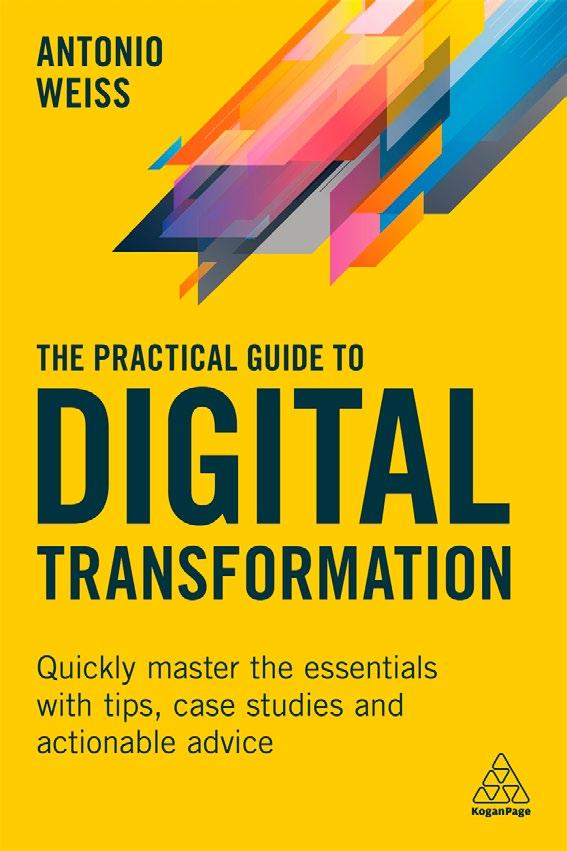
• Features key tips and tricks on putting principles into action, case studies of organizations getting it right and advice on what to say in your next meeting
• Covers important aspects of the end-to-end process, including creating a digital strategy, change management, stimulating innovation and knowing where to upskill and where to bring in new talent
• Helps time pressured professionals build confidence and quickly master the essentials of digital transformation
• Outlines how to start with the 'basics' of data science, cyber security, workable technology and good user experience and build from there
Digital transformation is a vital practice for organizations trying to keep up with competitors, but with new digital approaches constantly promising to revolutionize the workplace it can feel impossible to keep up. Cut through the hype with this accessible guide to making end-to-end digital transformation happen.
While technology offers the possibility for business improvement, successful digital transformation also requires an effective strategy, the right culture, change management, the ability to stimulate innovation and the knowledge of where to upskill and where to bring in new talent. The Practical Guide to Digital Transformation covers each of these factors and more by breaking the process down to 17 easy-to-follow and practical steps.
Each chapter includes a case study of an organization getting it right, along with advice on putting the principle into action, key tips and tricks, and what you might say in your next meeting. This book also outlines how to start with the foundations of 'doing digital' and build from there, including data science, cyber security, workable technology, minimised stack duplication, data registers and good user experience. Quickly build confidence and make change happen with this actionable guide to the essentials of digital transformation.
Dr Antonio Weiss, based in London, UK, is a Senior Partner at The PSC, an award-winning public service consultancy specialising in user-centred design, digital, strategy and delivery. He has advised the Office for Artificial Intelligence, the UK Space Agency and NHSx as well as numerous other pioneering digital organizations and frequently trains leaders to become digital transformation experts. He is also an Affiliated Researcher at the University of Cambridge's Digital State programme and the co-founder of Thomas Clipper, an e-commerce lifestyle brand for men featured in GQ, The Guardian and The Telegraph.
Edition: 1
Date: 02/28/2022
Price: $25.99
Paperback: 9781398603653
Ebook: 9781398603660
Pages: 232
Format (mm): 233x155
Band: Professional
Subject: Information, Knowledge & Data Management
Introduction
1 Getting the strategy and the roadmap right
1 What is a digital strategy?
2 Choosing your strategic delivery vehicle
3 How to do a digital roadmap
2 Making change happen
4 Ways of working
5 Senior and organisational buy-in
6 Funding digital
3 Doing digital
7 Understanding your users
8 Doing the bare minimum
9 Building new services
10 Buying technology
11 The cloud, APIs and open-source
12 Using data science to inform decisionmaking
13 Stimulating innovation
4 Future-proofing
14 Protecting and defending your organisation
15 The ethical digital organisation
16 Upskilling and bringing in new talent
17 Defining the next horizon
• Shows how businesses can embrace digital transformation and agile processes to achieve organizational success
• Provides guidance on how to scale agile principles and operations, make change stick and adopt agile mindsets and culture
• Contains real-life insights and examples from organizations driving business success with agility and digital innovation such as AirBnb, Amazon and Google
• New to this edition: material on the culture and mindset challenges of shifting at scale from linear to agile working, using data effectively in organizational and high-velocity decision-making and agile approaches in multidisciplinary teams
How can businesses transform to achieve competitive advantage in a digital-enabled world? How can managers and leaders create a culture that supports lasting change through these transformations?
Building the Agile Business through Digital Transformation is an in-depth guide for all those needing to better understand, implement and lead digital transformation in the workplace. It sets aside traditional thinking and outdated strategies to explain what steps need to be taken for an organization to become truly agile, embed innovation and develop talent to succeed.
This majorly revised second edition of Building the Agile Business through Digital Transformation contains new material on the culture and mindset challenges of shifting at scale from linear to agile working, and using data effectively in organizational decisionmaking. Full of practical advice, examples and real-life insights from organizations at the leading edge of digital transformation including AirBnb, Amazon and Google, this book is an essential guide to driving success by becoming an agile and digital native business.
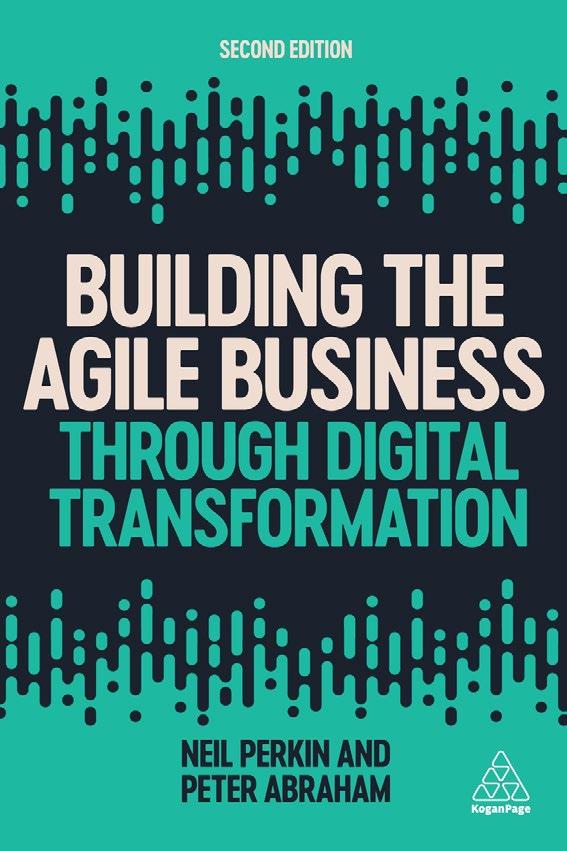
Neil Perkin is a writer, keynote speaker and founder of Only Dead Fish, a consultancy which specialises in digital strategy, transformation and agility. Based in West Sussex, UK, he has worked with organizations including Vodafone, GSK, Samsung, the UK Government and The Financial Times, and curates the quarterly series of Firestarters thought leadership events for Google UK.
Peter Abraham is an author, practitioner and co-founder of weareCrank, which uses data to drive decision making and driving growth through the intersection of data, user experience and channel optimization. Based in Surrey, UK, he has over 20 years' experience of helping global companies define their digital strategy and build digital centres of excellence to support true agility in business.
Edition: 2
Date: 06/28/2021
Price: $25.99
Paperback: 9781789666533
Ebook: 9781789666540
Pages: 336
Format (mm): 235x155
Band: Professional
Subject: Information, Knowledge & Data Management
1 The agile business
1 The key forces for change
2 How digital disrupts
3 What’s stopping you?
4 Defining digital transformation and how an agile business is the foundation for it
2 Fast
5 Operating in the ‘ambiguity zone’
6 Agile and adaptive methodology
7 The agile innovation process
3 Focused
8 The role of vision and purpose
9 Agile strategy and planning
10 Linking strategy to execution
4 Flexibility
11 Agile structures and resourcing
12 Scaling agility
13 Building the culture to move fast
14 A blueprint for flexibility - autonomy, mastery and purpose
15 Digital-native talent
5 Start small, scale fast and the transformation journey – putting it all together
16 Index
• Advises on the development and implementation of an information security management system that will meet the ISO 27001 specification
• Outlines IT governance best practice for international organizations of all sizes and across sectors
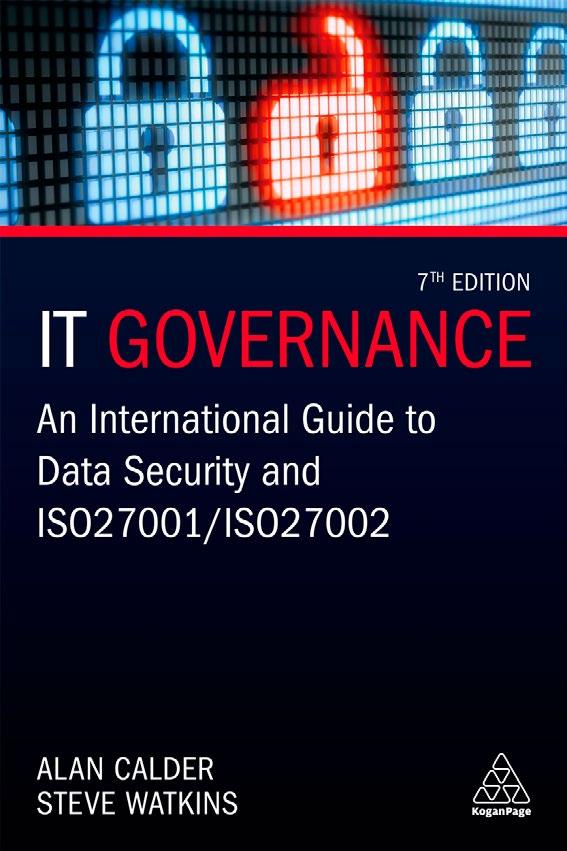
• New to this edition: changes in global regulation (including GDPR) and updates to standards in the ISO/IEC 27000 family, BS 7799-3:2017 (information security risk management) and the latest standards on auditing
• Covers topics such as risk assessment, asset management, controls, security, supplier relationships and compliance
Faced with the compliance requirements of increasingly punitive information and privacy-related regulation, as well as the proliferation of complex threats to information security, there is an urgent need for organizations to adopt IT governance best practice.
IT Governance is a key international resource for managers in organizations of all sizes and across industries, and deals with the strategic and operational aspects of information security.
Now in its seventh edition, the bestselling IT Governance provides guidance for companies looking to protect and enhance their information security management systems (ISMS) and protect themselves against cyber threats. The new edition covers changes in global regulation, particularly GDPR, and updates to standards in the ISO/IEC 27000 family, BS 7799-3:2017 (information security risk management) plus the latest standards on auditing. It also includes advice on the development and implementation of an ISMS that will meet the ISO 27001 specification and how sector-specific standards can and should be factored in. With information on risk assessments, compliance, equipment and operations security, controls against malware and asset management, IT Governance is the definitive guide to implementing an effective information security management and governance system.
Alan Calder is Group CEO of GRC International Group plc, the AIM-listed company that owns IT Governance Ltd.. He led the world's first successful implementation of BS 7799 (now ISO 27001) and was involved in developing a wide range of information security management training courses, accredited by the International Board for IT Governance Qualifications (IBITGQ).
Steve Watkins is Executive Director at GRC International Group plc, chair of the UK ISO/ IEC 27001 User Group and contracted technical assessor for UKAS. He is a member of the international technical committee responsible for the ISO 27000 family of standards, and chairs the UK National Standards Body's technical committee IST/33 (information security, cyber security and privacy protection) that mirrors it.
Edition: 7
Date: 10/28/2019
Price: $69.99
Paperback: 9780749496951
Ebook: 9780749496968
Pages: 408
Format (mm): 235x157
Band: Professional/ Academic
Subject: Information, Knowledge & Data Management
1 Why is information security necessary?
2 The UK combined code, the FRC risk guidance and Sarbanes–Oxley
3 ISO27001
4
5
6
7
8
9
10
11
12
13
14
15
16
17
18
19
20
21
22
23
24
25
26
27
• Demonstrates how companies can build their competitiveness by understanding the global value chain in which they operate
• Offers lessons for US, Japanese and European multinational companies as well as emerging market multinationals in how to understand the new business environment
• Explains how to position your company to succeed in emerging markets and in traditional markets, and to take advantage of the benefits of both
• Includes case studies from renowned international companies from both sides of emerging markets
• Online Resources: Lecture slides of each chapter
The traditional dominance of international markets by companies from the US, Western Europe and Japan can no longer be taken for granted. Emerging market economies, from the powerhouse Chinese economy (set to pass the US in national income by 2020) to dynamic players such as Mexico, South Africa and Indonesia, are rapidly changing the competitive landscape.
Companies that can successfully enter these emerging markets may reap rewards and benefits from cost reductions and market opportunities. By understanding their positioning in the global continuum of companies and customers - the global value chain - businesses can build their strategies for better competition, more effective resource allocation, cost reduction, and a heightened awareness of the risks and benefits.

Packed with in-depth case studies of multinationals from both sides of emerging markets, including: Accenture, Walmart, Google, Nike, Novartis, PetroChina, Embraer, Tata Group and FEMSA; Emerging Markets is essential reading for anyone looking to understand the new competitive landscape and how they can maximise the business opportunities available.
Online supporting resources include lecture slides that align with each chapter.
Professor Robert E. Grosse is Dean of the School of Business Administration at American University of Sharjah, and was 2012-2014 President of the Academy of International Business. He has taught international finance in the MBA programmes at Thunderbird, the University of Miami, the University of Michigan, the Instituto de Empresa (Madrid, Spain), and in many universities in Latin America, and he lectures on executive education programmes around the world. He was founding Director of Standard Bank Group's (South Africa) executive education programme, the Global Leadership Centre, offering leadership development training to 11,000 managers and executives. He is a leading author on international business topics, and his latest book, Can Latin American Firms Compete? was published by Oxford University Press in 2007.
Edition: 1
Date: 11/28/2015
Price: $51.99
Paperback: 9780749474492
Ebook: 9780749474508
Pages: 272
Format (mm): 240x170
Band: Textbook
Subject: International Business
1 Introduction
2 Why emerging markets are the place to be
3 The time horizon
4 What is the challenge from emerging markets?
5 Competing in emerging markets
6 Competitive strategies of firms in China: MNEs, SOEs and private firms
7 Emerging market MNEs competing in industrial countries and globally
8 Innovation is key
9 Large, small, family-owned and stateowned companies from emerging markets
10 Conclusions
• Contains all the essential and emerging theories and models of leadership to give students and practitioners a solid and rigorous academic underpinning to their leadership development
• Combines this theory with practical guidance based on research in the field and case studies, allowing students and practitioners to unite academic background with real-life situations in order to strengthen themselves as leaders
• Self-assessment tools and reflective exercises enable students and practitioners to discover their personal leadership style, their strengths and weaknesses, and learn how to become better leaders
• Online Resources: PowerPoint lecture slides and an instructor's manual
Essential Leadership is a practical, accessible book that tackles theory and practice in an integrated and stimulating way. You are encouraged to engage with a wide range of leadership theories and frameworks as well as rate your own leadership skills and qualities, make realistic self-development plans and start to experiment with new or different approaches. Rather than offering one best way forward or becoming overly theoretical, this book is a pragmatic resource for new and experienced leaders looking to navigate the leadership literature and start to fully realize their own leadership potential.

Supported by exercises, practical examples, rigorous self-assessments, advice and suggestions, Essential Leadership offers an important guide for those currently working, or planning to work, in a 21st century business environment with all its complexity and uncertainty. It provides an over-arching framework of five essential leadership qualities that can be refined and combined as leaders grow, allowing them to be particularly responsive to the business context. The book allows readers to discover and develop their own leadership qualities, and master them through understanding, experimentation, feedback and reflection. Cutting-edge research into Millennial Leadership is also included, as are sections on developing your leadership maturity throughout life, and how leadership culture forms and changes. Online supporting resources include lecture slides and an instructor's manual.
Esther Cameron has been experimenting with approaches to leadership and change for 25 years. She is a founding Director of Integral Change Consulting Ltd and was previously a lecturer for the University of Bristol. Together with Mike Green, she is co-author of Making Sense of Change Management (also published by Kogan Page).
Mike Green is Director of Transitional Space Ltd, and a Visiting Fellow at Henley Business School where he tutors and coaches in Leadership and Change. Mike also delivers bespoke and accredited learning programmes in Change Management to managers and change agents globally.
Edition: 1
Date: 02/28/2017
Price: $55.99
Paperback: 9780749477400
Ebook: 9780749477417
Pages: 400
Format (mm): 234x156
Band: Textbook
Subject: Leadership
1 Introduction
1 Leading in a New Era
2 Leadership Frameworks and Research
2 Leadership Traits and Characteristics
3 Contingency Theories
4 Situational Leadership
5 Psychodynamics, Power and the Shadow
6 Transformational and Transactional Leadership
7 Strategic and Innovation Leadership
8 Change Leadership
9 Leadership Responsibility and Values
10 Leading across Organizations and Networks
11 Leadership Health – Mind, Body and Spirit
3 Learning to Lead in Practice
12 What Does 21st-century Leadership Require?
13 How do Leaders Learn?
14 Levels of Leadership Maturity
4 You and Your Development
15 Taking Stock and Self-Rating
16 Clarifying your Goals and Intended Outcomes
5 Developing and Using the Five Qualities
17 Overview of the Five Qualities Framework
18 The Tenacious Implementer Quality
19 The Measured Connector Quality
20 The Visionary Motivator Quality
21 The Thoughtful Architect Quality
22 The Edgy Catalyser Quality
23 Becoming Masterful
6 Leadership and Organizations
24 Defining Leadership Culture
25 Changing Leadership Culture
26 The Implications of Millennial Leadership
• Explores how four great philosophersAristotle, Socrates, Kant and Nietzschewould approach questions of empowerment, engagement, leadership, values and performance
• Explains why modern organizational practices miss what matters the most - their people
• Reveals how leaders and their people can progress towards being more fully flourishing persons in the workplace by smashing through seven common workplace fictions
For decades, we have looked to management theorists, organizational psychologists and economists to tell us how we can squeeze the most out of people at work. The result? People are uninspired, feel like cogs in a machine and prefer to leave traditional work structures behind. Numbers and productivity can only get you so far.
What Philosophy Can Teach You About Being a Better Leader offers a different route that will allow you to reconnect with the humanist values of work. By turning to philosophy, and what it teaches us about finding fulfilment and living a good life, this book uncovers the ways you can re-engage your workforce by valuing its members as people, rather than just tools within the process.

The four authors argue that the rise of the 'omnipotent leader', who focuses on telling rather than leading, risks creating a new generation of feudal CEOs and needs to be resisted. With the help of Aristotle, Socrates, Kant and Nietzsche, as well as a whole host of other brilliant minds, they turn traditional management practices on their head, showing how moving away from traditional, hierarchical, risk focused control structures can lead to improved employee engagement, increased productivity and better outcomes for the entire business.
Alison Reynolds is a business leader and consultant in strategy execution. She is part of the Faculty in Executive Education at Ashridge Business School.
Jules Goddard is a Fellow of the Centre for Management Development at London Business School, where he has taught competitive strategy and creative marketing for 30 years.
Dominic Houlder is an Adjunct Professor in Strategic and Entrepreneurial Management at London Business School. He is internationally recognised as a leading business strategist.
David Lewis is Programme Director for Executive Education at London Business School and a renowned strategy and leadership expert.
The four authors met while undertaking a Master's in Research in Philosophy at the University of Buckingham.
Edition: 1
Date: 10/28/2019
Price: $19.99
Paperback: 9780749493165
Ebook: 9780749493172
Pages: 232
Format (mm): 234x156
Band: General
Subject: Leadership
Introduction – The dehumanized workplace
1 Who can reconnect us with our dreams?
2 Reason and passion in the humanized workplace
3 Humanizing strategy
4 Creativity and critical thinking
5 A question of example and fairness
6 The gift of authority
7 Meaning and communication
8 From engagement to encounter
9 Values and ethical pluralism
10 The freedom to do what you can
11 Index
• Improves managers' analytical skills and ability to recognise and manage projects

• Supports independent and distance learners with online resources, activities and exercises similar to those on MBA courses
• Fits into a range of business courses including MBAs and executive education schemes, allowing students to apply their practical experience in the workplace to their studies
• Encourages managers' understanding of specific contextual challenges that are increasingly common in the contemporary world of projects
• Online resources: lecture slides and instructor's manual
Understanding Project Management takes an applied approach to the study of project management, carefully balancing reflective practice and methodology necessary for successful deployment of tools and techniques in the real world. Including plenty of practical examples as well as contemporary real-world case studies, it takes a unique approach to the study of project management with an emphasis on international aspects and dilemmas that are increasingly common in the contemporary world. With a host of features to encourage reflection and reinforce learning, it is the ideal complement for independent or classroom study on a range of business courses.
Understanding Project Management helps managers understand project management, develop perspectives in application, and, through reflection, enables them to develop a project management capability, at an individual, organization or project level. The content throughout is guided by practice, making this an essential read for anyone wishing to make a success of the project management role. Online supporting resources include lecture slides and an instructor's manual.
Gary Straw has delivered project management modules on MBA and Master's and management development schemes for business schools in the UK and Eastern Europe, including Aberystwyth School of Management and Business, The Management Centre at Bangor University and Kingston Business School. He has also delivered ILM and CMI project management courses. His professional experience and insights into project management have developed through working within a number of private- and publicsector organizations, delivering projects in a range of market sectors.
Edition: 1
Date: 05/28/2015
Price: $45.99
Paperback: 9780749470555
Ebook: 9780749470562
Pages: 328
Format (mm): 240x170
Band: Textbook
Subject: Project Management
1 Projects in an ideal world
1 An introduction to projects and project management
2 Projects at the conceptual phase
3 Planning within projects
2 Projects in a real world
4 After the planning: delivering projects
5 Managing to completion
6 Reviewing and learning in projects
3 Projects in a challenging world
7 Projects – a way of thinking
8 Within and outside projects
9 A global stage
10 Managing and leading in project environments
4 Developing a capability
11 Managing and leading project enviornments
12 A spectrum of project management roles
13 Develop the capability
• Details regulatory developments affecting risks to reputation, the business model and strategy, along with improvements in risk management documentation and statutory risk reporting for assurance and reporting purposes
• Provides relevant international case studies including BP, Singapore Airlines and Darktrace
• New to this edition: new content on cyber risk, black swan events (such as COVID-19), climate risk, and case studies on Arcadia, Boohoo and HBO
• Covers developments in enterprise risk management (ERM), loss control and the value of insurance as a risk management method·
• Online resources: lecture slides with figures, tables and key points from the book
Effective risk management allows opportunities to be maximized and uncertainty to be minimized.
This guide for emerging professionals provides a comprehensive understanding of risk management with tools, tips and tactics on how to offer expert insights and drive success in an ever-changing area, covering everything from Covid-19 and digitization to climate change.
Fundamentals of Risk Management is a detailed and comprehensive introduction to commercial and business risk for students and risk professionals. Completely aligned with ISO 31000 and the COSO ERM Framework, this book covers the key principles of risk management and how to deal with the different types of risk organizations face. The frameworks of business continuity planning, enterprise risk management, and project risk management are covered alongside an overview of international risk management standards and frameworks, strategy and policy.

The revised sixth edition includes brand new content on trends such as cyber risk, black swan events and climate risk. It has been fully updated to place the emphasis on seeing risk as 'positive' rather than a 'constant threat', and establishes that risk is different in a digital/VUCA age. Additionally, it considers in detail the impact of the climate crisis and its effect on risk management activities.
Further updates from the previous edition include brand new case studies on the failure of Arcadia, HBO's bankruptcy and Boohoo's issues with modern slavery, this book provides a full analysis of changes in contemporary risk areas including digital risk management, risk culture and appetite, supply chain and statutory risk reporting. Supporting online resources include lecture slides with figures, tables and key points from the book
Clive Thompson was founding Chair of the Professional Standards and the Interest Group Committees of the Institute of Risk Management where he served on the board and was Deputy Chair until 2020. Based in West Sussex, UK, he has been a risk manager and consultant delivering projects globally. He is a Certified Fellow of the IRM.
Edition: 6
Date: 12/28/2021
Price: $62.99
Paperback: 9781398602861
Ebook: 9781398602878
Pages: 472
Format (mm): 240x170
Band: Textbook/ Professional
Subject: Risk Management
• Explains key areas of supply chain risk management, such as cargo crime, climate change and cyber-crime, and how to effectively mitigate risk at a managerial level.
• Includes new and updated global case studies like the effects of the US-China trade war and the disruption caused by the Suez Canal blockage in 2021.
• New to this edition: Contains new content on current geopolitical risks, the effects of the Covid-19 pandemic and additional material on supply chain and transport bottlenecks.
• Online resources: includes lecture slides and example test questions.
Navigate a continually evolving global risk landscape and react to new logistical challenges effectively with this vital guide on supply chain risk.

Implementing robust supply chain strategies has never been so essential in today's everchanging world. From geo-political risks to the continued effects of global crises, Supply Chain Risk Management is an essential resource for those wanting to mitigate risk and ensure supply chain resilience. Offering crucial insight from a management perspective, this updated 4th edition offers new guidance on the effects of the Covid-19 pandemic, supply-chain bottlenecks and evolving geo-political risks.
With new global case studies including disruption to the supply chain due to the Suez Canal blockage and global tensions like the US-China trade war, this edition explores a variety of real-world risks. This book details ongoing threats like climate change, corruption and technological risks while providing crucial detail on how to implement robust systems and safeguard supply chain operations. Combining theoretical and practical learning, Supply Chain Risk Management is essential for those needing to understand risk and how it can be approached.
John Manners-Bell is founder and CEO of Transport Intelligence Ltd. He is an Honorary Visiting Professor, London Guildhall Faculty of Business and Law, London Metropolitan University. He was formerly Chair of the Logistics and Supply Chain Global Agenda Council of the World Economic Forum, speaking and moderating at the annual Davos meeting. In 2021 he founded the Foundation for Future Supply Chain. His most recent book, Logistics and Supply Chain Innovation, was published by Kogan Page in November 2022.
Edition: 4
Date: 11/28/2023
Price: $59.99
Paperback: 9781398613218
Ebook: 9781398613225
Pages: 400
Format (mm): 234x156
Band: Textbook/ Professional
Subject: Risk Management
Introduction
1 Building a resilient supply chain
1 A framework for understanding risk
2 Engineering supply chain resilience
3 Contagion and logistics networks
4 Lessons from the covid crisis
2 Industry sector risk
5 Industry sector resilience to supply chain threats
6 Automotive supply chains
7 High-tech supply chains
8 Consumer goods supply chains
9 Food supply chain vulnerability
10 Pharma supply chains
11 Fashion supply chains
3 Supply chains’ interaction with the natural world
12 Natural disasters
13 Climate change and emissions policy
14 Environmental impact of global value chains
4 Economic, societal and political risks
15 Economic risks to the supply chain
16 Societal risks to supply chains
17 Political risks in international supply chains
5 Security & cyber threats
18 Corruption & bribery in the logistics industry
19 Cargo crime and piracy
20 Corruption in public, defence and humanitarian logistics
21 Terrorism and security
22 Cyber-threats to supply chains
23 Illicit supply chains
24 Conclusion
• Covers all the main application areas of risk management in business, including cyber risk, financial risk and political risk
• Collates cutting-edge contributions from recognized experts in specific application areas, outlining best practice and hot topics in risk management
• Uses a consistent framework to allow readers to easily compare practice in each area and apply insights
• New to this edition: new chapters on ESG risk, legal risk, climate change risk and financial risk; refreshed material on updated and new standards such as the ISO 3100, MOR and the ISO 14000
• Reviews the key challenges that affect risk professionals, addressing issues like communicating uncertainty, decision making, resilience, change management, risk culture and risk leadership.
The Risk Management Handbook offers readers knowledge of current best practice and cutting-edge insights into new developments within risk management.

Risk management is dynamic, with new risks continually being identified and risk techniques being adapted to new challenges. Drawing together leading voices from the major risk management application areas, such as political, supply chain, cybersecurity, ESG and climate change risk, this edited collection showcases best practice in each discipline and provides a comprehensive survey of the field as a whole.
This second edition has been updated throughout to reflect the latest developments in the industry. It incorporates content on updated and new standards such as ISO 31000, MOR and ISO 14000. It also offers brand new chapters on ESG risk management, legal risk management, cyber risk management, climate change risk management and financial risk management. Whether you are a risk professional wanting to stay abreast of your field, a student seeking a broad and up-to-date introduction to risk, or a business leader wanting to get to grips with the risks that face your business, this book will provide expert guidance.
David Hillson is a thought-leader and expert practitioner in risk management, based in Petersfield, UK. He has advised major organizations, governments and charities in 60 countries on creating value from risk using applied risk-based thinking. He has written 13 major books on risk and has developed significant innovations that are now widely accepted as best practice. He has received many awards for his ground-breaking work in risk management. He regularly shares his work through the RiskDoctorVideo YouTube channel.
Edition: 2
Date: 08/28/2023
Price: $53.99
Paperback: 9781398610613
Ebook: 9781398610651
Pages: 416
Format (mm): 234x156
Band: Professional/ Academic
Subject: Risk Management
Preface [Dr David Hillson]
1 Dimensions of risk management
1 Introducing risk [Dr David Hillson]
2 Enterprise Risk Management [John Crawley and Emer McAneny]
3 Environmental, Social & Governance (ESG) Risk Management [Dr Sarah Gordon]
4 Operational risk management [Dr Ariane Chapelle]
5 Financial Risk Management [Clive Thompson]
6 Business Continuity Management [Ian Clark]
7 Reputational risk management [Arif Zaman]
8 Project, Programme and Portfolio Risk Management [Dr Dale Cooper]
9 Supply Chain Risk Management [Linda Conrad]
10 Cyber Risk Management [Alex Stezycki]
11 Legal Risk Management [Dr Sam De Silva]
12 Climate Change Risk Management [Martin Massey]
13 Political Risk Management [Robert McKellar]
14 Country Risk Management [Nicki Kons]
15 Stakeholder Risk Management [Dr Lynda Bourne]
16 Ethics in Risk Management [Giusi Meloni]
17 Risk Management in International Development Cooperation [Magda Stepanyan]
2 CROSS-CUTTING DISCIPLINES
18 Risk Culture [Alex Hindson]
19 Risk-Based Decision Making [Keith Smith]
20 Risk Leadership in Complexity [Dr Richard Barber]
21 Resilience [Dr Erica Seville]
22 Communicating Uncertainty [Professor Veronica Bowman OBE]
23 Organisational Change Management and Risk [Dr Ruth Murray-Webster]
Epilogue: The Future of Risk Management [Dr David Hillson]
• Shows how risk and crisis managers can create robust and resilient organizational frameworks

• Provides an overview of emerging threats and their impact on businesses and wider society
• Includes detailed analysis of a wide selection of global case studies, including COVID-19, the UK National Health Service WannaCry attack, the Texas snowstorm, the Manchester Arena bombing and the Gatwick Airport drone Incident
• Uses an approach grounded in rigorous research and practitioner experience
• Covers management systems, creating organization capability, and the importance of communication and decision-making under pressure
• Online resources: PowerPoint lecture slides
From natural disasters to cyber-attacks to global pandemics, the modern risk environment is highly complex and challenges our fundamental understanding of risk and crisis management.
All senior risk and crisis managers face a similar challenge: maximizing their organization's ability to prepare for a potential high-impact event. Blending practical insights with rigorous research, Strategic Risk and Crisis Management provides a range of realistic solutions for any operational environment. It introduces concepts, frameworks and processes that will allow businesses to not only survive but respond and recover at a time of maximum chaos and confusion.
Authored by a recognized global authority on the strategic management of complex events, the book covers the integration of multiple stakeholders and the importance of information exchange and critical decision-making under pressure at strategic, tactical and operational levels. It also includes material on leadership, sense-making, resilience, wicked problems and the challenges of global urban resilience, as well as case studies with detailed analysis of organizational failures and the lessons learned, including COVID-19, the WannaCry attack, the Texas snowstorm, and the Gatwick Airport Drone Incident. Strategic Risk and Crisis Management is an essential read for professionals working in security, risk, crisis management and emergency response. It will also be a valuable text for university students taking modules on security, risk, emergency response and crisis management.
David Rubens is Professor in the United Nations University for Peace European Centre for Peace and Development (Belgrade), where he is Programme Director for the International Postgraduate Study Programme in Strategic Risk and Crisis Management. He founded the Institute of Strategic Risk Management in 2018, which has established itself as a leading platform for academics, practitioners and policy makers across the range of security, risk and crisis management-related sectors.
Edition: 1
Date: 02/28/2023
Price: $47.99
Paperback: 9781398609754
Ebook: 9781398609761
Pages: 352
Format (mm): 20x170
Band: Professional/ Academic
Subject: Risk Management
Introduction
1 Setting the scene - An overview of historical crisis management research
2 Corporate risk management in the 2020s
3 Black swans + grey rhinos – being ready
4 Causes of crisis management failure
5 Incident command systems and hierarchical management
6 Leadership
7 Resilience
8 The regulatory system – a failing safety net
9 Global urban resilience in the 2020s
10 Creating the new urban order
11 In the stranglehold of a pandemiclearning from Covid-19
12 Wicked problems
13 Case studies
• Provides a practical roadmap for how organizations can incorporate climate change into their enterprise risk strategy, integrating existing and new risk management methodologies
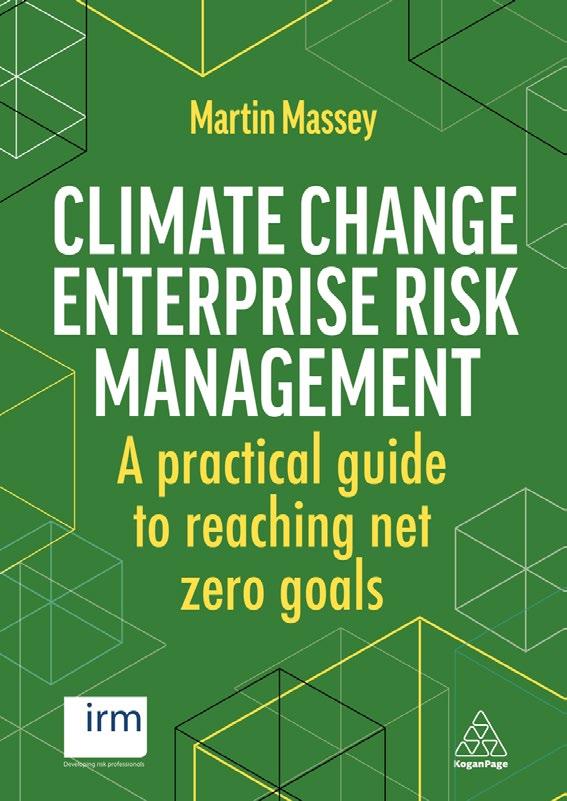
• Covers best practice risk management tools and techniques and how they can be tailored for climate change such as use of the risk radar, bow tie analysis, stress and scenario testing, risk maturity models, and risk reporting dashboards
• Presents international, sector-agnostic approach supported by examples, case studies and interviews and insights from leading experts in risk management across different industries
• Explains the climate change risk taxonomy that is now widely and consistently used across world by regulatory and risk managers.
• Online resources: PowerPoint slides
Edition: 1
Date: 12/28/2022
Price: $56.24
Paperback: 9781398608702
Ebook: 9781398608719
Pages: 424
Format (mm): 230x153
Band: Professional/ Academic
Subject: Risk Management
Introduction - Climate change enterprise risk management in context
1 Climate change risk landscape and ERM maturity
2 Climate strategic positioning and risk appetite integration
3 Developing an effective climate governance framework
4 Climate change risk identification techniques including stakeholder mapping
5 Managing transition risks
6 Building climate resilience
7 Climate physical risks – Data sources, uses and challenges
8 Designing an effective climate emerging risk management process
9 Climate emerging trends, issues and challenges
10 Climate stress and scenario testing
11 Climate risk integration into specific business processes
12 Financial reporting and climate disclosures
This book
• Includes case studies of major operational risk events to illustrate key concepts, covering rogue traders, fraud and technology issues
• Covers operational risk tools including categorisation, risk and control selfassessment, scenario analysis, events and losses and operational risk indicators
• Explores the regulatory treatment of operational risk and how to create an effective risk culture
• Examines where operational risk fits in relation to other risk types and how this can create challenges
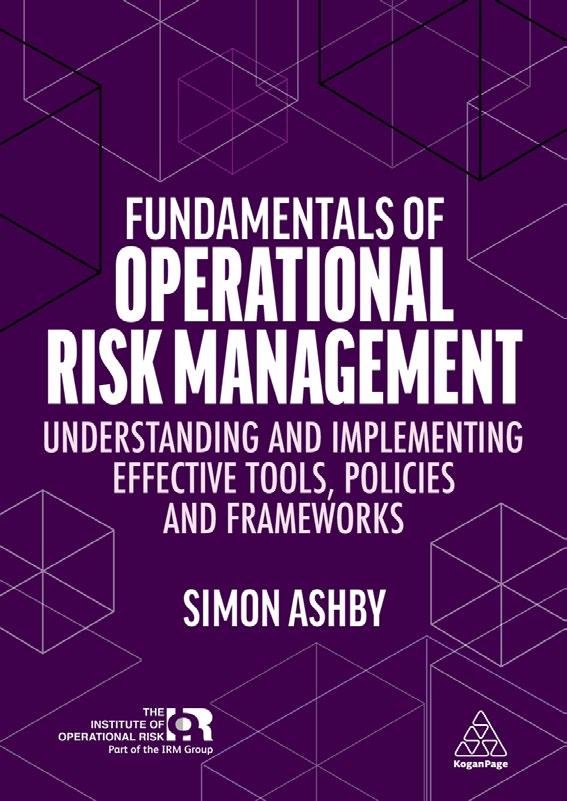
Fundamentals of Operational Risk Management outlines how to implement a sound operational risk management framework which is embedded in day-to-day business activities. It covers the main operational risk tools including categorisation, risk and control self-assessment and scenario analysis, and explores the importance of risk appetite and tolerance.
With case studies of major operational risk events to illustrate each concept, this book demonstrates the value of ORM and how it fits with other types of risk management. There is also guidance on the regulatory treatment of operational risk and the importance of risk culture in any organization. Master the essentials and improve the practice of operational risk management with this comprehensive guide.
Author Information
The IRM is a world leading professional body for risk management, driving excellence in managing risk to ensure organizations are ready for opportunities and threats of the future.
Edition: 1
Date: 04/28/2022
Price: $56.24
Paperback: 9781398605022
Ebook: 9781398605039
Pages: 320
Format (mm): 240x172
Band: Professional/ Academic
Subject: Risk Management
Table of Contents
2 Embedding operational risk management
3 Categorizing operational risks
4 Risk culture
5 Risk appetite
6 Operational risk governance
7 Risk and control self-assessments
8 Operational loss events
9 Operational risk indicators
10 Scenario analysis and stress testing
11 Organizational resilience
12 Regulating operational risk
• Contains templates and checklists covering planning, response, reporting and assurance, including a Business Impact Analysis
• Explains how to implement the best practice contained in ISO 22301:2019 and deliver an effective business continuity capability
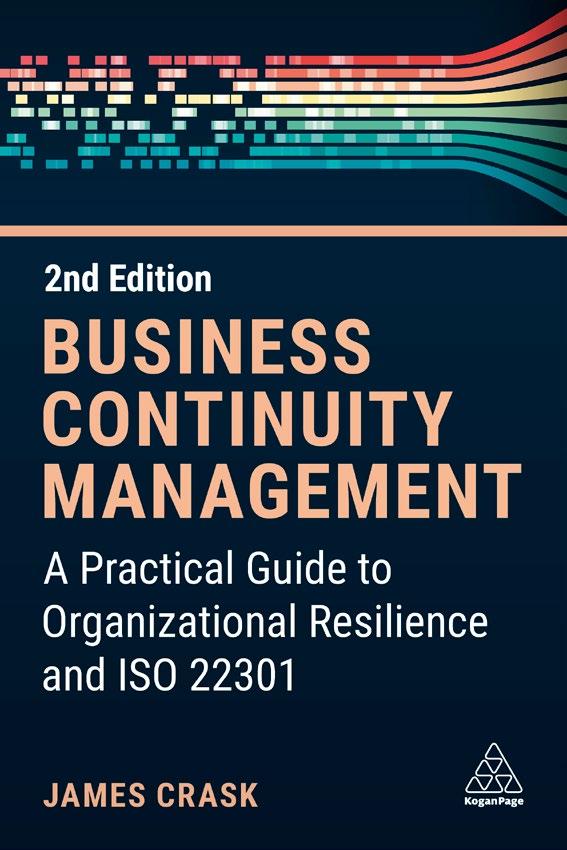
• Tackles key issues including getting the board engaged, obtaining real investment for resilience building and good practice in crisis response
• New to this edition: includes new guidance on the latest business challenges, including geopolitical risks, climate change, supply chain disruptions and the shift towards hybrid working environments. This edition also contains new content on the importance of using data to support resilience decision making with advice on scenario modelling, risk quantification and analytics. It covers the latest guidance on updates to BS 65000
Build and maintain resiliency with this practical guide to approaching risk head on and building an effective business continuity strategy.
It is critical that every business has a strong continuity plan in the face of heightened global risk and large-scale disruption. Business Continuity Management offers a straightforward and practical guide to building effective contingency plans and maintaining a resilient organization. Including tips, tools and templates, this book is a crucial guide to approaching business-wide disruption. It includes practical solutions built from the author's personal experience managing hundreds of projects in a variety of business settings.
This fully updated edition contains new case studies and guidance on the latest organizational challenges, including geopolitical risks, climate change, supply chain disruptions and how businesses can make effective decisions in a world of endless data. With key performance indicators, templates and checklists covering planning, response, reporting and assurance, this book is the essential resource for business continuity and resilience professionals.
James Crask is Global Lead for Resilience Advisory Services at Marsh, based in London, UK, working with clients to deliver resilience and business continuity solutions. He also chairs the International Standards Committee responsible for all global Business Continuity and Organisational Resilience ISO Standards, including ISO 22301:2019. He previously worked for PwC where he was responsible for building the UK firm's business resilience advisory services and has held roles for the Nuclear Decommissioning Authority and for the BBC.
Edition: 2
Date: 04/28/2024
Price: $49.99
Paperback: 9781398614871
Ebook: 9781398614888
Pages: 384
Format (mm): 234x156
Band: Professional/ Academic
Subject: Risk Management
1 Introduction
1 Core principles
2 The evolution of resilience
3 What can we learn from international standards?
4 How business continuity and resilience differs between industries
5 Comparing incident management, crisis management and business continuity
6 Good practice in crisis response
7 Lessons for business continuity and resilience from COVID-19
8 The future of business continuity management
2 Guidance on delivering an effective business continuity capability
9 Gaining and maintaining the attention of the board
10 Developing the governance and implementing resources
11 Delivering the BIA and determining recovery strategies
12 Writing plans and procedures
13 Training and exercising
14 Supply chain resilience
15 Reviewing, auditing and improving
3 Templates and checklists
16 Plan contents and tips for completion
17 Response templates
18 Assurance scorecard

• Introduces a tool for organizational resilience capability which can be scaled and adapted to any business regardless of size or complexity
• Explains how to conduct detailed assessments, report on resilience capability, benchmark performance, and develop strategies for achieving greater resilience
• Features case studies analyzing House of Fraser, Mercedes, Alibaba, BP, Transport for London and the WannaCry ransomware attack
• Covers related topics such as knowledge management, security, organizational learning, compliance and business transformation
• Avoids the common pitfalls of focusing solely on unexpected events and crisis management
For businesses to grow and be successful their approach to resilience must be defined by a holistic and risk-focused outlook, rather than one which is narrow and dominated by event-oriented continuity practices. The Organizational Resilience Handbook shows that success is as much to do with innovation and the speed with which new products are brought to market as it is with organizations having to deal with unexpected crisis situations. It comprehensively covers the full breadth and depth of the field and introduces related topics such as security, safety, e-commerce, emerging technologies and customer experience.
Through adopting a strategic and progressive approach, practitioners can apply the book's methodology to develop an in-depth understanding of resilience within their own organization and use it to effectively engage with the board and senior management in developing strategies for achieving greater resilience capability. A range of high-profile case studies, such as Mercedes, the UK's National Health Service, Alibaba and BP, help to illustrate the concept of resilience by detailing characteristics and behaviours which confirm its meaning. The Organizational Resilience Handbook is a practical guide to selfassessment, benchmarking performance and implementing resilience frameworks in any organization.
Graham Bell is a consultant and trainer specialising in organizational resilience and the assessment and mitigation of business risks. He delivers a qualification course on organizational resilience regulated by Ofqual and has 30 years' international experience in roles across manufacturing, telecoms, transport and energy sectors. He is a Fellow of the Institute for Strategy, Resilience & Security (ISRS), at University College London (UCL), and of the Institute of Strategic Risk Management (ISRM). He is also a member of the BSI Committee (CAR/001/01) tasked with the revision of BS 65000 Organization Resilience.
Edition: 1
Date: 08/28/2020
Price: $56.24
Paperback: 9781789661842
Ebook: 9781789661859
Pages: 304
Format (mm): 235x159
Band: Professional/ Academic
Subject: Risk Management
Introduction
1 Contextual setting
2 Definitions and references
3 Reasoning and benefits
4 Case studies
5 The Organizational Resilience Capability Model® (ORCM)
6 Assessment and reporting
7 Other key issues and ideas
8 Application and implementation
• Explains the underlying behavioural and organizational risks that can leave organisations vulnerable to what can be catastrophic reputational damage
• Provides a framework and insights that will help risk managers and boards to focus on and deal with the fundamental behavioural risks that underlie reputational risks
• Reveals how and why these risks remain hidden for long periods before emerging unexpectedly, giving readers the incentive to troubleshoot for their organizations well before trouble emerges
• Uses a wide variety of real-life case studies
- BP, Barclays, AIG, Volkswagen and the NHS - and examples of organizations that have suffered reputation damage to draw out insights
A company's reputation is one of its most valuable assets, and reputational risk is high on the agenda at board level and amongst regulators. Rethinking Reputational Risk explains the hidden factors which can both cause crises and tip an otherwise survivable crisis into a reputational disaster.
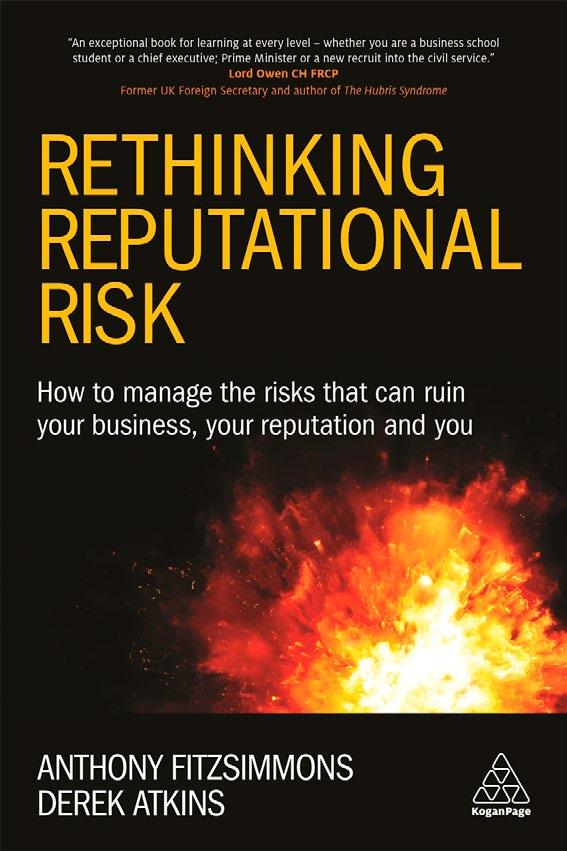
Reputations are lost when the perception of an organization is damaged by its behaviour not meeting stakeholder expectations. Rethinking Reputational Risk lays bare the actions, inactions and local 'states of normality' that can lead to perception-changing consequences and gives readers the insight to recognize and respond to the risks to their reputations. Using case studies, such as BP's Deepwater Horizon oil spill, Volkswagen's emissions rigging scandal, Tesco, AIG, EADS Airbus A380, and Mid-Staffordshire NHS Hospital Trust, and analysis of their failures, this hard-hitting guide also applies lessons drawn from behavioural economics to the behavioural risks that underlie reputation risk.
An essential read for risk professionals, business leaders and board members who need to understand and deal with business-critical threats to their reputation, this book presents a new framework that will be invaluable for all involved in safeguarding an organization's reputation.
Anthony Fitzsimmons is Chairman of Reputability LLP and an authority and leading thinker on reputational risk and the propensity of behavioural and organizational risks to cause reputational damage.
Derek Atkins BSc PhD MIMMM CEng FCIM FCII Chartered Insurer was a visiting Professor at Cass Business School, London, teaching risk management, reputational risk, and insurance, and a partner in Reputability LLP. He was the co-author of a dozen books.
Edition: 1
Date: 01/28/2017
Price: $45.99
Paperback: 9780749477363
Ebook: 9780749477370
Pages: 336
Format (mm): 235x155
Band: Professional/ Academic
Subject: Risk Management
1 Rethinking
1 Introduction
2 Reputation Basics
3 How Reputations are lost
4 What is Reputational Risk?
5 The hole in Classical Risk Management
6 Stakeholder Behaviour
7 Risks from failing to communicate and learn
8 Character, Culture and Ethos
9 Incentives
10 Complexity
11 Board composition, Skill, Knowledge, Experience and Behaviour
12 Risks from Strategy and Change
13 Incubation and complacency
14 The special role – and Risks – of leaders
2 Case studies
15 BP: Texas City Explosion
16 BP: Deepwater Horizon
17 Tesco PLC
18 American International Group (AIG)
19 EADS Airbus A380
20 Volkswagen
21 Mid Staffordshire NHS Foundation Trust (Stafford Hospital)
3 Practicalities
22 The way forward
23 System Basics – Getting to ‘go’
24 Setting up the Reputational Risk Management System
25 Operating the Reputational Risk Management System
• Provides a data-centric approach to managing common threats to confidentiality, integrity and availability including malware, data leakage, insider threat and Denial-ofService
• Explores how to prioritize relevant risks to develop and implement a successful cyber security strategy
• Covers human factors around cyber risk and how they impact employee training, cyber awareness and effective communication
• New to this edition: the impact of Web3 and the metaverse on cyber security; supplychain security in the gig economy; exploration of the global, macroeconomic conditions that affect strategies; how COVID-19 and remote working changed the cybersecurity landscape; new interviews and case studies from organizations including Volvo
• Contains interviews, examples and use cases with leading security and risk professionals from a variety of industries
How can you manage the complex threats that can cause financial, operational and reputational damage to the business? This practical guide shows how to implement a successful cyber security programme.
The second edition of Cyber Risk Management covers the latest developments in cyber security for those responsible for managing threat events, vulnerabilities and controls.
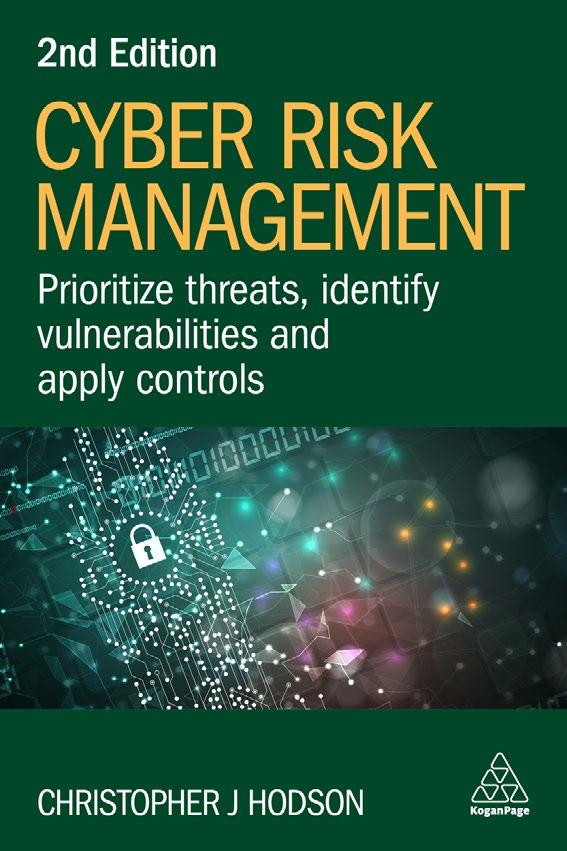
These include the impact of Web3 and the metaverse on cyber security, supply-chain security in the gig economy and exploration of the global, macroeconomic conditions that affect strategies. It explains how COVID-19 and remote working changed the cybersecurity landscape and features new interviews and case studies from organizations including Volvo.
Cyber Risk Management presents a data-centric approach to cyber risk management based on business impact assessments, data classification, data flow modelling and assessing return on investment. It covers pressing developments in artificial intelligence, machine learning, big data and cloud mobility, and includes advice on dealing with malware, data leakage, insider threat and Denial-of-Service. With analysis on the innate human factors affecting cyber risk and awareness and the importance of communicating security effectively, this book is essential reading for all risk and cybersecurity professionals.
Christopher J Hodson is Chief Information Security Officer (CISO), at Contentful, a software development company offering a content platform for digital-first businesses. Based in Reading, UK, he has 18 years' experience across the financial, retail, energy and media industry sectors and was previously CISO, EMEA at Tanium and CISO, EMEA and Data Protection Officer at Zscaler. He is a Curriculum Advisor, speaker and writer for the CompTIA Cybersecurity Advisory Board and a Guest Lecturer at Royal Holloway, University of London.
Edition: 2
Date: 02/28/2024
Price: $53.99
Paperback: 9781398613492
Ebook: 9781398613508
Pages: 416
Format (mm): 234x156
Band: Professional/ Academic
Subject: Risk Management
1 Contextualizing cybersecurity risk
1 Why now? The only constant is change
2 Technologies and security challenges
3 Data breaches
2 Cybersecurity programme management
4 What are cybersecurity and cybercrime?
5 Establishing a cybersecurity programme
3 Actors, events and vulnerabilities
6 Threat actors
7 Threat events
8 Vulnerabilities
9 Controls
4 Conclusion – The cybersecurity risk equation explained
10 Cyber risk management – A conclusion
• Explains how organizations can achieve their digital transformation goals without creating undue cybersecurity risks
• Brings together chapters written by senior practitioners of cybersecurity from a wide range of industry sectors
• Based on principles that have been independently shown to improve cybersecurity by enhancing risk management, aligning business goals and creating a culture of security throughout an organization
• Explores the roles and responsibilities of each department in managing cyber risk, including HR, Legal, Audit, M&A and Supply Chain Management
• Reframes cybersecurity as a strategic business issue and translates board-level principles to the management level
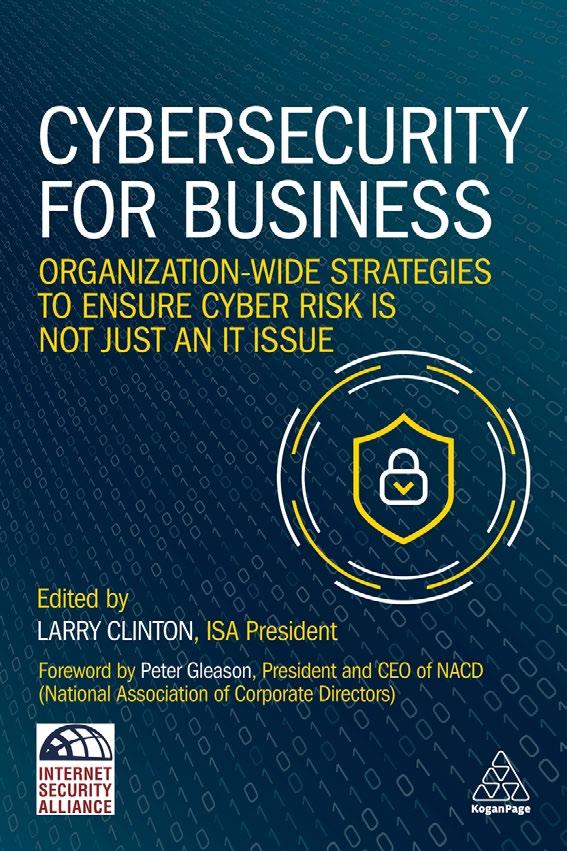
FINALIST: International Book Awards 2023 - Business: General
Balance the benefits of digital transformation with the associated risks with this guide to effectively managing cybersecurity as a strategic business issue.
Important and cost-effective innovations can substantially increase cyber risk and the loss of intellectual property, corporate reputation and consumer confidence. Over the past several years, organizations around the world have increasingly come to appreciate the need to address cybersecurity issues from a business perspective, not just from a technical or risk angle. Cybersecurity for Business builds on a set of principles developed with international leaders from technology, government and the boardroom to lay out a clear roadmap of how to meet goals without creating undue cyber risk.
This essential guide outlines the true nature of modern cyber risk, and how it can be assessed and managed using modern analytical tools to put cybersecurity in business terms. It then describes the roles and responsibilities each part of the organization has in implementing an effective enterprise-wide cyber risk management program, covering critical issues such as incident response, supply chain management and creating a culture of security. Bringing together a range of experts and senior leaders, this edited collection enables leaders and students to understand how to manage digital transformation and cybersecurity from a business perspective.
Internet Security Alliance provides thought leadership in cybersecurity and works with the US government to advocate for public policy that will advance the interests of cybersecurity.
Larry Clinton is President of the Internet Security Alliance. He advises industry and government on cyber policy and regularly appears in the media to provide an expert opinion. He has briefed NATO, the Organization of American States (OAS), G-20 and the US Congress. He has twice been named to the NACD 'Directorship 100' list of the most influential individuals in corporate governance.
Edition: 1
Date: 04/28/2022
Price: $41.99
Paperback: 9781398606142
Ebook: 9781398606395
Pages: 264
Format (mm): 234x157
Band: Professional/ Academic
Subject: Cyber Security
1 Why we need to take an enterprise-wide approach to cyber risk
1 The growing cyber threat – Not just an “IT” issue
2 View from the top – How boards are addressing cyber risk
3 Structuring the organization for the digital age
4 A modern approach to assessing cyber risk
2 How to manage cyber risk from an enterprise-wide perspective
5 The roles and responsibilities of human resource management in cybersecurity
6 The roles and responsibilities of legal and general counsel
7 The roles and responsibilities of audit and compliance
8 Cybersecure supply chain and third-party management
9 The roles and responsibilities of technical operations
10 The roles and responsibilities of external communications and crisis management
11 The roles and responsibilities in mergers and acquisitions
12 The roles and responsivities of cyber operations in developing a culture of security
• Provides a clear explanation of 50 of the most well-known business models in one reliable resource, ensuring readers can solve business challenges in any context
• Outlines every model's history, along with relevant theory, business application and real-world case studies
• Helps readers add structure and clarity to business problems and gives them templates they can apply to overcome their own professional challenges
• New to this edition: 10 new frameworks including Kay's distinctive capabilities, VMOST, 3c framework and the Competitive advantage matrix; coverage of recent developments in applying these models, from using technology to enhance engagement to applying them remotely
• Online Resources: lecture slides to support each chapter
Business frameworks sit at the heart of successful businesses. The second edition of The Business Models Handbook brings together the most helpful and widely used models into one invaluable resource.
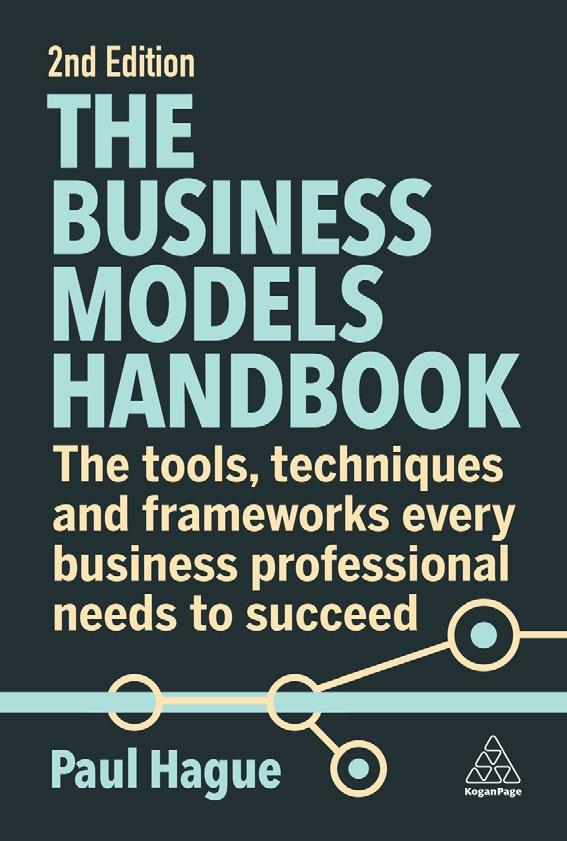
Business models add structure and clarity to business problems, help practitioners overcome the everyday challenges they face and enable the organization to grow and be profitable. Each chapter of this book focuses on an individual business framework, giving an overview of 50 of the best-known frameworks. These cover essential business topics such as benchmarking, competitive intelligence, gap analysis and value chains.
In this second edition, these include Kay's distinctive capabilities, Customer Activity Cycle and the 3C framework. It also covers the most recent developments in applying these models, including how to embed them remotely. Authored by a leading global market researcher with a background working on over 3,000 different research projects and supported by real-world case studies for each model, The Business Models Handbook is an invaluable resource for any professional or student. Online resources include lecture slides that align with each chapter.
Paul Hague is founder of B2B International Ltd, a global market research company. Based in Manchester, UK, he is Fellow of the Market Research Society and the author of ten books, sharing 30 years of practical experience in market research and marketing. He is a visiting fellow at Manchester Metropolitan University and a guest lecturer at Manchester Business School. He is the author of Market Research in Practice and co-author of B2B Customer Experience, also published by Kogan Page.
Edition: 2
Date: 08/28/2023
Price: $35.99
Paperback: 9781398611757
Ebook: 9781398611764
Pages: 392
Format (mm): 233x157
Band: Professional/ Academic
Subject: Strategy
• Explains how managers and leaders can influence, measure and reinforce employee behaviours that lead to actual results
• Brings together academic theories and practitioner experience drawn from behavioural psychology, strategy and change management
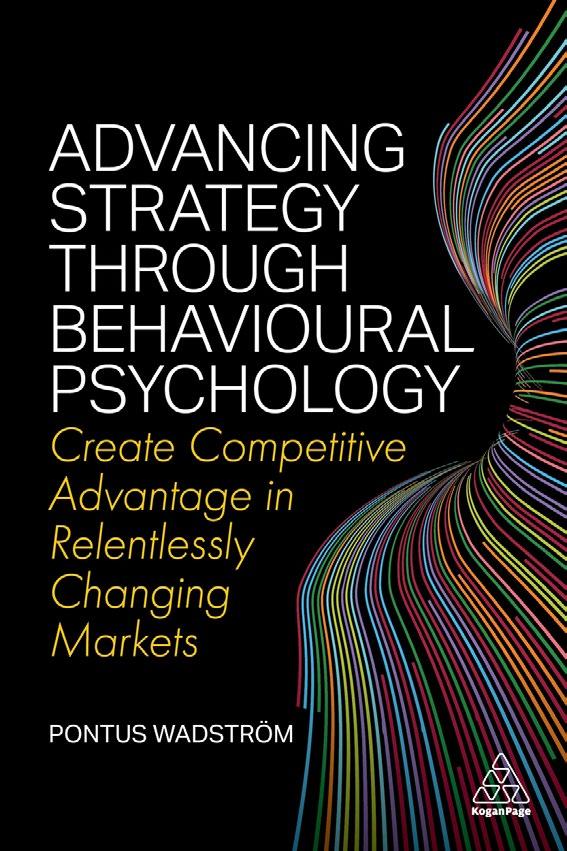
• Explores how adopting a behavioural approach leads to greater adaptability in rapidly changing business circumstances
• Considers the importance of understanding behaviour in encouraging innovation and improving employee engagement
• Proves that by spending less time on giving instructions and more time on follow-up, feedback and learning, organizations can achieve better results
Accelerate strategy and achieve desired results with this guide to understanding and influencing employee behaviour, based on the theory and practice of strategic management, behavioural psychology and change.
The realisation of strategy is entirely dependent on employee behaviour, so in order to achieve business results it is vital that managers and leaders develop an understanding of human behaviour. Advancing Strategy through Behavioural Psychology shows that by identifying which behaviours should be measured and encouraged, organizations can succeed in implementing strategies for continuous adaptation in a rapidly changing business environment.
Grounded in practitioner experience and academic research, this book argues that to achieve set goals organizations should spend less time planning and sending out instructions and more time on providing feedback on implementation and drawing out key points to be learned. By focusing on behaviour in this way, organizations can create a culture where innovation is encouraged and employees want to contribute to the company's future. Ensure long-term success and seize competitive advantage with this essential guide to identifying the key behaviours which will create business results and what influences them.
Pontus Wadström is an independent consultant and advisor in strategy and change based in Stockholm, Sweden, and has worked with all types and sizes of organization in almost all industries. He is also an affiliate researcher and lecturer at KTH Royal Institute of Technology, Stockholm. His research focus is on how large and complex organizations 'do' strategy in practice, all influenced by his previous studies in both management and behavioural psychology.
Edition: 1
Date: 04/28/2022
Price: $41.99
Paperback: 9781398604827
Ebook: 9781398604865
Pages: 256
Format (mm): 235x155
Band: Professional/ Academic
Subject: Strategy
1 A theory of everything
1 Introduction to strategy and behaviour
2 Strategy, change and behavioural psychology
3 A common language
4 Behaviour – The least common denominator
2 Arbitrariness is over
5 Old management principles are no longer good enough
6 The organization, its development and lack of development
7 Evidence and measurement
3 Unexpected simplicity
8 Behaviour – The foundation of everything
9 Activators – The igniting spark
10 Consequences – No feedback is also feedback
4 Strategy is behavioural change
11 A behavioural view of strategy
12 To realise strategy is to change
13 Exploiting competitive advantages – Big, best, fast and beautiful
5 Smart as a competitive advantage
14 From individual insight to competitive edge
15 Smart and behavioural strategising
16 The future of competitive advantage
• Dispels the ambiguity around on-trend buzzwords and explains how executives can deliver flexibility and entrepreneurship at a strategic, organizational and leadership level
• Includes case studies from companies including General Electric, Lego, Accor Hotels, ING, LVMH and Deutsche Telecom
• Explains why business agility is much more than agile
• Provides diagnostic tools to measure a business' starting level of agility and practical models to help any business to start and sustain a successful agility transformation
• Shows that it is possible to embrace uncertainty, rather than fear it
SHORTLISTED: Business Book Awards 2022 - Change & Sustainability
The ability to renew competitive advantage with flexibility is essential for any business in today's turbulent world. How do you go beyond trendy buzzwords and master the principles of business agility?
Resetting Management helps leaders understand why business agility matters. Agility releases a new level of energy, innovation and entrepreneurship, enabling organizations to respond to disruption while still delivering business strategies with rigour and efficiency. Using diagnostic tools and practical models, the book describes how to master the essential components and principles of agility and respond to uncertain and fast-changing environments.

Featuring case studies from some of the world's leading companies and illustrating how they have successfully and less successfully transformed for greater agility - including Lego, General Electric, LMVH and ING - Stéphane J.G. Girod and Martin Králik provide leaders with the skills to master the transformation journey that is right for their business.
Stéphane J.G. Girod is Professor of Strategy and Organizational Innovation at IMD business school in Lausanne, Switzerland. He writes a column in Forbes.com and his opinion pieces have been carried by China Daily, The Economist, BBC News, Tribune de Genève and The Times. Before joining IMD he was Manager of the Accenture Institute for High Performance, based in London.
Martin Králik is an IMD external associate, based in Southeast Europe. Before IMD, he worked with Insead and the International Data Corporation.
Edition: 1
Date: 06/28/2021
Price: $25.99
Paperback: 9781789667172
Ebook: 9781789667189
Pages: 280
Format (mm): 234x156
Band: Professional/ Academic
Subject: Leadership
1 A Call to Action (Why)
1 Why Agility?
2 The What of Business Agility - Reshaping How Organizations Make Choices
2 A New Agility Landscape (What)
3 Strategic Agility
4 Ramping Up Organizational Agility Without a Profound Overhaul of the Hierarchy
5 Intermediate Stage of Organizational Agility - Pockets of Agility, Powered by Agile Methods
6 Organizational Agility: The Pioneers of New Organizational Forms
7 Leadership Agility
3 How to Transform for Agility Successfully
8 Managing the Trade-offs of Strategic Agility
9 Navigating the Challenges of Implementing Agile Methods
10 Managing the Trade-offs of Radically New Organizational Forms
11 Final words
• Explains what businesses need to do to thrive in the increasingly uncertain context of the fourth industrial revolution, and how this can be achieved
• Illustrates the importance of establishing long term strategy, despite the turbulence and unpredictability of the markets, and provides tools and techniques to make these decisions
• Outlines the dynamic capabilities firms require to achieve competitively superior performance, with examples of good practice and advice on how to strengthen areas of relative weakness
• Includes a self-assessment questionnaire to assess the dynamic capacity of your organization, which can be an indicator of future performance
• Draws on robust research which tracked organizations over five years as well as the author's experience as an international business consultant
LONGLISTED: CMI Management Book of the Year 2021
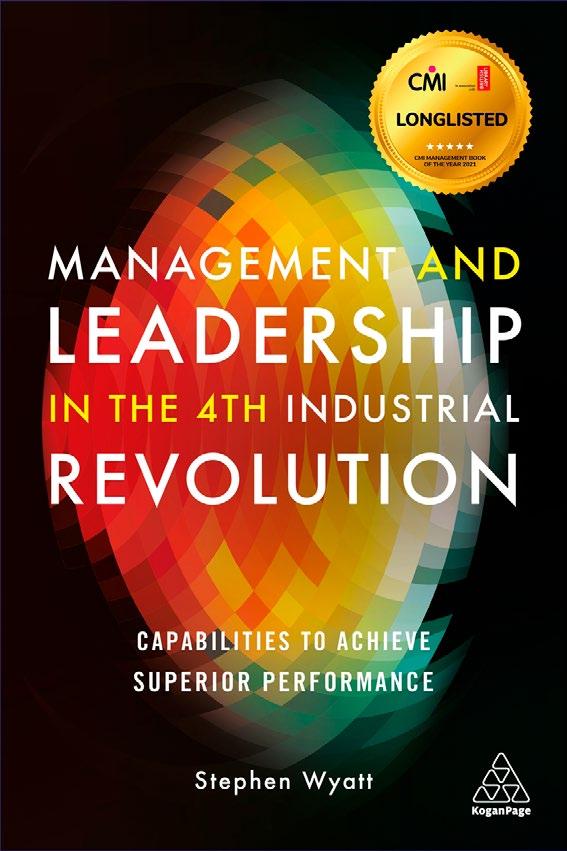
The business world is currently experiencing fundamental disruption, in part driven by the technology enabled Fourth Industrial Revolution. Corporate value is created and lost in breathtakingly short periods, and the rise of 'unicorns' against the demise of oncevenerated organizations has shown that how firms compete has changed. Management and Leadership in the 4th Industrial Revolution presents a framework for managing and winning in the new accelerated world of business, focusing on the key capabilities organizations now need to achieve competitively superior performance.
Building on the 'dynamic capabilities' approach already familiar to strategists and based around his own research, Stephen Wyatt shows how executives can assess the dynamic capacity of their organization - a leading indicator of future performance in comparison to their industry peers.
Written in an accessible style with best practice examples from companies and quotes from executives to support each insight, this book includes a self-assessment questionnaire to measure the dynamic capacity of your organization and advice on how to strengthen areas of relative weakness. Management and Leadership in the 4th Industrial Revolution offers timely insights on driving innovation and emphasizes the importance of long-term strategy, change management and new models of dynamic leadership.
Stephen Wyatt is Professor of Strategy and Leadership at the University of Bath. For over 25 years he has been a business consultant focused on developing leaders and enabling organizations to thrive in highly dynamic environments. He is also Affiliate Faculty at Singapore Management University and Industrial Associate at the University of Cambridge, and serves on the boards of the Global Innovation Management Institute and the Management Consulting Institute.
Edition: 1
Date: 11/28/2020
Price: $25.99
Paperback: 9781789666809
Ebook: 9781789666816
Pages: 280
Format (mm): 235x152
Band: Professional/ Academic
Subject: Leadership
1 Introduction
1 Competing for tomorrow, today
2 Build dynamic capacity - Thrive in 4IR
2 Sense & Make Sense
3 Seize & Replicate
4 Reposition & Reconfigure
3 Drive audacious growth - Be purpose-led
5 Purpose-led, forward-leaning
6 Ambidextrous - ‘Both AND’ mindset
7 Continuous evolution
4 Win the 4IR talent race
8 The race to develop 4IR talent
9 Deploy talent with fluid teaming
10 Human-centred workforce managementDuty of care
5 Dynamic advantage
11 Superior performance in 4IR
6 Summary
12 Boosters and key themes
• Addresses business model transformation as a leadership challenge providing actionable tools and guidance for companies
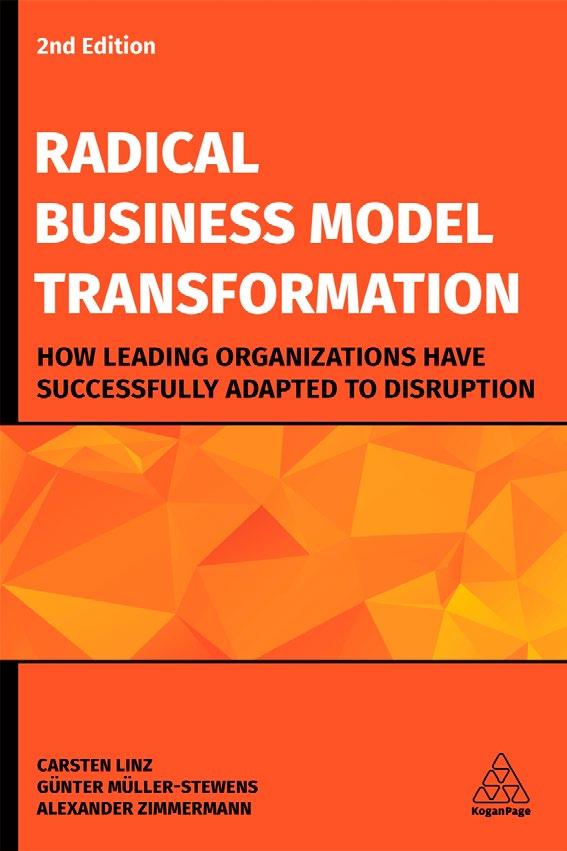
• Provides insights into organizations that have made radical shifts including SAP, Netflix and Daimler
• New to this edition: updated case studies with a global focus, new literature to keep up-to-date with the academic discourse and new chapters on areas such as Digital Transformation
How can organizations complete a major business model transformation and how can leaders successfully guide their business through this radical shift?
As markets are constantly transformed by new technologies and disruptor competitors, once successful business models designed to function in a different time now struggle as the mainstream changes. This book is the guide for organizations looking to turn downward trends into upward momentum and gain an edge on the competition.
Now in its second edition, this book offers practical advice on how to understand the fit of an existing business model and reconstruct it with a forward-thinking approach. New illustrative case studies of global organizations which have boldly transformed offer examples for change, including SAP, Netflix and Daimler. Business transformation is presented as a leadership challenge and methods to realize and implement opportunities for innovation company-wide are discussed in detail. Radical Business Model
Transformation is essential reading for business leaders, transformation experts and MBA students interested in ensuring that their business model is future-proof and can withstand the new proliferation of innovations set to transform the business landscape.
Carsten Linz is leading organizations to transform for the digital-intelligent age. During his 20 years in executive roles focused on software and data fueled growth, he has built several €100 million businesses and led company-wide transformation programs. His most recent roles include Group Digital Officer at BASF, Business Development Officer at SAP, and Global Head of the Center for Digital Leadership. He holds senior advisory roles, e.g. for the World Economic Forum's 'Digital Platforms and Ecosystems' project, serves on the committee of Europe's largest seed stage fund, and teaches in Executive programs at leading business schools. His blog is carstenlinz.com
Günter Müller-Stewens is Professor Emeritus of the Institute of Management and Strategy at the University of St. Gallen, Switzerland. His most recent main research interest is corporate strategy, as well as the competencies and contributions of strategists in organizations.
Alexander Zimmermann is Chaired Professor of Entrepreneurship and Strategic Management and Executive Director of the MBA in Technology and Innovation at the University of Liechtenstein. As well as teaching he acts as a moderator and coach to assist companies' strategic and organizational transformation processes.
Edition: 2
Date: 10/28/2020
Price: $39.95
Paperback: 9781789661965
Ebook: 9781789661972
Pages: 368
Format (mm): 230x150
Band: Professional/ Academic
Subject: Strategy
About the authors
1 Why business models need to radically shift
1 How business model transformation became mainstream
2 Working with the Business Transformation Board
2 Navigating the business model transformation journey
3 Drivers of business model transformation
4 How to assess your current and target business model
5 How to lead a radical shift of your business model
3 Learning from successful transformational organizations
6 Case studies of companies radically shifting the level of inclusiveness
7 Case studies of companies radically shifting the level of customization
8 Case studies of companies that sequence multiple radical shifts
4 How to move forward
9 Mastering the transformational leadership challenge
10 Designing your business model transformation path
11 Index
• Explains what information qualifies as evidence and how it can drive better organizational decisions
• Outlines how to improve the quality of organizational decisions by using data from multiple sources including organizational data, professional expertise, stakeholder values and scientific literature
• Shows how to critically analyze and evaluate evidence in order to get the most out of it
• Online resources: Lecture slides, case studies, exercises and further reading
Decisions in businesses and organizations are too often based on fads, fashions and the success stories of famous CEOs. At the same time, traditional models and new cuttingedge solutions often fail to deliver on what they promise.
This situation leaves managers, business leaders, consultants and policymakers with a profound challenge: how can we stay away from trends and quick fixes, and instead use valid and reliable evidence to support the organization?
In response to this problem, evidence-based management has evolved with the goal of improving the quality of decision-making by using critically evaluated evidence from multiple sources - organizational data, professional expertise, stakeholder values and scientific literature. This book sets out and explains the specific skills needed to gather, understand and use evidence to make better-informed organizational decisions.
Evidence-Based Management is a comprehensive guide that provides current and future managers, consultants and organizational leaders with the knowledge and practical skills to improve the quality and outcome of their decision-making. Online resources include case studies, exercises, lecture slides and further reading.
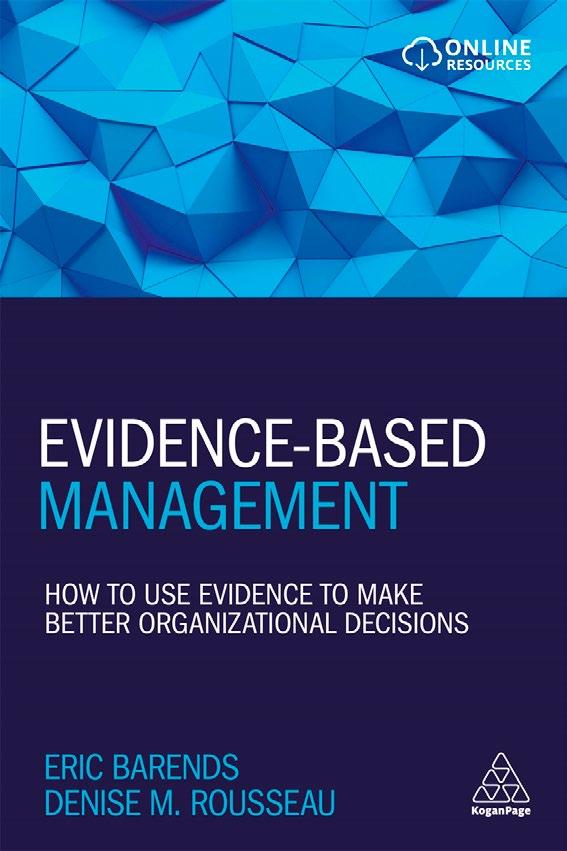
Eric Barends is Managing Director of the Center for Evidence-Based Management and advises management teams and boards of directors on evidence-based management and decision-making. He is also a visiting lecturer at New York University, Australian National University and VU University Amsterdam.
Denise M Rousseau is the H J Heinz II University Professor of Organizational Behavior and Public Policy at Carnegie Mellon University's Heinz College and Tepper School of Business. She was formerly the President of the Academy of Management and is an adviser to numerous social enterprises, professional associations, and governmental and for-profit organizations.
Edition: 1
Date: 09/28/2018
Price: $51.99
Paperback: 9780749483746
Ebook: 9780749483753
Pages: 392
Format (mm): 235x155
Band: Professional/ Academic
Subject: Strategy
1 Evidence-based management: the basic principles (with Rob Briner)
2 ASK: Critical questions about assumed problems and preferred solutions
1 Evidence from practitioners
3 ACQUIRE: Evidence from practitioners
4 APPRAISE: Evidence from practitioners
2 Evidence from the scientific literature
5 A short introduction to science (with Rob Briner)
6 ACQUIRE: Evidence from the scientific literature
7 APPRAISE: Evidence from the scientific literature (with Rob Briner)
3 Evidence from the organization
8 ACQUIRE: Evidence from the organization (with Martin Walker)
9 APPRAISE: Evidence from the organization (with Martin Walker)
4 Evidence from stakeholders
10 ACQUIRE: Evidence from stakeholders
11 APPRAISE: Evidence from stakeholders
12 AGGREGATE: Weighing and pulling together the evidence
13 APPLY: Incorporating the evidence into the decision-making process (with Alessandra Capezio)
14 ASSESS: Evaluate the outcome of the decision taken
15 Building the capacity for evidence-based management
16 Guidelines for critically appraised topics

• Focuses on how businesses can become more sustainable in practice (the 'how') rather than on the case for sustainability (the 'why')
• Features practical tools and tips and a variety of case studies of organizations successfully embracing sustainability
• Covers the whole process to sustainability, from defining an organizational purpose and setting goals to engaging stakeholders, creating a successful culture and avoiding common pitfalls
• Spotlights actionable examples of how businesses can become more innovative, resilient and successful by becoming more sustainable
• Explores how sustainable businesses create long term value by minimising negative social, environmental and economic practices and maximizing positive impacts
Edition: 1
Date: 02/28/2022
Price: $41.99
Paperback: 9781398604049
Ebook: 9781398604056
Pages: 328
Format (mm): 235x156
Band: Professional/ Academic
Subject: Sustainability in Business
3
12
• Reveals how Ben & Jerry's, Unilever, Nike, Danone, Ikea, NEC, Jaipur Rugs and BlackRock made the strategic shift from minimizing risk to creating social value
• Outlines strategies and practices for companies to create purpose, engage the "whole person," create value for society and revive the planet
• Offers a self-assessment to help readers evaluate their company's mindset and practices
• Online resources include a guide to help employees become socially conscious, operate in a purposeful company, become allies for social justice, add social value to their products and establish "green" habits
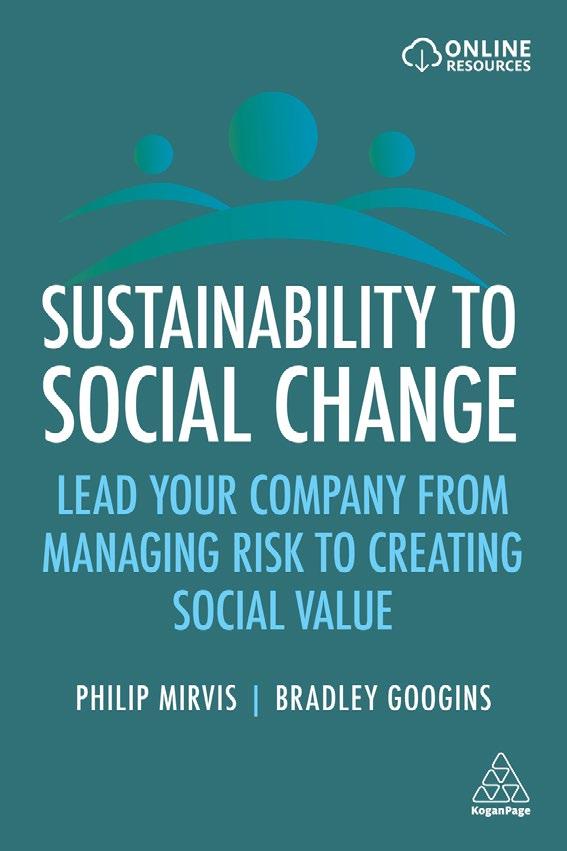
Is your company using its talent to create social value? Or is it simply managing risks? To address the problems facing society and business today, sustainability is not good enough.
Instead, companies need to do their part to lead social change. In Sustainability to Social Change, leadership and social innovation experts Philip Mirvis and Bradley K. Googins share their hands-on research to reveal how leaders can design and guide their companies to create more inclusive prosperity and become agents of social change. The book reveals the inside story of how socially innovative companies are making the strategic shift from minimizing risk to creating social value. It then outlines the strategies and practices that leaders can use to address the five biggest problems facing companies and society today: Purpose, Prosperity, Products, Planet and People.
Filled with real life examples, hands-on guidelines and self-assessments to rate your company's performance, Sustainability to Social Change helps you pivot your company's mindset and practices in order to enhance society and the environment, and fuel its own success. Online resources include a guide to help employees become socially conscious, operate in a purposeful company, become allies for equity and social justice, add social value at work and establish "green" habits.
Philip Mirvis is an organizational psychologist who serves as senior research fellow for the Global Network on Corporate Citizenship and Babson Social Innovation Lab. He is based in Ranchos des Taos, New Mexico. He has led public and corporate seminars, and lectured in over 50 nations throughout Asia, Europe, and Africa, and in Brazil and Australia.
Bradley Googins is a retired professor and former Director of the Center of Corporate Citizenship at Boston College. He is currently a visiting professor of Strategy and Entrepreneurship at the Catholic University of Milan. He is based in Watertown, Massachusetts.
Edition: 1
Date: 03/28/2022
Price: $32.95
Paperback: 9781398604353
Ebook: 9781398604360
Pages: 264
Format (mm): 235x158
Band: Professional/ Academic
Subject: Leadership
Introduction
1 Where We Are Now and What’s Next
1 Sustainability - The End of the Beginning
2 Social Change - The Start of Something New
3 Business as an Agent of ChangeTrailblazers and Transformers
4 Changemaking - Gearing Up to Lead Social Change
2 Lead Your Company into the Future
5 Put Purpose First
6 Make Prosperity Inclusive
7 Engage the Whole Person
8 Produce Social Value
9 Revive the Planet
10 Systemic Social Change
11 Epilogue
• Provides a practical approach to systems thinking that will help students to apply their knowledge to wider organizational challenges
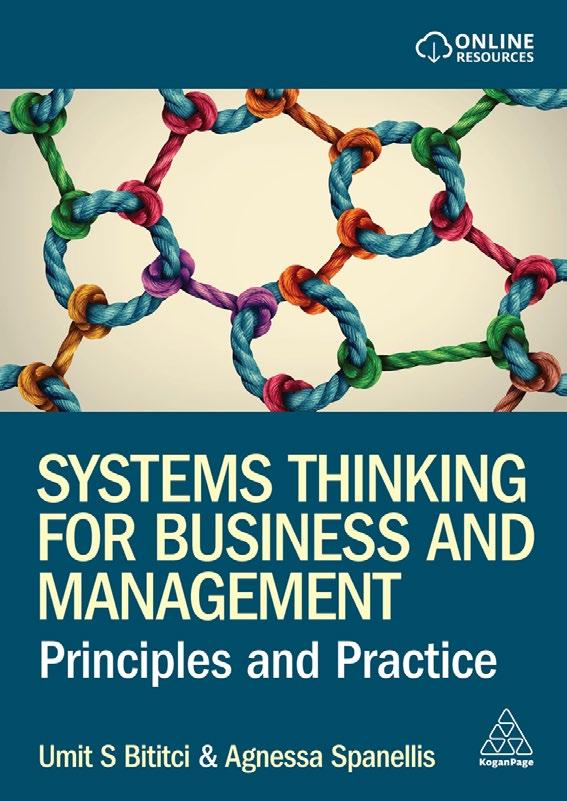
• Uses examples from business to help students understand the concepts and illustrate the applications of methods covered, such as from sustainability and climate change, data continuity and reporting and new technologies
• Online resources: Customisable PowerPoint slides and video links
• Features experiential, engaging pedagogy throughout such as reflective exercises, teamwork activities and a running case study, helping students engage with the concepts and apply theory to practice
• Encourages critical thinking, decision-making and problem-solving capabilities in students, helping them to develop a questioning mindset and enhance their employability skills
Edition: 1
Date: 11/28/2023
Price: $47.99
Paperback: 9781398611665
Ebook: 9781398611672
Pages: 376
Format (mm): 240x170
Band: Textbook
Subject: Systems Thinking
1 Introduction
1 Fundamentals of Systems Thinking
2 Introduction to Systems
3 Understanding Systems
2 Models and Methods
4 Common System Models and Frameworks
5 Modelling Hard Systems
6 Modelling Soft Systems
7 Systems Thinking in Group Decision Making
3 System Complexity
8 Understanding the Behaviour of Complex Systems
9 Changing Complex Systems
4 Looking into the Future
10 Future Systems Thinking
11 Summary and key takeaways
• Features activities and international case studies to illustrate good writing practices and to apply practical knowledge
• New to this edition: new chapters on writing well across disciplines, how social media and the spoken word affects writing, and new business case studies which include companies such as L'Oréal
• Provides a confidence boost to both native and non-native English speakers in writing in and for professional environments, as well as writing globally
Unlearn bad habits, sharpen your emails and improve your written communication throughout your business with How to Write Effective Business English. An easyto-follow guide on how to write with confidence, whether or not English is your first language.
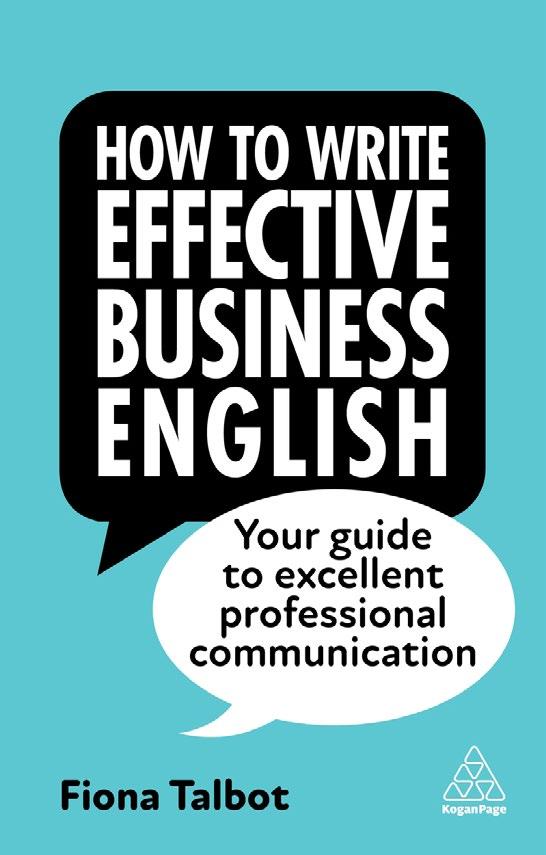
With new chapters on writing well across all disciplines, writing globally, and the impact of social media on workplace communication, this new edition prepares you to clearly liaise with your colleagues and to your target market in order to get your point across.
Not only is this for individuals who want to better their craft and build their confidence, but it's also for multinational companies where communication is vital. Whether you're fluent in English or still learning, all speakers can iron out areas where there are common misconceptions, and bring those skills into their workplace.
Fiona Talbot informs you on how to format your prose to cater for a business world, by using case studies from L'Oréal, Loaf Furniture and Octopus Energy to demonstrate how English is used internationally in business and to teach you how to address different scenarios, whilst putting your best foot forward. Express yourself in business in a clear manner on all platforms, and get your message across with impact.
Fiona Talbot is an internationally acclaimed business writing author. She works in the UK and internationally, training and advising on how to deliver premier written corporate communication for both native and non-native English speakers in today's digital, global economy. She has featured in major publications such as The Sunday Times, The Irish Times, The Press Association, Accounting Technician and Personnel Management. She is also the author of Improve Your Global Business English, Make an Impact with Your Written English, and Executive Writing Skills for Managers, all published by Kogan Page. Fiona Talbot is based in Chester, UK.
Edition: 4
Date: 05/28/2023
Price: $19.99
Paperback: 9781398609952
Ebook: 9781398609969
Pages: 200
Format (mm): 235x158
Band: General
Subject: Workplace Skills
Introduction
1 Business writing today
2 Why are you writing?
3 It’s crucial to connect at every stage of your career
4 Quality matters
5 Telling your story through social media
6 Standard or variant English – and changing punctuation and grammar
7 Writing globally ? Or in multinational teams?
8 Email and instant messaging
9 Practical conventions and common confusions
10 Look to the future
11 Conclusion: what will you do differently –and better?
Innovation and Best Practice in:
Introduction to HRM
Human Resource Management
Business Environment

HR Analytics



















































































































HR Leadership
International HRM
HR Technology
Strategic HRM
Sustainable HRM



Organizations












Organizational Development
Diversity & Inclusion
Employee Engagement
Employment Law & Relations




























































































































































































Talent Management & Recruitment
Performance Management


Reward Management
Coaching
Learning & Development
• Develops understanding of all the essential areas of the HR function, such as employment law, learning and development and performance management
• Ideal for professionals and those studying undergraduate and postgraduate degrees, both CIPD and non-CIPD courses
• Supports learning with a range of pedagogical features including key learning points and case studies from international organizations such as IBM and HSBC
• New to this edition: chapters on the future of work and managing remote employees; coverage of the contribution of the HR function to corporate social responsibility and employee wellbeing
• Online resources: comprehensive handbooks for lecturers and students, lecture slides with figures, glossary, flash cards, bibliography and a cross references CIPD Diploma (levels 5 and 7) handbook
Armstrong's Handbook of Human Resource Management Practice is the definitive resource for HRM students and professionals, helping readers understand and implement HR to align with business needs.
This book provides detailed coverage of all areas essential to the HR function such as employment law, employee relations, learning and development, performance management and reward management. It also covers the HR skills needed to ensure professional success, including leadership, managing conflict, interviewing and using statistics. It is illustrated throughout in full colour and has a range of pedagogical features to consolidate learning such as source review boxes, key learning points and case studies from international organizations such as IBM, HSBC and Johnson and Johnson. This fully updated 16th edition includes new chapters on managing remote workers and developments in digital human resource management practices. There are also updates to reflect the changes throughout the HR function, such as performance leadership, 'smart' reward and employee wellbeing.
Armstrong's Handbook of Human Resource Management Practice is suited to both professionals and students of undergraduate and postgraduate degrees. It is also aligned with the Chartered Institute of Personnel and Development (CIPD) profession map so can be used by those studying the Associate Level 5 and Advanced Level 7 qualifications. Online supporting resources include comprehensive handbooks for lecturers and students, lecture slides, all figures and tables, toolkits, and a literature review, glossary and bibliography.
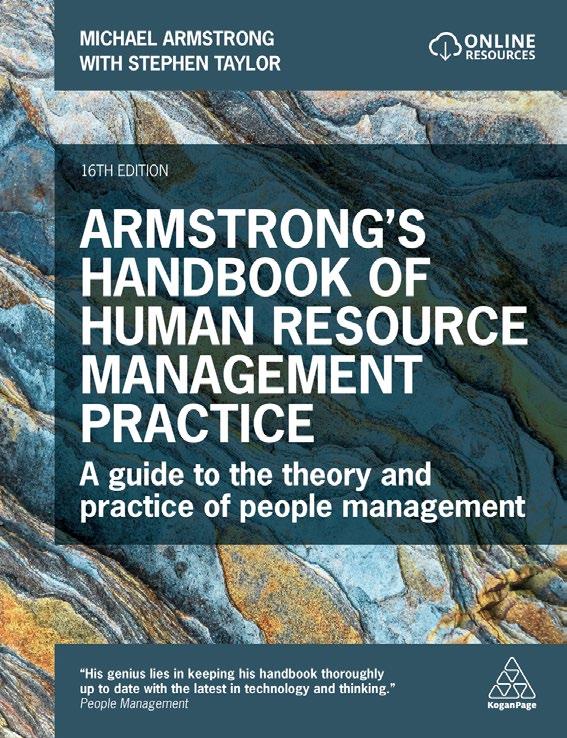
Michael Armstrong is the UK's bestselling author of HRM books. With over a million copies sold, his books have been translated into 21 languages. Based in London, UK, he is managing partner of E-Reward and was previously a chief examiner of the Chartered Institute of Personnel and Development (CIPD).
Stephen Taylor, Chartered CCIPD, is a senior lecturer in Human Resource Management at the University of Exeter Business School and a chief examiner for the CIPD.
Edition: 16
Date: 01/28/2023
Price: $69.99
Paperback: 9781398606630
Ebook: 9781398606647
Pages: 760
Format (mm): 245x190
Band: Textbook
Subject: Introduction to HRM
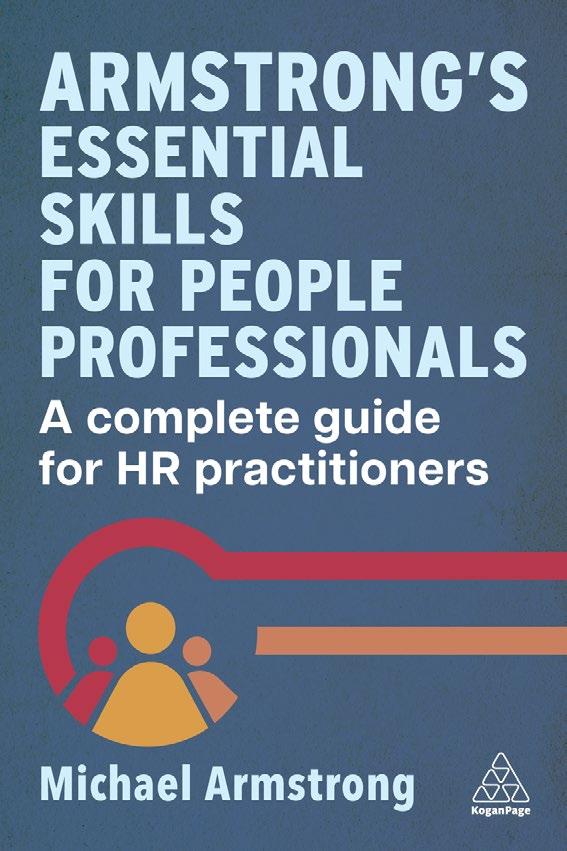
• Explains the role of a people professional and outlines the skills needed to succeed
• Provides guidance on essential skills such as recruitment, managing performance and reward, employee engagement and L&D
• Outlines competencies needed to deal with business issues including analyzing data, managing equity, diversity and inclusion (EDI) and contributing to the organization's ESG rating
• Offers techniques for handling people problems, conflict and challenging conversations
• Includes a dedicated section on personal skills such as problem-solving, decisionmaking, critical thinking, influencing and negotiation
A complete guide to the skills needed to be a successful people professional written by the UK's bestselling human resource management author.
Armstrong's Essential Skills for People Professionals is an essential resource for all current and aspiring HR practitioners. There is complete coverage of the fundamental skills needed including those for interviewing, selection, managing performance and reward, Learning and Development (L&D) and employee engagement. This book also covers techniques for handling people problems, navigating challenging conversations and managing conflict.
In addition, there is also coverage of strategic people management capabilities such as managing equity, diversity and inclusion (EDI), effective data analysis and supporting and communicating organizational change. There is expert content on competencies needed to deal with business issues as an HR professional including how to contribute to the organization's ESG (environmental, social and governance) rating. The final part of the book covers essential personal skills needed for success including problem-solving, decision-making, critical thinking, influencing and negotiation. Comprehensive yet accessible, this book will give you the skills and confidence you need to be an outstanding people professional.
Michael Armstrong is the UK's bestselling author of HRM books. With over a million copies sold, his books have been translated into 21 languages. Based in London, UK, he is managing partner of E-Reward and was previously a chief examiner of the Chartered Institute of Personnel and Development (CIPD). He is the author of many HR titles including Armstrong's Handbook of Human Resource Management Practice and Armstrong's Handbook of Performance Management, all published by Kogan Page.
Edition: 1
Date: 05/28/2024
Price: $31.99
Paperback: 9781398614765
Ebook: 9781398614789
Pages: 256
Format (mm): 234x156
Band: Professional
Subject: Introduction to HRM
1 The role of the people professional
1
2
3
4
5
6
7
8
• Offers a solid foundation in both the theory and practice of HRM through a wide variety of pedagogical features
• New to this edition: a greater international and contemporary focus, fresh case studies, coverage of the impact of new forms of employment and technology on HR and updated online resources
• Online resources: an instructor's manual, videos, multiple-choice questions and additional case studies for tutors plus multiple-choice questions and additional case studies for students
Packed with practical information and offering a solid foundation in HRM theory, Human Resource Management for MBA and Business Masters covers all the topics MBA students need to know in a concise, accessible way. One of the only texts available for HR non-specialist students doing a Masters or MBA, it looks at the changing world of the line manager and HR professional with regard to key topics such as HRM and strategy, employee resourcing, human resource development, employee relations and performance management. Annotated further reading for each chapter and questions for each case study help cement knowledge and understanding.
Now aimed at a wider readership of management Masters students, this fully updated 3rd edition of Human Resource Management for MBA and Business Masters features a greater international and contemporary focus, fresh case studies, coverage of the impact of new forms of employment and technology on HR, and updated online supporting resources. With diagrams and models throughout, it covers topics such as CSR, organizational culture and change, performance management and talent management, the criticisms of HRM levelled by the Critical Management School and different HRM challenges as they relate to each chapter. Online supporting resources for tutors include an instructor's manual, videos, multiple-choice questions and additional case studies; additional resources for students include multiple-choice questions and additional case studies.
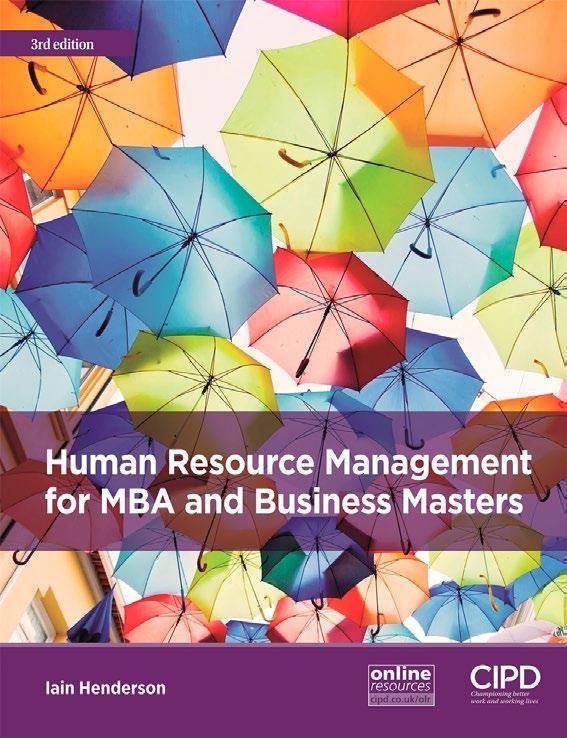
Iain Henderson is a senior teaching fellow at Edinburgh Business School, Heriot-Watt University, UK.
Edition: 3
Date: 01/28/2017
Price: $64.99
Paperback: 9781843984429
Ebook: 9781843984597
Pages: 224
Format (mm): 246x190
Band: Textbook
Subject: Introduction to HRM
1 Human Resource Management
2 Employee Resourcing
3 Learning and Development
4 Employee Relations
5 Human Resource Management and the Design of Work
6 Managing Performance
7 Managing Rewards
8 The Global Context of HRMInternational and Comparative HRM
9 Contemporary Issues and Future Trends
• Includes reflective practice activities to encourage students to think critically about the content and self-test their learning progress
• Aligns fully with the new CIPD Advanced Level 7 qualification and is written by one of the experts involved in its development
• Puts human resource management (HRM) in a business context and includes case studies and practical examples to help prepare students for a professional HR role

• New to this edition: Brand new chapter on organisation design and development including coverage of workplace culture, job design and change management as well as additional coverage of analytics, diversity and inclusion
• Online resources: lecture slides for each chapter and a lecturer's guide
Edition: 7
Date: 11/28/2020
Price: $64.95
Paperback: 9781789664867
Ebook: 9781789664874
Pages: 568
Format (mm): 245x190
Band: Textbook
Subject: Introduction to HRM
1 HRM, strategy and the global context
1 HRM, strategy, and diversity and inclusion
2 Forces shaping HRM at work
3 HRM, alignment and integration
4 International and comparative HRM
2 Responsibilities for delivering HRM
5 The changing roles of HR professionals 155
6 Line managers, leadership and HRM
3 HRM practices and processes
7 Resourcing and talent management 225
8 Performance management and development
9 Learning and knowledge development
10 Managing employment relations
11 Employee participation, engagement and voice
12 Reward management
4 HRM and performance from a business perspective
13 HRM and performance
14 Research skills and project management
• Helps students understand, analyse and critically evaluate key issues including the managerial and business environment, how HR strategies are shaped, globalization and demographic, social and technological trends
• New to this edition: enhanced emphasis on the impact of the external environment on the HR profession, a discussion of the impact of technology and social media, increased coverage of ethics and CSR and links to the HR Profession Map
• Online resources: instructor’s manual, lecture slides, annotated web links and answers to/guidance for the chapter activities for lecturers
HR functions within both internal and external contexts. The understanding of both contexts is crucial for comprehending how and why they drive HR strategies and practices in organizations, as well as the rules and structures within which they work. Built around five major themes which impact upon the HR function, and mapping to the CIPD Level 7 Advanced module of the same name, Human Resource Management in Context enables students to understand the complex and changing organizational context in which HR operates today by providing a comprehensive breakdown of the concepts, theories and issues from globalization and government policy to demographic, social and technological trends.
This fully updated 4th edition of Human Resource Management in Context includes a range of pedagogical features, balancing theory with practical analysis to form an engaging insight into the strategic side of HR. It includes enhanced emphasis on the impact of the external environment on the HR profession, a discussion of the impact of technology and social media, increased coverage of ethics and CSR and links to the HR Profession Map. Online supporting resources for lecturers include an instructor's manual, lecture slides, annotated web links and guidance for the chapter activities.

David Farnham, Chartered Fellow of the CIPD, is an emeritus professor at the University of Portsmouth and visiting professor at the University of Greenwich, UK. He has been a visiting professor at the University of East London, a visiting senior research fellow at the University of South Wales and a visiting senior research fellow at the Catholic University Leuven. He is Chief Examiner for the CIPD and a member of the advisory board of the Personnel Policies Study Group of the European Group of Public Administration, Brussels.
Edition: 4
Date: 02/28/2015
Price: $69.99
Paperback: 9781843983583
Ebook: 9781843984023
Pages: 488
Format (mm): 245x190
Band: Textbook
Subject: Introduction to HRM
1 Introducing Human Resource Management, Organisation and Management
1 Human Resource Management and its External Contexts
2 Contemporary Organisations and their Internal Contexts
3 The Managerial and Business Contexts of Organisations
2 Strategy Formulation and Implementation
4 Developing Corporate Strategies
5 Developing Human Resource Strategies
3 The External Contexts of Human Resource Management
6 Markets and the Competitive Context
7 Globalisation and International Factors
8 Demographic and Social Trends
9 The Technological Context
10 Government Policy and Legal Regulation
• Is the essential text for all postgraduate and undergraduate students studying the broader business context within which HR operates
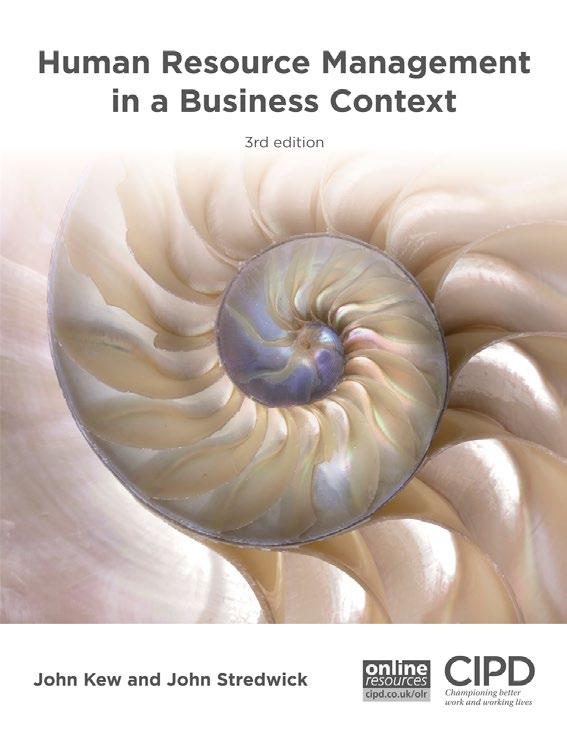
• New to this edition: updated to include an even broader range of global case studies with extended coverage from China and India and updates to policies and legislation
• Online resources: additional case studies and activities, lecturer's guides, PowerPoint slides and annotated web links
Highly accessible and student-friendly, Human Resource Management in a Business Context is the core text for the CIPD Level 7 Advanced module, Human Resource Management in Context, and is also essential reading for other undergraduate and postgraduate HR and business degrees. In clear and easy to navigate chapters, which consider government policy, regulation, the world economy and demographic and social trends, this book provides the firm theoretical background that you can apply in practice.
Human Resource Management in a Business Context is packed with international case studies, examples and activities that will actively engage you with the different areas of knowledge and allow you to work through the material step-by-step. This edition is fully updated to include an even broader range of global case studies with extended coverage from China and India and updates to policies and legislation. The online resources available have also been expanded on, and now provide additional case studies and activities, alongside lecturer's guides, PowerPoint slides and annotated web links.
John Kew is an educational consultant and has written flexible learning material for the CIPD's Professional Development Scheme.
John Stredwick is Senior Lecturer at University of Bedfordshire and a well renowned author. He is Visiting Professor at Webster University (US) based in Regents Park.
Edition: 3
Date: 06/28/2016
Price: $69.99
Paperback: 9781843984047
Ebook: 9781843984511
Pages: 608
Format (mm): 245x189
Band: Textbook
Subject: Introduction to HRM
1 Human Resource Management in Context
2 The Managerial Context of Human Resources
3 The Competitive Environment
4 Government Policy
5 Regulation
6 The World Economy
7 Demographic and Social Trends
8 Technology
9 Ethics, Social Responsibility and Sustainability
10 Strategic Management
11 HR Delivery, Strategy and Performance
• Maps to the CIPD Level 5 Associate Diploma in People Management
• Covers the employment relationship, resourcing and workforce planning, employee engagement and reward and discusses organisational design and development and how to improve organisational performance
• Includes pedagogical features such as learning outcomes, reflective activities, case studies and further reading to help students track their progress, reinforce their learning and see how the theory applies in practice
• New to this edition: Brand new chapters on people management in an international context, wellbeing at work and equity, diversity and inclusion
• Online resources: Powerpoint slides, a lecturer guide and annotated web links
Human Resource Management: People and Organisations provides thorough coverage of key HR topics and their context to enable students to excel in their academic studies and begin a successful career as a people professional.
Now fully updated for a third edition, Human Resource Management: People and Organisations covers everything from essential UK employment law and managing the employment relationship through to resourcing and workforce planning, employee engagement and reward management. There is also expert discussion on organisation design and development as well as advice on how to improve organisational performance. This edition now includes brand new chapters on people management in an international context, wellbeing at work and equity, diversity and inclusion

This book is fully supported by a range of pedagogical features including learning outcomes to summarise the content that will be covered in each chapter and track progress, reflective activities to consolidate learning and further reading suggestions to aid wider engagement with areas of particular interest. Case studies throughout also help students understand how the theory applies in practice It is ideal reading for anyone studying the CIPD Associate Diploma in People Management as well as those in the early stages of their career in HR.. Online resources include PowerPoint slides, a lecturer guide and annotated web links.
Stephen Taylor, Chartered CCIPD, is a Senior Lecturer in Human Resource Management at the University of Exeter Business School, UK and also a Chief Examiner for the CIPD. Based in Devon, UK, he previously taught at Manchester Business School and Manchester Metropolitan University Business School and has worked in a variety of management roles in the hotel industry and in the NHS.
Professor Carol Woodhams is Professor of Human Resource Management and Head of the Department of People and Organisations at the University of Surrey, UK. She has held various positions within the CIPD including National Examiner for Designing and Delivering Training and Editor of the flexible learning materials at Intermediate and Advanced levels and is based in Surrey, UK. She was named by HR Magazine as the most influential HR thinker in 2023.
Edition: 3
Date: 09/28/2022
Price: $56.24
Paperback: 9781398606937
Ebook: 9781398606944
Pages: 296
Format (mm): 246x190
Band: Textbook
Subject: Introduction to HRM
1 Managing the employment relationship
2 Talent management and workforce planning
3 Reward management
4 Employment law
5 Human resource development
6 Improving organisational performance
7 People management in an international context
8 Equality, diversity and inclusion
9 Wellbeing at work
10 Glossary
• Maps to the CIPD Level 5 Associate Diploma in People Management
• Covers the study of HRM, the people management contribution, the business environment and the structure and strategy of the HR function
• Provides guidance on the professional behaviours of a people professional and explains how to manage HR data and information and use it to make evidencebased decisions
• New to this edition: A brand new chapter on shaping people practice to benefit your organisation.
• Online resources: Powerpoint slides, Lecturer manual and annotated web links
Studying Human Resource Management is an ideal textbook for anyone studying the CIPD Associate Diploma in People Management.
Fully updated throughout, this book provides thorough coverage of the study of HRM including the people management contribution and business environment as well as discussing the strategy and structure of the HR function. Written by experts in the field with both academic and practitioner experience, Studying Human Resource Management includes invaluable discussion on professional behaviours for people professionals and guidance on how to manage HR data and information and most importantly, how to use it to make evidence-based decisions. There is also now a brand new chapter on shaping people practice to benefit your organisation.
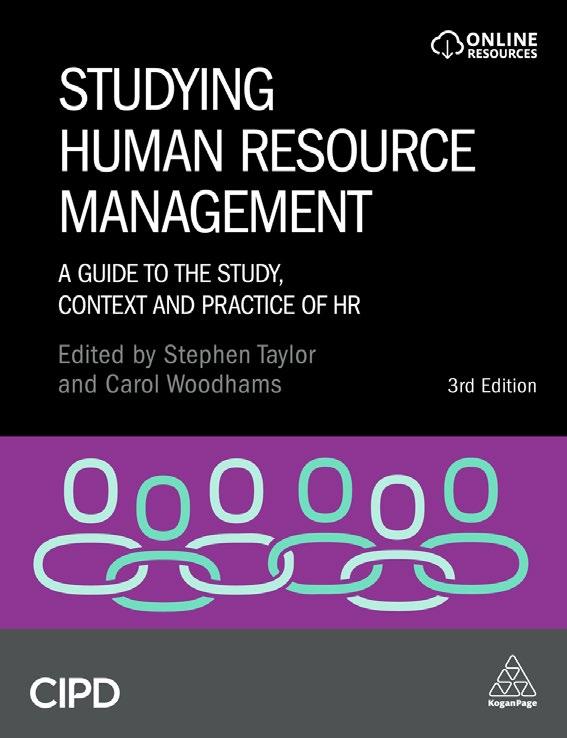
Each chapter includes key learning outcomes to summarise the content that will be covered and to help students track their progress, reflective activities to consolidate learning and further reading suggestions to support wider engagement with areas of particular interest. This book also includes case studies to help students understand how the theory applies in practice. Online resources include slides, a lecturer guide and annotated web links.
Stephen Taylor, Chartered CCIPD, is a Senior Lecturer in Human Resource Management at the University of Exeter Business School, UK and also a Chief Examiner for the CIPD. Based in Devon, UK, he previously taught at Manchester Business School and Manchester Metropolitan University Business School and has worked in a variety of management roles in the hotel industry and in the NHS.
Professor Carol Woodhams is Professor of Human Resource Management and Head of Department of People and Organisations at the University of Surrey, UK. She has held various positions within the CIPD including National Examiner for Designing and Delivering Training and Editor of the flexible learning materials at Intermediate and Advanced levels and is based in Surrey, UK. She was named by HR Magazine as the most influential HR thinker in 2023.
Edition: 3
Date: 09/28/2022
Price: $56.24
Paperback: 9781398606890
Ebook: 9781398606906
Pages: 256
Format (mm): 245x188
Band: Textbook
Subject: Introduction to HRM
1 The people management contribution
2 The people management business environment
3 Strategy and structure
4 Contemporary people management issues
5 Shaping people practice to benefit your organisation
6 Research and evidence-based practice in HRM
7 The behaviour of the people professional
8 Glossary
9 Appendices
• Written to support the new CIPD Level 3 Foundation qualification by the team who developed the syllabus
• Provides guidance on workforce analytics to enable students to use data and evidence to make informed business decisions and add organizational value
• Outlines the core behaviours and skills for people professionals including, developing professional courage, working ethically and managing change

• Online resources: Lecturer manual, Powerpoint slides and student multiple choice questions
• Includes key definition boxes, exercises, case studies and further reading to ensure a clear understanding of both the theory and practice, broad engagement with the subject and critical thinking skills
Edition: 1
Date: 09/28/2021
Price: $62.95
Paperback: 9781398602427
Ebook: 9781398602434
Pages: 256
Format (mm): 245x190
Band: Textbook
Subject: Introduction to HRM
Introduction
1 Business, culture and change
2 Evidence-based practice and analytics
3 Core behaviours for people professionals
4 The employee lifecycle and recruitment process
5 Selection and appointment
6 The employment relationship
7 Performance management
8 Reward and reward systems
9 Supporting others to develop skills and knowledge
• Provides a thorough grounding in all the core areas of HR including recruitment and selection, performance management, reward management and L&D
• Includes a dedicated chapter on personal effectiveness to provide students with the skills they need to progress in a career in HR such as influence, resilience, empathy and handling difficult conversations
• Covers wider business topics including change management, organisational context and communication technology to ensure that students have a broad understanding of the business environment
• Includes reflective practice activities to encourage students to think critically about the content and self-test their learning progress as well as explore further boxes to help students read more widely and explore the content more deeply.
• New to this edition: Fully aligned to the new CIPD Level 3 qualification including additional information on job design, people analytics and employee mental health
• Online resources: instructor's manual, lecture slides and annotated web links
Human Resource Practice is a practical and accessible guide for students and anyone looking to gain a thorough understanding of HR and is the definitive text for the CIPD's Level 3 Foundation Certificate in HR Practice.
This book covers all the core areas of HR including recruitment and selection, performance management, reward and learning and development (L&D). It also provides students with the broader coverage of the business environment that they need to succeed including topics such as change management, organisational context and the legal background to employment.
This fully updated 8th edition of Human Resource Practice now includes new coverage of the changing nature and demographic of the workforce, the continuing impact of technology and new developments that may be used. There is also coverage of the importance of data and people analytics to HR as well as an enhanced final chapter which includes additional material on working in a team, influencing skills and the importance of empathy, resilience and emotional intelligence. Reflective activities, case studies and explore further boxes throughout encourage students to think critically about the content and understand how it applies in practice in the workplace. Online resources include an instructor's manual, lecture slides and annotated web links.

Fiona Whiting is a freelance HR and organisational development consultant with over 20 years' experience as an HR practitioner. She has held a number of executive board-level positions and has worked predominantly with the NHS, local authorities and academic institutions as well as in a variety of private sector organisations. Fiona Whiting is also the co-founder and director of The People Effect List.
Edition: 8
Date: 10/28/2020
Price: $62.95
Paperback: 9781789665765
Ebook: 9781789665789
Pages: 416
Format (mm): 247x190
Band: Textbook
Subject: Introduction to HRM
1 Introduction and overview
2 The organisational context
3 The legal background to employment
4 Job analysis and design
5 Recruitment and selection
6 Performance management
7 Reward
8 Employee relations
9 Learning and development
10 Information and communication technology in HR
11 Change in organisations
12 Personal effectiveness
• Provides a comprehensive overview using straightforward language and key concept definitions to introduce those without industry experience to all the key aspects of HR and the role of the HR practitioner
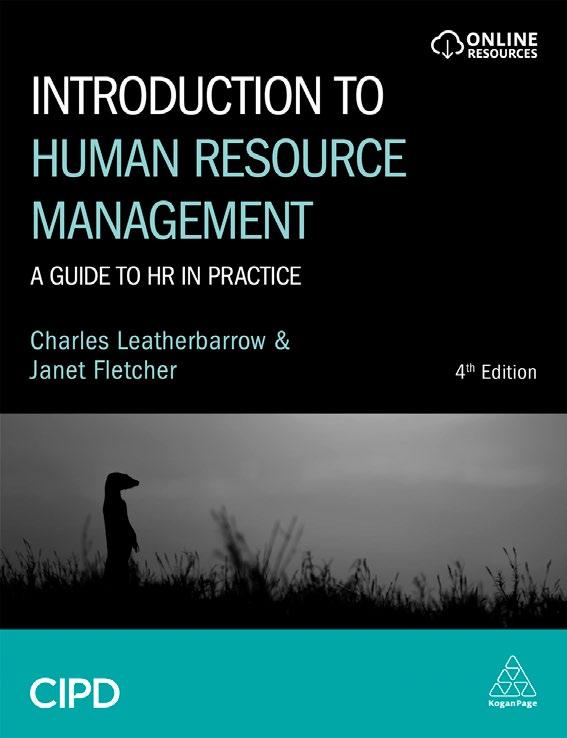
• Goes beyond theory and encourages further thinking and reflective learning using 'pause for thought' boxes, activities, review questions, practical examples and wider reading to consolidate students' learning and show how to apply this in the workplace
• Includes case studies from a range of organizations such as PwC, Rolls-Royce, Deliveroo and the BBC, as well as small and medium enterprises to show how HRM is applied in different organizations and international contexts
• New to this edition: international case studies, updates to legislation, coverage of zero-hours contracts, the gig economy, the continued rise of social media in recruitment and additional information on apprenticeships such as the UK apprenticeship levy
• Online resources: instructor's manual, lecture slides, additional case studies and reflective questions for student self-study
Edition: 4
Date: 10/28/2018
Price: $69.99
Paperback: 9780749483685
Ebook: 9780749483692
Pages: 568
Format (mm): 240x173
Band: Textbook
Subject: Introduction to HRM
1 Organisations
2
3 Human Resource Management (HRM)
4 The role of the HR practitioner
5 Human resource planning
6 Recruitment
7 Selection
8
9
10
11
12
13
14
15
16
17
18
19
• Explains how to decide on a hypothesis, gather and analyse qualitative and quantitative data and produce a write up with impact
• New to this edition: Discussion of how to collect and analyse secondary data as well as coverage of how ethics and sustainability apply to research methods
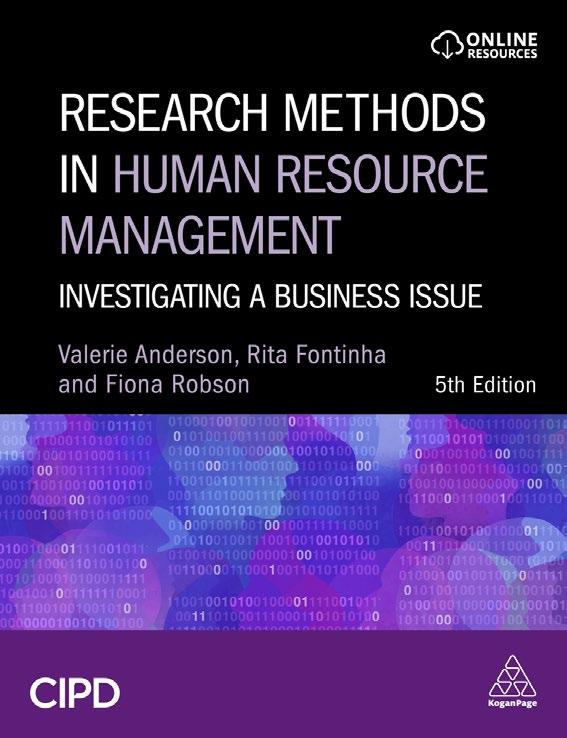
• Includes best practice sample literature reviews and write ups, review and reflect boxes, case illustrations and activities to help consolidate student learning
• Online resources: Instructor manual, PowerPoint slides and annotated weblinks
• Packed with international examples to give students a global perspective of research methods as well as guidance on collecting data across geographies
Fully updated throughout, this fifth edition is essential reading for master's-level CIPD and non-CIPD students alike.
Balancing theoretical frameworks and practical guidance, Research Methods in Human Resource Management explains everything from the first stages of a HR research project from defining a hypothesis and planning the research process through to reviewing literature and documents, collecting and analysing both qualitative and quantitative data. There is also guidance on how to write up the research project with best practice sample literature reviews and write-ups included.
Fully updated throughout, this edition now includes expert discussion of how secondary data can be used in a research project as well as new material on data collection in a hybrid world, ethics and sustainability. International examples and discussion of collecting data from different geographies. Mapped to the CIPD Advanced module, Business Research in People Practice, this is an invaluable textbook for all postgraduate HR students needing to complete a dissertation or research project. 'Review and Reflect' sections at the end of each chapter, case illustrations and activities help to consolidate learning. Online resources include an Instructor's manual, PowerPoint slides and annotated weblinks.
Valerie Anderson, Chartered MCIPD, is Reader in HRD at University of Portsmouth with extensive HRM and HRD management and consultancy experience.
Rita Fontinha is a Lecturer of International Business and Strategy specializing in Strategic and International HRM at Henley Business School.
Fiona Robson, Academic FCIPD is Head of Discipline for Business Management and Joint Programmes at AFG College in partnership with the University of Aberdeen. She is based in Doha, Qatar.
Edition: 5
Date: 01/28/2024
Price: $59.99
Paperback: 9781398610163
Ebook: 9781398611092
Pages: 504
Format (mm): 246x189
Band: Textbook
Subject: Human Resource Management
1 Investigating and researching HR issues
2 First stages towards an HR project
3 Finding and reviewing HR literature and information sources
4 Ethics, professionalism, standards and HR research
5 Planning the research process
6 Finding and using documents and organisational evidence
7 Collecting and recording qualitative data
8 Analysing qualitative data
9 Collecting and recording quantitative data
10 Analysing quantitative data
11 Writing up your project and making recommendations
12 Making an impact – the relationship between research and practice

• Provides practical guidance directly from those who created the Human Capital Management Standards
• Shows how the Human Capital Management standards can be applied to organizations of any size
• Guides organizations through the full standards accreditation process which is essential for winning government contracts
• Includes a foreword written by Dr Scott Steedman, VP (Policy) ISO and Director of Standards, BSI
Human Capital Management Standards is a comprehensive guide to the BSI and ISO frameworks for people management. Providing internationally agreed definitions and best practice guidance, it offers a foundation for sustainable people management and development practices in organizations. Covering everything from organizational governance, workforce planning, diversity and inclusion to learning and development, this book explores the key areas of people management throughout the employment life cycle, from initial hire to the time people move on from the organization. There is also coverage of additional business standards such as those related to occupational health and safety as well as the implications of implementing standards in a globalized and interconnected organizational context.
Human Capital Management Standards will allow people professionals and managers in organizations of all sizes and types to develop and implement effective people policies and processes based on robust research to create a supportive organizational environment for a more productive workforce. This book also includes essential coverage of the standards assessment process and tips and advice on how to achieve successful accreditation. With case studies from organizations that have made HR interventions based on these standards and a glossary to explain the language of standards, this is an indispensable guide for HR professionals, managers and standards specialists in all organizations.
Dr Wilson Wong is Head of Insight and Futures at the Chartered Institute for Personnel and Development (CIPD) and Chair of the Human Capital Standards Committee at the British Standards Institution (BSI). Prior to this, he worked in technology policy and financial/investment research.
Dr Valerie Anderson is Reader in Human Resource Development at the University of Portsmouth. She has gained extensive HRM and HRD management experience in a range of different public and private sector organizations.
Heather Bond is Standards Adviser at CIPD. Her professional expertise in people management and standards have been integral to the development of many standards in this book. Prior to this, she was responsible for CIPD qualifications development and regulatory compliance.
Edition: 1
Date: 09/28/2019
Price: $59.99
Paperback: 9780749484347
Ebook: 9780749484354
Pages: 344
Format (mm): 234x158
Band: Professional
Subject: Human Resource Management
1 Governance, human capital and culturethe role of standards and standardization [Edward Houghton]
2 It’s all a matter of standards [Heather Bond]
3 Workforce planning [Julie Sloan]
4 Recruitment [Sandy J Miles]
5 Learning and development [Valerie Anderson and Alaa Garad]
6 Diversity and inclusion [Anne McBride and Helge Hoel]
7 Occupational health and safety management [Martin Cottam]
8 Moving on from the organization [Valerie Anderson]
9 Cross-national, cross-sectoral and crossfunctional issues [Alaa Garad]
10 Assessment and accreditation [Angela Mulvie]
11 The future of standards affecting human capital management and development [Wilson Wong]
• Provides coverage of all the latest developments impacting work and employment including flexibility, sustainability, agility and ethics
• Includes reflective practice activities to encourage students to think critically about the content and explore further boxes to help students read more widely and explore the content more deeply
• Covers both the theory and practice of the topic so that students can hit the ground running in their future careers in the HR industry
• Online resources: Lecturer slides, for each chapter
Work and Employment in a Changing Business Environment is the definitive textbook for the new CIPD Advanced Level 7 module. It provides students with an understanding of the major contemporary trends in the HR business environment and discussion of significant areas of HR and Learning and Development (L&D) activity that derive from or are given additional prominence as a result of environmental developments.
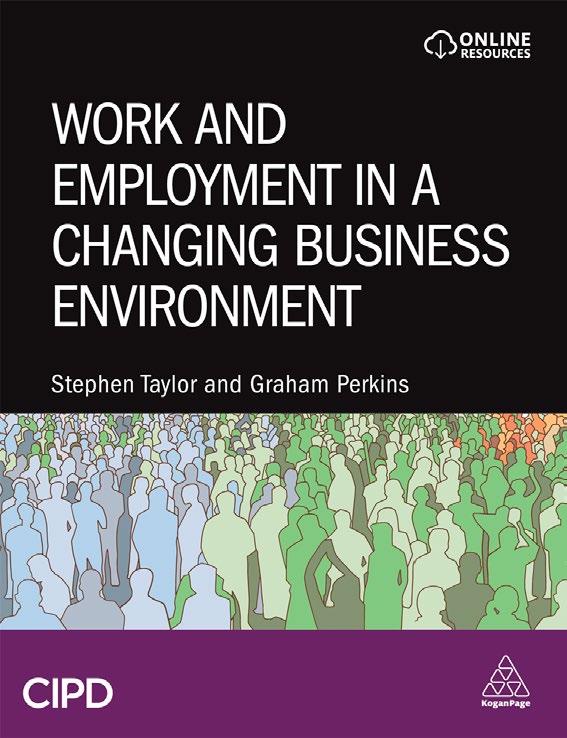
It provides students with an understanding of ways in which major, long-term environmental developments affect employment, work and people management in organizations as well as a thorough grounding in current and short-term developments in the people management environment. These areas include globalisation, technology, the economy, labour markets, society, politics, public policy and employment regulation. This book also includes expert coverage of how change, innovation and creativity can promote improvements in organisational productivity.
Most importantly, this brand new textbook covers the key elements that students on HR masters courses will need in their future careers including flexibility, agility and resilience. productivity, ethics and values, sustainability, equality, diversity and inclusion, wellbeing and working internationally. Case studies and examples demonstrate how the theory applies in practice and pause and review boxes will help students think critically about the content. Work and Employment in a Changing Business Environment is ideal reading for all postgraduate students on both CIPD and non-CIPD accredited courses. Online supporting resources include powerpoint slides for every chapter.
Stephen Taylor, Chartered CCIPD, is a Senior Lecturer in Human Resource Management at the University of Exeter Business School and a Chief Examiner for the CIPD. Before his academic career he worked in a variety of management roles in the hotel industry and in the NHS.
Graham Perkins is Senior Lecturer in Human Resource Management at University of Exeter Business School. Prior to a career in academia, he held a number of HR and Learning and Development roles in both public and private sector firms.
Edition: 1
Date: 06/28/2021
Price: $59.95
Paperback: 9781398600201
Ebook: 9781398600218
Pages: 416
Format (mm): 246x189
Band: Textbook
Subject: Business Environment
2
17
18
19
• Explores how to close the skills gap, boost productivity, improve employee wellbeing and both build and engage a diverse workforce
• Includes advice on how to design organizations, work and job roles for individual and business success
• Explains how to adopt an evidence-based approach to work instead of following intangible, unproven ideas about best practice
• Provides guidance on how organizations can become responsible businesses with a focus on trust, transparency and 'good work'
• Written by the Chief Executive of the Chartered Institute of Personnel and Development (CIPD) and includes case studies from global public and private sector organisations
Work has changed forever. How can HR and leaders adapt? How can they deal with the wellbeing and productivity crisis, address the skills gap and build better organizations? This book has the answer.
Written by a leading voice in the people profession, The New World of Work takes an evidence-based approach to provide practical advice on how the business and employees can succeed. It covers how to combat stalling productivity, poor wellbeing and the increase in mental health issues in the workplace as well as the need for agile learning, ways to close the skills gap and a refreshingly realistic look at the impact of technology. There is also essential discussion of job design, flexible working, diversity and inclusion (D&I) and how to engage both an ageing workforce and new Gen Z recruits. This book also includes guidance on how to build a business which is responsible, trustworthy and transparent, is based on the principles of 'good work' and is one that employees are proud to work for.
With global examples and case studies from private and public sector organizations, The New World of Work is the book that HR and business professionals need to seize the opportunity and allow both the business and its people to succeed.
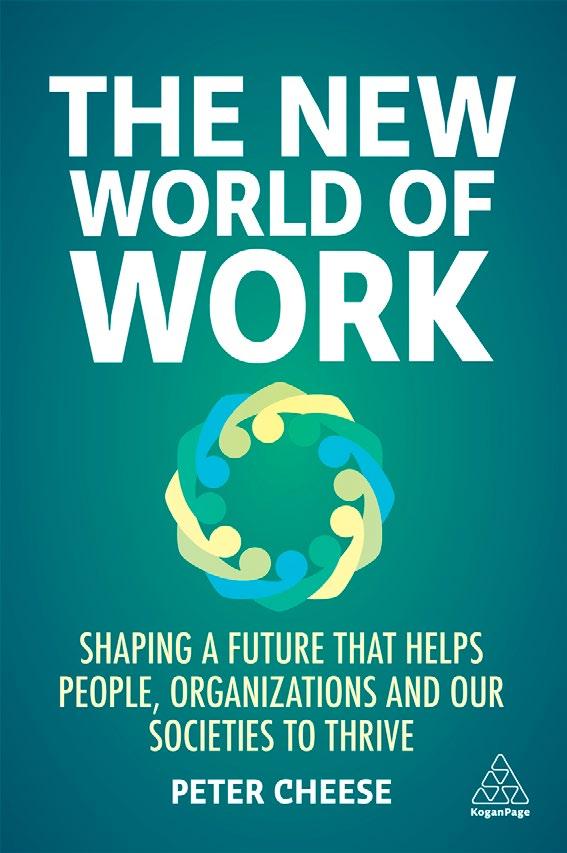
Peter Cheese is Chief Executive of the Chartered Institute of Personnel and Development (CIPD), the professional body for HR and people development. He is also Chair of the What Works Centre for Wellbeing. Based in London, UK, he writes and speaks widely on the themes of the future of work, and engages with politicians, policy makers, academics, business leaders and leaders in the people profession. Prior to the CIPD, he was Chair of the Institute of Leadership and Management after a long career at Accenture where he led the global consulting practice in people and organisation.
Edition: 1
Date: 06/28/2021
Price: $25.99
Paperback: 9781398602090
Ebook: 9781398602106
Pages: 400
Format (mm): 233x157
Band: Professional
Subject: Business Environment
1 A new era of work
2 Economics and the economy
3 Globalization and geopolitics
4 Social and demographic change
5 Technology: Automation, AI and beyond
6 Education and learning
7 Focusing on the right things
8 Building responsible business
9 Leadership for the future
10 People strategy at the heart of business strategy
11 Good work as a goal
12 The agile learning organization
13 Wellbeing as an outcome
14 #WTF - What’s the future?
• Offers a detailed and accessible guide to understanding and working with people analytics and advanced statistical techniques
• Contains numerous worked examples of analyses of various forms of HR data - such as employee engagement, performance and turnover - which are supported by R programming screenshots and online datasets
• New to this edition: new content on data ethics and integrity; diversity and inclusion (D&I) and chapter on predicting attrition with machine learning
• Online resources: Excel data sets and R syntax with worked case study examples
This is the essential guide for HR practitioners who want to gain the statistical and analytical knowledge to fully harness the potential of HR metrics and organizational people-related data.
The ability to use and analyse data has become an invaluable skill for HR professionals to not only identify trends and patterns, but also make well-informed business decisions. The third edition of Predictive HR Analytics provides a clear, accessible framework for understanding people data, working with people analytics and advanced statistical techniques.

Readers will be taken step-by-step through worked examples, showing them how to carry out analyses and interpret HR data in areas such as employee engagement, performance and turnover. Learn how to make effective business decision with this updated edition that includes the latest materials on predicting attrition with machine learning, biased algorithms and data protection, supported by online resources consisting of R and Excel data sets.
Martin R Edwards is an Associate Professor in Management at UQ Business School, University Queensland, Australia.
Kirsten Edwards is HR Lead for Advanced Analytics and Data Science at Rio Tinto and has over 20 years' broad international experience in analytics, HR and management consulting, based in Queensland, Australia.
Daisung Jang has over 10 years' experience of data analysis and is an expert on R. He is a lecturer in UQ Business School, University of Queensland, Australia.
Edition: 3
Date: 05/28/2024
Price: $47.99
Paperback: 9781398615656
Pages: 536
Format (mm): 240x170
Band: Professional/ Academic
Subject: HR Analytics
1 Understanding HR analytics
2 HR information systems and data
3 Analysis strategies
4 Case study 1 – Diversity analytics
5 Case study 2 – Employee attitude surveys – engagement and workforce perceptions
6 Case study 3 – Predicting employee turnover
7 Case study 4 – Predicting employee performance
8 Case study 5 – Recruitment and selection analytics
9 Case study 6 – Monitoring the impact of interventions
10 Business applications – Scenario modelling and business cases
11 More advanced HR analytic techniques
12 Reflection on HR analytics – Usage, ethics and limitations
13 Appendix
• Shows how to take a data-driven approach to recruitment, engagement, safety, wellbeing, training and performance management
• Helps HR professionals analyse the vast amount of company data to gain tangible organizational insights and drive performance
• Includes guidance on how to ensure data collection is transparent and that employees understand what information is being collected and why
• New to this edition: chapters on intelligent HR strategy, how to use data to enhance organizational culture; how data and AI can play a role in onboarding; the changing role of employee training through AI and personalization of education content
How can HR professionals utilize and leverage their organization's data effectively, with the use of AI, for more talent attraction, better employee engagement and higher talent retention to ultimately drive performance?
AI is now an integral part of being data-driven. With this updated edition of Data-Driven HR, practitioners can unlock business potential and success through data and analytics. Covering topics such as recruitment, employee engagement, performance management, wellbeing and training, HR practitioners can benefit from knowing how to really be datadriven through the use of data and AI.

HR teams will learn how to identify business goals, scrutinize useful sources of data and gain rich and diverse insights from their vast amounts of data. This book brings guidance on how to manage challenges that come with data and AI, as well as how to responsibly and transparently use data to improve decision making. It also includes predictive analytics and how to place warning systems into databases for any potential workforce issues. Packed with practical advice, key takeaways and real-life examples, this is essential reading for all HR professionals looking to make a measurable difference in their organizations.
Bernard Marr is one of the leading voices in Technology and Innovation. A futurist and strategic performance consultant, he has advised many of the world's best-known organizations on their business and data strategies. A frequent keynote speaker, he also writes on the topic of data and analytics for various publications including Forbes and the Huffington Post. Bernard Marr is also the author of Data Strategy (2021) and The Intelligence Revolution (2020) published by Kogan Page.
Edition: 2
Date: 01/28/2024
Price: $39.99
Paperback: 9781398614567
Ebook: 9781398614574
Pages: 304
Format (mm): 234x156
Band: Professional
Subject: HR Analytics
Preface
1 Data, Analytics and AI in HR
1 How data and AI are transforming HR
2 How data and AI have come to revolutionise HR
3 The Data, Analytics and AI tools available to HR
2 Data-Driven and AI-enabled HR in Practice
4 Better HR insights and decision-making
5 Recruitment and candidate selection
6 Employee Onboarding
7 Performance Monitoring and Management
8 Employee Training and Development
9 Performance monitoring and management
10 Identify the use cases
11 Building skills and aligning culture
3 Making data-driven and AI enabled HR happen
12 Identifying the use cases for your organization
13 The future of HR
• Enables HR practitioners with little or no experience of analytics to feel confident in their ability to find and handle workforce data and use it to make better business decisions
• Demonstrates how to make an impact by building people analytics into business processes and embedding data-driven mindsets throughout the organization
• Includes case studies from AstraZeneca, Brompton Bikes, Swarovski, NHS and Experian
• New to this edition: coverage of using data insights to respond to external disruption such as COVID-19; developing a people analytics journey; how to recruit people analytics specialists and embed new datadriven operating models within HR; new and updated case studies on topics such as structuring dashboards to drive insights and developing a culture of analytics
How can HR practitioners with little or no experience of analytics feel confident in their ability to find, analyse and use workforce data to make better business decisions? This book has the answers.
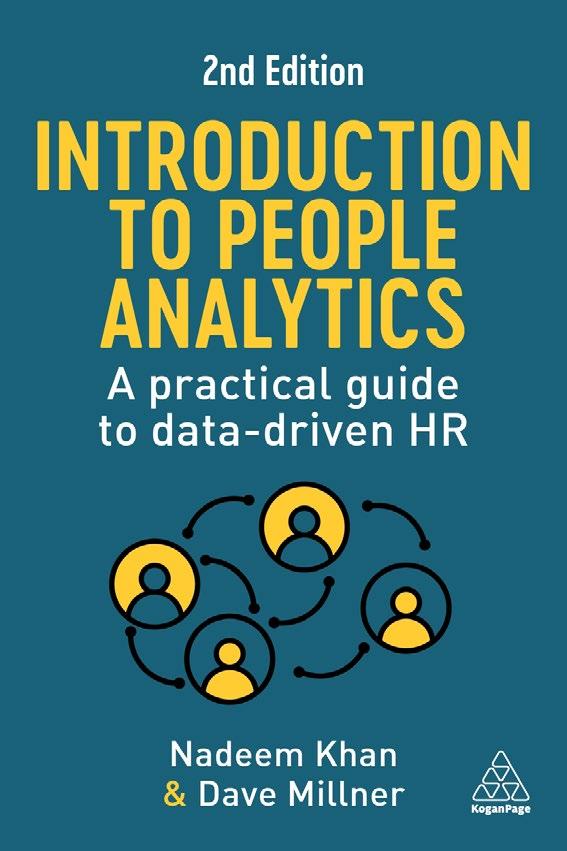
An understanding of people analytics is a crucial skill for all HR professionals. This new edition provides expert guidance on the key aspects of analytics, enabling all HR professionals to feel confident in their ability to handle employee and organizational data. It features new material on applying data to respond to external disruption such as COVID-19 as well as how to develop a people analytics journey. There is also advice on recruiting people analytics specialists and embedding new data-driven operating models within HR.
This book is essential reading for all HR professionals to develop understanding of how and where HR analytics can make a tangible difference to organizations. With updated case studies and thought leadership examples from companies including NHS, AstraZeneca and Swarovski, this book demonstrates how people analytics can be leveraged to improve culture and employee engagement, increase performance and reduce costs.
Nadeem Khan is a futurist, speaker and consultant. Based in Lancaster, UK, he is Head of Strategy & Growth at Zosh Occupational Health Ltd (ZOHL) and the Managing Director of Optimizhr Ltd.
Dave Millner has 30 years of consulting experience working with global organizations to offer a range of organizational development solutions underpinned by people analytics, based in St. Albans, UK. In 2021 he was named as one of the Most Influential HR Thinkers by HR Magazine
Edition: 2
Date: 07/28/2023
Price: $37.99
Paperback: 9781398610040
Ebook: 9781398610057
Pages: 400
Format (mm): 22x170
Band: Professional
Subject: HR Analytics
Introducing the framework
1 Context for change
1 Redefining HR: The context for change
2 The age of data and people analytics
2 Making the shift to a data-based approach
3 The commercial HR mindset
4 Developing new ways of working
5 Working with data
3 People analytics delivering value
6 A people analytics framework: Laying the foundations through metrics, reporting and core analytical activity
7 A people analytics framework: Identifying business insights from analytics
8 Delivering people analytics projects
4 Looking to the future
9 How to be more data-driven and people analytics-focused
10 The road ahead: Turning intent into tomorrow’s people function through people analytics
• Shows how to use insights from data to improve business decision making and prove the ROI of people analytics
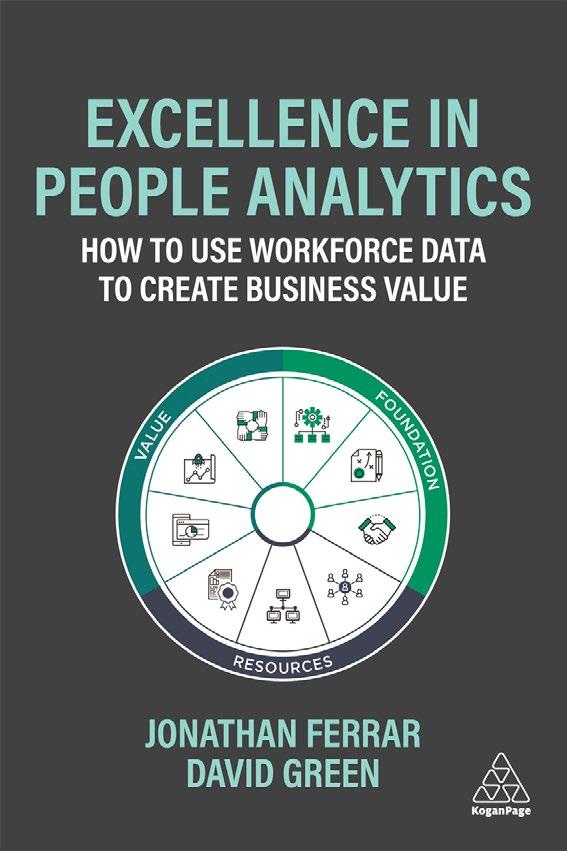
• Provides advice on how to formulate smart business questions and use people data to answer them
• Explains how to implement processes and establish robust infrastructure for ethical data collection
• Includes case studies from global organizations who are leveraging the value of people analytics including IMicrosoft, HSBC, Syngenta, Capital One, Novartis, Bosch, Uber, Santander Brasil and American Eagle
Effectively and ethically leveraging people data to deliver real business value is what sets the best HR leaders and teams apart. Excellence in People Analytics provides business and human resources leaders with everything they need to know about creating value from people analytics.
Written by two leading experts in the field, this practical guide outlines how to create sustainable business value with people analytics and develop a data-driven culture in HR. Most importantly, it allows HR professionals and business executives to translate their data into tangible actions to improve business performance, whilst navigating the rapidly evolving world of work.
Full of practical tools and advice assembled around the Insight222 Nine Dimensions in People Analytics® model, this book demonstrates how to use people data to increase profits, improve staff retention and workplace productivity as well as develop individual employee experience. Featuring case studies from leading companies including Microsoft, HSBC, Syngenta, Capital One, Novartis, Bosch, Uber, Santander Brasil and American Eagle Outfitters®, Excellence in People Analytics is essential reading for all HR professionals needing to unlock the potential in their people data and gain competitive advantage.
Jonathan Ferrar is a globally recognised consultant, speaker and business advisor in HR strategy and analytics. He is chief executive officer of global people analytics firm Insight222, and board advisor to the Chartered Institute of Personnel & Development.
David Green is an influencer, advisor and prolific speaker in the field of people analytics, human resources technology and the future of work. He is managing partner at Insight222 and host of the Digital HR Leaders podcast. In 2023 he was named as one of the Most Influential HR Thinkers by HR Magazine
Edition: 1
Date: 07/28/2021
Price: $39.95
Paperback: 9780749498290
Ebook: 9780749498306
Pages: 384
Format (mm): 232x152
Band: Professional
Subject: HR Analytics
1 The case for people analytics Introduction
The business value of people analytics
2 Nine Dimensions for Excellence in People Analytics
1 Governance
2 Methodology
3 Stakeholder Management
4 Skills
5 Technology
6 Data
7 Workforce Experiences
8 Business Outcomes
9 Culture
3 The next steps for people analytics
10 Transforming people analytics
11 Epilogue - the future of people analytics
12 Concluding remarks
13 Glossary
14 Index
• Supports the core knowledge and behaviour requirements of 'Personal effectiveness, ethics and business acumen' in CIPD Level 7 qualifications
• Provides 'skills in practice' examples to help students without prior business experience to put the skills in context and understand how they apply in the workplace
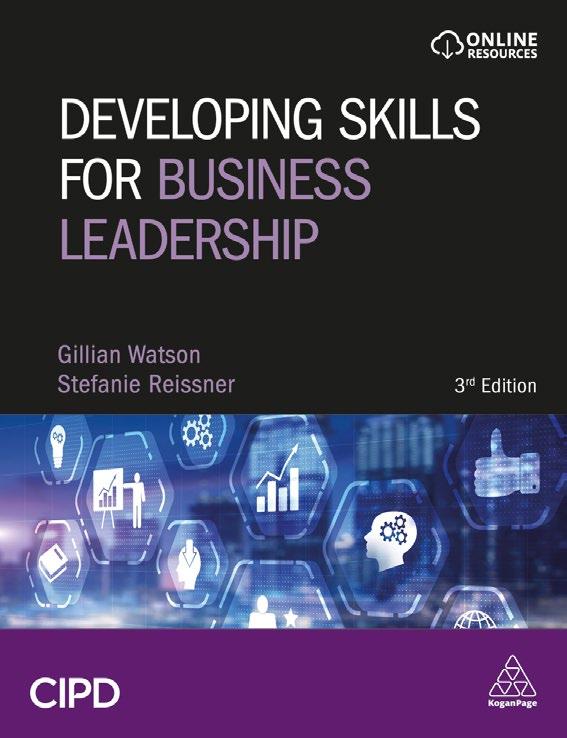
• New to this edition: New content on leading ethically, managing virtually, working inclusively, developing the organisation and managing stress
• Online resources: Lecturer's manual, powerpoint slides, additional case studies, activities and templates
Split into the core areas of managing yourself and others, transferable management skills and postgraduate study skills, this is an ideal textbook for CIPD advanced level students and those on non-CIPD business masters degrees.
Covering the theory and practice of the key topics needed for successful professional development and practice, Developing Skills for Business Leadership includes content on interpersonal and communication skills, managing information and projects in both academic and professional contexts, change management, decision making, managing financial resources and data analysis. This new edition has been fully updated throughout and now includes new material on on building and managing virtual teams, remote and hybrid working arrangements, resolving conflict, organizational learning and development as well as working across diverse cultures and how to foster inclusion. This book provides everything that students will need to manage teams in the workplace, make sound and justifiable business decisions and effectively lead, engage and influence others.
Chapters are supported by 'development zones', examples, case studies and 'pause for thought' boxes to consolidate learning and help students with no prior business experience put the skills into context and see how they apply in the workplace. Online resources include a student guide, PowerPoint slides, lecturer manual, and downloadable templates.
Gillian Watson has worked as university educator and academic leader for three decades. She has co-authored and edited several CIPD textbooks, developed many postgraduatelevel business programmes and has led a variety of academic teams.
Stefanie Reissner is a Professor of Work and Organization Studies at Essex Business School, UK, researching topics such as identity, reflexivity and learning. She is a senior fellow of the Higher Education Academy and an associate academic member of the CIPD.
Edition: 3
Date: 06/28/2023
Price: $59.99
Paperback: 9781398604964
Ebook: 9781398604971
Pages: 488
Format (mm): 246x190
Band: Textbook
Subject: HR Leadership
1 Introduction
2 Managing you
3 You as a professional
4 Working together
5 Working inclusively
6 Leadership
7 Managing information
8 Communication skills
9 Making decisions
10 Resolving conflict
11 Managing change
12 Developing the organisation
13 Managing projects
14 Career management
15 Next steps

• Fully aligns with the Chartered Institute of Personnel and Development (CIPD) 'Leading, Managing and Developing People' and 'Developing Skills for Business Leadership' modules
• Written by the UK's bestselling HRM author, whose books have sold over a million copies and been translated into twenty-one languages
• Online resources: lecture slides, an instructor's manual, a student's manual and a literature review
• Explores the key concepts of leadership, management and people development as it relates to the HR function
To make an effective contribution, HR specialists have to be good at management, leadership and developing both themselves and others. They also need to be aware of the management and business considerations that affect their work. Armstrong's Handbook of Management and Leadership for HR provides guidance on the processes of management and leadership with particular reference to what HR managers and aspiring managers need to know and do to make a difference.
Written by renowned human resources expert and bestselling author Michael Armstrong, Armstrong's Handbook of Management and Leadership for HR covers in one volume the 'Leading, Managing and Developing People' and 'Developing Skills for Business Leadership' Chartered Institute of Personnel and Development (CIPD) modules. It includes numerous practical features such as case studies, practitioner interviews, exercises and clear learning objectives to aid learning. This is the essential book for HR students and professionals looking to broaden their skills and understanding relating to management and leadership. Online supporting resources include lecture slides, an instructor's manual, a student's manual and a literature review.
Michael Armstrong is the UK's bestselling author of Human Resource Management books including Armstrong's Handbook of Human Resource Management Practice and several other titles published by Kogan Page. With over a million copies sold, his books have been translated into twenty-one languages. He is managing partner of E-Reward as well as an independent management consultant. Prior to this he was a chief examiner of the Chartered Institute of Personnel and Development (CIPD) and an HR director of a publishing company.
Edition: 4
Date: 11/28/2016
Price: $64.99
Paperback: 9780749478155
Ebook: 9780749478162
Pages: 472
Format (mm): 235x158
Band: Textbook
Subject: HR Leadership
1 Leading, managing and developing people fundamentals
1 Leadership
2 Management
3 Developing people
2 Human resource management and learning and development
4 The essence of human resource management
5 The practice of HRM
6 The practice of learning and development
7 The contribution of HRM and L&D in different types of organizations
8
• Explores international HRM from crosscultural, comparative and international approaches
• Includes 'theory and practice' boxes, global case studies and examples in every chapter to help students see how the content applies in a business context
• New to this edition: brand new coverage of the gig economy, workplace diversity and the impact of technology on international human resource management
• Online resources: lecture slides and additional case studies
Mapped to the CIPD Level 7 module of the same name, International Human Resource Management is a critical textbook for all HR students. Structured around the three core areas of cross-cultural HRM, comparative HRM and international HRM itself, this book provides students with a thorough grounding in the key approaches to international HRM.

Packed with global examples and case studies to support learning, this book explores all aspects of international human resource management from global talent strategy, recruitment and knowledge management to the difference in reward systems across cultures and managing expatriate assignments making it essential reading for students on both CIPD and non-CIPD accredited courses.
Supported by 'theory and practice' boxes in every chapter and with reflective activities and learning questions throughout, International Human Resource Management ensures that students without real-world business experience fully understand the main concepts and how they apply in the world of work. This edition now includes new coverage of the impact of the gig economy on international HRM, how technology is impacting HRM across countries and new material on workforce diversity. Online resources include lecture slides and additional case studies.
Chris Brewster is a professor of International HRM at Henley Business School. He is based in Kent, UK.
Elizabeth Houldsworth is an associate professor of Leadership, Organisations and Behaviour at Henley Business School. She is based in Oxfordshire, UK.
Paul Sparrow is the Emeritus Professor of International HRM at Lancaster University, Management School. He is based in Manchester, UK.
Guy Vernon is an associate professor of Human Resource Management at Southampton University. He is based in Southampton, UK.
Edition: 5
Date: 02/28/2023
Price: $66.99
Paperback: 9781398603530
Ebook: 9781398603547
Pages: 488
Format (mm): 246x189
Band: Textbook
Subject: International HRM
1 International HRM - an introduction
1 Cross-national human resource management
2 Differing national contexts
3 The impact of national culture
2 Comparative human resource management
4 Employee relations and collective voice
5 Non-standard employment - flexibility, precarity and work–life balance
6 Work organisation – direct communication and autonomy
7 Extrinsic reward
8 Strategic workforce planning, recruitment and selection
9 Performance management
10 Training and development
11 Global HRM departments
3 International human resource management
12 International HRM - theory and practice
13 Managing international mobility
14 International talent management
15 Globalising HRM
• Explores how relevant political and cultural contexts impact on international HRM, employment law and relations
• Covers key topics including core HR functional areas, expatriation and repatriation, equality, diversity and inclusion and analyses contemporary considerations such as CSR and work-life balance
• Draws on the author's industry experience of senior HR roles in several multinational companies with case study examples such as BAE Systems and Changan Ford.
• Supported by features including learning outcomes, key concepts and terminology boxes, activities and further reading recommendations
• Online resources: PowerPoint lecture slides, self-test questions and further resource and video links
Understand how to support the successful running of an international business through HR practices which respond to global and local contexts and reflect a changing broader landscape.
Essentials of International Human Resource Management is a concise and applied textbook which explores HR strategies and approaches for a range of organizations that operate internationally. Key topics covered include core HR functional areas, expatriation and repatriation, managing cultural differences and equality, diversity and inclusion. It also explores how relevant political, socio-economic, technological and cultural contexts impact on international HR, with case study examples such as BAE Systems and Changan Ford.

Focusing on both established and emerging economies, the book examines international employment relations, as well as cutting-edge topics including CSR, emotional and cultural intelligence, work-life balance and the consequences of the Covid-19 pandemic. With in-text features including learning outcomes, key concept boxes and activities as well as online resources consisting of PowerPoint lecture slides, self-test questions and further resource and video links, this is an essential resource for master's level and upper undergraduate students of international HRM.
John Opute is Associate Professor in International HRM at London South Bank University, UK, and Course Director of its International HRM MSc. He has over 20 years industry experience of general and human resources management and has held key HR positions in several multinational companies across the globe.
Edition: 1
Date: 02/28/2024
Price: $49.99
Paperback: 9781398613454
Ebook: 9781398613461
Pages: 336
Format (mm): 240x170
Band: Textbook
Subject: International HRM
1 A global view of HRM – key concepts, definitions and principles
2 Imperatives for international HRM
3 Key functional HRM areas
4 Expatriation and repatriation
5 Managing cultural differences
6 Managing equality, diversity and inclusion
7 International employment relations
8 International HRM and employment law
9 International HRM and mergers and acquisitions
10 Current and future issues in international HRM
• Fully examines the functional elements of International HRM including recruitment and selection, rewards and benefits, performance management, training and development, employment relations and job design
• Includes global case studies from a range of organizations such as Telefonica, McDonald's, Toyota, Unilever and Volkswagen
• Online resources: additional case studies, lecture slides for each chapter and discussion questions and self-test multiple-choice questions for students
In the face of globalization, multinational companies have become the norm, rather than the exception. HR professionals now need to manage across borders, cultures and time zones, meaning that a complete understanding of the theory and practice of International Human Resource Management (HRM) is essential. International Human Resource Management is a concise introduction for all students studying International HRM at the Masters level. It covers everything from the cultural and institutional contexts, international employment law and the role of International Framework Agreements to recruitment and selection, training and development, performance management, reward and benefits, job design and other functional areas of International HRM.
With numerous industry examples and global case studies from companies such as Telefonica, Unilever and Volkswagen, International Human Resource Management goes beyond the theory to fully explore how International HRM works in practice. It is an indispensable textbook to prepare students for successful careers in human resources. Online supporting resources include additional case studies, lecture slides for every chapter, self-test exercises for students, discussion questions and further reading.
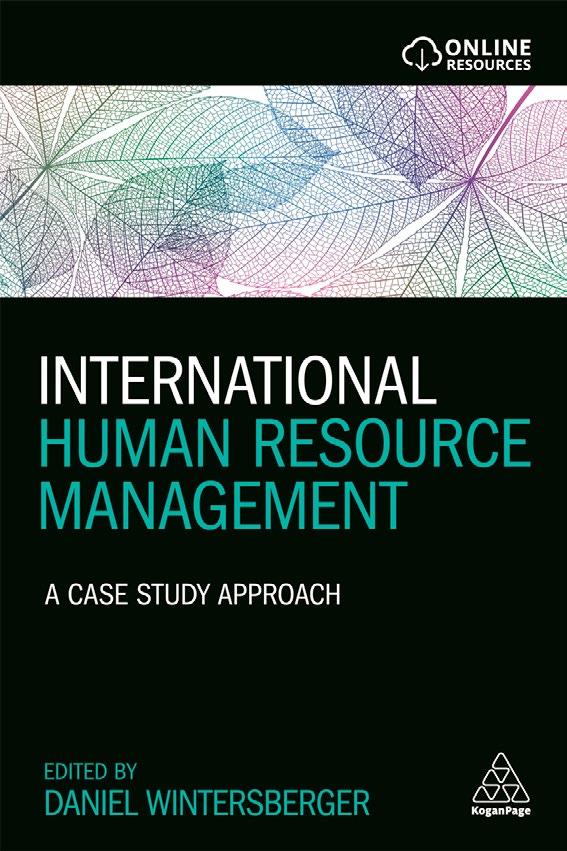
Daniel Wintersberger is a teaching fellow at Birmingham Business School in the UK, specializing in International Human Resource Management. He currently teaches on the MBA (HRM), MSc in Human Resource Management and the BSc in Business Management. Previously, Daniel lectured at Cardiff University Business School and Swansea School of Management. He has conducted research for the International Transport Workers' Federation (ITF) and worked with the British Airline Pilots' Association (BALPA). His professional and research experience spans Central and Eastern Europe, China, India and Brazil.
Edition: 1
Date: 11/28/2017
Price: $55.99
Paperback: 9780749480981
Ebook: 9780749480998
Pages: 304
Format (mm): 235x157
Band: Textbook
Subject: International HRM
1 The Context of International HRM
1 Introduction and Background to International HRM [Daniel Wintersberger]
2 The Cultural Context of International HRM [Daniel Wintersberger]
3 Leadership Across Cultural Contexts [Avis Tam]
4 Cross-Cultural Communication [James Baba Abugre]
5 The Institutional Context of International HRM [Daniel Wintersberger]
6 Global Labour Governance and Core Labour Standards [Christina Niforou]
2 Functional Areas of International HRM
7 International Recruitment, Selection and Talent Management [Peter Foss]
8 International Staffing in Multinational Companies [James Baba Abugre]
9 International Reward [Daniel Wintersberger]
10 International Training and Workforce Skills [Daniel Wintersberger]
11 International Employee Relations [Geraint Harvey]
12 Work Organization and Job Design across National Contexts [Daniel Wintersberger and Jorge Muniz Jr]
13 Conclusions: Change or Continuance in National Systems of HRM?
Edition: 1
Date: 04/28/2013
Price: $69.99
Paperback: 9781843983002
Ebook: 9781843983538
This book
• Ideal for students studying International Human Resource Management for the first time or those studying in their second language
• Online resources: Lecturer guide, powerpoint slides, case studies and a bonus chapter on new directions in International HRM as well as annotated web links and self-test questions for students

Full of contributions from experts in specific regions including North America, the Middle East and North Africa, India, Russia and China, this book will provide readers with a thorough understanding of HRM around the world. With crucial coverage of international HRM issues including cross-cultural leadership, business ethics, global talent supply and management as well as performance management of international staff, International Human Resource Management is essential reading for all those working or looking to work in HR around the world, particularly those looking to work in multinational companies. Fully supported by online resources including powerpoint slides, a lecturer guide, additional case studies and a bonus chapter on issues and new directions in International Human Resource Management as well as annotated web links and self-test questions for students.
Author Information
Dr. Crystal Ling Zhang is Senior Lecturer in Human Resource Management and Organisational Behaviour at Leeds Business School, Leeds Metropolitan University, UK
Pages: 440
Format (mm): 247x190
Band: Textbook
Subject: International HRM
Table of Contents
1 International HRM, National Differences and the Transfer of HRM (Paul Iles)
2 National Difference, Culture and IHRM (Crystal Zhang and Paul Iles)
3 Globalisation and IHRM Policies at the Enterprise Level (Paul Iles)
2 HRM and National Culture
4 Cross-Cultural Learning - Theories and Principles (Crystal Zhang and Paul Iles)
5 Cross-Cultural and Global Leadership, Leadership Development and IHRM (Crystal Zhang and Paul Iles)
6 Ethics, Culture and Corporate Social Responsibility (Paul Iles)
7 IHRM, Culture and Knowledge Flows in International Alliances, Joint Ventures, Mergers and Acquisitions (Paul Iles)
3 HRM in Different Regions
8 HRM in North America and Western Europe - The emergence of a ‘Western’ HRM model? (Paul Iles)
9 HRM in Russia and Central and Eastern Europe (Paul Iles)
10 HRM in the Middle East and North Africa (Paul Iles & Niki Kyriakidou)
11 HRM in Sub-Saharan Africa (Paul Iles)
12 HRM in Latin America (Paul Iles)
13 HRM in India (Crystal Zhang, Shakiya Nisa & Paul Iles)
14 HRM in China (Paul Iles & Xiaoxian Zhu)
4 International HRM Policies in IES
15 Employee Resourcing - Staffing, Recruitment and Selection in International Contexts (Paul Iles and Tingting Jiang)
16 Cross-Cultural Training and International HRD (Crystal Zhang & Paul Iles)
17 Global Talent Management (Paul Iles, Xiaoxian Zhu)
18 Managing the Performance of International Staff (Paul Iles)
19 Global Reward Management, Organisational Benefits and Employer Branding (Paul Iles and Tingting Jiang)
20 Employment Relations and Employee Voice in a Global Context (Paul Iles)
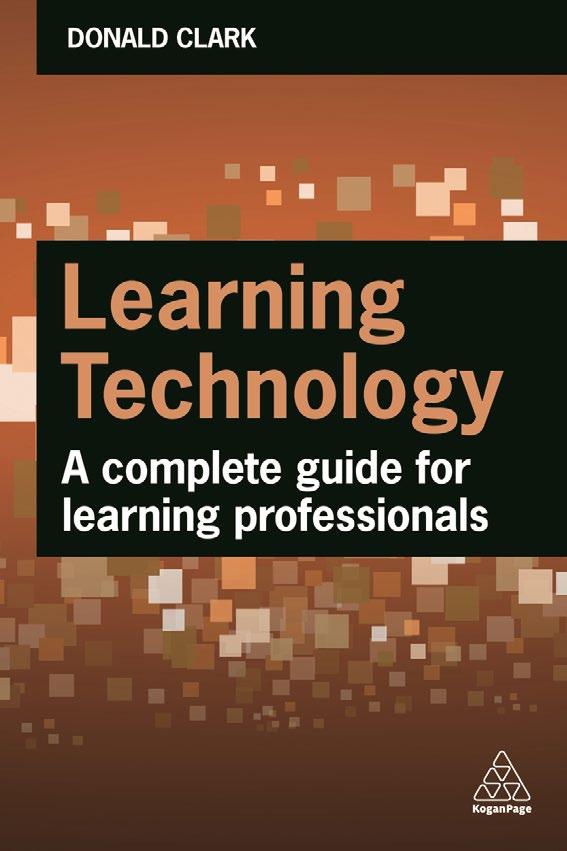
• Discusses the history of learning technology, its aims and the benefits for individuals and business
• Covers the latest developments in learning technology such as artificial intelligence, virtual reality and the metaverse
• Explains Learning Management Systems (LMSs), Learning Experience Platforms (LXPs), Learning Record Stores (LRSs) as well as discussion of data and analytics, simulations and mobile learning
• Written by an industry expert with over 35 years' experience in learning tech
Learning technology is now an integral part of all learning and development activity. Understanding what these technologies are, how they work and their aims is key to successful L&D practice.
Learning Technology is written by a leading voice in the learning tech industry. It explains the history of learning tech, its aims and how it is the fundamental technology that has driven learning, culture and progress. This book covers everything from writing to printing, broadcast media, teaching technology as well as detailed discussion of learning management systems (LMSs), learning experience platforms (LXPs) and learning record stores (LRSs). It also highlights the importance of data and analytics and covers the latest developments in the learning technology space including artificial intelligence, virtual reality and the metaverse.
Learning Technology helps L&D professionals assess and better understand learning platforms and teaching technologies, both past and present. it supports this by evaluating the benefits of each technology. It also provides insights into the future of work and learning and offers a comprehensive overview and detailed exploration of the topic.
Donald Clark has over 38 years' experience in online learning, simulations, virtual reality, mobile and artificial intelligence projects. He was a founding member of Epic Group plc and the Founder and CEO of Wildfire Learning. He is a frequent global speaker, blogger, advisor and researcher and is also a Visiting Professor at the University of Derby. Based in Brighton, UK, Donald Clark is also the author of Artificial Intelligence for Learning and Learning Experience Design, both published by Kogan Page.
Edition: 1
Date: 01/28/2023
Price: $45.99
Paperback: 9781398608740
Ebook: 9781398608764
Pages: 296
Format (mm): 230x155
Band: Professional
Subject: HR Technology
1 Learning technology
2 Prehistoric learning technology
3 Writing
4 Printing and books
5 Broadcast and media
6 Teaching technology
7 Teaching machines
8 Computers and the internet
9 Platforms
10 Content
11 Artificial intelligence
12 Metaverse
• Explains why a learning strategy which encourages a culture of continuous improvement is essential for success
• Provides guidance on upskilling and reskilling a workforce in a collaborative and techenabled world
• Shows how to take a human-centric approach to innovation and offers techniques for a variety of situations including problem analyses, experimentation and algorithmic business thinking
• Explores lean learning, data analytics, learning technologies including artificial intelligence (AI) and the ethics of using these technologies
• Includes case studies from Etihad Airways, ING and FEDEX
SHORTLISTED: Business Book Awards 2023 - International Business Book
Building and sustaining an organization which is nimble, adaptable, resilient and future proof is both complex and urgent. Only those with flexible and innovative Learnscapes will succeed.
Learning Ecosystems explains how organizations evolve into LearnScapes where learning techniques are aligned with continuous interaction with the ecosystem they are part of. It explains how to upskill and reskill a workforce continuously in an increasingly collaborative and tech-enabled world. Full of practical guidance and strategic advice, this book covers how to take a lifelong approach to learning in the organization and the core competencies needed for this. It explains what to do when building a value and data-driven learning strategy and discusses the symbiosis of people and technology.
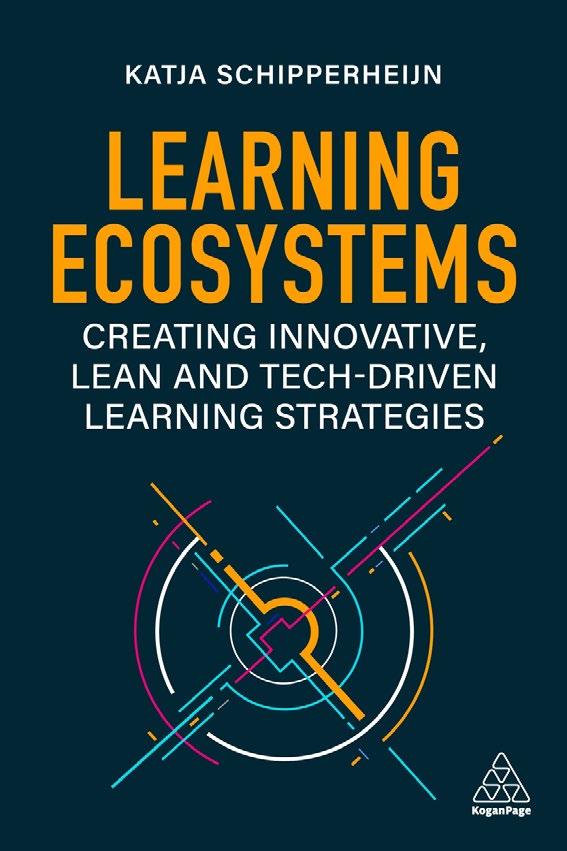
This book explores lean learning, data analytics, learning technologies including artificial intelligence (AI) and the ethics of using these technologies. There is also crucial guidance on how to take a human-centric approach to innovation. Learning Ecosystems demonstrates the value of continuous improvement and offers techniques for a variety of situations including problem analyses, experimentation and algorithmic business thinking. Most importantly, it provides guidance on how to build a learning culture and a learning ecosystem throughout the company. Supported by case studies from companies including Etihad Airways, ING, ESF and FEDEX, this is essential reading from a leading learning innovator who has helped global organizations to rethink their learning strategies to achieve sustained business growth.
Katja Schipperheijn is an internationally recognized learning strategist and founder of Habit of Improvement, a consultancy that focuses on learning strategies that foster growth and well-being in a human-machine symbiosis. Besides her work in corporate settings, she is founder of the sCooledu foundation with which she reached over 15,000 children participating in her workshops on digital citizenship. Based in Antwerp, Belgium and Dubai, UAE, she is also an international keynote speaker and guest lecturer.
Edition: 1
Date: 09/28/2022
Price: $41.99
Paperback: 9781398607408
Ebook: 9781398607415
Pages: 288
Format (mm): 234x158
Band: Professional
Subject: HR Technology
Introduction
1 A world in ever-increasing change
1 The world of human and machine
2 The value driven organization
3 The data driven organization
2 Learning to stay relevant for the future
4 Lifelong learning in a world of change
5 Competences that make us unique as human beings
3 Learning strategies and technology
6 Can learning strategies stand the test of time?
7 Learning technologies
4 Lean learning ecosystems and LearnScapes
8 The learning maturity model - From data repositories to LearnScapes
9 Lean learning
10 The six drivers of LearnScapes to make learning central
5 Building LearnScapes
11 Step 1: Discovery - Analysing the current learning needs for future success
12 Step 2: Burning platform - A supported choice for change
13 Step 3: Path to improvement - where technology, content and the learning culture come together
14 Step 4: Joint execution - no success without cooperation
15 Step 5: Future growth and improvementnever stop learning
16 Conclusion: Next steps
• Provides guidance on how to build a strategy that uses digital advancements and new technologies to make HR processes more efficient, improve individual performance and increase company profits
• Explains how to use insights from data and analytics to improve employee engagement and wellbeing
• Demonstrates how to recruit new staff and upskill existing employees so that the business has the expertise it needs to succeed in the digital age
• Includes case studies from companies who have effectively implemented a digital HR strategy and are seeing the benefits from it including Airbnb and PepsiCo
• Shows HR professionals how to adapt to the new elements of their roles created by digital transformation and new technologies
We are living in an uncertain world that is rapidly changing with an overload of information and a continual rise of technologies. Automation, the gig economy, digital platforms and other innovations are changing the fundamental nature of work and are having a significant impact on the workforce, workplace and the HR function. Digital HR Strategy is crucial reading for all HR practitioners and leaders wanting to ensure that their organization adapts to this changing and increasingly competitive environment by creating a strategic approach for sustainable transformation which goes beyond conventional digital HR propositions. Featuring case studies from organizations including Airbnb and PepsiCo, it covers areas such as the importance of cultural change and creating a humancentric employee experience, leveraging value propositions, and harnessing data insights and analytics to improve performance.
Digital HR Strategy also explores frameworks, strategies and opportunities for wellbeing initiatives, upskilling and reskilling workforces to respond to and establishing a culture of collaboration and innovation. Featuring tips, tools, and key questions to consider, it is an indispensable resource for all HR practitioners and leaders looking to build, develop and execute a digital HR strategy in order to achieve and sustain competitive advantage in this fast-changing digital age.
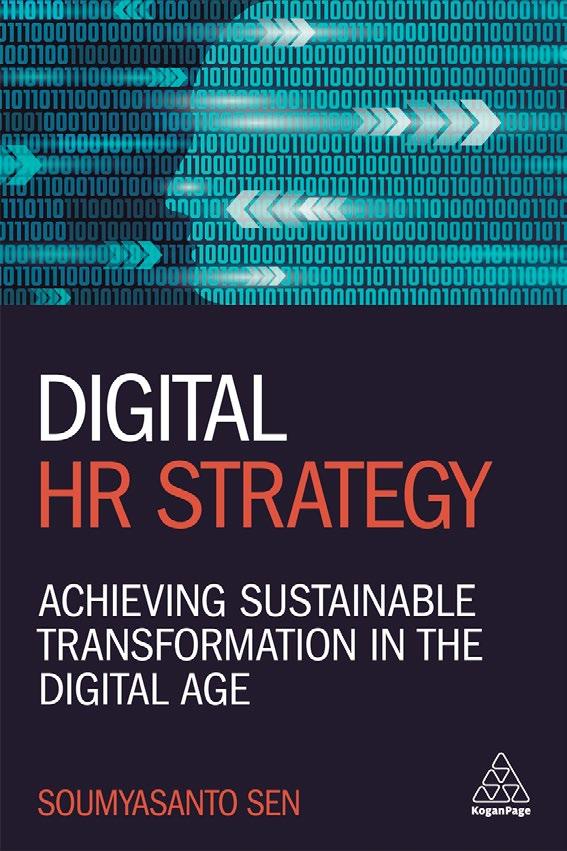
Soumyasanto Sen is the Founder and Future of Work Strategist at People Conscience, where he provides advice to communities dealing with digital transformation, the new world of work and HR strategy. He is an INSEAD alumni and currently also a HR IT Program Manager at large healthcare company. Prior to this, he was a Global HR IT Manager at one of the largest global automobile companies and a Senior Consultant at IBM Global Business Services. He is a regular conference speaker and commentator on all aspects of HR technology, digital transformation, people analytics and the future of work.
Edition: 1
Date: 02/28/2020
Price: $39.99
Paperback: 9781789661224
Ebook: 9781789661231
Pages: 312
Format (mm): 235x157
Band: Professional
Subject: HR Technology
1 Introduction
1 Revolution
2 Growing the digital economy alongside disruptions
3 The need for transformation and having the right mindset
4 The game changers - culture, data and strategy
5 Creating value propositions that are fit for purpose
2 Survival
6 The demand for the human-centric experience
7 Evolving the future of work, jobs and the workforce
8 Ongoing augmentation, reskilling and collaboration
3 Sustainability
9 Recreating the organization as a living organism
10 Driven by innovation and led by people
11 A sustainable evolution and a fairer society
12 Conclusion
13 Index
• Explores how to ensure that people practice is evidence-based, outcome-driven and improves the performance of both employees and the organisation
• Provides comprehensive coverage of all elements of an HR professional's role from recruitment and reward to job design and conflict management
• Includes reflective practice activities to encourage critical thinking and explore further boxes to help students read more widely
• New to this edition: additional content on organization development, employee experience and HR ethics
• Online resources: powerpoint slides, instructor's manual and sample essay questions
Strategic People Management and Development maps to the CIPD Level 7 module 'People Management and Development strategies for performance'.

It focuses on the need for evidence-based and outcome-driven practice in the people profession and explains how HR and Learning and Development (L&D) professionals can create value and drive performance in an organisation. It provides a thorough grounding in the theory and practice of how to lead and manage employees and effectively develop a workforce as well as extensive coverage of how to ensure professionalism and ethical behaviour in the people function. This book also includes discussion of organisation development and how high-performance work practices drive positive organisational and employee outcomes.
This book also includes practical advice on key HR activities including recruitment, job design,and reward. Fully updated throughout, this book includes case studies to help students see how the theory applies in practice, reflective practice activities to help them think critically about the content and self-test their learning progress as well as 'explore further' boxes to encourage wider reading. Online resources include an instructor's manual, lecture slides, and sample essay questions.
Gary Rees is Head of the Organization Studies and Human Resource Management at Portsmouth Business School. He is based in Portsmouth, UK.
Ray French was previously Principal Lecturer in Organizational Behaviour at Portsmouth Business School. He is based in Portsmouth, UK.
Edition: 6
Date: 12/28/2022
Price: $65.99
Paperback: 9781398607606
Ebook: 9781398607613
Pages: 408
Format (mm): 248x190
Band: Textbook
Subject: Strategic HRM
1 Strategic people management and development
1 Introduction [Gary Rees and Ray French]
2 People management and strategic context
2 The Scope and nature of people management [Gary Rees]
3 People management: strategy, culture and values [Gary Rees]
4 HRM contributions in different settings [Liza Howe-Walsh]
5 Professional and ethical people practice [Matthew Anderson & Charlotte Rayner]
3 Strategic people management and development effectiveness
6 Recruitment and selection [Kerry Collier and Ray French]
7 Talent management and developing employees for performance [Foteini Kravariti]
8 Engagement, wellbeing and inclusion [Victoria Pagan]
9 Managing the employment relationship [Peter Scott and Sally Rumbles]
10 Performance and reward: a strategic approach [Gary Rees and Alex Tymon]
11 Organisational design and effective working practices [Ray French and Emily Yarrow]
12 Organisational development and change [Gary Rees and David Hall]
4 Conclusion
13 Summary themes and future trends [Gary Rees and Ray French]
• Shows how to align HR strategies, policies and practices with wider organizational goals and objectives to improve business performance
• Features key learning summaries, source reviews and real-life examples from organizations including UNICEF and General Motors (GM)
• New to this edition: chapters on evidencebased strategic HRM, employee wellbeing strategies and HR analytics, additional case studies and updated wider content to reflect the latest research and thinking
• Online resources: lecture slides and handbooks for lecturers and students which include self-assessment questions, case study exercises and a glossary and literature review
Armstrong's Handbook of Strategic Human Resource Management is a complete guide to integrating HR strategies with wider organizational goals and objectives approaches to achieve sustained competitive advantage.
Supported by key learning summaries, source reviews and practical real-life examples from organizations including UNICEF and General Motors (GM), this book provides coverage of HRM strategies in key areas of the function such as employee engagement, talent management and learning and development, as well as strategic HRM approaches in an international context.
This fully revised seventh edition of Armstrong's Handbook of Strategic Human Resource Management contains new chapters on evidence-based strategic HRM, employee wellbeing strategies and HR analytics, as well as additional case studies and updated wider content to reflect the latest research and thinking. It remains an indispensable resource for both professionals and those studying HR qualifications, including undergraduate and masters degrees and the CIPD's advanced level qualifications. Online supporting resources include lecture slides and comprehensive handbooks for lecturers and students which include self-assessment questions, case study exercises, and a glossary and literature review.
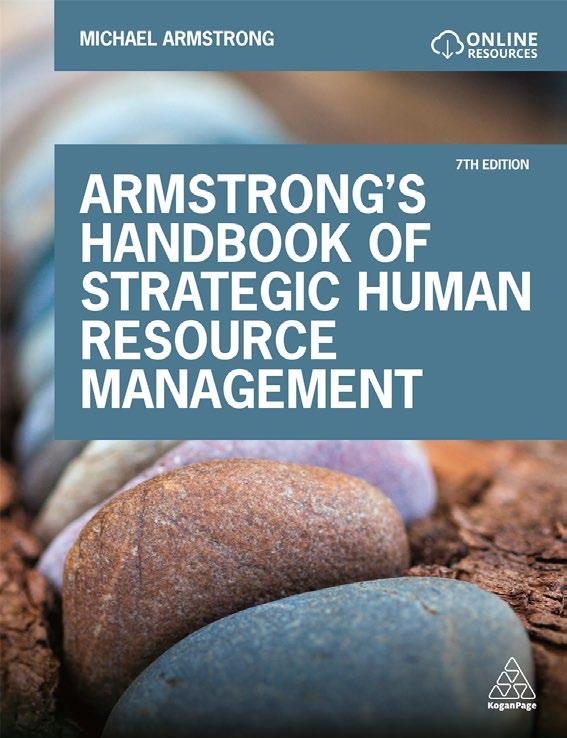
Michael Armstrong is the UK's bestselling author of HRM books. With over a million copies sold, his books have been translated into twenty-one languages. He is managing partner of E-Reward and was previously a chief examiner of the Chartered Institute of Personnel and Development (CIPD).
Edition: 7
Date: 12/28/2020
Price: $49.99
Paperback: 9781789661729
Ebook: 9781789661736
Pages: 312
Format (mm): 234x156
Band: Textbook
Subject: Strategic HRM
Introduction
1 Strategic human resource management (SHRM)
1 Human resource management
2 Strategic management
3 The concept of strategic human resource management
4 The evolution of SHRM
5 The reality of SHRM
2 People strategy in general
6 The concept of people management
7 The nature and practice of people strategy
8 Developing people strategy
9 Implementing people strategy
10 The strategic role of people professionals
3
13
14
15
16
17
• Explains what sustainable Human Resource Management is, what the benefits are and what the risks are of unsustainable HRM
• Shows how to implement and measure the effectiveness of sustainable HRM practices as well as specific guidance on sustainable HRM in different parts of the world, green HRM, responsible business, ethics and sustainable HRM as a business strategy
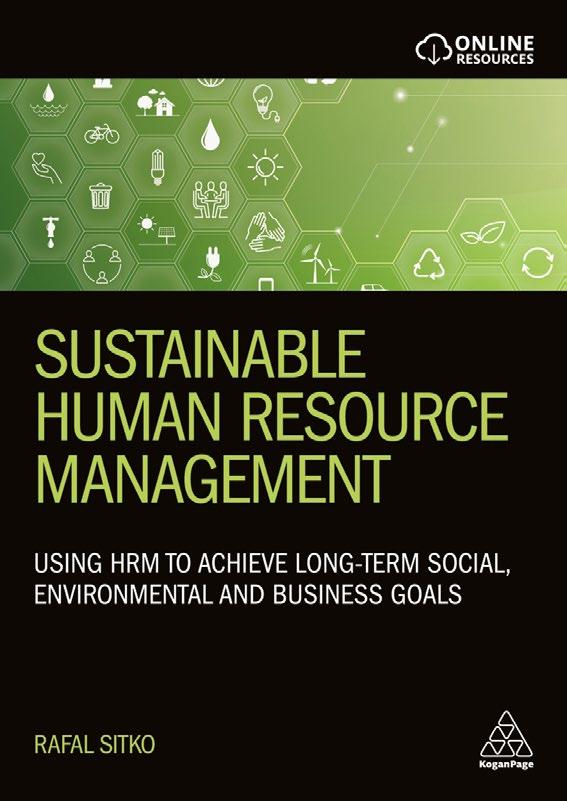
• Includes international case studies and examples throughout to show how sustainable HRM can improve candidate attraction and retention, employee engagement and reward as well as how improving productivity, employer branding and company culture to drive both efficiency and business performance
• Pedagogical features in each chapter include learning objectives, key concept definitions, skill check boxes, workshop discussion articles, chapter summaries, study questions and key readings
• Online resources: Sample course handbook and PowerPoint slides
Edition: 1
Date: 02/28/2023
Price: $56.24
Paperback: 9781398606494
Ebook: 9781398606708
Pages: 344
Format (mm): 230x154
Band: Textbook
Subject: Sustainable HRM
1 Introducing sustainable HRM
2 Sustainable HRM: key concepts, theories and models
3 Harm caused by unsustainable HRM
4 Regenerating the human resource base
5 Green HRM
6 Sustainable HRM as a business strategy
7 Implementing sustainable HRM
8 Measuring and reporting sustainable HRM
9 Sustainable HRM in different areas of the world
10 Glossary
• Takes a streamlined and hands-on approach that doesn't assume previous subject knowledge or working experience
• Explores areas such as leadership styles, conflict and negotiation, motivation, organizational change and structure and design
• Analyses contemporary topics such as the implications of technology (including AI and remote working) on individuals and organizational culture
• Supported by features including learning outcomes, key concepts and terminology boxes, reflective exercises and a glossary
• Online resources: PowerPoint lecture slides, additional exercises and further resource and video links
Obtain real-world knowledge of organizational behaviour to better understand people within organizations and make businesses operate more effectively.
Fundamentals of Organizational Behaviour is a hands-on and streamlined textbook exploring an area that can at times seem challenging and abstract. It covers key areas including individual differences at work, motivation, leadership styles and conflict and negotiation, without assuming students' prior knowledge or working experience. It also explores cutting edge topics such as the implications of technology, including AI and remote working, on workplace behaviour.
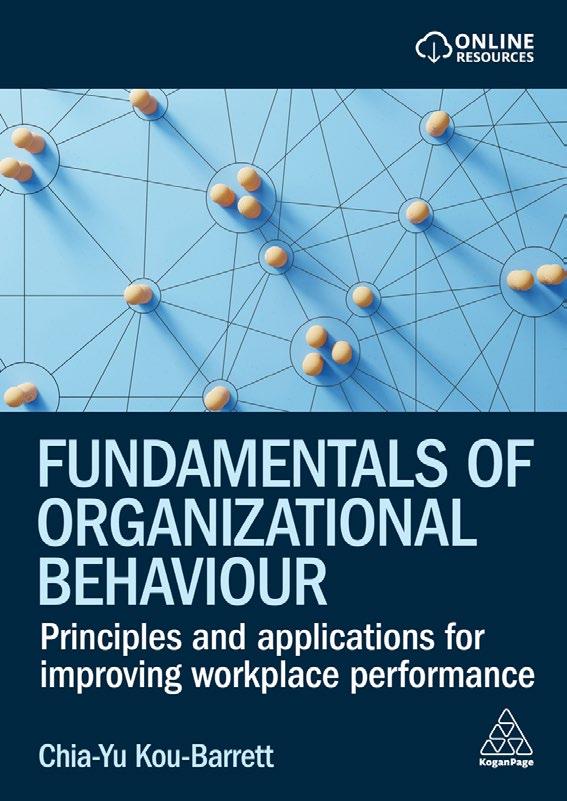
This new textbook examines power, status and political behaviours, organizational change and culture and organizational structure and design. It includes global case studies and examples throughout and is supported by a range of features including learning outcomes, key concepts and terminology boxes and reflective exercises to aid professional development.
Fundamentals of Organizational Behaviour is an essential resource for masters level and upper-level undergraduate students on HRM and Management degrees, taking modules on Organizational Behaviour.
Chia-Yu Kou-Barrett is Lecturer in Organizational Behaviour and Applied Psychology at Cranfield School of Management. Prior to this, she was an Assistant Professor in Organizational Behaviour at Smurfit Business School, University College Dublin. She has published her work in top-ranked peer-review journals, presented at a number of international conferences and co-authored several book chapters.
Edition: 1
Date: 03/28/2024
Price: $47.99
Paperback: 9781398613331
Ebook: 9781398613348
Pages: 336
Format (mm): 240x170
Band: Textbook
Subject: Organizations
1 Organizational behaviour – an overview of key concepts, definitions and trends
2 Individual differences – personality and diversity
3 Motivation theory and motivating individuals at work
4 Managing groups and teams
5 Power, status and political behaviours
6 Leadership styles
7 Conflict and negotiation
8 Organizational structure
9 Organizational change and organizational culture
10 Technology and organizational behaviour
• Bridges the gap between OB and HRM and shows you how to put effective people management at the heart of your organization
• Examines the role of corporate governance in shaping the scope of managerial choices in organizations and what this means in practice
• Looks at the ethical dimensions of OB that are increasingly important to understand in the context of 'good employers' and global employment standards
There is a large body of shared knowledge between the study of Organizational Behaviour and Human Resource Management but despite the crossover, they are often treated as very distinct disciplines. Written by a team of experts across both fields, Organizational Behaviour bridges the gap between OB and HRM, with an emphasis on inter-cultural and cross-cultural perspectives of organizational development, talent management, and leadership. Through a critical analysis of existing literature and case studies, the contributors cover topics such as corporate governance, ethical business practices, employee morale and motivation, performance management, corporate politics and conflict resolution, workplace diversity, creativity, and change management - all within the framework of current global employment standards and best practices.

Raisa Arvinen-Muondo works in HR management in Luanda, Angola. She has undertaken doctoral research at the University of Bedfordshire, on the career development of Angolan professionals within Western multinational organizations, focusing on the impact of experiences associated with international living.
Stephen J Perkins is Dean of London Metropolitan Business School and a Visiting Research Fellow at Cass Business School. In addition to having served in several universities, he has held senior management posts in industry at times of transformational change and consulted with private and state-owned organizations internationally.
Edition: 1
Date: 01/28/2013
Price: $64.99
Paperback: 9780749463601
Ebook: 9780749463618
Pages: 360
Format (mm): 235x158
Band: Textbook
Subject: Organizations
1 Introduction Introduction – Stephen Perkins and Raisa Arvinen-Muondo
2 Individuals at work under an employment relationship
1 Managing diverse identities at work – Janice Johnson and Christina Schwabenland
2 Perception, making decisions and people management – Raisa Arvinen-Muondo
3 Motivation at work: engagement and facilitation – Nahid Rozalin
3 Employing human resources to work together for a purpose
4 Managing performance – Caroline Bolam and Sarah Jones
5 Leadership, communication and organizational effectiveness – Linda Holbeche
6 Talent management – Raisa ArvinenMuondo and Qi Wei
4 Shifting contexts for organizational behaviour
7 Conflict, power and politics – Philip Davies and Rod Smith
8 Organizational culture – Eliot Lloyd
9 Managing organizational change – Faten Baddar Al-Husan and Konstantinos Kakavelakis
10 Creativity, innovation and the management of knowledge – Pauline Loewenberger
5 Summation and reflection
11 Coda: HRM and OB – accenting the social – Stephen Perkins and Raisa ArvinenMuondo
• Shows how to optimize the design of an organization to meet its strategies through the use of data and analytics
• Explores how to collect, sort and analyze people data in order to obtain actionable organizational insights
• Contains case studies and examples from real-world interventions, and describes how to avoid common challenges and pitfalls
• New to this edition: material on organizational planning and analysis, role design and job architecture, position management lifecycle and delta reporting and new case studies and examples
SHORTLISTED: CMI Management Book of the Year 2017 - Management Futures Category
Understand how to drive business performance with your organizational data and analytics in the second edition of Data-Driven Organization Design
Using data and analytics is a key opportunity for businesses to transform performance and achieve success. With a data-driven approach, all the elements of the organizational system can be connected to design an environment in which people can excel and attain competitive advantage. Data-Driven Organization Design provides a practical framework for HR and organization design practitioners to build a baseline of data, set objectives, carry out fixed and dynamic process design, map competencies, and right-size the organization. It shows how to collect the right data, present it meaningfully and ask the most relevant questions of it to help complex, fluid organizations constantly evolve and meet moving objectives.
This updated second edition contains new material on organizational planning and analysis, role design and job architecture, position management lifecycle and delta reporting. Alongside this, new case studies and examples will show how these approaches have been applied in practice. Whether planning a long-term transformation, a large redesign or an individual small project, Data-Driven Organization Design will demonstrate how to make the most of your organizational data and analytics to drive business performance.
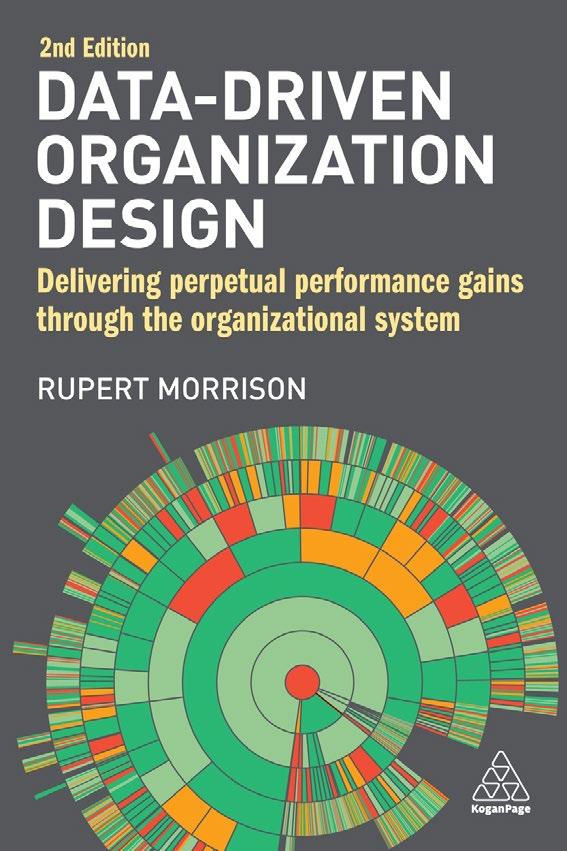
Rupert Morrison is the CEO and co-founder of Concentra Analytics, a software provider and consultancy firm which captures, manages, and analyzes data to improve organizational operations and execute strategies more effectively. Concentra Analytics works with clients including HSBC, Tesco, Aviva and FedEx and has won a Most Innovative award in The Sunday Times FastTrack Tech 100. Based in London, UK, he is also an international conference speaker and industry writer, whose contributions have featured in The HR Director, Personnel Today and the SHRM Blog.
Edition: 2
Date: 10/28/2021
Price: $46.95
Paperback: 9781398603264
Ebook: 9781398603271
Pages: 440
Format (mm): 235x155
Band: Professional/ Academic
Subject: Organizations
1 Introduction
1
2 Challenges
3
2
4
5
3
6
8
9
11
4
12
13
14
15
16
17
18
• Helps students develop effective analytical and problem-solving skills as they understand key OD and HRD issues
• Explains concepts and theoretical approaches clearly and provides activities to help cement understanding
• Online resources: instructor’s manual, additional case studies, multiple-choice questions and annotated web links
Developing People and Organisations introduces and explores concepts relevant to the learning outcomes for the optional units in CIPD's Level 5 Intermediate qualifications in human resource development (HRD) and organisational design and development. It provides a practical and accessible exposition of key theories informing the professional practice of HRD so students can explain and analyse the organisational context of HRD practice and describe, compare and critically evaluate a range of theories and approaches.

Written and edited by CIPD-accredited experts in the field and mapped to CIPD's HR Profession Map, Developing People and Organisations covers key topics such as organisation design and development, developing coaching and mentoring in organisations, meeting OD needs and developments in HRD. It includes reflective activities, annotated further reading, a glossary and case studies to encourage the application of theory to a practical working environment. Online supporting resources include an instructor's manual, additional case studies, multiple-choice questions and annotated web links.
Jim Stewart is Professor of HRD at Liverpool Business School, UK. He is also Chief Examiner of Learning and Development for the CIPD as well as Visiting Panel Chair and External Moderator.
Patricia Rogers is part of the Postgraduate Taught Strategy and Development Group responsible for the development of postgraduate taught strategies across Coventry University, UK.
Edition: 1
Date: 08/28/2012
Price: $69.99
Paperback: 9781843983132
Ebook: 9781843983316
Pages: 240
Format (mm): 246x191
Band: Textbook
Subject: Organizational Development
1 Organisation Design (Gary Connor, Ian McLean and Michael McFadden)
2 Organisation Development (Sophie Mills, Kristen Stevens, Krish Pinto, Amanda Lee)
3 Developing Coaching and Mentoring within Organisations (Terrence Wendell Brathwaite, Jill Ashley-Jones, Rosalind Maxwell-Harrison)
4 Meeting Organisational Development Needs (Jim Stewart, Dalbir Sidhu)
5 Contemporary Developments in Human Resource Development (Jim Stewart, Sharon McGuire)
6 Knowledge Management (Carol Woodhams, Graham Perkins)
7 Improving Organisational Performance (Patricia Rogers, Michelle McLardy, Raymond Rogers, Susan Barnes)
• Provides examples of emergent theories of OD and HRM and details of how these can be applied in the workplace
• Includes international case studies showing both successful and unsuccessful attempts at change
• Online resources: additional case studies and practical tools
People and Organisational Development is ideal for both practitioners and students alike. Setting out a new agenda for organisational effectiveness, this book not only covers emergent theories of organisational development and human resources management, it also gives practical examples for how these theories can be applied. Covering everything from how HR can support strategic change and how technology can be an agent of transformation to performance management, diversity, talent management and emotion at work, this book firmly places HR at the heart of a modern approach to OD.
Crucially, People and Organisational Development doesn't just examine successful change initiatives, it also covers the unsuccessful attempts at organisational change and what can be learnt from these. There is also invaluable discussion of the OD role of HRD in ethics, corporate social responsibility (CSR) and sustainability. Packed with international case studies and examples, this is essential reading for all those studying the CIPD Level 7 Advanced Organisation Design and Organisation Development module and everyone wanting to make a difference to the development of their people and their organisation. Online supporting resources include additional case studies and practical tools.
Helen Francis is Director of the Edinburgh Institute of Leadership and People Management (EILPM) and Reader within Edinburgh Napier Business School, UK.
Linda Holbeche is Visiting Professor at both the University of Bedfordshire and Cass Business School and an Associate at Ashridge Business School, UK.
Martin Reddington was formerly Global Programme Director, HR Transformation, at Cable & Wireless. Since leaving Cable & Wireless, he blends academic research with consultancy.
Edition: 1
Date: 01/28/2012
Price: $69.99
Paperback: 9781843982692
Ebook: 9781843983279
Pages: 376
Format (mm): 242x190
Band: Textbook
Subject: Organizational Development
1 Organisational Effectiveness - A New Agenda for Organisational Development (OD) and Human Resource Management (HRM) (Helen Francis, Linda Holbeche and Martin Reddington)

2 The Strategic Context for The New OE (Linda Holbeche)
3 The Historical and Theoretical Background to Organisation Development (Naomi Stanford)
4 Developing an Organisational Strategy from an HR Perspective (Mark Withers)
5 Organisational Culture and Cultural Integration (Valerie Garrow and Graeme Martin)
6 An ER Perspective on Organisational Effectiveness (John Purcell)
7 Transforming HR to Support Strategic Change (Peter Reilly)
8 Technology as an Agent of Transformation (Martin Reddington)
9 Critical HRD and Organisational Effectiveness (Allan Ramdhony)
10 The Role of Line Managers in HRM, Learning and Innovation (John Castledine and Douglas W. S. Renwick)
11 Strategic Workforce Capability - Planning for a New Era (Roger Cooper and Melanie Wood)
12 Performance Management and Reward (Roger Cooper and Adrian Furnham)
13 Inclusive Talent Management and Diversity (Eddie Blass and Gillian Maxwell)
14 Employer Branding and Organisational Effectiveness (Helen Francis and Martin Reddington)
15 The OD Role of HRD in Ethics, Corporate Social Responsibility and Sustainability (Carole Parkes)
16 Emotion at Work (Chiara Amati and Chris Donnegan)
17 The New OE - Future Prospects and Possibilities (Helen Francis, Linda Holbeche and Martin Reddington)
• Demonstrates how to design agile organizations and adapt existing people practices, including working patterns, job design, workforce planning and employee engagement
• New to this edition: new content on building agile careers and hybrid forms of working; how inclusion and wellbeing support individual resilience and contribute to improved performance across the organization
• Features case studies from organizations including the Alliance Manchester Business School, the UK National Health Service (NHS), SNC-Lavalin's Atkins business and General Electric (GE), new case studies; including how organizations responded to COVID-19
The key to retaining competitive advantage in a volatile business world is agility. The third edition of The Agile Organization shows how to develop capabilities across the organization to adapt.
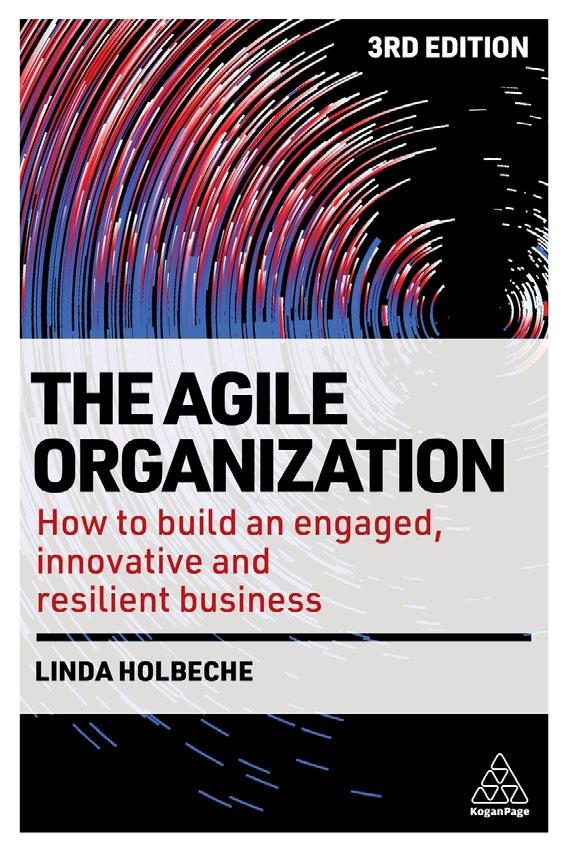
With helpful checklists, tips and advice, this is a practical blueprint to building both agility and resilience at individual, team and organizational levels. It covers how to design agile organizations as well as how to implement agile models into existing organizations and people practices. There is guidance on how agility can be applied to talent management, flexible working patterns and the importance of mobilizing and energizing employees for change.
This edition contains new material on agile mindsets and enterprise agile planning, alongside how hybrid forms of working can enhance resilience. There is also extended material on how inclusion and wellbeing initiatives can support individual resilience and innovation to improve performance across the organization. Case studies include ING, the University of California, Berkeley, the UK National Health Service (NHS) and SNC-Lavalin's Atkins business. This book is an essential read for HR and OD specialists, senior leaders and managers who want transform their organization and build an agile business.
Linda Holbeche is co-director of The Holbeche Partnership, and was previously Director of Research and Policy at the CIPD. She was Director of Leadership and Consultancy at the Work Foundation and of Research and Strategy at Roffey Park and is Visiting Professor at five UK universities. In 2021 she was named as one of the Most Influential HR Thinkers by HR Magazine and is the co-author of Organization Development, also published by Kogan Page. She is based in Sussex, UK.
Edition: 3
Date: 06/28/2023
Price: $35.99
Paperback: 9781398608665
Ebook: 9781398608672
Pages: 416
Format (mm): 235x155
Band: Professional/ Academic
Subject: Organizational Development
Introduction
1 Why go agile?
2 The resiliently agile organization
3 Agile strategizing
4 Agile linkages
5 Designing for agility
6 Agile implementation
7 Agile people processes
8 Nurturing employee engagement and resilience
9 HR’s role in building a high-performance work climate
10 Building a change-able culture
11 Agile leadership
12 Conclusion
• Explains what organizational planning and analysis is and how it can improve business performance
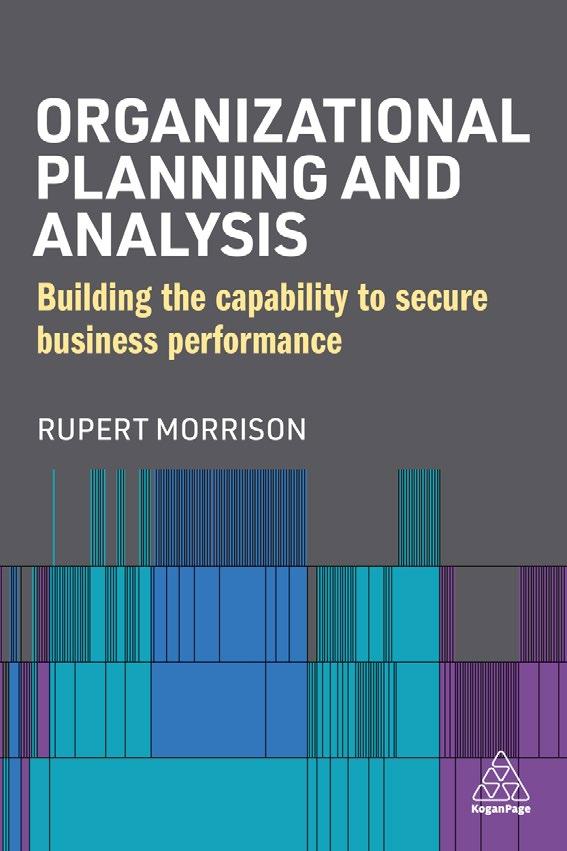
• Outlines the difference between strategic and operational workforce planning and how to embed robust succession planning
• Shows how to match people to new or changing roles and identify any skills gaps in the organization
• Covers how to use people analytics to improve the return on investment (ROI) for each employee in the organization
• Includes case studies from KPMG, Sainsbury's, WPP, Accenture, TSB, Johnson & Johnson, Aer Lingus and FedEx.
What is the cost of employees today and what will this be in the future? This book explains how to take a data-driven approach to workforce planning and allow the business to reach its strategic goals.
Organizational Planning and Analysis (OP&A) is a data-driven approach to workforce planning. It allows HR professionals, OD practitioners and business leaders to monitor an organization's activities and analyse business data to regularly adjust plans to ensure that the business succeeds. This book covers everything from how to build an OP&A function, the difference between strategic and operational workforce planning and managing demand and supply, as well as matching people to new or changing roles and developing robust succession planning. Organizational Planning and Analysis also covers how OP&A works with HR operations including recruitment, L&D, reward and performance management and includes a chapter on new human capital analytics which allow a business to improve the return on investment for each of its employees.
Full of practical advice and step by step guidance, this book is also supported by case studies from organizations including KPMG, Sainsbury's, WPP, Accenture, TSB, Johnson & Johnson, Aer Lingus and FedEx.
Rupert Morrison is the CEO and co-founder of Concentra Analytics, a software provider and consultancy firm which captures, manages and analyses data to improve organizational operations and execute strategies more effectively. Concentra Analytics works with clients including HSBC, Tesco, Aviva and FedEx and has won a Most Innovative award in The Sunday Times FastTrack Tech 100. Based in London, UK, he is also an international conference speaker and industry writer, whose contributions have featured in Forbes, HR Director and Personnel Today.
Edition: 1
Date: 09/28/2022
Price: $49.99
Paperback: 9781398605817
Ebook: 9781398605862
Pages: 384
Format (mm): 233x156
Band: Professional/ Academic
Subject: Organizational Development
1 Introduction
1.1 Organizational planning and analytics
1.2 Data-driven organization design
1.3 Financial planning and analytics
2 Making it real - Transformation and optimization
2.1 Introduction
2.2 Preparing to execute
2.3 Implementation
2.4 Ongoing optimization
3 Workforce Planning
3.1 Introduction
3.2 Supply forecasting and top-down demand planning
3.3 Bottom-up position planning, finalizing the workforce plan and monitoring progress
4 OP&A analysis
4.1 Introduction
4.2 Laying the foundations for effective OP&A analysis
4.3 Ignoring statistical traps and leveraging data science
5 The OP&A function
5.1 Introduction
5.2 Stage 1: Scoping the macro operating design and writing the business case
5.3 Stage 2: Detailing the OP&A function
5.4 Stage 3: Making the OP&A function real
5.5 Chapter - 18: Glossary
• Provides a complete guide for both students and practitioners to implementing effective OD to drive performance and growth
• Includes theory overviews as well as tools, techniques and international case studies from organizations including Ernst & Young, Nationwide, Lockheed Martin and the University of Sheffield
• Explores HR in relation to OD, and connected areas such as organization design, employee engagement, building organizational agility and resilience, and culture change
• New to this edition: chapters on building an adaptive culture of learning and innovation, organization health and 'use of self', material on digitization, OD in SMEs, competence profiles and OD education and development, new case studies and practice suggestion boxes at the end of each chapter
Organization Development (OD) is key to ensuring that organizations and their people can adapt to and engage in ongoing change in today's fast-paced and competitive world. How can those responsible for managing change determine the most appropriate course of action for their organization's needs and maximize capability?
Written by two of the leading experts in the field, Organization Development is an essential guide to the theories, practices, tools and techniques for achieving success. It explores the role of HR in relation to OD, and connected areas such as organization design, building organizational agility and resilience, and culture change.
Alongside international case studies from organizations including Ernst & Young, Nationwide, Lockheed Martin and the University of Sheffield, UK, this revised third edition of Organization Development contains new chapters on building an adaptive culture of learning and innovation and organization health and 'use of self'. With fresh material on digitization, OD in SMEs, and competence profiles, this is an indispensable handbook to understanding, communicating and implementing organization development approaches for both experienced practitioners and students.
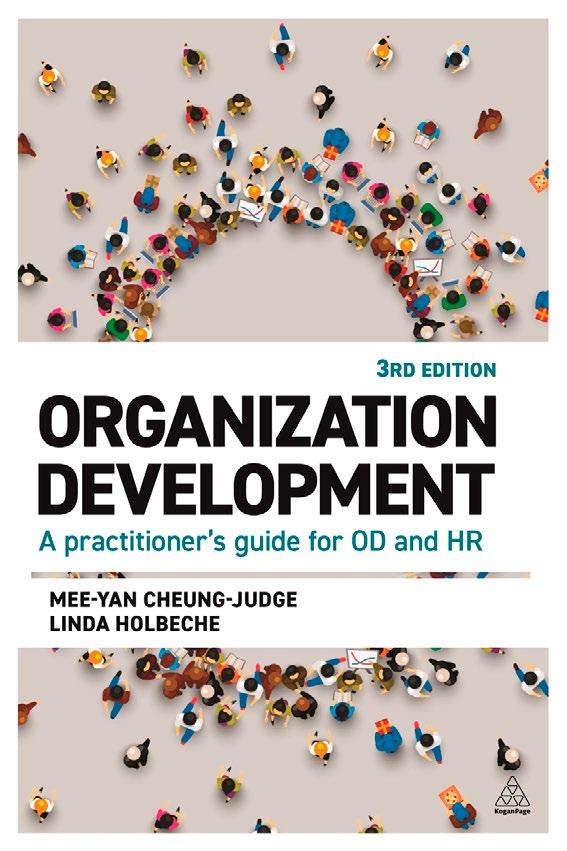
Mee-Yan Cheung-Judge had over 30 years' experience of delivering transformational change in a range of international organizations, including the BBC and Singapore's public sector agencies. A widely published author and international conference speaker, she was voted a Top Influential Thinker by HR Magazine in 2017 and 2019.
Linda Holbeche is Co-Director of the Holbeche Partnership, Adjunct Professor at Imperial College London Business School, UK, and Visiting Professor at four other UK universities. She acts as consultant on OD, HR, Strategy and Leadership. She is Fellow of Roffey Park and the Institute of Employment Studies and was previously Director of Research and Policy at the Chartered Institute of Personnel and Development (CIPD) and Director of Leadership and Consultancy at the Work Foundation. She is the author of The Agile Organization, also published by Kogan Page.In 2021 she was named as one of the Most Influential HR Thinkers by HR Magazine
Edition: 3
Date: 06/28/2021
Price: $49.99
Paperback: 9781789667912
Ebook: 9781789667929
Pages: 576
Format (mm): 240x170
Band: Professional/ Academic
Subject: Organizational Development
1 A practitioner’s guide for Organization Development
1 Section 1: OD history and theory overview
1 What is OD? Its brief history
2 Theories and practices of OD: a theory overview
2 Section 2: OD cycle of work
3 Theories and practices of OD - the OD cycle and the entry and contracting phase
4 Theories and practices of OD - the diagnostic phase
5 Theories and practices of OD - the intervention phase
6 Theories and practices of OD - the evaluation phase
3 Section 3: OD and change
7 Living at the edge of chaos and change
8 Back-room and front-room change matters
9 Can behavioural change be made easy?
4 Section 4: The Organization Development practitioner
10 The Organization Development practitioner
11 Power and politics in Organization Development
5 Section 5: Additional thoughts
12 What is an organization? What is organization health?
13 How to build up your presence and impact on organization life
2 HR in relation to OD: theory and practice
14 HR in relation to OD
15 Organization Design
16 Transformation and culture change
17 Building organizational agility and resilience
18 A culture conducive to innovation and learning
19 Building the context for employee engagement
20 Developing effective leadership
21 Postscript – towards a better tomorrow
22 References and further reading
23 Index
• Includes examples from global companies going through transformation as well as high growth challengers
• Outlines how organization design can help mature companies better embrace and connect digital capabilities, and how fastgrowth companies can mature and scale a culture that was effective for a start-up but is now facing new competition
• Conveys contemporary concepts around organization design in practical, accessible language
While technology and geopolitical forces change the face of business today, the patterns and challenges of organizing humans to work together across organization, culture, language and time zone boundaries remain. To face these challenges, all organizations need to be agile, networked and scalable.
Networked, Scaled, and Agile reveals how to shape organizations that will enable people to make faster and better decisions in a more complex world. By outlining the tension between the need for agility/differentiation and scale/integration, the book offers a new way to think about this debate using the models of the Tower (vertical integration) and the Square (horizontal integration). It addresses the role of the leadership team and how the organization design process can build C-suite leaders and successors. Each chapter concludes with a series of reflection questions for leaders as well as a summary of key concepts and tips.
Including case studies from global organizations, Networked, Scaled, and Agile reveals how organization design can address three of the biggest business challenges organizations face today: how to build a new capability across the entire enterprise; how to make the entire organization more customer-centric; and how to allow for faster innovation.
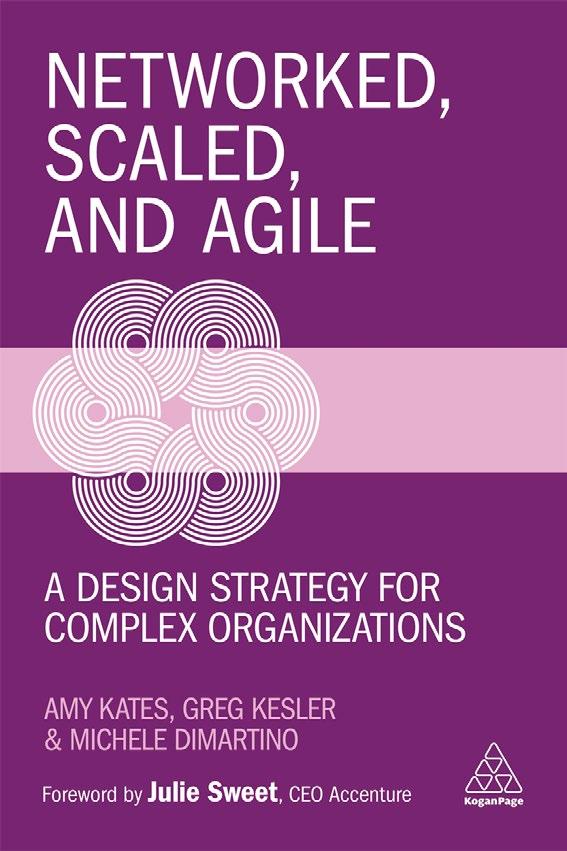
Amy Kates, Greg Kesler, and Michele DiMartino are organization design practitioners that consult to senior executives in companies around the world and live in New York, NY, Turnbull, CT and St. Petersburg, FL respectively. They are Managing Directors at Kates Kesler Organization Consulting, which is part of Accenture. Kates Kesler is recognized as one of the leading organization design firms and their methodology has become the global standard. The firm has been named by Forbes as one of the best consulting firms annually since 2016.
Edition: 1
Date: 03/28/2021
Price: $39.95
Paperback: 9781789667790
Ebook: 9781789667806
Pages: 200
Format (mm): 235x155
Band: Professional/ Academic
Subject: Organizational Development
Introduction
1 The Central Design Problem
2 Operating Models
3 Organization Models
4 Vertical Organization - The Tower
5 Horizontal Organization - The Square
6 Leadership in the Tower and the Square
7 Design Challenge - Enterprise Capabilities
8 Design Challenge - Customer Solutions
9 Design Challenge - Faster Innovation
10 Conclusion
• Explores introductory key definitions and approaches as well as concepts and theories relevant to EDI from a range of disciplines
• Analyses current topics including intersectionality, diversity resistance, neurodiversity, allyship and 'rhetoric vs reality'
• Features an overview of major worldwide legislation, insights from international experts and global case studies from General Motors, The Saudi British Bank (SABB) and Tata Consultancy Services
• Online resources: lecture slides, teaching resources, examples of materials from goodpractice EDI initiatives, further long-form case studies and links to articles and videos
Gain a contemporary and complete understanding of the concepts, theories and practical considerations integral to modern diversity management with this textbook.
Equality, Diversity and Inclusion in the Workplace provides a clear and accessible introduction to the subject, finely balancing theoretical and practical considerations to enable students to engage with EDI issues with confidence and understanding. It discusses concepts and theories relevant to EDI from a range of disciplines, outlining the major legislation impacting on EDI organizational practice worldwide.

This textbook also features an in-depth exploration of the key issues, challenges and considerations regarding respective employee groups and analyses concepts such as intersectionality, diversity resistance, allyship and issues of 'rhetoric versus reality'. It features insights from EDI experts across the globe as well as legal cases and examples from the likes of General Motors and Tata Consultancy Services. It is supported by a range of learning features including learning outcomes, 'often misunderstood' features, practical activities and debate questions.
With a suite of online resources including lecture slides, teaching resources and further long-form case studies, this is an essential resource for postgraduate and upper undergraduate HRM and business students studying modules relating to equality, diversity and inclusion.
Ciarán McFadden is a Senior Lecturer in Organizational Behaviour and Human Resource Management at the University of Stirling, UK. His interdisciplinary research explores the workplace and career experiences of LGBTQ+ and neurodiverse employees, labour market discrimination and identity in organizations and has been published in numerous peerreviewed journals and several books.
Edition: 1
Date: 02/28/2024
Price: $47.99
Paperback: 9781398611962
Ebook: 9781398611979
Pages: 336
Format (mm): 240x170
Band: Textbook
Subject: Diversity & Inclusion
1 Introducing diversity management
1 Introduction
2 Justifications and rationales
3 Definitions and approaches
4 Laws and legislation
5 Interdisciplinary EDI terms, concepts and theories
6 Discrimination
7 Policies and practices
2 Employee groups and characteristics
8 Age
9 Disability and illness
10 Gender, maternity and pregnancy
11 LGBTQ+ identities
12 Race, ethnicity and national origin
13 Religion and belief
3 More advanced concepts
14 Intersectionality and other stigmatised identities
15 Diversity resistance
16 Allyship
17 Employee networks and unions
18 Critiquing diversity management
• Provides practical tools, assessments and real-life examples from organizations for developing and measuring an effective strategy for engaging employees
• Features examples and case studies from organizations such as Capital One, EDF Energy and Marks & Spencer
• New to this edition: exploration of engagement strategies for the new world of work; why wellbeing, empathy and human connection are essential for engagement and how to create strategies that are inclusive of all employees

• Online resources: downloadable templates and tools to be used in practice, including self-assessment questionnaires
• Is part of the HR Fundamentals series of succinct, practical guides for those in the early stages of HR
How can I create engagement strategies that will empower employees to succeed? This book offers a practical resource for developing an effective engagement strategy aligned to business objectives.
An engaged workforce is essential to the performance and success of any organization. Featuring practical tools and templates, Employee Engagement provides comprehensive coverage of all stages of the engagement process, from planning initiatives to building and measuring their success.
This updated third edition presents engagement strategies that account for recent workplace developments, from remote working to creating psychological safety. It also includes updates on the evolving technology trends that impact engagement and guidance on how to create strategies that are inclusive of all employees. With examples and case studies from organizations such as AXA PPP Healthcare, EDF Energy and Marks & Spencer, Employee Engagement is essential reading for HR students and professionals. Online supporting resources include diagnostic tools, templates and additional bestpractice case studies.
HR Fundamentals is a series of succinct, practical guides featuring exercises, examples and case studies. They are ideal for students and those in the early stages of their HR careers.
Emma Bridger is an award-winning employee engagement specialist and Director of People Lab, an employee engagement consultancy that works with high-profile clients worldwide. Based in Hastings, UK, she has designed and developed the CIPD range of public and in-house employee engagement courses and is a regular conference speaker. She contributed to the UK Government Review Engaging for Success and is a member of the Engage for Success movement as part of its "guru group". In 2021, she was named as one of the Most Influential HR Thinkers by HR Magazine
Edition: 3
Date: 05/28/2022
Price: $27.99
Paperback: 9781398605145
Ebook: 9781398605152
Pages: 296
Format (mm): 235x160
Band: Professional/ Academic
Subject: Employee Engagement
Introduction
1 What is employee engagement?
2 Does engagement matter?
3 Developing your employee engagement strategy
4 How it works
5 Employee engagement: How do you do it?
6 Employee engagement tools and techniques
7 Planning and action
8 Measuring engagement
9 The future of employee engagement

• Delivers an essential and easy-to-follow framework for delivering engaging communication strategies including the transition to flexible working
• Advises how to communicate change effectively and bring clarity and stability to difficult situations, with lessons learned from the Covid-19 crisis
• Includes case studies from global companies including Unilever, John Lewis, HSBC, Volvo Group and the BBC
• New to this edition: chapters on Generation Z in the workplace and the impact of remote working and new material on the responsibility of employers to assure wellbeing and diversity and inclusion
Communicating effectively is crucial to improving employee engagement, organizational culture, and performance. Learn how to focus your time and resources to make the most positive difference to your organization and its people.
Successful Employee Communications explores how to help organizations work with purpose, be better listeners and connect with employees who have higher expectations and new ways of working. Easy-to-follow frameworks and checklists will help you conduct an internal communication audit, develop and measure a communication plan, work with difficult news and behaviour change, and support leaders to be more effective communicators.
Written by leading PR and internal communications experts and packed with new case studies and updated content, this second edition of Successful Employee Communications blends theory and practice, sharing insights and lessons from global organizations including AB InBev, Cambridge University, Reckitt and the Organisation for Economic Co-operation and Development (OECD). It is essential reading for anyone responsible for internal communication, employee engagement, organizational culture or employee experience in the new world of work.
Sue Dewhurst worked as a senior internal communicator in house and as a consultant for over 20 years, before specializing in learning and development. She's trained thousands of leaders and professional communicators and her models and frameworks are used in organizations worldwide.
Liam FitzPatrick is experienced in change management, PR and internal communications in-house and for major consultancies. He lectures on developing teams, research, and planning, and has served as an external examiner at UK universities.
Edition: 2
Date: 04/28/2022
Price: $41.99
Paperback: 9781398604483
Ebook: 9781398604575
Pages: 328
Format (mm): 234x158
Band: Professional/ Academic
Subject: Employee Engagement
1 Making the case for employee communications – Understanding the value leading practitioners add
2 Conducting your own employee communications audit – Tools and tips from experts
3 Setting objectives – Considerations and templates that work based on real life examples
4 Understanding your audience – Building a realistic profile of your workforce and how to use it
5 Defining your messages – Insights from pros on why it matters, how to define them, get them agreed and stick to them
6 Channel choices for employee communications – What to consider when choosing and using methods
7 Line managers as communicators – How to help them add the most value
8 Making it happen – Overcoming obstacles and project management when implementing employee communications
9 Change and transformation –Understanding the differences for effective employee communication
10 The Changing Nature of Work and the Workplace
11 Listening and Employee Voice
12 Communicating in tough times –Preparing leaders for delivering tough messages
13 Is it working? – Evaluation and measurement of an employee communication strategy that adds value
14 Communicating on purpose – Helping employees find meaning in the modern workplace
• Covers how employment law relates to all the key functions of HR including recruitment, discrimination, health and safety, parental rights and redundancies

• Easy to navigate and written in accessible language specifically for non-law students, the book also includes a glossary with clear explanations of technical terms
• Mapped to the CIPD Level 7 Advanced module in Employment law but suitable for any non-CIPD HR or business postgraduate students
• New to this edition: Up to date coverage of the latest legal developments including discrimination and working time updates as well as the legal implications of Brexit including workers' rights and freedom of movement
• Online resources: lecturer guide, powerpoint slides and additional case studies
Employment Law is the core textbook for the CIPD Level 7 module of the same name. Easy to read, jargon-free and full of case studies and useful examples this fully updated 16th edition provides a thorough grounding in UK employment law and how it applies in practice.
This definitive guide covers everything students need know to excel at their studies and begin a successful career as an HR professional. It covers the formation of the Contract of Employment, recruitment and selection, parental rights, discrimination and health and safety in the workplace. There is also essential coverage of unfair dismissal and redundancy.
This new edition is completely up to date with the latest cases and legislation including updates to discrimination law and working time. There is also guidance on the legal implications of Brexit such as freedom of movement, workers' rights and the change to procedural arrangements for the final court of appeal in UK cases. Reflective activities, case studies and explore further boxes encourage critical thinking, broader engagement with the topic and a clear understanding of how employment law applies in practice, Online resources include a lecturer guide, powerpoint slides and extra case studies to support learning and enable students to apply the theory in practice.
David Lewis is Professor of Employment Law in the Law School at Middlesex University, UK.
Malcolm Sargeant was Professor of Labour Law in the Business School at Middlesex University, UK.
Ben Schwab is a Lecturer in Employment Law at Kingston University London, UK.
Edition: 16
Date: 01/28/2023
Price: $66.99
Paperback: 9781398604728
Ebook: 9781398604735
Pages: 552
Format (mm): 240x188
Band: Textbook
Subject: Employment Law & Relations
1 The sources and institutions of employment law
2 Formation of the contract of employment (1) – The sources of terms
3 Formation of the contract of employment (2) – Implied terms of law
4 Recruitment and selection
5 Pay issues
6 Discrimination against employees (1)
7 Discrimination (2) – Lawful discrimination, vicarious liability, burden of proof, enforcement and equality of terms
8 Parental rights
9 Health and safety at work
10 The regulation of working time
11 Variation, breach and termination of the contract of employment at common law
12 Unfair dismissal (1) – Exclusions and the meaning of dismissal
13 Unfair dismissal (2) – Potentially fair reasons and the concept of reasonableness
14 Redundancy
15 Unfair dismissal and redundancy claims
16 Continuity of employment and transfers of undertakings
17 Information and consultation
18 Trade unions and collective bargaining
19 Glossary
• Provides students with no prior understanding or experience of the UK legal system with a thorough grounding in the key employment law concepts
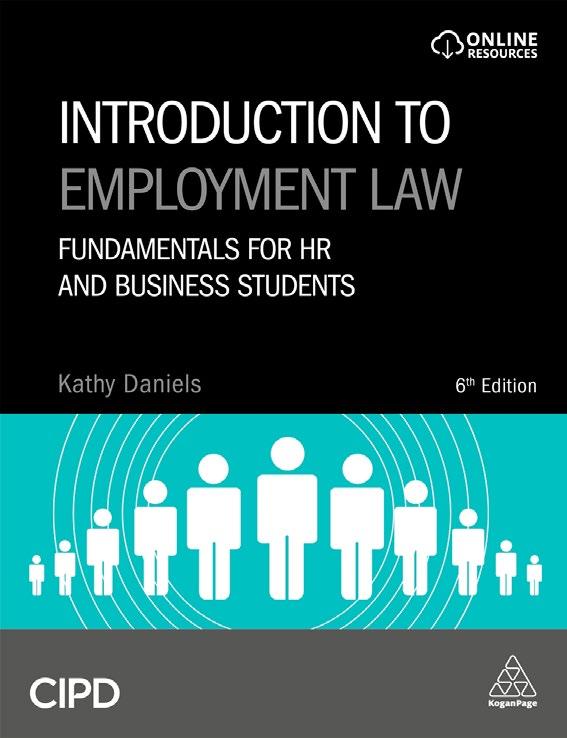
• Supports students' learning with pedagogical features including chapter objectives, tasks, 'explore further' sections, key learning points, examples to work through and a dedicated study skills chapter
• New to this edition: new material on the rights of agency workers, furlough practices, bereavement leave and the legal implications of Brexit
• Online resources: lecture slides, case studies, annotated weblinks and an instructor's manual
• Covers key areas including employment contracts, protected characteristics, discrimination, tribunals and redundancy
Written specifically for HR and business students, Introduction to Employment Law is a clear, accessible and jargon-free guide to UK employment law and how it applies in practice.
This book covers all the essentials of employment law including employment contracts, discrimination, redundancy and employment tribunals. There is also expert guidance on key issues including shared parental leave, flexible working policies and protected characteristics. Fully revised with the latest cases and legal developments, this new edition includes coverage of the rights of agency workers, bereavement leave, furlough practices and the legal implications of Brexit. This textbook doesn't assume any prior knowledge of the UK legal system and equips students with the knowledge and skills that they need to take forward into the workplace.
Packed with pedagogical features to consolidate learning including tasks, examples, explore further sections and key learning points as well as a dedicated study skills chapter covering employment law assignments and exams, Introduction to Employment Law is essential reading for all students studying the CIPD Level 5 Intermediate module in employment law. It is also an accessible introduction for Level 7 students and those on undergraduate and postgraduate business courses needing a thorough grounding in employment law. Online resources include lecture slides, case studies, annotated weblinks and an instructor's manual.
Professor Kathy Daniels is Associate Pro-Vice Chancellor (Engagement) at Aston University, Birmingham, UK. She teaches employment law and employee relations at both undergraduate and masters level and is the lead tutor for employment law programmes at the Chartered Institute of Personnel and Development (CIPD). She writes and presents extensively for a variety of organizations and law firms, specialising in employment law. She is a lay member of the Employment Tribunals, sitting in Birmingham. Prior to these appointments she was a senior HR manager in the manufacturing sector.
Edition: 6
Date: 01/28/2022
Price: $52.95
Paperback: 9781398603783
Ebook: 9781398603790
Pages: 320
Format (mm): 246x191
Band: Textbook
Subject: Employment Law & Relations
1 The formation of employment law
2 The Employment Tribunals and the Employment Appeal Tribunal
3 Contract of employment
4 Atypical contracts and the variation of contracts
5 Individual protection rights
6 Forms of discrimination
7 Discrimination - the protected characteristics
8 Termination of employment
9 Redundancy and transfers of undertaking
10 Trade union legislation
11 Privacy and confidential information
12 Health and safety
13 Study skills in employment law
14 List of legislation referred to
15 List of cases cited
16 Useful websites
• Builds knowledge in the core areas of employment law, including immigration, contracts, discrimination, equal pay and redundancy
• Features practical tools, checklists, case studies and real-life examples to help apply the knowledge in practice
• New to this edition: new material on the changeability of the law, family-friendly case law and out-of-court settlements, as well as updated case studies throughout
• Online resources: templates, forms and checklists including settlement offers, person specifications, appraisal forms, job induction checklists, preparation checklists for Employment Tribunals, additional references and links to podcasts
• Is part of the HR Fundamentals series of succinct, practical guides for those in the early stages of HR
The updated third edition of Employment Law is a clear and practical guide to understanding the complex, important system that regulates the relationship between employers and employees in the UK.

Understanding and applying the law effectively at work is essential for organizations. Employment Law offers a complete overview of the core components that form the interactions between an organization, its employees and the HR function. The third edition includes the latest developments and changes in law and HR perspectives, with new material on the changeability of the law, equal pay and parental leave.
Featuring practical tools, checklists, case studies and real-life examples, Employment Law builds legal knowledge in key areas including recruitment, contracts, discrimination, equal pay, health and safety and managing the end of the employment relationship. It is supported by case studies on topics such as early conciliation, implied rights and diversity and inclusion and online resources including person specification templates and appraisal forms and additional references.
HR Fundamentals is a series of succinct, practical guides featuring exercises, examples and case studies. They are ideal for students and those in the early stages of their HR careers.
Elizabeth Aylott has over 15 years' experience as an HR specialist and lecturer in areas of Employment Law and Employee Relations. After a career in HR both in industry and the charitable sector, she joined the Hampshire Business School where she lectured on CIPD programmes at both undergraduate and postgraduate level. She is based in Surrey, UK.
Edition: 3
Date: 05/28/2022
Price: $27.99
Paperback: 9781398603950
Ebook: 9781398603967
Pages: 240
Format (mm): 233x155
Band: Professional/ Academic
Subject: Employment Law & Relations
Introduction
1 Fundamentals
1 What is employment law?
2 The importance of employment law
3 Employment law and strategy
2 In practice
4 How it works
5 How you do it
6 Planning and action
7 Measurement
8 Conclusions and Government changes to employment law
• Provides a thorough and up-to-date grounding in the concepts and processes of employment relations as well as coverage of the legal context
• New to this edition: brand new content on workers in the gig economy, the need for greater transparency in the employeremployee relationship and how to support and encourage diversity in the workplace
• Online resources: lecturer guides, lecture slides, sample essay questions and additional case studies for students and lecturers and annotated web links
• Covers managing conflict, workplace grievances, employee discipline and how to use mediation to resolve conflict
Employment relations is concerned with the relationship between employees and their employers - one of the most important aspects of an HR role. Managing Employment Relations will give students a thorough grounding in the processes, context and practical application of employment relations and the skills they need for a successful career in HR.

Covering everything from the legal aspects of employment relations, essential policies, strategies and the changing social context to conflict resolution, mediation, employee engagement and workplace discipline, Managing Employment Relations is an indispensable guide. With brand new content on gig economy workers, supporting diversity in the workplace, individual and group policies and the need for greater transparency in the employer-employee relationship, this book is a comprehensive guide to the theory and practice of employment relations. Mapped to the CIPD Level 7 module in employment relations and full of case studies and exercises to help students understand the practical application of the core topics, this is an essential textbook for postgraduate HR students and practitioners in an employment relations role. Online resources include a lecturer guide, lecture slides, sample essay questions and additional case studies for students and lecturers as well as annotated weblinks.
Tony Bennett is a Senior Lecturer at Sheffield Business School, Sheffield Hallam University, UK and a Visiting Fellow at the Institute for Research on Organizations, Work and Employment at the University of Central Lancashire, UK.
Richard Saundry is a Professor of HRM and Employment Relations at the University of Sheffield, UK.
Virginia Fisher is a Senior Lecturer at the University of Exeter Business School, Exeter, UK.
Edition: 7
Date: 02/28/2020
Price: $69.99
Paperback: 9781789661453
Ebook: 9781789661460
Pages: 472
Format (mm): 245x190
Band: Textbook
Subject: Employment Law & Relations
1 Introduction
2 The concepts and processes of employment relations
3 The context of employment relations
4 Employment relations and the law
5 The global environment
6 Employment relations strategies, policies and change
7 Employee engagement
8 Managing employment relations
9 Employee representation
10 Employee involvement and participation
11 Managing workplace conflict
12 Managing workplace discipline
13 Managing employee grievances
14 Managing redundancy
15 The role of mediation in conflict resolution
16 Conclusion – Thoughts for the future
• Covers both the conceptual debates and functional areas of employment relations
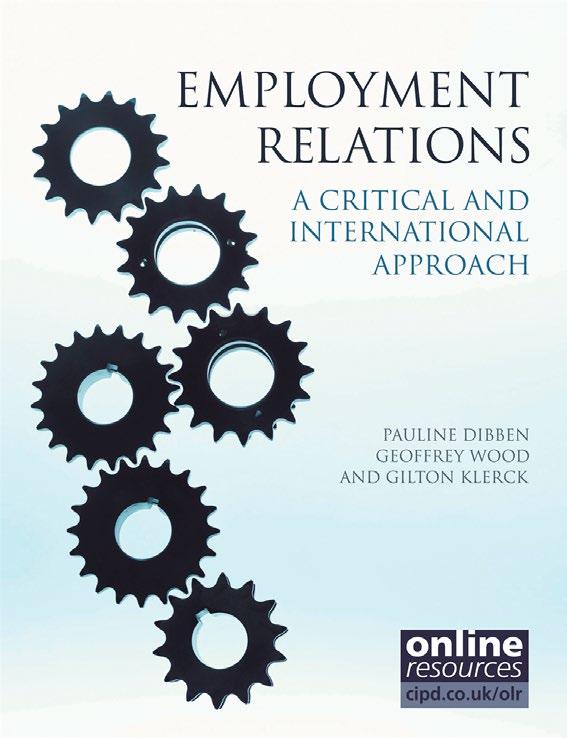
• Considers the local, national and global effects on the practice of employment relations
• Online resources: lecturer guides, PowerPoint slides and additional cases as well as annotated web links and further reading for students
Drawing on the latest research, Employment Relations is a key text for anyone studying the CIPD Level 7 Advanced module Managing Employment Relations as well as all those looking to expand their knowledge and understanding in this area. Covering both the conceptual debates and contextual factors relating to employment relations as well as key management interventions, this is invaluable reading for anyone looking to understand both the theory and practice of employment relations.
With coverage of the main players in employment relations - Trade Unions, Employers and the State - and critical discussion of the local, national and global effects on employment relations, Employment Relations provides a thorough grounding in the international context of employment relations. With comprehensive consideration of key workplace issues including employee engagement, discrimination, conflict, downsizing and redundancies, this is ideal reading for students and practitioners alike. Packed with exercises, examples and case studies, this book allows readers to take a critical approach to this crucial topic. Online supporting resources include an instructor's manual, lecture slides, additional cases, annotated web links and further reading.
Pauline Dibben is Senior Lecturer in Employment Relations at the University of Sheffield, UK.
Gilton Klerck is Professor of Sociology at Rhodes University, South Africa.
Geoffrey Wood is Professor in Human Resource Management at the University of Sheffield, UK.
Edition: 1
Date: 02/28/2011
Price: $69.99
Paperback: 9781843982685
Ebook: 9781843983255
Pages: 392
Format (mm): 248x190
Band: Textbook
Subject: Employment Law & Relations
Introduction
1 Conceptual Debates and Contextual Factors
1 The Main Players in Employment Relations
- Trade Unions, Employers, and the State
2 Theories of Employment Relations
3 Employment Relations and Human Resource Management
4 Local, National and Global Effects on the Practice of Employment Relations
5 Power and Authority
2 Management Interventions in Employment Relations
6 Voice
7 Employee Engagement
8 Pay and Reward
9 Discrimination, Difference and Diversity
10 Discipline and Grievance
11 Conflict and Dispute Resolution
12 Downsizing and Redundancy
13 Conclusion: The Relevance of Employment Relations and Comparative Employment Relations
• Provides practical tools, assessments and real-life examples including from Amazon and HSBC for planning, implementing and managing employee relations
• Shows how to align employee relations strategies to broader organizational objectives and improve business performance
• New to this edition: coverage of recent legislation changes relating to the new world of work, dispute resolution and deregulation; new and updated case studies on employee voice and industrial action
• Online resources: templates, questionnaires and further tools for development of an effective employee relations strategy
• Is part of the HR Fundamentals series of succinct, practical guides for those in the early stages of HR
The third edition of Employee Relations is a practical guide to the principles and practice of fostering positive relationships with employees to develop their engagement and achieve business success.

It features updated material on recent legislation changes including employment status in the gig economy and deregulation as a result of new international relations. Covering key areas such as conflict and dispute resolution, redundancies, rights and ethics, this book equips you with the skills and knowledge to plan, build and assess employee relations in any type of organization. Practical diagnostic tools and real-life examples from organizations including HSBC show how these strategies can be applied in practice.
With updated guidance and examples covering employee voice and the virtual workplace, Employee Relations is a vital resource for HR practitioners and students alike. Online resources include questionnaires and templates to support the development of an effective employee relations strategy.
HR Fundamentals is a series of succinct, practical guides featuring exercises, examples and case studies. They are ideal for students and those in the early stages of their HR careers.
Elizabeth Aylott is an experienced HR specialist and lecturer in the areas of employee relations and employment law. After a career in HR, both in industry and the charitable sector, she taught on CIPD programmes at all levels and lectured on HRM and business degree courses. She is also the author of Employment Law, published by Kogan Page. She is based in Surrey, UK.
Edition: 3
Date: 05/28/2022
Price: $27.99
Paperback: 9781398604834
Ebook: 9781398604919
Pages: 224
Format (mm): 233x155
Band: Professional/ Academic
Subject: Employment Law & Relations
1 Fundamentals
1 What is Employee Relations?
2 The importance of Employee Relations
3 Employee Relations and strategy
2 In practice
4 Employee Relations in practice
5 Planning and action
6 Measurement
7 Conclusion
• Fully aligned to the CIPD's new qualification framework and includes 'pause and reflect' boxes to reinforce learning, 'explore further' boxes to help students read more widely and activities to help put learning into practice
• Explains how to manage the internal and external recruitment and selection of staff including advertising jobs, interviewing processes and contracts of employment
• Covers information on job design, flexible working, discrimination and equality at work, retirement, redundancy and dismissals
• New to this edition: New chapter on the UK labour market outside the EU and the implications of Brexit on recruitment and staff development as well as further new chapters on HR analytics and employee experience
• Online resources: Lecturer Manual, PowerPoint Slides and Web links
An essential textbook for the CIPD Level 7 module in Resourcing and Talent Management which covers the recruitment, selection and retention of staff as well as employee retirement, dismissals and redundancy.

Resourcing and Talent Management provides broad and accessible coverage of key topics for HR masters students and is the essential companion for the CIPD Level 7 module of the same name. It covers everything from job design and both internal and external recruitment through to interviewing, selection and contracts of employment. There is also guidance on staff retention, succession planning, employee turnover as well as crucial information on how staff leave the business whether this is retirement, redundancy or dismissal.
This new edition of Resourcing and Talent Management now includes a brand new chapter on managing absence as well as new content on the UK labour market outside the EU and the implications of Brexit on recruitment and staff development, Fully updated throughout and aligned to the new CIPD qualification framework, this textbook includes 'explore further' boxes to encourage students to read more deeply, 'pause for thought' boxes to encourage reflection on learning and activities to put their learning in practice and test their understanding.
Stephen Taylor, Chartered CCIPD, is a senior lecturer in Human Resource Management at the University of Exeter Business School. He is also a Chief Examiner for the CIPD. Before his academic career he worked in a variety of management roles in the hotel industry and the NHS. Based in Devon, UK he is co-author of Armstrong's Handbook of Human Resource Management Practice, published by Kogan Page.
Edition: 8
Date: 12/28/2021
Price: $65.95
Paperback: 9781398600461
Ebook: 9781398600508
Pages: 480
Format (mm): 246x190
Band: Textbook
Subject: Talent Management & Recruitment
1 Introduction
2 The Resourcing and Talent Management environment
3 Human resource planning
4 Job analysis and job design
5 Recruitment advertising
6 Alternative recruitment methods
7 Employer branding
8 Selection - The classic trio
9 Advanced methods of employee selection
10 The
• Shows the nature and benefits of a critical understanding of and approach to the professional practice of learning and talent development

• Case studies help students focus on particular concepts and prepare for professional practice
• Online resources: web links for each chapter, lecture slides and an instructor’s manual complete with lecture handouts and additional case studies per chapter
Written for the CIPD Level 7 Advanced module of the same name, Learning and Talent Development combines a clear and concise structure and writing style with an academic and critical approach to the subject. It analyses and evaluates a range of learning and talent development theories and strategies so students can learn how to take the lead and confidently initiate, develop and implement these strategies, interventions and activities in the workplace.
Covering key topics such as the national and organizational context of learning and talent development, concepts related to individual and organizational learning and the functions associated with managing learning and talent development in the context of professional practice, Learning and Talent Development equips individuals to meet the expectations placed upon those performing specialist roles in developing others and is therefore also ideal for undergraduate and postgraduate students of human resource management or business students taking a module in human resource development or learning and development. Online supporting resources include web links for each chapter, lecture slides and an instructor's manual complete with lecture handouts and additional case studies per chapter.
Jim Stewart is Professor of HRD at Liverpool Business School, UK. He is also Chief Examiner of Learning and Development for the CIPD as well as Visiting Panel Chair and External Moderator.
Clare Rigg lectures at the Institute of Technology, Tralee, Ireland.
Edition: 1
Date: 01/28/2011
Price: $69.99
Paperback: 9781843982500
Ebook: 9781843983422
Pages: 392
Format (mm): 245x189
Band: Textbook
Subject: Talent Management & Recruitment
Introduction
1 The Nature, Purpose and Context of Learning and Talent Development
1 Organising and Managing Learning and Talent Development
2 International and National Contexts
3 Various and Varying Organisation Contexts
4 The Politics of Learning and Talent Development
2 The Process of Learning and Talent Development
5 Individual and Organisation Learning in Talent Development
6 Establishing Needs and Solutions to Talent Development
7 Learning and Talent Development Practical Strategies
3 The Management of Learning and Talent Development
8 Designing and Evaluating Talent Development
9 Accessing and Managing Resources
10 Ethics and Professionalism in Learning and Talent Development
11 Doing a Student Research Project
12 Conclusion
• Shows how to attract the best candidates and keep them by building cultures in which they feel valued
• Provides evidence for how better diversity and inclusion practices lead to increased creativity, openness to change, new ideas and understanding of new markets
• Includes original research from globally recognised organizations including Goldman Sachs, NHS, Telefonica, Unilever, KPMG, Royal Mail, Hitachi, Oxfam, Novartis and the Rio 2016 Olympic Games on how diversity and inclusion activities can improve talent attraction, management and retention

SHORTLISTED: CMI Management Book of the Year 2017 - Practical Manager Category
Organizations traditionally have had a clear distinction between their policies on diversity and inclusion and their talent management. The main driving force behind diversity and inclusion has been being seen to be a good employer, to be able to make claims in the annual report and to feel as though a positive contribution is being made to society. On the other hand, talent management activities have been driven by a real business need to ensure that the organization has the right people with the right skills in the right place to drive operational success. Inclusive Talent Management aligns talent management and diversity and inclusion, offering a fresh perspective on why the current distinction between them needs to disappear.
Featuring case studies from internationally recognised brands such as Goldman Sachs, Unilever, KPMG, Hitachi, Oxfam and the NHS, Inclusive Talent Management shows that to achieve business objectives and gain the competitive advantage, it is imperative that organizations take an inclusive approach to talent management. It puts forward a compelling and innovative case, raising questions not only for the HR community but also to those in senior management positions, providing the practical steps, global examples and models for incorporating diversity and inclusion activities into talent management strategy.
Stephen Frost works with clients worldwide to embed inclusion into their decision making. He teaches at various business schools and was formerly Head of Diversity and Inclusion for the London Organizing Committee of the Olympic Games and Paralympic Games.
Danny Kalman is a talent management consultant, executive coach and regular speaker on leadership development. He was Director of Global Talent at Panasonic Corporation from 2008-2013.
Edition: 1
Date: 07/28/2016
Price: $45.99
Paperback: 9780749475871
Ebook: 9780749475888
Pages: 280
Format (mm): 235x155
Band: Professional/ Academic
Subject: Talent Management & Recruitment
Challenge - The Addiction to Likeness in an Age of Diversity = Sameness
1 The Fierce Urgency of Now
1 Homogenous Talent Management
2 History – How a Segregated Mindset Evolved
3 The Future – Diversity is Local, Inclusion is Global
4 The Case for Inclusive Talent Management
2 How to Meet the Challenge
5 ITM in Recruitment – Finding Diverse Talent
6 ITM in Development – Growing Diverse Talent
7 ITM in Retention – Keeping Diverse Talent
8 Leadership – How You Can Make a Difference
9 Resolution: Change the System (Unconscious Nudges) + Change Your Behaviour (Conscious Leadership) = Inclusion
• Addresses all areas of performance management, from performance pay and giving feedback to managing underperformers and having difficult conversations
• Includes examples and exercises to show how the latest developments in performance management and leadership can be implemented with case studies from Microsoft and IBM
• New to this edition: material on managing and measuring performance with a remote workforce and creating agile performance goals; exploration of new approaches for bonuses and performance reviews
• Online resources: instructor's manual, lecture slides, a glossary and literature review
• Is written by the UK's bestselling HRM author, whose books have sold over a million copies and been translated into twenty-one languages
Optimizing staff performance is a key component of achieving outstanding business results. The new edition of Armstrong's Handbook of Performance Management is an essential companion for improving employee and organizational performance.
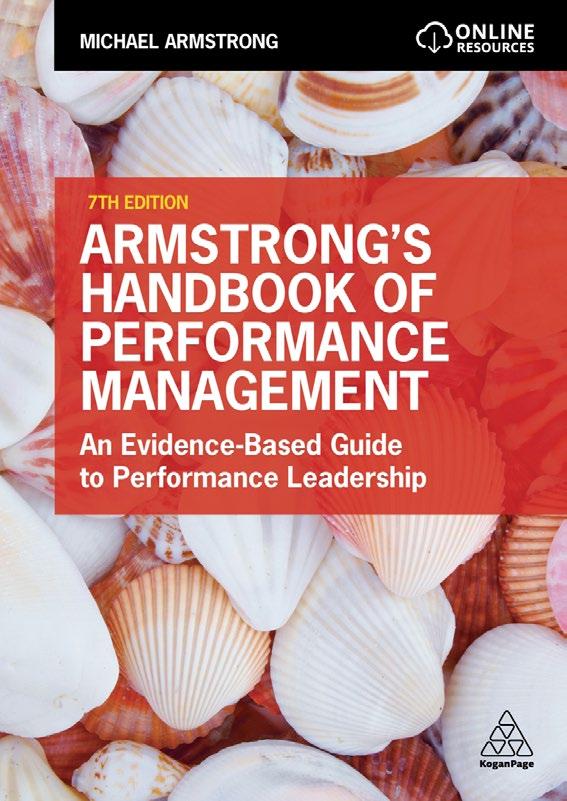
From performance pay and giving feedback to managing underperformers, this handbook addresses all areas of performance management to enable students and practitioners to understand how to assess, measure and improve performance.
This updated seventh edition contains new chapters on the meaning and development of performance management and managing performance with a remote workforce. It also covers performance leadership and multi-source feedback. Packed with examples to show how the theory applies in practice and exercises to consolidate student learning, Armstrong's Handbook of Performance Management remains an indispensable and engaging resource for securing effective performance across all aspects of the organization. Supporting online resources include an instructor's manual, lecture slides, a glossary and a literature review
Michael Armstrong is the UK's bestselling author of Human Resource Management books including Armstrong's Handbook of Human Resource Management Practice and several other titles published by Kogan Page. With over a million copies sold, his books have been translated into twenty-one languages. Based in London, UK, he is managing partner of E-Reward as well as an independent management consultant. Prior to this he was a chief examiner of the Chartered Institute of Personnel and Development (CIPD) and an HR director of a publishing company.
Edition: 7
Date: 01/28/2022
Price: $52.95
Paperback: 9781398603028
Ebook: 9781398603035
Pages: 280
Format (mm): 242x172
Band: Textbook
Subject: Performance Management
Chapter - 00: Introduction
1 Performance management fundamentals
1 The meaning and nature of performance management
2 The conceptual framework of performance management
3 Performance management systems
4 Performance management issues
5 Performance management developments
2 Performance management processes
6 Performance leadership
7 Performance and development planning
8 Assessing performance
9 Conducting performance reviews
10 Multi-source feedback
3 Performance management skills
11 Defining objectives
12 Providing feedback
13 Coaching
14 Managing underperformance
4 Applications of performance management
15 Managing organizational performance
16 Managing team performance
17 International performance management
18 Managing the performance of homeworkers
19 Performance management and learning
20 Performance management and talent management
21 Performance management and reward
22 Performance management and employee engagement
5 Managing performance management
23 Developing performance management
24 Learning about performance management
25 Evaluating performance management
6 Conclusions
26 Where is performance management today?
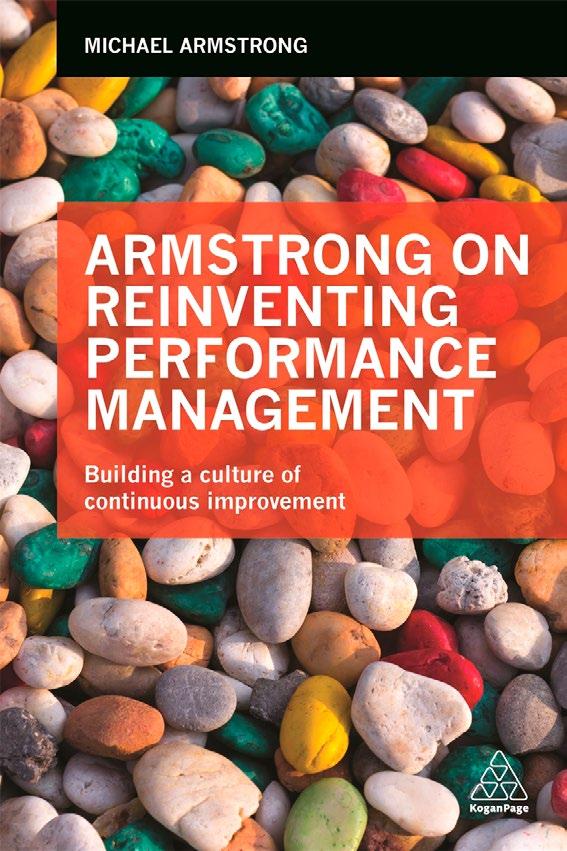
• Written by the UK's bestselling HRM author, whose books have sold over a million copies and been translated into twenty-one languages
• Provides insights into innovative approaches organizations such as Deloitte, Expedia and Google are taking to build organizational performance
• Shows how to build a culture of managing performance throughout the year which delivers results and reduces bureaucracy
• Empowers line managers to own the performance management process rather than HR, ensuring that the process is effectively cascaded across the business
Armstrong on Reinventing Performance Management presents a holistic approach to performance management, drawing on Michael Armstrong's vast research and experience. Most organizations have performance management processes in one form or another, but these are often based on formal annual reviews, forced rankings and directly linked to pay decisions. These traditional approaches are often at the expense of ongoing, continuous feedback and focus on looking back at what has or has not been achieved rather than looking forward. Direct links to pay decisions avert attention from people development, and managers often get lost in the bureaucracy of complex forms rather than fully engaging with their people.
Armstrong on Reinventing Performance Management details how to build a culture of ongoing feedback and coaching and provides case studies of how this approach to building performance has been effective in organizations including Deloitte, Gap, Expedia and Google. Filled with practical advice, including how to deal with underperformers, it enables organizations to remove overly bureaucratic and ineffective systems based on topdown judgments and ratings, and demonstrates how to get line managers' support for the process focusing on actionable feedback and growth.
Michael Armstrong is the UK's bestselling author of Human Resource Management books including Armstrong's Handbook of Human Resource Management Practice and several other titles published by Kogan Page. With over a million copies sold, his books have been translated into twenty-one languages. He is managing partner of E-Reward as well as an independent management consultant. Prior to this he was a chief examiner of the Chartered Institute of Personnel and Development (CIPD) and an HR director of a publishing company.
Edition: 1
Date: 01/28/2017
Price: $45.99
Paperback: 9780749478117
Ebook: 9780749478124
Pages: 240
Format (mm): 233x156
Band: Professional/ Academic
Subject: Performance Management
1 Performance Management – The Concept
2 Performance Management – The Reality
3 Effective Performance Management
4 What’s Happening to Performance Management?
5 Reinventing Performance ManagementThe Issues
6 Improve Objective Setting
7 Replace the Annual Performance Review
8 Abolish Rating
9 Enhance Personal Development
10 Provide Training
11 The Reinvention Programme
12 Conclusions
• Balances theory with practice to give students a full understanding of the subject
• Maps to the CIPD advanced-level unit on Performance Management
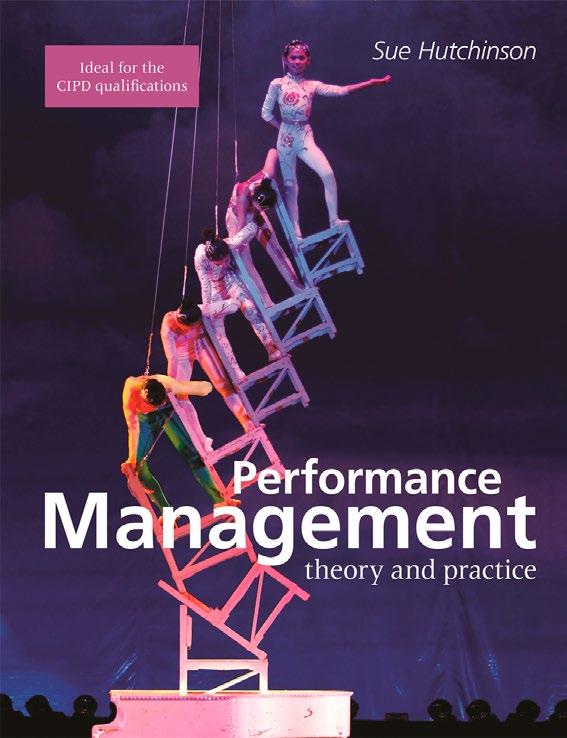
• Online resources: instructor’s manual, lecture slides, annotated web links for students
How do you systematically decide and communicate strategic performance aims, objectives, priorities and targets? How do you plan effective policies and practices? Which techniques, rewards and sanctions should you use to improve performance? How do you critically evaluate the effectiveness of performance management? Performance Management combines theory and practice to help students master these key concepts and apply their learning. Mapping to the CIPD Level 7 Advanced unit by the same name, the book is a core text for any student taking a performance management module at undergraduate or postgraduate level.
Featuring examples from a range of sectors and organizations across the globe, Performance Management is packed with pedagogical features such as learning outcomes, case studies, activities, reflection questions and further reading to fully engage students with the subject. Online supporting resources include an instructor's manual, lecture slides and annotated web links for students.
Sue Hutchinson is an associate professor in HRM at the University of the West of England, where she is also Associate Head of the HRM teaching and research group. She teaches on a range of HRM postgraduate modules including Performance Management, and is actively involved in research. Her main research interests focus on the link between people management and performance, the role of line managers in HRM and involvement and consultation. Previous work experiences include research and teaching at Bath University, policy advisor for the CIPD and industrial relations advisor in the paper industry.
Edition: 1
Date: 08/28/2013
Price: $69.99
Paperback: 9781843983057
Ebook: 9781843983286
Pages: 344
Format (mm): 240x190
Band: Textbook
Subject: Performance Management
1 Setting the Scene - HRM and Performance
2 Strategic Performance Management
3 Motivation at Work
4 The Role of Line Managers in Managing Performance
5 Defining and Measuring Individual Work Performance
6 Performance Appraisal and Feedback
7 Integrating Learning and Performance
8 Performance-Related Rewards
9 Managing Under-Performance
10 Absence Management
11 International Performance Management
12 Developing Performance Management
• Is part of the CIPD-endorsed HR Fundamentals series of succinct, practical guides for those in the early stages of HR
• Uses practical tools, assessments and more to demonstrate how to build a successful performance management strategy
• New to this edition: considers the major developments in the field and includes new case studies from companies such as Deloitte, who have dropped the formal appraisal process
• Online resources: downloadable templates and tools, including self-assessment questionnaires, to be used in practice
Effective performance management is at the heart of organizational success, delivering able and motivated employees who are aligned to an organization's values and goals. Using a combination of case studies, interviews, tools and diagnostic questionnaires, Performance Management is a complete and practical guide to getting the best out of people and achieving positive organizational outcomes through successful performance management.
It covers all areas of the subject, from objective-setting, giving feedback, measuring performance and managing underperformance and absence, to effectively integrating systems and processes into organizational and HR strategies.
This second edition of Performance Management contains new material on the ethical focus of the topic, promoting employee wellbeing through performance management, and the future of the annual appraisal, as well as new case studies and examples from Deloitte, Jumeirah Hotels, the CIPD and Hilton. Supporting online resources consist of additional activities and guidance for further research on the topic.

HR Fundamentals is a series of succinct, practical guides for students and those in the early stages of their HR careers. They are endorsed by the Chartered Institute of Personnel and Development (CIPD), the UK professional body for HR and people development, which has over 145,000 members worldwide.
Linda Ashdown is an Assessment Manager at the Chartered Institute of Personnel and Development (CIPD) and an HRM consultant through her own company Ashdown-Jones HR Ltd. She is also an Associate Lecturer at Portsmouth University Business School, specialising in performance management and employee engagement. She was previously on the board of a multinational advertising company as HR Director.
Edition: 2
Date: 09/28/2018
Price: $29.99
Paperback: 9780749483371
Ebook: 9780749483388
Pages: 224
Format (mm): 235x155
Band: Professional/ Academic
Subject: Performance Management
1 What is performance management?
2 Why is it important?
3 How does it fit with organization and HRM strategy?
4 How does it work?
5 How do you do it?
6 Planning and action
7 Measurement
8 Conclusion
This book
• Provides practical guidance on how to measure motivation, highlight areas for improvement, demonstrate which employee motivation programmes are working, and where costs can be reduced
• Helps transform talent management and succession planning by explaining what motivates an employee to want to progress in an organization
This book is a practical guide to ensuring that organizations consider all motivators - job security as well as the need for personal growth - to improve employee satisfaction, boost organizational productivity and reduce staff turnover.
Underpinned by original research, Motivation and Performance features case studies from finance, retail, the public and other sectors to show how the principles of motivating employees apply at all levels of the organization, not just at the leadership level, and how values and motivation can be changed and developed.
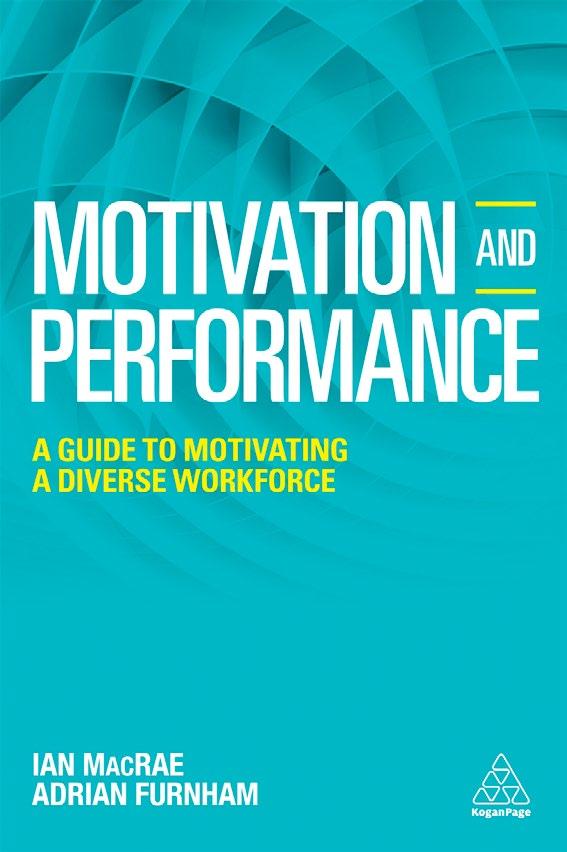
Complete with a framework for conducting effective visits to front-line locations, it will help HR professionals ask the right questions, choose whether to implement external motivation-building programmes and make a real impact on an employee's desire to progress in the company.
Author Information
Ian MacRae is Director of High Potential, an organizational consultancy providing customised psychological tests and reports for improving performance, predicting potential and developing people. He is a PhD candidate at Maastricht University.
Edition: 1
Date: 02/28/2017
Price: $34.99
Paperback: 9780749478131
Ebook: 9780749478148
Pages: 256
Format (mm): 235x157
Band: Professional/ Academic
Subject: Performance Management
Table of Contents
2 A Model of Motivation
3 Generational Differences
4 The Biology of Stress and Well-being
5 Measuring Motivation
6 The Power of Communication and Conversations
7 Intrinsic Motivation
8 Work Engagement, Organizational Health and Culture
9 Extrinsic Motivation and Rewards
10 Culture and Values
11 The Importance of Motivation Gaps
12 Outsourcing Motivation
13 The Dark Side and Derailed Motivation
14 Best and Worst Practice from Real Companies
• Covers all the key topics including reward strategies and structures, pay setting, benefits, bonuses, non-financial rewards, pensions and international reward management
• Now includes discussion of sustainability and equality, diversity and inclusion (EDI) and how these apply to reward management
• Full of pedagogical features such as learning objectives, self-assessment exercises, case studies, key learning points and explore further boxes
• New to this edition: Brand new content on deferred reward, executive reward, the impact of social transformation and the wider economy on reward as well as changes to reward post the Covid-19 pandemic
• Online resources: Lecturer manual and PowerPoint slides for every chapter
Covering theory and practice, Reward Management is an ideal textbook for postgraduate HR students, particularly those taking the CIPD Advanced level module in Strategic Reward Management

Now in its fifth edition, Reward Management covers everything postgraduate HR students need to know about the topic to excel in their studies and start their careers as people professionals. It covers reward management systems, frameworks and strategies through to pay setting, pensions, benefits and non-financial reward. There is also coverage of the legal and employment relations context of reward management as well as discussion of international reward management.
This new edition now includes brand new content on deferred reward, executive reward, the impact of social transformation and the wider economy on reward as well as changes to reward post the Covid-19 pandemic. The content has been fully updated throughout and now includes new discussion of sustainability and equality, diversity and inclusion and how they apply to reward management. This book is supported by examples, case studies and a range of pedagogical features such as learning objectives, self-test assessment exercises, key learning points and explore further boxes. Online resources include a lecturer manual and PowerPoint slides for every chapter.
Stephen J. Perkins is Emeritus Professor at London Metropolitan University and a Professional Research Fellow of the Global Policy Institute. He is the co-author of the annual CIPD reward management survey.
Sarah E. Jones is Head of Strategy and International Business at the University of Northampton. Prior to academia she worked as a HR manager in the aviation industry. She is a co-author of the CIPD's annual reward management survey and has presented research at international conferences.
Edition: 5
Date: 02/28/2024
Price: $59.99
Paperback: 9781398612891
Ebook: 9781398612907
Pages: 496
Format (mm): 246x189
Band: Textbook
Subject: Reward Management
1 Introducing the reward management system
2 Conceptual and theoretical frameworks
3 The legal, employment relations and market context
4 Base pay structures and relationships
5 Pay-setting, composition and progression
6 Variable pay schemes
7 Benefits
8 Pensions
9 Non-financial reward
10 Rewarding directors and executives
11 International reward management
12 Reward management within HRM
• Offers an extensive and comprehensive guide to understanding, developing and implementing effective reward systems
• Connects and supports the theory of reward management with the practical aspects, resulting in performing effective reward processes
• New to this edition: Reward implications of Covid-19; managing rewards through the cost-of-living crisis, new content on widening pay inequalities and the problem of low pay and poverty
• Online resources: lecture slides, glossary, bibliography, literature review, and a lecturer's manual and a student's manual
Armstrong's Handbook of Reward Management Practice is the essential guide to comprehending, developing and implementing effective reward strategies.
This updated seventh edition incorporates the latest research and developments within reward management, including the reward implications of Covid and the 'great resignation' and rewarding remote and hybrid workers. Revisions will also contain updates on reward structures, equal pay, employee benefits including wellbeing benefits, total rewards and smart rewards. This book covers all the crucial aspects of improving organizational, team and individual performance through reward processes, including financial and nonfinancial rewards, job evaluation, grade and pay structures, rewarding specific employee groups and ethical considerations
Armstrong's Handbook of Reward Management Practice bridges the gap between the academic and practitioner and is ideally suited to both HR professionals and those studying for HR qualifications, including master's degrees and the CIPD's intermediate and advanced level qualifications. Tips and checklists and can be found throughout, alongside case studies from organizations including General Motors, and the UK National Health Service. Online supporting resources include lecture slides and comprehensive handbooks for both lecturers and students, which include learning summaries, discussion questions, literature reviews and glossaries.
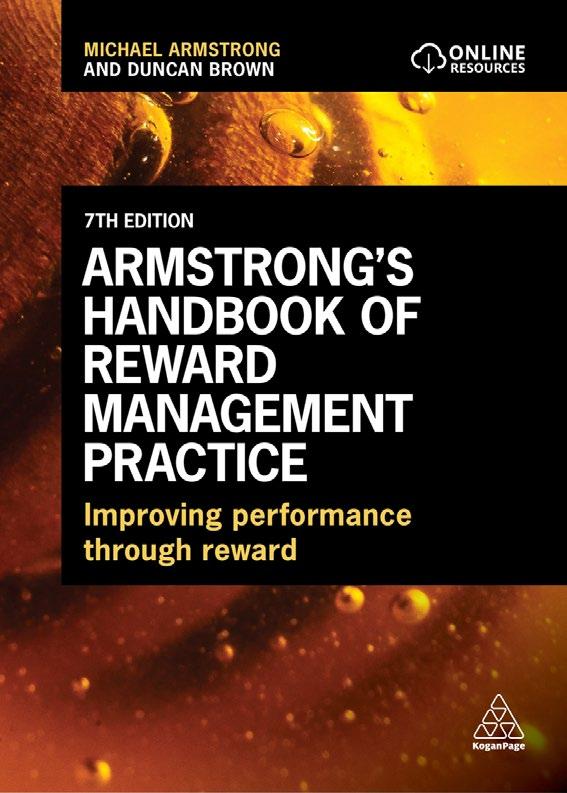
Michael Armstrong is the UK's bestselling author of HRM books including Armstrong's Handbook of Human Resource Management Practice. Based in London, UK, he is a former Chief Examiner of the Chartered Institute of Personnel and Development (CIPD).
Duncan Brown is Head of HR Consultancy at the Institute for Employment Studies. Based in London, UK, he has over 25 years' experience in consulting and reward. In 2021 he was named as one of the Most Influential HR Thinkers by HR Magazine
Edition: 7
Date: 11/28/2023
Price: $57.99
Paperback: 9781398611122
Ebook: 9781398611139
Pages: 392
Format (mm): 240x170
Band: Textbook/ Professional
Subject: Reward Management
Chapter - 00: Introduction
1 Fundamentals of reward management
1 Reward management – An overview
2 Strategic reward
3 Total reward
2 Aspects of reward management
4 Factors affecting reward
5 Financial rewards
6 Non-financial
10
11
12
3
13
14
15
17
19
5
23
24
25
6
7
28
29
30
31
32
• Uses practical tools and reflective questions to build knowledge and skills for implementing a successful reward management strategy
• Features examples and case studies, including from Which? and The Royal Horticultural Society to show how organizations can align reward strategy with wider objectives
• New to this edition: material and examples on approaching wellbeing within the benefits package and the latest application of technology; how to manage reward strategy with new ways of working
• Online resources: downloadable templates and tools to develop and implement reward management strategies
• Is part of the HR Fundamentals series of succinct, practical guides for those in the early stages of HR
How can I fairly reward and recognize employees and align this with team and organizational performance? Reward Management is a practical guide for understanding how to develop successful reward strategies.
It covers key areas including pay and grade structures, job evaluation, non-cash reward, pay reviews, bonus plans and tax issues. Featuring guidance, practical tools and case studies throughout, this book provides the knowledge and skills needed to plan, implement and assess an effective reward strategy in any type of organization.
This third edition of Reward Management includes the latest research and developments, such as how to incorporate wellbeing and new technologies in reward strategy and how new ways of working may affect a benefits package. Case studies include insight from McDonald's UK, Marks and Spencer and Which? to show how this can be applied in practice. Online resources include downloadable templates and further tools to be used in practice.

HR Fundamentals is a series of succinct, practical guides featuring exercises, examples and case studies. They are ideal for students and those in the early stages of their HR careers.
Michael Rose is an author, speaker and independent reward consultant based in London, UK. He was formerly the Vice-President of reward at the CIPD, and has held a number of senior reward management positions, such as the Director of Total Reward for Aon Corporation and Head of Reward Management for TSB Bank plc. A regular international conference speaker, he has also appeared on radio and TV commenting on reward issues and has written a number of books and articles on the topic.
Edition: 3
Date: 05/28/2022
Price: $27.99
Paperback: 9781398605299
Ebook: 9781398605305
Pages: 288
Format (mm): 235x160
Band: Professional/ Academic
Subject: Reward Management
Introduction
1 The fundamentals of reward management
1 Reward and reward strategy
2 Why reward is important and how it can make an impact
3 Relationship between motivation and reward
4 How reward fits together
5 How to get started with a reward strategy
6 Communications
7 Tax and National Insurance
2 Reward in practice
8 Grades and pay structures
9 Managing pay data and pay reviews
10 Bonus plans
11 Recognition and non-cash reward
12 Long-term plans
13 Benefits
14 Conclusions
15 Appendix
16 References
• Provides a complete resource for coaching and mentoring at individual, team and organizational levels
• Shows how to align coaching and mentoring to an organization's overall business strategy and measure its transformational impact
• Contains insights and case studies from the NHS and the CIPD's Steps Ahead mentoring programme
• New to this edition: a chapter on group and team coaching, material on systemic coaching and how to use coaching for diversity and inclusion, as well as updates to wider thinking and models
How can coaching and mentoring approaches be applied in individual, team and organizational contexts to increase performance? Coaching and Mentoring offers a complete resource for developing and implementing the latest theories and models in your organization.
Featuring tips, tools and checklists throughout, this book covers all the key aspects of the process, from delivering feedback that builds confidence and success and observant listening to evaluating the effectiveness of initiatives and coaching supervision. Guidance is also provided on how to support people in their learning, getting buy-in from stakeholders and creating a coaching culture. Drawing upon insights from a number of experienced coaching and mentoring professionals, it also features case studies from the NHS and the CIPD's Steps Ahead mentoring programme to show how these approaches have been applied in practice.
This fully revised fourth edition of Coaching and Mentoring contains a new chapter on group and team coaching and further material on systemic coaching and how to use coaching for diversity and inclusion. Featuring updates to case studies and wider research, coaches and mentors of all levels of experience and those studying coaching and mentoring will benefit from this definitive text.

Eric Parsloe was an experienced international executive coach-mentor, one of the founders of the European Mentoring and Coaching Council and founder of The OCM. He was also a member of the International Coaching Federation and the CIPD coaching and mentoring faculty.
Melville Leedham is an associate lecturer at The University of Northampton. Based in Northumberland, UK, he runs his own coach-mentoring business and also trains, supervises and assesses other coaches.
Diane Newell is the Managing Director of OCM Discovery at The OCM, based in Oxford, UK, offering consultancy and coaching to individuals and teams to support their strategic aims.
Edition: 4
Date: 03/28/2022
Price: $39.95
Paperback: 9781398601963
Ebook: 9781398601970
Pages: 312
Format (mm): 235x158
Band: Professional/ Academic
Subject: Coaching
1 Introduction to this edition of Coaching and Mentoring
1 The purpose, nature and practice of coaching and mentoring
2 Coaching – what the research says
3 Learning and adaptability
4 The core skills
5 The toolkit chapter
6 Awareness of individual differences
7 Supervision for coach or mentor
8 Stories of coaching and mentoring
2 How to effectively implement coaching and mentoring in organizations
9 Why invest in coaching and mentoring? What and where is the need?
10 Coaching and mentoring: what they are and how they are used in organizations
11 Implementing coaching and mentoring
12 Roles and responsibilities in coaching and mentoring
13 Supervision in practice
14 Coaching the team
15 Coaching and mentoring in the system and the impact of culture
16 What’s next?
17 References
18 Appendix: Professional governing bodies
• Provides a complete resource for best practice coaching from industry experts including Sir John Whitmore, Peter Hawkins and David Clutterbuck
• Covers all the fundamental areas of coaching, from making the personal and business cases for coaching, to using goal setting, questions and reflection and coaching evaluation and accreditation
• Explores a range of coaching models and techniques in both theory and practice, to allow readers to tailor their approach to specific situations
• New to this edition: new chapters including neuroscience coaching, systemic coaching, existential coaching, coaching contracts, reflection practice in coaching alongside updates to incorporate new research and models published since the last edition
How can you achieve coaching excellence? Use the latest research and insights from some of the biggest industry names in this fully revised fourth edition, which provides a diverse range of theory, tools and models for students and practicing coaches alike.
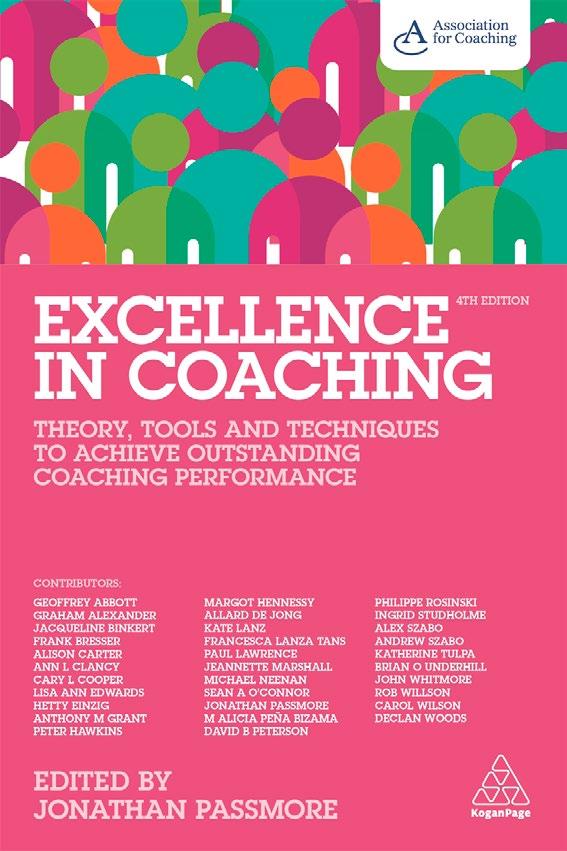
Excellence in Coaching is a comprehensive guide presenting the latest cutting-edge thinking in the field of workplace coaching. Published with the Association for Coaching, this book covers all key components of the coaching process, and examines a diverse range of coaching models including behavioural and transpersonal coaching, enabling coaches and trainers to adapt their approach and excel in their professional practice.
With updates to incorporate the latest thinking and insights, this revised fourth edition of Excellence in Coaching also contains a wealth of fresh material, including new chapters on establishing a coaching business, neuroscience coaching, psychodynamic coaching and understanding the coaching relationship. Featuring tips, checklists and tools, and a collection of best-practice material from some of the biggest names in the profession including Sir John Whitmore, Peter Hawkins and David Clutterbuck. This remains essential reading for practising coaches as well as for students.
Jonathan Passmore is the Director of The Henley Centre for Coaching at Henley Business School, University of Reading. He works with leaders from business, politics and the public sector to help them improve individual, team and organizational performance through coaching. He is also an award-winning researcher, a regular international conference speaker, and the author and editor of a number of publications and books, including Leadership Coaching and Mastery in Coaching, also published by Kogan Page.
Edition: 4
Date: 02/28/2021
Price: $39.95
Paperback: 9781789665475
Ebook: 9781789665482
Pages: 392
Format (mm): 234x158
Band: Professional/ Academic
Subject: Coaching
Introduction
1 The business of coaching
1 The development of coaching
2 What is coaching?
3 Coaching within organizations
4 Leveraging the coaching investment
5 Setting up and running your coaching practice
2 Coaching models and approaches
6 Coaching with the GROW model
7
11
3
12
13
14
15
16
17
18
19
20
21
• Is part of the CIPD-endorsed HR Fundamentals series of succinct, practical guides for those in the early stages of HR
• Uses practical tools, assessments and real life examples to build knowledge and skills in order to implement an efficient and effective coaching culture that empowers people and delivers business results
• New to this edition: demonstrates how a coaching culture should be closely aligned with broader business concerns, including bottom line results, productivity and agility in the VUCA (volatile, uncertain, complex, and ambiguous) environment. It shows how to link productivity and growth, how to adopt principles that naturally encourage coaching and engagement, how to develop autonomous teams, how to develop tools that foster flexibility, how to assess organisational readiness for change, and includes new international case studies

• Online resources: a suite of downloadable templates and tools for use in practice, including a diagnostic tool to check 'coaching culture health' and a corresponding report, development plan, monitoring templates, and training course assessment forms
Edition: 2
Date: 09/28/2018
Price: $29.99
Paperback: 9780749483272
Ebook: 9780749483289
Pages: 248
Format (mm): 235x157
Band: Professional/ Academic
Subject: Coaching
Introduction
1 Fundamentals
1 What is a coaching culture?
2 Is having a coaching culture important for your organization?
3 Aligning the coaching culture with organizational strategy: getting the right fit
2 In practice
4 Creating a coaching culture: the key components
5 Planning and developing the right strategy for your organization
6 Measurement tools for evaluating coaching
7 Conclusion
• Explains how to assess different employee needs and identify which experiences may impact these needs
• Shows coaches and line managers how to discuss race, gender, class, culture, education and socio-economic issues confidently with their employees
• Provides practical tips, tools, advice, examples and activities to work through in practice in the workplace
• Includes specific guidance on how to deal with employee trauma such as prejudice, racism, bullying, burn out, impostor syndrome and grief
• Shows how coaches can build an inclusive culture and encourage authenticity and acceptance in the workforce
SHORTLISTED: Business Book Awards 2023 - Diversity, Inclusion & Equality
Coaching and developing employees is not a one size fits all activity. Race, gender, class, education, culture and religion can all affect the needs of employees. Coaches, leaders and line managers must address this.
Diversity, Inclusion and Belonging in Coaching is a practical guide for coaches, leaders and line managers which explains how to understand different employee needs, identify what experiences can impact these needs and shows how to develop a truly inclusive approach to coaching and employee development. It also covers how to recognize the difference between employees in survival mode as opposed to those who are thriving, feeling psychologically safe and displaying healthy resilience.
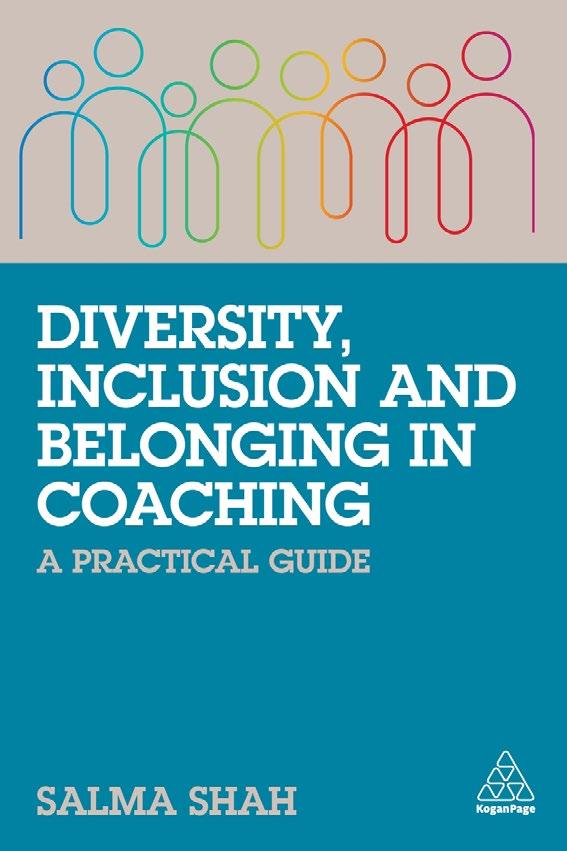
Packed full of practical tips, tools, case studies, interviews, examples and activities to work through in practice, this book allows coaches, leaders and line managers to create an inclusive culture of belonging and psychological safety to ensure that all employees flourish. There is also specific guidance on how to deal with employee trauma such as prejudice, racism, bullying, burnout, imposter syndrome and grief as well as how to cultivate a system of acceptance and encourage all employees to safely bring their authentic selves to work. Supported by expert advice, personal experience and industry research, this book is crucial reading for all coaches, leaders and managers responsible for talent development.
Salma Shah is the Founder and Director of the award-winning Mastering Your Power, a certified coach training programme designed with a wider systemic lens of diversity, inclusion, belonging and equity. Based in London, UK she works with clients at a senior level in public, private and voluntary sectors. She supervises and trains other coaches as well as presenting at events globally. She has worked with clients across a range of industries, including: Teenage Cancer Trust, Reuters O2 and British Transport Police. She has also delivered programs for major international organisations including: Oracle and Ernst and Young (Kuwait, Palestine).
Edition: 1
Date: 04/28/2022
Price: $41.99
Paperback: 9781398604506
Ebook: 9781398604544
Pages: 232
Format (mm): 235x157
Band: Professional
Subject: Coaching
• Shows how to use coaching tools and techniques to increase performance in leadership teams and the organization as a whole
• Features case studies from organizations from around the world and from a range of sectors, including Comair and the UK National Health Service (NHS) to show how these approaches have been applied in practice
• New to this edition: a new medley chapter of short case stories that address some of the regularly asked questions by new team coaches; a new chapter that explores ways of creating a teaming and team of teams culture; new material on the role of team coaching in mergers and developing the personal core capacities for systemic team coaching; a new case study describing team coaching in Toyota through a period of transformation
A high-performing and cohesive leadership team is essential for organizational success. Leadership Team Coaching in Practice provides an overview of the tools and techniques for coaching leadership teams and shows how these approaches have been applied around the world in a variety of team types and industries.

Featuring expert contributions from chief executives, team coaches, team leaders and consultants in organizations including Comair and the UK National Health Service (NHS), this practical guide illustrates best practice tailored to the needs of each organization. The new and updated third edition of Leadership Team Coaching in Practice incorporates the latest research and thinking in the field, including new material on developing the personal core capacities for systemic team coaching.
Alongside updates to case studies to offer a long-term view of interventions, the third edition contains new case studies including team coaching in Toyota through a period of transformation. There is a new medley chapter of short case stories that address some of the regularly asked questions by new team coaches and new material that explores ways of creating a teaming and 'team of teams' culture. This book remains an essential resource for executive and team coaches, CEOs, team leaders, organizational development consultants, and those studying coaching as part of a degree or coaching qualification.
Peter Hawkins is Professor of Leadership at Henley Business School, UK and a visiting professor at the University of Bath, UK and Oxford Brookes University, UK. Based in Bath, UK, he is the President of the Association of Professional Executive Coaching and Supervision (APECS) and the founder and emeritus chairman of Bath Consultancy Group and chairman of Renewal Associates. He has worked with many leading companies internationally, co-designing and facilitating major change projects and coaching boards and leadership teams. A regular keynote speaker at international conferences, he is also the author of several books including Leadership Team Coaching, also published by Kogan Page.
Edition: 3
Date: 02/28/2022
Price: $39.95
Paperback: 9781789666212
Ebook: 9781789666229
Pages: 472
Format (mm): 234x157
Band: Professional
Subject: Coaching
• Provides a complete resource for coaching leadership teams, as well as international, virtual, project and account teams and executive and non-executive boards
• Explores the key techniques and tools to be used at each stage of the coaching process, as well as guidance on common challenges and pitfalls to avoid
• Includes case studies from organizations including Deloitte and General Electric (GE) to illustrate how these approaches have been applied in practice
• New to this edition: discussion of agile teaming, using digital team coaching apps and AI, and training team leaders to coach their own team; new and refreshed case studies; updates to incorporate new developments and research
FINALIST: Goody Business Book Awards: Leadership: Team Building
Organizations are most effective when the teams responsible for their success work together collectively and in a dynamic relationship with the rest of the company. For those involved in developing leadership teams, understanding coaching practices and techniques is essential for enabling the best performance.
Leadership Team Coaching provides a comprehensive roadmap for team coaching, explaining all the key elements alongside practical tools and techniques for developing international and virtual teams, executive and non-executive boards and project and account teams in all types of organizations. Featuring case studies and insights from organizations including Deloitte and General Electric (GE), it also contains guidance on choosing the best team coach, creating a team-based culture and common pitfalls to avoid.
This fully updated fourth edition of Leadership Team Coaching contains new material on agile teaming, using digital team coaching apps and AI, and training team leaders to coach their own team. It remains an indispensable resource for coaches and senior leaders as well as for those studying coaching as part of a degree or coaching qualification.

Peter Hawkins is Professor of Leadership at Henley Business School, UK, and a visiting professor at the University of Bath, UK, and Oxford Brookes University, UK. The President of the Association of Professional Executive Coaching and Supervision (APECS) and the founder and emeritus chairman of Bath Consultancy Group and chairman of Renewal Associates, he has worked with many leading companies internationally, co-designing and facilitating major change projects and coaching boards and leadership teams. A regular keynote speaker at international conferences, he is also the author of several books including Leadership Team Coaching in Practice, also published by Kogan Page.
Edition: 4
Date: 06/28/2021
Price: $39.95
Paperback: 9781789667455
Ebook: 9781789667462
Pages: 488
Format (mm): 234x157
Band: Professional
Subject: Coaching
1 High-performing teams
1 Why the world needs more highperforming leadership teams
2 The high-performing team and the transformational leadership team
3 The five disciplines of successful team practice
2 Team coaching
4 What is team coaching?
5 The team coaching process and journey
6 Coaching the five disciplines – Systemic team coaching
3 Coaching different types of teams
7 Many types of teams
8 Coaching the board
4 The next frontier for systemic team coaching – Beyond the high-performing team
9 Disrupting and renewing team coaching
10 New dimensions for eco-systemic team coaching
5 Creating shared leadership, selecting, developing and coaching your own team
– Advice to chief executives and other team leaders
11 Selecting the players for a high-performing team
12 Key steps for CEOs in creating a highperforming team with shared leadership
13 How to find, select and work with a good team coach
14 Developing as a team coach
15 Supervising team coaching
16 Team coaching methods, tools and techniques
17 Conclusion
• New to this edition: a new chapter on the role of an L&D practitioner, critical examination of apprenticeships and greater international coverage and case studies
• Includes a 'what next' section in every chapter to extend learning in the subject area
• Provides additional questions in every chapter which can be used by individuals to reflect on their learning or for further discussion with a group
• Online resources: instructor's manual, lecture slides, annotated web links and self-test questions.
• Is a core CIPD Level 3 textbook mapped to the CIPD qualifications and CIPD Profession Map 2.0
Learning and Development Practice in the Workplace is the ideal textbook for anyone studying CIPD L&D qualifications and apprenticeships at Level 3 or Level 5, as well as for practitioners new to an L&D role.
This book covers what is required of an L&D professional and how to meet and exceed these expectations, how to align L&D activity with organisational strategy and, crucially, how to identify learning needs and design effective L&D practice.
This new edition of Learning and Development Practice in the Workplace has been fully updated, reflecting the new CIPD Profession Map, and now has dedicated chapters on the different approaches to learning delivery, including face-to-face training and facilitation, technology-based learning, coaching, mentoring and social and collaborative learning. There is also expert guidance on learner engagement including insights from neuroscience and psychology, as well as advice on evaluating the impact of L&D. With case studies, activities and examples throughout, this new edition is an indispensable guide for students and new practitioners alike. Online supporting resources include lecture slides, annotated web links and self-test questions.
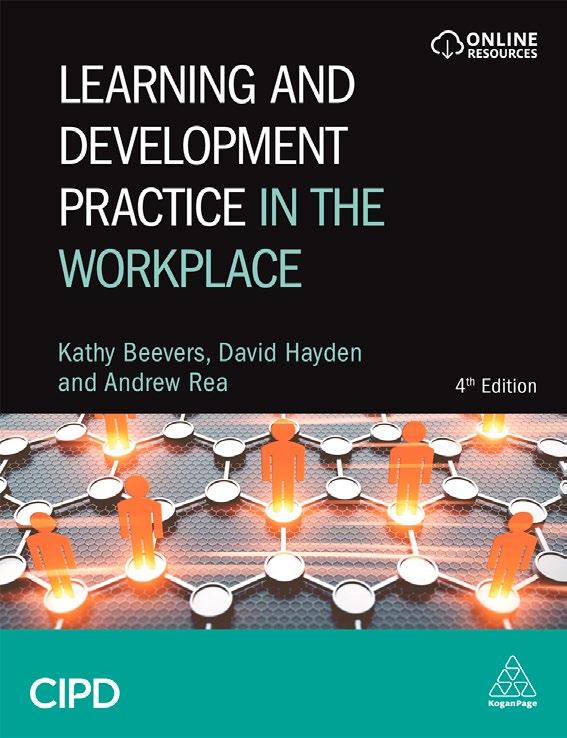
Kathy Beevers, Chartered FCIPD, is a qualified trainer, coach and author. She runs a learning and qualifications consultancy, Lightbulb Learning Ltd, and is also the Chief External Quality Advisor (CEQA) for CIPD.
Andrew Rea, Affiliate MCIPD, is a trainer, coach and facilitator with a background in management. He works with a range of organisations, creating and facilitating L&D initiatives, and has contributed to several L&D textbooks.
David Hayden, Chartered FCIPD, is the L&D Digital Learning Portfolio Manager at the Chartered Institute of Personnel and Development (CIPD). He has been working with CIPD qualifications since 2007.
Edition: 4
Date: 11/28/2019
Price: $69.99
Paperback: 9780749498412
Ebook: 9780749498429
Pages: 352
Format (mm): 246x188
Band: Textbook
Subject: Learning & Development
How to use this book
1 The L&D professional
2 The organisational context
3 Identifying learning and development needs
4 Designing learning and development activities
5 Delivery - Face-to-face training and facilitation
6 Delivery - Using technology
7 Delivery - Coaching and mentoring
8 Delivery - Social and collaborative learning
9 Engaging learners
10 Evaluating impact
• Is written and edited by experts with a wealth of experience in teaching, writing and examining in the field of Learning and Development

• Has an easy to navigate structure that takes students step-by-step through developing the knowledge and skills required for professional practice, the context of learning and development and fully utilising data in order to build a business case for its value within an organisation
• Online resources: multiple-choice questions for self-assessment, web links, extra case studies and a glossary of key terms, as well as lecturer slides, guides and test banks
Studying Learning and Development is the essential textbook for anyone studying the field in order to further their professional development, and HR practitioners wishing to extend their understanding of its background and practical application. With a clear layout that is easy to navigate, it takes you step by step through developing the knowledge and skills required for professional practice, understanding the broader context of learning and development - including the influential factors on achieving strategic objectives and developing policies that suit your organisational needs - and fully utilising learning and development data in order to build a business case for its value within your organisation.
Written and edited by experts in the field with a wealth of experience in teaching, writing and examining, Studying Learning and Development is the first and only text to map the unit learning outcomes of the three core modules for the CIPD Level 5 Intermediate level qualification. Its broad coverage means that it is also ideal for any students studying Learning and Development as part of a wider HR or business degree and wanting to gain a deeper appreciation for the knowledge, skills and planning required for the success of its policies and activities in practice. The additional resources available online, including multiple choice questions for self-assessment, web links to further resources, extra case studies and a glossary of key terms, as well as lecturer slides, guides and text banks, will enhance learning of the text and ensure thorough grounding in the theory. There are also six ebooks available to support the CIPD Level 5 Studying Learning and Development optional modules.
Jim Stewart is Professor of HRD at Liverpool Business School, UK. He is also Chief Examiner of Learning and Development for the CIPD as well as Visiting Panel Chair and External Moderator.
Patricia Rogers is part of the Postgraduate Taught Strategy and Development Group responsible for the development of postgraduate taught strategies across Coventry University, UK.
Edition: 1
Date: 01/28/2017
Price: $69.99
Paperback: 9781843984146
Ebook: 9781843984603
Pages: 256
Format (mm): 150x190
Band: Textbook
Subject: Learning & Development
• Mixes theory, case application and exercises to provide a comprehensive exploration of the topic
• Includes a range of case studies from different countries to illustrate how key ideas and theories are operating in practice around the globe, and are accompanied by questions or activities for students
• Online resources: instructor's manual, lecture slides and web links
As the global economy has changed and thus organizations with it, more learning is delivered at and through work and individuals are encouraged to utilise the opportunities that advances in technology have brought to take charge of their own learning. Essential reading for the CIPD Level 7 Advanced postgraduate unit Designing, Delivering and Evaluating Learning and Development Provision, Designing, Delivering and Evaluating L&D critically examines the contextual factors impacting upon these activities in organizations. With case studies from the public, private and voluntary sectors as well as examples of international practice, the book helps to identify some of the challenges L&D professionals face in a range of environments.
Designing, Delivering and Evaluating L&D is suitable not just for students working towards a CIPD Level 7 qualification, but also for those studying more general business and management degrees, as well as anyone who may have studied the subject previously and wishes to engage in continuous professional development with regard to this key HR practice. Online supporting resources include an instructor's manual, lecture slides and web links.
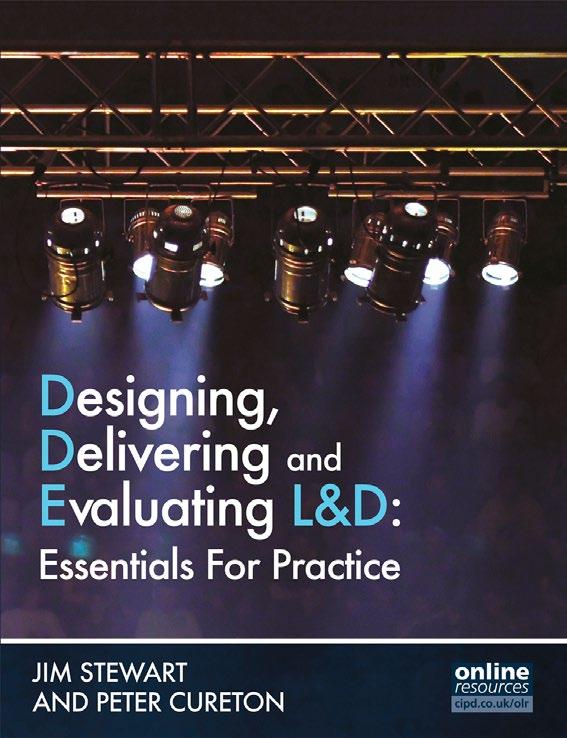
Peter Cureton is a former associate examiner for designing and delivering training with the CIPD.
Jim Stewart is Professor of HRD at Liverpool Business School, UK. He is also Chief Examiner of Learning and Development for the CIPD as well as Visiting Panel Chair and External Moderator.
Edition: 1
Date: 05/28/2014
Price: $69.99
Paperback: 9781843983606
Ebook: 9781843983699
Pages: 224
Format (mm): 246x190
Band: Textbook
Subject: Learning & Development
1 Designing, Delivering and Evaluating Learning and Development (Peter Cureton and Jim Stewart)
2 Individual and Collective Learning (Clair Doloriert, Jim Stewart and Sally Sambrook)
3 The External and Internal Context (Amanda Lee, Sophie Mills and Dalbir Sidhu)
4 Establishing Learning Needs (Tricia Harrison and Randhir Auluck)
5 Chapter - 05: Interventions (Crystal Zhang and Niki Kyriakidou)
6 Delivering and Facilitating Learning (Michelle McLardy and Nigel O’Sullivan)
7 Evaluating Learning and Development (Marian O’Sullivan and Michael McFadden)
8 Acting Professionally and Ethically (Peter Cureton and Maureen Royce)
9 Themes and the Future of DDE (Jim Stewart and Peter Cureton)
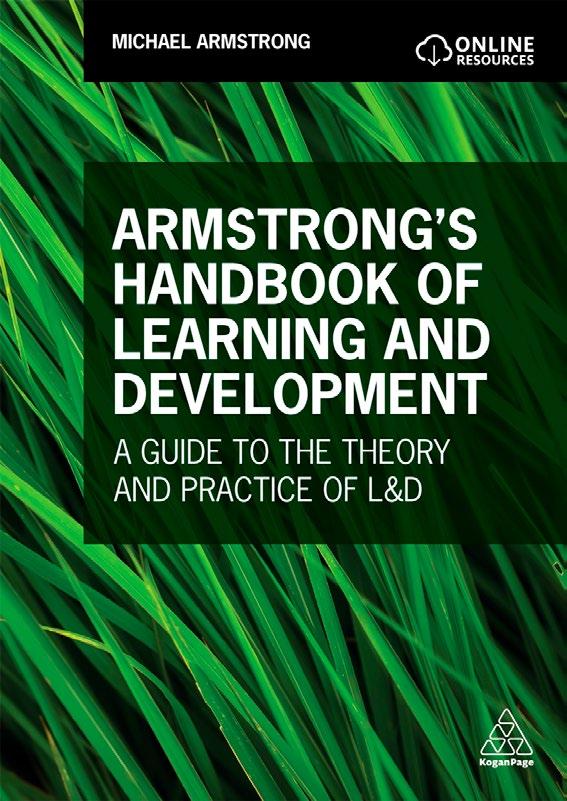
• Covers blended, social, experiential and digital learning as well as learning analytics and how AI, augmented and virtual reality can be used to support learning
• Outlines the role and responsibilities of an L&D professional and the essential skills needed to succeed
• Examines the latest development in the area including micro learning, connected learning, personalised learning and learning experiences
• Online resources: Lecture slides, Lecturer manual, student manual
• Provides a thorough grounding in the theory of L&D including the components of L&D, the distinction between L&D and training and discussion of how people learn
• Features case studies and examples to put the theory in context, reflective questions to consolidate learning and further reading suggestions to encourage broad engagement with the topic
Edition: 1
Date: 11/28/2021
Price: $59.95
Paperback: 9781398601888
Ebook: 9781398601895
Pages: 344
Format (mm): 240x170
Band: Textbook
Subject: Learning & Development
Introduction
1 Fundamentals of learning and development
1 The basis of learning and development
2 The context of learning and development
3 Learning culture
4 Organizational learning and the learning organization
5 Individual learning
6 Learning and development strategy
7 The contribution of learning and development to organizational performance
8 Learning analytics
2 The responsibility for learning and development
9 The role of the learning and development function
10 The role of the line manager
3 The process of learning
11 The nature of learning
12 Approaches to learning and development
13 Learning and development techniques
4 Areas of learning
14 Workplace learning
15 Social learning
16 Digital learning
17 Training
5 Planning and delivering learning events
18 Identifying learning needs
19 Planning learning events
20 Managing learning events
21 Transferring learning
22 Evaluating learning events
6 Aspects of learning and development
23 Leadership and management development
24 Sales training
25 Apprenticeships
7 Conclusion
26 Learning and development trends and issues
• Examines the importance of continuing professional development (CPD) and the methods that can be used to create and implement a CPD plan

• New to this edition: increased coverage of the critical debate about issues in CPD, an outline of how to organize and encourage CPD and guidance on how senior members of the profession can benefit from CPD
• Online resources: instructor’s manual and lecture slides
To maximise enjoyment of work and life requires a continual response to the changing world in which we live. Are you living to work or working to live? What would you like to be doing? We need to look within at our latent skills and abilities and explore ways of building on our current talents and developing new aspects of ourselves. Continuing Professional Development explores the importance of continuing professional development (CPD) and the different methods that can be used to analyse development needs and create and implement a CPD plan. It provides practical guidance and a theoretical overview of CPD, including examples and case studies.
This fully updated 2nd edition of Continuing Professional Development includes increased coverage of the critical debate about issues in CPD, outlines how to organize and encourage CPD and provides guidance on how senior members of the profession can use and benefit from CPD. Activities and self-diagnostic tools, critical debates about issues and coverage of how to organize and encourage CPD all bring the topic to life for CIPD students undertaking the Professional Development Scheme as well as general readers seeking to encourage CPD in the workplace. Online supporting resources include an instructor's manual and lecture slides.
David Megginson is a professor of HRD at Sheffield Hallam University, UK. He is on both the membership and education committees of the CIPD and the CPD Working Group.
Vivien Whitaker is a lecturer, researcher and consultant at Sheffield Hallam University, UK.
Edition: 2
Date: 01/28/2007
Price: $52.99
Paperback: 9781843981664
Ebook: 9780749482503
Pages: 176
Format (mm): 234x155
Band: Textbook
Subject: Learning & Development
1 Exploring Continuing Professional Development
1 Clarifying Continuing Professional Development
2 Understanding Continuing Professional Development
2 Engaging in Continuing Professional Development
3 Identifying Development Needs
4 Prioritising Needs and Selecting Appropriate Activities
5 Undertaking Development Activities
6 Recording and Evaluating Development
7 Organisational Contribution to CPD
3 Consolidating Your CPD Achievements
8 Celebrating Success
9 Networking Your Future
10 Empowering Career Creativity
• Provides up-to-date thinking on the issues and opportunities facing learning and development (L&D), including the role of L&D in talent attraction and retention
• Includes case studies and reflective questions alongside the knowledge and understanding required for the Chartered Institute of Personnel and Development (CIPD)'s intermediate level courses in learning and development
• Arms the professional with the evidence for L&D's transformational impact, showing how to link L&D to individual performance and organizational success
Learning for Organizational Development presents how to design, deliver and evaluate effective learning and development (L&D) programmes. This definitive guide to L&D's function in enhancing individual performance and organizational success is a core text for those studying for L&D qualifications such as the Chartered Institute of Personnel and Development (CIPD) Intermediate level as well as a useful handbook for L&D professionals looking to further their understanding of the latest developments.
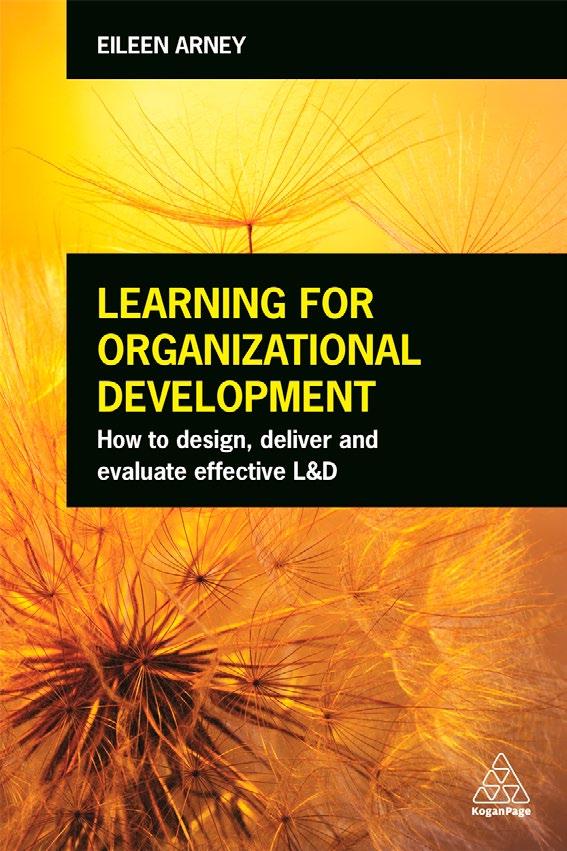
Complete with case studies and reflective questions to aid comprehension, Learning for Organizational Development considers the strategic business function of L&D for communicating the vital contribution that it makes to both individual performance and organizational success. It explores the role of L&D in talent development, showing how to support line managers in developing their people to drive retention and attraction. It also addresses the importance of developing the leadership capability within the organization, and provides practical guidance and examples of what works.
Eileen Arney is Teaching Director of Masters Programmes at The Open University Business School, UK. She is a Chartered Fellow of CIPD, has taught on level 7 CIPD programmes and has trained and practised as an executive coach. She has held senior civil servant posts including Assistant Director of National Police Training and has designed and delivered leadership programmes for senior managers in the UK and overseas.
Edition: 1
Date: 03/28/2017
Price: $51.99
Paperback: 9780749477448
Ebook: 9780749477455
Pages: 288
Format (mm): 235x155
Band: Textbook/ Professional
Subject: Learning & Development
1 Understanding Organizational Development
2 The Role of Learning and Development in Talent Management
3 Developing Leadership and Management Capability
4 Using Facilitation Skills
5 Implementing Coaching and Mentoring
6 Evaluating Learning and Development in a Knowledge Economy
• Features practical tools and assessments to build knowledge and skills to implement a successful L&D strategy
• Includes real-life examples such as WhatsApp to show how strategies and technologies are applied in practice
• New to this edition: chapter on the design of learning interventions; material on the impact of virtual learning, recent technological developments and accessibility in learning; case studies on learning through change and communities of practice

• Online resources: video clips from L&D specialists, an annotated bibliography, extended case studies and self-evaluation materials
• Is part of the HR Fundamentals series of succinct, practical guides for those in the early stages of HR
How can learning initiatives contribute to employee and organizational success? This is a practical introduction to the principles of designing and delivering effective training and L&D programmes.
Providing diagnostic tools, scenarios and case studies, Learning and Development demonstrates how to link learning to strategic business goals and explores both the benefits and complexities associated with L&D. This updated third edition features a new chapter on designing learning interventions, covering technology-led development and the impact of virtual learning. There is also guidance on making learning and development strategies accessible and inclusive for all employees, and information on metrics that can be used for measuring effectiveness.
Learning and Development features guidance in essential areas including identifying L&D needs, selecting the most appropriate types of intervention and the processes of measurement and evaluation. Online resources include extended case studies, an annotated literature review and self-evaluation tools.
HR Fundamentals is a series of succinct, practical guides featuring exercises, examples and case studies. They are ideal for students and those in the early stages of their HR careers.
Rebecca Page-Tickell is Director of MBA programmes and Director of Education and Experience at the Royal Docks School of Business and Law, University of East London, UK. A Principal Practitioner with the Association for Business Psychology, she has a particular expertise in self-managed learning and providing coaching to senior managers and directors. She previously held a number of senior L&D and HR management positions across a variety of industries and in multinational corporations.
Edition: 3
Date: 05/28/2022
Price: $27.99
Paperback: 9781398605800
Ebook: 9781398605831
Pages: 280
Format (mm): 235x155
Band: Professional/ Academic
Subject: Learning & Development
1 Fundamentals of learning and development
1 Defining learning and development
2 The importance of learning and development
3 Learning and development, organization and human resource management (HRM) strategy
4 How learning and development works
2 In practice
5 How do you do it?
6 Design of learning and development interventions
7 Planning and action
8 Measurement
9 Conclusion
• Provides guidance for learning and development (L&D) professionals on how to apply insights from neuroscience, human behaviour and AI to learning design including tips on how to engage staff in training
• Shows how to develop user-led training initiatives to optimize development and retention
• Outlines how simulations can be used to replicate a real-world challenge as closely as possible and how to integrate programmes into employees' existing workflow
• Includes case studies from global organizations including BP and the BBC
• New to this edition: learning in a hybrid world; changes in education that enable building better systems; practical guidance on user-centred design and building programmes that work
How can I design training so that it makes a real difference to employees' skills and development? This book gives L&D professionals everything they need to build effective learning experiences.
How People Learn provides L&D professionals a new way of thinking about learning by exploring what happens when we learn. It shows how to apply insights from neuroscience, human behaviour and artificial intelligence (AI) to learning design including tips on how to interest, excite and engage staff in training. Using the author's '5Di model', this book demonstrates how to define, design and deploy training into existing workflows so it works both for and with employees. It also explores how simulations can be used to replicate a real-world challenge as closely as possible.
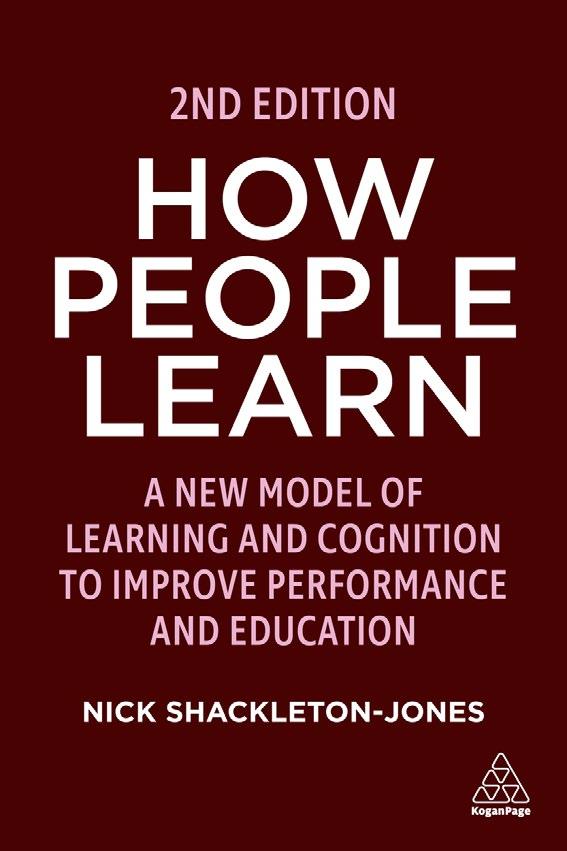
The second edition features new material on learning in a hybrid world, and how to manage skills development and performance now that work, workplaces and workers have changed. It includes more practical guidance on building programmes with usercentred design and covers developments in the connection between learning and cognition, alongside case studies and examples from companies such as BP and the BBC.
Nick Shackleton-Jones is HR Director, Talent & Learning at Deloitte, UK. His work focuses on building a better experience for employees and improving organizational performance. He was previously the Director of Learning and Performance Innovation at PA Consulting Group and Director of Learning Innovation and Technology at BP. He has also held senior roles in L&D at Siemens Communications and the BBC. Based in Reading, UK.
Edition: 2
Date: 01/28/2023
Price: $41.99
Paperback: 9781398607194
Ebook: 9781398607200
Pages: 312
Format (mm): 230x155
Band: Professional
Subject: Learning & Development
Preface
1 Cognition
2 Learning
3 Education
4 Language and learning
5 Learning design
6 Learning elimination (performance consulting)
7 Defining experience
8 Human-centred learning design
9 Bringing about change
10 Ethics and AI in learning
11 How to change someone’s mind
12 The future
• Explains how to use emotion, attention, memory, engagement, enjoyment, transfer, practice and retention to create effective learning content and interactions
• Shows how to make evidence-based decisions when creating learning and development (L&D) content and initiatives to ensure that the learning makes a tangible difference to employees
• Includes practical examples and expert advice on how to design each aspect of learning content including audio, visual, text, graphics, simulations and both virtual and augmented reality
• Provides coverage of user experience (UX), design thinking and blended learning which can be applied to face-to-face, remote and digital learning
• Contains a jargon-busting glossary to demystify learning experience terms and acronyms
How can I create in-person learning that engages people? How can I build digital learning that is effective? How can I develop learning content that can be used remotely and ensure that the learning sticks? Learning Experience Design has the answers to all these questions and more.
This book is a practical guide for all learning and development (L&D) professionals. It covers everything from what learning experience design (LXD) is, the role of the L&D professional in LXD, and what the main areas to consider when designing learning are including emotion, attention, memory, engagement, enjoyment, transfer, practice and learning retention. It includes practical advice for all areas of learning design including text, graphics, audio, visual, simulations, AR/VR, question and social design. There is also essential guidance on instructional design, UX (user experience) design and how to design effective learning analytics.
The final part of the book covers design thinking, blended learning and discussion of LMSs (learning management systems), LXPs (learning experience platforms) and LRSs (learning record stores). With examples, tips, case studies and advice throughout, this is an invaluable book for anyone wanting to make an impact with their learning design and ensure knowledge, skills and performance improvement.
Donald Clark has over 30 years' experience in online learning, simulations, virtual reality, mobile and artificial intelligence projects. He was a founding member of Epic Group plc and the Founder and CEO of Wildfire Learning. He is a frequent global speaker, blogger, advisor and researcher and is also a Visiting Professor at the University of Derby.
Edition: 1
Date: 11/28/2021
Price: $39.95
Paperback: 9781398602625
Ebook: 9781398602632
Pages: 320
Format (mm): 234x157
Band: Professional
Subject: Learning & Development
1 Learning experience design
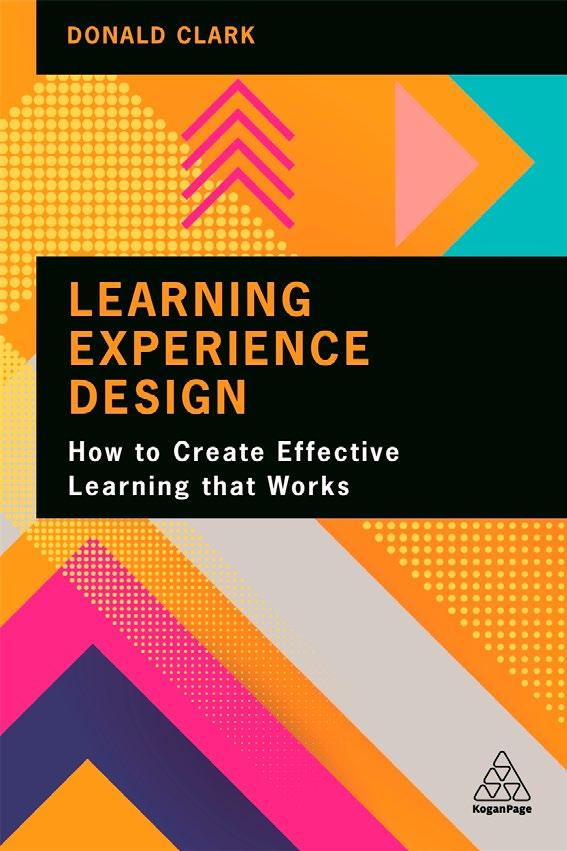
2 Learning experience designers
3 Emotion, attention and motivation
4 Interface design
5 Chapter - 05: Text and graphics
6 Audio for learning
7 Video and animation
8 Engagement, questions and feedback
9 Scenarios and simulations
10 VR and AR
11 Games and gamification
12 Social learning
13 Transfer and practice
14 Workflow, curation and data
Innovation and Best Practice in:

Introductory Logistics & Supply Chain




Logistics
Global Logistics




Humanitarian Logistics & Supply Chain

Maritime Logistics









Retail Logistics & Supply Chain
Manufacturing & Production
Operations Management

Procurement










Supply Chain Management







Supply Chain Analytics






















































Supply Chain Finance

























Sustainability

Transport
Warehouse Management


• Unique breadth and depth of coverage of supply chain strategy and logistics/ distribution including step-by-step strategic accounts of setting up and operating supply chains for maximum value and the tactical elements of logistics and distribution
• Worked examples using current real-world data (flow charts, tables, maps, equations) from the authors' first-hand experience bring the concepts to life
• Figures and flow charts show how the elements of supply chains are interdependent, and a dedicated chapter on supply chain integration brings them together
• New to this edition: the latest innovations in logistics and supply chain management including artificial intelligence, cyber-security, 5G mobile networks, drones and cobots
• Online Resources: Lecture slides (featuring tables, images and formulae from the text), infographic, acronyms and abbreviations and useful formulae
Edition: 7
Date: 01/28/2022
Price: $80.00
Paperback: 9781398602045
Ebook: 9781398602052
Pages: 824
Format (mm): 240x171
Band: Textbook
Subject: Intro Logistics & Supply Chain

• Establish a holistic view of the many complex, real-life scenarios that supply chain managers face, in the context of a real company situation
• Gain a better understanding of the challenges of supply chain management and develop effective problem solving skills
• Discover how to deliver optimal performance by integrating the business, technical and leadership dimensions of supply chain management
• Learn how to tear down silos and create the right cross-functional mindset
• Online resources: free access to the online business simulation game The Fresh Connection, supporting templates, frameworks and PowerPoints
Mastering the Supply Chain is an introduction to supply chain management. The book integrates theory with practice and aims to create a cross-functional mindset in students and practitioners.
It provides a wide overview of relevant supply chain concepts and sets out the challenges that need to be overcome in order to find practical ways of implementing these in a real company situation. Readers are continuously asked to actively reflect on the choices they make, thus experiencing first-hand the many challenges that good and effective supply chain management presents.
Mastering the Supply Chain presents a different way of learning that puts the reader at the heart of a life-like situation, so that they experience the impact of every decision they make, not just in their own 'silo' but across the business. In this way, they will learn that many supply chain concepts are relatively simple to understand, but not so easy to apply in reality. Chapter 6 helps students to pull everything they've learned together and see how the concepts play out in the real world by guiding them through an interactive demonstration of the online business simulation game The Fresh Connection (free access is included with the book). This is a key text for students on supply chain management BScs and MScs as well as background reading for students playing the full version of The Fresh Connection Business Simulation game.
A freelance trainer and consultant, Ed Weenk is also a senior lecturer in Supply Chain at Maastricht School of Management, EADA Business School in Barcelona and the Antwerp Management School.
Edition: 1
Date: 03/28/2019
Price: $51.99
Paperback: 9780749484484
Ebook: 9780749484491
Pages: 296
Format (mm): 240x170
Band: Textbook
Subject: Intro Logistics & Supply Chain
Preface
1 Supply chain – General introduction
2 Introduction to the business dimension of supply chain management
3 Introduction to the technical dimension of supply chain management
4 Introduction to the leadership dimension of supply chain management
5 Scenarios in a fresh food company
6 Knowledge in action, with a supply chain simulation
7 Mastering the technical dimension of supply chain
8 Mastering the leadership dimension of supply chain
9 Supply chain in a VUCA world
10 Imagining business challenges for the supply chain
11 Imagining technical challenges for the supply chain
12 Imagining leadership challenges for the supply chain
13 Epilogue
14 References
The ultimate value chain experience
The Fresh Connection allows you to achieve a perfect balance between methodology and a practical approach. This cross-functional business simulation game engages participants in turning around a manufacturer of fruit juices. In teams of 4, participants will represent the functional roles of VP Purchasing, VP Operations, VP Supply Chain, and VP Sales.
Accredited by professionals and educators from all over the world, it will motivate your students to deliver optimal performance. It pushes students to develop critical skills when dealing with supply chain best practices from theory and real life. Experience how this new tool creates high energy levels and keep your students engaged.
The Fresh Connection is now available with Textbook!
Integrates theory with practice and aims to create a cross-functional mindset in students and practitioners.
Easy to implement into your curriculum
Ingeniously incorporates knowledge and practice of the fundamentals. The diagrams are especially descriptive, and the combination of theory with experiential learning is a game-changer in the quest to educate students and professionals how to manage supply chains in an ever-changing world.
Quickly switch between a classic, online, or hybrid classroom se ing
An out-of-the-box solution
What’s included in our Integrated Learning Approach?
Mastering the Supply Chain Textbook

Business simulation game
Mastering the Supply Chain provides an invaluable guide for understanding how decisions are made when managing the supply chain strategically. The emphasis of the book is on practical learning and hence the book is wri en around 'The Fresh Connection' supply chain game. Having used this game in my courses over several years, this book would be an excellent companion. The book will provide value for UG, PG and MBA courses with a focus on supply chain management.
Educator Course Materials
Exercises, videos & more
Our integrated Learning Approach allows for complete flexibility. When designing your course, you can easily tailor it to meet specific wishes!
Easy and fast to implement! Everything needed to start your course today is included. Our Teaching Approach takes away the stress of planning & designing your course.
Flip the switch and change how you teach your students. You control whether it is in a physical classroom, fully online, or a hybrid setting.
We provide 24/7 support and expert guidance to guarantee successful implementation.
 – Laura M Meade, Director of International Programs, Professor of Supply Chain Practice, Neeley School of Business, Texas Christian University, Forth Worth
– Professor Samir Dani, Professor of Logistics and Supply Chain Management, Head of Logistics, Marketing, Hospitality and Analytics, University of Huddersfield, UK
– Laura M Meade, Director of International Programs, Professor of Supply Chain Practice, Neeley School of Business, Texas Christian University, Forth Worth
– Professor Samir Dani, Professor of Logistics and Supply Chain Management, Head of Logistics, Marketing, Hospitality and Analytics, University of Huddersfield, UK
Game setup in a nutshell entails participants playing the web-based business game in teams of 4 people; either virtually or in classroom setting. Eeach of the team members take up one of the four VP roles available in the business simulation game. The teams are challenged to manage a virtual company and consider corporate strategy and business objectives. Our business simulation games provide the ultimate learning experience using best practices from theory
The team will experience the impact of every decision they make, not just in their own functional ‘silo’ but across their business!
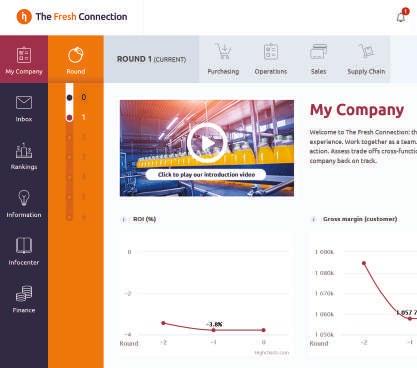
Creating the curriculum with the teaching materials was easily done. I had very limited time and was able to set up an entire semester in one evening.
– Professor Dr.Ing. Gaby Neumann Professor in Engineering Logistics Technische Hochschule Wildau
The only time I have trouble ge ing my students out of the classroom is when we’re playing The Fresh Connection.
– Dr. Roberto Perez–Franco Director, MIT Supply Chain Strategy Lab Massachusetts Institute of Technology (MIT)
Ask your Kogan Page sales representative for more information: kpinfo@koganpage.com Developed by:
• Presents a step-by-step guide to all aspects of logistics, from the warehouse to delivery, giving students and early-career practitioners a complete overview of all the logistics processes
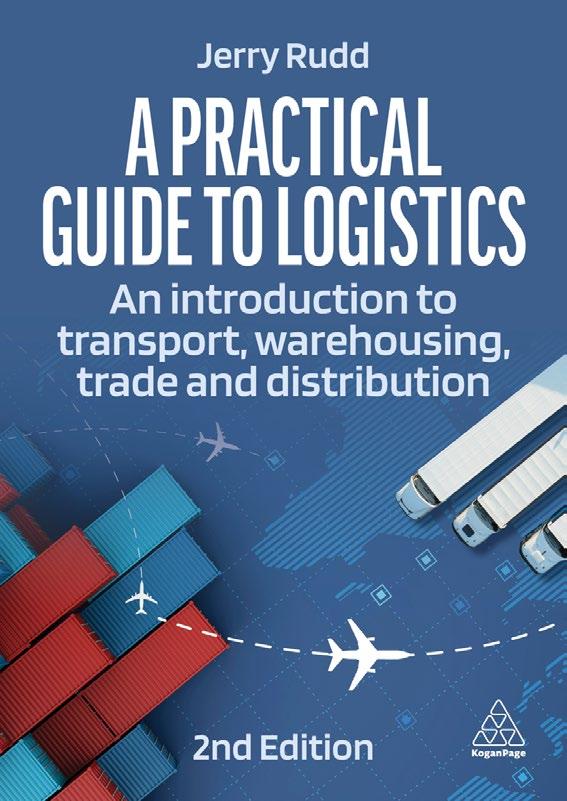
• Provides practical, accessible, up-to-date information, covering best practices to drive business growth
• Equips readers with the necessary knowledge to progress in their careers in logistics management
• New to this edition: new chapter on Health and Safety in logistics; coverage of the most recent developments including automation and electric vehicles
• Online resources: Lecture slides and bonus figures
Few enter the logistics management industry with experience in all aspects of the profession. This book provides clear, workable explanations and guidance on the fundamentals to achieve success.
A Practical Guide to Logistics is a straightforward guide taking readers through all aspects of the industry, covering packaging, transportation, warehousing and exporting and importing of goods. This fully updated second edition features a new chapter on Health and Safety in the field, and coverage of the most recent developments impacting logistics, including automation and electric vehicles.
It equips readers with the necessary knowledge to progress in their careers and provides balanced advice on how to choose the right option for their business. A Practical Guide to Logistics is an essential introduction for practitioners, undergraduate and postgraduate students of logistics. Online resources include lecturer slides and additional figures and formulae.
Jerry Rudd is a logistics and supply chain professional with over 25 years' experience. He has worked with companies such as Ford, Peugeot, the Bank of England and Wincanton. He is based in London, UK.
Edition: 2
Date: 12/28/2023
Price: $41.99
Paperback: 9781398612648
Ebook: 9781398612686
Pages: 424
Format (mm): 240x170
Band: Textbook/ Professional
Subject: Intro Logistics & Supply Chain
1 Introduction – What is logistics?
2 First steps – Strategic decisions
3 Storage – The physical infrastructure
4 Warehouse handling equipment
5 Warehouse operations and management systems
6 Packaging and customer requirements
7 Road vehicles
8 Abnormal indivisible loads
9 Vehicle operations – Costs and their reduction
10 Legal requirements and compliance
11 Vehicle routing and networks
12 Rail and other inland transport
13 Seafreight and airfreight
14 Health and Safety
15 Terms and conditions and insurance
16 Customs and imports
17 Export documentation requirements
18 Miscellaneous supply chain topics
• Explains measurement processes for macrologistics, looking at GDP and freight flow measurements
• Includes case studies examining the use of freight-flow and logistics cost models
• Based on vital research from Stellenbosch University
Edition: 1
Date: 05/28/2020
Price: $69.99
Paperback: 9781789664010
Ebook: 9781789664027
Pages: 320
Format (mm): 233x157
Band: Textbook/ Professional
Subject: Intro Logistics & Supply Chain
1 An introduction to logistics and macrologistics
2 Business logistics and its role in customer service
3 Measuring and communicating the value of logistics
4 An introduction to strategy
5 Logistics strategy
6 Strategy implementation and change management
7 The need for macrologistics
8 The instrumentation of macrologistics
9 Macrologistics strategy
10 Logistics and the future
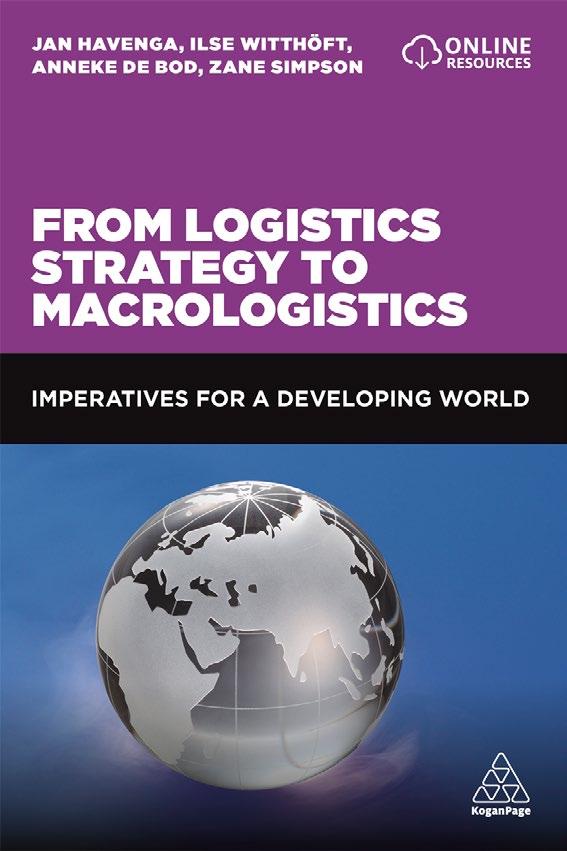
• Provides over 100 tools for functions across warehousing, transport and inventory management
• Offers solutions and plans on some of the most common problems faced by logistics and supply chain professionals
• New to this edition: tools to incorporate robotics and blockchain in logistics; guidance and frameworks on how to measure the return on investment for new technologies
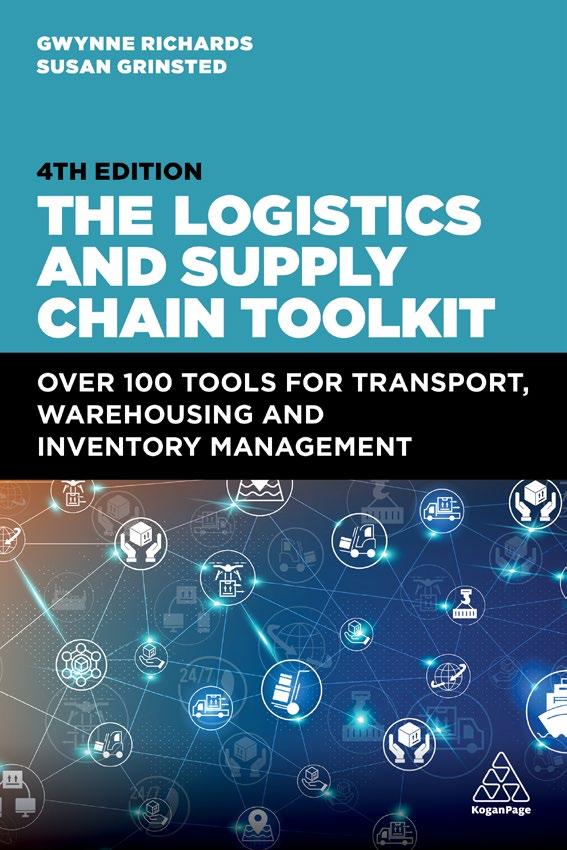
• Online resources: downloadable tools such as supply chain audits and supply chain strategy decision charts
• Features guidance on general management, performance management and problemsolving to provide a unique and transferable scope of tools
The Logistics and Supply Chain Toolkit provides practical tools and ideas to optimize the management of logistics and supply chain processes.
The fourth edition is fully updated to feature the latest frameworks and topics, including robotics and blockchain in logistics and how to measure the return on investment for these technologies. It offers solutions and plans spanning across a variety of functions such as warehousing, logistics, supply chain management, inventory and outsourcing. General management, performance management and problem-solving tools are also included to provide a broader, transferable scope of tools for the reader.
Each toolkit addresses key principles within its area of discipline, providing the reader with a precision approach to be used in complex and sensitive circumstances. The Logistics and Supply Chain Toolkit is an essential resource of practical tools and information for warehouse, inventory and transport managers and students to help them tackle the challenges of logistics and supply chain management. Online resources contain downloadable content, including supply chain audits and supply chain strategy decision charts.
Gwynne Richards runs his own logistics consultancy and provides courses on warehouse and transport management for practitioners. He lectures at University of Warwick, UK and Hong Kong Polytechnic University. He is also the author of Warehouse Management, published by Kogan Page.
Susan Grinsted is co-founder of HowToLogistics.com, an associate at Apprise Consulting and a Principal Fellow of WMG at University of Warwick, UK.
Edition: 4
Date: 03/28/2024
Price: $53.99
Paperback: 9781398613379
Ebook: 9781398613386
Pages: 424
Format (mm): 234x156
Band: Professional/ Academic
Subject: Intro Logistics & Supply Chain
Introduction
1 Warehouse management tools and guides
2 Transport management tools
3 Inventory management tools
4 Supply chain management tools
5 Outsourcing tools
6 General management tools
7 Performance management tools
8 Financial management tools and ratios
9 Problem-solving tools
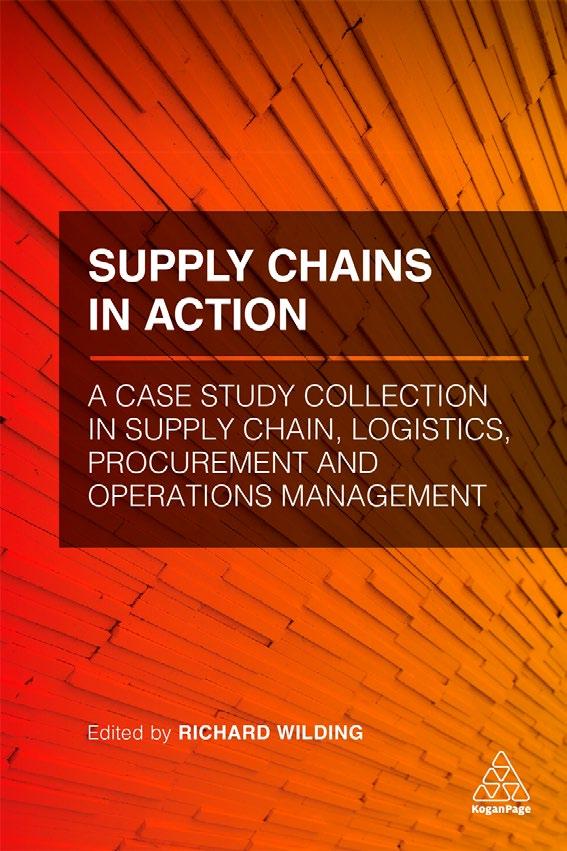
• Learn from in-depth case studies which deliver insights and perspectives on current and emerging issues, trends and significant new areas of research
• Gain insights into a variety of topics including technology-related issues, setting and reviewing budgets, managing economic performance and managing costs
• Learn from first-hand experiences from subject matter experts in industry and academia regarding how to reach business objectives and overcome considerable obstacles
• Understand unique perspectives that demonstrate how leading organisations stay competitive across the globe in a variety of geographical contexts
• New to this edition: Covers hot new topics and vital new areas of research which will guide future strategies, as well as being edited by industry expert and highly respected academic, Richard Wilding
Volume 2 of Logistics, Supply Chain and Procurement Case Study Collection contains new case studies tackling Supply Chain and Procurement issues, aiming to provide solutions affecting a range of different businesses. Comprehensive in scope and scrupulous in detail, this collection includes actual events experienced by businesses of every size, from SMB's to some of the most successful corporations in manufacturing, transportation, maritime and other industries. Readers will discover proven tactics and innovative solutions for handling uncertainties, solving problems and circumventing risk, plus a wealth of information to guide strategy and decision making.
Readers involved in logistics and supply chain management will find the Logistics, Supply Chain and Procurement Case Study Collection full of: immediate application of strategies and tactics to situations and challenges; valuable tools for testing management proficiency in crisis mitigation and resolution; independent learning modules and professional training programmes; expanded question-and-answer sections designed to measure knowledge transfer and lessons learned; engaging, topical situations highly relevant to the fields of logistics, supply chain management and operations. Students and prospective managers will learn crucial skills to meet current challenges, qualify for professional advancement and achieve success.
Professor Richard Wilding OBE is recognised globally for his thought leadership in Logistics & Supply Chain Management. Richard is a highly acclaimed presenter and regularly speaks at Industrial Conferences and has undertaken lecture tours of Europe and Asia at the invitation of local Universities; Confederations of Industry.
As Chair (Full Professor) in Supply Chain Strategy at the Centre for Logistics and Supply Chain Management, Cranfield School of Management UK, Richard works with European and International companies on Logistics and Supply Chain projects in all sectors including pharmaceutical, retail, automotive, high technology, food, drink and professional services to name a few. He has published widely in the area of Supply Chain Management and is Editorial Advisor to a number of top journals in this area. He is currently Chair of CILT.
Logistics, Operations and Supply Chain Management
Edition: 1
Date: 10/28/2019
Price: $224.00
Ebook: 9780749483715
Pages: 264
Format (mm): 240x160
Band: Reference
Subject: Intro Logistics & Supply Chain
1 Supply chain process design
1 Efficient integration of shipping into intra-regional supply chains [Anastasia Christodoulou, Zeeshan Raza, John Woxenius]
2 Overcrowding in a hospital emergency department – A supply chain management referral pathway to reduce overcrowding [Ingrid Hunt, Noreen Spillane]
3 X company’s OTD (On-Time Delivery) performance improvement – The application of lean six-sigma methodology [Gendao Li, Alireza Shokri, Kyrill Nussbaum]
4 Developing best-practice in operational workforce planning [Peter Hilton]
2 Supply chain network and infrastructure design
5 Why procurement should want to pay for performance – A case study of how buyer and sellers aligned to create the most profit for both [Todd C Snelgrove]
6 Closing the cycle from tree to product, x company’s sustainability journey [Gendao Li, Alireza Shokri, Jie Ma]
7 Environmentally responsible packaging in global supply chains [Henrik Pålsson]
8 Freight transport, storage and distribution organisations to be able to identify customer requirements [Graham Heron, Erica Ballentine]
3 Supply chain information system design
9 Protecting supply chains from counterfeit products [Mark Manning, Daniel Stanton]
10 The same but different; a comparative analysis of common reverse logistics and closed loop supply chain issues in the UK multiple retail sector [Graham Heron, Erica Ballentine]
11 Supply chain disruption [Steve O’Sullivan]
12 Defence support chain performance dashboard development [Alan Woods]
• In-depth case studies deliver insight and perspective on current and emerging issues, trends and significant new areas of research in the fields of logistics, supply chain and operations
• Cases cover a variety of topics including how to tackle technology-related issues, setting and reviewing budgets, managing economic performance and managing costs
• Shares first-hand experiences and knowledge from subject matter experts in industry and academia regarding how to reach business objectives and overcome considerable obstacles
• Imparts unique perspectives that demonstrate how leading organisations stay competitive across the globe in a variety of geographical contexts
• Covers hot new topics and vital new areas of research which will guide future strategies
• Foreword by Martin Christopher
The Logistics, Supply Chain and Operations Management Case Study Collection contains real-life scenarios from leading companies including Volvo, Vortex, Honda of America, Green Cargo and Swedish Transport Administration. It includes a foreword by Martin Christopher. Comprehensive in scope and scrupulous in detail, this collection includes actual events experienced by businesses of every size, from SMB's to some of the most successful corporations in manufacturing, transportation, hospitality and other industries. Readers will discover proven tactics and innovative solutions for handling uncertainties, solving problems and circumventing risk, plus a wealth of information to guide strategy and decision making.

Readers involved in logistics and supply chain management will find the Logistics, Supply Chain and Operations Management Case Study Collection full of: immediate application of strategies and tactics to situations and challenges; valuable tools for testing management proficiency in crisis mitigation and resolution; independent learning modules and professional training programmes; expanded question-and-answer sections designed to measure knowledge transfer and lessons learned; engaging, topical situations highly relevant to the fields of logistics, supply chain management and operations. Students and prospective managers will learn crucial skills to meet current challenges, qualify for professional advancement and achieve success.
Professor David B. Grant is Professor of Logistics at Hull University Business School. He has over 175 publications and is on the editorial boards of numerous journals.
Edition: 1
Date: 03/28/2016
Price: $224.00
Ebook: 9780749477493
Pages: 384
Format (mm): 24x156
Band: Reference
Subject: Intro Logistics & Supply Chain
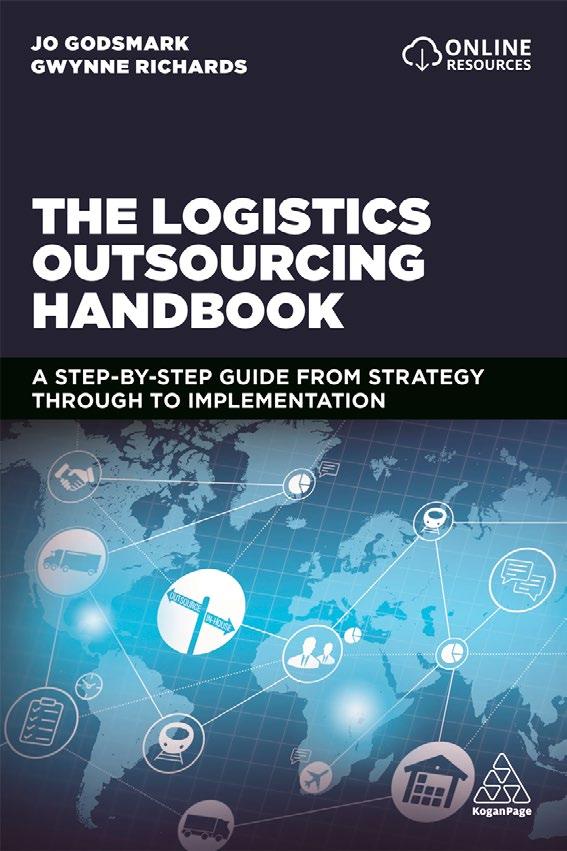
• Provides a life-cycle approach to logistics outsourcing, with tried and tested processes for decision-making and implementation
• Includes informative case studies from large companies such as Asda, British Airways and KFC, as well as major 3PLs
• Looks at the benefits of outsourcing, such as enhancing customer satisfaction and reducing liabilities
• Presents current statistics for logistics outsourcing and analyses why contracts are both awarded and terminated
• Online Resources: Includes examples of decision tables, RFP/metrics/selection criteria as excel and word downloadable templates, as well as PowerPoints for students
For any business involved in today's supply chains, logistics services are critical. Companies have to decide whether to retain their own logistics operations or place their trust in thirdparty suppliers. This potential move away from the traditional approach of managing these processes internally can lead to improved service and reduced cost although this isn't always the case. The Logistics Outsourcing Handbook provides step by step guidance on the process of logistics outsourcing and explains how to apply this information for commercial success. Vital advice is given on benchmarking existing operations, how to shortlist companies, produce a request for a proposal, choose the optimum supplier and implement and manage the contract.
The Logistics Outsourcing Handbook analyses outsourcing from both an industry wide perspective, while also drilling down into specific individual considerations. The book provides valuable guidance in terms of contractual relationships, cost models and the integration of information technology systems. By analysing current statistics and surveys, looking into factors behind why contracts are awarded and terminated important insights can be acquired. This book contains tools, models, online resources and case studies on the outsourced relationships of companies including Intel KFC and BA to further develop the reader's knowledge which makes this book an informative and essential resource.
Gwynne Richards has over 35 years of experience in warehouse management and logistics outsourcing. As well as running his own successful logistics consultancy, he produces and runs a number of courses on warehouse management and logistics outsourcing for practitioners.
Jo Godsmark is a supply chain professional and consultant with over 20 years experience in manufacturing and logistics. She is Chair of Chartered Institute of Logistics and Transport's Outsourcing and Procurement Forum.
Edition: 1
Date: 12/28/2019
Price: $62.99
Paperback: 9780749484620
Ebook: 9780749484637
Pages: 384
Format (mm): 234x155
Band: Textbook/ Professional
Subject: Logistics
Introduction
1 Logistics outsourcing
2 To outsource or not to outsource?
3 The logistics services marketplace
4 Supplier or partner?
5 The outsourcing lifecycle
6 Third-party logistics contracts and pricing mechanisms
7 Performance measurement and management
8 The risks associated with outsourcing
9 Managing relationships
10 IT in logistics outsourcing
11 The future of logistics outsourcing
12 Appendix I LSP warehouse audit checklists
13 Appendix II LSP transport audit checklists
14 Appendix III Sample non-disclosure agreement
15 Appendix IV LSP outsourcing contract –typical headings
16 Appendix V Sample receiving process flow
17 Appendix VI Sample customer questionnaire
18 Appendix VII Useful websites
19 References and further reading
20 Index
• Provides the latest insights from leading thinkers to keep readers up to date with the growth and evolution of e-logistics
• Explains key technological and business developments, such as cloud computing, social technology and distributed leger technology, and how they can be applied
• Examines the strategic role of e-logistics in managing information and information flows within and between organizations

• New to this edition: new chapters on AI, machine learning and autonomous vehicles, Internet of Things, Immersive technology, robotics, drone and last mile deliveries
E-Logistics serves as the nerve system for the whole supply chain and enables smooth information flow within and between organizations.
This new and updated edition provides the latest and most comprehensive coverage on digitalization in logistics and supply chain. It covers all transport modes and the role of ICT in supporting an integrated freight and supply chain network.
E-Logistics provides a cross-academic and industry perspective with leading academics and practitioners as contributing authors. A variety of successful e-logistics business approaches are discussed covering a range of commercial sectors and transport modes. Subsequent chapters address in depth support systems for B2C and B2B e-commerce and e-fulfilment, warehouse management, RFID, electronic marketplaces, global supply network visibility and service chain automation. Industry case studies are used to support the discussion. The new edition also covers emerging technologies such as AI, machine learning and autonomous vehicles, Internet of Things, Robotics, drone and last mile deliveries.
Yingli Wang is a Reader in logistics and operations management at Cardiff Business School. She specialises in logistics and supply chain digitisation and has led a number of research projects from a wide range of UK and international funding bodies. Her research started with examining technological innovation for organisations such as logistics service providers and manufacturers, and then recently extended to explore how technological innovations could benefit a wider society, in particular by addressing the 'wicked' problems and grand challenges. Dr. Wang is also a Chartered Member of the Chartered Institute of Logistics and Transport (CILT).
Stephen Pettit is a Professor at Cardiff Business School and is a member of the Transport and Logistics Research Group within the Logistics and Operations Management Section. He has been involved in a wide range of transport-related research programmes for both the UK Government and the European Commission. His research interests include port management and policy, and the logistics of humanitarian aid delivery. His recent research has also focused on international logistics and the application of information and communication technology in the fields of transport, logistics and supply chain management.
Edition: 2
Date: 09/28/2021
Price: $65.95
Paperback: 9780749496883
Ebook: 9780749496890
Pages: 296
Format (mm): 235x155
Band: Textbook
Subject: Logistics
1 E-logistics definition, trends and directions
2 End-to-end global visibility and order management - Integrated supply and demand chains in the age of value chain management
3 B2C e-commerce and fulfilment
4 The challenges of e-commerce on warehousing in the future
5 Advanced warehouse management systems and innovations - Streamlining e-logistics processes with technology deployment
6 Automating a logistics service chain - A telecommunications company’s perspective
7 Regional electronic marketplaces to improve logistics
8 Trade and transport electronic single windows
9 Port-centric ICT systems - Building value in supply chains
• Provides a holistic view of both fashion retailing and fashion logistics.
• Studies major forces driving change in the fashion retail industry and how manufacturers can adapt their working practices accordingly.
• New to this edition: content has been restructured to include updated case studies, key objectives, summary q&a's and 'how to put into practice' textboxes.
Retailers are being advised to review their supply chains in a bid to accelerate their speed to market. Fashion Logistics assesses the growth and changes in the industry as well as the drivers of change in the market. Supply chain networks and operations play an integral role in distributing product across the retail industry and significant changes within those networks have altered the way in which they function. Manufacturers therefore need to rethink their supply chains to make them resilient to shock, agile enough to respond quickly to sudden change, flexible enough to customize products and efficient enough to protect margins. Fashion Logistics assesses these forces and changes and how manufacturers should adapt their working practices accordingly.
This second edition of Fashion Logistics includes revised CSR and reshoring sections, updated case studies and new content on how manufacturers can adapt their working practices and the further demise of the department store sector.

John Fernie is Emeritus Professor of Retail Marketing at Heriot-Watt University, Scotland. He has written and contributed to numerous textbooks and papers on retail management, especially in the field of retail logistics. He was the founder editor of the International Journal of Retail & Distribution Management and is on the editorial board of numerous marketing and logistics journals. He is a Fellow of the Institute of Logistics and Transport. He holds an Honorary Professorship at St Andrews University and several visiting positions at European universities.
David B Grant is Professor of Supply Chain Management and Social Responsibility at the Hanken School of Economics, Finland. David has over 250 publications in various refereed journals, books and conference proceedings and is on the editorial board of several internationally ranked journals. Honours in 2019 include the award of the Bualuang ASEAN Chair Professorship at Thammasat University in Thailand.
Edition: 2
Date: 11/28/2019
Price: $62.99
Paperback: 9780749493318
Ebook: 9780749493325
Pages: 256
Format (mm): 235x156
Band: Textbook
Subject: Logistics
1 Introduction to fashion logistics
2 The changing nature of fashion retailing: Implications for logistics
3 Offshore sourcing and outsourcing in the international fashion supply chain
4 Corporate social responsibility (CSR) in international fashion supply chains
5 International logistics
6 In-store consumer service
7 Online consumer service
8 Luxury fashion and supply chain management
9 Sustainable fashion retailing and logistics
• Covers the entire supply chain in a defence context through real-life case studies, examining issues such as circular logistics in defence and contracting
• Provides vital insights from international academics and professionals currently working in defence logistics areas such as distributive manufacturing and performance management
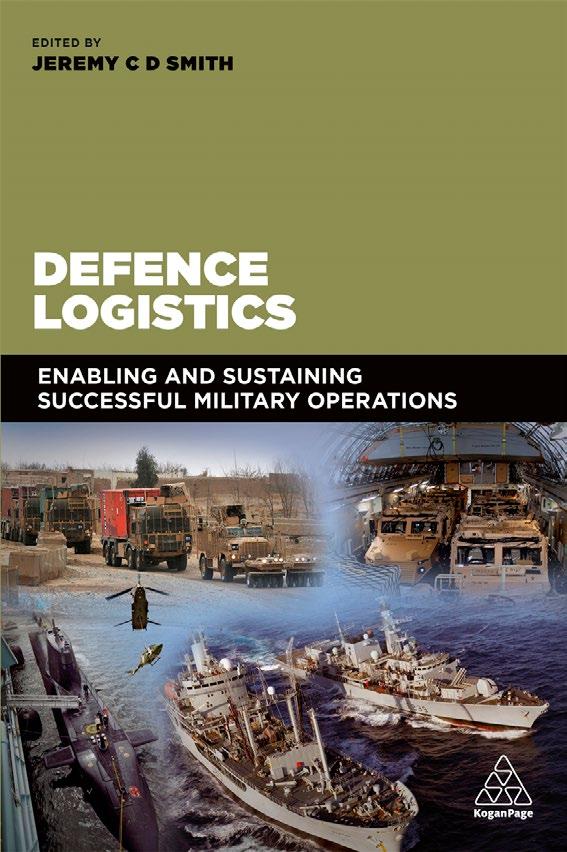
• Includes coverage of recent developments and technologies affecting defence logistics, such as 3D printing and issues such as obsolescence, counterfeiting and sustainability
The management of logistics and supply chain operations is of vital importance in the defence sector.
Defence Logistics looks at established theories and their practical utility, providing insights into current thinking for postgraduate and undergraduate students, lecturers, researchers, practitioners and professionals through real-life case studies.
Defence Logistics focuses on key areas of logistics and supply chain management in context, such as sustainability, inventory management, resilience, procurement, information systems and crisis response. This comprehensive and up-to-the-minute collection includes contributions from international academics from a range of universities, academies and defence schools, along with practitioners who are currently working in the field of defence logistics.
Jeremy Smith manages modules on the Defence Acquisition Management and the Programme and Project Management MScs at Cranfield Defence and Security, UK. He developed and leads several logistics short courses and workshops pitched at strategic and practitioner levels. He served for 25 years in the British Army as a logistician and Ammunition Technical Officer.
Edition: 1
Date: 02/28/2018
Price: $79.99
Paperback: 9780749478032
Ebook: 9780749478049
Pages: 384
Format (mm): 230x150
Band: Textbook/ Professional
Subject: Logistics
Introduction
1 Defence logistics definitions and frameworks
2 Defence logistics - an historical perspective
3 Defence logistics in context
4 Resilience in defence supply chains
5 Integrating mission and support systems through the life cycle - Integrated logistics support and maintenance strategies
6 Supportability analysis for supportable and supported mission systems
7 Achieving dependability in defence systems
8 Planning and executing defence operational logistics
9 Procurement for defence logistics support
10 Managing performance in defence logistics
11 Optimizing the defence inventory
12 Accounting and finance in defence logistics
13 Decision support in defence logistics
14 Defence logistics and crisis response
15 Defence logistics information systems
16 A look to the future
• Provides fascinating cases that identify the key stages in the development of city logistics initiatives in London, New York, Paris, SaoPaulo, Tokyo, Beijing, Delhi and Gothenburg
• Examines urban supply chains for major cities, with cases looking at urban food supply chains, services and the special logistics requirements involved, construction, waste management, e-commerce and home delivery
• Includes toolkits to help policy makers and managers devise and work with new initiatives
• Presents and is based on original research from the University of Gothenburg and Chalmers in Sweden, the Centre for Infrastructure, Transportation and the Environment in New York and the University of California
Approximately 80 per cent of European and American citizens live in an urban environment. Due to their large populations and extensive commercial establishments, urban areas require large quantities of goods and services for commercial and domestic use. This results in increasing levels of demand for freight transport services. Freight transport in towns and cities is a major contributor to environmental impacts, particularly to local air pollution and noise. Urban Logistics addresses public policy makers, freight transport companies and receivers of supplies, providing them with the information and guidance to affect change in the logistics of the city.
Urban Logistics is written by an outstanding team of international editors combining their expertise and using their research from leading business schools in Sweden and the US. There are also valuable contributions from academics and industry experts from companies and universities from all over the world. The book includes clear examples of initiatives that work and business case developments, as well as toolkits for policymakers and managers who are devising new initiatives. There is an in-depth examination of different aspects of urban logistics, such as retail logistics for cities, urban food supply chains, services and the special logistics requirements involved, construction, waste management and e-commerce and home delivery. There is also a focus on networks and partnerships and an analysis of innovation as a new constant.

Michael Browne is Professor of Logistics and Urban Freight Transport at the University of Gothenburg.
Sönke Behrends is a senior researcher at IVL Swedish Environmental Research Institute, Gothenburg.
Johan Woxenius is Professor of Maritime Transport Management and Logistics at the University of Gothenburg.
Genevieve Giuliano is Professor and Margaret and John Ferraro Chair in Effective Local Government at the University of Southern California. She is also Director of METRANS Transportation Center.
José Holguín-Veras is William H Hart Professor and Director of the Center for Infrastructure, Transportation and the Environment at the Rensselaer Polytechnic Institute, Troy, New York.
Logistics, Operations and Supply Chain Management
Edition: 1
Date: 12/28/2018
Price: $79.99
Paperback: 9780749478711
Ebook: 9780749478728
Pages: 392
Format (mm): 235x157
Band: Professional/ Academic
Subject: Logistics
1 Setting the scene
1 Introduction to urban logistics
2 Metropolitan economies and the generation of freight and service activity –An international perspective
3 Urban logistics – The regional dimension
4 Urban planning policies for logistics facilities: a comparison between US metropolitan areas and the Paris region
5 The dualism of urban freight distribution –City vs suburban logistics
6 Port cities and urban logistics
2 Urban logistics diversity
7 The logistics of parcel delivery – Current operations and challenges facing the UK market
8 E-commerce trends and implications for urban logistics
9 Food and urban logistics – A fast-changing sector with significant policy and business implications
10 Consolidation centres in construction logistics
11 The socio-economic benefits of off-peak hour distribution – The case of Stockholm
3 Making change happen
12 Stakeholder engagement and partnerships for improved urban logistics
13 Multi-actor multi-criteria analysis as a tool to involve urban logistics stakeholders
14 Off-hour deliveries – The importance of outreach and proper planning
15 The procurement process – A key to improved urban logistics efficiency
16 Future developments in modelling and information
• Explores key characteristics of industrial and consumer packaging in a variety of companies, using examples and case studies from practice
• Examines the different ways that packaging adds value to logistics and supply chain, such as cost-effectiveness and packaging aesthetics
• Provides concrete tools, methods and guidelines that help reduce the cost of materials handling, and increase safe and efficient storage
• Looks at environmentally friendly and innovative packaging solutions which help promote sustainability and cut costs
• Examines the track and trace capability of packaging through ICT, the technology included in packaging to enable tracking through the supply chain
Packaging has a major impact on supply chain performance, as it affects all logistics activities in supply chains. Effective and efficient packaging can significantly improve the performance of companies by generating value and reducing costs and the negative environmental impacts in supply chains. Packaging Logistics uses a systems approach to examine all the essential roles of packaging in supply chains, from the purchasing of raw materials to the production and sale of finished products, as well as transport and distribution. It examines the strategic role of packaging and its operational importance, explains the theoretical basis, presents useful methodologies, tools and concepts, and provides decision support for packaging innovation. It provides several examples of the total environmental impacts of packaging: on logistics and transport efficiency, on product waste and from the packaging material.
Packaging Logistics covers essential topics such as one-way and reusable packaging, industrial and consumer packaging, ICT, end-of-life, environment, innovation, e-commerce, and future trends and challenges. This research-based and practical book takes the reader through every stage of packaging and relates it to supply chain and logistics, illustrated by many case studies.

Henrik Pålsson is Associate Professor at Lund University, Sweden. He has conducted research and taught master's students within packaging logistics since 2004.
Edition: 1
Date: 06/28/2018
Price: $59.99
Paperback: 9780749481704
Ebook: 9780749481711
Pages: 248
Format (mm): 234x157
Band: Professional/ Academic
Subject: Logistics
1 Defining Packaging Logistics
2 Packaging performance in supply chains
3 Packaging performance methodology
4 Environmental performance of packaging logistics
5 Managing packaging waste
6 Managing ICT features of packaging
7 Reusable packaging systems
8 Industrial packaging evaluation
9 Decision support for industrial packaging
10 Organising packaging development
11 Packaging innovation capability
12 Managing packaging logistics in e-commerce channels
13 Managing packaging logistics in developing countries
14 References
• Outlines health and safety from the basic principles such as establishing the best culture, through to issues relating to physical and mental health, personal protection equipment, manual and mechanical handling, and safe transport operations
• Provides the most up to date regulatory information on health and safety, such as the Health and Safety at Work Act (HASAWA)
• Focuses on assessment and elimination of risks, compliance and the avoidance of unsafe practices in logistics and transportation
• Looks at vehicles, their maintenance and driving standards as well as the important role of managers in safe operation, for example by optimum vehicle routing
Logistics is a complex industry that exposes employees to a whole variety of risks.
These include not only accidents on the road and deaths and injuries resulting from unsafe use of forklifts, but also the consequences of poor fire safety, long-term health risks due to poor manual handling technique and problems relating to mental health. Many thousands of incidents are recorded every year. This book examines each aspect of health and safety in turn, with a focus on warehousing and transportation.

Health and Safety in Logistics informs managers about potential hazards found in the industry and explains in detail how they can make the workplace as safe as possible.
Jerry Rudd is a logistics consultant. He was formerly Logistics Manager at Gefco and Business Unit Director at Wincanton, working with Waitrose, Sainsbury's and British Airways.
Edition: 1
Date: 09/28/2020
Price: $56.24
Paperback: 9781789663259
Ebook: 9781789663266
Pages: 464
Format (mm): 234x155
Band: Professional/ Academic
Subject: Logistics
1 Introduction – The importance of health and safety
2 Basic principles of health and safety
3 Physical health issues
4 Mental health
5 Drug and alcohol issues
6 Personal protection equipment
7 Safe storage and warehouse layout
8 Manual handling
9 Materials handling equipment
10 Fire safety
11 Yard safety
12 Vehicle loading
13 Road vehicle specifications, maintenance and compliance
14 Accident prevention during vehicle operations
15 Transport of dangerous goods by road
16 Vehicle mounted loading equipment
17 Seafreight, rolling motorway and airfreight
18 Miscellaneous issues
19 Health and safety monitoring and audit
• Looks at how bringing marketing and logistics together is a powerful way of improving customer service and increasing competitiveness
• Demonstrates how to deal with digitalisation and successfully integrate it into marketing and logistics strategies
• Presents a range of examples from a range of sectors such as retail, transport and the service industries
• Includes case studies such as Toyota and Value and Tesco and the club card
• Examines how to deal with scenarios such as Black Friday and Online Monday, where marketing is promising something logistics can't deliver
Logistics and marketing stand out as two disciplines which are connected, and both are critical to the provision of customer value. Marketing and Logistics Led Organizations looks at marketing-led logistics and logistics-led marketing. In the current business world, the idea of a single supply chain has been replaced by an integrated multi-channel approach. The authors therefore examine how to optimise profit and control costs through the coordination of these two functions.

Marketing and Logistics Led Organizations takes an in-depth look at physical supply chains where manufacturing of a product occurs from groceries to pharmaceuticals, and from automotive to construction. The authors examine omni-channel, how this affects the customer experience and the need for a joined-up strategy which is operationalised across all channels. They also look at the challenges of digitalisation and the customer interface with the growth of the internet as well as the intensification of competition across all sectors.
Robert Mason has a business background, mainly in a variety of roles with M&S. He is now a Reader in Logistics and Operations Management (LOM) at Cardiff Business School and has led many business research projects with Tesco as a partner.
Barry Evans' early career involved roles in Logistics/Distribution with Watney Mann, Rank Hovis McDougall and Royal Mail. This was followed by roles in Tesco plc, including Lean Process Manager in Tesco Supply Chain Development. He joined the Lean Enterprise Research Centre at Cardiff Business School as a Senior Research Associate. Mr Evans is now retired.
Edition: 1
Date: 10/28/2017
Price: $59.99
Paperback: 9780749478735
Ebook: 9780749478742
Pages: 280
Format (mm): 234x156
Band: Professional/ Academic
Subject: Logistics
1 An Introduction – Setting the Scene
2 Customer Value – What is it?
3 Organisations have to be More Capable Today than Ever Before – Why?
4 How Purpose is Achieved – A Marketing and Logistics Led Approach
5 What Great Operational Process Capability Looks Like
6 Marketing and Logistics in Harmony –Building and Sustaining Operational Excellence Integrated with a Marketing Orientation
7 Finding Logistics Solutions – How Logistics is Responding to Modern Challenges
8 Conclusions – Logistics is Business Critical
• Overviews global container transport, including shipping networks and inland/multimodal aspects
• Focuses on operational models and cost structures, including multimodal
• Discusses key origins and destinations, main routes and service types, and key players in the sector
• Written by industry experts and respected academics who have advised the Department of Transport and the United Nations
International Freight Transport presents the key changes and issues in the fast-moving industries of trade and transport. It includes coverage of regional trade groupings, the emergence of new large economies (i.e. BRIC countries), and pivotal regions such as the Middle East and Central America where major projects, such as new and widened canals, are underway or planned. These changes could redraw the trade map with major implications for transport patterns and solutions.
Blending geography, economics, politics and trade, International Freight Transport provides insight into a wide range of topics, including: globalisation; demand versus supply; buyers and sellers; transport regulation, geography, modes and methods; transport ownership; alliances; and safety and security. The book is the only comprehensive and accessible book on international transport available.

Professor Anthony Beresford is Programme Director for the MSc International Transport at Cardiff University and Director for the suite of Masters Programmes within Logistics and Operations Management. Professor Beresford has travelled widely in an advisory capacity within the ports and transport fields in Europe, Asia and North America.
Dr Stephen Pettit is a researcher for the Transport and Shipping Research Group in Cardiff Business School. He has been involved in a range of transport related research including a ground-breaking project for the Department of Transport.
Edition: 1
Date: 03/28/2017
Price: $84.99
Paperback: 9780749474348
Ebook: 9780749474355
Pages: 376
Format (mm): 240x155
Band: Textbook
Subject: Global Logistics
Introduction – Cases, Structures and Prospects
1 Trade and the Transport Environment
1 Demand, Supply and Freight Rates –The Shipping of Global Trade [Hassiba Benamara, Jan Hoffmann and Frida Youssef]
2 Trade and Customs Procedures in International Freight Transport –Requirements, Issues and Trends [Andrew Grainger]
2 International Freight Transport in Practice
3 Multimodal Transport Solutions for Grain Exports from Kazakhstan [Timur Bimaganbetov, Anthony Beresford and Stephen Pettit]
4 The Transport of Oil and Gas [Hance D Smith and Azmath Jaleel]
5 Global Container Transport [Rolf Neise]
6 Car Shipping [Paul Nieuwenhuis]
3 Trading Regions
7 International Freight Logistics in South East Asia – The Indonesia–Malaysia–Thailand Growth Triangle (IMT-GT) [Ruth Banomyong]
8 North America’s Evolving International Freight Transport – Challenges and Responses [Michael Ircha]
9 International Freight Transport in South America – The Case of Colombia [David B Grant, Rodrigo Britto, Juan Pablo Soto, Marcus Thiell]
10 International Freight Transport in Southern Africa [Christopher Savage]
11 Freight Transport in Korea and Taiwan [Su-Han Woo, Po-Lin Lai, Doori Kim and Jungeun Kim]
4 Challenging Environments and Transport Futures
12 Overcoming International Freight Transport Challenges in a Disaster Response Context [Peter Tatham and Gyöngyi Kovács]
13 Transport Futures – Reconciling the OnDemand Economy with Global Production Chains [Peter Wells]
• Offers a step-by-step guide to global logistics
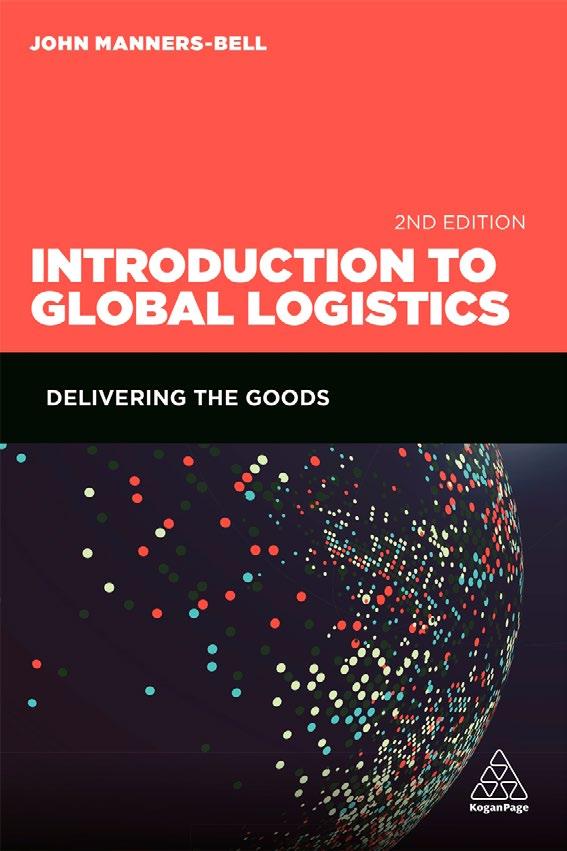
• Provides in-depth definitions, descriptions and explorations of the strategic principles and practices in transportation modes and supply chain verticals, including: freight forwarding, contract logistics, shipping, road freight, air cargo and express
• Examines important trends and developments that are shaping the industry, including 3D printing, megacities, and postharvest food losses
• Online resources: Chapter-supporting lecturer slides
Introduction to Global Logistics offers a step-by-step guide to global logistics. Covering the breadth of logistics, this highly accessible text is illustrated by engaging case studies of market leaders. In this comprehensive second instalment of Global Logistics Strategies, John Manners-Bell provides an in-depth definition, description and exploration of the strategic principles and practices in transportation modes and supply chain verticals, including: freight forwarding, contract logistics, shipping, road freight, air cargo and express. The book also examines major sectors, including automotive, chemical, pharmaceutical, retail, consumer, and high tech.
Introduction to Global Logistics offers a detailed examination of key topics, including: how the logistics industry has developed, how it is influenced by macro-economic factors and demand-side trends, what the risks are to the industry, and how it will develop over the coming years. It examines important trends and developments that are shaping the industry, including 3D printing, megacities, and post-harvest food losses.
Online resources available: Chapter-supporting lecturer slides.
John Manners-Bell is the founder and CEO of Transport Intelligence, a leading supplier of market solutions to the global logistics industry. He is Honorary Visiting Professor at the London Metropolitan University, adviser to the World Economic Forum and a former Chairman of the Supply Chain Council of the World Economic Forum. Prior to establishing Transport Intelligence, he worked as an analyst in consultancies specializing in international trade, transport and logistics. John Manners-Bell is author of Logistics and Supply Chains in Emerging Markets and Supply Chain Risk
Edition: 2
Date: 11/28/2016
Price: $69.99
Paperback: 9780749478254
Ebook: 9780749478261
Pages: 384
Format (mm): 235x155
Band: Textbook
Subject: Global Logistics
Introduction
1 What’s shaping the global logistics market?
2 An industry in transformation: towards consolidation
3 Logistics market development by geography
4 The emergence of logistics clusters
5 International freight forwarding
6 Contract logistics
7 European road freight
8 Express parcels
9 Air cargo
10 Container shipping
11 The European rail and intermodal sectors
12 Supply chain technologies
13 Supply chain dynamics of vertical sectors
14 Risks in global supply chains
15 The e-commerce logistics phenomenon
16 Supply chain innovation and disruption
17 Ethical and sustainable supply chain strategies
• Provides research from leading academics and practitioners on fundamental, cuttingedge and trending topics in logistics and supply chain management
• Offers guidance on how to apply key learnings, tools, and methods for use globally in the real world scenarios
• Examines the supply chain from start to finish to teach readers the importance and the nuances of each stage of supply chain management
• New to this edition: a revised structure and focus, a range of new topics including the supply chain of the future, ethical supply chains and supply chain leadership
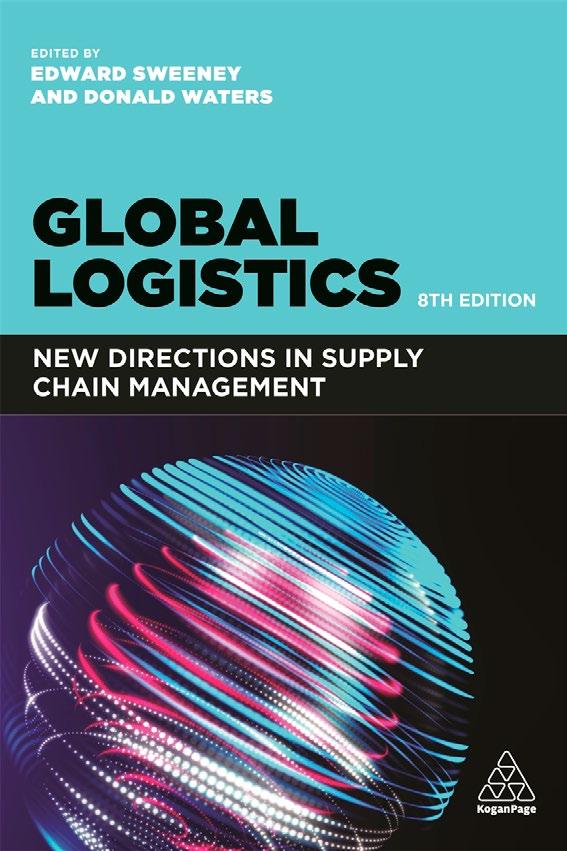
• Supply chains are fundamental to the global economy. There is a now a need to rethink the concept of resilience and to tackle the challenges of achieving net zero emissions and continually evolving consumer demands. This latest version of Global Logistics addresses those issues and provides those in logistics and supply chain operations with valuable and current thinking from which we will all benefit.
Edition: 8
Date: 07/28/2021
Price: $65.95
Paperback: 9781398600003
Ebook: 9781398600010
Pages: 480
Format (mm): 234x155
Band: Textbook/ Professional
Subject: Global Logistics
1 Re-thinking supply chain strategy
2 Linking supply chain management to financial performance
3 Supply chain risk management: finance –the forgotten perspective?
4 Supply chain vulnerability and resilience
5 Fulfilling customer needs in the 2020s with marketing and logistics
6 New procurement directions in supply chain management
7 Maximizing capacity utilization in freight transport
8 Retail logistics
9 Trends and strategies in global logistics and supply chain management
10 Global sourcing and supply 190
11 Supply chain relationships: the foundation of success
12 Delivering sustainability through supply chain management
13 Greening of logistics: cutting pollution and greenhouse gas emissions
14 People powering contemporary supply chains
15 Leadership in logistics
16 Ethics in supply chains: an illustrated survey
17 Humanitarian logistics and supply chain management
18 Digitalization in global supply chain operations
19 Digitalization and Industry 4.0 in logistics
20 Performance measurement and management in the supply chain
21 Aligning technology, manufacturing and supply chain: why it matters and how to do it
22 The ‘deglobalization’ of logistics and supply chains: operating in an increasingly nationalistic and risky world
• Provides a comprehensive overview of crossborder logistics from an operational and strategic perspective

• Focuses on operational and regulatory requirements, their impacts on business and ways to reduce those impacts
• Includes illustrative case studies and examples and extracts from relevant regulations and international recommendations
• Covers trade facilitation and frictionless trade, such as the World Trade Organization (WTO) Trade Facilitation Agreement, Customs Partnership Programmes and Region Trade Agreements
• Online resources: summary tables of regulations and international recommendations
With considerable turmoil in international trade and logistics it is more important than ever to understand trade and customs issues and their impact on logistics operations. At every port and border international freight operations are exposed to trade and customs procedures.
Cross-Border Logistics Operations serves as a comprehensive guide and companion to the cross-border trade and customs environment and its implications for international business supply chains and their control. Inspired by the World Customs Organization's Professional Standards (also known as the WCO PICARD Standards), it provides key insights into transporting goods across borders and effectively managing the requirements for compliance and enforcement.
International students, business operators and government officials will find the book rich in detail with practical examples that include the political, administrative, regulatory, technological and economic context throughout. It covers all the critical operational and legal aspects of cross-border logistics operations, including:
-prevailing trade, customs and border policy
-tariffs and import taxes
-border management and supply chain security practices
-prohibitions and restrictions
-enforcement and compliance practices
-supply chain and logistics arrangements
-disaster relief operations
-frictionless trade and trade facilitation principles.
Dr Andrew Grainger is an established trade facilitation practitioner, academic and educator with global outlook. As the Director of Trade Facilitation Consulting, he helps government agencies and international organizations cut red-tape in international trade. He is also an Adjunct Professor at the Centre for Customs and Excise Studies (CSU, Australia) and an Honorary Associate Professor at the University of Nottingham (UK). He has provided consultancy services to the World Bank Group and the United Nations family of organizations, has given witness to the UK Parliament's Select Committees and provided research services to the European Parliament.
Edition: 1
Date: 08/28/2021
Price: $79.95
Paperback: 9781789666724
Ebook: 9781789666748
Pages: 312
Format (mm): 235x158
Band: Professional/ Academic
Subject: Global Logistics
1 Cross-border logistics operations
2 Customs administrations, tariffs and other taxes
3 Customs declarations and control
4 Prohibitions, restrictions and other border procedures
5 Border facilities - Operations and design
6 Trade and customs compliance management
7 Coordinated border management and supply chain security
8 Logistics, supply chain management and borders
9 Trade facilitation
10 Borders and disaster relief logistics operations
• Examines the myriad ways in which companies are configuring themselves to compete in an internationalized economy
• Explains the shared benefits and metrics which are crucial for the long-term sustainability of international supply chain business relationships
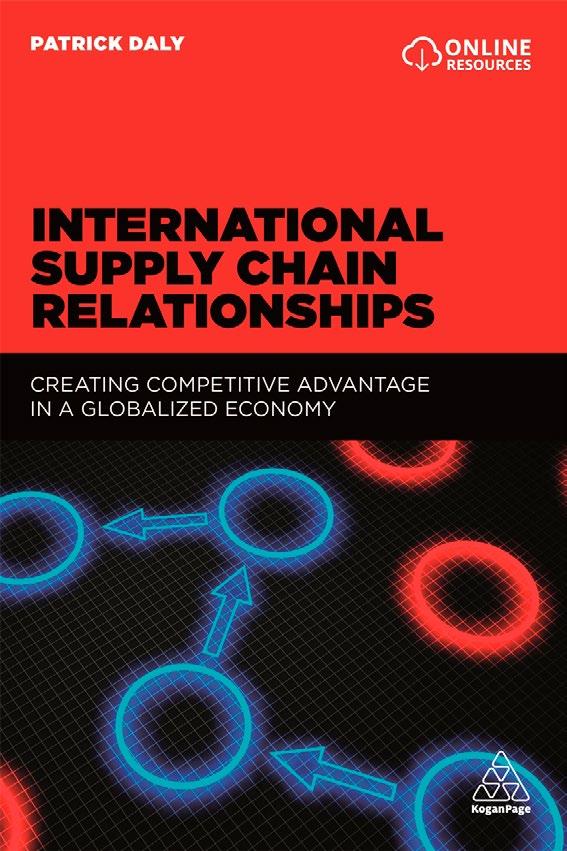
• Presents case studies of long-term strategic relationships, which are critical for success, as well as short-term alliances designed to address specific tactical goals, projects or initiatives
• Online resources: audio Q&A clips with Patrick Daly
Multinational corporations have developed networks of production that stretch across the globe.
They have done this in order to maximize their ability to service their customers in markets worldwide, exploit greater opportunities for growth, maximize their profitability and increase their business value. It is the strength and quality of the relationships and connections that we build with other players that will ultimately determine the effectiveness and the success of our business.
International Supply Chain Relationships looks at these complex connections, covering long-term inter-organizational relationships, situational inter-organizational relationships, multi-disciplinary global engineering teams, technologies and innovations, supply chain communication, supply chain coordination, and future trends.
International Supply Chain Relationships aims to provide supply chain practitioners in any type of business with ideas, tools and strategies that they can readily access, interpret and put into practice speedily and pragmatically to create value for their own international business. In many instances, supply chain projects bring together people from different disciplines who may come from different cultures and ethnic backgrounds. Add in long distances and different time zones and the complexities and challenges of sustaining successful working relationships increase even more. This book provides case studies which illustrate how to manage these arrangements effectively.
Patrick Daly has been a consultant for almost 20 years working in international supply chain and logistics with some of the world's top international corporations, including PepsiCo Worldwide Flavours, Pfizer, Proctor & Gamble, GlaxoSmithKline, Merck Millipore and many more. He has worked with these clients all around the world including China, India, Middle East, Europe, North America and South America.
Edition: 1
Date: 02/28/2019
Price: $62.99
Paperback: 9780749480035
Ebook: 9780749480042
Pages: 232
Format (mm): 235x156
Band: Professional/ Academic
Subject: Global Logistics
1 The globalization of business and the supply chain management concept
2 The world is not flat – Geography still matters
3 Culture – An evolutionary strategy for success
4 We’re getting hitched – Long-term interorganizational relationships
5 Let’s make a movie – Situational interorganizational relationships
6 Why bother? The whole is greater than the sum of the parts
7 Do you speak my language? Supply chain communication
8 Right stuff, right place, right time –Supply chain coordination
9 Finger on the pulse – Control and measurement
10 Looking around the block – Future trends
• Discusses the logistics of a humanitarian response to an uncertain, rapid onset event
• Shows how to establish an agile supply chain that brings aid into confused and rapidly developing environments
• Offers topical focus by assessing issues of contemporary relevance, including the COVID-19 vaccine, migrant crises and sustainability
• New to this edition: contains new chapters on cash-based HL systems, providing logistics services for humanitarian relief and helping the humanitarian supply chain become more sustainable

• Features international perspectives from a range of expert contributors from practice and academia
• Online resources: Lecturer slides and an Operational Assessment appendix
In rapidly developing emergencies, it is vital for aid agencies to understand how to establish an agile supply chain that resists the chaos of a crisis and can cater to unknown needs.
Now in its fourth edition, Humanitarian Logistics presents chapters from a wide range of academics and practitioners and offers cutting edge research into how complex problems such as distribution of the COVID-19 vaccine and provision of relief to victims of natural disasters can be solved. New chapters cover topics such as cash-based humanitarian logistics (HL) systems, sustainability in a HL context and providing logistics services for humanitarian relief.
In recent years, a number of global crises have highlighted the critical role that logistics plays in humanitarian response. There is a vital need to understand how to conduct operations in confused and swiftly changing environments. This book is essential reading for anyone who needs to understand how to effectively manage supply networks during a rapidly developing emergency.
Professor Peter Tatham is a member of the Editorial Boards of the Journal of Humanitarian Logistics and Supply Chain Management, and the International Journal of Physical Logistics and Supply Chain Management. He was Professor of Humanitarian Logistics at Griffith University, Australia, and he remains a leading international researcher in the field of humanitarian logistics.
Professor Graham Heaslip is Professor of Logistics Engineering and Head of School of Engineering at Atlantic Technological University, Galway, Ireland. He is a board member of the Humanitarian Logistics Institute (HUMLOG) based at Hanken School of Economics, Helsinki, Finland and is a member of the Editorial Boards of the Journal of Humanitarian Logistics and Supply Chain Management, and the International Journal of Physical Logistics and Supply Chain Management. His work in the field of logistics and supply chain management has gained international recognition, including the Emerald Literati Network Awards for Excellence.
Edition: 4
Date: 12/28/2022
Price: $85.00
Paperback: 9781398607149
Ebook: 9781398607156
Pages: 376
Format (mm): 235x155
Band: Textbook/ Professional
Subject: Humanitarian Logistics & Supply Chain
Introduction
1 Impacts of funding systems on humanitarian operations
2 Supplier relationships in humanitarian organizations
3 Providing logistics services for humanitarian relief
4 Risky business revisited - Disasters within disasters
5 The journey from a patchy to a comprehensive supply chain in UNHCR (2005–2015)
6 Humanitarian supply chain service performance
7 Network design for pre-positioning emergency relief items
8 Competing for scarce resources during emergencies - A system dynamics perspective
9 Preparing for cash and voucher assistance - Developing capabilities and building capacities
10 Pandemic response and humanitarian logistics
11 Helping people and planet - Making the humanitarian supply chain more sustainable
12 What next for humanitarian logistics?
13 The way forward - Current trends in humanitarian logistics
• Offers vital insights on supply chain management from key practitioners and academics in the humanitarian field.
• Provides highly practical cases and examples, written by practitioners from international companies and associations.
• Shows how to integrate collaboration and coordination into working practices, one of the current biggest challenges in the humanitarian community.
Supply Chain Management for Humanitarians provides an in-depth insight into the management of supply chains in the context of humanitarian logistics. This accessible and practical book considers humanitarian logistics from a strategic and operational perspective.
The overarching theme is collaboration and coordination, one of the biggest challenges in the humanitarian community. Supply Chain Management for Humanitarians takes a problem-based learning approach, featuring real cases and examples from leading organizations including Oxfam, Unicef, and The Red Cross.
Each chapter is self-standing, relating the content in each chapter to the supply chain as a whole. This enables the reader to easily dip into different sections. At the end of each chapter, there is a case study written by a leading practitioner currently working in the humanitarian field.
Supply Chain Management for Humanitarians fills a much needed gap in the market and is essential reading for humanitarians worldwide.
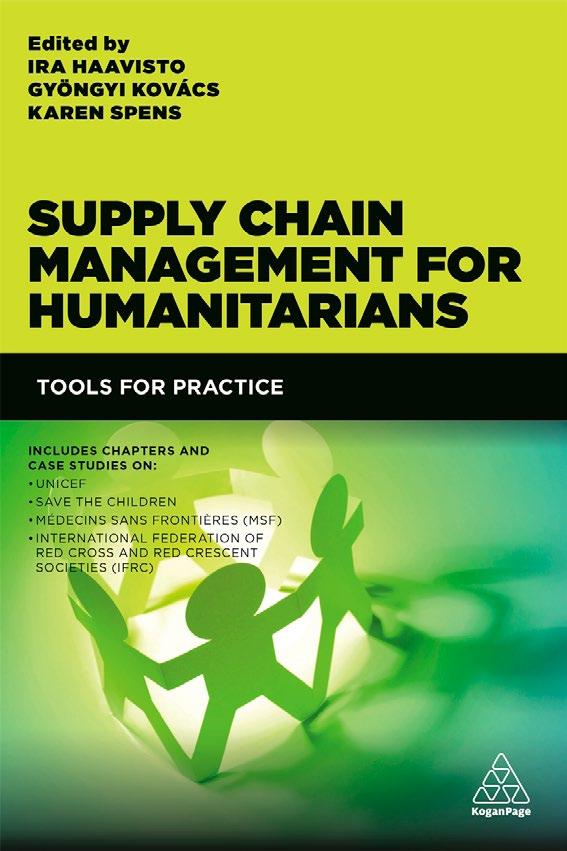
Dr Ira Haavisto is the Director of the HUMLOG Institute. She teaches Supply Chain Management and Social Responsibility at Hanken School of Economics in Finland.
Professor Karen Spens is the Dean of Education at Hanken School of Economics, and a professor in Supply Chain Management and Social Responsibility. She is widely published in the logistics and supply chain industry.
Dr Gyöngyi Kovács is the Erkko Professor in Humanitarian Logistics at the Hanken School of Economics, and the Director of the HUMLOG Institute. She also lectures in supply chain management and corporate geography. She is widely published in the logistics and supply chain industry.
Edition: 1
Date: 08/28/2016
Price: $62.99
Paperback: 9780749474683
Ebook: 9780749474690
Pages: 416
Format (mm): 234x157
Band: Textbook/ Professional
Subject: Humanitarian Logistics & Supply Chain
• Edited by two leading academics who have conducted research for The Department of Transport and the United Nations
• Includes research-based findings from an international team of contributors as well as invaluable insights and international case studies
• Focuses on the big picture, which differentiates it from other available texts which are regional (e.g. Europe, Asia) or focus on specific aspects (e.g. privatisation, competitiveness)
• Online resources: Includes lecture notes, lesson plans and PowerPoints
Port Management looks at the numerous types of business interactions that occur at active ports. These include cooperating with other ports, coordinating deliveries with ships, overseeing port development, advertising and promotion, and enforcing security and environmental protection initiatives. Including research, practical insights and case studies, this book looks at quantitative methods and market analysis, maritime logistics, port planning and pricing, and commercial law.

Port Management covers all the main aspects of management, administration and policy, and fills existing gaps in the literature in this area. Edited by two leading academics who have conducted research for the Department of Transport and the United Nations, this text is international in scope and includes research-based findings from a global team of contributors. It provides fascinating insights into the geography, economics, politics and trade involved in port management. Online supporting resources include lecture notes, lesson plans and PowerPoints.
Dr Stephen Pettit is a researcher for the Transport and Shipping Research Group in Cardiff Business School, UK. He has been involved in a range of transport-related research including a groundbreaking project for the UK Department of Transport.
Professor Anthony Beresford is Programme Director for the MSc International Transport at Cardiff University, UK and Director for the suite of Masters Programmes in Logistics and Operations Management. Professor Beresford has travelled widely in an advisory capacity within the ports and transport fields in Europe, Asia and North America.
Edition: 1
Date: 12/28/2017
Price: $84.99
Paperback: 9780749474324
Ebook: 9780749474331
Pages: 576
Format (mm): 235x155
Band: Textbook
Subject: Maritime Logistics
1 Global Challenges and Port Governance
1 Value Creation and Value Capture in the Ports’ Business System
2 The Governance of Ports under Global Challenges – What Next?
3 Effect of Global Supply Chain Developments on the Governance of Port Regulation
4 Port Governance Reform in Spain
2 Port Resilience, Transport Logistics and the Environment
5 Port Resilience – A Perspective from UK Ports
6 Quantifying Resilience in Seaports – An Application to Ports in the Hamburg-Le Havre Range
7 Understanding Australian Port Resilience and the Development of a Port Resilience Framework
8 Green Pricing Decision-Making –Tackling Uncertainty In The Case Of Port Infrastructure
9 The Implications of the SECA for Ports and Hinterland Transport in Sweden
10 The Role of Ports in the Offshore Wind Industry
3 Port Policies and Competition Strategies
11 Canadian Ports Policy – An Evolutionary Approach
12 Port Policies and Private Investments –Insights from Latin America and Caribbean Countries
13 The Operations Management and Governance of Cruise Terminals in Hong Kong
14 Competition Strategies in the Spanish Port System and Their Relationship with Port Authority Efficiency
15 Assessing the National Port System – The Case of Vietnam
4 Port Choice and Ports in Shipping Systems
16 Supply Chain Modelling for ContainerPort Choice – Case Study of a WestMediterranean Transhipment Port
17 Port-centric Logistics – The Seaport Versus Inland Location Dilemma
18 Port Management Implications from Economies of Scale in the Liner Container Shipping Industry
• Develop the ability to understand complex decision making approaches in international maritime logistics and transport settings
• Gain a critical understanding of international maritime transport from a strategic perspective
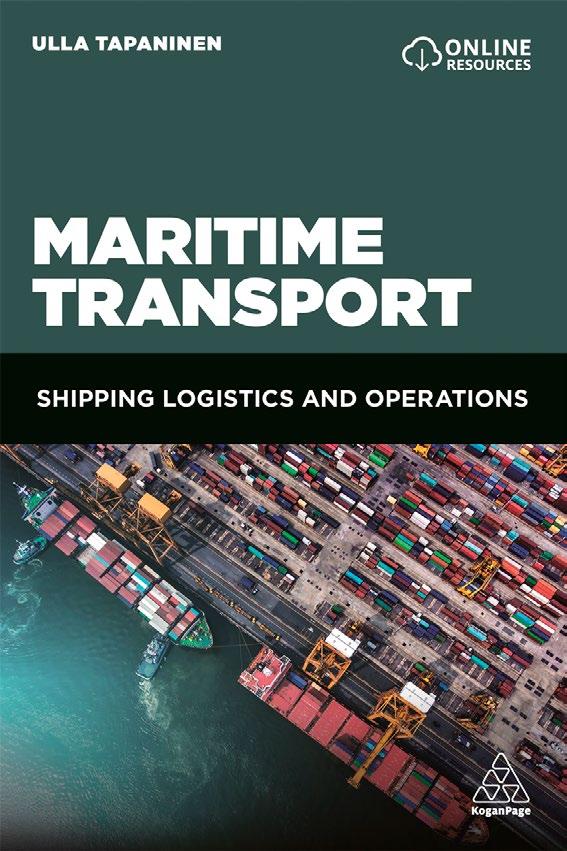
• Develop analytical skills to assess the role of logistics service providers and other stakeholders in international maritime transport and logistics
• Learn from insightful case studies covering topics such as: Gothenburg dry land transport; traffic between Helsinki and Tallinn; Russian transit traffic; IKEA transport operations; ship strategies: Greece vs Norway
Maritime transport is the transport of people or goods by water. It is the backbone of world trade and globalization. Twenty-four hours a day and all year round, ships carry cargoes to all corners of the globe.
Maritime Transport focuses on the operational side of this important industry, covering many topics such as sea traffic currents, passenger transport, short sea shipping and dangerous cargoes.
Parts one and two of Maritime Transport present the concepts, theory and background information, then part three presents more complex and deeper issues such as the maritime transportation of the future. It covers topics such as intelligent shipping, data exchange at sea and maritime security. In addition, the book includes fascinating case studies and examples, such as maritime transport in the Baltic sea, ship strategies in Norway and Greece and the benefits of slow steaming. At the end of each chapter there are questions that will help students to gain a deeper understanding of the many topics covered.
Ulla Tapaninen is a Senior Transport and Logistics Specialist for the City of Helsinki. She is also in charge of Helsinki City maritime cluster programme, focusing on the city's unique arctic and smart marine industry with start-up companies. She is an adjunct professor of maritime logistics and was previously at the University of Turku. She has worked in key positions in two Finnish shipping companies, Finncarries Oy Ab and ESL Shipping.
Edition: 1
Date: 05/28/2020
Price: $69.99
Paperback: 9781789662467
Ebook: 9781789662481
Pages: 224
Format (mm): 235x155
Band: Textbook
Subject: Maritime Logistics
• Provides a comprehensive overview of maritime logistics including all of the core concepts and latest research
• Examines the latest risks and threats within the port and shipping industry such as the propagation effects on port disruption, and how recent technological developments such as improved analysis of real time data information seek to prevent these risks
• New to this edition: updates on real time data to improve operational efficiencies, capacity optimization, scheduling and agility, asset utilization within port management, route planning, integration and KPIs in intermodal shipping
• Covers all trade facilitating elements to maritime transport and its value within global supply chains
Sea freight remains overwhelmingly the most common form of transport for goods globally. Grasp the core theories and understand the latest research in maritime logistics, along with how this field operates and contributes to global supply chains, with this key textbook.
Maritime Logistics provides a complete overview of the core concepts within this discipline from a range of international expert contributors. This textbook examines the recent developments in the ports and shipping industries including supply chain strategies and emerging, innovative practices. Designed for maritime students and professionals, the structure offers a complete approach with an emphasis on developing a well-rounded knowledge and understanding of the field.
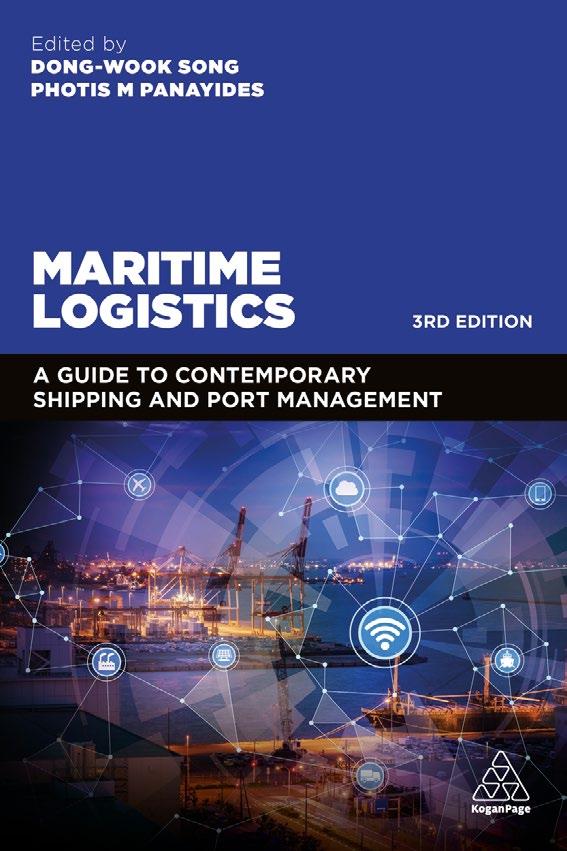
The third edition is fully updated with new content on maintenance optimization, supply chain integration, economies of scale within liner shipping and port performance and management. In addition, this edition examines new technologies, considers new and existing risks to the maritime supply chain as well as generally how maritime logistics will continue to evolve. For those seeking to become maritime logistics specialists, this is the authoritative companion.
Dong-Wook Song is Korean Chair in Maritime Affairs, Professor of Maritime Economics and Logistics and Head of Shipping Management and Logistics at the World Maritime University, Malmö, Sweden. He is Editor-in-Chief of WMU Journal of Maritime Affairs and has worked as consultant for a number of private and public organizations including the UN, OECD, ADB and World Bank
Photis M Panayides is Professor in Shipping Economics, Department of Commerce, Finance and Shipping at Cyprus University of Technology, Limassol, Cyprus. He serves on the editorial board of several academic journals and has served as Vice-President of the Board of Directors of the Cyprus Ports Authority and as member of the Council of the International Association of Maritime Economists.
Edition: 3
Date: 12/28/2021
Price: $65.95
Paperback: 9781789661699
Ebook: 9781789661705
Pages: 536
Format (mm): 234x157
Band: Textbook/ Professional
Subject: Maritime Logistics
1 Introduction
1 Introduction to maritime logistics
2 Maritime transport and logistics as a trade facilitator
3 International maritime trade and logistics
4 Defining maritime logistics and its value
5 Hinterland logistics and global supply chains
6 Human elements in maritime logistics
2 Shipping logistics
7 Intermodal freight transport and logistics
8 Global maritime networks in container shipping
9 Supply chain integration of shipping companies
10 Logistics strategy in container shipping
11 Tanker shipping logistics
12 Dry bulk shipping logistics
3 Port logistics
13 Dry ports in concept and practice
14 Port-centric logistics in concept and practice
15 Container hub ports in concept and practice
16 Multinationalizing container portsBusiness models and strategies
17 Public-private partnerships and port logistics performance
18 Port and logistics chains - Changes in organizational effectiveness
19 Logistics performance of supply chainoriented ports
4 Conclusion
20 Looking ahead

• Discusses the high commercial value of the seas and oceans and the current areas of technological development within the blue economy
• Explains how to target and capitalise on the potential for maritime innovation within specific areas
• Provides insights into important innovations such as spatial data infrastructures and hydrography for maritime economies; the evolution of eNavigation and GNSS vulnerability; near or real time situational awareness
• Presents case studies from organisations who have successfully integrated new technologies into their existing business models
Edition: 1
Date: 09/28/2019
Price: $65.99
Paperback: 9780749483951
Ebook: 9780749483968
Pages: 288
Format (mm): 234x158
Band: Professional/ Academic
Subject: Maritime Logistics
1 An introduction to the blue economy
2 Shipping
3 Ports and harbours
4 Offshore renewables
5 The cruise industry
6 Maritime surveillance
7 Aquaculture
8 Hydrography and bathymetry
9 Ocean observation
10 Sustainable fisheries
11 Subsea monitoring
12 Safety of life at sea
13 Conclusion
• Examines container logistics from the shippers perspective, tackling issues that are central to the role of organising and overseeing the transportation of goods and commodities, a unique angle which is not covered in other maritime transport books
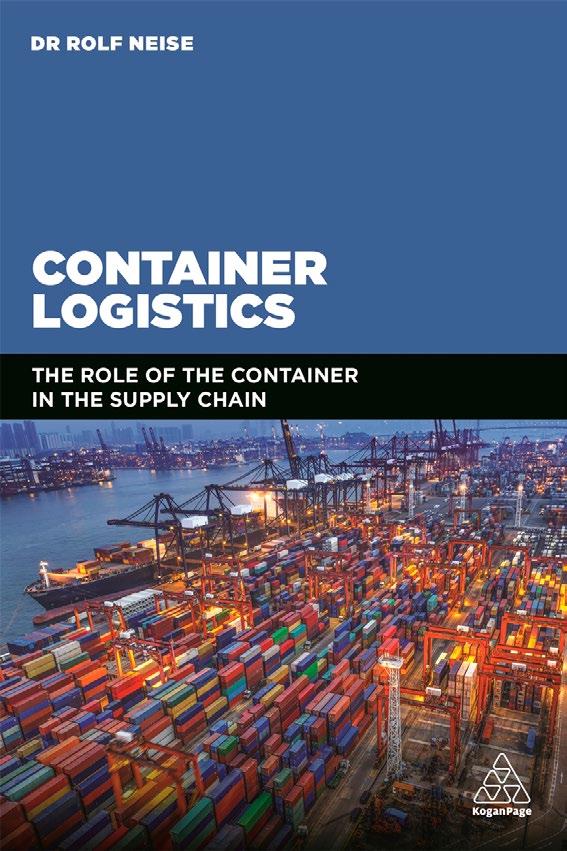
• Provides insights into ways of managing container logistics as an integrated part of a shipper's global supply chain covering planning, procurement and execution and collaboration of logistics activities
• Provides shared knowledge from a team of international contributors such as the CEO of Hamburg Port Authorities, the International Logistics Director of Michelin, the Senior Vice President of Global Customer Solutions, Kuehne + Nagel and the Global Procurement Director, Mondi
• Features research and innovations from the supply chain and the maritime business perspective, covering topics such as empty container logistics, terminal & port optimisation and intermodal freight
• Includes vital tools and case studies to help supply chain managers and shippers work more effectively in complex areas, such as design thinking and real-time data management
• Online resources: Powerpoints of key diagrams and tables and chapter summaries
Edition: 1
Date: 05/28/2018
Price: $79.99
Paperback: 9780749481247
Ebook: 9780749481254
Pages: 448
Format (mm): 235x155
Band: Professional/ Academic
Subject: Maritime Logistics
• Focuses on specific logistics and supply chain issues relevant to retail management
• Includes internationalization, corporate social responsibility and green logistics, and explores practical examples from Tesco and Schuh
• New to this edition: New material on the luxury fashion industry and the logistical challenges of e-commerce
• Features contributions from leading academics in the field and retail logistics practitioners
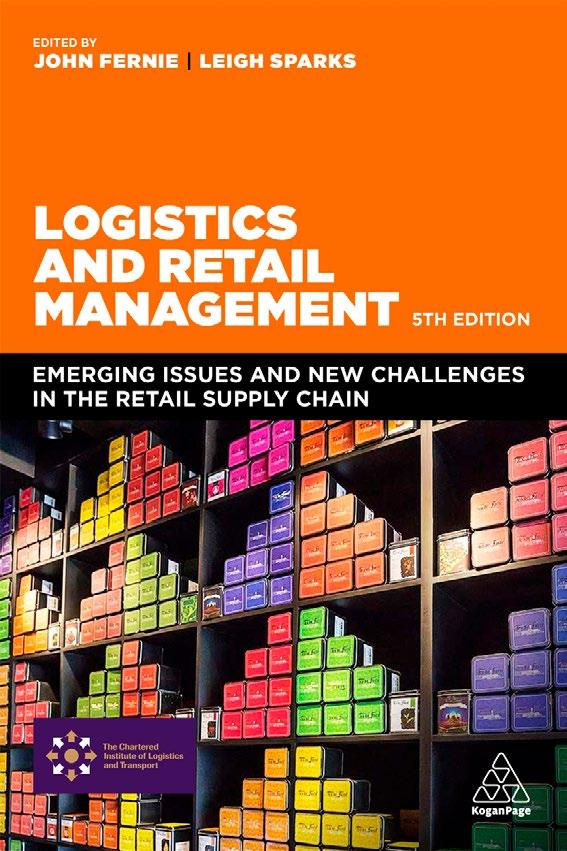
Logistics and supply chains play a vital role in the overall success of retail management. This fifth edition of Logistics and Retail Management covers the major strides made in retail logistics and the challenges which remain, providing students and professionals with the current thinking and research in this strategic field. Including chapters on internationalization, corporate social responsibility (CSR), and green logistics, the book also explores examples from successful organizations such as Schuh and Tesco.
Fully updated with the latest international developments and on-going changes in the field, Logistics and Retail Management, 5th edition is a multi-contributed collection from leading academics and practitioners and an expert editor team. The new edition also includes material on the luxury fashion industry and the logistical challenges of e-commerce. Logistics and Retail Management, 5th edition is the essential text for students of retail logistics and supply chain management.
John Fernie is Emeritus Professor of Retail Marketing at Heriot-Watt University, Edinburgh. He has written and contributed to numerous textbooks and papers on retail management, especially in the field of retail logistics.
Leigh Sparks is Professor of Retail Studies at the Institute for Retail Studies, University of Stirling, Scotland. He is on the editorial boards of several leading marketing and business journals.
Edition: 5
Date: 11/28/2018
Price: $79.99
Paperback: 9780749481605
Ebook: 9780749481612
Pages: 344
Format (mm): 234x156
Band: Textbook/ Professional
Subject: Retail Logistics & Supply Chain
1 Retail Logistics – Changes and challenges [John Fernie and Leigh Sparks]
2 Relationships in the supply chain [John Fernie]
3 The internationalization of the retail supply chain [John Fernie]
4 The international fashion supply chain and corporate social responsibility [Patsy Perry, John Fernie and Steve Wood]
5 The footwear supply chain – The case of Schuh [John Fernie and Colin Temple]
6 Supply chain strategy in the fashion and luxury industry [John Fernie and Patsy Perry]
7 Tesco’s supply chain management [Leigh Sparks]
8 On-shelf availability in UK retailing [John Fernie and David B Grant]
9 The development of e-tail logistics [John Fernie, Suzanne Fernie and Alan McKinnon]
10 The greening of retail logistics [Alan McKinnon and Julia Edwards]
• Explores retail supply chain and merchandising from the very basics, up to strategic and senior level challenges

• Includes an academic presentation of theories and models used to aid practical understanding
• Includes tools and case studies to help supply chain managers and merchant planners work more effectively
• Explores the differences between industries in retail (i.e. the supply chain function in a supermarket is different to a merchandising function in a fashion retailer)
• Bridges the gap between research-based texts and those aimed solely at managers
Buying, merchandising and the supply chain are inextricably linked. Product merchandisers play a key role within retail, as profits can be affected by how successfully they undertake their work. Merchandisers set prices to maximise profits and manage the performance of ranges, planning promotions and mark-downs as necessary. They also oversee delivery and distribution of stock and deal with suppliers. Their connection with and understanding of the supply chain is vital. Supported by theories, explanations and real-life examples, Managing the Retail Supply Chain looks at concepts and core themes that run across all sectors.
Many businesses use a one-size-fits-all solution for any issues which arise, leading to big problems. Managing the Retail Supply Chain presents numerous examples of different business models adopted by a variety of companies. Covering basic principles of retail supply chain, KPIs, merchandise planning and demand planning as well as omnichannel, vertical integration, on-shelf availability and e-commerce, Managing the Retail Supply Chain is an essential guide for anyone involved in or studying retail supply chains and merchandising.
James Topps has worked in retail supply chain for Kraft (Formerly Cadbury), Ted Baker and Morrison's. He currently heads up the merchandise planning (formerly supply chain) for Maplin Electronics, Rotherham.
Glenn Taylor is currently Merchandise Planning Director at Maplin Electronics. He has been Merchandise and Supply Chain Director in companies such as Dreams, B&Q and BonMarche, developing best practice through periods of expansion and growth for business on and offline, in the UK and overseas.
Edition: 1
Date: 01/28/2018
Price: $59.99
Paperback: 9780749480622
Ebook: 9780749480639
Pages: 288
Format (mm): 235x156
Band: Textbook/ Professional
Subject: Retail Logistics & Supply Chain
1 Introduction
2 Foundations of retail and supply chain and merchandising
3 Merchandise planning
4 Branch merchandising
5 Buying and sourcing
6 Logistics
7 Finance
8 Omni-channel retailing
9 Tools, reports and documents
10 Technology
11 Roles within supply chain and merchandising
12 Vertical integration and manufacturing
13 The fashion industry
14 Supermarket and food retail
15 Electronics retailing
16 Big ticket retailing
17 SME retail
18 Troubleshooting common issues in supply chain and merchandising
19 The future for supply chain and merchandising in retail
• Examines the real secrets of highly effective production processes in winning organizations, such as Rolls Royce, Toyota and Land Rover, as well as Tesco and Unilever
• Explains socio-technical systems and their design through in-depth case studies of best practice
• Investigates high performing organisations and their use of six sigma and lean manufacturing
• Presents tools to help managers improve processes and the sustainability of improvement such as sand cone models and the supportive model of manufacturing
• Online resources: powerpoint diagrams of models, as well as surveys and exercises
Many production managers have de-stocked excessively large inventories, gone lean, experimented with continuous improvement processes and introduced new working practices. These interventions have largely failed. Businesses have also failed to invest in the workforce that undertakes improvements. This means that cash flow stops quickly, stocks are depleted to zero and customers lose confidence.
Systems for Manufacturing Excellence looks at how people and technology work effectively together to generate high performance manufacturing and service operations. Not everyone is a Toyota but that does not mean we cannot learn from such businesses. The book will present a logic, variety of approaches and methods that underpin the different models of high performance used by 'world class' businesses. The authors use examples from their training with Toyota, work with Tesco, and many world class manufacturing businesses that form their research agenda. The book will help teams run each part of their production process for effectiveness and efficiency, with a high level of discipline that supports excellence in performance.

Nick Rich is Professor of Operations Management at Swansea School of Management. He teaches Socio-Technical Systems Design. Nick Rich is a Fellow at Toyota Motor Corporation of Japan.
Mohamed Afy-Shararah is an industrial engineer experienced in the manufacturing and distribution sectors. He was awarded his doctorate in strategic operations management and received formal training at the Toyota Lean Management Centre.
Edition: 1
Date: 01/28/2020
Price: $55.99
Paperback: 9780749496999
Ebook: 9780749497002
Pages: 344
Format (mm): 235x155
Band: Textbook/ Professional
Subject: Manufacturing & Production
1 Operational excellence
2 The real issues and DNA of winning organizations
3 Socio-technical systems and their design
4 High performing organizations (six sigma and lean)
5 TPM and maintaining (reliability focused and OEE-based flow improvement)
6 Highly reliable organizations (organizational level pre-occupations)
7 Operations management by design of new processes
8 The safety case
9 Improving processes and the sustainability of improvement
10 The new agenda for change
11 Conclusions
• Presents the theory behind international standards and their application in industry, with case studies from Bosch, BP, M&S, Bodyshop, Toyota, Tesco, McDonalds, Benetton and Royal Mint.
• Looks at how product and technical standards have evolved to help shape the way in which we manage entire businesses and their interactions with customers, suppliers and the consumer
• Introduces examples of standards working in practice, resulting in safer ways of working, better health and safety, better quality, better regulatory compliance, better environmental performance
• Includes insightful seminar topics and sample exam questions.
• Online resources: Full lecture slides for seminars as well as links to videos and revision materials for students
International standards ensure that organisations operate the right processes to support their objectives. International Standards for Design and Manufacturing is an accessible guide for manufacturing and production managers and students. It guides readers through the standards needed to build operating systems which are robust, integrated and used to drive the continuous improvement of business performance.
International Standards for Design and Manufacturing is based on many years of research collaboration between Swansea University and leading manufacturing and production practitioners from key companies from around the world. Each chapter includes an introduction to the standards being discussed, definitions, examples of using the standards in practice, why these standards are important, conclusions, seminar topics and mock exam questions to allow the reader to test their knowledge and understanding.

Nick Rich is Professor of Socio-Technical Systems Design at Swansea School of Management. He is an academic with a specialist interest in high performance and highly reliable businesses. He has gained international acclaim and has received a significant number of awards for his research work.
F. Tegwen Malik is an academic at Swansea University and focuses her research on biomimetics, product design and innovation (for all applications including the life sciences sector) and the application of international management standards to industry and service sectors.
Edition: 1
Date: 11/28/2019
Price: $62.99
Paperback: 9781789660425
Ebook: 9781789660531
Pages: 368
Format (mm): 231x155
Band: Textbook/ Professional
Subject: Manufacturing & Production
1 The importance of standards
2 The evolution of Total Quality Management (TQM)
3 Introduction to management system standards
4 Quality management system standards
5 Operational excellence (OpEx)
6 Environmental management systems standards (EMS)
7 Occupational health and safety management systems
8 Information security management
9 Business continuity and uninterrupted product flow
10 Supply chain management, design and international standards
11 Developing a learning organization and auditing
12 Leadership and international standards
13 Implementation, resistance to change and sustaining change
14 Conclusions and looking forwards
• Explains how to design and manufacture products that meet the diverse needs and demands of customers, covering a number of different industries, such as textiles, automotive, electronics, aerospace and retail
• Describes how to compete in a global market by integrating product design into the supply chain and looks at key issues, such as resource footprints and risk
• Provides valuable insights from leading businesses who are known for their successful product design, such as Egil Moller Nielsen, former Group-Vice President for Global Distribution and Logistics at LEGO
Product design touches every aspect of modern life, determining the form and function of the products and technologies that we use every day. Product design is not just concerned with the appearance and functionality of products; it has an important role in determining the cost, pricing, risk and profitability profile of those products. Product Design and the Supply Chain shows how decisions taken at the design stage of a product's life cycle go on to affect that product's subsequent value to a company. Eighty percent of a product's eventual supply chain costs are already present at the early stages of product design and development. This book allows companies to make informed design decisions that have significant positive through-life implications for risk, complexity and responsiveness, thus allowing them to create a 'moat' that is difficult for competitors to sidestep or surmount.
Product Design and the Supply Chain contains fascinating content applicable to industry. It is full of useful and insightful real-life cases and examples. This book sets out to show how design impacts: sales revenues, pricing, time to market, manufacturing and supply chain costs, supply chain risks, brand loyalty, and competitiveness.
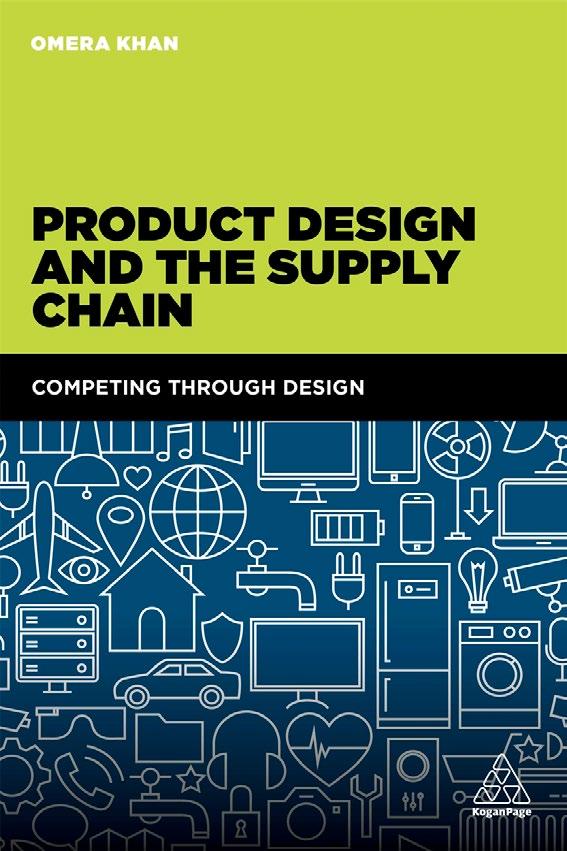
Omera Khan is Professor of Supply Chain Management at Royal Holloway University of London. She's also a Visiting Professor at the University of Agder in Norway and adviser in logistics and supply chain management to many other universities around the world. She is internationally recognized in the fields of supply chain risk management, supply chain resilience and cyber risk, supply chain responsiveness, sustainability and the impact of product design. Omera Khan's work in this area has been widely published in practitioner articles and academic publications.
Edition: 1
Date: 12/28/2018
Price: $59.99
Paperback: 9780749478230
Ebook: 9780749478247
Pages: 264
Format (mm): 234x154
Band: Professional/ Academic
Subject: Manufacturing & Production
1 Setting the design agenda
2 The interface between product design and the supply chain
3 Product design and supply chain risk
4 Product design and the pursuit of agility
5 Product design and sustainability
6 Building bridges – Making the change
• Provides extensive guidelines to the key parameters used when planning inventory at the detailed item operational level and tools required to plan inventory at a strategic level.
• Presents case study examples to provide broader understanding of tools and techniques and to demonstrate where each tool is best applied
• Includes a comprehensive list of tools used in inventory planning, essential for both students and practitioners
• New to this edition: chapters on balancing and control, inventory stack and flow, future developments in inventory management and new tools and case studies.
• Online resources: supporting excel spreadsheets to aid understanding and implementation of inventory planning, with ready-to-use formulae.
Looking beyond the complexity and theory of inventory management, authors Geoff Relph and Catherine Milner examine managing inventory and achieving targets. Whilst the first edition mainly focused on planning, this new edition of The Inventory Toolkit includes three new chapters that go beyond planning to implementation. Amongst other topics, the new chapters cover holding and moving inventory, working with suppliers and using stack and flow to identify pinch points and facilitate lean and agile operations.
This comprehensive second edition of The Inventory Toolkit includes case studies from diverse industries such as retail and aerospace, and worked examples and regular exercises which illustrate how the inventory tools can be used in an operational setting. It is an invaluable reference guide for students and practitioners focusing on inventory management and operations management in manufacturing and retail, as well as operational staff involved in the implementation of the MRP and inventory management modules of ERP systems.
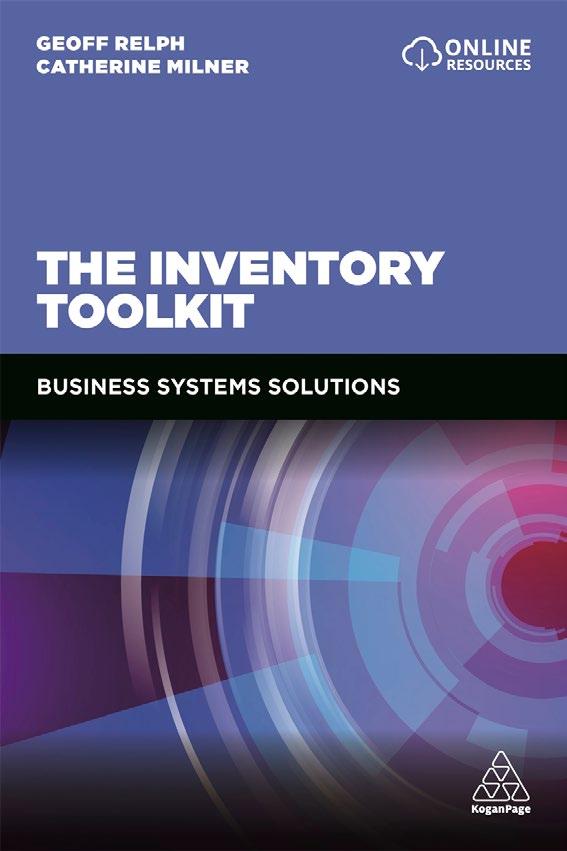
Geoff Relph has extensive experience in inventory and business systems management in the operational, consulting and academic sectors. He is an associate lecturer at the Warwick Manufacturing Group, University of Warwick, UK, and delivers modules for the MSc Programme in the UK and internationally.
Catherine Milner is a chartered engineer and project manager with experience working in aerospace, petrochemicals and telecommunications. She has managed many successful projects on electronic data exchange with customers, forecasting, MRP, supply chain management, and business process re-engineering. She is a managing consultant, and a visiting lecturer at the University of Warwick.
Edition: 2
Date: 07/28/2019
Price: $55.99
Paperback: 9780749482121
Ebook: 9780749482138
Pages: 448
Format (mm): 239x171
Band: Professional/ Academic
Subject: Operations Management
Introduction
1 Introduction to inventory management
2 Business systems and business
3 Inventory balancing and control
4 The complexity of inventory management within business systems
5 Stack and flow inventories
6 Traditional thinking in inventory optimization
7 k-curve methodology
8 The practical application of k-curve
9 Case study examples of k-curve planning approach
10 Review, summary and what to do next
11 Appendix A
12 Appendix B
13 Appendix C
14 Useful websites
15 Index
• Shows how effective operations can have a huge strategic impact throughout the organization
• Provides guidance on how to respond to the most important challenges facing the practice of operations management
• Offers direction on how to set the agenda for developing operations capabilities
Edition: 1
Date: 04/28/2017
Price: $45.99
Paperback: 9780749473549
Ebook: 9780749473556
Pages: 312
Format (mm): 233x158
Band: Professional/ Academic
Subject: Operations Management
1 Exploit the Power of Operations
2 Establish an Operations Capability Culture
3 Make Operations a Strategic Asset
4 Set Your Performance Framework
5 Resource Your Operation Appropriately
6 Establish Internal Processes Networks
7 Shape Your External Supply Networks
8 Learn from Day-to-day Control
9 Setting Improvement Priorities
10 Position Your Improvement Process
11 Master the Mechanics of Improvement
The study and practice of operations has shifted to reflect the new challenges and uncertainties of how to thrive in today's ever-changing world. The Operations Advantage identifies the most significant challenges to the practice of operations management and gives guidance on how businesses can respond. Leaders need to link the strategic objectives of the business clearly and logically to its operations performance objectives. The book presents a series of ten activities that will help them to do this and therefore make operations work better, such as designing and configuring internal processes and resourcing the operations appropriately.
Based on the global teaching, training and consultancy conducted by the author, The Operations Advantage looks at the application of operations management across a range of sectors, including finance, healthcare, professional services, oil and gas industries. Although these diverse sectors require operations practitioners to apply knowledge in different ways, they essentially deal with the same set of processes. The book is an indispensable and unique guide for anyone with an operational role in any organization, as well as operations management students and academics.
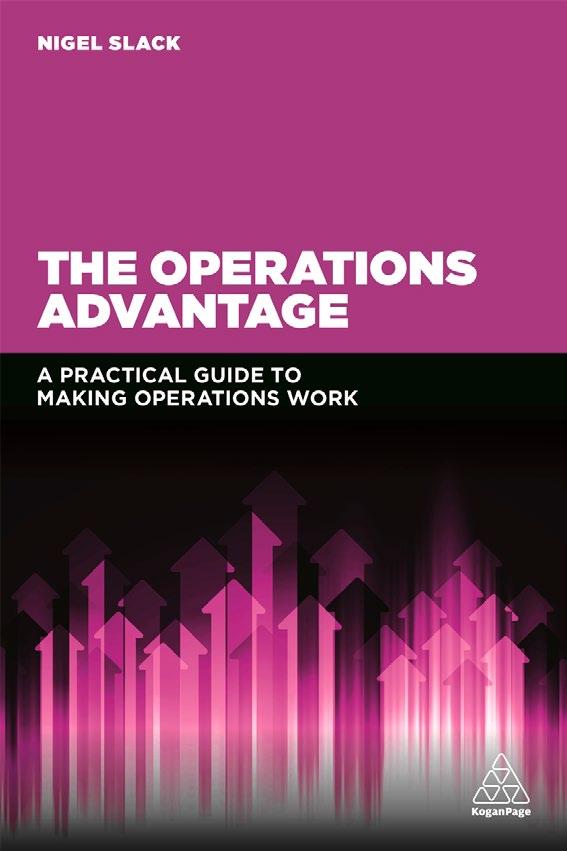
Nigel Slack is Emeritus Professor of Operations Management and Strategy at Warwick Business School, Coventry, UK and the former head of its Operations Management Group. He acts as a consultant in many sectors, including Financial Services, Utilities, Retail, Professional Services, General Services, Aerospace, FMCG, and Engineering Manufacturing.
• Looks at common strands that can inform strategy from a practical operating perspective
• Highlights the core fundamentals that business leaders should be guided by in order to achieve organizational success
• Offers a framework for achieving super performance
Most successful companies have operations management at their heart. It enables strategy and should be part of boardroom discussions. However, Cranfield research has shown that business strategy barely recognises the world of operations management.
Recognising that operations management needs to be more strategic, Business Operations Models is a revolutionary new title that looks at the interrelationship of operations management and strategy.
In Business Operations Models, Martin Christopher and Alan Braithwaite identify the characteristics of market-leading businesses that have transformed their markets and delivered super performance for their stakeholders. It points to the theory gap between strategic thinking and operations and how many high-performing businesses arrive at their new operating models as much by chance as judgement. Unpacking those observations leads to some clearly defined features of winning competitors, including eliminating waste, leveraging technology, and utilising transformative business models. Business Operations Models offers a framework for achieving super performance and understanding when and how a company may be able to leverage its capabilities to outperform.

The book provides detailed international case studies that illustrate how the principles work in practice, including Apple, Dell, Amazon, John Lewis, Southwest Airlines, Aldi, Toyota and many others.
Alan Braithwaite is Visiting Professor at Cranfield University and specializes in supply chain strategy and operational excellence in the retail, manufacturing and service sectors. He is the founder of LCP Consulting, which collaborates with over 400 companies internationally.
Martin Christopher has been at the forefront of the development of new thinking in logistics and supply chain management for over 30 years. He is Emeritus Professor of Marketing and Logistics at Cranfield University, where he helped build the Centre for Logistics and Supply Chain Management into a leading centre of excellence. His published work is widely cited by other scholars and he has been invited to participate in academic and industry events around the world.
Edition: 1
Date: 05/28/2015
Price: $45.99
Paperback: 9780749473310
Ebook: 9780749473327
Pages: 264
Format (mm): 235x155
Band: Professional/ Academic
Subject: Operations Management
1 What we mean by business operations models – and why are they important?
2 The characteristics of super-performing businesses
3 The customer lens – understanding compelling value
4 The strategy operations gap
5 Unpacking the business operations model framework
6 The technology dimension to being a disruptor
7 Market-changing models – driving transformation
8 Competing through the basics
9 Optimization of the business operations model
10 Making it happen – becoming a disruptor
11 Guiding principles to building a competitive edge through business operations models
• Shares wisdom from one of the most respected academics in the field and a team of contributors who are both academics and industry experts
• Covers purchasing concepts, frameworks and best practice from esteemed business school HEC Paris
• Covers strategic and tactical standpoints, including strategic thinking and specific thought processes
• Shows how to optimise specific aspects of purchasing
Strategic Sourcing Management examines procurement and supply management in detail, covering the three dimensions of competitiveness, effectiveness and efficiency. Written by Olivier Bruel, Professor Emeritus HEC Paris, and a team of contributing experts from academia, consulting and industry, the book is organised into four parts: strategic decisions; operational management of procurement and related supply chain; management of human resources and dedicated information systems; management of performance and change.
This book has been written with a comprehensive global and coherent approach but the chapters are self-standing, enabling the reader to dip into different sections according to need. Strategic Sourcing Management considers both tactical and strategic perspectives that link with a corporate strategy and it includes dedicated chapters on how to set up a Strategic Sourcing function. The text is enriched with clear graphics and solid examples of best practice. Strategic Sourcing Management is a robust text based on both research and experience, so an essential reference for practitioners and academics working in or studying procurement and supply management. It is suitable for anyone involved in procurement and supply management at a senior level but also for general management enabling them to understand the mechanisms of value creation through Strategic Sourcing.
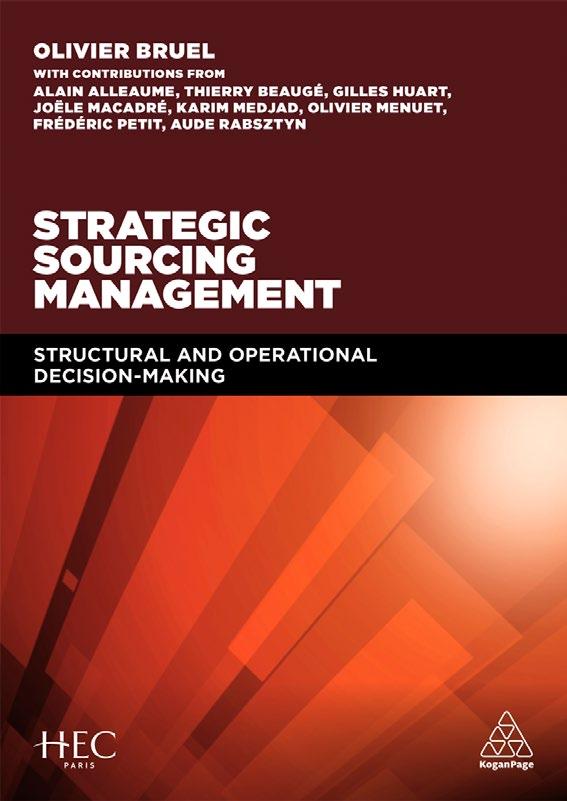
Olivier Bruel is Professor Emeritus of the Information Systems and Operations Management Department at HEC Paris. He has also been conducting many consulting activities and is Founder and and Honorary President of the ACA (Association Cesa Achats et Supply Chain).
Edition: 1
Date: 12/28/2016
Price: $84.99
Paperback: 9780749476991
Ebook: 9780749477004
Pages: 720
Format (mm): 239x170
Band: Textbook
Subject: Procurement
1 Strategic decisions and supplier policies
1 Procurement: its integration in a company’s general strategy
2 Procurement marketing: segmentation and strategies
3 Definition of requirements and upstream procurement practices
4 Supplier policy: sourcing, panel and SRM
5 Globalization and international procurement
6 Sustainable procurement: stakes and implementation
7 Outsourcing, “make-or-buy” decisions and simple subconctracting
2 Operational management of procurement
8 Quantitative forecasting and requirements planning
9 Economic optimization: tco minimization, service level for internal clients and shared cash management
10 Calls for tenders: major stages, selection process and post-procurement follow-up
11 Procurement of services CAPEX procurement
12 The financial stakes of procurement: mechanisms for protecting currency and energy and commodity purchases
13 Public procurement: French and European contexts
14 The practice of international operations
15 International procurement: legal considerations
3 Organization and management of resources
16 Organization, structure and positioning of the procurement department
17 Procurement professions and humanresources management
18 Procurement information systems and dedicated web tools
4 Section - FOUR: Performance and change management
19 Procurement communication plan
20 Procurement performance: measurement indicators and reporting systems
21 Procurement performance: steering change management
22 The co-authors
23 Glossary
• Explores the extraordinary global sourcing methods of IKEA, one of the largest and most influential companies in the world
• Presents practical guidelines on how purchasing teams can real create value and tangible results in category sourcing
• Looks at how category sourcing, beyond the initial consolidation of the supplier base, can be successfully implemented and managed
• New to this edition: focus on Ikea as a good example of how to create cost leadership by creating value, exploration of new ways of helping practitioners to really understand the fundamental ideas in category sourcing, and not just rely on models and processes, with case studies from Maersk, Carlsberg, P&G and Aldi
How is it possible to sell a kitchen at 30 per cent below market price? Why are hot dogs cheaper in IKEA than in the supermarket? How can IKEA sell the Lack table at half the price it was when it was launched 35 years ago and how can it be achieved with a substantial profit?
Strategic Sourcing and Category Management examines how IKEA - and other cost leading companies - use category management to create advantages with direct and indirect sourcing. With 25 years' experience from IKEA, where he had the responsibility to develop and execute the company's purchasing strategy, author Magnus Carlsson shares his insights on important topics: when category management is profitable and why; how teams repeatedly create value and results; what the main approaches are in different categories; how a company implements category management; the difference between success and failure.
In this new edition of Strategic Sourcing and Category Management, Magnus Carlsson has added new themes including examples and references from companies such as Maersk, Carlsberg, P&G and Aldi, illustrating the application of cost leadership that spans far beyond IKEA. Even there, the cost leadership lessons are not limited to home furnishings as the company is sourcing categories such as food, components, materials, transports and indirect materials, with a total purchasing spend of approximately €7 billion. But maybe even more importantly, the book illustrates how teams create value by thinking differently and asking the right questions, allowing an understanding that goes beyond mere tools and processes.
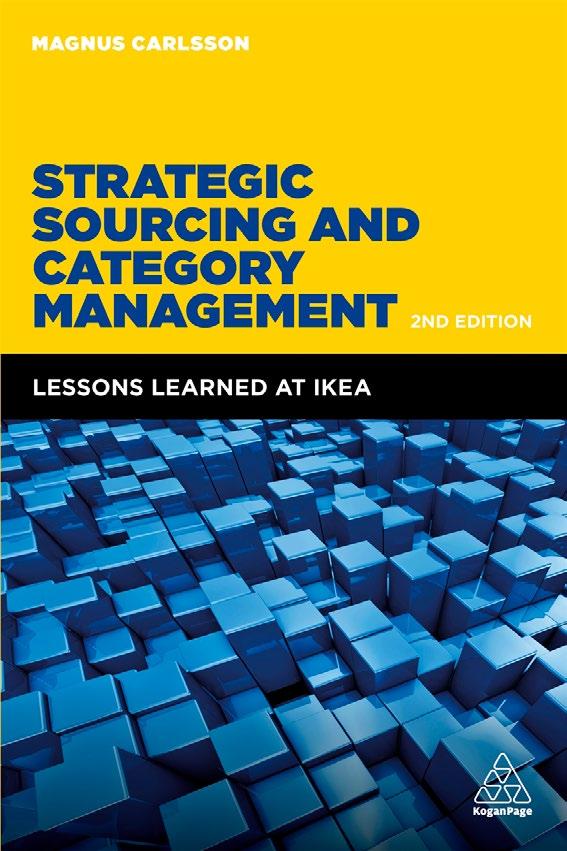
Magnus Carlsson has 25 years' experience as a strategic sourcing expert at IKEA. He also has 10 years' experience with leadership and training within the Swedish defence forces and is an advisor in strategic sourcing for Kingfisher.
Edition: 2
Date: 05/28/2019
Price: $59.99
Paperback: 9780749486211
Ebook: 9780749486228
Pages: 296
Format (mm): 235x156
Band: Professional/ Academic
Subject: Procurement
Introduction
1 Lessons learned at Ikea
2 What is category management?
3 Leading category sourcing
4 The hunt is on
5 Where is the money?
6 Creating value
7 The moment of truth
8 Control performance and create more value
9 Different categories and other perspectives
10 From theory to practice
11 Success or failure?
12 Appendix tools and models
13 Notes
14 References and further reading
• Provides a holistic, non-technical view of the strategic sourcing process for complex technologies
• Presents clear explanations of the end-toend costing model for digital buying, tied to a service lifecycle, project milestones and deliverables, illustrated with case studies
• Enables procurement managers to gain vital digital and analytical skills, helping them to realize business innovation and growth
• Online resources: sample audit sheets, workflows and checklists
With the rise of cloud services and the digitization of all business units, procurement managers need to understand how to buy technology services in order to generate revenue, drive innovation and retain customers.
The Technology Procurement Handbook provides a structured and logical view of the digital buying process. It includes invaluable advice on how to manage digital demand, prepare sourcing strategies, analyze the cost and benefits of proposed solutions and negotiate and implement comprehensive agreements.
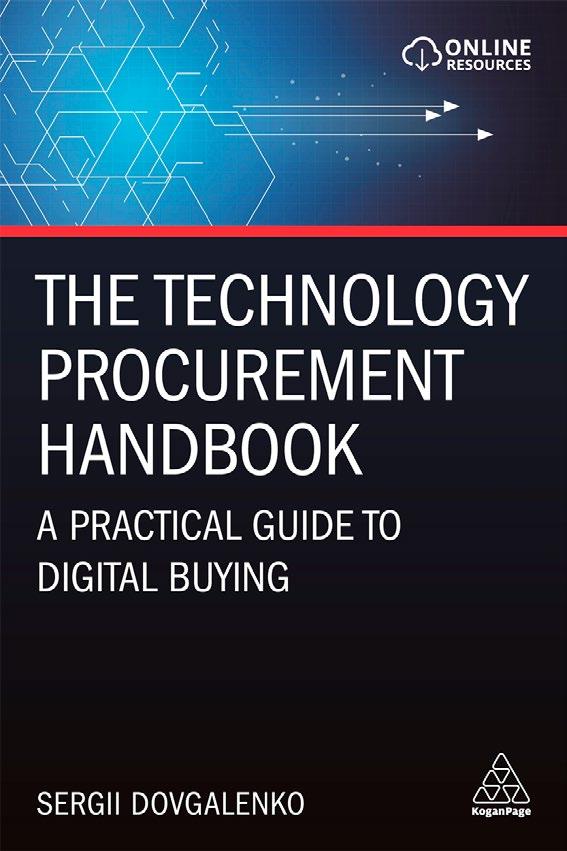
The Technology Procurement Handbook examines the multiple streams of data that feed into the technology procurement process, such as ITIL service lifecycle data, PMI project management and cloud and software contract provisions. The book includes case studies and extensive practical advice based on the authors experience from recent procurement projects. There is also a chapter on modular contracting for the US market, explaining the use of agile contracts for IT projects.
Sergii Dovgalenko is the CPO at Ukrainian Railways. He specializes in technology procurement and used to manage IT category portfolios across multiple companies and geographies. His recent projects included full procurement support of new digital sales and communication channels, Agile development outsourcing from major Indian and Easter European hubs, SAP and Ariba implementation, various procurement transformation initiatives and many more.
Edition: 1
Date: 04/28/2020
Price: $69.99
Paperback: 9781789662108
Ebook: 9781789662115
Pages: 328
Format (mm): 235x157
Band: Professional/ Academic
Subject: Procurement
1 Setting the scene for the next-generation technology procurement
2 Four pillars of technology procurement
3 Technology basics for procurement professionals
4 Relationship management in procurement
5 Deep dive into the procurement process
6 Practical advice and case studies on technology procurement
7 US legislation and regulation on agile deployment and contracting and performance-based management
8 Procurement 3.1 – Agile, lean, and value delivery today
9 Conclusion
• Features interviews with supply chain leaders working in a range of industries, who share new insights and practical recommendations
• Explores how to drive performance and margin improvement in a sustainable and ethical way
• Outlines how to turn the theory into an action plan with a comprehensive toolkit of tried and trusted strategic sourcing techniques and processes
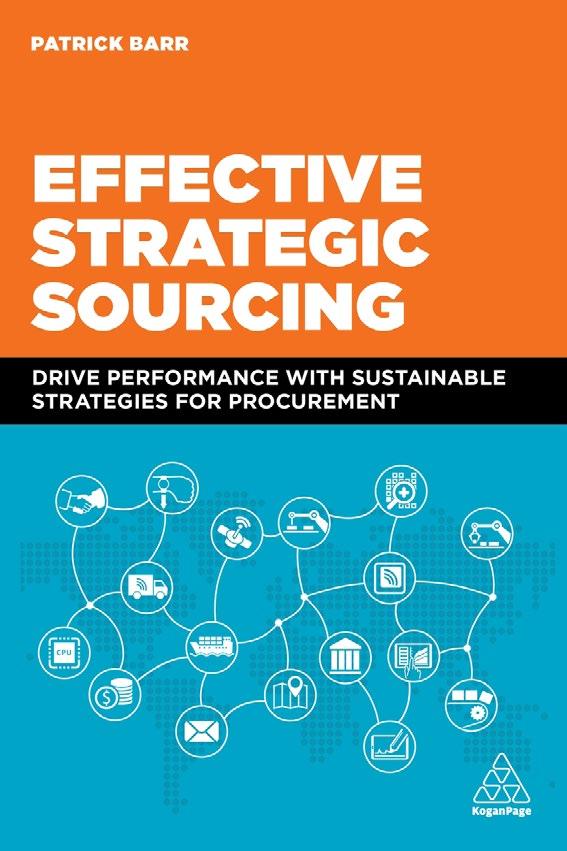
• Explains how to design and implement a sourcing strategy, from establishing success criteria through to supplier performance management
• Online resources: PowerPoint slides for lecturers
Modern supply chains are enjoying new opportunities for innovation and growth. Build competitive advantage, optimize cost and encourage ethical business practices with the process of strategic sourcing.
Effective Strategic Sourcing brings together tools and techniques to develop comprehensive sourcing strategies and drive performance and margin improvement in an ethical, environmentally responsible way. From supplier research and risk analysis to category management and cost modelling, it answers key questions around make versus buy, outsource versus insource and RFI versus RFP.
Top supply chain leaders from a range of industries offer their insights and experience in interviews covering the challenges inherent in modern strategic sourcing. The book also focuses on how supply chain and procurement professionals can address sustainability concerns by thinking globally and acting locally and aiming for net-zero carbon footprint sourcing. Learn from the experts and thrive in the 'new normal' with this essential guide to maximising the benefits of strategic sourcing.
Patrick Barr is the owner and Managing Partner of Barr Performance Coaching, based in Greater Dublin, Ireland. He has over 30 years' international experience in supply chain operations, strategic sourcing and strategy management, and previously held senior supply chain roles at Microsoft, Diageo and British Airways. His current clients range from micro SMEs to major multinationals. He is a Faculty member at the Irish Management Institute and is also the author of The Successful Career Toolkit, published by Kogan Page.
Edition: 1
Date: 06/28/2022
Price: $56.24
Paperback: 9781398605541
Ebook: 9781398605558
Pages: 256
Format (mm): 234x156
Band: Professional/ Academic
Subject: Procurement
1 Establishing strategic sourcing success criteria
2 Supply market research
3 Supplier research
4 Make versus buy decisions
5 Outsource versus insource
6 Supply risk analysis
7 Category management
8 Thinking local acting global
9 Zero carbon footprint sourcing
10 RFI versus RFP
11 Strategic sourcing tools and techniques
12 Ecosystem mapping and value chain dynamics
13 Cost modelling and pricing models
14 Sustaining competitive pricing over time
15 Advanced negotiation skills
16 Supplier performance management
• Includes essential tools and templates for practitioners to apply category management and deliver value when sourcing and purchasing
• Combines procurement theory and practice through case studies including IKEA, The Body Shop, the UK's National Health Service (NHS), Heinz and GlaxoSmithKline
• Allows readers to analyse complex sourcing situations quickly and clearly while developing innovative proposals for sourcing
• New to this edition: contains guidance on how category managers can implement sustainability effectively within their strategies and how practitioners can integrate technological advancements, like digital sourcing platforms, into their day-today operations
Approach purchasing and procurement strategically, effectively and sustainably, with this comprehensive and practical guide to category management.

Category Management in Purchasing equips those working in procurement with the tools they need to ensure effective purchasing in a time of rapid modernization. Combining practical advice and theory, this essential resource is crucial for developing successful purchasing strategies. Covering new technology-driven approaches to category management, this new edition outlines digital transformations and technological advancements, from digital sourcing platforms to new tools and systems.
This edition also provides readers with the knowledge to approach complex sourcing situations not only effectively, but also sustainably. Including new guidance on how organizations and businesses can implement sustainability into their procurement strategies, Jonathan O'Brien recontextualizes category management in a time when responsible sourcing is more important than ever. This highly regarded and essential text provides what everyone in procurement needs when striving to make category management a reality.
Jonathan O'Brien is the CEO of Positive Purchasing Ltd, based in Plymouth, UK. With over 30 years of experience, he has helped global organizations increase their purchasing capability through training, education and working directly with practitioners and executive teams. He is the author of Negotiation for Procurement and Supply Chain Professionals, Supplier Relationship Management and Sustainable Procurement, all published by Kogan Page.
Edition: 5
Date: 03/28/2024
Price: $59.99
Paperback: 9781398613799
Ebook: 9781398613805
Pages: 552
Format (mm): 234x156
Band: Professional/ Academic
Subject: Procurement
Introduction
1 Introducing category management
2 The principles of category management
3 Laying the groundwork for success
4 Stage 1 – Initiation
5 Stage 2 – Insight
6 Stage 3 – Innovation
7 Stage 4 – Implementation
8 Stage 5 – Improvement
9 Making category management happen
10 Guaranteeing success – Now and for the future
• Provides clear guidance on all aspects of managing suppliers to demonstrate how effective relationships that maximize value and success in business can be formed and maintained
• Explains 'The Orchestra of SRM®' proven framework for developing successful supplier relationship management programmes alongside practical tips and tools for real world application
• Outlines how to manage supplier segmentation and put in place interventions unique to each supplier
• New to this edition: how working practices have changed in supplier relationship management due to COVID-19 and the implications moving forward, information on the future of the supply base, updates on how to practically develop strategic collaborative relationships and implement supplier innovation
Effective supplier relationship management enables organizations to unlock value from their supply base and reap tangible benefits. With practical tips and a proven approach, this is the guide to understanding how to maximize the potential of suppliers to gain a competitive advantage, get more innovation and drive sustainability.

Supplier Relationship Management explains the importance of ongoing supplier management, how to measure and improve their performance, and for the critical few that can make a dramatic difference to our organization, drive in and future-proof strategic collaborative relationships. The Orchestra of SRM® framework, coupled with expert tips, tools and resources, delivers clear guidance on how to design an effective supplier relationship management program, with maximum return on time and investment.
Written by leading procurement expert, Jonathan O'Brien, this third edition offers new content on how to adapt to the huge changes we have seen across supply bases in recent years, and the new risks and challenges organizations face in managing key suppliers. It includes new information on driving sustainability, the future of the supply base, and how to secure more innovation from our suppliers. Supplier segmentation is outlined in more detail and there is new information on how companies are managing supply chains, and the impacts of this in practice. A practical guide to unlock the new value from your key suppliers in a changing world.
Jonathan O'Brien is the CEO of Positive Purchasing Ltd, the international procurement and negotiation consultancy and training provider, and is based in Plymouth, UK. With over 30 years of experience working in purchasing, he has worked all over the world to help global organizations increase their purchasing capability through online and classroom training, education and working directly with practitioners and executive teams to drive the adoption of supplier relationship management and other strategic purchasing methodologies. He is also the author of Category Management in Purchasing, now in its fourth edition, The Buyer's Toolkit, and the award-winning title Negotiation for Procurement and Supply Chain Professionals, now in its 3rd edition, all published by Kogan Page
Edition: 3
Date: 01/28/2022
Price: $65.95
Paperback: 9781398602250
Ebook: 9781398602267
Pages: 504
Format (mm): 233x155
Band: Professional/ Academic
Subject: Procurement
Introduction
1 What we need from our supply base is...
2 Five good reasons to get close to our suppliers
3 Introducing the Orchestra of SRM
4 Segmenting the supply base
5 Supplier performance measurement
6 Building a supplier performance measurement system
7 Acting upon measurement
8 Supplier improvement and development
9 Supplier management
10 Contract management
11 Relationship management
12 Supply chain management
13 Strategic collaborative relationships
14 Innovation from suppliers
15 The Orchestra of SRM is ready to play
16 Glossary
• Offers a ground-breaking new approach to delivering winning negotiations in procurement and supply chain management

• Provides the vital tools and comprehensive tactics for a detailed, planned approach to negotiation
• Helps purchasers to evaluate a supplier in advance, assess the sales team, and tailor their negotiation strategy
• New to this edition: changing themes in procurement such as near shoring, update of contextual global factors to negotiation.
Highly effective negotiation skills are an essential element of a purchasing and supply chain professional's toolkit.
Negotiation for Procurement and Supply Chain Professionals provides a step-bystep approach to delivering winning negotiations and getting game-changing results. It provides purchasers and supply chain managers with the necessary tools and tactics for a detailed, planned approach to negotiation.
Negotiation for Procurement and Supply Chain Professionals allows the purchasing professional or the buying team to evaluate the supplier in advance, assess the sales team, and tailor their negotiation strategy depending on concession strategies, cultural influences and game theory. Negotiation for Procurement and Supply Chain Professionals provides a strong framework for discussion in advance of the meeting, allowing the negotiator to plan their agenda, objectives and tactics. Based upon the Red Sheet® Methodology, this book is a proven and collaborative technique used by many companies globally. The new edition includes supply chain planning, updates on multi-party negotiation for supply chain negotiations, Brexit as a retrospective example of negotiation and how the negotiation capability will need to change in the future.
Jonathan O'Brien is the CEO of Positive Purchasing Ltd, the international procurement and negotiation consultancy and training provider. With over 30 years of experience working in purchasing, he has worked all over the world to help global organizations increase their negotiation and purchasing capability through training, education and working directly with practitioners and executive teams to drive in the adoption of negotiation and other strategic purchasing methodologies. He is also author of Supplier Relationship Management, now in its second edition, The Buyer's Toolkit and Category Management in Purchasing, now in its fourth edition, all published by Kogan Page.
Edition: 3
Date: 08/28/2020
Price: $69.99
Paperback: 9781789662580
Ebook: 9781789662597
Pages: 480
Format (mm): 235x157
Band: Professional/ Academic
Subject: Procurement
1 Introducing negotiation
2 Countering the seller advantage
3 Red sheet
4 Planning the negotiation
5 Negotiation across cultures
6 Personality and negotiation
7 Power
8 Game theory
9 Building the concession strategy
10 The negotiation event
11 Winning event tactics
12 Body language
13 Managing what you say and how you say it
14 Post-negotiation activities
15 Negotiation as a key enabler for success
16 Appendix - The Red Sheet negotiation templates
• Provides an overview of contracting logistics and the complexities of procurement and acquisition
• Gives clear guidelines for successfully planning, negotiating and managing a contract
• Features interesting examples of successful procurement projects from different industries, such as defence, aviation and ship building.
• Includes case studies from Ministry of Defence, Heathrow Airport and Cross-Rail based on the author's experience of leading the procurement and acquisition projects.
• Online Resources: contract templates for procurement and acquisition projects
The role of a contracting professional begins well before the award of a contract and doesn't end until the benefits of the acquisition have been realised, long after the deliverables arrive in a box on a loading dock. Global Contract Logistics tackles the growing complexity of contracting in a technologically accelerating world. The author looks at the common errors and the ten phases of a successful acquisition.
Global Contract Logistics examines what it takes to be an intelligent client, one who employs contracting or procurement professionals to obtain goods and services on their behalf. It debunks many commonly held myths involving contracting, procurement and acquisition and outlines ten vital steps towards success for intelligent clients and their supporting acquisition professionals. The text is supported by case studies of projects that the author Steve Morgan has led, during his time with the Ministry of Defence and BAA. Online supporting resources include contract templates for procurement and acquisition projects.

Steven Morgan was Director of Commercial Operations at the UK's Ministry of Defence (MoD). He was also responsible for the training, qualification, mentoring, and deployment of Commercial professionals throughout the MoD in collaboration with the Defence Academy. He was previously Capital Programmes Director for BAA, where he was responsible for capital projects and procurement. He has also previously worked at Sellafield as director of commercial and contract management.
Edition: 1
Date: 07/28/2019
Price: $51.99
Paperback: 9780749475932
Ebook: 9780749475949
Pages: 224
Format (mm): 232x156
Band: Professional/ Academic
Subject: Procurement
Introduction
1 Professional growth in procurement
2 Defining the need
3 Specifying the requirement
4 Chunking the work (aka acquisition strategy)
5 Competitively selecting the ideal source
6 Devising an incentivized contract for alignment
7 Supporting the contractor
8 Enforcing the contract
9 Integration
10 Commissioning
11 Assessing effectiveness
12 Conclusions
• Provides a practical handbook for procurement and supply chain managers who need to review their own skills and practices
• Provides tools to help organizations move towards best practice
• Equips the reader with accompanying PowerPoint slides that illustrate the tools and skills
• Presents broad commercial skill-sets which are internationally applicable
Contract management is a key management skill, yet it is underplayed in most organizations, which usually default to project management skills as a proxy for contract management skills. Whilst project management skills are equally essential, they are not the same thing. Contract Management looks at the wider contract management picture from an industrial-commercial perspective, and helps set-out typical structures and processes that assist the contract management task. The author uses diagramatic representations to depict complex ideas.
Contract Management includes "learning points" in each chapter, looking at handling problems, procedural changes and enhancing commercial performance.

Peter Sammons is a commercial/procurement specialist with 35 years in field. He is now a consultant who provides commercial support and develops/delivers training seminars
Edition: 1
Date: 07/28/2017
Price: $45.99
Paperback: 9780749480646
Ebook: 9780749480653
Pages: 280
Format (mm): 233x156
Band: Professional/ Academic
Subject: Procurement
Introduction
1 Contract Management as a Value Driver
2 What is the Task?
3 Role and Importance of Effective Contract Management
4 Contract Administration
5 Commercial Strategy
6 Contract Design
7 Mobilization
8 When Things Go Wrong
9 Managing for Success
10 Practical Tools and Checklists
• Introduces an actionable, step-by-step process for prioritising and implementing a sustainable procurement strategy
• Focuses on the social and environmental factors of procurement, including labour practices, the processes used and the waste created in goods and services bought
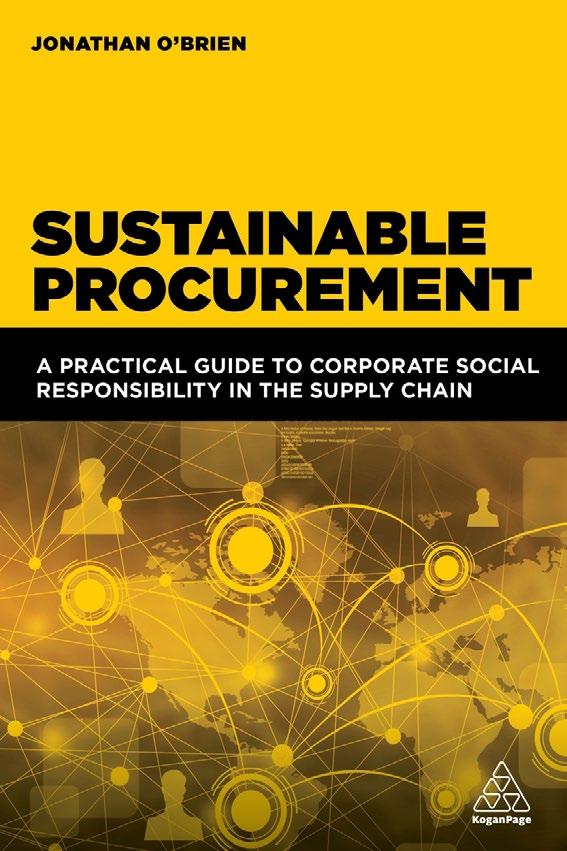
• Features guidance on implementing sustainability requirements with immediate suppliers and driving improvements elsewhere in the supply chain where there is no direct relationship
• Explains how to carry out a sustainability audit then develop objectives and a strategy based on the priorities and major impacts identified
• Highlights key methods of monitoring results, communicating to the organization and ensuring continued sustainability success in the future
The business case for sustainability is clear and organizations are responding to the imperative to act. But with 50-70% of the change needed involving the supply base, procurement and supply chain functions are critical to success.
Sustainable Procurement explains how procurement and supply chain professionals can develop existing best practice approaches to make supply side sustainability a reality. Based around the OMEIA® Sustainable Procurement process, this book provides a stepby-step and highly practical methodology that embeds sustainable procurement into existing proven procurement approaches. It also provides crucial new tools that equip and enable those in this field to drive highly effective supply-side sustainability.
By exploring the current landscape and the business case for sustainability, Sustainable Procurement makes sense of how we can translate good ambition into prioritised grass roots level change. Guidance is offered on how procurement can help redefine what an organisation does based upon what needs to change in its supply base. There are extensive resources to help determine hot spot risk areas, assess suppliers, and determine and prioritise where to direct our precious resources. It also provides new models for 'sustainable value engineering' to help organisations transform what and how they buy. Written by leading procurement expert and best-selling author, Jonathan O'Brien, this practical guide outlines how to establish sustainable procurement as a key strategic enabler to reduce supply-side risk and drive action to respond to detrimental impacts in the supply base.
Jonathan O'Brien is the CEO of Positive Purchasing Ltd, the international procurement and negotiation consultancy and training provider, and is based in Plymouth, UK. With over 30 years of experience, he has helped global organizations increase their purchasing capability through training, education and working directly with practitioners and executive teams. He is also the author of Category Management in Purchasing, Negotiation for Procurement and Supply Chain Professionals, Supplier Relationship Management and The Buyer's Toolkit, all published by Kogan Page.
Edition: 1
Date: 04/28/2023
Price: $69.99
Paperback: 9781398604681
Ebook: 9781398604698
Pages: 536
Format (mm): 235x155
Band: Professional
Subject: Procurement
Introduction
1 Our current situation
1 Situation planet Earth 1 - the planet
2 Situation planet Earth 2 - people
3 Homosapiens - extinct in a hundred years?
2 The sustainability imperative
4 Introducing sustainable procurement
5 The business case for sustainable procurement
6 Setting the direction for sustainability
3 Sustainable Procurement
7 Assessing the supply base
8 Prioritizing risks, impacts and opportunities
9 Evaluating potential sustainable procurement projects
10 Making what we buy sustainable
11 Driving sustainability in our suppliers
12 Audit and assessment of suppliers
13 Driving sustainability in the supply chain
14 Making it happen, measuring outcomes and driving success
15 Appendices
• Offers a theoretical underpinning with supporting supply chain management tools and strategies
• Provides examples of best practice, including case studies of companies such as Nestlé and organisations from the Gartner Supply Chain Top 25
• Presents essential supply chain technologies, such as RFID, barcodes, logistics technology, automated warehouses, omnichannel, as well as future trends, such as big data, the Internet of Things (IoT) and autonomous systems
• Looks at how effective supply chain strategy can boost a company's competitive advantage and examines the importance of talent management and organisational strategy
Supply chains, including logistics, are the functional elements of an organisation's operations. To formulate a strategy for this operation to work seamlessly the organisation needs to align these operations with the corporate and business strategy. Strategic Supply Chain Management provides a discussion on effective supply chain strategic leadership for managerial teams who have previously been operating on a tactical or operational level, as well as students who need to learn about applying the theories of strategic supply chain management in practice.
Strategic Supply Chain Management introduces concepts and tools which will enable successful buyer-supplier relationships and effective organizational leadership and talent management. Samir Dani provides a concise but important outlook on the connection between business strategy and supply chain strategy. The book delves into topical issues of risk, resilience, and sustainability and how these influence both business and supply chain strategy. The book also considers strategies for procurement, buyer supplier relationships, and sales & operations planning. An important aspect of this book is to consider the leadership and talent aspects of the humans in the supply chain and how this influences strategy and creates competitive advantage.
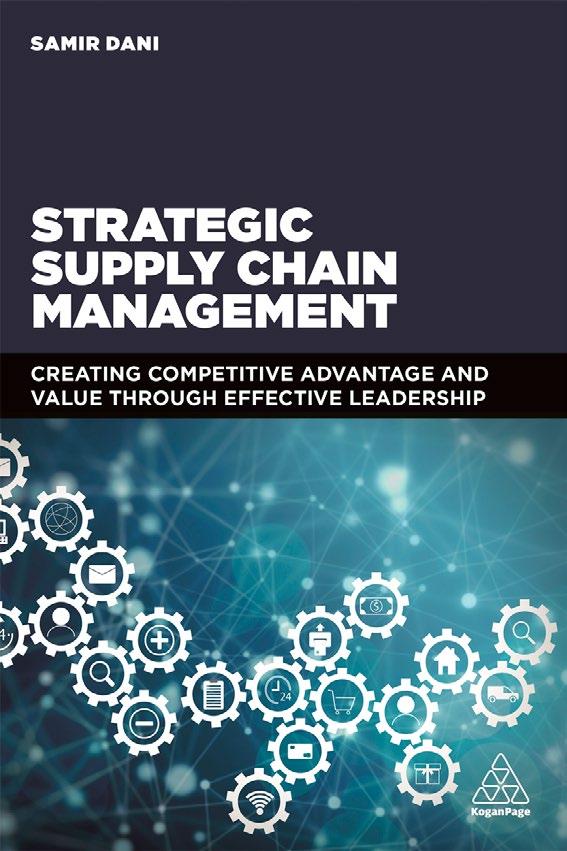
Samir Dani is Professor of Logistics and Supply Chain Management in Huddersfield Business School at the University of Huddersfield, UK. He is the recipient of the 2015 Prix des Associations prize at the Les Plumes des Achats & Supply Chain awards for his book Food Supply Chain Management and Logistics published by Kogan Page.
Edition: 1
Date: 10/28/2019
Price: $55.99
Paperback: 9780749478841
Ebook: 9780749478858
Pages: 200
Format (mm): 233x155
Band: Textbook
Subject: Supply Chain Management
1 Elements of strategy
2 Sales and operations planning
3 Sourcing and purchasing
4 Supplier relationships and collaboration
5 Risk and resilience
6 The circular economy and supply chain strategy
7 Talent management
8 Other factors important for supply chain strategy
9 Appendix - Factors influencing the supply chain strategy
• Introduces the concept of the strategy-driven supply chain by exploring the effect of a poor strategy on supply chains and how strategy should translate into supply chain design
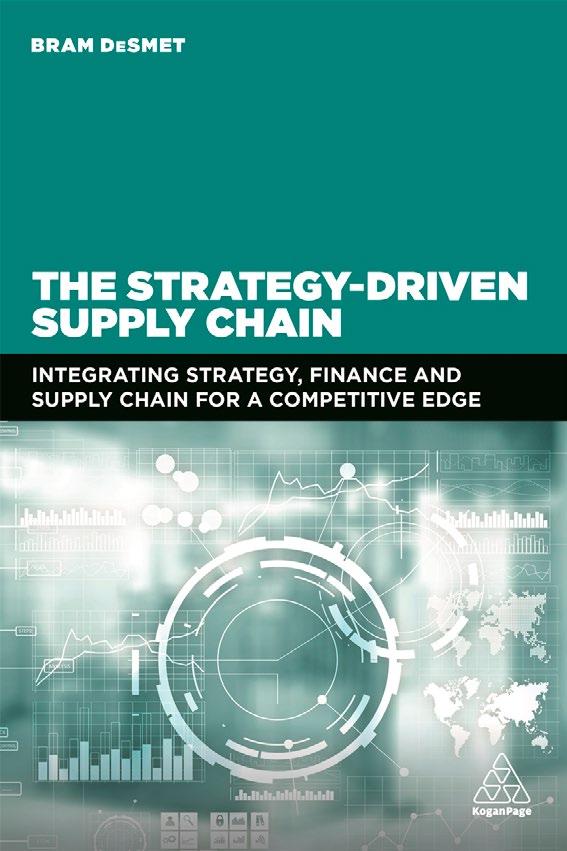
• Offers practical guidance on implementing the strategy-driven supply chain concept in an organization from the top down or bottom up
• Emphasises the need for strategic integrated value planning and execution as the next step beyond S&OP and IBP
• Explores the financial context of how Return on Capital Employed (ROCE) links to other financial metrics and targets like growth, EBITDA and free cash flow
• Builds and fully expands on the fundamental concepts of Bram DeSmet's previous book, Supply Chain Strategy and Financial Metrics
Different strategies lead to different supply chains, and a lack of strategic choices leads to a blurred focus. This book introduces the concept of the 'strategy-driven supply chain', which changes the role of supply chain from operational-tactical to tacticalstrategic.
Building on the fundamentals of the author's previous bestselling book, Supply Chain Strategy and Financial Metrics, this new work defines a mission and purpose for supply chain management which puts supply chain at the heart of the triangle of service, cost and cash. The Strategy-Driven Supply Chain explains the need for integrated value planning and execution as the next step beyond S&OP and IBP and how to use a strategy-driven scorecard with a focus on Return on Capital Employed (ROCE) as the overall value metric.
The Strategy-Driven Supply Chain includes numerous tools to put these ideas into action, including a method to analyse financial metrics and compare them to key competitors, and exercises to define an organization's strategic choices (or lack thereof). It also features real-life examples of how to use the supply chain triangle to engage sales, finance and operations and case studies that illustrate the impact of strategy on the supply chain and financial metrics. This practical guide outlines a seven-step approach to integrating the people, process, tooling and analytics aspects of the change journey to the strategy-driven supply chain.
Dr Bram DeSmet is the CEO of Solventure where he helps global production and retail organizations in the domain of Strategy, Supply Chain and Operations. He is a Professor in Operations & Supply Chain Management at Vlerick Business School, Belgium and a visiting Professor at Peking University, China.
Edition: 1
Date: 05/28/2021
Price: $59.95
Paperback: 9781398600454
Ebook: 9781398600478
Pages: 320
Format (mm): 235x156
Band: Professional/ Academic
Subject: Supply Chain Management
1 The Supply Chain Triangle of Service, Cost and Cash
2 Strategy in the Supply Chain Triangle
3 Strategy-Driven S&OP
4 The Strategy-Driven Enterprise
5 The Strategy-Driven Scorecard
6 Implementing the Strategy-Driven Enterprise
7 Appendix – Financial Templates –Inventory Management
8 Appendix – Financial Templates – The Cost of Inventory – Rent, Room, Risk
• Demonstrates how to integrate customer responsiveness and agile supply chains into the overall value chain strategy
• Provides research-based models and frameworks which introduce new ways of driving effective strategic decision-making
• Presents an interdisciplinary approach, highlighting the important field of systems sciences
• Includes real-life examples of how to increase competitive advantage through effective value chain management, from large corporates such as BAT and Maersk
A supply chain is the process of all parties involved in fulfilling a customer request, while a value chain is a set of interrelated activities a company uses to create value and a competitive advantage. In Strategic Value Chain Management the authors bring together a variety of disciplines, showing how to move from traditional supply chain management to value chain management. Research from the (ISM) International School of Management, Germany, originating from a network of companies in a range of sectors, is integrated with case studies to demonstrate particular concepts.
Strategic Value Chain Management brings together theory and practice and presents tangible ways of creating competitiveness in a changing world through the use of effective models and frameworks. Challenging the traditional Porters Five Forces Model, the authors introduce the important academic disciplines of cybernetics and systems sciences as essential drivers of strategy within the supply chain, supported by case studies illustrating their implementation.

Prof. Dr. Sc. Qeis Kamran (MBA-GM, MBA- PPM, MBL-HSG, LLM, PhD Scholar and researcher at University of Twente, the Netherlands) is the full Professor of Strategy, Cybernetics and Design Science at ISM International School of Management, Dortmund, Germany. He previously worked in sales, management, entrepreneurship and leadership roles in retail, energy, oil, petrochemicals and consulting industries.
Edition: 1
Date: 11/28/2020
Price: $59.95
Paperback: 9780749484422
Ebook: 9780749484439
Pages: 440
Format (mm): 230x150
Band: Textbook/ Professional
Subject: Supply Chain Management
Introduction
1 Michael Porter – the founder of competitive strategy
2 A treatise of cybernetics, system sciences and complexity sciences
3 Introducing the six forces model
4 Global value chain management strategies and models for competitive advantage
5 Economic dimension of the six forces model and practical implications
6 Conclusion
7 Appendix – Economic layer, supply chain and collaboration
8 Index
• Explains Integrated Business Planning frameworks and how they can be applied to supply chain management
• Encourages the application of academic theories to real-world problems, such as how to build an honest and open supply chain
• Discusses change and how to implement it through learning from examples provided by a range of supply chain professionals: academics, practitioners, consultants and service providers
• Includes numerous international case studies illustrating the successful and unsuccessful implementation of change
Managing changes to the supply chain comes with its unique challenges. Supply chain planning presents an especially complex challenge for the change practitioner as multiple stakeholders and functions are involved.
Successful Integrated Planning for the Supply Chain evaluates different approaches to change interventions and explores how Integrated Business Planning could be implemented in any organization to create sustainable improvements.

Using frameworks based on extensive academic research, Richard Lloyd considers the potential blocks to an effective supply chain, and advises on how to deal with and identify uncertainties within an organization. Numerous international case studies included throughout show that every project has its own set of unique problems. Successful Integrated Planning for the Supply Chain is an invaluable guide for anyone who needs to implement change in the supply chain.
Richard Lloyd is Associate Director of the Supply Chain Centre of Excellence at TATA Consultancy Services, Mumbai. The author has worked for lots of international companies designing and managing supply chains such as NOKIA, where he was responsible for driving their global supply chain. He is a visiting lecturer at Cranfield University, Bedford, UK.
Edition: 1
Date: 03/28/2018
Price: $59.99
Paperback: 9780749477684
Ebook: 9780749477691
Pages: 280
Format (mm): 235x155
Band: Professional/ Academic
Subject: Supply Chain Management
1 Introduction
2 The supply chain challenge
1 Context. Situation. Outside-in
3 An outside-in view of an organization
4 Who works here and why?
5 Digging to understand how we got here
2 Complication. What is really going on?
6 Incongruities and uncertainties: a look behind the scenes
7 Theory of action: linking behaviour to assumptions
8 The politics of information technology: patronage and partnership
3 Implications. Interpreting our findings
9 Wicked problems: understanding the challenge
10 Leadership approaches to change
11 Realpolitik and ideals: projects
4 Conclusions. Decisions. Shaping interventions
12 Conclusions
13 Platforms and tools for change
14 Getting to agility faster
5 Wrap-up: Case study re-imagined. Next steps
15 Case study re-imagined
16 Next steps
• Explains the theory behind Supply Chain 4.0 and its application in practice, examining existing and emerging technologies, such as IoT, autonomous vehicles and big data

• Provides guidelines for designing and implementing innovative methods and techniques in order to address logistics problems effectively and systematically
• Explores the significant value of smart and integrated logistics operations
• Includes case studies of "Logistics 4.0" solutions in action, from companies such as Tesco, DHL and Waitrose
Supply Chain 4.0 has introduced automation into logistics and supply chain processes, exploiting predictive analytics to better match supply with demand, optimizing operations and using the latest technologies for the last mile delivery such as drones and autonomous robots.
Supply Chain 4.0 presents new methods, techniques, and information systems that support the coordination and optimization of logistics processes, reduction of operational costs as well as the emergence of entirely new services and business processes.
This edited collection includes contributions from leading international researchers from academia and industry. It considers the latest technologies and operational research methods available to support smart, integrated, and sustainable logistics practices focusing on automation, big data, Internet of Things, and decision support systems for transportation and logistics. It also highlights market requirements and includes case studies of cutting-edge applications from innovators in the logistics industry.
Professor Michael Bourlakis is the Head of the Logistics, Procurement & Supply Chain Management Group at Cranfield School of Management. He is a member of the European Technology Platform (Food for Life, European Commission).
Dr Emel Aktas is a Senior Lecturer in Cranfield School of Management at Cranfield University. She specializes in supply chain analytics, using mathematical modelling and decision analysis in transport, retail and manufacturing sectors.
Dr. Vasileios Zeimpekis is a lecturer at the Hellenic Open University. He is a transportation expert in the United Nations Economic Commission for Europe (UNECE) and in the Hellenic Committee for Competitiveness and Development for Logistics. He is the Vice President of Operations at the board of directors of the Hellenic Logistics Association.
Professor Ioannis Minis is a Professor in the Department of Financial and Management Engineering of the University of Aegean. He is also the chairman of the National Council for Supply Chain Growth and Competitiveness, an advisory body to the Greek government.
Edition: 1
Date: 02/28/2021
Price: $65.95
Paperback: 9781789660739
Ebook: 9781789660746
Pages: 312
Format (mm): 234x156
Band: Textbook/ Professional
Subject: Supply Chain Management
1 Supply Chain 4.0: enabling market-driven strategies [Martin Christopher]
2 Driving better customer experience in digital supply chains [Patrick Strauss]
3 Blockchain in the supply chain [Martyn Walker]
4 Blockchain for humanitarian supply chain [Rameshwar Dubey, Angappa Gunasekaram, Stephen J. Childe, Benjamin T. Hazen and Thanos Papadopoulos]
5 Supply Chain 4.0: the cyber-security challenge [James Kench]
6 Defining and testing system parameters for enhancing vision picking technology in warehouse operations [Anastasios Gialos and Vasileios Zeimpekis]
7 Collaborative robotics – transforming warehouse logistics [Markus Voss]
8 Improving cold-food quality control through the Internet of Things and big data: an empirical case [Alexandre Luis Prim, Tiago Pedro Nicchellatti and Roberto Goularth Mendes]
9 Predicting physical distribution delays: a case study of outbound logistics [Zina Ben Miled, Jeremy Archbold and Brooke Renee Cochenour]
10 Adopting Industry 4.0 technologies in agri-food supply chains: an exploratory investigation of drivers and barriers [Imran Ali, Sattar Satie and Vinh Thai]
11 The impact of sharing economy incentives and Industry 4.0 technologies on humanitarian logistics: insights from the Iran floods of 2019 [Hamed Seddighi and Hamid Moradlou]
12 In search of a human dimension of Supply Chain 4.0: stipulating learning as a lever for the future supply chain organization [Henning de Haas, John Bang Mathiasen, Søren Skjold Andersen and Torben Tambo]
• Offers a thoroughly contemporary coverage of supply chain network design in the age of geopolitical disruptions, fast-paced technological innovation and drive for more sustainable business
• Looks at how organizations can integrate agility, resilience and sustainability into supply chain network design

• Presents a customer-driven lens that will help networks evolve from a traditional B2B to a B2B2C workflow
• Spans the entire gamut of the supply chain, logistics and operations landscape, ranging from planning, sourcing, manufacturing, distribution and logistics
• Explores how old systems need to be updated with the latest developments in Artificial Intelligence, Machine Learning, and Robotic Process Automation breakthroughs.
The traditional linear supply chain is no longer fit for purpose, and organizations must redesign their supply chains to become more customer-driven, agile, resilient and sustainable.
Supply Chain Network Design shows how to design intelligent, agile supply chain networks in the age of geopolitical disruptions, fast-paced technological innovation and drive for more sustainable business. It outlines how to incorporate international relations and a global perspective into supply chain planning and actions and how to embed ESG and circular economy goals. It surveys the rapidly evolving technology landscape and how it impacts some companies and provides a competitive advantage to others. It also explores how to harness technologies such as robotic process automation, AI and machine-driven intelligence and the evolution of forecasting to demand sensing to enhance network design.
Taking a global perspective, Supply Chain Network Design is supported by practical cases and examples and provides a consumer-driven lens that will help organizations evolve their networks from a traditional B2B to a B2B2C workflow. Covering both lessons learned and how to move forward, this will be an must-read for supply chain, logistics and distribution leaders, managers and analysts.
Nick Vyas is Executive Director of USC Marshall School of Business's Center for Global Supply Chain Management. He is based in Los Angeles, USA.
Das Dasgupta is Chief Data Officer at Saatchi & Saatchi. He is based in Irvine, USA.
Greys Sošic is Chair and Professor of Data Sciences and Operations at USC Marshall School of Business. She is based in Los Angeles, USA.
Edition: 1
Date: 05/28/2024
Price: $59.99
Paperback: 9781398614918
Ebook: 9781398614925
Pages: 336
Format (mm): 234x156
Band: Textbook/ Professional
Subject: Supply Chain Management
1 Introduction- the supply chain landscape: disruptions, threats and key trends to watch
2 Principles of network design and how to optimize and put these into practice
3 Reworking supply chains models with awareness of geopolitical, environmental and national security concerns
4 How to create intelligent supply chain Harnessing emerging technologies in supply chain network design
5 Chapter - 06: Integrating sustainability in the supply chain DNA
6 Breaking down siloes to move towards a circular economy
7 Smart Cities, Smart Infrastructure, Smart Nations (new perspective on infrastructure)
8 Implementing Effective Network Design Change within Your Organization
9 Lessons learned from four supply chain network design case studies
10 Conclusion
• Provides the latest research on trends, challenges and technologies actively shaping food supply chains, such as veganism, supply shortages and blockchain
• Covers the fundamentals of food supply chain management including how food is produced, retailed and regulated
• Offers international case studies from leading companies such as Cargill, Nestlé and Starbucks to show theory in practice
• New to this edition: topics including food innovation, emerging trends, such as data analytics within the food supply chain, postBrexit challenges to food supply chains and veganism, as well as online resources
• Online resources: PowerPoint lecture slides
First edition WINNER: ACA-Bruel 2015 - Prix des Associations
Food supply chains are integral in ensuring that food makes it from the farm to the table. Understanding how these operate has never been more important.
The new edition of Food Supply Chain Management and Logistics is the guide to all aspects of food supply chains. This book examines food production, operational challenges and the future challenges of the industry and sustainability. The emergence of new technologies, which are key in increasing the efficiency of processes, such as food apps, big data and blockchain, are discussed. As are wider trends including veganism and local sourcing.

Food Supply Chain Management and Logistics embeds learning using case studies from leading companies such as Cargill, Nestlé and Starbucks. In addition, case studies from sustainable businesses such as Omnom Chocolate and ReFood also feature. The book is structured to provide readers with an understanding of the basics of food supply chain management and logistics before expanding the scope to cover more of a range of topics. Online resources include PowerPoint lecture slides.
Samir Dani is Professor of Operations Management and Deputy Director of Keele Business School at Keele University, UK. He engages widely with industry and has research interests in supply chain risks, sustainability in supply chains, and the use of technology and business models. He works with the food sector on projects related to food supply risks, food sustainability, and food ecosystems. He has published widely and has presented his research to both academic and practitioner audiences.
Edition: 2
Date: 06/28/2021
Price: $65.95
Paperback: 9781398600126
Ebook: 9781398600133
Pages: 344
Format (mm): 233x156
Band: Textbook/ Professional
Subject: Supply Chain Management
1 Introduction to food supply chains
1 Food production
2 Food production
3 Food manufacturing
2 Operational challenges
4 Food retailing
5 Food logistics
6 Challenges in international food supply chains
7 Collaboration and relationships
8 Food sourcing and procurement
9 Risk management
10 Technology trends in food supply chains
3 Sustainability and future challenges
11 Food regulation, safety and quality
12 Food innovation
13 Sustainability challenges in food supply chains
14 Food sector and economic regeneration
15 Food security and future challenges
• The first edition, Supply Chain Risk Management, won the ACA Bruel Special Mention Prize in Paris for its contribution to the purchasing and supply chain industry
• Explains key areas of supply chain risk management, such as cargo crime, climate change and cyber-crime
• Provides case studies, such as Dell's response to climate changes, the Port of Antwerp cyber breach and the Yemen Air Cargo Plot, to embed learning using applicable examples
• New to this edition: a new chapter on 'The threat of supply chain cyber crime', additional case studies, the latest thinking on political risk as well as updates throughout
• Online resources: lecture slides and example test questions
From political uncertainty to trade disrupts and cyber threats, the risk environment is continuously evolving, and new challenges frequently arise demanding immediate attention to avoid disruption to supply chains.
Supply Chain Risk Management is the guide to recognizing, reviewing and reacting to these risks to ensure continued operations and optimal service. This book is a practical learning tool which offers a comprehensive framework to understanding risk and how to engineer resilience into the supply chain.
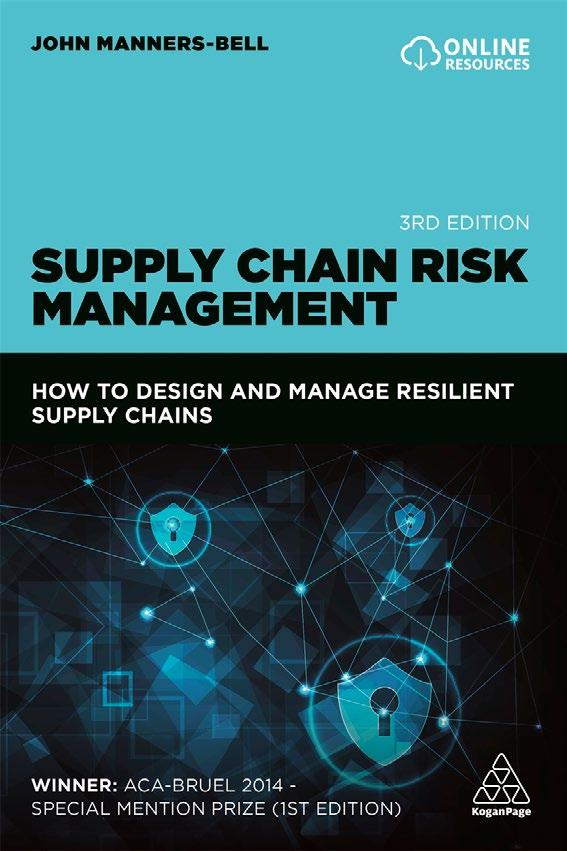
The third edition of Supply Chain Risk Management details how to approach various threats, including black swan events, natural disasters, climate change, cargo crime and piracy, and terrorism and security. Using case studies and recent, topical examples, this book demonstrates how to successfully manage these risks and apply learnings in practice. Objectives, summaries and key point checklists in each chapter also help the reader grasp these key concepts and understand how to keep supply chains resilient. Online resources include lecture slides and example test questions.
John Manners-Bell is the CEO of Transport Intelligence, a leading supplier of market solutions to the global logistics industry. He is also Visiting Professor at the London Guildhall Faculty of Business and Law, London Metropolitan University.
Edition: 3
Date: 11/28/2020
Price: $65.95
Paperback: 9781789666373
Ebook: 9781789666380
Pages: 368
Format (mm): 235x156
Band: Textbook/ Professional
Subject: Supply Chain Management
1 A framework for understanding risk
2 Engineering supply chain resilience
3 Industry sector resilience to supply chain threats
4 Natural disasters and pandemics
5 Climate change and emissions policy
6 Economic risks to the supply chain
7 Societal risks to supply chains
8 Corruption in the logistics industry
9 Cargo crime and piracy
10 The threat of supply chain cyber crime
11 Political risks in supply chains
12 Illicit supply chains
13 Terrorism and security
• Offers a detailed and up-to-date overview of all the major trends transforming the supply chain and logistics industry, including blockchain, automation and AI
• Presents a vision of how supply chains will develop in the coming years and how businesses can remain resilient to these innovations
• New to this edition: in depth discussions of urban logistics, smart warehousing, nearsourcing/re-shoring, and the role of new technologies in mitigating climate change
• Online resources: PowerPoint slides and sample case studies
• Investigates how disruptive technologies will transform supply chain dynamics in vertical industries such as automotive and fashion
Global disruption, new technologies and changing consumer habits are causing turmoil in the supply chain industry. This book shows businesses how to remain resilient in this dynamic new environment.
The supply chain crisis of 2021 exposed the necessity of a sustainable supply chain. The Fourth Industrial Revolution has transformed our society and economy. The logistics and supply chain industry continues to be innovated by automation, blockchain and sustainability. Amid all this volatility, it is vital for businesses to not only protect their operations from disruption, but to rise to the challenge that these innovations pose to become game-changers in their sectors.
Now in its second edition, Logistics and Supply Chain Innovation provides vital insight into the major trends transforming the supply chain and logistics industry. Featuring a new section on the role of technologies in reducing carbon emissions, case studies from companies such as Amazon, Alibaba, Maersk, UPS and DHL, as well as a full update of all existing content on crowd sourcing and shipping, on-demand delivery, autonomous vehicles and more, Logistics and Supply Chain Innovation is the essential guide to thriving in a rapidly developing logistics landscape. Online supporting resources include PowerPoints and sample case studies.

John Manners-Bell is Founder and CEO of Transport Intelligence Ltd. He is an Honorary Visiting Professor, London Guildhall Faculty of Business and Law, London Metropolitan University. He was formerly Chair of the Logistics and Supply Chain Global Agenda Council of the World Economic Forum, speaking and moderating at the annual Davos meeting. In 2021 he founded the Foundation for Future Supply Chain. He has spoken at conferences in Asia, USA, Africa, Latin America, Middle East and Europe. He is based in Bath.
Edition: 2
Date: 11/28/2022
Price: $56.24
Paperback: 9781398607484
Ebook: 9781398607491
Pages: 416
Format (mm): 234x153
Band: Professional/ Academic
Subject: Supply Chain Management
Introduction
1 The impact of innovation and disruption on the supply chain
1 The Fourth Industrial Revolution and the anatomy of innovation
2 Breaking the paradigm
3 Lessons from the past
4 Disruption to the post-Covid-19 supply chain and logistics industry
2 Transforming supply chain models
5 The direct-to-consumer model and its implications for logistics
6 Alternative downstream retail distribution models
7 On-demand delivery and crowd-shipping
8 Innovating to meet the challenge of urban distribution
9 The disruptive power of e-retailing
10 Amazon – The ultimate disruptor
11 3D printing and the transformation of upstream supply chains
3 New technology development and adoption
12 The Internet of Things, Big Data and artificial intelligence
13 Control towers and supply chain visibility
14 Blockchain in supply chains
15 The disruptive potential of robots and automation in the warehouse
16 Autonomous vehicles and delivery robots
4 Digitalization of logistics markets
17 Digital road freight and warehousing platforms
18 The digitalization of international freight forwarding
19 Disrupting trade finance
5 Innovating for sustainability
20 The role of new technologies in mitigating climate change
21 A guide to alternative propulsion systems
22 Designing smart and circular supply chains
23 ‘Shifting to Green’ survey
24 Future directions for global supply chains
25 The ‘Great Reset’
26 Conclusion
• Discusses trends, issues and challenges associated with integrating e-business with supply chain management
• Provides an overview of the use of B2B and B2C technologies in supply chains in different industries, such as HE institutions, multinational automation corporations and healthcare
• Uses bona fide case studies from industry and academia which highlight concerns and problems such as e-technology security and collaborative system use
• Looks at how to use e-technologies to increase the efficiency of logistics, production, distribution and other related activities
Using e-business technologies to manage supply chains increases the efficiency and performance of logistics, production, distribution and other related activities. E-Business and Supply Chain Integration explains how a number of tools can be used to produce an e-supply chain and achieve higher productivity.
This essential book examines supply chain theories along with real life cases and examples from industry to illustrate how e-business can enhance supply chain integration and highlights the negative outcomes when it is poorly managed. Dr Ozlem Bak and a team of expert contributors from practice and academia assess the impact of e-business on numerous different sectors, such as automotive, healthcare, logistics, higher education, and professional services. E-Business and Supply Chain Integration explains the strategic implications of new technologies and provides guidance on effective supply chains in e-businesses.

Dr Ozlem Bak is Senior Lecturer at Huddersfield University, UK. She lectures on courses in operations management, purchasing, and supply chain management at undergraduate and postgraduate level. Before entering academia she worked in the automotive industry for companies such as Daimler Chrysler and Hyundai.
Edition: 1
Date: 02/28/2018
Price: $79.99
Paperback: 9780749478452
Ebook: 9780749478469
Pages: 272
Format (mm): 235x155
Band: Professional/ Academic
Subject: Supply Chain Management
1 E-integrated healthcare supply chains: tracking and monitoring medical devices in the National Health Service (NHS), UK [Dr Ying Xie and Dr Liz Breen]
2 Smart technologies: disruptive technologies and the agrifood industry – fit for practice? [Professor Kim P Bryceson and Dr Asif Yaseen]
3 Digital technologies in the professional services industry: aligning human capital supply with market demand [Georg Juelke]
4 Implementation of e-health to improve healthcare [Wenqi Jacintha Hee, Dr Geoffrey Jalleh and Dr Chad Lin]
5 E-learning in higher education: a case of doctoral dialogue in a virtual space [Dr Mark Readman]
6 E-government: assessing the impact of e-business technologies on government service supply chains [Dr Ozlem Bak]
7 Cloud technology: China’s e-business approach to market development – the case of `Alisports [David Cockayne]
8 Supply chain integration through e-business-enabled enterprise systems: the case of the UK automobile sector [Professor Vikas Kumar, Dr John Loonam, Archana Kumari, Professor Jose Arturo Garza-Reyes and Hieu Van Ngo]
9 The role of business-to-business platforms and their implications for supply chains: a case from the European automotive industry [Dr Ozlem Bak]
10 E-freight: prospects and challenges of the digitalization of the air cargo supply chain [Alicja Gajewska and Dr Eric Tchouamou Njoya]
11 E-learning in higher education: an account of student autonomy within the context of a UK-based e-learning environment [Dr Ozlem Bak]
• Provides the latest academic research on blockchain supported by actionable frameworks and practical insights from realworld application
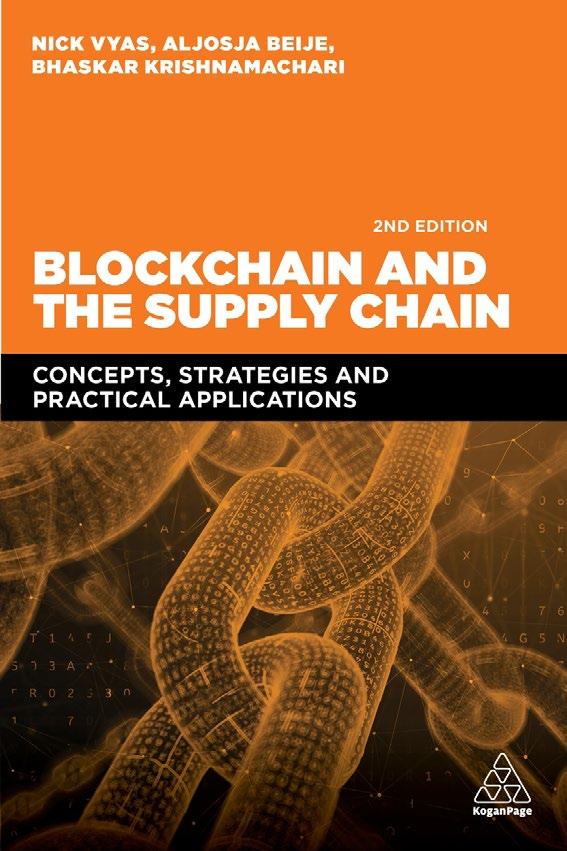
• Outlines how blockchain and other technologies can be utilized in supply chain management to improve tracking, metrics and performance
• New to this edition: the latest technological developments relating to supply chain integration including Enterprise Blockchain, Ethereum and Hyperledger, the impact of COVID-19, the future of blockchain and potential developments
• Online resources: Lecture slides and example assignments and quizzes
• Examines case studies of successful implementation of blockchain and supply chain automation, and examples from IBM, Maersk-Line, ABN-AMRO
Edition: 2
Date: 09/28/2022
Price: $62.99
Paperback: 9781398605213
Ebook: 9781398605220
Pages: 288
Format (mm): 232x156
Band: Professional/ Academic
Subject: Supply Chain Management
1 Evolution of supply chain - How we got here
2 Supply chains in 2021 – Costly, fragile, and increasingly complex
3 Basics of blockchain
4 Internet of things, data analytics and other information technologies
5 Blockchain strategy – The why, what and how of blockchain
6 What supply chain management processes and metrics will be affected by blockchain?
7 Blockchain projects in practice – Case study
8 Blockchain use cases in supply chain
9 Economic impact and future outlook
• Demystifies blockchain technology and its intrinsic relationship to supply chain management.
• Provides multiple case studies of how a variety of businesses are using blockchain in the supply chain, including companies such as Walmart, Coca-Cola and Microsoft
• Offers practical tips, frameworks, and tools so readers can assess the business case for using blockchain and implement it within their supply chain
• Includes an invaluable benchmark survey on the state of play of blockchain in supply chain management.
Blockchain provides a secure ledger of transactions, programmable smart contracts, and real-time trustworthy visibility and insight into the supply chain process.
For all the promises it offers to supply chain professionals, however, there's very little guidance available on how organizations should begin evaluating and using it. Integrating Blockchain into Supply Chain Management provides that much needed step by step guidance.
Integrating Blockchain into Supply Chain Management is a very practical book of tools, frameworks and case studies. It will help students and supply chain managers to evaluate the value proposition blockchain brings. It will then guide them through essential processes for making informed, practical, timely, and business-savvy decisions for using blockchain as an effective supply chain tool. It includes a valuable benchmark survey of the state of play in blockchain in supply chain management, including organisations such as Tyson Foods, IBM and Coca Cola, as well as downloadable frameworks and tools.
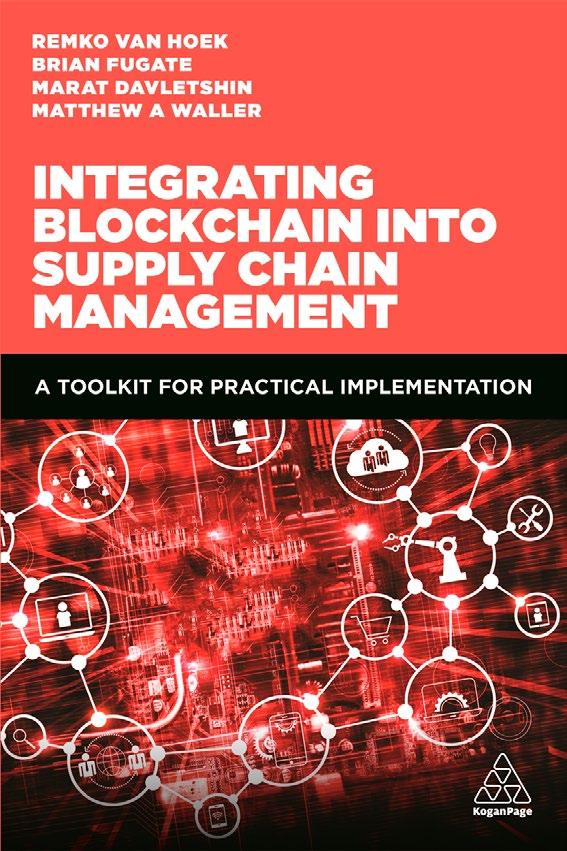
Remko van Hoek, is Professor of Supply Chain Management in the Walton College of Business at the University of Arkansas. Formerly Chief Procurement Officer for the Walt Disney Company, he has held senior supply chain executive roles in the US and Europe at several companies, including Nike and PwC. He also is the Chair of the Board of Directors of the Council of Supply Chain Management Professionals (CSCMP).
Brian Fugate is the Oren Harris Chair in Transportation, Chair of the Department of Supply Chain Management at the University of Arkansas, and MIT Fulbright Senior Research Scholar.
Marat Davletshin was formerly an Operations Manager with Amazon and is currently at the University of Arkansas.
Matthew A. Waller is the Dean of the Sam M. Walton College of Business at the University of Arkansas, where he also serves as the Sam M. Walton Leadership Chair and a Professor of Supply Chain Management.
Edition: 1
Date: 11/28/2019
Price: $62.99
Paperback: 9780749498269
Ebook: 9780749498252
Pages: 264
Format (mm): 235x155
Band: Professional/ Academic
Subject: Supply Chain Management
1 Understanding blockchain technology
2 Using blockchain as a new database
3 Common blockchain features
4 How to adopt blockchain and bridge the gaps
5 Supply chain operations and blockchain
6 Blockchain as a supplier of a stable and secure supply chain system
7 The implications of traceability across the supply chain
8 Blockchain technology and advantages for marketing products and services
9 What is the business case for embracing blockchain?
• Presents disruptive technologies as the enablers or drivers of new business models, products, services and overall solutions
• Maps how to create and implement superior process improvement solutions across the entire supply chain
• Features case studies of organizations that have successfully integrated new technologies into their existing business models and supply chains, such as BT, Morrisons and Aramex
• Features a foreword by world-leading thought leader, John Gattorna
Disruptive technologies have the power to upend supply chains, adding uncertainty, cost, and complexity to any business. These technologies can also create competitive advantage, but only if organizations strategically build them into their supply chains.
Supply Chain Disruption, with a foreword by John Gattorna, provides the vital knowledge that supply chain managers need in order to implement disruptive technologies strategically. This essential book avoids a one-size-fits-all approach and encourages the reader to consider customer needs first before aligning appropriate technologies with each supply chain application.

Supply Chain Disruption focuses on information systems, analysing how companies currently integrate and implement potentially disruptive technologies into their supply chain roadmaps. It presents new ways of planning more effectively and efficiently through the use of new tools and techniques, creating improvements in agility, customer service and cost.
Steve O'Sullivan is a supply chain and logistics specialist with extensive two-decade international experience in complex business-critical environments for firms across multiple industries, such as aviation and consumer electronics. As an academic scholar-practitioner, Steve consistently creates and implements superior process improvement solutions across the entire supply chain process, while supporting international management teams in meeting and exceeding established targets.
Edition: 1
Date: 08/28/2019
Price: $59.99
Paperback: 9780749484101
Ebook: 9780749484118
Pages: 272
Format (mm): 233x158
Band: Professional/ Academic
Subject: Supply Chain Management
Preface – Setting the scene
1 An introduction to supply chain disruption
2 Supply chain strategic friction
3 Ad omnia paratus – Prepared for anything
4 Humanitarian disasters and the supply chain
5 The art of responding to disruption through the physical supply chain
6 Pharmaceutical supply chain disruption –A policy perspective
7 Corporate breakdowns and the supply chain
8 A conceptual process model – Reducing the gap of pain through dynamic strategic alignment
• Reviews how Tesco has tackled all the recent challenges by revitalizing itself under Dave Lewis and facing down threats from discounters and Amazon
• New to this edition: Chapters on rebuilding customer trust and Tesco's Corporate Social Responsibility agenda
• Uses real examples and academic research to explain the benefits of a Lean supply chain
• Examines the key principles behind Tesco's success: customer loyalty, simplicity of operations and Lean thinking
• Winner of the prestigious Prix des Assocation 2016, in Les Plumes des Achats & Supply Chain
WINNER: Les Plumes des Achats 2016 - Prix des Associations (1st edition)
Over the last two decades Tesco has emerged as a dominant player in the UK market and a leading global retailer. The Lean Supply Chain explores how Tesco, over the last 20 years or so, has built its business around supply chain excellence. As a mega-retailer, Tesco has learnt to create a balanced supply chain system, supporting suppliers' needs as well as customers' requirements. This perspective, and an ambition to act sustainably, has underpinned a rebuilding of trust in the Tesco brand and a resurgence in commercial fortunes.
This fully updated edition of The Lean Supply Chain contains new chapters on Tesco's current strategy, rebuilding brand trust and its CSR agenda. It charts the principles of lean thinking, customer loyalty and simplicity which were used by Tesco to frame its supply chain strategy and draws upon the authors' deep knowledge of how the retailer has dealt with challenges and market changes to provide lessons for other businesses, large or small, who wish to place how they manage their supply chains at the heart of their competitive strategy.

Barry Evans has held roles at Tesco including Lean Process Manager in Supply Chain Development. He was part of the Lean Enterprise Research Centre at Cardiff Business School as a Senior Research Associate until his retirement.
Robert Mason is Professor of Logistics and Programme Director, MSc Sustainable Supply Chain Management, at Cardiff Business School. He has led numerous business research projects, including working with Tesco as a partner.
Edition: 2
Date: 12/28/2018
Price: $59.99
Paperback: 9780749482060
Ebook: 9780749482077
Pages: 336
Format (mm): 234x159
Band: Professional/ Academic
Subject: Supply Chain Management
1 Introduction
2 Tesco past and present
3 Tesco and strategy – Managing the what, why and how!
4 Customer insight – To drive the Tesco supply chain
5 Lean and the Tesco supply chain –‘Mastering the supply chain’
6 Tesco and their CSR agenda
7 Rebuilding trust
8 Tesco and continuous improvement –Debunking seven myths of conventional business thinking
9 Current challenges – Aligning corporate and supply chain strategies to a changing macro environment
10 Conclusions
• Provides best practice examples of collaborative working to help streamline working practices and drive waste and inefficiency out of supply chains
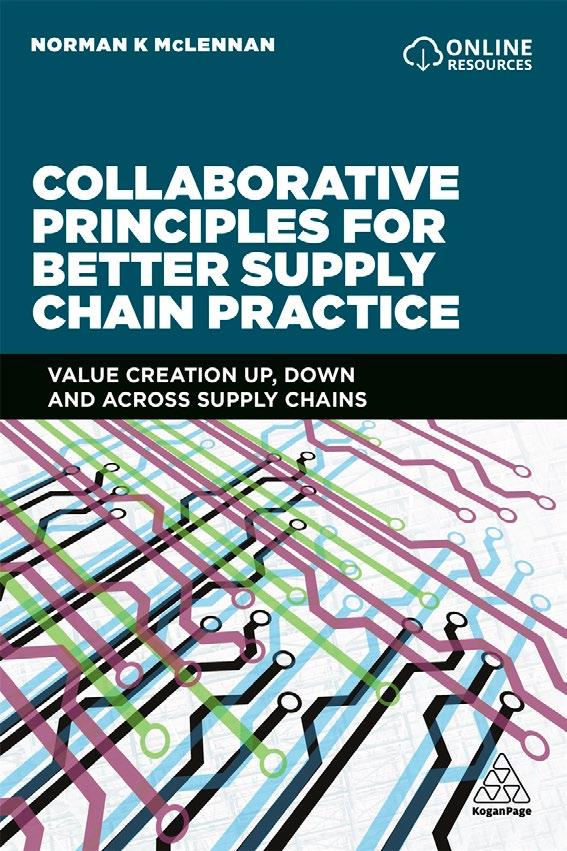
• Examines the role that government, industry bodies, regulators and contractor trade associations can play in driving collaborative innovation
• Provides insights into future digital collaborative knowledge-cube based procurement solutions
• Online resources: Bonus chapter and roadmap
Hyper competition and globalization mean that markets are changing. There is aggressive competition, shortening product life cycles, financial pressures and ever more demanding customers and consumers. Companies need to adopt new practices and new ways of thinking, so they are looking at collaboration across supply chains to become more sustainable, efficient and economical. Collaborative Principles for Better Supply Chain Practice looks at behavioural and commercial collaborative business principles and their application by means of case studies which showcase collaboration success across the private, public and 3rd sectors.
Collaborative Principles for Better Supply Chain Practice covers different perspectives: the client looking down the supply chain, the suppliers looking up the supply chain and the inter-dependencies of organizations horizontally across the supply chain. The book explores operational and project-type environments in different industry sectors, which will help you think about your supply chain differently and optimize your processes to achieve supply chain excellence. Online supporting resources include a bonus chapter and a roadmap on negotiations.
Norman McLennan is a cross-industry leader in the area of supply chain management and business improvement. He is a visiting professor with the Robert Gordon University, Aberdeen. His professional industry experience spans over 30 years split between the oil and gas/energy, engineering and traditional construction sectors working in the UK, Europe and internationally with extensive supply chain management and commercial project management experience. The author is regularly invited to speak at related industry and professional bodies' events and conferences.
Edition: 1
Date: 09/28/2018
Price: $55.99
Paperback: 9780749480493
Ebook: 9780749480509
Pages: 296
Format (mm): 235x157
Band: Professional/ Academic
Subject: Supply Chain Management
1 Knowledge Architecture Around Collaboration
1 Introduction - the rationale for collaborative business practices across supply chains and why collaboration can be the jewel in the crown
2 Collaborative arrangements - different supply chain perspectives, drivers and interdependencies
3 Raising the game - ISO 44001 - the evolution and emergence of a new global standard for collaborative working
4 The importance of stakeholder engagement in harnessing the benefits of collaborative working practices
5 Pan industry supply chain collaborationan exemplar of solutions developed by the industry for the industry
6 Commercial risk and pricing considerations associated with collaborative versus traditional contracting arrangements
2 Case Studies Of Exemplar Historical Collaborative Practice
7 The team marine story - putting logic back into logistics
8 Captain - the impossible dream
9 Building supply chain functional excellence through collaboration with internal partners
10 Envoi - value creation through collaborative outsourcing of acquisition and divestmest (A&D) in upstream exploration and production (E&P) sector
3 Case Studies Of Exemplar Collaborative Practice In Play Or Evolving
11 Humanitarian relief - food for the hungry (daring to be different through collaborative innovation)
12 The oil and gas technology centre (OGTC)
13 All together now: improvements in collaboration in the pharmaceutical & biomedical life science sectors
14 The emergence of digital procurement in the IT sector
15 Referencing
16 Further reading
17 Index
• Explains how to transform your company's operational performance by implementing demand-driven supply chain management
• Provides a very simple, but effective, way to segment your supply chain and achieve your planned service levels from up to half the average inventory while using significantly less capacity
• Understand how to reduce capacitydelivering cost savings of approximately 20%
• Online resources: Full-colour figures from the book
Many manufacturing and distribution companies are moving from the traditional 'forecast push MRP' to demand-driven supply chain management (SCM). Demand-driven SCM is an 'end-to-end' supply chain planning and replenishment process that enables companies to achieve their planned service levels from up to half the average level of inventory and requiring significantly less throughput capacity - irrespective of the level of demand volatility or lead-time length.
Demand-Driven Supply Chain Management is the go-to source for industry supply chain/ operations executives and students. It describes the 'what, how and why' of the demanddriven SCM process. The key themes in the book are: what is demand-driven? why is demand-driven so effective? how to operate a demand-driven supply chain? and how to adopt the demand-driven process in your company? Readers can quickly grasp the essential concepts from one of numerous self-contained sections that present the book's key concepts from different perspectives. Online resources available include full-colour figures.
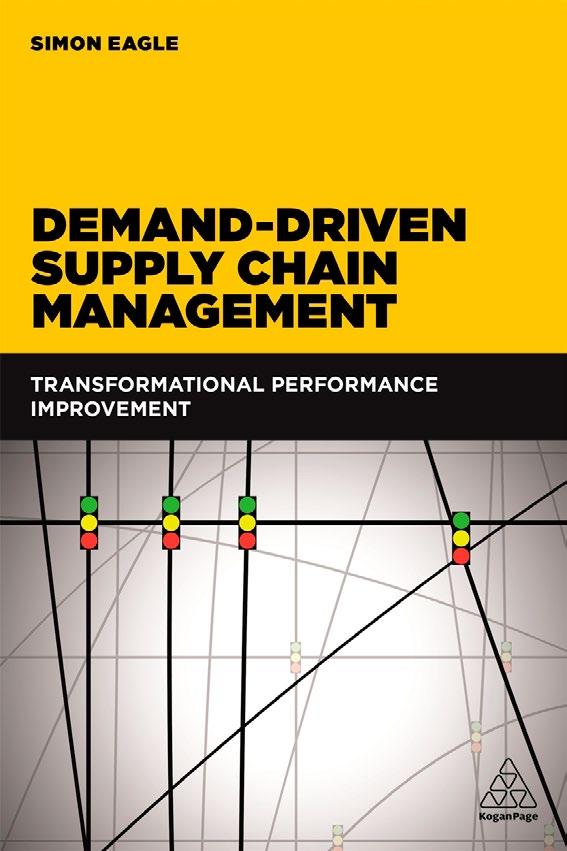
Simon Eagle is a senior supply chain planning and strategy consultant with over 20 years of international industry experience and significant expertise in S&OP and demand-driven supply chain management. He works with manufacturing and distribution companies that wish to make a transformational improvement in their E2E operations and supply chain performance and does so through helping them to adopt 'demand-driven' planning and execution.
Edition: 1
Date: 04/28/2017
Price: $59.99
Paperback: 9780749479978
Ebook: 9780749479985
Pages: 280
Format (mm): 235x157
Band: Professional/ Academic
Subject: Supply Chain Management
1 Introduction and Summaries
2 What is Demand-Driven SCM?
3 Why Demand-Driven SCM?
4 How to Operate a Demand-Driven Supply Chain
5 Demand-Driven SCM and Lean
6 Why Aren’t We Already Using DemandDriven SCM?
7 The Demand Driven Institute, DemandDriven MRP and SaaS
8 What Next – Control Theory?
Chapter - Postscript: From Supply Chain – An Apology to Our Commercial Colleagues
Chapter - The Story Behind DDMRP: Contribution by Chad Smith and Carol Ptak, Co-founders of the Demand Driven Institute
This book

• Provides practical examples, strategies and recommendations that you can implement immediately, improving short-term performance as you prepare for longer-term issues
• Features real-life case-studies taken directly from the author's industry projects and extensive experience
• Presents a multi-dimensional geographic view, including opportunities and challenges in developing markets, multi-modal options of the New Silk Route, the diversity within Asia and developments in emerging Africa
The linear concept of a chain is therefore no longer adequate to describe these complex international networks of suppliers, stakeholders, partners, regulators and customers that are involved in ensuring the efficient and effective movement of products, services, information and funds around the world - we are firmly in the era of Global Supply Chain Ecosystems.
Exploring the latest market trends and industry developments across emerging, developing and developed markets, in Global Supply Chain Ecosystems industry leader Mark Millar presents detailed and practical insights that will help you capitalise on market opportunities, overcome supply chain challenges and make better informed business decisions.
In addition to highlighting key supply chain shifts such as the move beyond globalisation back towards regionalisation, this ground-breaking new publication explores several critical aspects of global supply chain ecosystems - including visibility, resilience, sustainability and collaboration.
Author Information
Acknowledged as an engaging and energetic presenter, the author has completed over 450 speaking engagements at corporate events, client functions and industry conferences across 26 countries. A Visiting Lecturer at Hong Kong Polytechnic University, the author is recognised in the 'China Supply Chain Top 20', as one of 'Asia's Top 50 Influencers in Supply Chain and Logistics' and in the 2017 USA listing of 'Top Pros-to-Know in Supply Chain'.
Edition: 1
Date: 06/28/2015
Price: $65.99
Paperback: 9780749471583
Ebook: 9780749471590
Pages: 288
Format (mm): 232x156
Band: Professional/ Academic
Subject: Supply Chain Management
Table of Contents
2 Supply chain visibility
3 Sustainability and green supply chains
4 Risk and supply chain resilience
5 Free trade for all – navigating the FTA landscape
6 The Asian Era
7 The New Silk Road connecting Europe and Asia
8 Integrated logistics hubs
9 Human capital – the talent pool
10 Omni-channel supply chains
11 Africa – is it the next Asia?
12 Supply chain innovation
• Provides a detailed explanation of the most frequently used business analytics models in the supply chain, the challenges these present and the impact on different parts of the supply chain
• Includes models in all areas of business analytics such as descriptive, predictive and prescriptive analytics, with fully solved examples that can be easily followed and adopted
• Presents new research for developing, implementing and evaluating business analytics models within a complex supply chain environment
• Highlights the most recent developments in the field of supply chain analytics, which have been driven by new technologies
• Online resources: lecturer slides
An incredible volume of data is generated at a very high speed within the supply chain and it is necessary to understand, use and effectively apply the knowledge learned from analyzing data using intelligent business models.
However, practitioners and students in the field of supply chain management face a number of challenges when dealing with business models and mathematical modelling. Supply Chain Analytics and Modelling presents a range of business analytics models used within the supply chain to help readers develop knowledge on a variety of topics to overcome common issues.
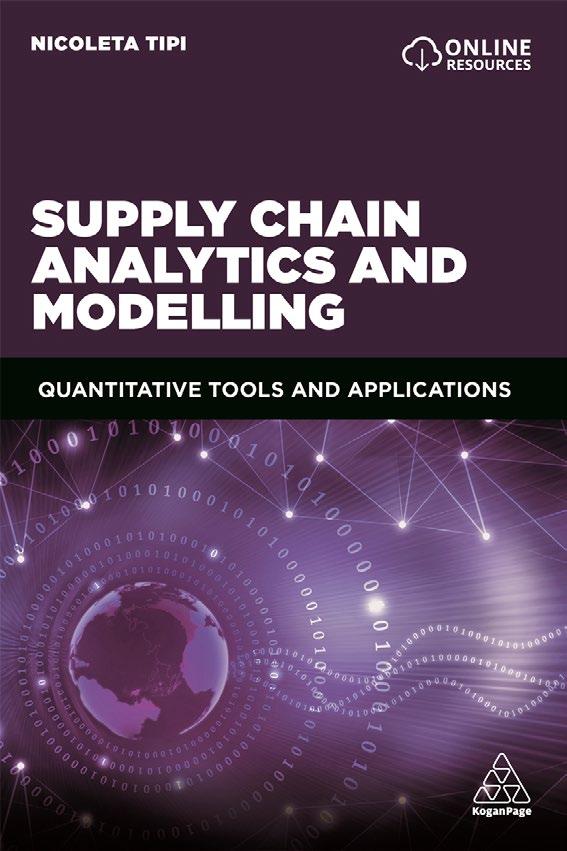
Supply Chain Analytics and Modelling covers areas including supply chain planning, single and multi-objective optimization, demand forecasting, product allocations, end-toend supply chain simulation, vehicle routing and scheduling models. Learning is supported by case studies of specialist software packages for each example. Readers will also be provided with a critical view on how supply chain management performance measurement systems have been developed and supported by reliable and accurate data available in the supply chain. Online resources including lecturer slides are available.
Nicoleta Tipi is Senior Lecturer in Operations and Supply Chain at the Open University, UK. She was previously Senior Lecturer at the University of Huddersfield where she gained experience lecturing in the area of supply chain modelling and logistics operations. Nicoleta Tipi has considerable industry experience, having worked in different roles involving modelling and analytics for Unilever.
Edition: 1
Date: 04/28/2021
Price: $65.95
Paperback: 9780749498603
Ebook: 9780749498610
Pages: 328
Format (mm): 235x158
Band: Textbook/ Professional
Subject: Supply Chain Analytics
1 Introduction to business analytics
2 The role of modelling in the supply chain
3 The role of data in the supply chain
4 Big data and data visualization
5 Supply chain performance measurement systems
6 Business analytics models
7 Supply chain analytics
8 The future of supply chain analytics
• Provides readers with a comprehensive understanding of the financial synergies across the supply chain
• Combines theory and practice to tackle key issues and adapt supply chain finance to individual organizations' circumstances
• Presents several initiatives to coordinate and develop cross-border financing from institutions such as the World Bank
• New to this edition: interviews from SCF platform providers, new examples on working capital management, additional learning activities and a terminology list
Financing the End-to-End Supply Chain provides readers with a comprehensive understanding of the financial synergies across the supply chain.

It demonstrates the importance of the strategic relationship between the physical supply of goods and services and the associated financial flows. The book provides a clear introduction, demonstrating the importance of the strategic relationship between supply chain and financial communities within an organization. This book links together treasury, banking, supply chain, systems, IT, and key stakeholders.
Financing the End-to-End Supply Chain will help senior supply chain practitioners to build collaboration, improve relationships and enhance trust between supply chain partners. With its combination of theory and practice it tackles vital issues including physical, information and financial flows, and tailoring supply chain finance to individual organisations' circumstances. Recognizing that supply chain finance means different things in different countries, the authors also consider various initiatives to harmonize and develop cross-border financing as well as including an agenda for national and international policy makers. The new edition features interviews from SCF platform providers on how ecosystems are involved in supply chain finance, additional learning activities for students and new examples on working capital management.
Simon Templar is a founding member of the Supply Chain Finance Community, a nonfor-profit association. Simon Templar is a qualified accountant with 20 years' industry experience as well as a lecturer on supply chain and procurement MSc's at Cranfield University.
Erik Hofmann is Head of Supply Chain Finance-Lab at the University of St.Gallen in Switzerland. He is also Director of the Institute of Supply Chain Management (ISCM-HSG) and Boardmember of the Supply Chain Finance Community (SCFC).
Charles Findlay is an experienced Business Strategy, Supply Chain and Procurement consultant , an agel investor and a Director of State of Flux.
Edition: 2
Date: 08/28/2020
Price: $62.99
Paperback: 9781789663488
Ebook: 9781789663495
Pages: 448
Format (mm): 235x158
Band: Professional/ Academic
Subject: Supply Chain Finance
Introduction
1 The background
1 The nucleus – Supply chains and financial performance
2 The big issue – Working capital management
3 The flows – Towards an integrated view of supply chain processes
2 The current practice
4 The concept – A case for supply chain finance
5 The ecosystem – Who is involved in supply chain finance?
6 The value proposition – Solutions for supply chain finance
7 The implementation – Bringing supply chain finance programmes to life
3 The future
8 The global setting – Supply chain finance in the context of cultural and geographical dispersion
9 The look beyond – Factors impacting the future of supply chain finance
10 Index
• Looks at the relationship between supply chain decisions and financial performance, measured by financial statements including the income statement, balance sheet and key financial and non-financial performance indicators
• Examines the applications of traditional and contemporary costing approaches and how they support supply chain management decision making
• Looks at the development of financially sustainable supply chain operations that have incorporated supply chain finance, working capital management and risk management

• Introduces a capital investment appraisal toolkit to construct the business case for investing in supply chain assets or considering an outsourcing or insourcing decision
• Online resources: invaluable study questions and worked solutions to reinforce the learning as well as multiple-choice questions with solutions and PowerPoint activities
The need to contain costs across the business is as strong as ever and the search for cost reduction opportunities is intensifying. There still remains one last major opportunity to take out costs - through the supply chain.
Ultimately all costs will make their way to the final marketplace to be reflected in the price paid by the end user. Smart companies instead seek to make the supply chain more competitive through the value it creates and the costs it reduces overall. They have realized that the real competition is not company against company but rather supply chain against supply chain.
Supply Chain Management Accounting looks at how the evolution of supply chains has been dramatic over the last few years, with more and more companies moving to sourcing overseas, distributing finished goods to overseas markets, and increasing their international operations. The seeking of low-cost country sourcing, optimizing manufacturing, and exporting products and services has created new challenges to demand forecasting and supply chain planning. Supply Chain Management Accounting presents a wide range of approaches and ground-breaking research findings. The book covers profitability, liquidity and asset utilization, product costing, activity-based costing, investment appraisal, customer profitability analysis, budgeting and sales and operations planning. Online supporting resources include invaluable study questions and worked solutions to reinforce the learning as well as multiple-choice questions with solutions and PowerPoint activities.
Simon Templar is a qualified accountant with 20 years industry experience as well as a lecturer on supply chain and procurement MScs in Cranfield and Plymouth. The author is a founding member of the Supply Chain Finance Community, a not-for-profit association which aims to share best practice and new research in an open, collaborative environment.
Edition: 1
Date: 03/28/2019
Price: $55.99
Paperback: 9780749472993
Ebook: 9780749473006
Pages: 392
Format (mm): 234x156
Band: Professional/ Academic
Subject: Supply Chain Finance
Supply chain accounting
1 Profitability, liquidity and asset utilisation
2 Supply chain management and firm performance
3 Product costing – Comparing marginal costing with full costing
4 Activity based costing and time based process mapping
5 Investment appraisal
6 Total cost of ownership and life cycle costing
7 Target costing and new product development
8 Introduction to supply chain finance
9 Customer profitability analysis
10 Budgeting, sales and operations planning, standard costing and variance analysis
• Examines the 'inventory' or 'working capital' angle, which is overlooked in many of the more strategic supply chain management texts
• Includes a practical road map on how to improve a business and facilitate an improved Return-on-Capital-Employed
• Online resources: Includes worksheets covering basic financial concepts such as cash flow and working capital, with example data sets and guidelines/exercises to make it interactive
• Provides insightful case studies examining successful supply chain transformation programmes employed in a wide variety of international companies
Supply Chain Strategy and Financial Metrics is a step-by-step guide to balancing the triangle of service, cost and cash which is the essence of supply chain management.

Supply chains have become increasingly strategy-driven, and this Supply Chain Triangle approach puts the supply chain at the heart of the strategy discussion instead of seeing it as a result.
Supply Chain Strategy and Financial Metrics fully reflects the 'inventory' or 'working capital' angle and examines the optimisation of the supply chain and Return on Capital Employed. Including case studies of Barco, Casio and a selection of food retail companies, this book covers building a strategy-driven KPI dashboard, target setting and financial benchmarking. Regular examples and diagrams illustrate how different types of strategies lead to different trade-offs in the Supply Chain Triangle. This ground-breaking text links supply chain, strategy and finance through financial metrics, therefore creating value for the shareholder. Online supporting resources include worksheets covering basic financial concepts such as cash flow and working capital, with example data sets and guidelines/ exercises to make it interactive.
Dr Bram DeSmet is the CEO of Solventure where he helps global production and retail organizations in the domain of Strategy, Supply Chain and Operations. He is a Professor in Operations & Supply Chain Management at Vlerick Business School, Belgium.
Edition: 1
Date: 05/28/2018
Price: $59.99
Paperback: 9780749482572
Ebook: 9780749482589
Pages: 288
Format (mm): 235x155
Band: Professional/ Academic
Subject: Supply Chain Finance
1 The Supply Chain Triangle of Service, Cost and Cash
2 Strategy in the Supply Chain Triangle
3 Financial Benchmarking in Two Dimensions
4 Financial Target Setting in Two Dimensions
5 The Impact of Strategy on Financial Benchmarking and Target Setting
6 Redefining the Service Corner into a Value Corner
7 Building a Strategy Driven KPI Dashboard
8 Implementing a Strategy Driven Supply Chain
9 Appendix – Financial Templates –Inventory Management
10 Appendix – Financial Templates – The Cost of Inventory – Rent, Room, Risk
• Looks at the benefits of the supply chain finance (SCF) approach, including reduction of working capital and increased profitability through the supply chain
• Examines the role of innovative technologies to support SCF, such as blockchain and the Internet of Things (IoT)
• Presents solutions and programmes that help mitigate and better manage financial flows within and across the supply chain
• Contains essential theory and practical case studies, making this a vital text for MSc, PhD and MBA students
• Links the field of SCF to that of the overarching problem of sustainability
• Online resources: self-test multiple-choice and essay questions for each chapter
Supply Chain Finance is a contributed book looking at the two major perspectives of managing finance across the supply chain.
The first is more short-term, focused on accounts payables and receivables. The second is a more overarching perspective, focused on working capital optimization in terms of inventory and asset management. It includes chapters from a variety of research perspectives, as well as from business and policymakers. The authors look at the benefits of the supply chain finance approach including reduction of working capital, access to more funding at lower costs, risk reduction, as well as an increase of trust, commitment, and profitability through the chain.
Supply Chain Finance includes theory as well as practical case studies addressing advances in the area of supply chain finance. The editors and contributors look at how to design and implement supply chain finance in supply chains and examine what the future holds for this important area. Online supporting resources include self-test multiple-choice and essay questions for each chapter.
Wendy Tate is the William J. Taylor Professor of Business and Cheryl Massingale Faculty Research Fellow, Department of Supply Chain Management at the Haslam College of Business, University of Tennessee in Knoxville, Tennessee.
Lydia Bals is Professor of Supply Chain & Operations Management at Mainz University of Applied Sciences, Germany and Visiting Professor at the Department of Strategy & Innovation, Copenhagen Business School, Denmark.
Lisa M. Ellram is the Rees Distinguished Professor of Supply Chain Management in the Department of Management at the Farmer School of Business, Miami University in Oxford, Ohio.
Edition: 1
Date: 12/28/2018
Price: $84.99
Paperback: 9780749482404
Ebook: 9780749482411
Pages: 280
Format (mm): 235x155
Band: Textbook/ Professional
Subject: Supply Chain Finance
1 Supply chain finance – Solutions for financial sustainability, risk management and resilience in the supply chain
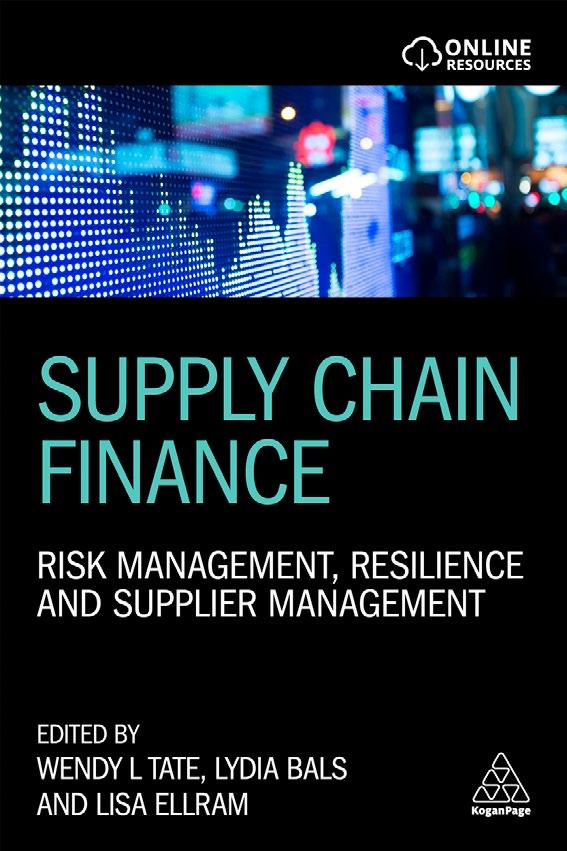
2 Supply chain finance – History and future directions
3 Suppliers, customers, and firms’ financial decisions
4 Supply chain finance – Definition, modern aspects and research challenges ahead
5 Optimizing cash flows for a retail supply chain coordinator
6 Supply chain finance opportunities by managing payables discounts
7 Mapping and managing the financial supply chain
8 Supply chain finance and cyber risk – An illustrative case study
9 Commodity risk management at BMW –Price indices and contracts
10 A business partners’ view on decisionmaking challenges in the supply chain
11 Exploring fragmentation in the supply chain finance (SCF) ecosystem
12 Foundational premises and value drivers of blockchain-driven supply chains – The trade finance experience
• Gain a deeper understanding of the circular economy with a mix of theory and practice to encourage experiential learning
• Explores how different roles in supply chain management, purchasing, finance and sales must collaborate to create the right circular strategy for the business
• Examines the wider societal context of the circular economy and its applications to an individual company, focusing on business models, profitability and transformation
• Includes reflections, exercises and examples to aid understanding of the challenges, opportunities and practical implications of transforming to a circular business model
• Online resources: free introductory access to the online business simulation game The Blue Connection, supporting templates, videos and example course designs
Global consumption of raw materials currently goes beyond the earth's regenerative capacity, but the circular economy offers a more sustainable model which also provides new business opportunities.
Mastering the Circular Economy is an introduction to circularity from a business and value chain management perspective. With many reflections and exercises throughout, the book draws a direct link between relevant recent theory and practice and offers students and practitioners a deeper understanding of the topic. It looks at both the macro and micro context of the circular economy, from the government and societal view to the impact of new business models in an individual company.

Starting from the corporate imperative of moving from linear to circular business models, Mastering the Circular Economy covers the associated opportunities and challenges for organizations, from regulation and risk to value chain collaboration, reverse logistics and product quality. Part two of the book helps students to pull together everything they've learned and see how the concepts play out in the real world by guiding them through application in the online business simulation game The Blue Connection (free basic access is included with the book). Readers are continuously asked to reflect on the choices they would make in different roles to demonstrate a full understanding of the strategic and operational implications of the circular economy.
Ed Weenk is Senior Lecturer of Global Supply Chain Management at Maastricht School of Management and Senior Associate Professor at EADA Business School Barcelona. As a freelance trainer and consultant he also teaches at many other business schools around the world. He is based in Maastricht, the Netherlands.
Rozanne Henzen is a researcher and circular economy expert within the Sustainable Transformation Lab (STL) of Antwerp Management School, based in Antwerp, Belgium. She is currently recognized as one of the Sustainable Young 100 of 2020 in the Netherlands.
Edition: 1
Date: 05/28/2021
Price: $49.99
Paperback: 9781398602748
Ebook: 9781398602762
Pages: 376
Format (mm): 242x170
Band: Textbook
Subject: Sustainability
1 Exploring circularity
1 Introduction to circularity
2 Circularity – exploring the company perspective
3 Circularity – exploring the leadership perspective
4 Circularity – exploring the perspective beyond the company frontier
5 The corporate circular imperative
2 Mastering circularity
6 Knowledge in action – The Blue Connection
7 Circularity – mastering the company perspective
8 Circularity – mastering the leadership perspective
9 Circularity – mastering the perspective beyond the company frontier
10 The corporate circular imperative (2)
3 Imagining the transformation from linear to circular
11 The transformation from linear to circular
12 Circularity – imagining the transformation from the perspective of the company
13 Circularity – imagining the transformation from the perspective of leadership
14 Circularity – imagining the transformation from the perspective beyond the company frontier
15 Conclusion

future
The Blue Connection allows you to achieve a perfect balance between methodology and a practical approach. This innovative web-based business game engages participants in the transitioning from a take-make-dispose linear production towards circular business models by implementing a circular strategy for a virtual e-bike manufacturer. In teams of 4, participants will represent the functional roles of VP Finance, VP Purchasing, VP Supply Chain, and VP Sales.
Accredited by professionals and educators from all over the world, it will motivate your students to deliver optimal performance. Experience how this new tool creates high energy levels and keeps your students engaged!
is now available with Textbook!
Quickly switch between a classic, online, or hybrid classroom se ing
Integrates theory with practice! It aims to offer students and practitioners a deeper understanding of circularity from a business and value chain management perspective.
Easy to implement into your curriculum
Hands-on and engaging writing style with a brilliant structure where the reader is taken on the journey from idea to practice, and towards envisioning the future. Truly recommendable!
– Dr. Desirée Knoppen, Associate professor of circular economy and supply chain management, EADA Business School Barcelona
This timely book provides a thorough overview of the different aspects of the circular economy and concrete tools and exercises for implementing a circular strategy. The combination with The Blue Connection simulation game enables an experiential learning experience that will ensure that students master knowledge and skills needed in the circular economy.
– Eric Dooms, Associate professor of Strategy at TIAS School for Business and Society
An out-of-the-box solution
What’s included in our Integrated Learning Approach?
Mastering the Circular Economy Textbook

Business simulation game
Educator Course Materials
Exercises, videos & more
Our integrated Learning Approach allows for complete flexibility. When designing your course, you can easily tailor it to meet specific wishes!
Easy and fast to implement! Everything needed to start your course today is included. Our Integrated Approach takes away the stress of planning & designing your course.
Flip the switch and change how you teach your students. You control whether it is in a physical classroom, fully online, or a hybrid setting.
We provide 24/7 support and expert guidance to guarantee successful implementation.
Game setup in a nutshell entails participants playing the online business game in teams of 4 people; either virtually or in classroom setting. Eeach of the team members take up one of the four VP roles available in each business simulation game. The teams are challenged to manage a virtual company and consider corporate strategy and business objectives. Our business games provide the ultimate learning experience using best practices from theory and real life.
The team will experience the impact of every decision they make, not just in their own functional ‘silo’ but across their business!
At universities, the circular perspective will become a major topic when teaching students supply chain skills. Mastering the Circular Economy book, in combination with the business game “The Blue Connection”, provides a practical and concrete tool for both top level executives in companies and for professors at universities!
The Blue Connection is a simulation that allows us to manage this transition for an electric bicycle manufacturer, it surfaces many of the challenges we will face in reality and allows us to test different solutions and approaches to understand the interactions and inherent complexities.
Ask your Kogan Page sales representative for more information: kpinfo@koganpage.com Developed by:
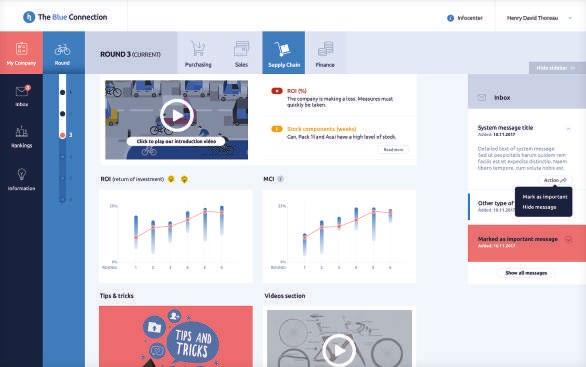
• Provides guidance on how to move away from the 'take, make, dispose' approach towards a circular economy model that regenerates goods into new products

• Explains how to create value instead of waste at every stage in the supply cycle, with real examples and case studies covering ecodesign, food waste apps, industrial manufacturing and key legislation changes affecting circular economies
• New to this edition: circular economy framework 2.0, ecodesign, food & agriculture, recycled fabrics in fashion logistics, new chapter on packaging and examples from Africa, India and other developing countries
• Online resources: lecture slides with figures and tables from every chapter
WINNER: 2018 Les Plumes des Achats & Supply Chain - The Committee Special Prize
As we learn more about the climate and biodiversity crisis, it is clear that how we make and consume things is a major part of the problem. Extraction and processing of materials, fuels and food makes up about half of global greenhouse gas emissions and over 90% of biodiversity loss and water stress. Many modern businesses deplete resources, destroy ecosystems and dump waste and pollution at every stage - harming human health along the way.
Governments, businesses and think-tanks see the circular economy as the way forward. Now in its second edition, A Circular Economy Handbook is a guided tour through the concepts and the practicalities. A unique framework systematically explores the range of circular interventions, including product and supply chain design, material choice and supporting business models.
How does it really work for business? What circular approaches are emerging in food, fashion, consumer technology, packaging and other sectors? How do these reduce risk, improve resilience and build profitable, future-fit organizations? With over 300 real examples from around the world, this is a must-read for businesses, students and policymakers. This new edition has been extensively updated to include the latest trends, thinking, research and solutions, with a new chapter on packaging and 30 new company snapshots.
Catherine Weetman helps businesses thrive by using fair, regenerative and circular approaches that are better for people, planet and profit She founded Rethink Global in 2013, to support organizations that want to explore how circular and regenerative approaches create value. She is a Mentor and Group Leader for the Circular Economy Club, a member of the Strategic Foresight Board for the Circular Economy Alliance, and a member of the advisory board for UKMSN+. She also hosts the Circular Economy Podcast.
Edition: 2
Date: 11/28/2020
Price: $52.95
Paperback: 9781789665314
Ebook: 9781789665321
Pages: 496
Format (mm): 233x155
Band: Textbook/ Professional
Subject: Sustainability
Introduction
1 An overview of the circular economy
1 The circular economy
2 The design and supply chain
3 Circular business models
4 Enablers and accelerators
2 How are businesses adopting circular economy models?
5 Drivers for change
6 Food and agriculture
7 Fashion and textiles
8 Consumer electricals and electronics
9 Industrial manufacturing
10 Packaging and plastics
3 What does this mean for supply chains?
11 Supply chain strategy and planning
12 Supply chain operations: Sourcing and procurement, manufacturing, distribution and reverse logistics
4 Implementation
13 Making the business case and starting the journey
14 Glossary
15 Index
• Contains in-depth international case studies written by leading academics, practitioners and consultants which deliver insights and perspectives on global sustainability trends
• Provides examples of sustainable practices and solutions introduced across different industries, such as food, manufacturing, transportation and construction, including Coca-Cola India, CargoPartners, Saica and Natvita and others
• Examines ways to reach sustainable business objectives through integration of innovative solutions and overcome considerable obstacles, with lessons learned from experts in industry and academia
• Explores innovative new topics and vital new areas of research which will guide readers to form future green and sustainable supply chain strategies
Sustainability is an increasingly urgent and important factor in logistics and supply chain management, impacting the whole supply chain lifecycle from product design and development, to supplier management, packaging, transportation, warehousing and distribution.
The third volume of the Supply Chain Case Study Collection, the Sustainable and Green Supply Chains and Logistics Case Study Collection contains real-life scenarios from leading companies who are pursuing a sustainability agenda. Cases cover sustainability and 'green' practices in a range of different industries, from food through to manufacturing and construction, and in a variety of organization sizes. They are written by leading international academics and feature cutting-edge research from countries including India, Vietnam, Brazil, China and the UK.

By exploring examples of waste reduction, supplier management, the circular economy and cross-industry collaboration, the Case Study Collection focuses on how organizations are currently trying to meet sustainability goals and achieve success in greening supply chains.
Dr Ozlem Bak is a Senior Lecturer in Operations Management at Brunel Business School, based in London, UK. Her academic activities are underpinned by industrial and commercial background which included experience in the automotive industry for companies such as Daimler, Chrysler and Hyundai. Her current research interests lie in supply chain management, particularly organisational transformation and e-business implementations in supply chains.
Edition: 1
Date: 11/28/2021
Price: $224.00
Ebook: 9781789668223
Pages: 304
Format (mm): 240x160
Band: Reference
Subject: Sustainability
• Examines the new technologies, artificial intelligence systems and applications needed to drive a sustainable trucking industry
• Explains how the acceleration of the adoption of zero emission transport will be linked to infrastructure investments, supported by case studies from companies such as Jaguar, Land Rover and Honda
• Presents the many other factors that will impact the survivability of Diesel as an energy source in the future, for the global manufacturers of Diesel cars and trucks
• Details new players in freight sustainability across four continents and examines future plans and models, which manufacturing companies are planning to role out by 2050
The transport industry has an important role to play in addressing climate change and the environmental challenges facing governments, businesses and individuals.
Achieving net zero emissions by 2050 will require this sector, which is a large contributor of emissions, to innovate, adapt and drive positive change. New technologies including batteries and alternative fuels will all be significant, as will developing different approaches and outlooks.
The Road to Zero Emissions is the comprehensive guide for those in the transport industry to understanding what can and is being done to tackle climate change. Through examining established companies and new entrants in the automotive space, readers are provided with examples of the importance of infrastructure, business innovation and financing for the future. In addition to this, the role of governments in establishing policies, such as zeroemission zones, is also discussed. Progressing towards zero emissions requires immediate change and this book will start you on the journey.

Dennis Evans has held senior positions in truck manufacturing companies around the world, most recently with a division of VW Commercial Vehicles. He has worked in the UK, Europe, USA, South America, Middle East and Africa, with all of the major vehicle manufacturers.
Des Evans is an honorary Professor within the Advanced Services Group at Aston University Business School. He was awarded an O.B.E. for services to the Motor Industry.
Alistair Williamson started as a technical engineer with Bedford Trucks and graduated through senior engineering roles at Scania UK and MAN AG, becoming Global Marketing Director for MAN AG based in Munich. He has operated his own successful Marketing consultancy for 14 years.
Edition: 1
Date: 09/28/2020
Price: $69.99
Paperback: 9781789665604
Ebook: 9781789665611
Pages: 312
Format (mm): 235x158
Band: Professional/ Academic
Subject: Sustainability
Introduction
1 The road to zero emissions
2 The fall of the diesel engine and the rise of the electric motor
3 Climate change action and the Paris Agreement
4 The climate change challenge
5 Infrastructure challenge and the role of government
6 ‘Shock waves’ in the global battery market
7 Global energy systems and the impact of electric vehicles
8 EV development and the world’s ‘top 10’ commercial vehicle manufacturers
9 ‘New kids on the block’ – new entrants into the EV market space
10 Alternative fuels to diesel and electricity for trucks and transportation
11 Business innovation in the automotive sector
12 Financing the future
13 Journey milestones
14 The journey continues – 2050 and beyond
• Provides original research conducted by the Kühne Logistics University, Hamburg
• Presents vital insights into how different companies have tackled decarbonisation with a focus on transportation
• Includes a new decarbonisation framework within which external factors can be classified and systematically assessed by companies
• Explains the external factors likely to influence the carbon reduction in logistics, such as freight transport demand, truck fuel consumption and related CO2 emissions
Logistics accounts for around 9-10% of global CO2 emissions and will be one of the hardest economic sectors to decarbonize. This is partly because the demand for freight transport is expected to rise sharply over the next few decades, but also because it relies very heavily on fossil fuel. Decarbonizing Logistics outlines the nature and extent of the challenge we face in trying to achieve deep reductions in greenhouse gas emissions from logistical activities. It makes a detailed assessment of the available options, including restructuring supply chains, shifting freight to lower carbon transport modes and transforming energy use in the logistics sector. The options are examined from technological and managerial standpoints for all the main freight transport modes.
Based on an up-to-date review of almost 600 publications and containing new analytical frameworks and research results, Decarbonizing Logistics is the first to provide a global, multi-disciplinary perspective on the subject. It is written by one of the foremost specialists in the field who has spent many years researching the links between logistics and climate change and been an adviser to governments, international organizations and companies on the topic.

Alan McKinnon is Professor of Logistics at Kühne Logistics University, Hamburg. He has been researching and teaching freight transport and logistics for almost forty years and has published extensively in journals and books. He was a member of the European Commission's High Level Group on Logistics, Chairman of the World Economic Forum's Logistics and Supply Chain Industry Council and a lead author of the transport chapter of the Intergovernmental Panel on Climate Change's fifth assessment report. He has spent many years researching the links between logistics and climate change and been an adviser to governments, international organizations and companies on this topic.
Edition: 1
Date: 06/28/2018
Price: $59.99
Paperback: 9780749483807
Ebook: 9780749480486
Pages: 328
Format (mm): 234x158
Band: Professional/ Academic
Subject: Sustainability
1 Climate change: the nature and scale of the challenge
2 Developing a decarbonisation strategy for logistics
3 Reducing freight transport intensity
4 Shifting freight to lower carbon transport modes
5 Improving asset utilisation in logistics
6 Transforming energy use in road freight transport
7 Transforming energy use in maritime, air cargo and rail freight sectors
8 Decarbonising logistics at the national level: the case of the united kingdom
• Examines all the key areas in sustainable logistics and supply chain management including transport, warehousing and operations
• Provides a comprehensive overview of sustainability science, as well as an understanding of sustainability as it relates to supply chain
• Offers topical case studies based on extensive research by the experts in the field designed to be used in teaching
• New to this edition: Updated with coverage of the latest research and data including trends in logistics and supply chain management and new cases
• Online resources: instructor manuals, lecturer slides and a compiled list of tables and figures
Our daily lives are permeated by the activities of logistics and supply chain, from food and clothing to doorstep deliveries. As these processes have the ability to significantly impact the natural environment, it has never been so important to develop and implement sustainable principles and practices.
Sustainable Logistics and Supply Chain Management is an essential textbook for undergraduate and postgraduate students for understanding sustainability as it pertains to logistics operations. This book covers the direct environmental impacts of logistics and supply chain processes, including emissions and waste, as well as how wider changes such as globalization need to be given similar considerations. Presenting different pathways to guide readers, case studies and supported by extensive research, this book provides all the support needed to understand and implement a sustainable approach.
Now in its third edition, Sustainable Logistics and Supply Chain Management is fully updated with the latest research and data including trends in logistics and supply chain management and new cases. Online resources include instructor manuals, lecturer slides and a complied list of figures and tables.
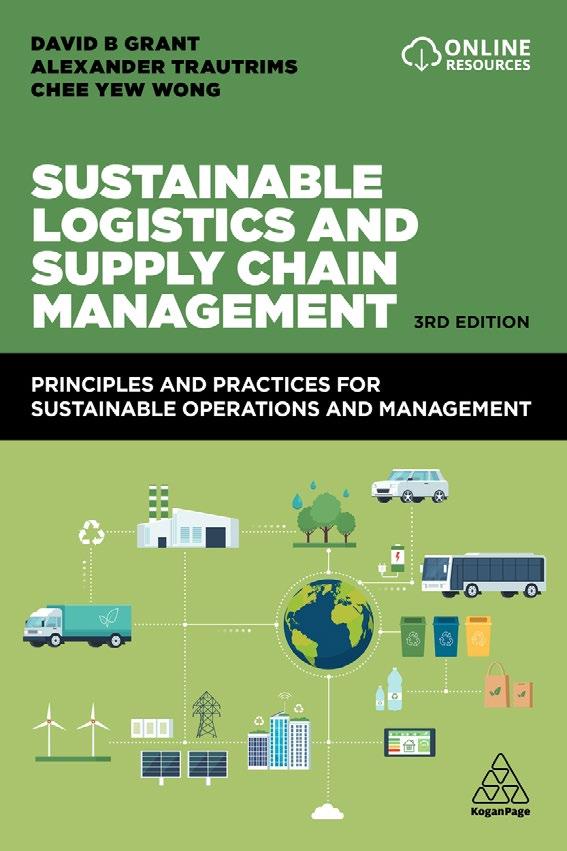
Professor David B. Grant is Professor of Supply Chain Management & Social Responsibility, Hanken School of Economics, Helsinki, Finland and Bua Luang ASEAN Chair Professor, Thammasat University, Bangkok, Thailand. He has over 175 publications and participates in editorial boards for numerous journals.
Professor Chee Yew Wong is Chair of Supply Chain Management at Leeds University Business School, UK. He has extensive consultancy experience in operations, purchasing, production, inventory and distribution management.
Dr Alexander Trautrims is a Lecturer in Supply Chain and Operations Management at Nottingham University Business School, UK. His research focuses on sourcing, compliance and supply issues.
Edition: 3
Date: 11/28/2022
Price: $56.24
Paperback: 9781398604438
Ebook: 9781398604445
Pages: 304
Format (mm): 235x158
Band: Textbook/ Professional
Subject: Sustainability
Introduction
1 Logistics and supply chain management
2 Science of sustainability
3 Freight transport
4 Sustainable warehousing
5 Product design, cleaner production and packaging
6 Sustainable purchasing and procurement
7 Reverse logistics and recycling
8 Risk, resilience and corporate social responsibility
9 Sustainable logistics and supply chain management strategy
• Presents vital research from leading academics on sustainable supply chains, from the German Research Foundation - Deutsche Forschungsgemeinschaft (DFG) - the selfgoverning organization for science and research in Germany
• Provides examples of best practice in sustainable value chains from a cross-section of industries, such as agriculture, energy and retail
• Examines the impact of digitalization as an enabler for sustainable supply chains and a facilitator of high performance
• Focuses on increasing cost savings, profits and revenue
Sustainability can create greater efficiency and cost savings in the supply chain. Supply chains, which are more complex and global than ever before, are full of both risks and opportunities. The risks range from inconsistent or poor quality, supply disruptions and health and safety concerns, to corruption. Businesses face pressure to adopt sustainable supply chain practices from various stakeholders and motivations typically come from one or more of four sources: customers, compliance, costs, competitive advantage. Sustainability in Global Value Chains is the guide to understanding all aspects and approaches of sustainable supply chains using in-depth research from leading academics from sixteen different universities.
Sustainability in Global Value Chains focuses on how to make supply chains sustainable, with an emphasis on new technologies and digitization. The research featured covers topics such as KPIs in production and supply chains, the role of standards, blockchain technology and algebraic models. This comprehensive book presents real world issues, problems in implementing sustainability in the supply chain and examples of best practice.
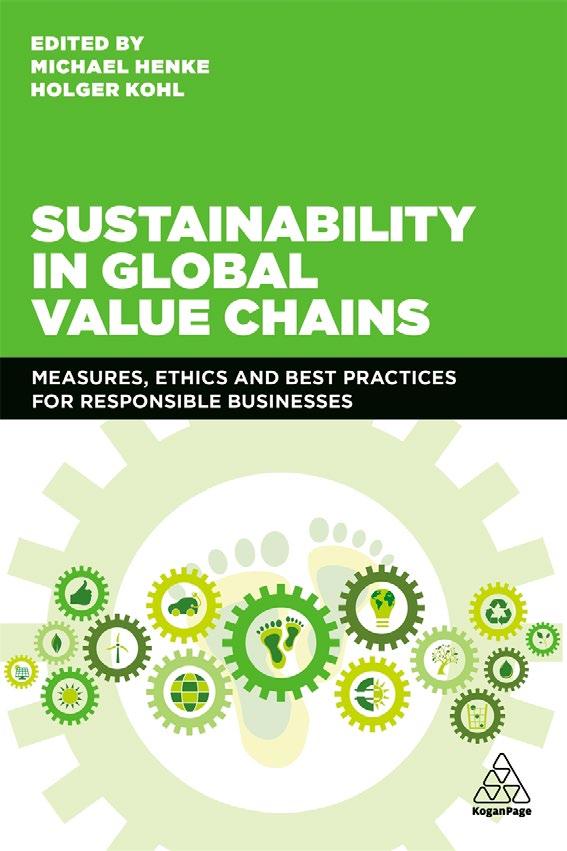
Michael Henke is Chair of Enterprise Logistics at TU Dortmund University, Director of Enterprise Logistics, IML Dortmund, Professor for Strategic Sourcing and Procurement at Louvian School of Management, Paris and Professor for Supply Chain Management at Lappeenranta University of Technology, Finland.
Holger Kohl is Director of Corporate Management at Fraunhofer IPK (Fraunhofer Institute for Design and Technology) and Head of Department in Sustainable Corporate Development at TU Berlin.
Edition: 1
Date: 02/28/2021
Price: $65.95
Paperback: 9781789662627
Ebook: 9781789662634
Pages: 304
Format (mm): 235x157
Band: Textbook/ Professional
Subject: Sustainability
1 Introduction – About the book
2 The importance of supply chain management for sustainability in global value chains
3 Interdisciplinary research work in the field of SSCM
1 Ethical principles of sustainable value chain management
4 Start-ups as relevant supporters and initiators of sustainability attributes in global value chains of the future
5 Global value chain sustainability governance – Implications for management research and practice
2 Measuring sustainability in global value chains
6 Sustainability controlling in integrated value chains
7 Measuring diversity among competing supply-value chains
8 Sustainable buyer behaviour in value chains – Determinants and marketing implications
9 Tactical planning measures for sustainable and efficient international transportation networks
3 Actions to continuously improve sustainability in global value chains
10 Biomimetic principles for improved organizational information processing –Toward sustainable supply chains
11 (How) Can research in the field of sustainable supply chain management become more forward-looking and futureshaping?
12 Success factors of voluntary sustainable supply chain management sector initiatives
13 An institutional framework of urban logistics – Policy options and the role of the government
14 Index
• Looks at the international trade of waste between countries, where hazardous and non-hazardous wastes are exported from developed to developing countries
• Features theory and research supported by fascinating case studies looking at transboundary waste transfer, covering essential topics such as the Chinese ban on waste imports and the huge issue of plastic waste
• Includes governance and management models and strategies for dealing with the waste crisis

• Presents vital data and statistics on the waste crisis, examines possible causes and introduces different discourses and strategies
• Performs a comparative analysis between the current main laws that regulate waste at international, European and Brazilian levels
WINNER: 2020 International Solid Waste Association Publication Award
Among other factors, rapid global population growth, our development model and patterns of production and consumption have increased waste generation worldwide to unsustainable rates. This rise has led to crises in many countries where waste management practices are no longer sound. Global Waste Management outlines the emerging global waste crisis considering the perspectives of developed and developing countries around the world and the international relationships between them. This book provides an ecological viewpoint as well as studying these problems from a legal and justice standpoint.
Global Waste Management contextualises the problems faced when dealing with waste including the causes and origins. Focus is given to cross border waste transfer, as an ongoing and controversial practice, making waste management a global matter. This book scrutinizes existing international, European and Brazilian regulation on waste to highlight the complexity of the subject and the weaknesses of the law. Using a critical and socioecological approach, the book proposes an original model of governance to support a new system of global waste management that takes into account ecological sustainability and social justice to overcome the waste crisis. To create these models, a theoretical framework on socio-ecological justice is developed and combined with different discourses and theories described throughout the book. This is the essential guide to understanding the global waste crisis and the future of waste management.
Dr. Kamila Pope is an environmental lawyer and researcher. She is a member of the World Commission on Environmental Law (WCEL/IUCN), the Experts Committee at Halte à l'Obsolescence Programmée (HOP), and Harmony with Nature Knowledge Network Experts (HwN/UN). She has won two international awards for research on sustainability and her PhD thesis was elected the best Brazilian legal thesis of 2019, a prize awarded by the Ministry of Education and Research of Brazil.
Edition: 1
Date: 04/28/2020
Price: $69.99
Paperback: 9781789660777
Ebook: 9781789660784
Pages: 416
Format (mm): 234x156
Band: Textbook/ Professional
Subject: Sustainability
Introduction
1 The socio-ecological problem of waste
1 The waste crisis – origins and causes
2 Waste as a problem of justice
3 Models to overcome the waste crisis
2 A new waste management system for a sustainable and just future
4 Waste as a legal problem
5 Legal regulation of cross-border waste transfer
6 Global governance and the management of waste
7 Conclusion
8 References and further reading
9 Index
• Examines the ethical, social and economic causes and their negative consequences
• Clarifies how the sustainability ideal aligns with Economics and Law, and how manufacturers and supply chain practices can integrate it into their processes
• Outlines theoretical frameworks for tackling planned obsolescence
• Presents real-life case studies which give insights into production, consumption patterns and planned obsolescence
• Online resources: Chapter-by-chapter lecturer slides
Planned obsolescence is a strategy used to make products obsolete, leading to their premature replacement. The result is the over-exploitation of natural resources, increased waste and detrimental social impacts. It is a known practice in consumer electronics and affects other industries as they put profit before consequence.
A ground-breaking new book, Understanding Planned Obsolescence looks at the causes, cost and impact of planned obsolescence. It considers the legal and economic frameworks to overcome the practice and how to mitigate its effects. It also unearths new patterns of production and consumption highlighting more sustainable development models. Including a wide range of case studies from Europe, USA and South America, Understanding Planned Obsolescence is a vital step forward for the future of business and academia alike. Online resources now available include chapter-by-chapter lecturer slides.

Kamila Pope is an Environmental Law and Bio-law lecturer, researcher and lawyer. She has published a plethora of articles, chapters and papers covering Environmental Law, Sustainability, Planned Obsolescence and Waste Management. She holds a Master's in Law, Environment and Political Ecology and is studying a PhD in Law, Politics and Society.
Edition: 1
Date: 01/28/2017
Price: $84.99
Paperback: 9780749478056
Ebook: 9780749478063
Pages: 240
Format (mm): 234x156
Band: Textbook/ Professional
Subject: Sustainability
Introduction
1 Identifying the causes, consequences and history of planned obsolescence
1 Consumer society: A product of the growthist economy
2 Planned obsolescence as an instrument of the growthist economy and its socioenvironmental consequences
2 How to overcome planned obsolescence: from theory to practice
3 Sustainability in Economics and Law: The greening of sciences in the search for a new paradigm
4 The sustainability paradigm as the foundation to tackle planned obsolescence: New perspectives
5 Final considerations
• Examines the most pressing issues and current trends in green logistics
• Analyses the environmental consequences of logistics and how to deal with them
• Examines ways of reducing these externalities and achieving a more sustainable balance between economic, environmental and social objectives
• Provides insightful international case studies that illustrate the impact of green logistics in practice
• Online resources: Graphics, tables, chapter summaries, and guidelines for lecturers
Leading the way in current thinking on environmental logistics, Green Logistics provides a unique insight on the environmental impacts of logistics and the actions that companies and governments can take to deal with them. It is written by leading researchers in the field and provides a comprehensive view of the subject for students, managers and policy-makers.
Fully updated, the 3rd edition of Green Logistics has a more global perspective than previous editions. It introduces new contributors and international case studies that illustrate the impact of green logistics in practice. There is a new chapter on the links between green logistics and corporate social responsibility and a series of postscripts examining the effects of new developments, such as 3D printing, distribution by drone, the physical internet and the concept of peak freight.
Other key topics examined include: carbon auditing of supply chains; transferring freight to greener transport modes; reducing the environmental impact of warehousing; improving the energy efficiency of freight transport; making city logistics more environmentally sustainable; reverse logistics for the management of waste; role of government in promoting sustainable logistics.
The 3rd edition of Green Logistics includes indispensable online supporting materials, including graphics, tables, chapter summaries, and guidelines for lecturers.

Alan McKinnon is Professor and Head of Logistics at Kühne Logistics University, Hamburg. He has been researching and teaching in freight transport and logistics for 35 years and has published in journals and books. He's been an adviser to several governments and international organisations on environmental aspects of logistics.
Michael Browne is Professor of Logistics at the University of Westminster, London. He has worked on studies for Transport for London, the European Commission, the UK Department for Transport, Research Councils and commercial organizations.
Maja Piecyk is Associate Professor in Logistics at Heriot-Watt University, Edinburgh. Much of her research focuses on the optimisation of supply networks, carbon auditing of logistics and long-term trends in the energy requirements and environmental impacts of logistics.
Anthony Whiteing is Senior Lecturer in the Institute for Transport Studies at the University of Leeds. An academic with 30 years' experience, he's been involved in various UK and European research projects primarily in the field of freight transport.
Logistics, Operations and Supply Chain Management
Edition: 3
Date: 02/28/2015
Price: $59.99
Paperback: 9780749471859
Ebook: 9780749471866
Pages: 448
Format (mm): 235x155
Band: Textbook/ Professional
Subject: Sustainability
• Outlines suitable and safe conditions in which to manufacture products
• Clarifies issues on waste and what it does to the environment
• Depicts how to analyse the impact of the transportation of goods in terms of pollution
• Looks at ways road freight operators, warehouse companies, shipping lines and airlines can mitigate their impact on the environment
• Explores case studies including CEVA, ASOS, Apple, Intel, Exol Lubricants, ProLogis, Sports Direct, Unilever, Citylink, Deliveroo/Ubereats and Hewlett Packard
It is increasingly clear that traditional supply chains which focus on sourcing products from the lowest possible cost suppliers are failing to exploit their full potential. Supply Chain Ethics, through case studies, surveys and unique research, identifies and outlines best practice employed by global manufacturers, retailers and logistics companies. It examines the so-called 'triple advantage' that accrues to businesses when strategies that combine bottom line profits, sustainable environmental practices and positive societal impact are employed. Narrow supply chain strategies which focus on only one of these three factors will inevitably fail.
Supply Chain Ethics covers the following issues which affect senior supply chain, operations and manufacturing managers: 'triple advantage' best practice and how it can create value for global businesses; product design; sourcing and warehousing; transportation and recycling; environmental practices of logistics companies and suppliers; supply chain technologies. There is also an invaluable Ethical Supply Chains survey of top global companies.
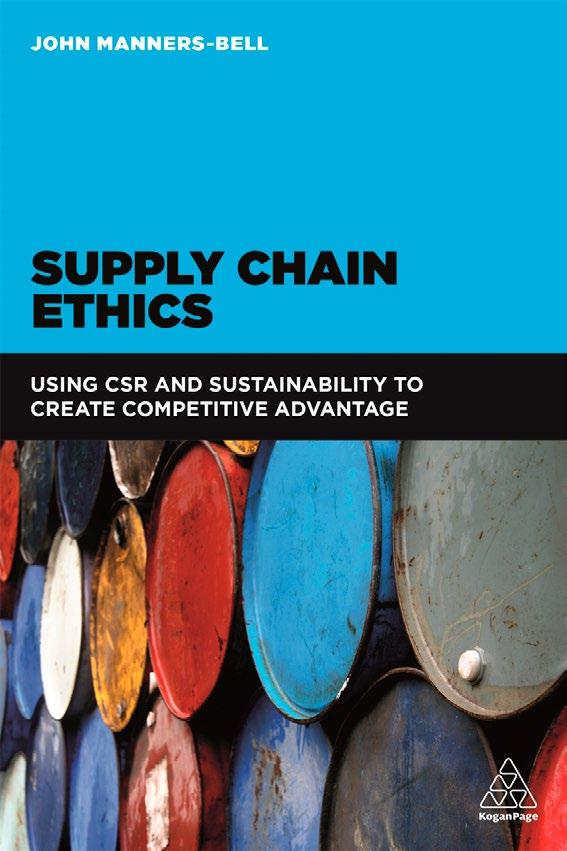
John Manners-Bell is Founder and CEO of Transport Intelligence Ltd, Bath, UK, which since 2002 has developed a market-leading position in the provision of market research to a range of blue chip customers and governmental organisations. He is former Chair of the Logistics and Supply Chain Global Agenda Council of the World Economic Forum, attending meetings in the UAE, China and South Africa as well as speaking and moderating at the annual Davos meeting. He is regularly quoted in the trade and national press (FT, Bloomberg, Wall Street Journal, Economist) and has spoken at conferences worldwide.
Edition: 1
Date: 03/28/2017
Price: $59.99
Paperback: 9780749479459
Ebook: 9780749479466
Pages: 296
Format (mm): 235x160
Band: Professional/ Academic
Subject: Sustainability
Introduction
1 New Thinking and Business Models
1 Profit, People and Planet – The Triple Advantage
2 Supply Chains in the ‘Circular Economy’
3 The Role of Supply Chain Technologies
4 Sustainable Supply Chains Survey
2 Public Policy and Industry Response
5 Government Policy and Industry Response to Climate Change
6 Implementing a CSR Strategy
7 Sustainable Warehousing and Distribution
8 Sustainable Packaging Initiatives
9 Global or Local? The Ethical Debate
3 Ethical Issues in the Supply Chain
10 Societal and Environmental Supply Chain Responsibility
11 Ethics in the Supply Chain – Societal Impact
12 Ethical Supplier Relationships
13 Treatment of Workers in the Modern Logistics Sector
• Delivers an in-depth investigation of the full scope of the airline industry
• Includes industry analysis of competing business models and the impact of airline alliances
• Provides an assessment of airline performance, examining core competencies, dynamic capabilities and key performance indicators
• Learn from case studies including Monarch, Air Berlin, Niki, Sabena, examining airline capacity management, risk models and fuel hedging
The aviation industry is a major driver of world trade. As global markets and economies are constantly evolving, practitioners and academics need more quality information and a broader perspective of aviation management rather than just silo-based knowledge, particularly if they wish to move up the management ladder and progress. Air Transport Management presents the dynamic shifts which have influenced structural changes in the aviation industry, such as the emergence of low cost carriers. These changes have transformed the market, leading to deregulation and consolidation. The author provides a viable road map aimed at giving students and managers in the aviation industry a rigorous understanding on how to manage strategically in complex and turbulent market conditions.
Air Transport Management examines the airline industry structure in terms of entry barriers, competition dynamics and competing business models. With the inclusion of fascinating case studies, this handbook assesses different business models used by international companies and proposes best fit management practices which airlines should follow in order to survive.

Prof Dr Eyden Samunderu (PhD) is a leading expert and well trusted advisor in the area of air transport with extensive international consulting experience. He is Program Director for a Master's programme at the International School of Management (ISM) in Dortmund Germany. He is currently a Board Advisor at Aviation Partners Africa London as well as sitting as Advisory Board Member for the Hamburg Aviation Conference. His research interests are in air transport economics, airport infrastructure financing, container and shipping logistics, competition policy, multimarket contact and strategic group theory in air transport.
Edition: 1
Date: 11/28/2019
Price: $62.99
Paperback: 9780749484569
Ebook: 9780749484576
Pages: 384
Format (mm): 235x155
Band: Textbook/ Professional
Subject: Transport
1 The scope of the airline industry
2 Growth and change in the airline industry – Air transport liberalization
3 The airline alliances
4 Airline industry analysis – A structureconduct-performance perspective
5 Airline competing business models
6 Airline competition dynamics
7 Measuring airline performance
8 Strategic groups in the airline industry
9 The future outlook of air transport
10 Conclusion
11 Index
• Explains how the rapidly evolving global logistics industry works in close partnership with the aviation operators to achieve fast and efficient facilitation

• Looks at air freight and how carriers are responding to market demands with new and better methods and technologies
• Reviews changes in manufacturing and production methods
• Illustrates how different challenges are met in varied markets through insightful case studies
• Features contributions from a team of experts, including: Oliver Evans, Chief Cargo Officer at Swiss International Airlines Ltd and Stan Wraight, who has over 40 years of industry experience gained through both senior management and board level positions at KLM Cargo, Atlas Air and AirBridge Cargo
• Online resources: Air Cargo News' Freighter Directory
Aviation Logistics looks at the function of the air cargo business and its role in global supply chains and logistics. As global economies are constantly evolving, the supply chain business with its transport partners must be proactive for the future. Technology and its resulting efficiency and transparency are therefore a central part of this book. Aviation Logistics examines how carriers are coming up with new methods and technologies to improve ground handling and road transport, traceability systems and barcoding, security and screening, and safe delivery of perishable items (such as in the pharmaceutical and medical sectors).
Endorsed by The International Air Cargo Association (TIACA), Aviation Logistics is supplemented with case studies and contributions from a team of experts including Oliver Evans and Stan Wraight, both industry experts.
Online resources available: Air Cargo News' Freighter Directory.
Michael Sales specializes in press relations and consultancy for the transport industry. He has handled a number of prestigious clients, including Airports of Paris, Air France Express, Athens International Airport, Cologne Bonn Airport, ECS, Basque regional industrial promotion, Düsseldorf Airport, Budapest Airport and many more. He is also a freelance journalist.
Edition: 1
Date: 02/28/2016
Price: $69.99
Paperback: 9780749472702
Ebook: 9780749472719
Pages: 208
Format (mm): 234x155
Band: Textbook/ Professional
Subject: Transport
1 Air cargo – trying harder
2 The world of air cargo, Oliver Evans, former TIACA
3 Air cargo history
4 Airport connections
5 Cargo handling agents – the impact of IT
6 Road feeder service
7 Freight forwarder
8 Cool logistics
9 Express and mail
10 Special air cargoes
11 Cargo security and risk
12 Environment
13 Innovation and trends in air logistics
14 Views on the future
15 The law – organizations and regulations governing international aviation
16 Glossary of common air freight terms
• Essential guide to cost-effective, sustainable road passenger transport management
• Features a complete set of management tools equipping readers for success in the passenger transport field
• Includes essential guidelines on topics such as coordinating staff training, putting together performance reports for directors and arranging vehicle maintenance
• Online resources: sample performance reports and target assessment forms.
Road passenger transport management is an important role, involving the planning and coordinating of passenger transport operations, including routes and schedules.
Managers ensure that passengers reach their destinations safely, on time and in the most cost-effective way. Road Passenger Transport Management covers all the essential tasks a transport manager is expected to master.
Road Passenger Transport Management provides tips and tools for working with customers, planning routes and scheduling delivery times, as well as managing a team of supervisors, administration staff and drivers. The authors include guidelines for coordinating staff training and arranging vehicle maintenance, MOTs and tax payments, as well as organizing vehicle replacements and managing contracts and developing new business. This is a contributed book, with expertise shared from well-known academics and practitioners who have spent many years in the passenger transport field. The tools and case studies in this vital new guide will enable readers to learn new skills or build on existing expertise. Online supporting resources include sample performance reports and target assessment forms.
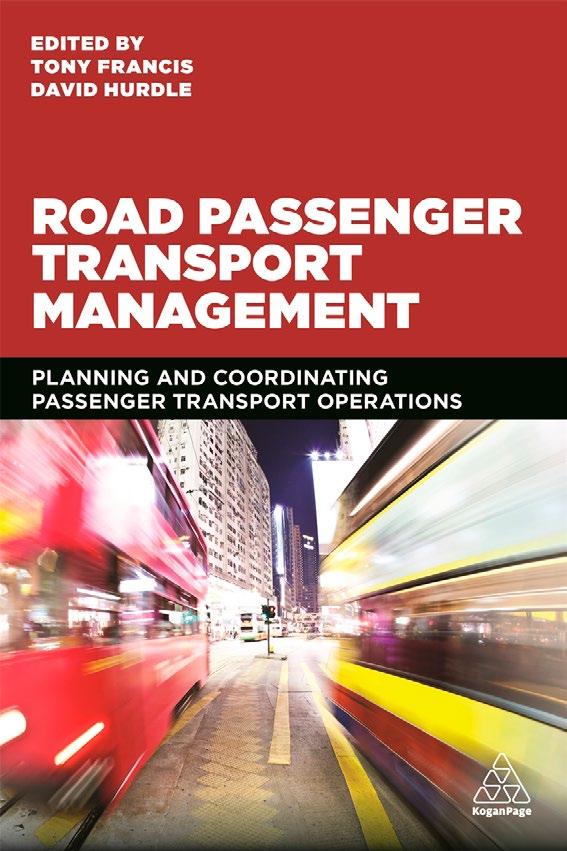
Anthony Francis is a consultant providing guidance on operating and commercial issues affecting the road, rail and aviation transport industries to passenger transport companies. He previously worked in senior strategic roles for the Department of Transport, the Strategic Rail Authority and Arriva.
David Hurdle is an independent transport consultant and a transport and town planner. He has written and spoken extensively on sustainable transport issues. He has worked for local government and the public transport industry.
Edition: 1
Date: 09/28/2020
Price: $62.99
Paperback: 9780749497019
Ebook: 9780749497026
Pages: 352
Format (mm): 234x157
Band: Professional/ Academic
Subject: Transport
1 How the bus business works
1 Definition of road passenger transport
2 History, heritage, current challenges
3 The legal and regulatory framework
4 Planning
5 Vehicles and fuels
6 Operations
7 Fares, ticketing and other revenue – turning a social service into a business
8 Human resources case study: Metroline
2 Wider engagement
9 The present and potential market for public transport
10 Bus provision and land use planning
11 Bus priority
12 Planning and operating a rural bus service
13 Further partnerships between bus operators, local authorities and employers
14 The bus industry in Wales
15 Working with the public
16 The value of the bus to society
17 Presentation
18 The future and new technology
19 Appendix I (by Cyril McIntyre) – Regulation of road passenger transport in the Republic of Ireland
20 Appendix II (by Gavin Booth) – Scotland’s buses
21 Index
• Outlines the essential information on warehouse management and how to overcome common challenges and exploit potential opportunities
• Provides practical advice on how to operate an efficient and cost-effective warehouse using methods such as resource planning, labour management and warehouse layout
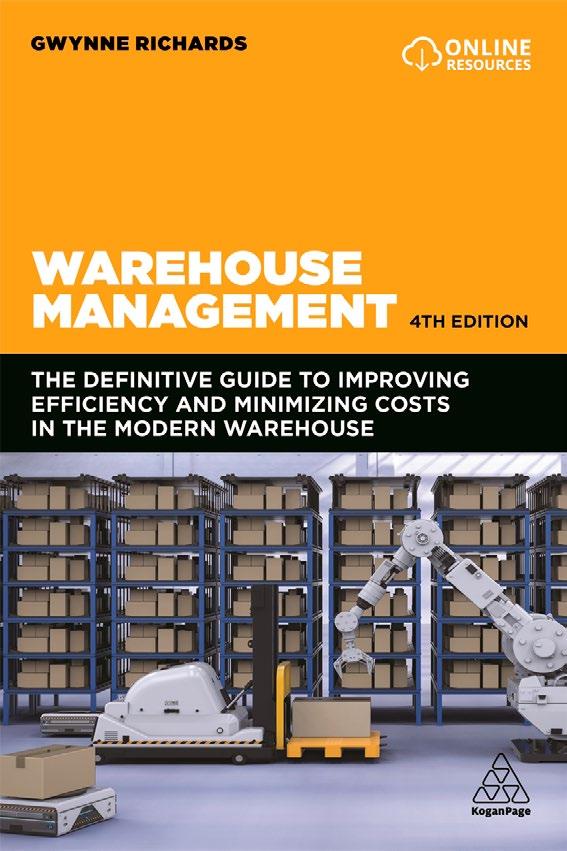
• Explores the latest technologies in warehousing, including robotics, cobots, technologies for dealing with pandemics, AI and drones in the warehouse, along with how these will impact the future of warehousing
• New to this edition: updates on new technologies in warehousing, the latest thinking on the future of warehouses and renewed online resources
• Online resources: PowerPoint slides (lecturer slides), bonus chapter on outsourcing
Modern warehouses are capitalizing on cutting-edge technologies, new operating models and innovative practices to maximize their role in the wider supply chain. Understand how to successfully manage these warehouses with this bestselling guide.
The fourth edition of Warehouse Management is fully updated to include up to date information across the board. The latest technologies in warehousing, such as robotics, cobots and AI, are explained and their impact is situated alongside discussions on the future of warehousing. There are new case studies from companies who have achieved improvements and cost savings through the introduction of new technology and equipment, leaner processes and environmental initiatives. Gwynne Richards provides expert advice with clear and easy to grasp solutions.
Warehouse Management guides the reader through all aspects of successfully managing a warehouse, its operations and distribution. This bestselling book covers an extensive range of key topics from defining the modern warehouse, detailing management processes, strategies and practices to outlining how to tackle environmental challenges to ensure a sustainable supply chain. With practical insights into how to improve operating costs, increase efficiency and reduce costs, this is a must read for optimizing warehouse performance. New and updated online resources include PowerPoint slides and a bonus chapter on outsourcing.
Gwynne Richards has over 30 years of experience in warehouse management and logistics and is based in the Vale of Glamorgan, UK. As well as running his own successful logistics consultancy, he provides a number of courses on warehouse and transport management and logistics outsourcing for practitioners. He is the co-author of The Logistics and Supply Chain Toolkit with Susan Grinstead and The Logistics Outsourcing Handbook with Jo Godsmark, both published by Kogan Page.
Edition: 4
Date: 11/28/2021
Price: $80.00
Paperback: 9781789668407
Ebook: 9781789668414
Pages: 536
Format (mm): 235x155
Band: Textbook/ Professional
Subject: Warehouse Management
Introduction
1 The role of the warehouse
2 Role of the warehouse manager
3 Warehouse processes - Receiving and put-away
4 Warehouse processes - Pick preparation
5 Goods-to-person and person-to-goods picking
6 Order-picking methods
7 Warehouse processes from replenishment to despatch and beyond
8 Information systems in the warehouse
9 Warehouse layout
10 Storage and handling equipment
11 Resourcing a warehouse
12 Warehouse costs
13 Performance measurement and management
14 Health and safety
15 The warehouse and the environment
16 The warehouse of the future
17 Appendix 1 Global warehouse costs
18 Appendix 2 Warehouse audit checklists
19 Bibliography
20 Websites of companies that have contributed to this book and other useful websites
21 Glossary
• Presents the complex detail of warehousing and transportation logistics in a clear and digestible way
• Provides full-colour technical drawings, structural models and tables which clearly illustrate technical issues
• Translated from the original German bestselling book, Transport-und Lagerlogistik, published by Springer Nature.
• Includes valuable tools for planning and making economic efficiency calculations
• Provides more than 200 examples with worked solutions and gives the reader targeted practice with 250 questions and answers
Warehousing and Transportation Logistics offers an overview of transport, warehousing and assembly logistics, including order picking, packaging, handling and management. The key focus is on the management techniques in transport and warehousing and the logistics-focused perspective runs throughout the entire book. The author examines different applications and planning techniques and includes examples of supporting economic calculations and questions and answers.
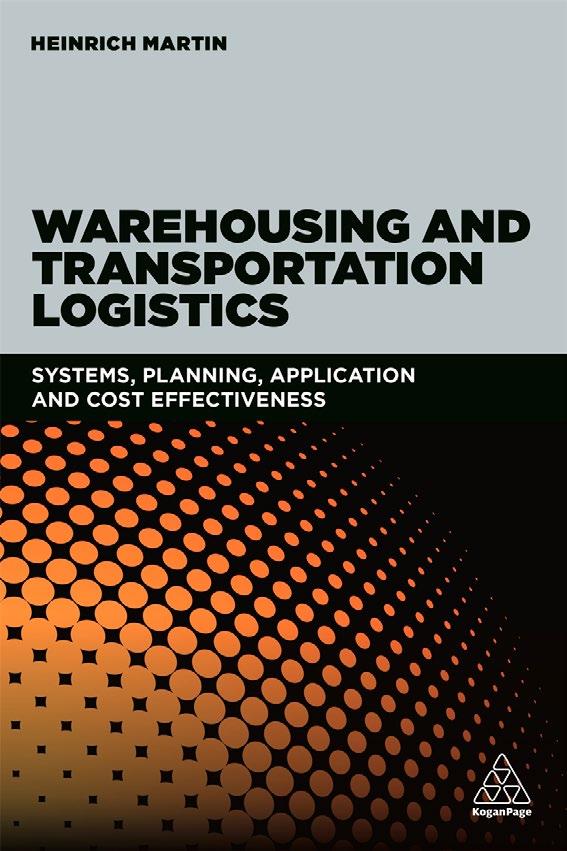
Warehousing and Transportation Logistics looks at unit creation, material flow or goods storage as well as systems and management for planning or information to identify objects, control and processing of orders. It is a practice-oriented book for students with a multitude of useful information and ideas. It is also a workbook for professional practitioners, production, planning and industrial engineers, who are specifically concerned with the planning side of this specialist area. The examples at the end of each chapter deepen and complement the content and there are comprehensive notes with each figure providing additional information on the topic.
Professor Heinrich Martin was a lecturer at the University of Applied Science in Hamburg for over 30 years, and has been a visiting lecturer in universities around the world. His areas of expertise include transportation systems, warehousing systems, order picking systems, material flow systems and factory planning. Dr Martin has lead multiple projects with numerous organisations.
Edition: 1
Date: 04/28/2018
Price: $84.99
Paperback: 9780749482206
Ebook: 9780749482213
Pages: 680
Format (mm): 241x170
Band: Textbook/ Professional
Subject: Warehouse Management
1 Logistics Structures Within Companies
2 Material Flow Logistics
3 Transporting Goods – Packaging, Loading Unit
4 Basic Transport Logistics
5 Continuous Conveyor
6 Discontinuous Conveyor
7 Switching
8 Handling
9 Basic Warehouse and Picking Logistics
10 Warehouses and Shelves
11 Picking Systems
12 Planning System and Project Management
13 Information Logistics
Innovation and Best Practice in:

























































































































































































Marketing Strategy
Sustainable Marketing
Marketing Planning
Marketing Analytics



























































































































B2B Marketing
Digital Marketing




















Marketing Communications











Luxury Marketing
Market Research







Branding














Event Management




Public Relations
Retail Sales & Key Account Management

















Social Media

Social Media Marketing







• Offers a well-rounded approach to the new realities of marketing professions, including discussions of multidisciplinary skills, tools, and the updated 4Ps (Product, Price, Promotion & Place)
• Adapts a variety of cutting-edge business issues from the wider business world into a focused marketing context
• Summarizes a large body of literature and academic research on new developments in marketing management, making them accessible and actionable

• Explores case studies from significant brands and multiple real-world examples in a comprehensive way
• Online resources: Lecture slides and further questions for group discussion
Marketing as a practice is facing unprecedented challenges: a changing media landscape, an increasingly complex customer journey, innovative technologies, start-ups which disrupt traditional channels and a new generation of tech-savvy clients. How should students and practitioners adapt to this shifting landscape and address the skills gap that many of today's marketers face? Advanced Marketing Management prepares students for this new world of marketing. Since traditional marketing approaches fail to provide convincing solutions to modern business realities, a new approach is urgently needed if marketers are to regain trust within their organizations.
Using contemporary examples, business case studies and supporting pedagogy, Advanced Marketing Management will provide a critical exploration into the more advanced aspects of marketing management, including the gap that exists between formal marketing literature and real-world practice, discussion of multidisciplinary tools, and the crucial evolution of the '4Ps'. Summarizing a large body of literature and academic research on new developments, this book is the go-to guide for students, lecturers and practitioners, wanting to succeed as modern marketers.
Online resources include lecture slides and further questions for group discussion.
Dr Nikolaos Dimitriadis is an award-winning educator and consultant and the CEO of Trizma Neuro, a neuromarketing and neuroHR company. He is also Regional Director of The University of Sheffield International Faculty, CITY College, for the Western Balkans.
Dr. Neda Jovanovic Dimitriadis is an academic researcher and guest lecturer on brand strategy, consumer behaviour and marketing communications. She specializes in behavioural research in marketing, branding and media planning.
Dr Jillian Ney is a consultant and guest lecturer on social media intelligence in the UK and Europe. Her work has featured at global conferences and has been used by Fortune 500 companies.
Edition: 1
Date: 11/28/2018
Price: $51.99
Paperback: 9780749480370
Ebook: 9780749480387
Pages: 320
Format (mm): 240x170
Band: Textbook
Subject: Marketing Strategy
1 The need for the new marketer
2 Neuroscience skills – Marketing and the human brain
3 Predictive skills – Marketing and data intelligence
4 Innovation skills – Marketing and creative thinking
5 Adaptability skills – Marketing and decision making
6 The 4EPs marketing mix, part 1 –Empathic product and experiential price
7 The 4EPs marketing mix, part 2 – Everpresent place and engaging promotion
8 Reorganizing the marketing function
9 Marketers – The new transformational leaders
• Presents an easy-to-follow framework for creating a marketing strategy which is scalable and adaptable and can be applied to any business or industry
• Written by thought-leader Jenna Tiffany, who has been has been recognized as one of the top 100 female marketers to follow worldwide by Search Engine Journal
• Identifies the most common pitfalls in everyday marketing practice and provides tools to pre-emptively avoid them
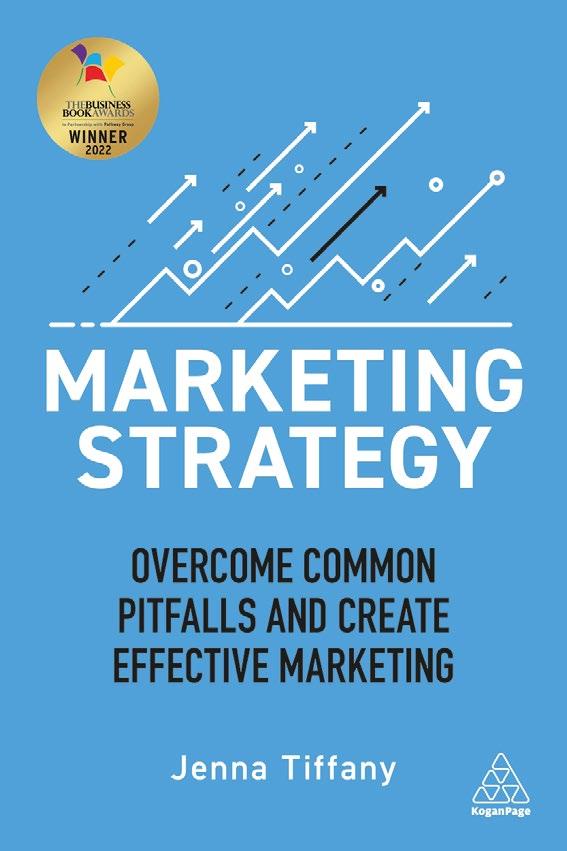
• Supports key concepts with practical tasks for the reader to complete, to cement their understanding of the tasks discussed
WINNER: The BookFest Spring Book Awards 2022 - Marketing category
WINNER: Business Book Awards 2022 - Sales & Marketing category
Tasked with creating marketing strategy? This book is for you. Learn about the most useful tools and models, dodge common mistakes, and optimize your marketing strategy success, with this practical and adaptable framework from award-winning thought-leader Jenna Tiffany.
Create an effective marketing strategy for your business with Marketing Strategy, which offers a clear, easy-to-follow overview of why strategy is important, how to create it, how to implement it, and - crucially - how to measure its success. Packed with global examples and case studies, the book opens by discussing the role strategy plays in any organization's long-term vision. It also discusses the key models and frameworks that can be used to analyze the marketing environment, and offers information on segmentation, targeting and positioning. Importantly, it will outline some of the key challenges likely to crop up, and gives pre-emptive tools for avoiding them.
Marketing Strategy is highly practical in approach. Chapters are supported by short tasks to complete throughout, to cement the reader's understanding of the concepts discussed. Put together, these tasks create an easy to follow, step-by-step framework for creating a marketing strategy. The framework is adaptable and can be applied to any industry or business. Marketing Strategy also includes input from leading marketing strategists including Mark Ritson and organizations such as Mailchimp, the CIM and DMA.
Jenna Tiffany, based in London, UK and Lisbon, Portugal is Founder and Strategy Director at marketing agency Let'sTalk Strategy and is recognized as one of the top 50 marketers to follow in the world. A Chartered Marketer and awarded fellow of the IDM, she has worked with brands such as Shell, Hilton and World Duty-Free, and is an elected member of the prestigious DMA UK Email Marketing Council. Jenna Tiffany is also an international conference speaker, qualified teacher and a thought-leader on marketing trends.
Edition: 1
Date: 05/28/2021
Price: $39.95
Paperback: 9781789667417
Ebook: 9781789667424
Pages: 320
Format (mm): 235x158
Band: Professional/ Academic
Subject: Marketing Strategy
Introduction
1 What is strategy?
2 Scenario - Establishing the current situation
3 Targets - Setting objectives
4 Reach - Researching your customers
5 Awareness - Planning your marketing campaign
6 Tactics - Selecting the right channels
7 Execution - Implementing your marketing strategy
8 Generate - Tracking the results
9 Yield - Analysing your strategy’s success
10 Common pitfalls in marketing strategy
11 Glossary
12 Further resources
• Presents fascinating original research comparing the websites and social media feeds of over 30 organizations from various sectors, proving how consumers are dealing with a 'sea of sameness' with many of them saying the same thing
• Offers a clear, seven-step, values-based framework that will help organizations break away and differentiate themselves from the competition
• Helps companies identify the exact capabilities, attitudes and behaviours that need to be adjusted to escape the 'herd instinct', enabling them to meet consumers' needs more effectively, and therefore stand out from the competition
• Helps organizations create differential value for their customers, by re-focusing on the consumer and the kinds of solutions they want, rather than the kinds of solutions the organization has traditionally offered
"How do we get customers to choose us over our competitors?"In a crowded market it's imperative to demonstrate that you understand what your customers value and can communicate how you can solve their problem better than the competition.
Stand-out Marketing presents original research which compares the content produced by organizations in a range of sectors which demonstrates that customers are left swimming in a "sea of sameness" by copycat marketing that makes choice difficult.

On the back of this unique and fascinating research, Stand-out Marketing sets out a framework of five competencies for business leaders, marketing and sales professionals to successfully differentiate themselves from competitors. These include seeing the next competitive move, staying in tune with your customers and becoming indispensable to them, activating and evaluating initiatives, as well as building an organizational culture which enables these competencies. Featuring interviews with industry experts, tools and exercises throughout, Stand-out Marketing is an essential resource to help companies stand out, deliver genuine value, and achieve competitive advantage.
Dr Simon Kelly is President of Shake Marketing, and was formerly Marketing Director (SVP) of British Telecom. He is also Senior Lecturer in Marketing at Sheffield Business School, and Lecturer in Marketing and Sales at University of York.
Dr Paul Johnston is a senior lecturer in marketing and innovation at Nottingham Trent University.
Stacey Danheiser is CEO and founder of Shake Marketing. She is also CEO and Course Creator for Customer Value Link.
Edition: 1
Date: 12/28/2020
Price: $39.95
Paperback: 9781789664829
Ebook: 9781789664836
Pages: 264
Format (mm): 235x158
Band: Professional/ Academic
Subject: Marketing Strategy
1 B2B organizations are stuck in a Sea of Sameness
2 Why does sameness happen in B2B marketing?
3 The V.A.L.U.E. competency framework –core competencies for B2B differentiation
4 The role of sales and marketing in B2B organizations – what is important?
5 The visionary – competencies for seeing the next competitive move
6 The activator – competencies for getting things done
7 The learner – competencies for staying in tune with your customers
8 Usefulness – competencies for becoming indispensable to your customers
9 The evaluator – competencies for making good decisions
10 Building a V.A.L.U.E. competency culture
11 Using V.A.L.U.E. competencies to stand out from your competitors
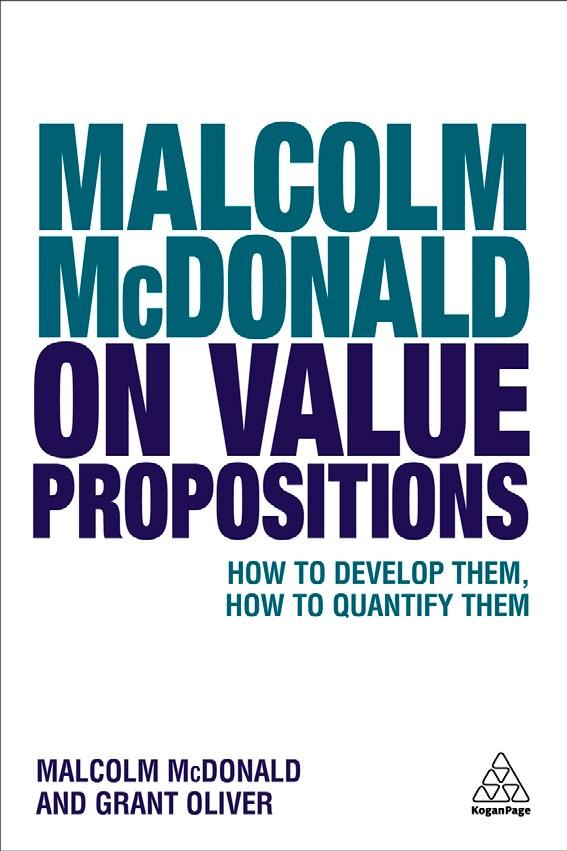
• Provides readers with a simple, direct methodology to develop and financially quantify their value propositions
• Includes research that demonstrates the impact that quantified value propositions have on a company's financial performance, and why successfully implementing them will make a company more profitable
• Features a wealth of tools, frameworks and templates for the reader to apply to their own day-to-day business practices, and additional downloadable templates and resources
While many organizations understand the importance of having a clearly defined value proposition to help them become more profitable, many businesses struggle to use them effectively. This book will show you how to develop a financially quantified value proposition that drives growth.
A value proposition is an innovation or feature that clarifies a company's core purpose and identity. In the same way profit lies at the heart of every business, so does the value proposition, communicating how its service or products fulfil the needs of their customers. Malcolm McDonald on Value Propositions is a step-by-step guide to understanding exactly why financially quantified value propositions will help readers to increase revenue and deliver tangible results.
Highly practical and filled with useful tools and checklists, this succinct guide explains the process of developing a value proposition from start to finish, how to use segmentation appeal to the relevant key accounts, and to ensure it is both financially grounded and has resonance with customers. From understanding how buying decisions are made, through to financial dashboards and value quantification tools, Malcolm McDonald on Value Propositions is perfect for anyone looking to integrate financial success into their proposition, and gain understanding of how it can be used to deliver and communicate value.
Professor Malcolm McDonald is Emeritus Professor at Cranfield & Honorary Professor at Warwick Business School. He is Chairman of six companies, and works with the operating boards of some of the world's leading multinationals. He has written over 40 books including the best-selling Marketing Plans: How to prepare them, how to use them
Grant Oliver is MD at 90 Day Action Plan, and has over 20 years' experience in software and management consultancy. He has been interim IT director in the NHS, Finance Director of a software company, and Non-Executive Director of a Housing Association.
Edition: 1
Date: 10/28/2018
Price: $31.99
Paperback: 9780749481766
Ebook: 9780749481759
Pages: 256
Format (mm): 230x157
Band: Professional/ Academic
Subject: Marketing Strategy
Chapter - 00: An important introduction – getting the best out of your value proposition
1 How financially quantified value propositions will make you richer
2 Quantifying the emotional elements of value propositions
3 What exactly is a financially quantified value proposition?
4 An overview of the value proposition process – where to start
5 Why it is critical to understand how key buying decisions are made
6 Which key accounts should you develop value propositions for?
7 Which segments should you develop value propositions for?
8 Understanding key account and segment needs before building a value proposition
9 Understanding our own asset base and capabilities
10 Developing value propositions
11 Creating and financially quantifying value propositions
12 Developing and presenting value propositions that resonate with customers
13 Value-celling – How to maximize value creation in supply chains
14 Financial analysis, value quantification tools and financial dashboards
15 Summary of the value proposition process
• Shows how to increase response rates, engagement and sales conversions by applying behavioral science techniques to shape consumer behavior
• Covers key areas such as marketing communications, campaigns, social media marketing and customer retention strategies
• Explores how to maximize consumer involvement and engagement through storytelling and convey exclusivity and desirability
• Includes insights from organizations including AT&T, The US Navy, Merrill and The Wall Street Journal
• Online resources: downloadable checklists and interactive templates to be used in practice
WINNER: National Indie Excellence Awards 2023 - Marketing & Public Relations
SHORTLISTED: Business Book Awards 2023 - Smart Thinking
FINALIST: Next Generation Indie Book Awards 2023 - Business
Increase engagement, response rates and the ROI of marketing initiatives with this step-by-step guide to harnessing hardwired consumer behavior and instinctive responses.
Using Behavioral Science in Marketing shows how to apply behavioral science principles in key areas of marketing, including marketing communications, email, direct mail and ad campaigns, social media marketing and sales funnel conversion strategies. Highly practical and accessible, it includes case studies and examples from AT&T, Apple, Spotify and The Wall Street Journal showing how these approaches have been used in practice.

Using Behavioral Science in Marketing also reveals how to increase consumer involvement and engagement, convey exclusivity and desirability, and prompt customer action and loyalty with scientifically proven principles such as autonomy bias, storytelling, and the Von Restorff effect.
Featuring common mistakes to avoid and key takeaways at the end of each chapter, it's also accompanied by downloadable checklists and an interactive template to use in practice. In a highly competitive space, where even an incremental advantage can result in significant uplifts, this is a crucial resource to create stand out and successful marketingespecially for marketers in highly regulated or highly competitive environments.
Nancy Harhut is Co-Founder and Chief Creative Officer at HBT Marketing, a consultancy which specializes in applying human behavior techniques in marketing and whose clients include H&R Block, AARP and Transamerica. Based in Boston, Massachusetts, she previously held senior creative management positions with agencies within the IPG and Publicis networks, where she worked with clients including Dell, Bank of America and AT&T. A regular international conference keynoter, she has been recognized as an Online Marketing Institute Top 40 Digital Strategist and Ad Club Top 100 Creative Influencer.
Edition: 1
Date: 08/28/2022
Price: $41.99
Paperback: 9781398606487
Ebook: 9781398606678
Pages: 288
Format (mm): 235x156
Band: Professional
Subject: Marketing Strategy
1 Emotional and rational elements in decision making
2 Conveying customer benefits through loss aversion and the endowment effect
3 Achieving urgency and exclusivity through the scarcity principle
4 The reciprocity principle and the marketing value of give to get
5 Social proof - Harnessing the power of people like us, and the people we like
6 Storytelling - Increasing consumer involvement and engagement
7 Autonomy bias - Harnessing the human need for control
8 Encouraging sales and loyalty through the consistency principle and the Zeigarnik effect
9 Information gap theory - Prompting consumers to take action through curiosity and the need to know
10 Tapping into the authority principle to stand out and prompt responses
11 Choice architecture and status quo biasHow to use inertia to get things moving
12 Labeling and framing - Making people see things your way
13 Increasing action through automatic compliance triggers and reasons
14 Maximizing the impact of your marketing copy and language
15 Increasing desirability though triggering availability bias
16 Creating stand out marketing communications through context, rewards and unpredictability
17 Temporal discounting and temporal landmarks - The effects of time on behavior
• Introduces the concept of sustainable marketing and tools for understanding the impact of both sustainable and unsustainable marketing
• Explains the role of marketing in the overall efforts towards a sustainable future

• Shows how to implement and measure the effectiveness of sustainable marketing practices as well as how to avoid greenwashing pitfalls
• Includes international case studies and examples throughout to show how the theory can be practically implemented at companies of all sizes
• Provides guidance on how to embed sustainability into your strategy and how to remain resilient throughout transformation.
Becoming a sustainable marketer is no longer an optional extra. Sustainability has become a necessity for the future, but do you feel confident delivering on this for your clients and customers?
Sustainable Marketing provides a practical guide for marketing professionals to transform their daily work, and the industry as a whole, into a force for good. Starting with an outline of the role of marketing in the wider world of sustainability, this book provides concrete tools, techniques and models for daily use, as well as guidance on staying resilient throughout your own personal journey with sustainability. Whether thinking about the channels you use, or the marketing activities your department does, this is the perfect guide for marketing professionals working through their company's sustainable transformation.
Written by experts who apply their unique framework to the issue, this book takes what may feel like an insurmountable challenge and breaks it down, giving in-depth advice and providing real-world success stories from companies of all sizes including Tony's Chocolonely, EcoSki and Tesla.
Paul Randle is co-founder of the Sustainable Marketing Compass and CEO of Pickle Consulting Ltd based in Berkshire, UK. He has 30+ years of global client and agency marketing experience. He sits on the advisory panel of the Sustainable Marketing, Media and Creative course offered by the Cambridge University Institute for Sustainability Leadership.
Alexis Eyre is co-founder of the Sustainable Marketing Compass, and co-founder of Sustainists. Based in Hampshire, UK, she has worked for brands including Natwest, Sunsail and EcoSki and has spoken at the Leaders Week Summit and Business Green NetZero Festival.
Edition: 1
Date: 12/28/2023
Price: $31.99
Paperback: 9781398613133
Ebook: 9781398613140
Pages: 256
Format (mm): 234x156
Band: Professional
Subject: Sustainable Marketing
Foreword
1 An Introduction to Sustainability
1 Understanding Sustainability
2 Marketing’s Silent Spring
3 Tools for Understanding Marketing’s Impacts
4 The Sustainable Impacts of Marketing
2 The Role of Marketing
5 The Role of Marketing - The ‘Engine of Growth’
6 The Mindset of Marketing - 1% is Good, Volume is Better
7 The State of Marketing - Creative Tramlines
8 The Need for a New Role for Marketing
3 The Tools for Sustainable Marketing
9 The Origins, Objectives and Introduction to the Sustainable Marketing Compass
10 UN SDG Alignment - Align your Marketing with your Company’s and the World’s Most Important Sustainability Goals
11 Strategic Foundations - Embed Core Sustainability-Based Principles at the Heart of your Marketing
12 Activation Pillars - Go to Market Sustainably and Avoid Greenwashing Pitfalls
13 Data Models & Testing
14 Sustainable Marketing Successes & Failures
4 Building Sustainable Marketing Capability
15 Capability Development and the Parallels to Digital Transformation
16 Sustainable Marketing Maturity Modelling
17 Your Personal Resilience Journey
• Written by the internationally acknowledged authority on marketing planning, Malcolm McDonald.
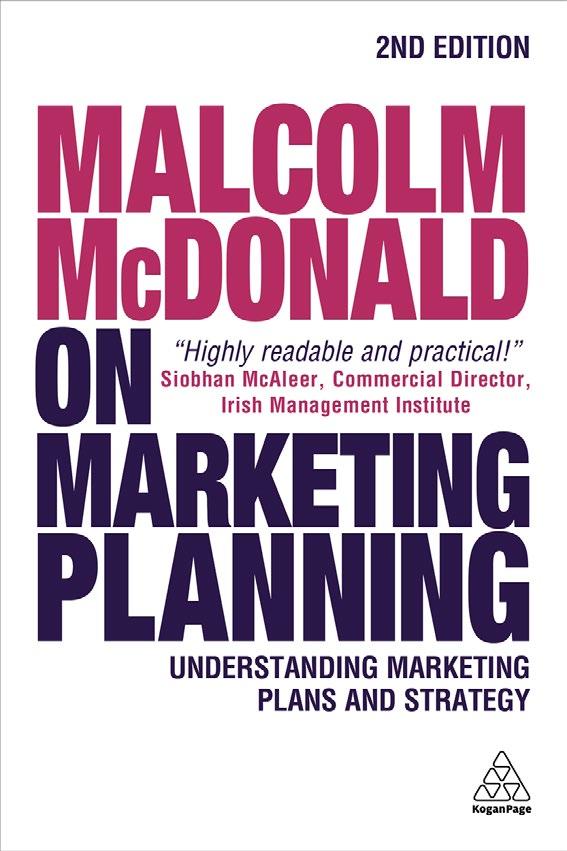
• Explains the key concepts and principles of marketing planning in an accessible, engaging fashion.
• A compact guide for busy professionals, containing all essential info in a user-friendly, pedagogically rich format featuring helpful margin notes and key points.
• Includes adaptable business templates and tools that the reader can use when establishing their own marketing plans.
• Online resources: multiple templates as a practical toolkit for marketing planning.
A primer for marketing professionals and students, the second edition of Malcolm McDonald On Marketing Planning provides a clear guide to marketing planning. Focusing on the practical application of marketing planning, this book will guide readers through the production of a marketing plan that has real world application. Key content includes defining markets and segments, setting marketing objectives and strategies, advertising and sales promotion strategies, and price and sales strategies.
With an emphasis on practicality, this fully revised second edition has been thoroughly overhauled to contain new content on the essentials of marketing planning and the strategic marketing process.
Online resources include multiple templates as a practical toolkit for marketing planning.
Professor Malcolm McDonald is a global leading authority on marketing. He was until recently Professor of Marketing and Deputy Director at Cranfield University School of Management, and is now an Emeritus Professor at the University as well as being an Honorary Professor at Warwick Business School and Academic Advisor at the Oxford College of Marketing. He has consulted many major companies in strategic marketing and is Chairman of numerous companies for some of the world's leading multinationals. He has written more than 40 books including the best-selling Marketing Plans: How to prepare them, how to use them
Edition: 2
Date: 11/28/2016
Price: $29.99
Paperback: 9780749478216
Ebook: 9780749478223
Pages: 192
Format (mm): 235x155
Band: Textbook/ Professional
Subject: Marketing Planning
1 Let’s get real
2 Getting rid of that big managerial nonsense
3 Understand the real meaning of customer value
4 A very practical way to begin planning a profitable future
5 Market segmentation
6 What do our customers want?
7 How to set marketing objectives
8 How to set marketing strategies
9 A step-by-step strategic planning system
10 How to deal with adversity

• Shows how to create an agile data-powered marketing strategy to increase engagement, enable customer personalization and build brand and product strategies
• Describes how to communicate data analysis effectively to stakeholders, and how to develop the skills needed to be a data-savvy marketer
• Explores how to use data in a non-invasive, secure and ethical way, which respects consumer privacy and new global laws
• Includes best practice case studies and examples from a range of organizations in a variety of sectors, including Coca-Cola, Sephora and The American Marketing Association
Stop feeling overwhelmed by data and start using it to its full potential, to create an agile and forward-looking strategy that enables customer-centric marketing, builds your brand and develops product strategies.
Many brands talk about creating a marketing strategy powered by data, analytics and metrics. Yet too often they're still overwhelmed by data, or unsure of how to use it to create a flexible and future-focused strategy that doesn't just validate what's happened in the past. Marketing Metrics takes readers through all the stages of implementing a data-first strategy, from early-stage adoption to more advanced customization. Featuring examples from a range of organizations including Coca-Cola and Mercedes-Benz, it shows how to create a strategy which leverages consumer data for customer-centric marketing, establishes the ROI of channels and campaigns, strengthens brands and creates datadriven product strategies.
Covering the range of new global laws that impact consumer privacy and data collection and usage, Marketing Metrics shows how to use data in a non-invasive, secure and ethical way. Also showing how to communicate critical data to the right stakeholders and the skills of the data-savvy marketer, this is a clear and jargon-free guide to creating a futurefocused and data-powered marketing strategy.
Christina Inge is the Founder and CEO of Thoughtlight, a tech consulting company which specializes in digital marketing and analytics strategies. She has worked with well-established brands such as Nissan, Smithsonian and Pega Systems, as well as a range of startups and nonprofits. Based in Boston, Massachusetts, she is a member of the Massachusetts Technology Leadership Council and has served on the board of the American Marketing Association-Boston. An instructor at Harvard University Extension School and Northeastern University College of Professional Studies, she is a frequent and sought-after speaker and has been published in numerous industry publications.
Edition: 1
Date: 09/28/2022
Price: $41.99
Paperback: 9781398606593
Ebook: 9781398606609
Pages: 336
Format (mm): 234x158
Band: Professional/ Academic
Subject: Marketing Analytics
1 Data-driven strategy
2 Customer data - The core four
3 Metrics-driven customer journeys and personas
4 Channel metrics
5 Data-driven branding
6 Content marketing metrics frameworks
7 Content marketing: the essential metrics
8 Data-driven product strategy
9 Price and place metrics
10 Marketing performance metrics
11 Data governance and the new privacy laws
12 Building dashboards and data evangelism
13 What are the skills of a metrics-driven marketer?
14 Marketing metrics resources
15 Dictionary of marketing metrics and related terms
• Provides an accessible and step-by-step guide to providing actionable marketing insights through using analytical tools and techniques
• Shows how to analyze customer demand, market segmentation, customer loyalty and campaign success to increase conversion rates and engagement
• New to this edition: material on forecasting, customer touchpoints modelling, a new focus on customer loyalty and additional analytics techniques and approaches
• Supporting resources: Datasets, presentations slides for each chapter and a test bank of self-test questions
Who is most likely to buy and what is the best way to target them? How can I use both consumer analytics and modelling to improve the impact of marketing campaigns? Marketing Analytics takes you step-by-step through these areas and more.
Marketing Analytics enables you to leverage predictive techniques to measure and improve marketing performance. By exploring real-world marketing challenges, it provides clear, jargon-free explanations on how to apply different analytical models for each purpose. From targeted list creation and data segmentation, to testing campaign effectiveness, pricing structures and forecasting demand, it offers a complete resource for how statistics, consumer analytics and modelling can be put to optimal use.
This revised and updated third edition of Marketing Analytics contains new material on forecasting, customer touchpoints modelling, and a new focus on customer loyalty. With accessible language throughout, methodologies are simplified to ensure the more complex aspects of data and analytics are fully accessible for any level of application. Supported by a glossary of key terms and supporting resources consisting of datasets, presentation slides for each chapter and a test bank of self-test question, this book supplies a concrete foundation for optimizing marketing analytics for day-to-day business advantage.

Mike Grigsby, based in Orlando, Florida, has more than 30 years' experience in the field of marketing analytics. He was formerly vice president of customer insights and advanced analytics at Brierley and Partners and of strategic business analysis and advanced analytics at Targetbase and has also held leadership positions at Hewlett-Packard and Gap. Previously an adjunct professor at the University of Texas at Dallas, he taught analytics at both graduate and undergraduate levels. He is the author of Advanced Customer Analytics, also published by Kogan Page.
Edition: 3
Date: 12/28/2022
Price: $45.99
Paperback: 9781398608191
Ebook: 9781398608207
Pages: 336
Format (mm): 217x136
Band: Professional/ Academic
Subject: Marketing Analytics
Introduction
1 How can marketing analytics help you?
1 Overview of statistics
2 Consumer behaviour and marketing strategy
3 What is an insight?
2 Dependent variable techniques
4 Modelling demand and elasticity
5 Polynomial distributed lags
6 Using Poisson regression
7 Logistic regression and market basket analysis
8 Survival modelling and lifetime value
9 Panel regression and same store sales
10 Introduction to forecasting
3 Interrelationship techniques
11 Simultaneous equations
12 Principal components and factor analysis
13 Segmentation overview
14 Tools of segmentation
4 Focus on media and loyalty
15 Modelling marcom value
16 Media mix modelling
17 Overview of loyalty
18 Loyalty with SEM
19 The customer loyalty journey
5 More important topics for everyday marketing
20 Statistical testing
21 Introduction to Big Data
22 Conclusion - The finale
23 References
24 Further reading
• Provides an impartial overview of the various solution vendors and software providers available, enabling readers to select the most appropriate predictive analytic tools for their needs
• Features international case studies gleaned from the author's more than 25 years of industry experience, and contains supplementary articles from recognised thought-leaders in the field
• Gives a holistic, balanced overview of predictive analytics, the universal branch of advanced analytics used to make predictions about unknown future events
Predictive analytics has revolutionized marketing practice. It involves using many techniques from data mining, statistics, modelling, machine learning and artificial intelligence, to analyse current data and make predictions about unknown future events. In business terms, this enables companies to forecast consumer behaviour and much more. Predictive Analytics for Marketers will guide marketing professionals on how to apply predictive analytical tools to streamline business practices. Including comprehensive coverage of an array of predictive analytic tools and techniques, this book enables readers to harness patterns from past data, to make accurate and useful predictions that can be converted to business success. Truly global in its approach, the insights these techniques offer can be used to manage resources more effectively across all industries and sectors.
Written in clear, non-technical language, Predictive Analytics for Marketers contains case studies from the author's more than 25 years of experience and articles from guest contributors, demonstrating how predictive analytics can be used to successfully achieve a range of business purposes.

Dr Barry Leventhal is a leading UK authority on geodemographics and a marketing analytics expert. He is Emeritus Chair of the Census and Geodemographics Group (CGG), which is an advisory board of The Market Research Society (MRS) and a leading voice in the UK information industry. He was recently awarded the MRS Gold Medal Award - the association's rarest accolade, presented for the first time since 2008 - in recognition of his lifetime of exceptional achievement and contribution to the research profession.
Edition: 1
Date: 02/28/2018
Price: $31.99
Paperback: 9780749479930
Ebook: 9780749479947
Pages: 272
Format (mm): 234x154
Band: Professional/ Academic
Subject: Marketing Analytics
Introduction to predictive analytics
1 How can predictive analytics help your business?
2 Using data mining to build predictive models
3 Managing the data for predictive analytics
4 The analytical modelling toolkit
5 Software solutions for predictive analytics
6 Predicting customer behaviour using analytical models
7 Predicting lifetimes – from customers to machines
8 How to build a customer segmentation
9 Accounts, baskets, citizens or businesses – applying predictive analytics in various sectors
10 From people to products – using predictive analytics in retail
11 How to benefit from social network analysis
12 Testing the benefits of predictive models and other marketing effects
13 Top tips for gaining business value from predictive analytics
• Provides real-world guidance on the application of text analytics for marketing professionals

• Bridges the gap between marketers and data analysis experts by cutting through jargon
• Helps marketers to frame the right questions and apply the results successfully
• Online resources: Self-test questions, chapter review Q&A and an Instructor's Manual with text sources and instructions
In an age where customer opinion and feedback can have an immediate, major effect upon the success of a business or organization, marketers must have the ability to analyze unstructured data in everything from social media and internet reviews to customer surveys and phone logs. Practical Text Analytics is an essential daily reference resource, providing real-world guidance on the effective application of text analytics. The book presents the analysis process so that it is immediately understood by the marketing professionals who must use it, so they can apply proven concepts and methods correctly and with confidence.
By decoding industry terminology and demonstrating practical application of data models once reserved for experts, Practical Text Analytics shows marketers how to frame the right questions, identify key themes and find hidden meaning from unstructured data. Readers will learn to develop powerful new marketing strategies to elevate customer experience, solidify brand value and elevate reputation. Online resources include selftest questions, chapter review Q&A and an Instructor's Manual with text sources and instructions.
Steven Struhl PhD, MBA, MA has more than 25 years' experience in consulting and research, specializing in practical solutions based on statistical models of decision-making and behaviour. In addition to text analytics and data mining, his work addresses how buying decisions are made, optimizing service delivery and product configurations and finding the meaningful differences among products and services. Steven also has taught graduate courses on statistical methods and data analysis. He speaks at conferences and has given numerous seminars on pricing, choice modelling, market segmentation and presenting data.
Edition: 1
Date: 07/28/2015
Price: $45.99
Paperback: 9780749474010
Ebook: 9780749474027
Pages: 272
Format (mm): 233x156
Band: Professional/ Academic
Subject: Marketing Analytics
1 Who should read this book? And what do you want to do today?
2 Getting ready: capturing, sorting, sifting, stemming and matching
3 In pictures: word clouds, wordles and beyond
4 Putting text together: clustering documents using words
5 In the mood for sentiment (and counting)
6 Predictive models 1: having words with regressions
7 Predictive models 2: classifications that grow on trees
8 Predictive models 3: all in the family with Bayes Nets
9 Looking forward and back
• Serves to integrate widely disparate approaches to predicting consumer choice via artificial intelligence marketing, showing the strengths, weaknesses and best applications of each method and point of view.
• Covers methods and techniques including Discrete Choice Modelling, Conjoint Analysis and Machine Learning Models, placing all of these in the wider context of predictive analytics and artificial intelligence marketing.
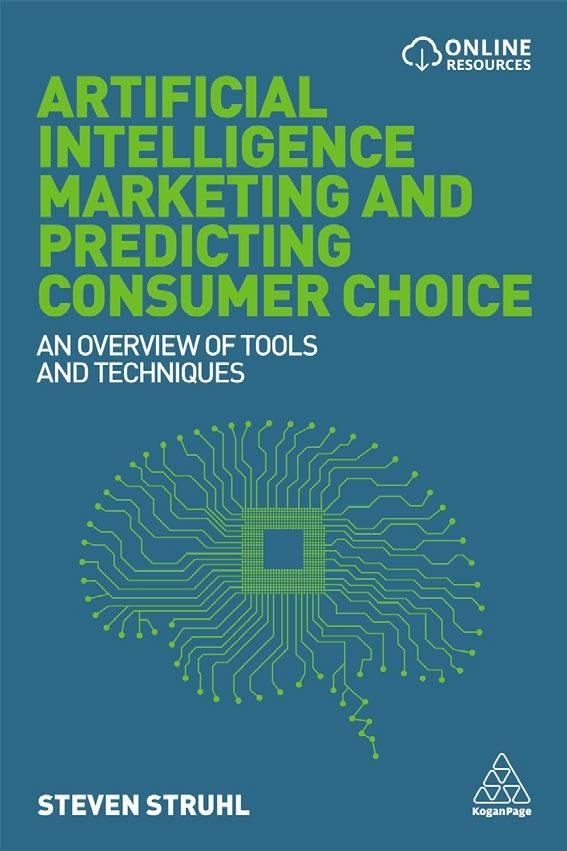
• Explores the human side of advanced analytics - using data to predict what people will choose.
• Includes extensive diagrams and charts, pointers on tools and techniques, definition boxes and practical hints and tips.
• Online resources: bonus chapters on AI, ensembles and neural nets, and finishing experiments, and a range of multiple or single product simulators
The ability to predict consumer choice is a fundamental aspect to success for any business. In the context of artificial intelligence marketing, there are a wide array of predictive analytic techniques available to achieve this purpose, each with its own unique advantages and disadvantages. Artificial Intelligence Marketing and Predicting Consumer Choice serves to integrate these widely disparate approaches, and show the strengths, weaknesses, and best applications of each. It provides a bridge between the person who must apply or learn these problem-solving methods and the community of experts who do the actual analysis. It is also a practical and accessible guide to the many remarkable advances that have been recently made in this fascinating field.
Online resources: bonus chapters on AI, ensembles and neural nets, and finishing experiments, plus single and multiple product simulators.
Dr. Steven Struhl PhD, MBA, MA has more than 25 years' experience in consulting and research, specializing in practical solutions based on statistical models of decision-making and behavior. In addition to text analytics and data mining, his work addresses how buying decisions are made, optimizing service delivery and product configurations and finding the meaningful differences among products and services. Steven also has taught graduate courses on statistical methods and data analysis. He speaks at conferences and has given numerous seminars on pricing, choice modelling, market segmentation and presenting data.
Edition: 1
Date: 04/28/2017
Price: $34.99
Paperback: 9780749479558
Ebook: 9780749479565
Pages: 272
Format (mm): 234x154
Band: Professional/ Academic
Subject: Marketing Analytics
1 Who Should Read this Book and Why?
2 Getting the Project Going
3 Conjoint, Discrete Choice and Other Trade-offs: Let’s Do an Experiment
4 Creating the Best, Newest Thing: Discrete Choice Modelling
5 Conjoint Analysis and its Uses
6 Predictive Models: Via Classifications that Grow on Trees
7 Remarkable Predictive Models with Bayes Nets
8 Putting it Together: What to Use When
• Illustrates new approaches, models and solutions to help deal with any B2B marketing challenge
• Written by one of the leading voices in the B2B marketing sphere who brings a wealth of insight and information sourced from firsthand experience
• Online resources: case studies, web links to insightful videos and articles, and presentation slides with helpful templates
• New to this edition: new chapters on customer attrition, B2B partnership marketing and lead nurturing, new research on influencer marketing and the behaviours of millennial customers
Navigate the B2B marketing sphere with this fully updated guide on how to better understand new customer habits, the digital era and how to shift away from outdated traditional practices.
Innovative B2B Marketing is an essential guide for marketers looking for the latest approaches, models and solutions for B2B marketing. Written by one of the leading voices in the B2B marketing sphere who works with the Chartered Institute of Marketing (CIM) and other major associations, this book features real-life examples from a diverse range of sectors including marine, information technology and pharmaceutical, plus topical discussion points and challenges from key B2B marketing forums and associations.

Now fully updated, the second edition of Innovative B2B Marketing features new chapters on customer attrition, B2B partnership marketing and lead nurturing, as well as further content on influencer marketing and the behaviours of millennial customers. It is accompanied by online resources which consist of case studies, web links to insightful videos and articles, and presentation slides with practical models and templates.
Simon Hall, based in Berkshire, UK, is a marketing innovator with 25 years' experience in Technology and Services Marketing. He is the Managing Director and Founder of NextGen Marketing Solutions, a B2B marketing and business consultancy. Previously UK Chief Marketing Officer for Dell, he has also held senior roles at Acer, Microsoft and Toshiba. He is a Course Director with the Chartered Institute of Marketing (CIM), and lectures at Pearson Business School (University of Kent). He is a B2B council member with the Data and Marketing Association (DMA) and the author of B2B Digital Marketing Strategy, also published by Kogan Page.
Edition: 2
Date: 08/28/2022
Price: $34.99
Paperback: 9781398604766
Ebook: 9781398604773
Pages: 376
Format (mm): 235x156
Band: Professional/ Academic
Subject: B2B Marketing
1 Introduction to business marketing
1 Developing your marketing strategy
2 The new marketing mix
3 B2B marketing strategy and planning
2 Improve B2B customer-centric marketing
4 Business customers and buying behaviours
5 Acquisition marketing
6 Retention and loyalty marketing
7 Marketing for preventing customer attrition
8 C-suite marketing
9 B2B product and solutions marketing
3 ‘Transform’ through content and digital marketing
10 Digital and content marketing
11 Digital marketing strategy and planning
12 B2B digital marketing channels
13 Content marketing
14 B2B social media marketing
15 B2B brand building
4 ‘Collaborate’ with partners
16 Partnership marketing
17 B2B influencer marketing
18 The modern B2B channel landscape
19 Marketing to and through channel partners
5 Optimizing marketing execution
20 Sales and marketing alignment
21 Account-based marketing
22 Lead generation
23 Lead nurturing
24 Modern B2B events marketing
25 Measuring and evaluating B2B marketing
• Gives clear, direct explanations of the more advanced aspects of digital B2B marketing, and makes these accessible and user-friendly
• Expertly explains the most up-to-date digital frameworks relevant to the B2B marketing sphere, and shows how to implement these to achieve lead generation, customer retention and data management
• Is due to be the set text for the Chartered Institute of Marketing (CIM)'s course Advanced B2B Digital Marketing, and recommended reading for the courses B2B Acquisition and Retention Marketing, and Introduction to B2B Digital Marketing
• Includes a wealth of global case studies, featuring companies such as Danfoss, American Express, IBM, Schneider Electric and more
Harness the most up-to-date techniques, frameworks and skills for effective B2B digital marketing, with this essential handbook as recommended by the Chartered Institute of Marketing (CIM).
B2B Digital Marketing Strategy is a decisive guide to the most recent developments in the field. It gives readers an overview of the latest frameworks and models, and shows how these can be used to overcome the everyday challenges associated with account targeting, data utilization, and digital campaign management.

Intensely practical, B2B Digital Marketing Strategy helps readers get to grips with some of the more advanced and complex elements of B2B marketing. It expertly explains how to incorporate the latest digital methodologies into critical processes such as lead generation, customer retention and customer experience personalization. Packed with global case studies and examples, this book is an invaluable resource for any professional operating in the B2B space.
Simon Hall, Berkshire, UK is a marketing innovator with around 25 years' experience in Technology and Services Marketing. In his former career, he served as UK Chief Marketing Officer for Dell as well as many senior European roles at Acer, Microsoft and Toshiba. In addition to running courses and workshops with companies on various B2B marketing and digital marketing areas, Simon Hall also lectures final year university students and degree apprentices in strategy, and marketing at Pearson Business School (University of Kent). He is a member of the Chartered Institute of Marketing, of the DMA B2B Council, and a Global Thought Leader in B2B Marketing for the ICG Group (a global consulting company). He is the founder of NextGen Marketing Solutions and author of Innovative B2B Marketing, also published by Kogan Page.
Edition: 1
Date: 08/28/2020
Price: $41.99
Paperback: 9781789662542
Ebook: 9781789662559
Pages: 352
Format (mm): 235x155
Band: Professional/ Academic
Subject: B2B Marketing
1 The new evolving business landscape
1 DEVELOPING THE B2B DIGITAL STRATEGY
2 B2B digital marketing strategy
3 B2B customer journeys and the customer experience
4 B2B personalization marketing and buyer personas
5 B2B customer insights and data management
2 THE EARLY BUYER JOURNEY STAGE
6 Generating awareness
7 B2B SEO and search strategies
8 B2B websites and website strategies
3 Digital for lead generation and lead nurturing
9 B2B digital marketing for lead generation
10 B2B digital and lead nurturing
4 Digital campaign management and integration
11 B2B content marketing
12 B2B digital marketing campaign planning
13 Digital integration marketing in B2B
14 Digital marketing and sales
15 Measuring digital marketing
5 Digital for retaining customers
16 Types of digital retention marketing
17 Digital retention marketing channels
6 B2B social media and digital marketing platforms
18 B2B social media marketing strategy
19 B2B digital marketing technologies and platforms
20 Index
• Explores key concepts of digital marketing and best-practice for tools, channels and platforms including SEO, social media marketing, email marketing and online advertising
• Combines practical and implementable stepby-step guidance for creating and evaluating digital marketing campaigns with a robust theoretical and academic underpinning
• Describes how to incorporate accountability, inclusivity and meaningful sustainability messaging, as well as respect legal considerations such as the GDPR
• Features interviews with industry professionals, case studies from the likes of Adidas, Nielsen and The Eden Project as well as how-to guides, checklists and critical thought pieces
• Online resources: lecture slides, group activities, worksheets and further resource links
Learn how to create effective digital marketing campaigns, analyze competitor behaviour and conduct digital marketing in a responsible and accountable way with this real-life focussed and streamlined textbook.
Digital Marketing in Practice balances step-by-step practical coverage with academic theoretical context throughout to offer a definitive and easy-to-understand resource. Exploring key definitions and best-practice for tools, channels and platforms including SEO, social media marketing, email marketing and online advertising, it shows how to create plans and set objectives, design digital marketing campaigns and evaluate their success for improvement.
Digital Marketing in Practice also describes how to incorporate accountability, inclusivity and meaningful sustainability messaging. Featuring interviews with industry professionals and case study examples from a range of brands including Nielsen and the Met Office, it also contains how-to guides, check lists and critical thought pieces.
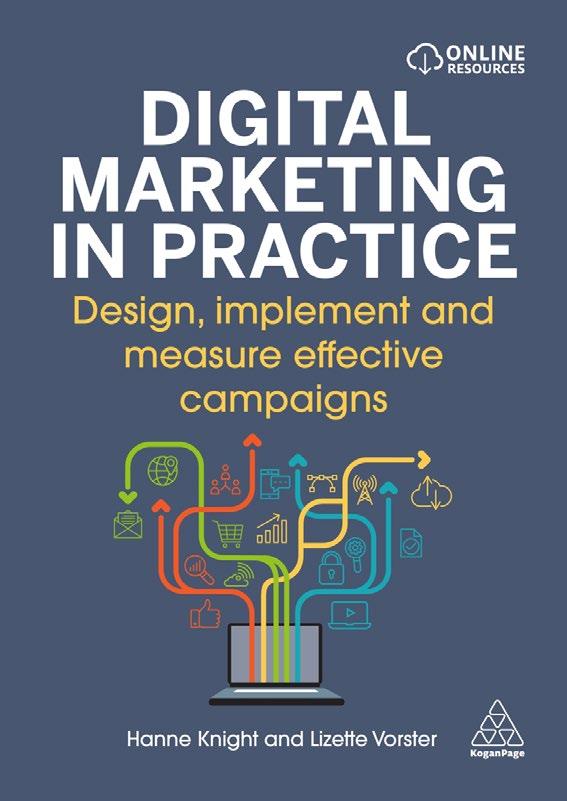
Supported by online resources consisting of lecture slides, self-test questions, group activities, worksheets, additional interactive case studies and further resource links, it is an indispensable text to equip students with the tools to develop and implement successful digital marketing.
Hanne Knight is Lecturer in Marketing at the University of Plymouth, UK, where she also leads its Digital and Social Media Marketing MSc. She consults practitioners on sustainability communication and is senior examiner at the Chartered Institute of Marketing.
Lizette Vorster is Assistant Professor in Strategic Business Communications at Aarhus University, Denmark. Prior to this, she was Lecturer in Digital Marketing at Northumbria University, UK. She has held a number of senior positions in professional practice, including Head of Marketing and Creative Director.
Edition: 1
Date: 03/28/2023
Price: $49.99
Paperback: 9781398608870
Ebook: 9781398608887
Pages: 496
Format (mm): 240x173
Band: Textbook
Subject: Digital Marketing
1 Basic concepts and elements of digital marketing
1 Introduction to digital marketing
2 Planning a digital marketing strategy
3 Digital marketing campaigns
4 Accountability in the digital age
2 Researching the digital environment
5 The macro environment
6 The micro environment
7 Market segmentation, targeting and positioning
8 Big Data
3 Online customer behaviour
9 Primary and secondary data sources
10 The digital consumer
11 Customer journey and experiences
12 Socially responsible consumer behaviour
13 Global Consumer Behaviour
4 Implementing digital marketing
14 Objective setting
15 Marketing mix for the digital world
16 Digital tools, techniques and technology
17 Social media marketing channels and concepts
18 Digital marketing channels and platforms
5 Measurement and evaluation
19 Evaluation of digital marketing success –Dashboards and challenges of data-driven marketing
20 Data analytics and metrics
21 Digital marketing audit
22 Managing, testing and improving campaigns
6 Legal and ethical considerations
23 Ethical considerations
24 Sustainability in the digital world
25 Legal considerations
• Provides a one-stop guide to creating a digital marketing strategy and understanding how to structure and build a more strategic approach
• Includes real-world case studies including Coca-Cola, MoneySupermarket.com, Bloom & Wild, Airbnb, Adidas and Uber
• New to this edition: material on AI in marketing, e-commerce, marketing automation, affiliate marketing and how to use digital analytical tools, plus new strategies for the latest cookie changes and privacy protection
• Online resources: Lecture slides, activity sheets, test banks, practical implementation guides and templates
Build an effective and practical digital marketing strategy with this bestselling guide, covering everything from automation and analytics to integrating AI.
Digital Marketing Strategy is a global bestseller, and a one-stop guide to structuring and building a more strategic approach to digital marketing. Now fully updated, this third edition covers the integration of AI in marketing, e-commerce, marketing automation, affiliate marketing and how to use digital analytical tools, plus new strategies for the latest cookie changes and privacy protection.
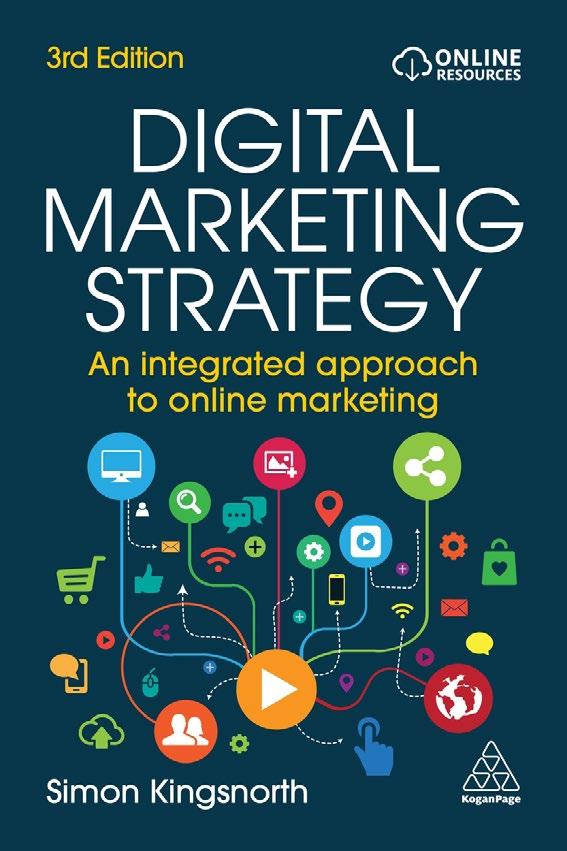
Digital Marketing Strategy will show you how to effectively select, align and manage digital channels and operations, to streamline a successful digital marketing strategy for measurable, optimized results. Recommended by the Chartered Institute of Marketing (CIM), it is supported by real-world case studies from the likes of Coca-Cola, Spotify, Airbnb, Adidas and Hostelworld as well as checklists, key terms and insights from leading industry practitioners to help you develop your own digital marketing strategy. This book is an invaluable guide for both digital marketing students and entry-level to mid-management marketing professionals.
Accompanying online resources consist of practical implementation guides spanning SEO, paid-search, email, lead-generation, as well as presentation slides and activity sheets.
Simon Kingsnorth is a digital marketing expert with over 20 years' industry experience. Based in Reading, UK, he was formerly the Global Head of Digital Marketing at Citi Bank and has provided consultancy services to leading brands such as Vodafone, Asda and Lloyds TSB. A regular conference keynote speaker and contributor to industry publications, he is the author of The Digital Marketing Handbook, also published by Kogan Page.
Edition: 3
Date: 05/28/2022
Price: $41.99
Paperback: 9781398605978
Ebook: 9781398605985
Pages: 416
Format (mm): 234x157
Band: Textbook/ Professional
Subject: Digital Marketing
Introduction - How will this book transform your digital marketing strategy?
1 The foundations of digital marketing
1 Knowing your business objectives and your customer
2 Understanding the digital ecosystem
3 Integrating digital into wider organization strategy
4 Understanding the evolving digital consumer
5 Barriers, considerations and data protection in digital marketing strategy
2 Integrating digital change into your wider organization
6 Enabling technologies for online marketing and digital transformation
7 Planning your digital marketing strategy –Objectives, teams and budgeting
3 Using channel strategy to reach your customers
8 SEO strategy and organic techniques
9 Building and optimizing a winning paid search strategy
10 Display advertising and programmatic targeting
11 Tailoring your social media strategy
12 Marketing automation, messaging and email marketing – the unsung heroes
13 Affiliate schemes and partnerships to deliver highly targeted leads
14 Lead generation that delivers results
15 Content strategy – a key pillar of success
16 Personalizing the customer journey and digital experience
4 Conversion, retention and measurement
17 Effective Experience Design (XD)
18 Optimizing your e-commerce platform
19 Managing loyalty, CRM and data
20 Measuring success through data analytics and reporting
5 Tailoring your final digital marketing strategy
21 Providing a smooth online service and customer experience
22 Putting together your digital marketing strategy
• Guides the reader step by step through building, implementing and optimizing the components of digital marketing such as SEO, social media content, paid search and display advertising
• Features practical tips, examples from brands including Google and Amazon, platform recommendations and common pitfalls to watch out for
• Written by a recognized industry expert and bestselling author who has more than 20 years' digital marketing experience
• Online resources: interactive tools and templates to be used in practice
Build, implement and optimize your digital marketing campaigns, with this indispensable guide which covers everything from SEO, social media, paid search and display advertising.
The Digital Marketing Handbook takes the reader step by step through the various components of B2B and B2C online marketing, making it an essential companion to every marketer's desk. Highly practical in approach, it features tips, platform recommendations and common pitfalls to watch out for, as well as examples from global brands including Google, Amazon and Nissan. Detailed guidance is provided for key areas such as creating content that excites, informs and converts, using marketing automation and analyzing your results to maximize performance.

Written by recognized industry expert and bestselling author, Simon Kingsnorth, The Digital Marketing Handbook brings together reliable and actionable insights into one complete resource. Also covering how to manage affiliates and partnerships to deliver highly targeted leads and provide customer service that achieves high review scores and builds loyalty, it is accompanied by online templates and interactive tools to use in practice. This book is an essential blueprint for marketing professionals to deliver the best results from their digital marketing campaigns.
Simon Kingsnorth is a recognized digital marketing expert with over 20 years' industry experience. Based in Reading, UK, he was previously the Global Head of Digital Marketing at Citi Bank and has worked with leading brands including Vodafone, Direct Line Group and Google as well as on many successful start-up launches. A regular conference keynote speaker and contributor to industry publications, he is also the author of Digital Marketing Strategy, also published by Kogan Page.
Edition: 1
Date: 01/28/2022
Price: $31.99
Paperback: 9781398603394
Ebook: 9781398603400
Pages: 288
Format (mm): 233x155
Band: Professional
Subject: Digital Marketing
1 How this book works
2 Building a high-converting, beautiful website
3 Optimizing your website to deliver top SEO results
4 Managing paid search for cost-effective results
5 Running display advertising that delivers brand value
6 Managing affiliates and partnerships to deliver highly targeted leads
7 Creating content that excites, informs and converts
8 Delivering organic and paid social media that grows your brand
9 Using analytics to interpret and optimize your results to maximize performance
10 Automating your email and CRM plans to deliver compelling digital communications
11 Using e-commerce and retail partners to scale your merchandizing
12 Providing customer service that delivers high review scores and builds loyalty
• Provides tips on how to best connect with customers in a rapidly changing climate of engagement and interaction
• Explores current and emerging trends which are shaping the industry, including voicebased marketing, influencer marketing and data insights
• New to this edition: updated content on martech, consumer data and privacy considerations, programmatic and content marketing, SEO & paid search and new global case studies and expert views
• Online resources: bonus contributor views and additional case studies on Kwik Fit, Battersea Dogs Home and Yves Saint Laurent
Gain essential grounding in SEO, email marketing, social media, content marketing, performance marketing and much more, with this practical and essential guide to digital marketing.
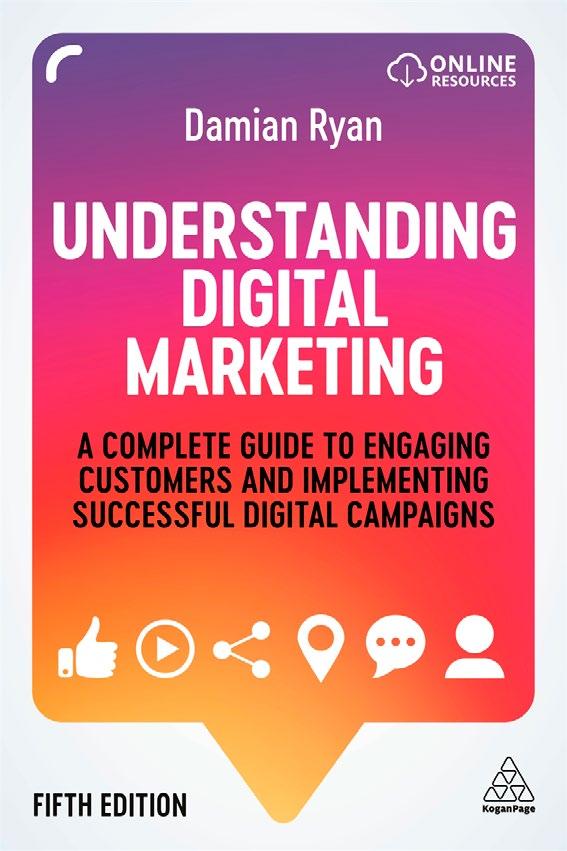
The world of digital media is constantly changing, as technologies continue to transform the way we interact and communicate on a global scale. In this climate, Understanding Digital Marketing provides a practical, no-nonsense guide to digital marketing, from strategy and digital transformation to best-practice basics and trends, packed with clear and informative case studies and examples.
This fifth edition of the bestselling Understanding Digital Marketing is fully updated to reflect the latest global developments in the industry including martech, consumer data and privacy considerations, influencer marketing and voice marketing. Complete with first-hand accounts of what success in digital marketing looks like, this book is an essential resource for practitioners and students alike. It is now required reading for more than 100 universities and colleges, and has received endorsements from Harvard University, Hult Business School and the Chartered Institute of Marketing.
Damian Ryan is a media and marketing expert with over 30 years' experience. He created the Golden Spider Awards for internet excellence, before establishing the first digital agency in the UK and Ireland in 1997. He went on to successfully build and sell three digital marketing businesses and is now a specialist adviser in mergers and acquisitions in corporate finance. Ryan is now a partner with BDO where he covers deals in media marketing communications and marketing technologies.
He is also author of Understanding Social Media and The Best Digital Marketing Campaigns in the World, both published by Kogan Page.
Edition: 5
Date: 11/28/2020
Price: $29.95
Paperback: 9781789666014
Ebook: 9781789666021
Pages: 448
Format (mm): 235x158
Band: Textbook/ Professional
Subject: Digital Marketing
1 Introduction - Digital transformation
2 Digital marketing strategy setting
3 Being online: Welcoming the world
4 Search - Being found online
5 Email marketing
6 Mobile marketing
7 Social media
8 Content marketing and native content
9 Programmatic marketing
10 Performance marketing
11 How to form meaningful insights from data
• Shows how to create a powerful social media marketing strategy which is embedded within your wider organization through effective workflows, team configurations and a supportive culture
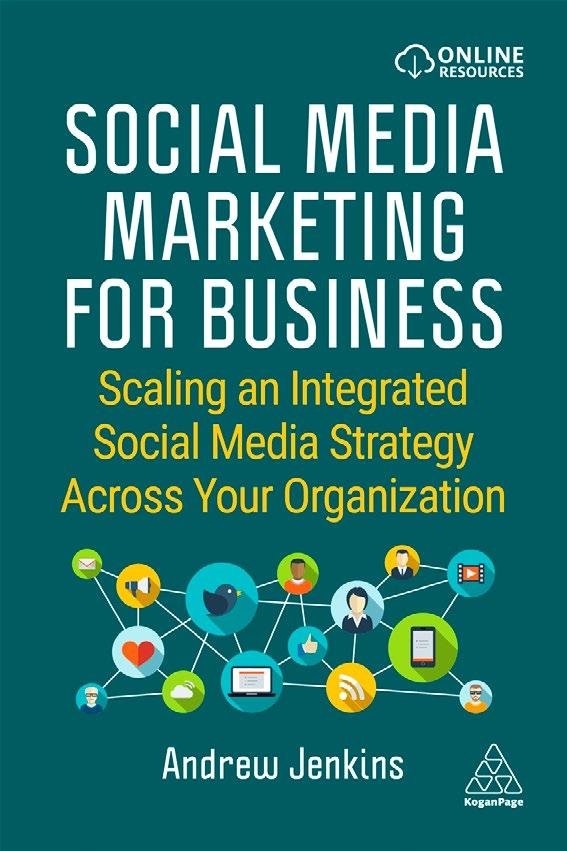
• Covers key areas such as balancing social media ownership and developing and measuring engaging social media content to increase reach and better reflect the personality of the brand
• Contains a range of international case studies from a variety of sectors, including Airbnb, Hyundai, Deloitte Digital and LVMH
• Online resources: presentation slides, content calendars, a content marketing framework and interactive tools for effective social media management
Social media has become an imperative for almost every business. Discover how to successfully implement an effective social media strategy that is supported and integrated throughout every part of your organization, with this essential handbook to enhancing your online presence.
Social Media Marketing for Business provides a step-by-step roadmap to setting up effective workflows, team configurations, governance models and social media policies, alongside creating and measuring content and social media campaigns that have the competitive edge. Featuring insights from leading industry experts, it covers areas such as balancing social media ownership, measuring success using analytics and conducting a social media audit.
Containing an array of international case study examples from organizations such as The World Wildlife Fund (WWF), Deloitte Digital, Dell, Burger King and LVMH, Social Media Marketing for Business explores how to build a supportive culture, get buy-in and the common pitfalls to avoid. Supported by a content calendar templates, content marketing framework and online presentation slides, this book is a one-stop-shop for developing effective social media marketing strategies and integrating them within your business.
Andrew Jenkins is Principal of Volterra, a professional services firm specializing in social media and social selling strategies. Based in Toronto, Canada, he was formerly the Head of Social Media Strategy for Royal Bank of Canada (RBC) and has worked with a diverse list of companies in North America and Europe, including CIBC, Rogers, Bell Canada, InfoSpace and The Aga Khan Foundation. A regular international speaker and panellist at numerous industry conferences and events, he also teaches a course on Social Media Strategies for the Enterprise at the University of Toronto's School of Continuing Studies.
Edition: 1
Date: 03/28/2022
Price: $39.95
Paperback: 9781398603691
Ebook: 9781398603707
Pages: 248
Format (mm): 234x158
Band: Professional/ Academic
Subject: Digital Marketing
Introduction
1 You’re in charge of social media, now what?
2 The who/what/where of your social media and content audit
3 Social media governance and policy development
4 Content! Content! Content!
5 Training
6 Analytics and ROI
7 Employee advocacy and personal branding
8 In-house or outsource
9 Beware bright shiny syndrome
10 Your social media operating model
11 Giving up control
12 Paid social media
13 Hashtags
14 Humanity
15 Bringing it all together
• Highlights the most effective changes to undertake on your e-commerce site, demonstrating how to focus valuable time on tangible efficiencies and revenue gains
• Shows how to gain insights into online customers' behaviour and identifies free or inexpensive tools to help access them
• Supports the transition to becoming a data-driven organization, helping to adopt a scientific approach to implementing an optimized e-commerce website
• New to this edition: new content on test metrics, prioritization and personalization, plus updated case studies and recommended tools
Conversion rate optimization (CRO) is about understanding people and behaviour, not simply website visits. This book is an all-encompassing guide to the how, the why and the tools and techniques.

Grounded in best-practice theory and research, E-commerce Website Optimization brings together usability, analytics and persuasion to offer a detailed, step-by-step guide to increasing the percentage of visitors who buy from your site and subsequently the amount that these visitors spend when they do. In a complex and evolving field, it will help you improve conversion rates, increase ROI from online marketing campaigns, generate higher levels of repeat business and increase the e-commerce value of websites.
In the fast-moving world of e-commerce, this fully revised second edition includes updates on test metrics, prioritization and personalization, alongside updated case studies and newly recommended tools. E-commerce Website Optimization is an invaluable book for those seeking to implement a data-driven ethos for their organization's e-commerce programme, for everyone from chief digital officers and heads of online sales, to entrepreneurs and small business owners.
Dan Croxen-John is CEO of AWA Digital, a global e-commerce conversion optimization agency. He is a certified Web Analyst, a Fellow of the Institute of Direct Marketing, and has served on advisory boards for numerous associations.
Johann van Tonder is COO at AWA Digital, working with brands such as Canon, Avis and Interflora. He has trained and coached big and small e-commerce businesses around the world, and is a regular speaker at international conferences.
Edition: 2
Date: 12/28/2020
Price: $25.99
Paperback: 9781789664423
Ebook: 9781789664430
Pages: 272
Format (mm): 235x158
Band: Professional/ Academic
Subject: Digital Marketing
1 Introduction to e-commerce website optimization
2 The kick-off
3 How people buy
4 Essential research
5 Add depth with further research
6 Merchandizing analytics
7 Creating the optimization plan
8 Hypotheses and creative work
9 Testing your hypothesis
10 Personalization
11 Optimizing the optimization
12 People and culture
13 Persuasive website copywriting
14 Launching a new website
• Is a clear-cut guide on how to structure mobile marketing in a planned and coordinated way
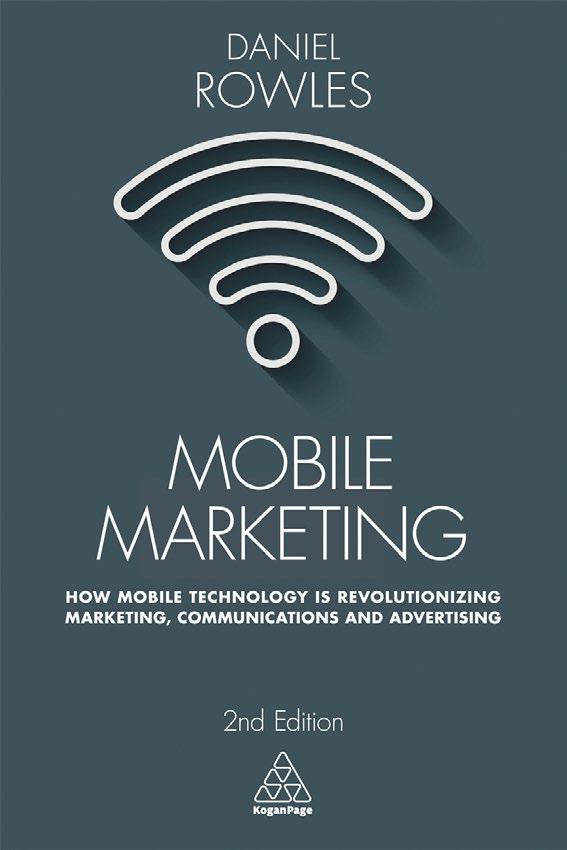
• Demystifies terms, tools and techniques, helping readers connect and coordinate the different dynamics across their business
• Includes high-profile case studies including Heineken, Nike Training Club, Google Play and MailChimp
• Changes since the last edition include two new chapters (Mobile & Email, LocationBased Devices and Beacons), plus cutting edge updates on wearable technology, mobile payments, virtual reality and understanding the multi-screen journey
• Checklists chapter and practical frameworks such as how to create a mobile marketing strategy and how to develop an app
• Online resources: digital marketing instructors manual, lecture slides, example exam and self-test questions, and a content calendar template
Mobile Marketing is a clear, practical guide to harnessing the mobile consumer and tackling the rising challenges of divided user attention across multiple screens at the same time. It demystifies the vast spectrum of tools and techniques now available and explains how to optimize these dynamics into an innovative and effective mobile marketing strategy. Now that website search rankings take into account mobile optimization, no serious marketer can do without a thorough understanding of mobile.
The first edition of Mobile Marketing won the Judge's Choice Award in Social Media at the Small Business Trend's 2014 Book Awards. This fully revised 2nd edition includes straightforward explanations on mobile optimized content, app development, social media and proximity based marketing. It has also expanded to include two brand new chapters on mobile and email and on location-based devices, plus cutting-edge updates on advances in wearable technology, mobile payments, virtual reality and strategies for the changing user journey. Integrated with tactical checklists, easy application frameworks and powerful case study insights such as Heineken, WordPress, MailChimp, Nike Training Club (NTC), Google Play and Moz, it provides a full overview from service provision and technology integration to content strategy, ready to capture fast-moving consumers on the go. Online resources include a digital marketing instructors manual, supporting lecture slides, example exam and self-test questions, and a content calendar template.
Daniel Rowles has worked in digital marketing for almost 20 years on both the client and agency sides. He is a Course Director for the CIM, lecturer at Imperial College London and Cranfield School of Management and lead judge of the CIM Marketing Excellence awards. He is also the host of the Digital Marketing Podcast, a global top-ten business podcast on iTunes. His company TargetInternet.com has helped clients of all types to use digital marketing more effectively, including the BBC, Vodafone, Sony, Oracle and Tesco.
Edition: 2
Date: 02/28/2017
Price: $31.99
Paperback: 9780749479794
Ebook: 9780749479800
Pages: 272
Format (mm): 235x156
Band: Textbook/ Professional
Subject: Digital Marketing
1
This book
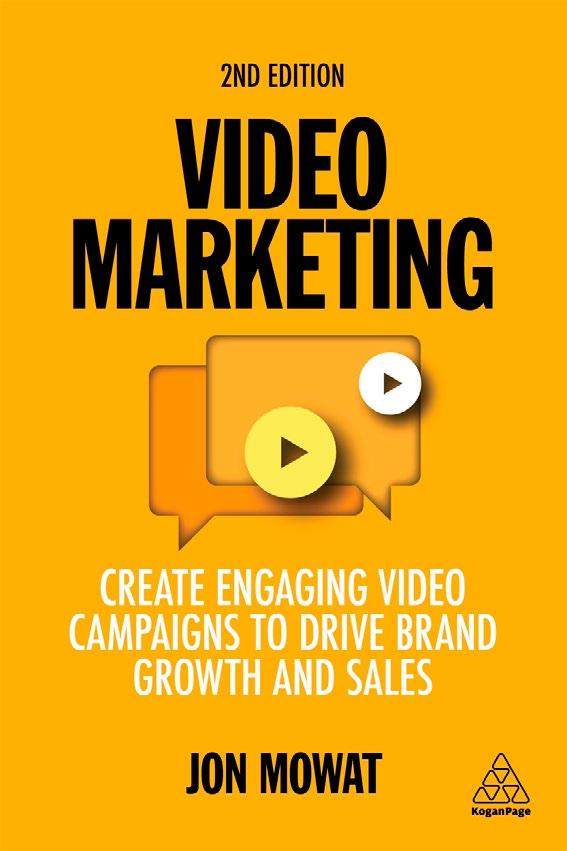
• Shows how to create and edit video campaigns for all budgets, including DIY approaches using DSLRs and smartphones
• Contains case studies and examples from well-known international brands including adidas, Kleenex, and Red Bull
• Online resources: video links for campaigns discussed in the book and a downloadable strategy planner
• New to this edition: chapters on understanding your audience and buying media space on ad networks and social media, content on personal and personalized content and avoiding potential pitfalls such as frauds and fake views
Video Marketing takes a step-by-step and in-depth look at planning and creating great video campaigns, as well as activating, testing and measuring their success. Featuring case studies from global household names such as adidas, Kleenex, and Red Bull, it explores which video types and platforms brands should use, using multi-video campaigns, live videos and webinars, as well as creating and editing video campaigns on a budget using DSLRs and smartphones.
Updated with the latest developments, this second edition of Video Marketing contains new chapters on understanding your audience and buying media space on ad networks and social media, as well as further content on personal and personalized content and avoiding potential pitfalls such as frauds, fake views and updates. Accompanying online resources consist of video links for campaigns discussed in the book and a downloadable strategy planner for readers to complete and put into action.
Author Information
Edition: 2
Date: 08/28/2021
Price: $25.99
Paperback: 9781398601147
Ebook: 9781398601154
Pages: 288
Format (mm): 234x158
Band: Professional
Subject: Digital Marketing
Table of Contents
1 What is video marketing?
2 Why video marketing works
3 Understand your audience
4 Video types and platforms
2 Creating great videos
5 The basics of video marketing
6 Planning effective video campaigns
7 Storytelling and creative that changes behaviour
8 Activation, measurement and testing
9 Buying media space on ad networks and social media
10 The dark underbelly of video advertisingHow to avoid losing money
3 DIY video projects
11 Filming and editing
12 Filming on a smartphone and DSLRs
4 Creating effective video campaigns
13 Steps 1 and 2 - Where your brand content is now and setting goals
14 Step 3 - Content planning and programming strategy
15 Step 4 - Building the perfect content hub
16 Step 5 - Creating high-volume video content - And making it easy
17 Step 6 - Multi-video campaign activation and testing (how to grow ROI)
• Covers all aspects of marketing from the planning stages and implementation to measuring data and campaign performance
• Grounds big picture theory in real-world practice with case studies from cutting-edge global companies, including TikTok and Spotify
• New to this edition content on the following key topics: Social Media Marketing and AI, Retail Digital Advertising, Third-party data, Measurement of MarComms, Semiotics and the Metaverse, plus updated global case studies and examples
• Online Resources: PowerPoint slides for lecturers, and a multiple choice question bank
Full marketing integration is vital in establishing effective marketing initiatives. This newly updated, clear and accessible textbook provides students and practitioners with the skills they need to deliver successful campaigns for the modern consumer.
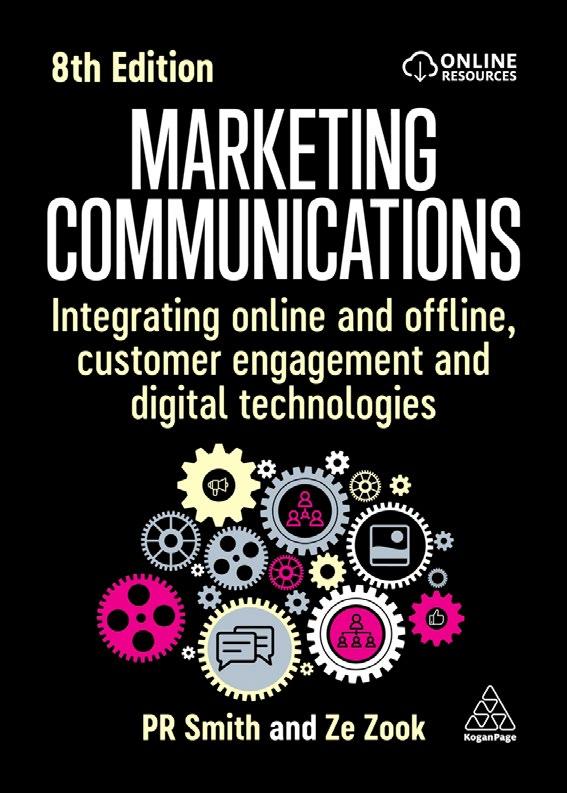
The 8th edition of Marketing Communications continues to be a core resource covering all aspects of marketing from the planning stages and implementation to measuring data and campaign performance. Explore how to navigate buyer behaviour, social selling, PR campaigns, big data, marketing automation and more with this complete textbook.
Learn through current, real-world case studies from global companies such as TikTok and Spotify and explore what it takes to build a truly integrated, successful marketing plan. Incorporating branding, customer journey, advertising and more, Marketing Communications also provides in depth content on the legal requirements you need to develop your strategy including all you need to know about new GDPR rules and 3rd party data.
New to this edition, it includes information on the ongoing impact of AI in all aspects of marketing communications ensuring that you have all the tools necessary to reach the modern consumer while utilizing the latest industry technologies.
This book will give readers the confidence to work in an environment of constant technological transformation and build the core skills they need as marketers to create fully integrated strategies and successful campaigns.
PR Smith is a marketing consultant, bestselling business author and inspirational speaker. He has helped hundreds of businesses, from innovative start-ups to established blue-chip companies. He is founder of SOSTAC® Planning framework, voted in the Top 3 Business Models worldwide by the Chartered Institute of Marketing's Centenary Poll, and created the Great Sportsmanship Programme.
Ze Zook is an integrated marketing author, lecturer, producer and consultant specializing in helping the creative industries fulfil both their missions and business goals. He is a visiting academic at Regent's University London and consults on digital marketing for privatesector disruptive start-ups.
Edition: 8
Date: 12/28/2023
Price: $59.99
Paperback: 9781398611719
Ebook: 9781398611726
Pages: 680
Format (mm): 246x189
Band: Textbook
Subject: Marketing Communications
1 Communications background and theories
1 New integrated marketing communications
2 Branding
3 Customer relationship management
4 Buyer behaviour
5 Communications theory
6 Marketing communications research
7 Marketing communications agencies
8 International marketing communications
9 The marketing communications plan
10 The changing communications environment
2 Communications tools
11 Selling, social selling, marketing automation and martech
12 Advertising
13 Publicity and public relations
14 Sponsorship
15 Content marketing and other sales promotion
16 Direct mail, email, messaging and chatbots
17 Exhibitions, events and experiential marketing
18 Merchandizing and point of sale
19 Packaging
20 Owned media – websites and social media
• Features contributions from leading academics, industry experts, thought leaders and influencers around the globe
• Presents a wealth of varying perspectives on content marketing grouped into key subject areas, allowing the reader to move through the book according to their interests and absorb the most useful aspects of each discussion
• Includes coverage of core subjects including media publishing, text vs visuals vs gaming, the ethics of native advertising, content marketing measurement, content blockers, storytelling through data, and much more
• Brings together numerous, and often opposing, perspectives to present a unified, definitive appraisal of content marketing as a whole
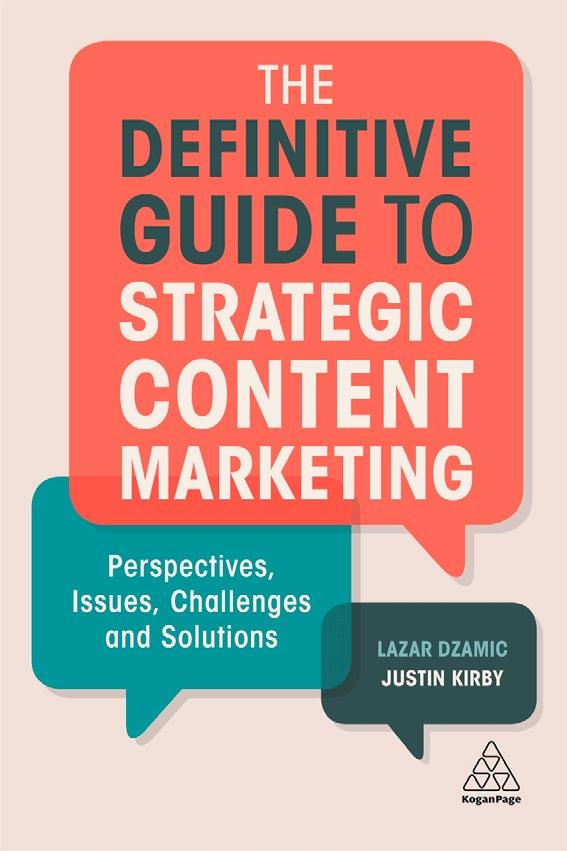
• Online resources: Bonus chapters
Edition: 1
Date: 07/28/2018
Price: $29.99
Paperback: 9780749482220
Ebook: 9780749482237
Pages: 288
Format (mm): 235x157
Band: Professional/ Academic
Subject: Marketing Communications
Introduction: mapping the Content marketing & territory
1 Content marketing: a new and better promise?
1 Why Content is seen as the solution to current marketing challenges
2 Experience Economy: brand and customer experience as Content enablers
3 How Content can help build sustainable brands with better purposes
2 How Content changes the way we all do business
4 Creative agency perspective: how Content impacts creativity, process and revenue
5 Media agency perspective: how Content impacts creativity, process and revenue
Online Chapter 01 Client perspective: how Content & impacts creativity, process and revenue
Online Chapter 02 Publisher perspective: how Content impacts creativity, process and revenue
3 Data, new formats and the role of Content in the consumer journey
6 Content distribution and its role in the consumer journey
7 Content and storytelling in the age of user data abundance
8 The evolution of Content formats: from text to video to AR/VR to AI…
4 How to measure and evaluate Content marketing
9 Key measurement issues relating to Content marketing
5 Content marketing: not such a new and better promise?
10 The rejecter’s manifesto: key arguments against the Content marketing ‘mirage’
11 Content marketing and ethics: challenges, threats and balancing acts
12 Conclusions
• Explains how to integrate immersive brand experiences into marketing strategies, using targeted outreach for a live social media domino effect

• Provides practical steps to plan, inspire, activate and evaluate tangible results from experiential initiatives
• New to this edition: four new chapters on digital experience and merged realities, the experience economy, customer experience and the 'Pop-Up' phenomenon
• Online resources: practical checklists, workbooks and sector -focused content on drinks, cosmetics, FMCG, automotive, retail, fashion and technology
The immersive brand experience is revolutionizing brand engagement. Experiential Marketing, second edition, cuts through the jargon with clear practical guidelines on how to magnify marketing strategies to a powerful new level. This book emphasizes that experiential marketing is not just about creating a live event. A unique, immersive experience allows businesses to generate a surge of brand engagement, which is amplified immediately by a niche target of consumers through live content sharing and social media streams.
This comprehensive second edition of Experiential Marketing pinpoints exactly where this innovative strategy fits in with the current marketing and events climate, including a stepby-step outline to plan, integrate and evaluate its game-changing results. The completely fresh content analyzes the latest industry advances and case studies, including four new chapters on the digital experience and merged realities, plus the experience economy and creative explosion of the 'Pop-Up' phenomenon. Accompanied with a digital toolkit of downloadable resources, this book is essential reading for marketing, business, media and events professionals alike, providing strategic decision makers with a unique competitive advantage in a vibrant new era of marketing strategy.
Shirra Smilansky is CEO and Executive Creative Director of Electrify Worldwide Ltd, an international brand engagement agency working with clients such as L'Oreal Luxe, Carling, Selfridges, Harvey Nichols, Lancome and Yves Saint Laurent. She is the Co-founder of an MA degree 'Experiential Meets Digital' and former Visiting Professor at London Metropolitan University. With over 15 years in the industry, Smilansky is an impactful thought-leader, entrepreneur and innovator in experiential marketing, co-founding her first company BlazinStar Experiential back in 2003.
Edition: 2
Date: 12/28/2017
Price: $31.99
Paperback: 9780749480967
Ebook: 9780749480974
Pages: 320
Format (mm): 235x158
Band: Professional/ Academic
Subject: Marketing Communications
1 An experiential revolution: the accelerating transformation of business and marketing
1 What is experiential marketing?
2 A whole new world: millennials, brand experiences and social media
3 The experience economy is here
4 Concept stores, the future of retail and pop-ups
5 Digital experiences, artificial intelligence in marketing and merged realities
6 The BETTER creative model: how to create unique experiential marketing ideas
2 SET MESSAGE: an activation framework for your experiential marketing strategy
7 Situation and background: exploring the business context for experiential marketing
8 Experiential objectives: how to creatively define and set your goals
9 Target audience: gathering holistic insights and understanding of your customers
10 Message: key communication of your brand message using experiential marketing
11 Experiential strategy: how to develop live brand experience strategies and frameworks
12 Selected locations and brand ambassadors for your experiential marketing strategy
13 Systems and mechanisms for measurement for experiential marketing planning
14 Action: how to deliver and project manage live brand experiences
15 Gauging effectiveness: creating a realworld test-and-learn approach for experiential marketing environments
16 Evaluation: interpreting and monitoring tangible results from experiential marketing
17 Conclusion: planning for the future of experiential marketing
• Explains how to amplify engagement by tapping into consumer emotions with practical, psychology-driven techniques
• Inspires the confidence and dexterity to sell and deliver stand out copy in a variety of creative contexts
• Includes exclusive interview insights across the creative industry from high profile copywriters, ad agencies and market leaders
• New to this edition: four new chapters placing copywriting in context: content marketing, creativity, storytelling and the impact of mobile and social channels; how to sell, quantify, brief and critique copy; plus brand new interview insights directly from the industry
Enhance your copywriting skills with psychology-driven techniques to create stand out copy that taps into consumer decision making and sells, using this second edition of the ultimate copywriting survival guide for the 21st century - essential to every marketing or creative professional's bookshelf.
With many professionals now developing their skills on the job, it is notoriously difficult to benchmark successful copy. This book provides a step up for those who already know the basics of writing copy, and are seeking more advanced, psychology-driven techniques to gain the competitive edge. With practical insight into human decision making and consumer engagement, it will inspire the clear-cut confidence needed to create, quantify, and sell stand out copy in a cluttered marketplace.
Complementing the 'how to' perspective of copywriting, with impressive interviews from leading ad agencies and copywriters across the globe, this second edition addresses the everyday issues faced in a multitude of roles, including:

-Practical advice to measure and benchmark effective copy
-Guidance on creating and critiquing briefs
-New chapters on how to weave copywriting skills into the wider industry
-Storytelling and content marketing
-The impact of evolving channels like mobile and social media
Practical, inspiring and extremely digestible, Persuasive Copywriting is the only vibrant, all-encompassing guide to copywriting that you need.
Andy Maslen is Managing Director of Sunfish, a writing agency specializing in corporate communications, direct marketing and digital content, and CEO of the Andy Maslen Copywriting Academy. A lifetime fellow of the Institute of Direct and Digital Marketing, Maslen works globally with clients such as the NHS, Prudential, The Economist, BBC Worldwide, Hamleys, London Stock Exchange, RSPB, The New York Times and PricewaterhouseCoopers. He is co-founder of the Copy Cabana conference and a bestselling author of numerous fiction and non-fiction books.
Edition: 2
Date: 01/28/2019
Price: $29.99
Paperback: 9780749483661
Ebook: 9780749483678
Pages: 296
Format (mm): 235x157
Band: Professional/General
Subject: Marketing Communications
1 Copywriting in context
1 Creativity – A genuinely marketable skill?
2 The right and wrong way to judge copy
3 The impact of new channels – From mobile to social
4 Blood brothers or ugly sisters – How do copy and content fit together?
2 Motivation versus reason – Tapping into your customer’s deepest drives
5 Harnessing the power of emotional copywriting to persuade your prospects
6 Three big ideas you should use for copy before highlighting the "benefits"
7 A powerful process for developing customer empathy through copy
8 Copywriting hacks – Flattery will get you everywhere
9 The ancient Greek secret of emotionally engaging copy
10 Copywriting and connecting on social media
11 Creating calls to action – Top tips to bring home the bacon
3 The pleasure principle – Making your writing more enjoyable and compelling
12 Balancing pleasure and profit – Five techniques to write fantastic copy
13 How to engage your imagination and free your creativity
14 Tone and technique in copy – Finding your voice (and that of others)
15 The definitive guide to when grammar matters in copywriting
16 Injecting life into your sales pitch – An ageold method

• Delivers a clear, repeatable methodology that will transform an organization's IC practices from chaos to calm
• Uses data and statistics to prove the impact that IC has on profit margins, and gives practical tips for getting board members on side for IC initiatives
• Highlights relevant research, comments and input from leading industry figures including Seth Godin and Brené Brown
• Includes practical case studies from companies such as Perrigo, SSP and transport organizations like fire services and airports
Streamline your organization's communication for happier employees, clients and customers, with this powerful and practical methodology featuring insight from experts Simon Sinek and Brené Brown.
As the title suggests, Influential Internal Communication proves just how influential internal communications (IC) is, and the measurable impact it has on an organization's growth. For many organizations, IC often slips down the list of priorities when there are high pressure, high stakes business situations to cope with. This causes a sense of chaos and confusion within the organization that will - eventually - permeate to external customers and clients. Influential Internal Communication presents a clear, adaptable methodology that will help readers understand, diagnose and fix their own communication challenges, thereby transforming the chaos into calm.
Backed up with data and statistics from industry reports on workplace culture, Influential Internal Communication is based on The Field Model and draws on research with CEO's, some of the best insights into people, organisations and chaos. The theory is backed up with real world case studies, showing how chaos can impact a range of organizations of varying size and industry. Written by the 2020 President of the Chartered Institute of Public Relations (CIPR), Influential Internal Communication will streamline any organization's IC practices, and help to drive engagement, efficiency and profit across the board.
Jenni Field has nearly 20 years' experience in communications and is based in Berkshire, UK. She has worked at Director level for numerous organizations including the global pharmaceutical company Perrigo. Jenni Field was the 2020 President of the CIPR, and is both Chartered and a fellow of the Institute. She has been quoted by The Times, Raconteur and listed on the Institute of IC's 30 under 30, and Inspiring Workplaces top 101 influencers in employee engagement. She now runs her own consultancy, Redefining Communications, and speaks regularly for organisations and at industry events.
Edition: 1
Date: 04/28/2021
Price: $39.95
Paperback: 9781789666137
Ebook: 9781789666144
Pages: 240
Format (mm): 235x158
Band: Professional/ Academic
Subject: Internal Communications
Introduction
1 Foundations
1 Introduction to internal communication
2 Without communication there is chaos
3 Understanding organizations and leadership
4 Understanding people
2 Applying the model
5 The Field Model
6 Data and diagnostics
7 The fix
8 Applying the model and making it work for the long term
9 Conclusion

• Explores what makes a luxury brand and how to market them in a changing global context
• Shows how luxury brands can develop customer relationships through AR and AI and embrace end-to-end sustainability and the circular economy
• Contains case studies from international brands such as Ferrari, Balenciaga and Shang Xia as well as discussion points and suggestions for further reading
• Online resources: lecture slides for each chapter and video interviews with industry experts
• Written by leading academics with extensive industry experience and tightly edited into a cohesive whole
Learn what makes a luxury brand, how to successfully market them in a changing global context and what opportunities sustainable luxury and the latest technological developments present.
Managing Luxury Brands offers comprehensive coverage of key and cutting-edge topics in luxury brand management. Examining the socio-cultural contexts of luxury and the ways in which prestige brands create meaning, it presents a framework for understanding, analysing and developing a modern luxury brand. Unlike many other texts, it also explores the environmental and social impact of luxury, sustainable luxury and the opportunities of new technological innovations including the metaverse, artificial intelligence and nonfungible tokens (NFTs).
With case studies and examples from a range of brands including Ferrari, Balenciaga and Shang Xia, Managing Luxury Brands brings together insights from leading academics in the field from across the globe who draw on extensive consulting and industry experience. Supported by a range of features which include learning objectives, discussion questions and chapter summaries, accompanying online resources consist of lecture slides and video interviews with industry experts. This textbook is an invaluable resource for any student studying luxury brand management.
Eleonora Cattaneo (ed.) is Professor of Luxury Management and Director of the MSc and Executive Masters in Luxury Brand Management at Glion Institute of Higher Education in Switzerland. Previously, she was Senior Lecturer in luxury marketing and Head of the MA in Luxury Brand Management at Regent's University London. She has extensive consulting experience and has advised global brands and leading luxury hospitality groups. The author of several publications and papers, her research interests focus on rebranding, heritage branding and sustainable luxury buying behaviour. She is based in Ticino, Switzerland.
Edition: 1
Date: 03/28/2023
Price: $49.99
Paperback: 9781398606401
Ebook: 9781398606739
Pages: 360
Format (mm): 235x156
Band: Textbook
Subject: Luxury Marketing
1 Definitions of luxury and key facets of luxury branding
1 Luxury - a changing paradigm?
2 The evolving meaning of luxury brands and a framework for creating modern prestige
3 Luxury trends accelerated by the Covid-19 pandemic
4 The environmental and social impact of luxury - consumer concerns and practices
2 Managing luxury brands today
5 Sustainable luxury and circular economy
6 Advances in digital - new opportunities for luxury retail
7 Developing profitable customer relationships through AI
3 New directions in luxury branding
8 Luxury in the Metaverse - The five forces of value creation for luxury brands in the Metaverse
9 The ‘brand origin’ dilemma
10 The niche world of ultra-luxury brands - A unique set of customers and how to act differently to serve them
11 The old is the new ‘new’ - Emerging business models in the luxury fieldrenting and resale
12 Future industry developments
- Experiential luxury, extreme personalization and bringing back the human factor in luxury branding
• Explains what sets a luxury customer experience apart and how to adapt to the changing luxury landscape
• Demonstrates how to adapt brand messaging across different channels and media and how to integrate emerging technology such as AI in order to deliver a true omnichannel experience
• Shows how to use data to provide truly personalized experiences whilst protecting customer privacy
• Features case studies from leading luxury brands such as Lamborghini, Prada and Gucci
What is a luxury customer experience and how can luxury brands best use emerging technologies in order to create truly unique, high-end experiences for their customers?
These are the questions that The Future of Luxury Customer Experience has been designed to answer, as it explores how luxury brands can best utilize new technologies to deliver experiences that surprise and delight customers in a truly omnichannel environment.
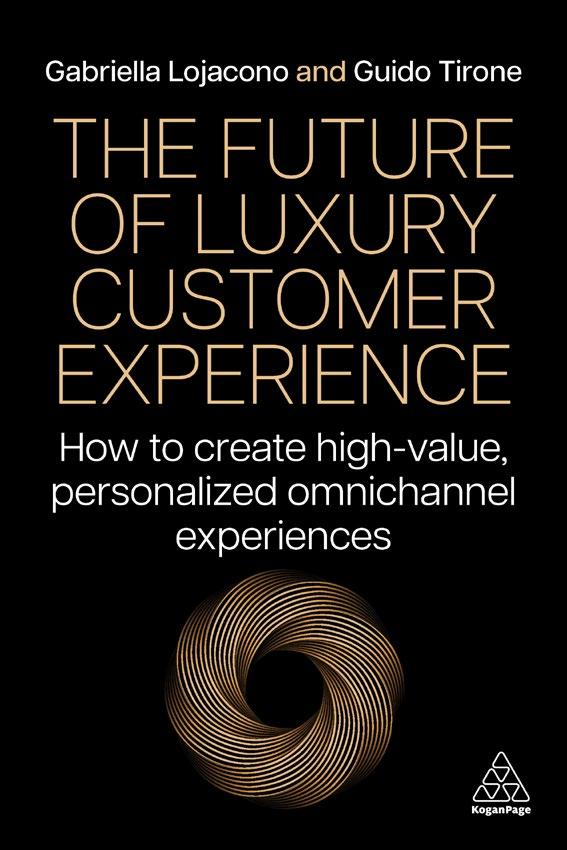
Using case studies from world-leading luxury retailers such as Dior, Chanel and Ferrari, this book explains what makes a luxury customer experience different. Learn how luxury brands need to evolve in order to adapt to the changing landscape, using data and the latest technology to provide exceptional customer experiences whilst protecting their customer's privacy. Written by experts from the world-leading SDA Bocconi School of Management, this book provides a thorough understanding of how to create and deliver luxury customer experiences that will build long-lasting customer loyalty, as well as how these experiences can build and support brand awareness. Covering topics such as inclusivity and social responsibility, the use of AI and virtual experiences, as well as how set KPIs to evaluate success, this book provides practical advice on how to create a luxury customer experience that will deliver exceptional results.
Gabriella Lojacono is an Associate Professor of International Management at the Department of Management and Technology of Università Bocconi and SDA Bocconi School of Management based in Milan, Italy. She is also the Director of the Executive Master in Luxury Management at SDA Bocconi.
Guido Tirone, based in Dallas, Texas is VP of Customer Insights and Analytics at Canyon Ranch. He is also Senior Lecturer for the University of Texas and a Fellow at SDA Bocconi School of Management.
Edition: 1
Date: 06/28/2024
Price: $47.99
Paperback: 9781398615458
Ebook: 9781398615465
Pages: 344
Format (mm): 234x156
Band: Textbook/ Professional
Subject: Luxury Marketing
1 Adapting to the Changing Luxury Landscape
1 Going Global Whilst Staying Local
2 Reimagining the Supply Chain
3 Embracing Social Responsibility and Inclusivity
4 Building Brand Equity Through Authenticity
5 Becoming Truly Omnichannel
6 Strategic Collaboration Across Industries
2 Using Data and Tech to Build and Personalize Relationships
7 Building a 360° View of the Customer
8 Privacy and Customer Relationship Management
9 Building a Personalized Relationship
10 The Store of the Future: Offline vs Online presence
3 Best-Practice Customer Relationship Management for Experience and Engagement
11 How Luxury Customer Experience Can Support Brand Awareness
12 How to Optimize Spend and Evaluate Success
• Addresses the need to demonstrate growth in the face of the many unique challenges to the luxury sector
• Offers expert strategies that help sustain luxury growth at higher volumes without risking dilution
• Includes recent and authoritative international research into the basis of the luxury dream and a fresh approach to the specific obstacles to perceived exclusivity posed by the Internet
This book addresses the No 1 challenge of all major luxury brands today: How can these brands pursue their growth yet remain luxury? How do you reconcile growth and rarity?
Kapferer on Luxury offers a selection of the most recent and insightful articles and original essays on the luxury growth challenge from Jean-Noël Kapferer, a worldrenowned luxury analyst. Each chapter addresses a specific issue relating to the luxury growth challenge such as sustaining the 'luxury dream', adapting the internet to luxury demands, re-widening the gap with premium brands' competition, and the importance of non-delocalization. It also explores in detail facing the demand of the Chinese clients, rising sustainable quality and experiential standards, developing real luxury services and managing luxury brands within groups without diluting their equity and more.
As such, Kapferer on Luxury is the perfect and timely resource for luxury executives, communication managers, luxury observers and advanced students willing to deepen their understanding of this major luxury challenge.

Jean-Noël Kapferer is one of world's foremost thought leaders on luxury and its brands. An active researcher, HEC Paris graduate and PhD-holder from Northwestern University's Kellogg Business School (USA), Kapferer is co-author of The Luxury Strategy and The New Strategic Brand Management and has written many seminal articles. He is a sought after speaker, leading seminars on luxury all around the world at institutions such as HEC Paris, Tsing Hua University Beijing, Seoul Luxury Business Institute and LBI Shanghai. He is also advisor to the president of Inseec Business School (Paris).
Edition: 1
Date: 03/28/2015
Price: $41.99
Paperback: 9780749474362
Ebook: 9780749474379
Pages: 240
Format (mm): 235x158
Band: Textbook/ Professional
Subject: Luxury Marketing
Introduction: Growth issues for luxury
1 How luxury is changing
1 Sustaining the luxury dream: challenges and insights
2 Abundant rarity: the key to luxury growth
3 The artification of luxury: from artisans to artists
2 Specific issues and challenges
4 Luxury after the crisis: pro logo or no logo?
5 Why luxury should not delocalize: a critique of a growing tendency
6 Internet and luxury: under-adopted or illadapted?
7 Does luxury have a minimum price?: an exploratory study into consumers’ psychology of luxury prices
8 All that glitters is not green: the challenge of sustainable luxury
3 The business side of luxury brands’ growth
9 Not all luxuries act alike: the distinct business models of luxury brands
10 The LVMH–Bulgari agreement: what changes in the luxury market lead family companies to sell up?
11 Developing luxury brands within luxury groups: synergies without dilution?
• Identifies the rules for marketing luxury products and implementing a luxury strategy
• Provides the depth insight required to master luxury marketing strategies
• Includes coverage of human resources and financial management in the luxury space
Discover the secrets to successful luxury brand management with this bestselling guide written by two of the world's leading experts on luxury branding, Jean-Noël Kapferer and Vincent Bastien, providing a unique blueprint for luxury brands and companies.
Having established itself as the definitive work on the essence of a luxury brand strategy, this book defines the differences between premium and luxury brands and products, analyzing the nature of true luxury brands and turning established marketing 'rules' upside-down.
Written by two world experts on luxury branding, The Luxury Strategy provides the first rigorous blueprint for the effective management of luxury brands and companies at the highest level.
This fully revised second edition of The Luxury Strategy explores the diversity of meanings of 'luxury' across different markets. It rationalizes those business models that have achieved profitability and unveils the original methods that were used to transform small family businesses such as Ferrari, Louis Vuitton, Cartier, Chanel, Armani, Gucci, and Ralph Lauren into profitable global brands.

Now with a new section on marketing and selling luxury goods online and the impact of social networks and digital developments, this book has truly cemented its position as the authority on luxury strategy.
Jean-Noël Kapferer is an internationally recognized thought leader on brands and brand management. A professor at HEC Paris, he holds a PhD from Northwestern University (USA) and is an active consultant to many European, Asian and American corporations. He is the author of 12 books, including the international bestseller New Strategic Brand Management, and Reinventing the Brand (published by Kogan Page).
Vincent Bastien is one of the most experienced senior managers in the luxury business. Formerly MD of Louis Vuitton Malletier and CEO of Yves Saint Laurent Parfums, he has held senior posts at some of the world's most prestigious luxury brands. He is now Affiliate Professor at HEC Paris, teaching Strategy in Luxury.
Edition: 2
Date: 09/28/2012
Price: $51.99
Hardback: 9780749464912
Ebook: 9780749464929
Pages: 408
Format (mm): 242x163
Band: Textbook/ Professional
Subject: Luxury Marketing
1 Back to luxury fundamentals
1 In the beginning there was luxury
2 The end of a confusion: premium is not luxury
3 Anti-laws of marketing
4 Facets of luxury today
2 Luxury brands need specific management
5 Customer attitudes vis-à-vis luxury
6 Developing brand equity
7 Luxury brand stretching
8 Qualifying a product or service as luxury
9 Pricing luxury
10 Distribution and the internet dilemma
11 Communicating luxury
12 Financial and HR management of a luxury company
3 Strategic perspectives
13 Luxury business models
14 Entering luxury and leaving it
15 Learning from luxury
16 Luxury and sustainable development: convergences and divergences
• Explains how any marketer, in any category, can elevate their brand and become a modern prestige brand
• Provides actionable checklists and advice on how to apply the power of prestige to add meaning to a brand, making it peerless, priceless and profitable
• Includes answers to key questions such as how to operate a luxury brand on social media
• Packed with case studies from leading global brands including including Airbnb, Acqua di Parma, Burt's Bees, Lakrids, Starbucks, TerraCycle, and YouTube
How can a brand become one of those peerless 'Ueber-Brands' we all admire and are willing to pay a premium for? Is there a proven process? Where should we start?
Brand Elevation explains the main drivers behind brands becoming peerless and priceless and how to harness these principles to develop a winning brand strategy. Written for marketers and brand managers of all levels of experience, and for both those working in start-ups and established players, it proposes a six-step, easy-to-follow program to elevate your brand.
Brand Elevation explores challenges such as creating a distinct and brand-guiding mission, mediating between exclusivity and inclusion and mastering the art of seduction. Featuring case studies and expert accounts from organizations including Airbnb, Acqua di Parma, Burt's Bees, Lakrids, Starbucks, TerraCycle, and YouTube, Wolfgang Schaefer and JP Kuehlwein skilfully explain how any brand - regardless of sector and industry - can become a modern prestige brand.

Wolfgang Schaefer is CEO and Founder of zwoelf consulting, specialized in narrative brand strategies. Based in Berlin and NYC, he lectures at XU Exponential University Potsdam and other schools in Europe and the US. For the past 25 years as chief strategist he has worked with many of the world's top marketers at LVMH, P&G, Miele, Swarovski, Coty and Unilever et al.
JP Kuehlwein is the Founder of marketing consultancy Ueber-Brands. He's also Adjunct Professor of Marketing at NYU Stern and Columbia Business School and leader of the Marketing Institute at The Conference Board think tank. Previously, he was Executive Vice President at Frederic Fekkai & Co as well as Brand Director and Director of Corporate Strategy at Procter & Gamble.
Edition: 1
Date: 01/28/2021
Price: $41.99
Paperback: 9781789664669
Ebook: 9781789664676
Pages: 304
Format (mm): 233x155
Band: Professional/ Academic
Subject: Luxury Marketing
1 RECAP – THE PRINCIPLES OF UEBERBRANDINGTM
1 Principle 1 - Mission incomparable –Having a distinct, brand-guiding Mission
2 Principle 2 - Longing vs belonging –Balancing exclusivity and inclusion
3 Principle 3 - Un-selling – Mastering the art of seduction
4 Principle 4 - From Myth to meaning –Giving the brand soul
5 Principle 5 - Behold the product! Making your product manifest the Myth
6 Principle 6 - Living the dream – Letting the brand radiate from the inside out
7 Principle 7 - Growth without end –Balancing scaling and brand building
2 HOW TO – SIX STEPS TO ELEVATE YOUR BRAND
8 Step 1 - Set Your Mission
9 Step 2 - Write Your Myth
10 Step 3 - Realize Your Dream
11 Step 4 - Live Your Dream
12 Step 5 - Find Your Ueber-Target
13 Step 6 - Ignite All Targets
14 Summing up – The Ueber-Branding Model
3 LESSONS – UEBER-BRANDING IN ACTION
15 Case 1 - TerraCycle – From Mission to Myth to movement, or – How to ‘eliminate the idea of waste’
16 Case 2 - Acqua di Parma – The power of a mythical core, or – How to build your business and your equity simultaneously
17 Case 3 - Burt’s Bees – Growing an UeberBrand ground up, or – How purpose and profit can live in harmony
18 Case 4 - Starbucks – The renaissance plan, or – How to leap ahead by going back to quality and service
19 Case 5 - Airbnb – The importance of culture, or – How Airbnb found, launched and lives its purpose
20 Case 6 - Lakrids – Growth without end, or –How to scale a dream
21 Case 7 - YouTube – Platform or brand of the future, or – How to be one when you are many
EPILOGUE: Crises – Times of UeberOpportunities
22 References and further reading
23 Index

• Provides examples from global brands such as Harley-Davidson, Caterpillar, Disney, Apple, Madecraft, LinkedIn, Johnson & Johnson, Nestle, FedEx, and Gillette among others
• Introduces a detailed step-by-step formula to transition any part of your portfolio, regardless of industry, to luxury status
• Redefines luxury as a series of attributes or "switches" that create greater perceived value in the eyes of consumers
• Online resources: sample syllabi for classroom use, templates for application of framework, case studies, discussion questions
Expand your existing portfolio by using the creative luxury process to elevate specific products and provide greater value to customers.
Contrary to popular belief, luxury is a well-defined code that can be reapplied to any other product or service to enhance its value. Adding Prestige to Your Portfolio reveals how non-luxury companies can apply the principles of luxury and creativity to transition parts of their portfolio to luxury status.
Adding Prestige to Your Portfolio describes how companies can elevate any product or service at each step of the customer buying journey (awareness, search and compare, purchase, use, advocate). By applying the creativity technique Closed World Principle, readers can determine which luxury benefits (security, fun, self-respect, self-fulfillment, accomplishment, recognition, relationships or belonging) would best map to their product or service and garner the greatest business impact at that particular stage of the customer buying journey.
Illustrated with examples from industries as diverse as healthcare and industrial equipment, Adding Prestige to Your Portfolio shows companies how to borrow the elements of luxury and sprinkle them throughout the customer experience in order to strengthen loyalty and increase their appeal to potential new customers. Online resources include sample syllabi, templates to aid in application of framework, case studies and discussion questions.
Drew Boyd is Associate Professor of Marketing and Innovation at the University of Cincinnati in Mason, Ohio. He trains, consults and speaks on the topics of innovation, persuasion and marketing strategy at Macy's, Toyota and Procter & Gamble. He spent 17 years at Johnson & Johnson in marketing, mergers and acquisitions, and international development, where he also earned his first of five patents for medical devices. His work has been featured in business publications such as The Wall Street Journal, Bloomberg, Industry Week, Psychology Today, and Strategy+Business
Edition: 1
Date: 01/28/2021
Price: $39.95
Paperback: 9781789666090
Ebook: 9781789666106
Pages: 216
Format (mm): 235x158
Band: Professional/ Academic
Subject: Luxury Marketing
1 The Luxury Opportunity – Upscale and Grow
2 Switching on Luxury – The Tools of Creative Luxury
3 Transforming a Product or Service to Luxury
4 Transforming the Shopping and Buying Experience
5 Transforming the Usage Experience
6 Transforming the Post-Purchase Experience
7 Driving Prestige into Your Culture
8 Conclusion
• Explains how to streamline marketing and management processes across a luxury business
• Contributes unique strategies from more than fifty luxury thought leaders across Europe, Asia, Australia and the Americas
• New to this edition: how to manage the changing Asian markets, the digitalization of sales, communication and product, new strategies for the evolving market and business of luxury
• Shares high profile insights to case studies such as Louis Vuitton, Leica and MoëtHennessy
Examine luxury branding on a global scale, with more than fifty cutting edge contributions from the foremost thought leaders in luxury management and marketing.
The Management of Luxury, second edition, presents a unique snapshot of best practice insights into the increasing challenges faced in luxury business, with contributions shared by more than fifty global leaders on luxury management. The highly renowned editors draw these together into one essential handbook, ranging from luxury brand strategy, luxury consumer behaviour and market positioning, through to management succession, heritage, counterfeiting and competing effectively as a luxury SME.

Fully updated in its second edition, The Management of Luxury explores the newly evolving direction of Asian market trends and how to integrate digitalization into sales and product strategies. Both are crucial for competitive advantage in the luxury market, featured alongside iconic case studies such as Burberry, Louis Vuitton and Leica. The book's value is not only in streamlining management processes and return on investment; but equally for those who marvel at an industry unlike any other, striving to trust both in the conventional and innovate new paths towards the extraordinary. Highly influential, applicable and enlightening, it is a vital addition to every luxury business manager's collection.
Benjamin Berghaus is Head of the Competence Center for Luxury Management at the Institute of Marketing of University of St.Gallen (HSG), Switzerland.
Günter Müller-Stewens is Professor of Management and Organization at the University of St.Gallen (HSG), Switzerland, and Director of its Institute of Management.
Sven Reinecke is Associate Professor of Business Administration, specialized in Marketing, and Director of the Institute of Marketing at the University of St.Gallen (HSG), Switzerland.
Edition: 2
Date: 06/28/2018
Price: $44.99
Paperback: 9780749481827
Ebook: 9780749481810
Pages: 496
Format (mm): 234x157
Band: Professional/ Academic
Subject: Luxury Marketing
• Explains how to use market research tools and methods effectively to obtain reliable results with examples from companies including Adidas, Marks & Spencer, Grohe and General Motors
• New to this edition: two new chapters on using market research to test social and political opinions and GDPR, as well as new sections on web scraping, storytelling reporting and research trends.
• Online resources: templates to use when conducting market research such as 'customer satisfaction questionnaires' and 'focus group discussion guide' as well as improved PowerPoint slides for lecturers and exercises for students
Market Research in Practice provides a practical and robust introduction to the subject, providing a clear step-by-step guide to managing market research and how to effectively to obtain the most reliable results. Written by an industry expert with over 35 years' practical experience in running a successful market research agency, tips and advice are included throughout to ground the concepts in business reality. This text also benefits from real-world examples from companies including Adidas, Marks & Spencer, Grohe and General Motors.
Now in its fourth edition, Market Research in Practice is now fully updated to capture the latest changes and developments in the field and explores new tools of qualitative research using online methods as well as expanding further on online surveys such as SurveyMonkey. Accompanied by a range of templates, surveys and resources for lecturers, this is an invaluable guide for students of research methods, researchers, marketers and users of market research.
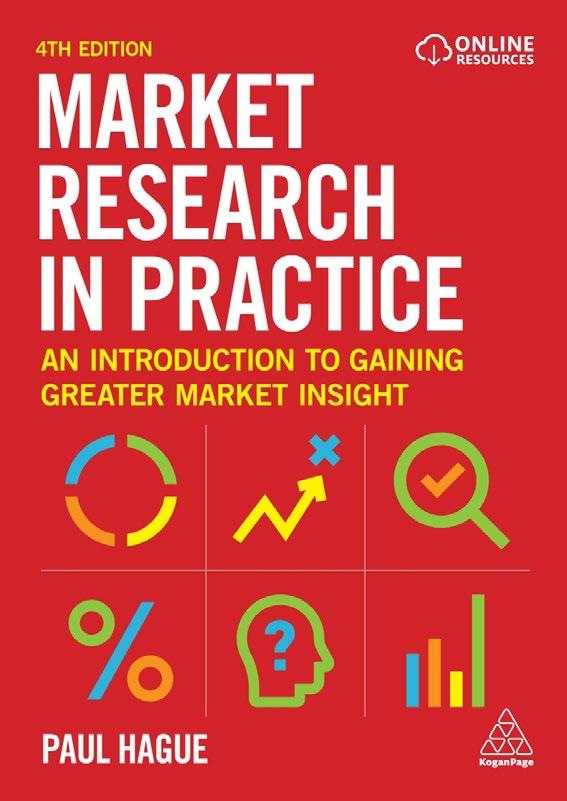
Author Information
Edition: 4
Date: 11/28/2021
Price: $46.95
Paperback: 9781398602823
Ebook: 9781398602830
Pages: 392
Format (mm): 240x170
Band: Textbook/ Professional
Subject: Market Research
Table of Contents
1 Introduction
2 Market research design
3 Uses of market research
2 Qualitative research
4 Qualitative research
5 Desk research
6 Focus groups
7 Depth interviewing
8 Observation and ethnography
3 Quantitative research
9 Quantitative research
11
and statistics
25
• New to this edition: three new chapters on researching digital culture, applied semiotics in branding and storytelling and branding in marketing communications
• Provides insight into what semiotics is, why it matters and how it enables marketers to understand consumers from a whole new perspective

• Delivers guidance on the end-to-end process of running a commercial semiotics project, from commission and design right through to analysis of results
• Discover how to convert results into brand strategy to guide business development and increase profit margins
Semiotics is a superpower for marketers. It's a proven, powerful method of uncovering consumer insight, tailoring brand strategies that work and generating profit for brands.
Companies such as Unilever and P&G have attested to the success of Lawes semiotics in stimulating innovation and boosting sales. Now newly updated, this second edition is packed with even more revelations about brands, consumers and their emerging needs. Three new chapters reveal the unseen social forces that drive the Be Kind movement, public appetite for sincerity and the emotions of younger generations.
Using Semiotics in Marketing is an acclaimed how-to guide that makes semiotics accessible. It ensures all agency-side and client-side marketers can pick up the skills to use and apply semiotics to brands and is the only book on semiotics ever published that sets out a complete blueprint for research projects. This is your one-stop guide to learn how to write briefs and proposals, design projects, conduct analysis, write reports and present research findings.
Start using semiotics today. Position and launch new brands, rejuvenate established ones, design products and packaging and inspire timely and provocative ad campaigns. See the future. Innovate.
Dr Rachel Lawes is recognized as one of the original founders of British commercial semiotics. Based in London, UK, she has convened the Market Research Society Advanced Qualitative Methods Masterclass for 15 years. Academic posts include Principal Lecturer in Marketing at Regent's University London. She supplies brand strategy and consumer insight to brands and ad agencies globally. Clients include Unilever, P&G, Diageo and Grey London. Rachel is a Fellow of the Market Research Society in the UK. She is the author of Using Semiotics in Marketing and Using Semiotics in Retail, both published by Kogan Page.
Edition: 2
Date: 03/28/2023
Price: $41.99
Paperback: 9781398607644
Ebook: 9781398607651
Pages: 360
Format (mm): 233x156
Band: Professional/ Academic
Subject: Market Research
Introduction to the new edition Introduction to the first edition
1 Semiotics will change your career in marketing or market research
2 An explosion of semiotics in business
3 How to do research using semiotics – A blueprint for marketers
4 Images, language and other semiotic signs
5 Society, culture and other big influences on consumers
6 Creativity and innovation – Semiotic tools for thinking
7 How to do semiotic field trips
8 Combining semiotics with ethnography and discourse analysis
9 Data – insight – strategy
10 Sharing the findings of semiotic research
11 Industry debates and the future of semiotics
12 Inspiration – How to continue teaching yourself to do semiotics
13 Consumer needs in the 2020s
14 Brands and businesses
15 Marketing and communications
16 Acknowledgements
17 Glossary
18 References
• Provides a toolkit to structure, compose and design questionnaires for business application
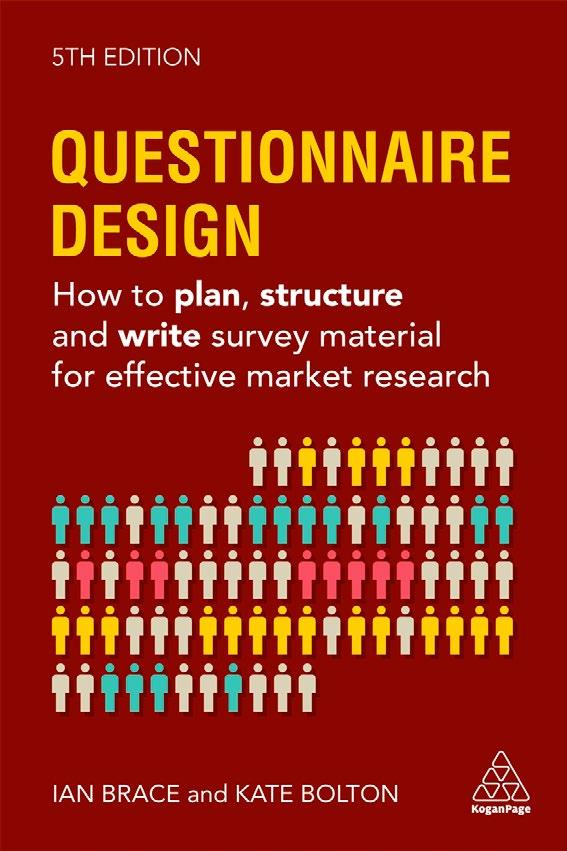
• Delivers an accessible guide to aid the process of writing a questionnaire with easy navigation to key points
• Addresses the modern-day challenges facing questionnaires such as the pressure to be shorter and smarter than ever
• New to this edition: advances in behavioural science and more in-depth review of neuroscience approaches in questionnaires, a 'mobile-first' focus in the text and inclusions of clear and quick reference summaries at the end of each chapter
Will your questionnaire work as well as it needs to by today's standards? Use this new edition of the bestselling guide to make sure it does.
Good data is central to information-based decision making. Increasing access to online survey software is allowing more organizations to benefit from contact with their customers, employees and the public. However, the challenges facing the questionnaire writer remain and the greater volume of surveys and demands on potential respondents' time is making the task even harder. Your questionnaire needs to work better than ever to keep their attention. Questionnaire Design provides comprehensive and practical guidelines to plan, structure and compose questionnaires across all industries and purposes, ensuring valuable data insights are captured with accuracy and efficiency.
You can't write a good questionnaire unless you know exactly what you are trying to achieve. This updated fifth edition recognizes this fundamental challenge, with advice for gaining the clarity needed to plan and focus your questionnaire. It continues to provide guidance for those using interviewer administered surveys, but now reflects the primacy of online and the challenges that brings. With pressure on everyone's time, this revised edition makes it even easier to navigate to the key points with new bullet-pointed takeaways at the end of each chapter.
Ian Brace, based in Oxford, UK, is a fellow of the MRS and runs training courses on questionnaire design. He was previously director of research methods at TNS UK and a visiting professor in market research at Bristol Business School.
Kate Bolton, based in Surrey, UK, is a certified member of the MRS and has been its key industry trainer for questionnaire design for over 20 years as well as being an examiner for the MRS Advanced Certificate. She previously led the Foundations Research Skills Programmes at Kantar.
Edition: 5
Date: 05/28/2022
Price: $39.95
Paperback: 9781398604124
Ebook: 9781398604131
Pages: 368
Format (mm): 234x156
Band: Professional/ Academic
Subject: Market Research
Introduction
1 Defining achievable questionnaire objectives
2 Influence of data collection approach on question design
3 Planning a questionnaire
4 An overview of question types
5 Identifying types of data created by questions
6 Creating appropriate rating scales
7 Asking about behaviour
8 Measuring satisfaction, image and attitudes
9 Writing effective questions
10 Creating a questionnaire for an online survey
11 Engaging respondents in online surveys
12 Choosing online survey software
13 Considerations for intervieweradministered and paper self-completion surveys
14 Test piloting your questionnaire
15 Ethical issues in questionnaire design
16 Understanding social desirability bias
17 Designing questionnaires for multicountry surveys
This book
• Benefit from in-depth knowledge from one of the UK's leading UX research professionals
• Features tools and frameworks that readers can refer to when conducting their own user research
• New to this edition: new chapter on research operations and infrastructure, further analysis on combining user research methodologies and combined new research plan and strategy templates
User experience research, also known as UX research, focuses on understanding user behaviours, needs and motivations through a range of observational techniques, task analysis and other methodologies. User Research is a practical guide that shows readers how to use the vast array of user research methods available. Written by one of the UK's leading UX research professionals, readers can benefit from in-depth knowledge that explores the fundamentals of user research.

Covering all the key research methods including face-to-face user testing, card sorting, surveys, A/B testing and many more, the book gives expert insight into the nuances, advantages and disadvantages of each, while also providing guidance on how to interpret, analyze and share the data once it has been obtained. Now in its second edition, User Research provides a new chapter on research operations and infrastructure as well as new material on combining user research methodologies.
Author Information
Edition: 2
Date: 02/28/2022
Price: $39.95
Paperback: 9781398603578
Ebook: 9781398603585
Pages: 344
Format (mm): 235x155
Band: Professional/ Academic
Subject: Market Research
• Shows readers how to create intrinsic engagement through gamification, and use this engagement to glean more meaningful consumer insights
• Provides insight into the contexts in which gamification can be used, and the specifics of designing and making games for research purposes
• Written by one of the UK's leading designers of Research Games, Betty Adamou, who has been named one of seven women shaping the future of market research
Games are the most engaging medium of all time: they harness storytelling and heuristics, drive emotion and push the evolution of technology in a way that no other platform has or can.
It's no surprise, then, that games and gamification are revolutionizing the market research industry, offering opportunities to reinvigorate the notoriously sluggish engagement levels seen in traditional surveying methods. This not only improves data quality, but offers untapped insights unattainable through traditional methods. Games and Gamification in Market Research shows readers how to design ResearchGames and Gamified Surveys that will intrinsically engage participants and how best to use these methodologies to become, and stay, commercially competitive.
In a world where brands and organizations are increasingly interested in the feelings and contexts that drive consumer choices, Games and Gamification in Market Research gives readers the skills to use the components in games to encourage play and observe consumer behaviours via simulations for predictive modelling.
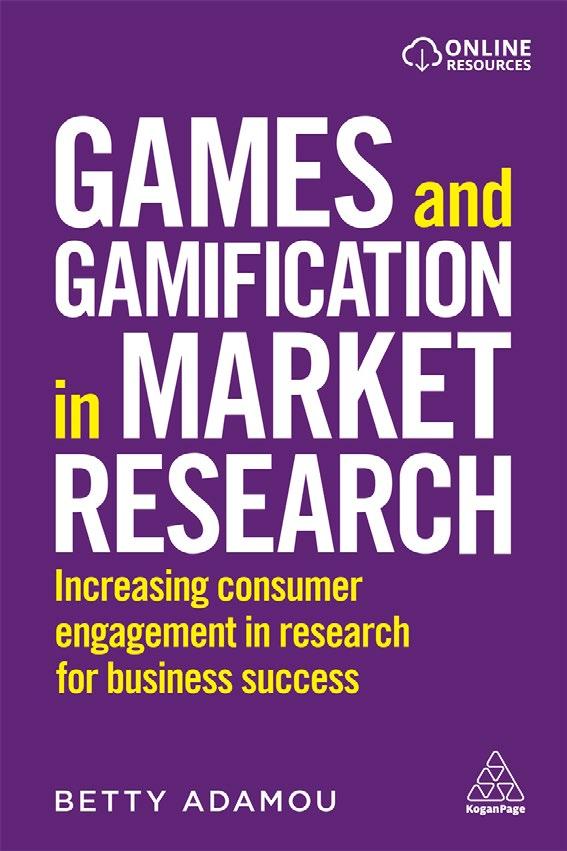
Written by Betty Adamou, the UK's leading research game designer and named as one of seven women shaping the future of market research, it explains the ways in which these methodologies will evolve with technologies such as virtual reality and artificial intelligence, and how it will shape research careers. Alongside a companion website, this book provides a fully immersive and fascinating overview of game-based research.
Betty Adamou is the Founder and Chief ResearchGame Designer at Research Through Gaming. In addition to developing ResearchGames on behalf of Fortune 500 companies and academic institutions alike, Adamou also guest lectures, writes about and gives keynote presentations and talks on Game-Based Research Methods. Adamou has won multiple awards for her work in entrepreneurship and innovation in market research.
Edition: 1
Date: 11/28/2018
Price: $44.99
Paperback: 9780749483357
Ebook: 9780749483364
Pages: 360
Format (mm): 234x156
Band: Professional
Subject: Market Research
• Reveals and explains the latest branding techniques used by companies worldwide
• Includes expert advice on best practice for adding culture and content into brands
• Enables students and practitioners to stay up to date with targeting, adding recent research and market knowledge to the discipline
• Contains a section on brand valuation which illuminates the complex strategies behind how brands are ranked in the media
Adopted internationally by business schools and MBA programmes, this book is the ultimate resource for senior strategists, positioning professionals and postgraduate students to understand and overcome the challenges of brand management and strategy today, written by the leading international expert of branding, Jean-Noël Kapferer.

The New Strategic Brand Management is simply the reference source for branding professionals and postgraduate students. Over the years it has not only established a reputation as one of the leading works on brand strategy, but also has become synonymous with the topic itself.
Using an array of international case studies, this book covers all the leading issues faced by brand strategists today, with both gravitas and intelligent insight. It reveals new thinking on topics such as putting culture and content into brands, the impact of private labels and the comeback of local brands.
This updated fifth edition builds on the book's already impressive reputation, including new content that will help students and practitioners stay up to date with targeting, with relevant research and market knowledge to support the discipline.
With dedicated sections for specific types of brands (luxury, corporate and retail), international examples and case studies from companies such as Audi, Nivea, Toyota and Absolut Vodka; plus models and frameworks such as the Brand Identity Prism; The New Strategic Brand Management remains at the forefront of strategic brand thinking.
Jean-Noël Kapferer is one of the world's foremost thought leaders on luxury brands. An active researcher, he is an HEC Paris graduate and holds a PhD from Northwestern University's Kellogg Business School. Kapferer is author of Kapferer on Luxury and co-author of The Luxury Strategy (both published by Kogan Page). He is a sought after speaker, leading seminars on luxury worldwide at institutions including HEC Paris, Tsing Hua University Beijing, Seoul Luxury Business Institute and LBI Shanghai. He is also advisor to the president of Inseec Business School (Paris).
Edition: 5
Date: 01/28/2012
Price: $69.99
Paperback: 9780749465155
Ebook: 9780749465162
Pages: 512
Format (mm): 250x190
Band: Textbook
Subject: Branding
Introduction - Building the Brand when the Clients Are Empowered
1 Why is Branding So Strategic?
1 Brand Equity in Question
2 Strategic Implications of Branding
3 Brand and Business Models
4 Brand Diversity - How Specific Are Different Sectors?
5 Managing Retail Brands
2 The Challenges of Modern Markets
6 The New Brand Management
7 Brand Identity and Positioning
3 Creating and Sustaining Brand Equity
8 Launching the Brand
9 Growing the Brand
10 Sustaining a Brand Long Term
11 Brand and Products - Identity and Change
12 Growth Through Brand Extensions
13 Brand Architecture
14 Multi-Brand Portfolios
15 Handling Name Changes and Brand Transfers
16 Brand Turnaround and Rejuvenation
17 Managing Global Brands
4 Brand Valuation
18 Financial Valuation and Accounting for Brands
• Covers a range of popular and novel branding concepts and perspectives to offer a comprehensive and multi-dimensional approach to branding
• Examines cutting-edge topics such as managing brand crisis, digital brand analytics, as well as sensory branding and neuromarketing
• Contains case studies from international brands including Uber, Guinness, Li-Ning, Arm & Hammer, Balenciaga and Netflix
• Supported by pedagogical features which include learning outcomes, 'in practice' boxes, key concepts and discussion questions
• Online resources: lecture slides for each chapter and an instructors' manual with further case studies and exercises
How are brands created? How can their value be measured? Explore these areas and more with this clear and concise brand management textbook.

Brand Management combines practical and real-life applications with a range of perspectives and research insights into the theoretical, societal and socio-cultural contexts to cover all the key aspects of brand management. Exploring areas such as the key definitions and elements of branding, brand loyalty and positioning and brand communication, it offers an easy-to-follow operationalized focus on areas such as measuring brand equity, co-branding and brand architecture.
Featuring case studies and examples from Uber, Guinness, Li-Ning, Arm & Hammer, Balenciaga and Netflix, Brand Management also examines new and emerging topics including managing brand crisis, brands' responsibilities and digital brand analytics. It is supported by a range of features such as learning outcomes, 'in practice' boxes, key concepts and discussion questions and online resources consisting of lecture slides, video links and an instructors' manual containing further case studies and exercises.
This is an indispensable textbook for undergraduate and postgraduate students of brand management.
Jaywant Singh is Professor of Marketing and Head of Research at the Department of Digital and Data Driven Marketing at Southampton Business School, University of Southampton, UK. His research is in the areas of branding and consumer behaviour.
Paurav Shukla is Professor of Marketing and Head of Digital and Data Driven Marketing Department at the Southampton Business School, University of Southampton, UK. His research interests include luxury branding and marketing, cross-cultural consumer behaviour, and international marketing.
Edition: 1
Date: 05/28/2024
Price: $41.99
Paperback: 9781398611580
Ebook: 9781398611597
Pages: 336
Format (mm): 240x170
Band: Textbook
Subject: Branding
1 Introduction – the foundations of brand management
1 What is a brand? Key concepts and definitions
2 The evolution of branding
3 Research streams in branding
2 Building brands - principles and applications
4 Key elements of a brand
5 Brand loyalty and brand equity
6 Brand positioning
7 Brand communication
8 Brand engagement
9 Brand extension
10 Brand alliances and cobranding
11 Brand architecture and corporate branding
3 Managing contemporary brands
12 Managing negative brand events and crisis
13 Luxury branding
14 Sensory branding and neuromarketing
15 Social media branding and digital brand analytics
16 Global and cross-cultural branding
17 Brands and societal responsibility
• Introduces effective strategies and tools for starting or scaling a fashion brand
• Explains key business models such as Porter's Five Forces, Generic Strategy and Diamond; Kapferer's Brand Identity Prism; The Fashion Cycle; Design Thinking; Business Model Canvas; Sinek's Golden Circle; Greiner Growth Strategy
• Helps readers understand financial management and business planning and advises on how to raise money
• Assesses the impact of digital shifts and the impact of new technology including NFTs, AR, VR and AI
• Evaluates the impact of digital collections, gamification, product placement, omnichannel, the drop model and see-now buy-now
• Online resources: lecture slides, self-test questions, group activities, worksheets and additional interactive case studies
Learn how to develop, launch and build a successful fashion brand with this definitive textbook which explores the realities of the contemporary fashion industry.
Fashion Brand Management is a complete guide to operating a fashion business in a multi-trillion revenue industry. Written by a leading innovator in the space, it describes how to gain competitive advantage, meaningfully embrace sustainability and purpose and successfully market to and engage consumers. Balancing theory with practical applications throughout, it also explores the key business models and financial management processes used in the industry and how fashion brands can build entrepreneurial advantage.

Exploring the key challenges and opportunities for today's fashion businesses both large and small, Fashion Brand Management examines supply chain disruption, social selling and technological innovations including the metaverse, digital collections and blockchain. Featuring case studies from a range of innovative global brands including Ecoalf, MWHQ, Pala Eyewear and Unhidden, in-text features include learning objectives, key terms and activities. With supporting online resources consisting of lecture slides, self-test questions, group activities and worksheets, this is an essential resource for fashion students.
Alison Lowe is a leading expert on fashion brand development and growth. Based in London, UK, she founded and leads a fashion incubator agency and an online support platform, Start Your Own Fashion Label. She develops and teaches courses at the London College of Fashion, University of East London, University of the Arts London and Emlyon Business School. A regular international conference speaker, she also consults for brands across the globe, is a judge for the Great British Entrepreneur Awards and has been awarded an MBE for Services to the Fashion Industry.
Edition: 1
Date: 02/28/2023
Price: $41.99
Paperback: 9781398609006
Ebook: 9781398609013
Pages: 320
Format (mm): 240x170
Band: Textbook
Subject: Branding
1 Putting the customer first
2 Competitive advantage
3 Purpose, planet, people
4 Business foundations for fashion brands
5 Product design and development
6 Supply chain management
7 Brand storytelling and management
8 Innovation and technology
9 Driving sales
10 Marketing and promotion
11 Finance
12 Future entrepreneurial advantage for fashion brands
13 Glossary
This book
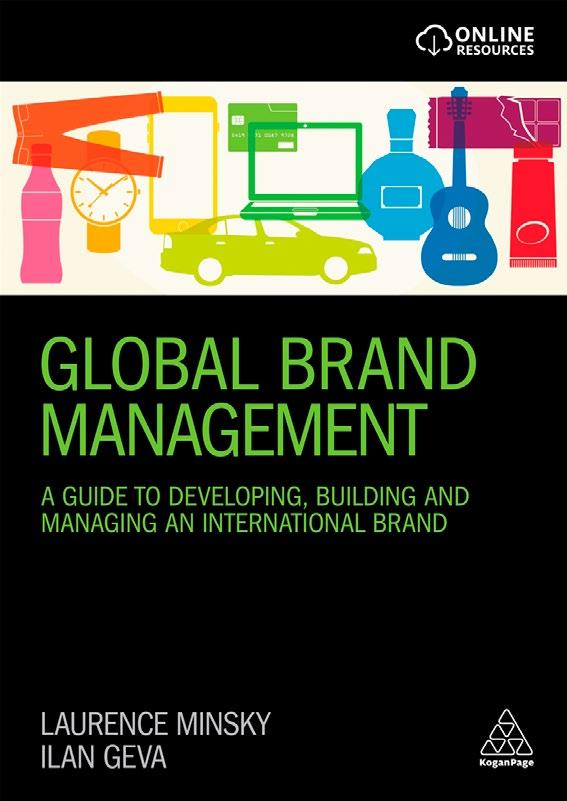
• Features perspectives from world class practitioners to demonstrate the crucial importance of global brands effectively adapting to different languages, cultural values and commerce laws
• Demonstrates the essential role that flex and elasticity play in enabling a brand to maintain a distinct and unified identity across global borders
• Includes detailed case studies from Oreo, McDonalds, Harley Davidson, Tropicana and Xiaomi, and guest contributions from a range of international entrepreneurs, strategists and marketers
• Online Resources: Chapter PowerPoints, chapter summaries, test banks, sample syllabus
• Features a foreword by Mark Tungate: Editorial Director of the Epica awards, and author of multiple books on branding published by Kogan Page
Edition: 1
Date: 11/28/2019
Price: $55.99
Paperback: 9780749483609
Ebook: 9780749483616
Pages: 328
Format (mm): 240x167
Band: Textbook
Subject: Branding
1 A definition of brands and branding
2 The strategic role branding plays
3 Internal branding vs. external branding
4 MarTech, Programmatic, and more technological innovations
2 Practical and tactical applications
5 Brand foundational development
6 Brand actualization
7 Branding and the marketing communication ecosystem
8 Brand management
3 Branding issues and opportunities
9 Branding in a global economy
10 Brand architecture
11 Speciality application areas
12 Digital asset management (of branding elements)

• Provides the necessary tools to create more informed marketing strategies, enabling brands to thrive in foreign markets
• Delivers a proven, repeatable methodology that can be adapted to any product, industry or region
• Helps organizations engage more effectively with buyers in the foreign market, and seize market opportunities promptly
• Contains clear, practical tips to recognize and avoid the most common pitfalls when entering new markets
• Helps readers understand the dynamic of product, price and value from a foreign market's perspective
In theory, the Internet allows all brands to market internationally. But in practice, most companies struggle to compete outside their home market. Written from a marketing practitioner's perspective, International Brand Strategy evens the playing field with clear, actionable techniques to guide any organization going through the process. This book helps companies build sales in foreign markets, but just as important it helps them thrive by maintaining price integrity and building brand equity at the same time.
With the guidance provided in International Brand Strategy companies hit the ground running in foreign markets. This provides a competitive advantage from day one, empowers companies to avoid costly mistakes, and saves months of trial and error. The book lays out a unique methodology for managing brands abroad that can be implemented for any product in any market. These methods have proven their value for companies large and small across six continents. The book guides readers with pragmatic models and a wealth of examples from global companies such as Target Canada, Unilever and Apple.
International Brand Strategy was written for those who are planning to enter a new market and for those who are already there but wish to improve their brand's performance. It helps the reader recognize some of the most common pitfalls and how to avoid them, provides practical tips to understand the dynamics of price, product and value from a foreign buyer's perspective, and defines a conceptual framework to assess and improve brand equity at home and abroad.
Sean Duffy is founder and CEO of Duffy Agency, based in Boston MA, USA and Malmö, Sweden. He is Adjunct Professor in International Strategic Marketing at Lund University School of Economics & Management, Sweden and contributes to its Masters Programme in Entrepreneurship. He has served two terms as European Governor of TAAN Worldwide, and was previously creative director with MullenLowe Group / IPG, Sweden.
Edition: 1
Date: 01/28/2021
Price: $39.95
Paperback: 9781789666298
Ebook: 9781789666304
Pages: 272
Format (mm): 233x156
Band: Professional/ Academic
Subject: Branding
1 Preparation
1 Why brands fail abroad
2 The business case for entering a foreign market
3 Choosing the right market
4 The difference between domestic and international brand building
5 Defining an approach to international markets
6 Preparing the brand for travel
2 The new market
7 Understanding the mechanics of building brand equity abroad
8 Setting realistic expectations
9 Dealing with language
10 Assembling the right team
11 Segmenting the market and targeting
12 Understanding local buyers in foreign markets
13 Understanding local competitors from the buyer’s POV
14 Seeing your product from the local buyer’s POV
15 Seeing your product’s price from the local buyer’s POV
16 Seeing your brand’s value from the local buyer’s POV
17 Creating an international web presence
18 Responding to the market
3 Get moving
19 Engaging company leadership
20 A different type of management
21 The renewed importance of vision and mission
22 Distinguish between marketing and sales
23 Defining success
24 Evaluating risk
4 Conclusion
• Provides practical tools to deliver digital branding success, such as a checklist covering the entire process, and measurement devices for multiple channels and purposes
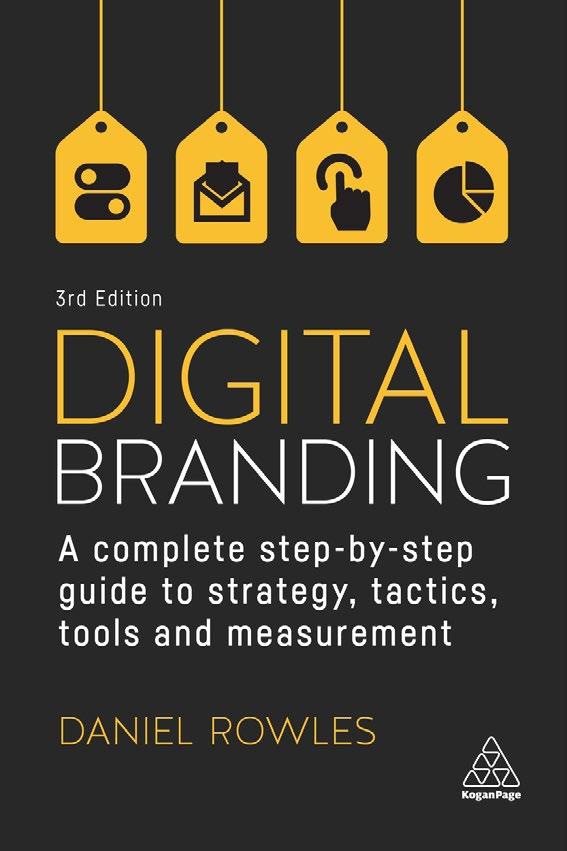
• Illustrates how popular and established brands use digital branding to create lasting and memorable digital marketing campaigns
• Written by a respected CIM fellow, course leader and industry thought leader, who has over 20 years of digital marketing experience on both client and agency sides
• New to this edition: a closer study of brand authenticity and ethics along with fresh case studies, updates on social media regulations and overviews of new social media platforms such as TikTok
Every decision and action you make contributes to your brand, so it makes sense that everything you do digitally also contributes to your digital brand. Use this bestselling guide to strengthen your brand's online presence and explore core marketing avenues.
Digital Branding is ideal for marketers and brand strategists who want to enhance their brand's online presence. It provides step-by-step, practical guidance on how to build a brand online and quantify it through tangible results. Written by a respected Chartered Institute of Marketing (CIM) fellow, course leader and industry thought leader, it examines core marketing areas such as content marketing, social media, search engine optimization and web analytics.
The book delivers a robust framework for planning, brand identity, channel selection and measuring the effectiveness of campaigns, and includes lessons from the BBC, Imperial College London and Hootsuite. Now fully updated, this third edition features new content on brand authenticity, ethics and meaning, as well as updates on social media regulations and social media platforms such as TikTok.
Daniel Rowles, based in Jersey, has more than 25 years of digital marketing experience on both client and agency sides. He is a CIM fellow and course director and the lead judge for the CIM Marketing Excellence Awards. Rowles also lectures at Imperial College London and Cranfield School of Management and co-hosts the Digital Marketing Podcast, a global top-10 business podcast on iTunes. His digital marketing company, TargetInternet.com, supports clients such as the BBC, Vodafone, Sony, Oracle and Tesco. He is also the author of Building Digital Culture, Mobile Marketing and Podcasting Marketing Strategy, also published by Kogan Page.
Edition: 3
Date: 01/28/2022
Price: $29.95
Paperback: 9781398603189
Ebook: 9781398603196
Pages: 232
Format (mm): 235x155
Band: Professional/ Academic
Subject: Branding
Introduction
1 Digital branding in perspective
1 What digital branding really means
2 Focusing on value
3 Considering the user journey
4 Objectives and authenticity
2 The digital toolkit
5 Social media
6 Search
7 Mobile
8 Online advertising
9 Email marketing
10 CRM and marketing automation
11 From integration to transmedia campaigns
3 Digital brand strategy and measurement
12 Measuring digital branding
13 Primaries and indicators
14 The role of analytics
15 Bridging the gaps
16 The importance of asking questions
17 Conclusion
• Shows how to tap into authentic brand loyalty and human connection by aligning brand voice with individual customer values, experiences and aspirations
• Demonstrates how to leverage brand storytelling into the marketing mix to strengthen brand engagement and achieve long-term growth
• Builds on cutting edge interviews and case studies with leading storytellers from different industries such as Expedia, McDonalds, Adobe, Coca Cola and Google
• New to this edition: Inclusion of new trends in storytelling, future of brand storytelling as well as a brand new 'How to Guide'
Written by the award-winning storyteller Miri Rodriguez at Microsoft, this bestselling book gets back to the heart of brand loyalty, consumer behavior and engagement as a business strategy by using storytelling to trigger the emotions that humans are driven by.
Despite understanding essential storytelling techniques, brands continue to explain how their product or service can help the customer, rather than showcasing how the customer's life has changed as a result of them. This second edition of Brand Storytelling contains new trends in storytelling, as well as expanding on story experience and employee experience. This book explores the future of brand storytelling in a post pandemic era. New to this edition is also a 'How to Guide' taking readers through each step of the design thinking process in order to prototype their stories.
Brand Storytelling provides a step-by-step guide to assess, dismantle and rebuild a brand story, shifting the brand from a 'hero' to 'sidekick' mentality and positioning the customer as a key influencer to motivate the audience. Clarifying why machine-learning, AI and automation only tell one side of the story, this book will inspire you with cutting edge interviews and case studies from leading brands like Expedia, Coca Cola, McDonalds, Adobe and Google to tap into authentic brand loyalty and human connection.
Miri Rodriguez, based in Pompano Beach, Florida, is an award-winning, globally recognized storyteller and Senior Storyteller for Future of Work at Microsoft. She is a creative journalist, content strategist and a renowned keynote speaker and international thought leader in brand storytelling, personal branding and youth entrepreneurship. She has earned several awards in digital marketing and customer experience and is ranked as a top in-demand speaker at leading industry conferences globally. Her previous clients include Adobe, Discover, Walmart and McKesson.
Edition: 2
Date: 07/28/2023
Price: $25.99
Paperback: 9781398610088
Ebook: 9781398610095
Pages: 256
Format (mm): 15x160
Band: Professional
Subject: Branding
1 Brand storytelling: what is it?
2 Where do I start? Introduction to Design Thinking
3 The magic and magic tricks in story’
4 IMC reimagined: building an integrated marketing plan with story
5 The brand story hero: putting your customer at the heart of your brand story
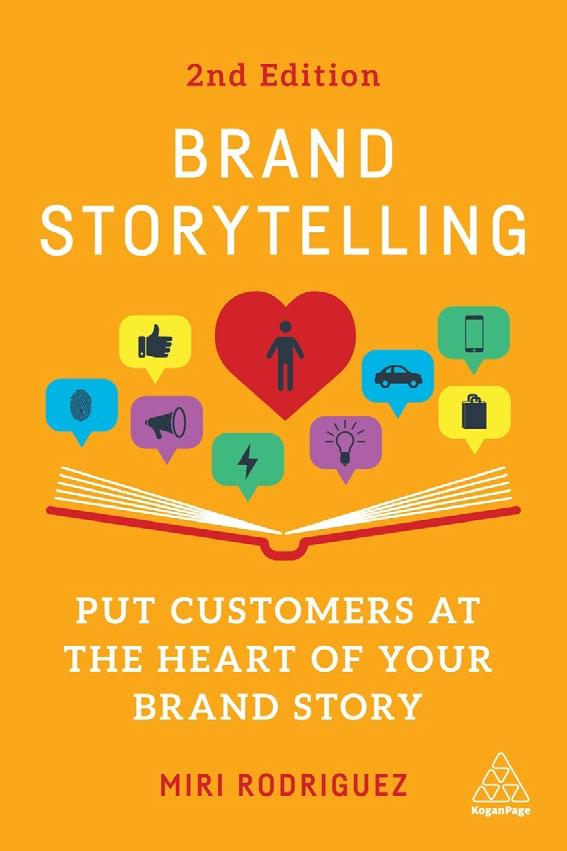
6 Chapter - 06: If story is magic, vulnerability is the magic wand
7 Ethics in storytelling: when to use your secret weapons
8 Immersive storytelling: exploring the story experience
9 Your best brand storytellers in the digital age: employees and influencers
10 Marketing (actually, testing) your brand story
11 Benchmarking your brand story
12 The future of brand storytelling: how AI, machine learning and automation can only tell one side of the story
13 Villains and antagonists: The bad guys who want to tear down your brand story
14 Inspire your brand story: interviews with leading storytellers around the world
15 The Storytelling Workbook: Your step-bystep guide to designing brand stories
• Breaks brand strategy into three meaningful steps: identity, intention and implementation
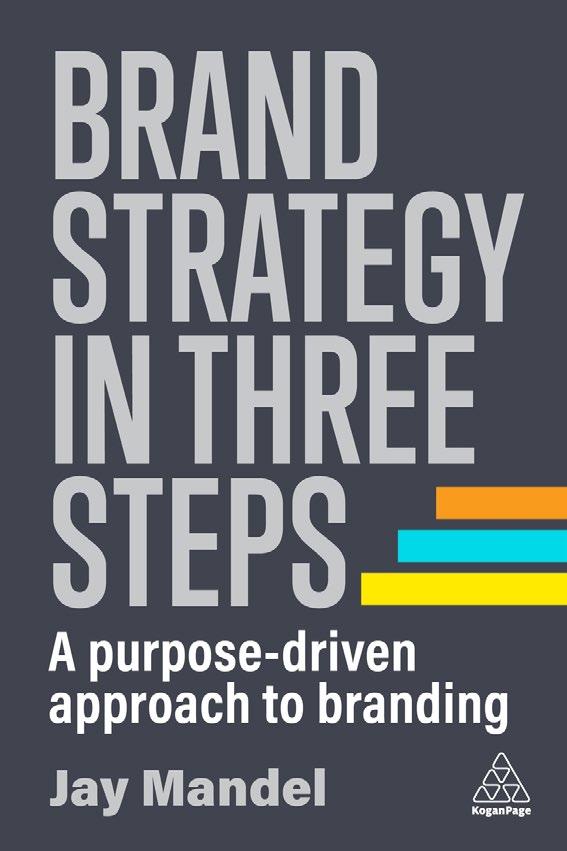
• Helps brand strategists align their purpose with their goals to create meaningful messaging that will leave a lasting impact on customers
• Includes examples of effective brand strategies from top brands including Mastercard, Apple, Warby Parker and Sweetgreen
• Walks readers through cultivating a valuesdriven brand identity, creating an actionable branding plan and implementing the resulting strategy
Learn how to create an authentic and consistent brand strategy by focusing on the values of your company. This book breaks this process into three steps focused on brand identity, setting intentions and implementing the resulting strategy.
To consistently appeal to consumers, a brand needs to implement a strong strategy that delivers a memorable experience. There are two other essential stages of this process, and the companies who skip over these risk seeming out of touch and inauthentic. In Brand Strategy in Three Steps, branding coach Jay Mandel takes readers through an innovative and efficient three-step approach to brand strategy centered on identity, intention and implementation.
Brand Strategy in Three Steps highlights the importance of communicating value to consumers through meaningful interactions. Jay Mandel walks readers through the best branding strategies for new companies and established ones looking to revamp their approach, providing thoughtful exercises to help readers map a living brand document. The book helps readers through the three essential steps of brand strategy: identifying their core values as a company, determining how this relates to the product or service and tying these together when rolling out the strategy. Readers will gain the practical insight necessary to launch a successful, purposeful brand strategy and go-to-market plan.
Jay Mandel is the founder of Your Brand Coach, a brand management company based in New York City, New York. He served as Director of Marketing at IBM, Vice President of Global Digital Marketing at Mastercard and Digital Marketing Manager at CIT. A corporate trainer for the Association of National Advertisers, he is part of the marketing faculty at Sacred Heart University and serves as an adjunct professor of marketing at Fordham University and the Fashion Institute of Technology.
Edition: 1
Date: 06/28/2023
Price: $29.99
Paperback: 9781398609792
Ebook: 9781398609808
Pages: 256
Format (mm): 235x158
Band: Professional
Subject: Branding
Introduction
1 Identity
1 Brand identity
2 Identifying your goals and core values
2 Intention
3 Setting intentions
4 Cultivating brand purpose
5 Creating an actionable strategy
6 Setting intentional goals
3 Implementation
7 Creating an actionable plan
8 Executing a successful branding strategy
9 Conclusion
• Explains why the quest for incremental advantages by mainstream brands will hold back market-beating growth

• Identifies why brand managers and product development teams need to seek out the quirky and the odd
• Demonstrates the principles and ways of working that need to be applied if brands are to develop new entrepreneurial products, learned from the margins
• Features case studies from brands operating at the margins and those organizations that have leveraged the margins such as Knorr and Peroni
Legacy brands are struggling. The hand-to-hand combat for advantage has become a zero-sum game - producing small share gains and losses but nothing to bring about sensational new growth.
This book shows why businesses, marketers and entrepreneurs need to break free from their 'mainstream inhibition' and turn their attention to the margins - to confront, evaluate and embrace the 'strangeness' of behaviours, ideas and ways of life at the fringes.
Why? Because marginal behaviours can break through and take off. They can go mainstream. They can unleash 'consumer-driven disruption', promoting new innovation, new routes to market, new winners and losers - and new growth.
Using original research and analysis of the brands that have successfully backed marginal behaviours, From Marginal to Mainstream provides a framework for understanding and evaluating this non-obvious, untapped potential.
Marginal behaviours may be unpromising, untested, weird, even sometimes repulsive - yet they can point the way to the future.
Today's margins are tomorrow's pot of gold - if you know where and how to look.
Dr Helen Edwards straddles the business and academic worlds of marketing through teaching, writing and consultancy. She is an award-winning columnist at Marketing Week, an adjunct associate Professor of Marketing at London Business School, and sits on the board of the UK Effies. She is also the author of Creating Passion Brands, published by Kogan Page and is based in London, UK.
Edition: 1
Date: 02/28/2023
Price: $27.99
Paperback: 9781398604315
Ebook: 9781398604322
Pages: 264
Format (mm): 233x156
Band: Professional
Subject: Branding
Introduction
1 The margins and why they matter
1 From ‘Does anyone do that?’ to ‘Doesn’t everyone do that?’
2 Why modern mainstream marketing is a low-growth zone
3 Going for growth - Why the margins? And why now?
2 How to read the margins
4 Overview
5 A smouldering fire in the fringes - The elemental beacons
6 What’s hidden, what’s there and what could be - The revelatory beacons
7 Shakers of place and pace - The opportunity beacons
8 An irresistible momentum - The growth beacons
3 A strategy for growth
9 Overview
10 Entrepreneurs get it – They are marginals too
11 Growth from the margins - A marketer’s playbook
12 The M2M advantage - Seven things every leader should know
• Combines an academic perspective with practical insights gained from the authors' extensive industry experience of working on a variety of events
• Explores a diverse range of case studies such as The 2022 Commonwealth Games, Expo 2020 Dubai and The American Heart Association (AHA) conferences
• New to this edition: Renewed focus on virtual and hybrid events, expansion of health and safety advisory in light of COVID-19 and anti-terrorism, as well as new models such as the Cultural Risk Assessment and new case studies
• Online resources: activity sheets, group activities, lecturer slides, self-tests questions, case studies and web links
Learn how to plan, deliver and evaluate successful events with this clear and comprehensive textbook which explores the latest developments in this challenging and fast-paced environment.

Written by authors with extensive industry experience of working on a wide spectrum of events, this is an essential step-by-step resource for students and the next generation of event planners. Offering a well-rounded approach which introduces key models and theories as well as practical real-life insights throughout, Event Planning and Management offers a structured formula for all types of events, from their initial planning to final evaluation.
Without assuming prior subject knowledge or experience, this fully updated third edition of Event Planning and Management provides a renewed focus on virtual and hybrid events, which is lacking from many other texts. Featuring real-world examples including The 2022 Commonwealth Games, Expo 2020 Dubai and The American Heart Association (AHA) conferences, accompanying online resources include lecture slides, activities, self-test questions and web links. This is an indispensable resource for students studying eventsrelated modules, as well as early-stage practitioners and aspiring events managers.
Ruth Dowson was Senior Lecturer in events management at the UK Centre for Events Management at Leeds Beckett University, UK for over 14 years. She has more than 30 years of experience in strategic development, management and delivery of events, conferences, seminars and exhibitions, in both the public and private sectors.
Bernadette Albert is Senior Lecturer at Leeds Beckett University, UK, where she leads the undergraduate programme in Event Management. She draws on extensive experience in managing and advising on international, state, civic and private events.
Dan Lomax is Senior Lecturer at Leeds Beckett University, UK. He has 25 years' experience in the live music and cultural events sector specializing in content creation, event planning and operational delivery.
Edition: 3
Date: 12/28/2022
Price: $49.99
Paperback: 9781398607101
Ebook: 9781398607118
Pages: 360
Format (mm): 230x153
Band: Textbook
Subject: Event Management
1 Events – the changing environment 1
2 The event planning model
3 Research, concept development and feasibility screening
4 Developing your events programme and content
5 Venue selection and site planning essentials
6 Production and operational logistics
7 Staffing and human resources in events
8 Drawing in the crowds – marketing events
9 Finance, budgeting and procurement in events
10 A practical guide to managing an event on the day
11 Measuring event success – evaluation insights
12 Events – the future
• Introduces the subjects of event sponsorship, fundraising, partnerships and relationship development, in the context of the Integrated Marketing Communications Mix, allowing readers to see the role they play in overall events management
• Includes discussion questions and recommended reading sections, with each chapter structured around specified learning outcomes
• Reveals fascinating discussion on the future of fundraising and sponsorship, including burgeoning developments such as crowdfunding
• Online resources: Comprehensive set of downloadable teaching aids
Securing sponsorship and other sources of funding for events is becoming increasingly competitive, making differentiation and delivery vital. Event Sponsorship and Fundraising explores this complex area of event management, drawing on both experiential marketing and consumer behaviour theories, and developing critical insights on the dynamics of successful event sponsorship. Its coverage includes professional guidance on prospecting for sponsors, brand activation and evaluation, as well as advice on relationship management, proposal writing and pitching to potential sponsors.

Event Sponsorship and Fundraising places each of these concepts at the heart of the Integrated Marketing Communications Mix, alongside cutting edge literature on the topic. Written by two highly experienced industry practitioners, both of which now teach on two of the UK's leading event management degree courses, and supported by a comprehensive set of online resources, this book is an invaluable go-to resource for event management students, tutors and professionals alike.
Tom Lunt is the Programme Leader for International Events Management at the University of Surrey. He is former senior lecturer at London Metropolitan University and spent nine years working in fundraising events with organizations such as Christian Aid and the Royal Star & Garter Home for disabled servicemen and women.
Eva Nicotra is Senior Lecturer at London Metropolitan University, teaching event planning, events marketing and sponsorship, and live music events promotion. She is an accomplished events and music industry professional and previously ran her own events management company for live events, charity fundraisers, concerts and festivals.
Edition: 1
Date: 11/28/2018
Price: $51.99
Paperback: 9780749480929
Ebook: 9780749480936
Pages: 288
Format (mm): 240x170
Band: Textbook
Subject: Event Management
1 Introduction to event sponsorship, fundraising, partnerships and relationship development
2 Event sponsorship at the centre of the integrated marketing communications mix
3 Delivering event sponsorship campaigns
4 Identifying and securing sponsors and funding opportunities
5 Prospecting for grant funding and sponsorship: case studies from Scottish cycling events
6 Preparing and delivering a sponsorship pitch
7 Managing relationships with sponsors and funding bodies
8 Legal issues in event sponsorship and fundraising
9 Evaluating sponsorship and grantmaking relationships
10 Where next for event sponsorship and fundraising?
11 Practical templates to kick-start your event sponsorship and fundraising
12 Afterword – building your career in sponsorship and fundraising
• Covers all aspects of planning and managing campaigns in a structured way, from research and analysis, to objectives, strategy and tactics, timescales, resources, evaluation and review
• Features best-practice examples from organizations including Procter & Gamble, Co-op, McDonalds and the UK Government
• New to this edition: material on the latest developments such as online influencers, the role of big data in stakeholder identification and disruptive models
• Online resources: extended case studies, lecture slides, discussion questions and assessment tasks
Taking a PR campaign from planning to implementation can seem overwhelming. This book provides a blueprint for success and is widely regarded as one of the best 'how-to' guides available.
Digestible and easy to read, this fifth edition of Planning and Managing Public Relations Campaigns presents a 12-point plan for ensuring success of campaigns of all sizes, covering vital areas including the role of public relations in organizations, the importance of context, research and analysis, setting objectives, strategy and tactics, timescales and resources, evaluation and review.

With discussion of new developments in the industry, from the gig economy and online influencers, to disruptive models, this fully updated new edition addresses the need for agile planning and draws on fresh case studies to provide up-to-date examples of best practice. Supported by a suite of online resources, Planning and Managing Public Relations Campaigns is an invaluable guide for students and practitioners alike. Online resources include extended case studies, lecture slides, discussion questions and assessment tasks.
Dr Anne Gregory is a professor of corporate communication and leading international academic. She is based in the School of Business and Law at the University of Huddersfield, and previously spent many years in public relations practice with senior experience both in-house and in consultancy. She remains a consultant and an advisor at board level to several large organizations.
Edition: 5
Date: 12/28/2020
Price: $39.95
Paperback: 9781789663204
Ebook: 9781789663211
Pages: 352
Format (mm): 235x158
Band: Textbook/ Professional
Subject: Public Relations
1 Planning and managing – The context
2 Public relations in context
3 Starting the planning process
4 Research and analysis
5 Communication theory and setting aims and objectives
6 Knowing the public and messages
7 Strategy and tactics
8 Timescales and resources
9 Knowing what has been achieved –Evaluation and review
• Demonstrates that an individual's sense of morality has an impact on decision making and ethical business behaviour, and helps managers account for this in business practice
• Helps practitioners understand and react to ethical consequences in the face of fastmoving technological advances
• Explores the concept of personal ethics spilling into the professional realm in relation to topical issues such as sexual harassment and social media
• Relates underlying ethical issues such as utilitarianism and moral relativism to everyday issues
The weight of social responsibility in public relations (PR) has never been more pronounced. Ensure the professionalism and credibility of your business using the practical tips and guidance in this book, written by a leading academic in the field and recommended for PR students and practitioners alike.
Ethical practice in any professional discipline is guided by age-old philosophical perspectives, but its modern parameters are continually evolving. Ongoing developments in technology, social media and social contexts mean that public relations and its practices are constantly changing, and so do the ethical questions faced by practitioners in the field.
Face the ethical questions and dilemmas that are inherent to public relations and ensure you practice across the public relations spectrum in an ethical and socially responsible manner with this fully updated guide, packed with useful tools and insights to support those in PR and corporate communications.

Engaging and accessible, Ethics in Public Relations offers a lively exploration of the key ethical concerns present in the public relations world today, written by an accredited academic with over 26 years' professional experience in the field.
Fully updated, this third edition includes an entirely new chapter on the uses of ethics in social media, covering topical issues such as blogger engagement and the relationship between employee social media activity and organizational reputation.
Patricia J Parsons APR, FCPRS spent 26 years as a faculty member and former chairman in the Department of Communication Studies at Mount Saint Vincent University in Halifax, Canada retiring recently as a full Professor. Her research, writing and teaching focused on public relations ethics and strategy, and healthcare communication. She is the author of a dozen books and numerous papers for the professional and lay press. She is accredited in public relations and is a member of the Canadian Public Relations Society's College of Fellows. Prof. Parsons lives in Toronto and can be reached via email at ethicsinpr@gmail. com or via Twitter @ethicsinpr.
Edition: 3
Date: 04/28/2016
Price: $41.99
Paperback: 9780749477264
Ebook: 9780749477271
Pages: 192
Format (mm): 235x157
Band: Textbook/ Professional
Subject: Public Relations
1 What Lies Beneath
1 Before we begin: New profession... or one of the oldest?
2 Lies, truth and honesty: their role in PR practice
3 Truth, trust and the virtue of being ‘good’.
4 Whose rights are right?
5 The trouble with rules
6 Utilitarianism: Right acts and wrong reasons
2 Ethics and the Practitioner
7 Your moral development: Cultivating respect and humility
8 Codes of ethics: The good, the bad and the (almost) ugly
9 Conflicts of Interest: Sex and other relationship issues
10 (Very) personal ethical decisions: Whistleblowing and moonlighting
3 Strategies and Dilemmas
11 Public Relations ethics and traditional media
12 Public Relations ethics and social media
13 Persuasion propaganda and advocacy: The ethics of influence
14 Supporting ‘good causes’: bad ethics or bad taste?
15 Deceptive authorship: Ghost-writing and plagiarism
4 Organizations, Ethics and PR
16 Making decisions: The true reality of everyday ethics
17 PR and the corporate ethics programme
18 The future of ethical PR: education and leadership
19 Appendix 1: For your bookshelf
20 Appendix 2: Chartered Institute of PR Code of Conduct
21 Appendix 3: Guidelines for the ethics audit
• Helps readers publicize their brand to the right audiences by securing earned media placement
• Offers detailed guidance on building an elevator pitch for different kinds of media outlets
• Breaks down cost-efficient media strategies employed by international public relation firms
Harness the power of public relations and discover how you can secure meaningful press for your organization.
It can be difficult to publicize a company or a product without formal training, yet it's more important than ever for successful marketing strategies to include media relations. In this book, media expert Annie Pace Scranton breaks down the most powerful and efficient PR tactics that brands can use to garner the right kind of attention. The book guides marketing and PR professionals through the process of developing authentic messaging, unique selling points, timely news pitches and other engaging ways to reach the media.
The Guide to Earned Media is a must-read for anyone ready to unleash the power of public relations, perfect their messaging and work toward long-term brand prominence. Readers will walk away knowing how to make use of the most effective media strategies available today.
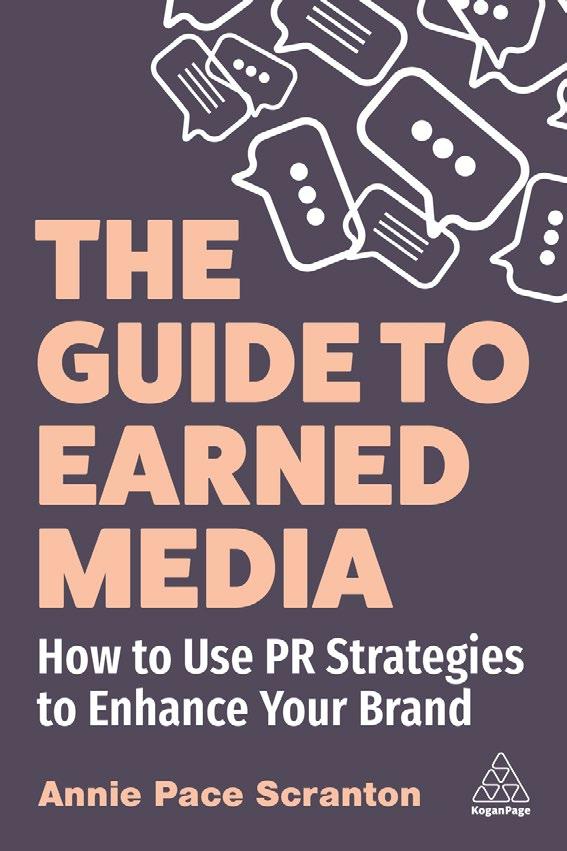
Annie Pace Scranton is the founder and CEO of Pace Public Relations, a certified womenowned global PR agency based in New York City, NY. Specializing in media relations, Pace has represented top clients, such as Away, Inc., Fast Company and the Forward Party, helping them achieve higher brand recognition through valuable press placements. Scranton is passionate about the world of PR and regularly shares her expertise at leading industry events, such as Digital Summit, Silicon Slopes and Adweek. She is an adjunct professor at New York University (NYU), teaching PR Consulting in the Graduate Program.
Edition: 1
Date: 08/28/2023
Price: $24.99
Paperback: 9781398611054
Ebook: 9781398611061
Pages: 184
Format (mm): 234x157
Band: Professional/ Academic
Subject: Public Relations
Introduction
1 PR and successful branding
2 he three spheres of influence
3 The origin story
4 Setting goals
5 The brand’s elevator pitch
6 Thought leadership
7 Pitching to print media
8 Pitching to broadcast media
9 The expert approach
10 Conclusion
• Delivers an improved holistic approach to crisis strategies, from guidance for when the incident first occurs, to the aftermath, the move to recovery and beyond
• Gives a practical framework with easy-tofollow tips, checklists and guidelines that readers can adapt to any industry and any kind of crisis
• Packed with brand new global case studies from responses to events including the British Post Office scandal, Burger King's misfired International Women's Day campaign, Yorkshire cricket's racism scandal and Peloton's crises
• New to this edition: New sections on managing long-running crises and the phases of crises, and new content on behavioral communication and diversity and inclusivity at a time of crisis
Is your company equipped to deal with any kind of crisis - whether caused by internal error, customer action or social media mishap? This bestselling guide gives readers the skills, tools and knowledge to respond effectively to high-stake situations and protect your brand from disaster.
Crisis Communication Strategies is a must-have guide that covers the whole span of a crisis from preparing and laying the groundwork before it occurs, during the incident and the aftermath, including the move to recovery and beyond. It guides readers through each phase, providing details of what to consider, what should be done, tips and checklists for improved responses.
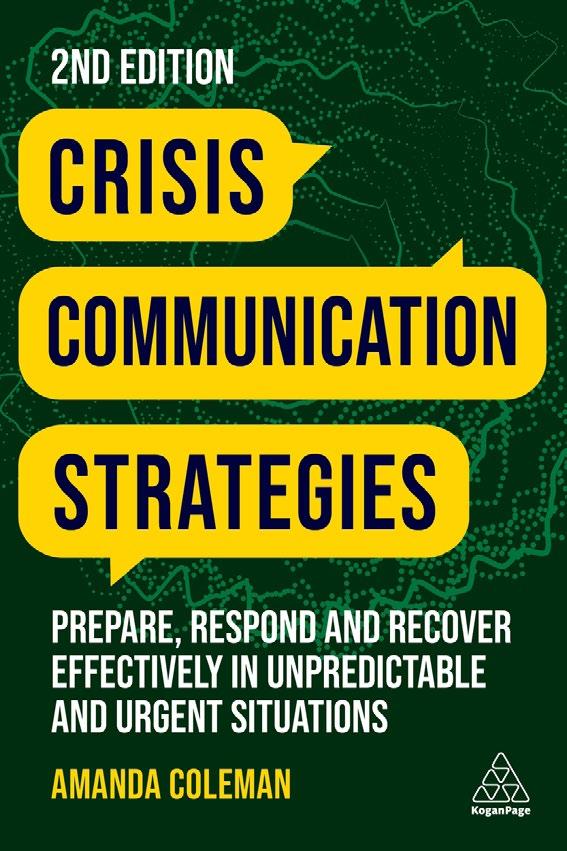
This second edition of Crisis Communication Strategies provides new sections on managing long-running crises. It also contains new content looking at the phases of crises, behavioural communication as a tactic and how to ensure diversity and inclusivity in tumultuous times.
Supported by brand new case studies and examples from responses to events including the British Post Office scandal, Burger King's misfired International Women's Day campaign, Yorkshire cricket's racism scandal and Peloton's crises, it also explores the role of leadership in developing a crisis communication response that has people at its heart. This is an essential guide for PR and communications professionals who wish to protect their company and build long-term resilience.
Amanda Coleman, based in Manchester, UK, is a crisis communication consultant and Director and founder of crisis communication consultancy Amanda Coleman Communication Ltd. With 20+ years' experience in emergency services communication, she is a fellow of the Chartered Institute of Public Relations (CIPR) and The Public Relations and Communications Association (PRCA). She is an advisor for the Resilience Advisors Network, a Senior Associate of the Centre for Crisis and Risk Communication and the Chair of the UK's Emergency Planning Society Communication Professional Working Group. She is the author of Everyday Communication Strategies, published by Kogan Page.
Edition: 2
Date: 03/28/2023
Price: $34.99
Paperback: 9781398609419
Ebook: 9781398609426
Pages: 248
Format (mm): 233x156
Band: Professional/ Academic
Subject: Public Relations
1 Are you ready for a crisis? Creating and testing a crisis communication plan
2 Recognizing a crisis: What it is and how to spot it
3 The operational response: The approaches and how they relate to communications
4 Remembering the people: How employees should come first
5 It’s tough at the top: The role of leadership in a crisis
6 The impact on the community: Managing the consequences
7 It’s OK to not be OK: Ensuring support is in place
8 Stepping on the road to recovery
9 So, what happens next?
This book
• Enables organizations to maximize positive customer engagement with a practical, step by step understanding of how a crisis spreads, the peaks and troughs of consumer reaction and how to turn it into an opportunity
• Embeds a 'bottom-up' crisis culture, including how to differentiate a daily problem from a crisis, engage in early mitigation and legally sound stakeholder response
• Features case studies from leading global brands, as well as personal anecdotes from front-line industry experience
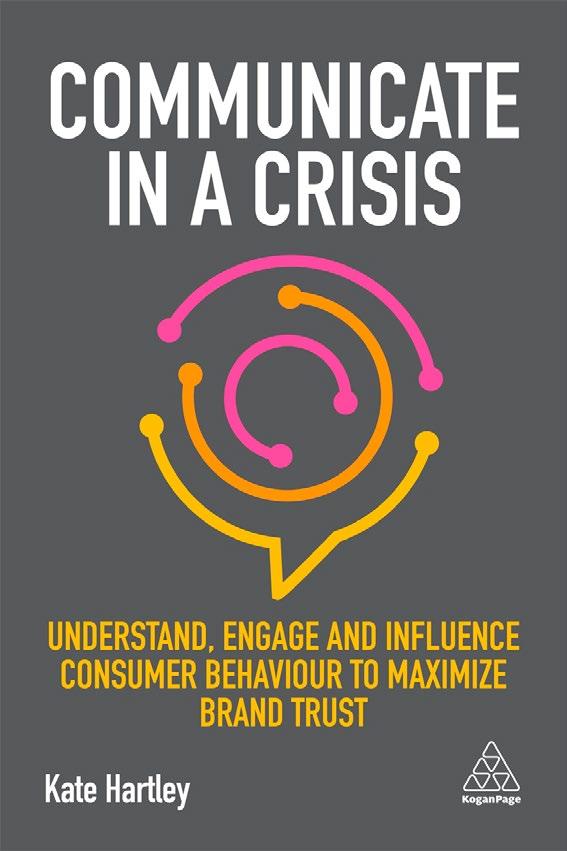
This book turns the traditional crisis management approach on its head, starting by understanding changing consumer behaviours and the new 'threat' for brands, then outlining practical steps to prepare, synchronize and execute a coordinated brand response across all channels - under pressure. It reveals why we love to hate our favourite brands, how to recognize a day to day problem from a crisis, and offers valuable advice, such as using influencers and brand advocates to address social media trolls, rumours and the impact of fake news. With unique case studies, interviews and anecdotes from global leaders, Communicate in a Crisis will embed a bottom-up culture of long-term reputation management, always ready to face the unexpected.
Author Information
Edition: 1
Date: 08/28/2019
Price: $31.99
Paperback: 9780749486501
Ebook: 9780749486822
Pages: 256
Format (mm): 235x155
Band: Professional/ Academic
Subject: Public Relations
• Reveals the specific purpose-built technologies, data assets and actionable insights that PR professionals can use to inform better executive decisions

• Outlines how you can use technology, data and insights to quantify PRs contribution to business objectives
• Includes case studies from Mastercard, Cisco, Southwest Airlines, Adobe, Oracle, Bill & Melinda Gates Foundation, KPMG, Bank of NY Mellon, Wells Fargo, Visa, Audi, IBM, FedEx, NFL, Airbus and General Motors
Data, technology and insights have forever changed the public relations and corporate communications function. Failure to adapt is more a matter of willingness than inability.
Now, technology, data and insights inform more meaningful objectives and elevate performance evaluation. The result is a positive return on PR investment, reduced reputational risk and optimal efficiency. By ignoring these essential assets, PR professionals risk losing executive attention and organizational investment. While "building buzz" or "breaking through the media clutter" may have been adequate measures of success in the past, the top executives who fund and evaluate corporate communications expect much more, including a quantifiable and positive return on PR investment.
Leaders assume that corporate communications and PR professionals already understand the fundamentals of business, and they expect an ability to contextualize PR objectives, outputs and outcomes in the language of business. PR Technology, Data and Insights helps communications professionals understand the purpose-built technologies, data assets and actionable insights available to them while sharing best practices to apply these assets for improved PR performance over time, versus objectives and against competitors.
Using case studies from industries as varied as financial services, technology, travel, automotive and more, along with best practice examples from Adobe, Mastercard, Southwest, Ford and other world class organizations, PR Technology, Data and Insights shows professional communicators how to optimize technology, lead with data, quantify PR's ability to convert public relations outputs to business outcomes, and deliver insights that empower executive decision-making.
Mark Weiner is Chief Insights Officer for PublicRelay, Inc. He lives in Ponte Vedra Beach, Florida. He has lectured at public relations programs at Columbia University, The University of Texas at Austin, UNC-Chapel Hill and New York University. He is an advisor for The University of Florida Public Relations Advisory Council, trustee for the Institute for Public Relations, member of the Arthur Page Society and a member of the PR News Public Relations Hall of Fame. He is the 2018 recipient of the Institute for Public Relations Jack Felton Medal for Lifetime Achievement.
Edition: 1
Date: 04/28/2021
Price: $39.95
Paperback: 9781398600409
Ebook: 9781398600416
Pages: 232
Format (mm): 235x157
Band: Professional/ Academic
Subject: Public Relations
Introduction
1 Technology, Data, and Insights
1 Technology
2 Data
3 Insights
2 The Public Relations Continuum
4 The Landscape Analysis
5 Setting Objectives
6 Strategy and Tactics
7 Evaluation
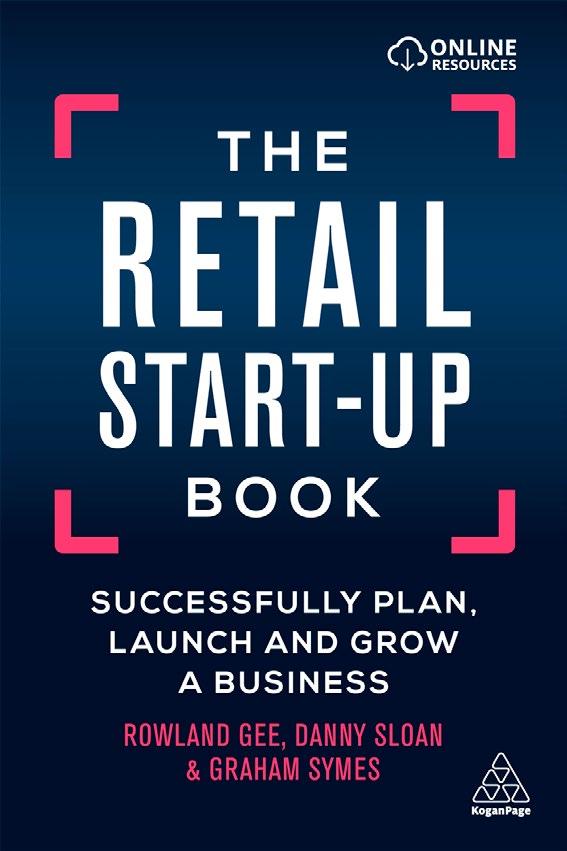
• Learn how to plan and deliver a successful retail vision, master the best routes to market and communicate effectively with new and existing customers
• Shows how to set KPIs to balance sales against overheads and use data to keep an eye on profits
• Teaches the science of shopping, how to research customer behaviours and optimize staff for the greatest customer satisfaction
The retail market in the UK is worth more than £400 billion annually and employs over 3 million workers, while in the US 29 million people create over USD $4 trillion of revenue through the industry. Despite the challenge to establish stores and big-box retailers, there's a rapid increase in the number of retail start-ups and consistent growth in the independent sector. From beard shops and barbers, through cafes and coffee shops, to 'retailment' concept stores and boutique consumer-focused experiences, the specialist retail sector is booming.
The Retail Start-Up Book provides clear guidance and advice on how to develop a winning retail strategy that seamlessly merges online and offline tactics. Introducing the science of shopping and how to understand customer behaviours and needs, it explores the essential steps of developing a business plan, marketing and promoting a business and advising on buying and visual merchandising. Building on years of retail experience nationally and internationally, in large groups and with independent retailers, The Retail Start-Up Book meticulously provide invaluable practical insights to help new retailers hit the floor running, or more established organizations grow their business and nurture their profits.
Rowland Gee is former Chief Executive of Moss Bros Group plc. Under his leadership, Moss Bros entered a strategic business relationship with Hugo Boss, resulting in the UK establishment of the brand. He is co-founder of Grey4Gold Ltd, a professional skills matching service for retail.
Danny Sloan was BAA Director of Planning 2012, ensuring BAA airports delivered the First and Lasting Impression for the UK across its airports during the London Olympics. He is co-founder of Grey4Gold Ltd.
Graham Symes is an experienced finance director in retail and wholesale fashion, with clients including Harrods, Harvey Nichols, Selfridges, and Christian Lacroix.
Edition: 1
Date: 05/28/2019
Price: $31.99
Paperback: 9780749484729
Ebook: 9780749484736
Pages: 272
Format (mm): 233x156
Band: Professional/ Academic
Subject: Retail
• Includes current insights derived from neuromarketing research into consumer behaviour
• Provides practical tools that are robust and easy to use to translate the theory into tangible results
• Contains new models for retail brand management based on first-hand experience at major global retailers and suppliers
Basing shopper marketing strategy on customer insights is what differentiates market leading retail brands from weaker competitors. Many retail organizations lack business development and strategic departments that collect experiences, set benchmarks and create models and manuals. Retail Marketing Strategy makes the information available to drive new ways of thinking and make retail practice more agile for everyone.
Outlining the five key capabilities required for retail excellence, namely in-store execution; organizational development; fact-driven decision making; multi-channel operations, and understanding customers, Retail Marketing Strategy answers some of the most difficult questions in retail including how to innovate to develop new ways to interact with customers across multiple channels, and how to replicate online success stories from other sectors. Practical steps are put forward for collating and interpreting the data generated in shopper activity, helping to make sense of trends and build effective strategy. Guidance is based throughout on neuromarketing research, providing a clear framework for building in experiential elements such as scent or music into the retail environment to really engage with consumers on an emotional level.
If you are a marketing, branding or supply chain professional working in retail seeking straightforward and research-driven techniques for building lasting customer loyalty, or you are responsible for driving retail strategy in your organization, let Retail Marketing Strategy be your guide.

Constant Berkhout is a passionate practitioner of retail marketing and shopper psychology. He obtained a Master of Science in Economics Cum Laude with a major in Marketing at the University of Groningen in the Netherlands. Through his own agency, Berkhout works with retailers and suppliers in Europe, the Middle East and Asia including Conagra Brands, Danone, GrandVision, Heineken, JDE, Jumbo, Migros, SPAR International and Sonos. Before setting up his own agency, he held commercial and insights roles at Ahold Delhaize, Kraft, P&G and PepsiCo.
Edition: 1
Date: 11/28/2015
Price: $45.99
Paperback: 9780749476915
Ebook: 9780749476922
Pages: 296
Format (mm): 235x158
Band: Professional/ Academic
Subject: Retail
1 Shopper happiness
1 Delivering shopper happiness
2 Shoppers are people
2 The myth of impulse purchasing
3 Tapping into irrational shopper behaviour
4 Understanding the shopper brain through neuro research
3 Channel choices
5 Channel preference: the future of the hypermarket channel
6 What the shopper wants from online shopping channels
4 Fact-driven decision making
7 Getting your assortment right
8 Really making loyalty card programmes work
9 Making big data digestible
5 In-store execution
10 The unstoppable growth of private labels and opportunities for A-brands
11 The unexplainable effect of music
12 Can scents work wonders?
13 Self-scanning is more than savings
6 Organizational development
14 The birth of category management
15 True customer understanding
16 Shopper marketing: new phase of trade marketing
7 Embracing the shopper
17 Retailers in action to increase shopper happiness
• Features case studies from diverse sectors including professional services (Ernst & Young), financial services (FM), manufacturing (Rolls-Royce), services (EMCOR, FM Global), pharmaceuticals (Pfizer), and engineering (AMEY)
• Combines ground-breaking research with experience from recognized thought leaders of Cranfield School of Management
• Offers an integrative Key Account Management framework that senior executives can use to design or further develop strategic customer management programmes
Implementing Key Account Management is a highly practical handbook that guides readers through the realities of rolling out a functional key account management programme. The book offers an integrated framework for key account management (KAM) that businesses can use to design or further develop strategic customer management programmes, enabling them to overcome the obstacles that organizations often face when rolling out their strategies.

Bringing together the experiences of leading experts within this field, Implementing Key Account Management draws on two decades of research and best practice from Cranfield University School of Management, one of the foremost centres for researcher and thought leadership in KAM. Between them, the authors have designed and delivered programmes globally for clients such as Rolls-Royce, Unilever, Vodafone, The Economist and many more. Rigorously researched, well-grounded and practical, this book is - quite simply - the definitive, go-to resource for implementing key account management programmes.
Javier Marcos has designed and delivered programmes globally for clients such as Barclays, Cap Gemini, GKN Aerospace, Rolls-Royce and Unilever.
Mark Davies acts as Visiting Fellow for Cranfield School of Management and facilitates the Cranfield KAM Best Practice Research Club.
Rodrigo Guesalaga is Senior Lecturer at Cranfield School of Management, Associate Professor at Pontificia Universidad Católica de Chile, and Visiting Professor at Vlerick Business School.
Sue Holt is Director of the Cranfield School of Management's flagship Open Programme on KAM.
Edition: 1
Date: 08/28/2018
Price: $45.99
Paperback: 9780749482756
Ebook: 9780749482763
Pages: 352
Format (mm): 240x170
Band: Professional/ Academic
Subject: Sales & Key Account Management
1 Introduction to implementing key account management
1 Re-engaging strategic customers
2 Adopting key account management
3 Building customer understanding and value planning
4 Developing customer relationships
2 Developing winning offerings
5 Creating compelling customer value propositions
6 Co-creating value with key customers
3 Designing customer-centric approaches and processes
7 The role of the key account manager and the KAM team
8 Measuring KAM performance
9 Motivating, incentivizing and rewarding for KAM
10 KAM and procurement: the buyer’s perspective and value-based negotiation
11 International key account management
4 Assessing your KAM programme: a framework
12 The KAM Framework
13 Epilogue: Final word on implementing KAM from a global practitioner at Unilever Food Solutions
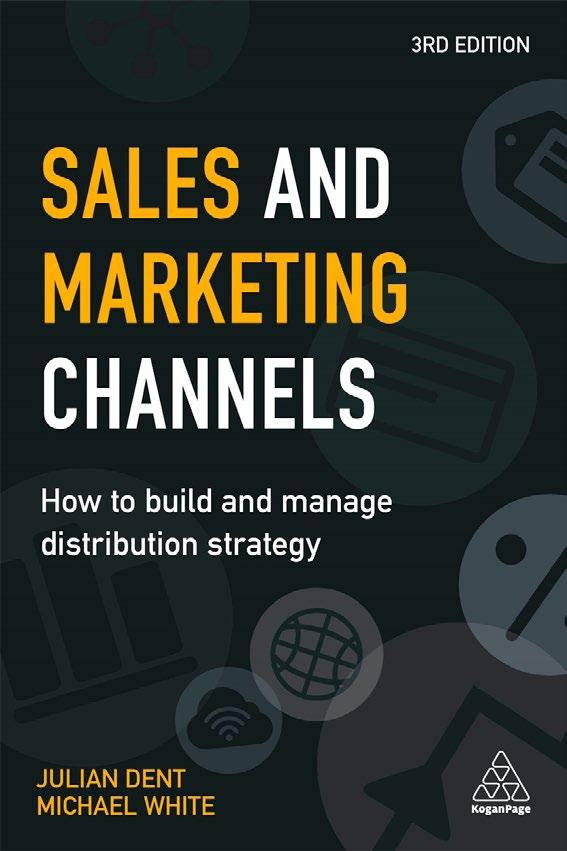
• Provides a complete economic framework for analyzing any channel partner (distributor, reseller or retailer) and a new series of multisector insights
• Enables a defined go-to-market strategy and forecasting for emerging channels and technology
• Supports the allocation of scarce resources for the highest returns, and channel negotiation from positions of market strength or weakness
• New to this edition: multi-sector focus, the emergence of the cloud, new consumer channels, the switch from products to services, the 'gig economy' and monetizing intellectual property
• Online resources: Bonus chapters on how to engage with retailers, franchised systems, and managing the people-based business model
Edition: 3
Date: 04/28/2018
Price: $44.99
Paperback: 9780749482145
Ebook: 9780749482152
Pages: 384
Format (mm): 233x154
Band: Professional/ Academic
Subject: Sales & Key Account Management
• Understand the balance between achieving growth through the development of key accounts and serving key accounts, without letting costs become prohibitive
• Implement best practice in key account management in a confident and successful manner through a highly practical, step-bystep approach
• Benefit from rich learning features, including mini-cases, narratives, examples, diagrams, and visually represented models
• Online resources: include a bonus chapter, case studies, self-test questions, figures and tables, a template for creating your own KAM plan and suggested further reading
• Written by authors with over 20 years experience researching, teaching and consulting on key account management
Malcolm McDonald on Key Account Management explores the challenges of winning, retaining and developing key accounts. Key accounts are customers who help their suppliers grow, and consequently, they wield significant power. Although they are the key to market share and revenue growth, the costs of serving key accounts can erode profitability unless they are thoroughly understood and managed.
Malcolm McDonald on Key Account Management takes a step-by-step approach to presenting best practice in key account management. Whether your business is starting up or well-established, there is always more to discover about improving the way value is created between you and your most important customers. Malcolm McDonald and Beth Rogers have spent over twenty years researching, teaching and consulting on key account management, and have condensed their knowledge into this book, focusing on making it clear, concise and easy to use.
Professor Malcolm McDonald was formerly a Professor of Marketing and Deputy Director at Cranfield University School of Management and is now an Emeritus Professor. Based in the UK, he is also an Honorary Professor at Warwick Business School and the author of Malcolm MacDonald on Marketing Planning, also published by Kogan Page.
Dr Beth Rogers was formerly a Business Development Manager at Portsmouth Business School and chaired project board developing National Occupational Standards for UK professional sales. Based in the UK, she is now the Director of two organisations and writes articles for business publications.
Edition: 1
Date: 08/28/2017
Price: $29.99
Paperback: 9780749480776
Ebook: 9780749480790
Pages: 248
Format (mm): 235x155
Band: Professional/ Academic
Subject: Sales & Key Account Management
1 Introducing key account management
2 The role of key accounts in achieving business growth
3 Selecting the right key accounts
4 Understanding buying decisions
5 Key account plans
6 Understanding account-based marketing
7 People and skills for key account management
8 Going global with key accounts
9 The risks of key account management
10 The future of key account management
Appendix 1: The McDonald and Rogers 10 guidelines for profitable key account management
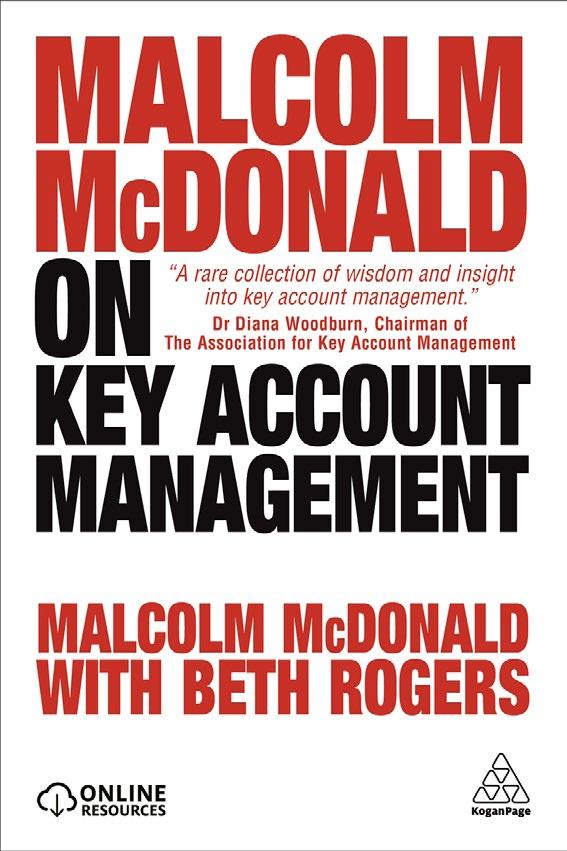
Appendix 2: A quiz for key account managers
Appendix 3: Important research articles on key account management
• Covers topics such as how to develop a strategy and programme, budget for activities, set KPIs, determine ROI, create a dashboard and build a team
• Addresses the relationship between search and social, analytics, customer experience and risk assessment and management in social media
• Helps readers gauge their own social media score with crib notes and practical exercises
• Serves as both a reference guide for professionals and study guide for marketing students
Understanding Social Media is the essential guide to social media for students and professionals alike. Drawing on the experience, advice and tips from dozens of digital marketers and social media superstars, it is an extensive crowd-sourced guide to social media platforms.
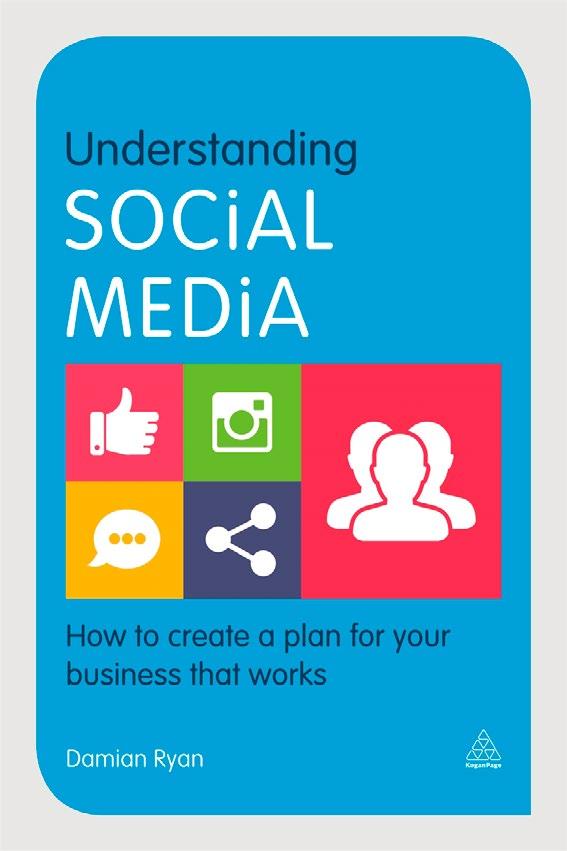
Illustrated throughout with case studies from both successful and failed campaigns, Understanding Social Media democratizes knowledge of social media and promotes best practice, answering questions such as 'How do you create a compelling social media campaign?', 'How do you build and engage with an audience?' and 'Where is the line between online PR and social media drawn?' It is the most comprehensive and practical reference guide to social media available.
Damian Ryan is founder and chairman of The Global Academy of Digital Marketing, a collaborative movement comprised of digital marketers seeking knowledge, case studies, contacts and credible data to help them prosper. He is also a partner with Mediaventura, the UK's leading corporate finance firm for the TIME (Technology, Internet, Media and Entertainment) sector. He is also the author of Understanding Digital Marketing and The Best Digital Marketing Campaigns in the World
Edition: 1
Date: 04/28/2015
Price: $31.99
Paperback: 9780749473563
Ebook: 9780749473570
Pages: 304
Format (mm): 235x157
Band: Professional/ Academic
Subject: Social Media
1 Getting started – how to create a compelling social media programme
2 Rules governing the relationship between search and social
3 How to budget for social media activities
4 Setting KPIs and measuring success
5 Understanding social media ROI – what matters and what doesn’t
6 Why social media is central to customer experience
7 How to build a social media team – how to pick the right suppliers
8 Understanding the relationship between online PR and social media
9 The future for social media and the vastly changing landscape
10 Risk assessment and risk management in social media
• Measure and interpret social media activity into actionable data insights for the business
• Maximize community engagement, integrate content marketing, reputation, audience segmentation and channel investment with speed and clarity
• New to this edition: new content on influencer marketing; new channel explosion and diversification; privacy and behavior; strategy development and new case studies and interviews
• Online resources: digital versions of the templates featured in the book, case studies and Q&As
Social media marketing is no longer optional. This book unpacks the winning formula for effective social media marketing complete with comprehensive updates and latest developments.
Social Media Strategy contains the latest insights on influencer marketing, new channel explosion and diversification, privacy and behaviour, strategy development and new case studies and interviews. This second edition demonstrates how to design, activate and measure a clear social media strategy which is directly accountable to your wider business objectives.
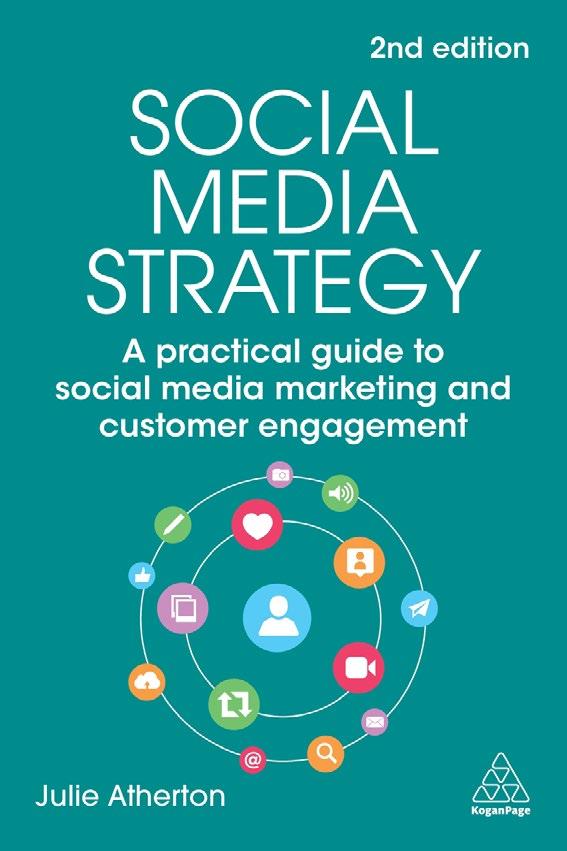
Providing a simple, structured way to create integrated customer engagement and social media campaigns that work, Social Media Strategy delivers practical guidance on key areas, such as identifying and targeting audience segments, a simple ABC (audience, brand, campaign) model, methods of two-way community engagement, reputation management, being present on the right channel, brand purpose, and identifying the relevant tools and platforms to audit, track and measure business impact and customer engagement.
With example templates, interviews and global case studies including National Geographic, Lush, South West Airlines, Dreams, Mumsnet and more, this bestselling guide delivers a long-term solution for maximizing social media led business development for any business.
Julie Atherton, based in Bristol, UK, is the founder of Small Wonder, public speaker, consultant and strategist with 30 years' experience working with global brands including Nissan, ITV, Deloitte Digital, Asos and St John Ambulance. She trains marketing professionals in digital, brand and content marketing. Previous chair of the DMA Social Media Council, she is an experienced trustee and non-executive director for a range of organizations. She is the author of B2B Social Selling Strategy, also published by Kogan Page.
Edition: 2
Date: 10/28/2023
Price: $35.99
Paperback: 9781398609990
Ebook: 9781398610002
Pages: 280
Format (mm): 234x156
Band: Textbook/ Professional
Subject: Social Media Marketing
1 The role of social media in business, marketing and customer expectations
2 Integrated customer engagement –Understanding how and why your social media strategy will enhance your PR and strategic business development
3 Getting started – Aligning social media goals and KPIs with your wider business objectives, PR and marketing campaigns
4 The power of social listening – How to profile your audience and customer insights for a global social media strategy
5 A quick-step guide to channel selection, digital integration, niche social and being present on the relevant channels
6 How to drive action and engagement through integrated content marketing on social media
7 Customer or celebrity? Identifying and attracting the right influencers to advocate your brand
8 Examples, tools and templates – What does a great social media strategy look like?
9 Measuring and benchmarking success –How and when do you know your social media strategy is working?
10 Crisis and reputation management for social media – A clear guide for the unpredictable
• Discusses the importance of maintaining control of the brand message while still giving the influencer the freedom to create posts in their natural style
• Helps readers understand the key facets of influencer marketing, walking them through the process of preparing their own influencer marketing strategy
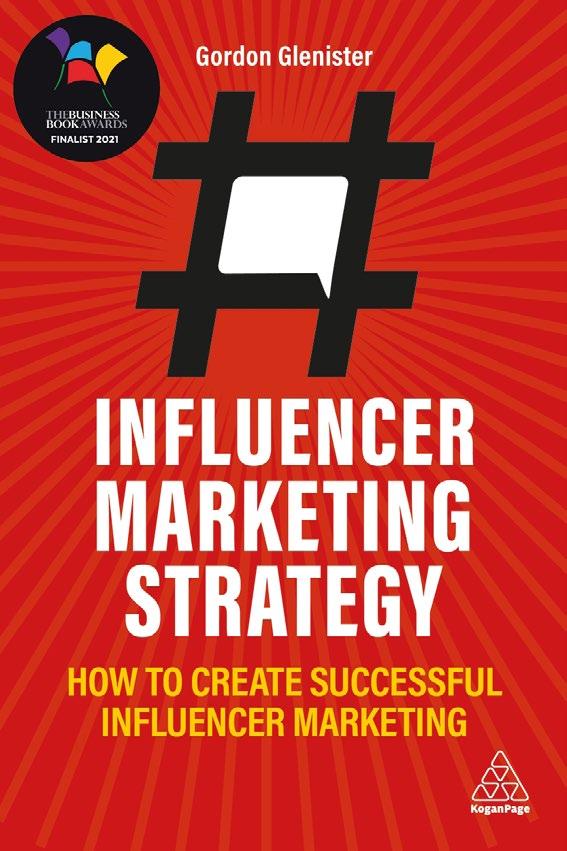
• Features in-depth case studies from the beauty, fashion, gaming, travel, health and tech industries, to showcase the variety of influencer marketing strategies that can be adopted. Examples include Mumsnet, Fyre Festival, Dermalogica and Ryan's Toys
• Offers advice on incorporating influencer marketing into a wider content marketing strategy
SHORTLISTED: Business Book Awards 2022 - Sales & Marketing category
Create an influencer marketing strategy that benefits both brand and the influencer with this fascinating guide, rich in case studies from the biggest and the best and the small and specialist.
Influencer marketing can no longer be ignored. Whether it's broad scale celebrity endorsement, or micro-influencers with niche, highly targeted followings, influencer marketing has become a natural extension of content marketing. However, while the opportunities are vast, the very nature of influencer marketing means that a brand must relinquish control of their marketing message to allow the influencer to communicate in their natural style. This can be unnerving, and it's therefore imperative to have a clearly defined campaign that mutually benefits and protects both the brand and the influencer.
Influencer Marketing Strategy gives readers everything they need to create influencer marketing strategy. It will walk readers through the key considerations, and offer insight into decisions such as choosing the right influencer, planning content, and how to incorporate influencer marketing into your wider marketing strategy. This book presents fascinating, in-depth case studies from the beauty, fashion, gaming, travel, health and tech industries, demonstrating the variety of ways that influencer marketing can be utilized, and the huge opportunities it presents for organizations and industries of all sizes. Influencer Marketing Strategy is the ultimate guide to developing a successful influencer marketing strategy - and building campaigns that create real value.
Gordon Glenister, based in Cambridgeshire, UK, is Global Head of Influencer Marketing for the Branded Content Marketing Association, and has over 25 years' experience in promotional marketing. He is the host of Influence, the global podcast that shines a spotlight on influencer marketing. He also runs his own consultancy and regularly speaks around the world on influencer marketing, membership and merchandise. Gordon Glenister was Director General of the British Promotional Merchandise Association for 11 years.
Edition: 1
Date: 03/28/2021
Price: $39.95
Paperback: 9781789667257
Ebook: 9781789667264
Pages: 304
Format (mm): 235x155
Band: Professional
Subject: Social Media Marketing
Introduction
1 What is influencer marketing?
2 The major platforms for influencer marketing
3 Creating your strategic framework
4 The legal impacts of influencer marketing
5 Working with influencers
6 Finding influencers
7 Creating an ambassador programme
8 Influencer marketing around the world
9 The future of influencer marketing
10 Understanding analytics and measurement
11 Case studies
12 Appendix 1 – Directory of influencer marketing platforms, agencies and consultants
13 Appendix 2 – Glossary of terms
14 Index
United
Paul Raymond
Academic Sales Manager
+44 (0) 7866 109832 praymond@koganpage.com
Matt De Bono
United
Digital & Library Sales Manager
+44 (0) 20 7843 1922 mdebono@koganpage.com
Anne-Marie Heeney
Academic Commissioning Editor +44 (0) 20 7278 0433 aheeney@koganpage.com

7901 916164
& Scotland: Halen Lemberger
Europe, Central Asia & the Caucasus: Durnell Marketing Ltd
Australia & New Zealand: Booktopia Publisher Services
Middle East & North Africa: Avicenna
South Africa: Jonathan Ball Publishers +27 (0) 11 601 8000
Sub-Saharan Africa: Africa Connection
Singapore, Malaysia & Brunei: Pansing
Japan, Taiwan, Korea, Cambodia, Philippines, Indonesia,
Thailand, Vietnam & Myanmar: The White Partnership
(0) 7973 176046
China & Hong Kong: China Publishers Marketing +86 21 5425 9557